
Ultralight Hiking:
See also:
Ultralight
Hiking Advice
The
Upper Yarra Walking Track
Hiking 2017
Hiking 2016
Hiking
2015
Hiking
2014.htm
Hiking 2013
& Earlier
Steve's
Blog
World
Travel Kit for Son
Finnsheep.com
NEW MOBILE
FRIENDLY SITE: THE ULTRALIGHT HIKER



Della & I (combined age then 120) heading
off from Freney Lagoon on the second day of our walk across Tasmania in 2011. We took seven days.
Between us we were carrying @ 20 kilos & enough food (& booze!) for 10
days. These zpacks ‘Blast’ packs are 52 litres including pockets and weigh
around 300 grams. Today we would be carrying several kilos LESS.
All about light weight, ultra light
hiking, backpacking, bushwalking, hunting, tracks, trails, adventures, gear,
reviews…
I have been hiking/hunting now for over sixty years, a little more
slowly than I once did, walking in the Victorian Alps & elsewhere often in
winter and in all weathers. I have camped out a lot, more than two years of my
life in toto. I have seen the failure of just about every type of gear, and
experienced most disasters which can befall you in the wilderness, and
survived. So, if you dream of doing a bit of camping/hiking, maybe I can offer
some useful advice?
This is a ‘work in progress’. I will be adding to it on a regular basis
adding new photos, adventures, product/ideas, suggestions, etc. You should also
look at HIKING
ADVICE also a section of gear advice for my son written in 2011 WORLD
TRAVEL KIT FOR SON. You can also see my older posts above, eg Hiking 2017. Hope you find something interesting.
PS: UPPER YARRA TRACK: I have recently created this site The
Upper Yarra Walking Track Australia’s oldest (& best), an approx. 10-14 day
walk with numerous resupply points, plentiful water and camping spots now
extending from Moe railway Station @ 150 kilometres up the Latrobe, Tyers &
Thomson River valleys, via Yallourn North, Erica & Walhalla, across the Baw
Baw Plateau, along the Upper Thomson River, past the Yarra Falls & Mt
Horsefall, along the Little Ada, Ada and Yarra valleys via Warburton to
Lilydale Railway Station.
Now, complete with Track
Instructions
ULTRALIGHT HIKING BLOG:
27/12/2018: Gully Walking: Most
of the ‘great’ walking tracks (like the Alps’
for example) head along the tops where I admit the views outward and downwards
can be truly
awe inspiring. They do lack for water (and fish) however, are often windy
and/or with very changeable weather that can be a challenge for tents and even
survival. Often they even lack for firewood for a nice cheery fire too.
Myself I prefer the valleys though they seldom for some reason have any track
at all. Mind you this means you can mostly have them all to yourself. I prefer
the view looking up anyway. I am laid up at the moment but that does not
prevent me from dreaming of just such journeys.
And as you can see, Spot is dreaming too:

Let me hint at a route you might follow up the Freestone Creek (Briagalong)
from the beautiful ‘Blue Pools’ for example. All the way up. Here and there are
walking tracks, 4WD tracks, old abandoned logging tracks, deer trails and just
plain bush-bashing.
The beautiful ‘Blue Pool’:

Two dogs eager to start the journey – how young Spot was in May 2013:

But he was keen to lead on up the valley

Past a remarkable bird’s nest:

For just a journey of 3-4 days I guess you could (eg) leave your mountain
bike at the top of the unnamed track that drops down from the Rim Track above
Mt Blomford (above the Lees Creek Track) and return to your car (at the Blue
Pools) via the Marathon Rd – quite a pleasant down hill journey.
The Freestone Creek is a beautiful watercourse (with trout, blackfish,
crays, freshwater mussels, etc) and you will find many wonderful campsites
along the way. I guess over the years (deer hunting, etc) I have walked pretty
much all of it coming out at the top onto the Marathon Rd or the McDonald Gap
Track perhaps.Many people who love the Blue Pools have never seen the Upper
Freestone (which is even better) and is accessed by the delightful Lees Creek
Track which criss-crosses it many times,
What a delightful stream the Freestone is. You can walk in or beside it for
many, many kilometres.

The road used to follow the creek all the way but a substantial length now
diverts from the river. The old road can still be walked however (as you will
find out). Quite a lot of it I would have walked in the dark either trying to
get to a twilit bail-up or attempting to round up stray hounds after just such
a missed bail-up. I know I have a couple of times walked into a large tired
stag the dogs still had bailed up in the dark.
The Upper Freestone:

This is a heart-starting experience I can tell you. Much like dropping onto
the back of a large shark or porpoise body-surfing when you are a mile out from
the beach on the ‘Groper Break’ at Nobby’s near the Newcastle Heads for
example. Something which used to happen to me when I was a teenager. It’s a
wonder I grew to be a man. There used to be a song about such growing up in Newcastle and working at
the BHP steel refinery which then dominated the Harbour and city in the 1960s –
what a decade! I worked there too pouring pig iron in the blast furnace, etc. ‘
Men grow strong as iron upon black bread and sour’ was the refrain. I certainly
did.
A shark’s skin (called ‘shagreen’) is much more like sandpaper than a
dolphin’s (smooth) so it certainly alerts you when to be scared if you should
touch it. A mile out to sea there is not much to be done about it. Hard to believe
that at 14-15 years old we swam out there to surf (and stayed all day in the
water) to swim back in in the afternoon, then catch the train home (to
Fassifern). Much better than taking illicit drugs, violent video games or
whatever it is the youth risk themselves at these days. We also often rode our
bikes up into the Watagan
Mountains (behind
Fassifern), climbed all over their wild places and camped out there by the
light of he moon.
Once you cross the divide (McDonalds Gap Track) you would head down the
Little River to the Moroka. This is likely to be tough going after the fires,
but might be OK if you walk in the middle of the ‘river’. It is not much more
than a gutter really, yet it still held live trout (miraculously) after the
fires burnt to the very water’s edge – and even though every fish and eel in
the Macalister died! We were one of the first vehicles in after the
fires. That was practically the only life we saw in a hundred miles of driving
– save for many deer tracks around the deepest waterholes. It is no wonder
there are so many deer now – and so little else. Such (wildfire) management is
a crime! You might find the going better on the ridges or even sticking to the
roads. This is an adventure for you. I can’t do everything there is left to do.
(I am 70). You will find out for yourselves.
Moroka Hut

There is plenty of fairly easy walking along the Moroka wherever you hit it
– eg from the Moroka Hut down to Horseyard Flat. There is a fine track from
Horseyard Flat down to the first waterfall at least. The main set of waterfalls
further on is awesome, especially when there is enough water to canoe the river
(if you are suicidal!)
You may find it more congenial to cross the river in the vicinity of the main
falls and climb to the other side for a better view. Then you might find it
easier to walk down the ridges aiming for the Moroka in the vicinity of
Higgins’ old cattle yards above the Moroka Creek Track. There are some drops to
avoid, as you will find out. However I have beaten my way down through the
Gorge itself when I was younger crossing back and forth. It certainly is
beautiful and entertaining.
The Upper falls:

The way gets a bit rougher from here on:

When you are walking along the Moroka (below the Gorge) ignore the so-called
track. Criss-cross in such a way as to make for the flattest walking. From
Higgins Yards to the Moroka Creek for example the ‘track’ is on the true left
bank but it is choked with blackberries. You can walk along the clear ridge on
the true right bank. From the Carey down it is pretty clear on the true left
bank even though the ‘track’ is usually on the other side. Ignore the ‘track’
Parks Victoria will never do any real work – not so long as they have
air-conditioned offices and 4WDs and can have meetings.
From the Moroka Creek Track (at least) the river is ‘canoeable’ (when there
is enough water – perhaps 2 metres on the Waterford gauge) though intrepid
adventurers have come down it all the way from the bridge on the Moroka Road!
Truly. But it is not recommended to come over those falls (though people have)!
So it might have been a good idea to bring along your pack raft because when
there is sufficient water (eg above 1.8 metres on the Waterford Gauge on the
Wonnangatta) you can raft all the way down – to the Castleburn Creek confluence
in this scenario about seven days lying about on your raft like Huck and Tom,
say from the Moroka Creek Track down – which would be the safest put in, but
there are some interesting rapids between there and the Wonnangatta – and some
lovely grassy camps too. If you put in at the confluence (six days) it would be
safest There are plenty of beautiful campsites on the Wonnangatta too.
See (for hundreds of photos and precise canoeing instructions) eg:
http://www.theultralighthiker.com/2017/11/22/remote-wonnangatta-day-two/
http://www.theultralighthiker.com/2017/11/15/a-wonnangatta-spring/
http://www.theultralighthiker.com/2017/11/15/a-wonnangatta-spring-day-two/
http://www.theultralighthiker.com/2017/11/15/a-wonnagatta-spring-day-three/
http://www.theultralighthiker.com/2018/01/04/canoe-wonnangatta-kingwill-to-meyers-flat/
http://www.theultralighthiker.com/2017/01/17/wonnangatta-kingwell-bridge-to-black-snake-creek/
http://www.theultralighthiker.com/2017/01/17/wonnangatta-black-snake-to-hut-creek/
http://www.theultralighthiker.com/2017/01/17/wonnangatta-hut-creek-to-waterford-bridge/
http://www.theultralighthiker.com/2018/12/13/wonnangatta-waterford-to-angusvale-day-one/
Moroka-Wonnangatta confluence.

Of course you can walk all the way mainly on the true right bank, sometimes
in the water,sometimes criss-crossing along over bends and loops, sometimes
walking along on beautiful river flats replete with bell-birds, wood swallows
and bee-eaters – and there are roads too in places.
Castleburn Creek Confluence:

If you walk up the Castleburn Creek (there is a lovely campsite at the
confluence, but vehicles can get there) you will swing away from the main road
till you hit the Black Range Track which you will follow till you hit the
walking track that runs down from Pretty Boys Hill via the Lees Creek to the
Freestone once again – thence down it as before in the opposite direction to
the Blue Pools.
Of course I am assuming you will make this journey in the warmer months but
still when the mighty Wonnangatta has enough water to make for an interesting
pack raft trip from the confluence down. Some day you may even be lucky enough
to find enough water in the Freestone to make it canoeable, or some other side
gully might provide an adventure when the rains pour down – something which no
man has ever enjoyed The Scorpion or the Castleburn for example. Who knows what
delights await in some shady grove deep in the mountain’s heart? I know I have
often thrilled to some unexpected ephemeral delight deep in the wilderness.
As a deer hunter I can never neglect the many side gullies which join the
main stream. My journey would be likely to take much longer than yours as I
spied my way up them. Often they contain hidden wonders which you would
otherwise miss in this life: it might be a rare tree or orchid in bloom, or
some wildlife or another caught in a surprising way: Baby deer frolicking like
lambs for example. Watching a huge goanna fold itself into a miniature tree
hole high in some forest giant. A beautiful miniature waterfall or just a
perspective (maybe when a rainbow winks into existence) looking up or down the
gully which brings joy to your heart. Take your time. You will not pass this
way again. And you will pass surprisingly soon. I have seen so many good
friends come and go. People whose faces come to me as I see a remembered path
or tree in some hidden gully where we once stood, perhaps sharing an orange
together long ago..
You would have to make a couple of food drops (along the Wonnangatta –
Moroka Glen and Castleburn confluence perhaps?) somewhere perhaps if you
intended to do this trip. The old fellas in the C19th would have traveled the
land like this with just an axe, a billy, a bag of flour, some salt, a fishing
line and a rifle – and mostly lived off the land. Of course you could too
(barring legalities!). I favour a .410 myself for its lightness and
versatility. Some models such as Rossi’s ‘Circuit Judge’ can be dismantled so
they will fit in your pack but can also take a .45 calibre pistol round or a
solid in .410 – either big enough to take surprisingly large game. A sambar
would have to be quite close and carefully targeted. A wallaby would be easy.
Just across the way in Tasmania
it is legal to kill and eat them. I can’s see what is the difference myself.
Many animals starve to death in winter because they were not harvested before
the days start to close in.
Ducks are plentiful along our rivers. Likewise native pigeons (though
illegal) are a culinary delight. People tell me lyre birds are as tasty as any
bantam. And so on. The game will still be there long after the laws and the
people who made them are dust. Some years you will find rabbits plentiful,
echidna, brush-tailed possums, goannas, water dragons and so on. A PS: The ‘Tea
Tree which is found in various spots along the way was so named because the
early settlers used to use an infusion from it as a substitute for tea.
I guess it would take me nearly a week (on my 70 year old legs, but enjoying
the trip immensely as I go) to reach the Wonnagatta-Moroka confluence from the
Blue Pools. I would then have about a week drifting down the Wonnagatta then
3-4 days making my way back to the Blue Pools, so it is not a weekend trip by
any means. You are no doubt much younger (and perhaps in a dreadful hurry to
get to the grave!) so you can/will be much faster. I only hope you learn and
enjoy along the way…
A couple of other ideas:
First a short one: Sandy Creek to Morris
Creek, down the Welington, then a
short section of the Mitchell Gorge (bring the pack raft), then walk up the Sandy Creek
to your camp.
Up the Nicholson (from around Bairnsdale) to say Marthavale (some bastards
burned down the wonderful hut there but it is still a lovely place to camp
(although vehicles) with fresh trout in the river nearby. Over (via ‘Steve’s
Track’ – Yes!)’ into the Wellington,
then down the Mitchell to the beginning (perhaps at the wonderful ‘sand
jetties’ at the mouth of the Mitchell. This one would also take weeks and
require resupply.
I used to love walking up the Deep Creek – a tributary of the Thomson (years
ago) then down the Aberfeldy to the Thomson, sometimes by boat. I could raft
down the Thomson to Deep Creek and exit via the (now closed) D10 track which
used to take me to within a chain of deep Creek just upstream from the Thomson
confluence.
I’m sure if you have read this far, you get the point. There are many
wonderful valley walking/pack rafting trips to be enjoyed in the Gippsland
mountains. All I can say is: ‘Get out there’. Soon you too will be 70 – or
worse!
Can I recommend Rooftop’s Dargo-Wonnangatta Adventure Map for this (and many
other like) fascinating expeditions?
See Also:
https://www.theultralighthiker.com/2018/11/04/beginning-hiking/
https://www.theultralighthiker.com/2018/12/20/their-torn-and-rugged-battlements-on-high/
25/12/2018: Why
These Umbrellas Will Last Forever: Davek Umbrellas. They are confident:
‘Unconditionally Guaranteed For Life: Every Davek umbrella comes with an
Unconditional Lifetime Guarantee. If, during its lifetime, the umbrella should
fail to function properly for any reason whatsoever, the company will gladly
repair or replace it for free.’ https://au.davekny.com/
The lightest appears to be: The Davek Mini: https://au.davekny.com/collections/umbrellas/products/the-davek-mini
under 1 lb ie 453 grams. Comes in lots of colours – at least seven anyway..
‘The Davek Mini is our smallest, most compact umbrella. This incredibly
convenient umbrella fits in literally any compartment, from a handbag or clutch
to your pants pocket. The stylish Mini is the perfect “just in case” umbrella,
hardly noticeable when it’s not in use. Keep it with you always—never be caught
without an umbrella again. Measures less than 7 inches when closed.
Pocket-sized protection, with style to spare. Manual open/close system.’
It costs $A75 (Dec 2018), so it is certainly worth finding out. You are
always better off to have good things than cheap things. This is a piece of
wisdom which seems to have been lost. For example we drive 1995-6 cars which we
expect to last us for the rest of our lives. Most everything we own is like
that. We are proud of that fact. We never wanted to be a part of the throw away
society.
|
Coverage diameter
|
38 in (arc-diam); 34 in (straight-diam)
|
|
Closed length
|
7 inches
|
|
Weight
|
Under 1 lb—ultra lightweight
|
|
Open/close system
|
Manual system
|
|
Shaft material
|
Steel
|
|
Frame system
|
Fiberglass reinforced 6-rib frame system
|
|
Fabric
|
190 thread-count microweave fabric
|
|
Warranty
|
Unconditional lifetime guarantee
|

I carry this
Montbell one for emergencies which weighs 85 grams, but I doubt it will
last me for life – though I admit the last few weeks have made me think that
might not be so long as I might wish! So perhaps it would! It might be more
sensible to carry this rather heavier one which I could be confident would
never fail me as a roof – so I could perhaps dispense with a raincoat
altogether – so the weight difference would be negligible – but how much weight
is your life worth in grams?
I have seen a man dead in the rain when I was comfortable nearby. I would not
want to be the one who is dead. Rain is deadly. You must have shelter. You must
have a roof. There is no such thing as a safe walk. Following a defined trail
is really no safer than forging your way through the trackless bush,
which I would rather do anyway. How often have I ‘found’ walkers who have
followed a deer trail off into the bush and who then can’t find their way back
to the marked trail. Some I don’t find!
On a lighter note, here is a genius idea for any hiking umbrella: http://www.theultralighthiker.com/2017/12/14/a-hands-free-umbrella/
See
Also:
http://www.theultralighthiker.com/2018/04/29/ultralight-rain-gear/
http://www.theultralighthiker.com/2018/09/28/a-wind-shell-and-an-umbrella/
http://www.theultralighthiker.com/2017/08/18/raincoat-shelter/
http://www.theultralighthiker.com/2016/08/14/hiking-in-the-rain/
http://www.theultralighthiker.com/the-importance-of-a-roof/http:/The%20Importance%20of%20Roof
23/12/2018: Wild Journeys: https://www.amazon.com.au/Wild-Journeys-Bruce-Ansley-ebook/dp/B07BVHRZLZ#reader_B07BVHRZLZ
21/12/2018: Their Torn and Rugged
Battlements on High : ‘Where the pine-clad ridges raise
Their torn and rugged battlements on high,
Where the air is clear as crystal, and the white stars fairly blaze
At midnight in the cold and frosty sky’
'The Man from Snowy River', Banjo Paterson
As you know I am a bit laid up at the mountain, but a young friend of
mine has been out and about, and shared this guest post for you:
Kobie Notting: 'Dear Victorian Alps, you really
cemented a place in my heart this weekend. Your bipolar weather makes me love
and respect you even more, even though you tried to kill me Saturday night. How
lucky we are to live within a couple hours drive of this. P.S. Go hike the
Crosscut Saw people.


You start from the Mt Howitt carpark. You can do a day trip or an
overnighter.. there’s a hut an hour in from the carpark that you camp at the
night.. so basically drop your bags there and keep going to the crosscut. It’s
a section between Mt Howitt and Mt Buggery where you’re just walking on the top
of the ridge.
 Views
are just epic; just make sure it’s not going to be windy as there’s some
sketchy sections like half a footpath wide with sheer drops, wouldn’t want it
to be gusty. You could easy get to the view part and back in half a day. It’s
only an hour to the hut, then from the hut another hour to the start of the
crosscut saw. With a light day pack you’d kill it. It’s hilly but if you took
your time you would be fine.
Views
are just epic; just make sure it’s not going to be windy as there’s some
sketchy sections like half a footpath wide with sheer drops, wouldn’t want it
to be gusty. You could easy get to the view part and back in half a day. It’s
only an hour to the hut, then from the hut another hour to the start of the
crosscut saw. With a light day pack you’d kill it. It’s hilly but if you took
your time you would be fine.

A reader writes: ‘Got stuck on the cross cut saw in a total white out and
had to sit it out behind a rock for several hours. The clouds can move in on
you very quickly. Take care. The drop below is called the Terrible Hollow for a
reason’

Yeah it changes soooo quickly up there! See eg: https://www.trailhiking.com.au/crosscut-saw-mt-speculation/?fbclid=IwAR10nHuvI9Cb7lfLxLRvpCKLs3OoSXgNi3EPNkNoszvhKQovTdmJisrTGFY'

The High Country is always ablaze with wldflowers:


Kobie also posted this video to give a bit of an idea of how a
living 360 degrees up there is like: https://www.facebook.com/kobie.notting/videos/10157010309837658/
Chilling out on the roof rack of the Troopie:

Don’t know the full poem? One of the best ever
written. Here it is:
The Man from Snowy
River
There was movement at the station, for the word had passed around
That the colt from old Regret had got away,
And had joined the wild bush horses - he was worth a thousand pound,
So all the cracks had gathered to the fray.
All the tried and noted riders from the stations near and far
Had mustered at the homestead overnight,
For the bushmen love hard riding where the wild bush horses are,
And the stock-horse snuffs the battle with delight.
There was Harrison, who made his pile when Pardon won the cup,
The old man with his hair as white as snow;
But few could ride beside him when his blood was fairly up-
He would go wherever horse and man could go.
And Clancy of the Overflow came down to lend a hand,
No better horseman ever held the reins;
For never horse could throw him while the saddle girths would stand,
He learnt to ride while droving on the plains.
And one was there, a stripling on a small and weedy beast,
He was something like a racehorse undersized,
With a touch of Timor pony - three parts
thoroughbred at least -
And such as are by mountain horsemen prized.
He was hard and tough and wiry - just the sort that won't say die -
There was courage in his quick impatient tread;
And he bore the badge of gameness in his bright and fiery eye,
And the proud and lofty carriage of his head.
But so slight and weedy, one would doubt his power to stay,
And the old man said, "That horse will never do
For a long and tiring gallop-lad, you'd better stop away,
Those hills are far too rough for such as you."
So he waited sad and wistful - only Clancy stood his friend -
"I think we ought to let him come," he said;
"I warrant he'll be with us when he's wanted at the end,
For both his horse and he are mountain bred."
"He hails from Snowy
River, up by Kosciusko's
side,
Where the hills are twice as steep and twice as rough,
Where a horse's hoofs strike firelight from the flint stones every stride,
The man that holds his own is good enough.
And the Snowy River riders on the mountains make their
home,
Where the river runs those giant hills between;
I have seen full many horsemen since I first commenced to roam,
But nowhere yet such horsemen have I seen."
So he went - they found the horses by the big mimosa clump -
They raced away towards the mountain's brow,
And the old man gave his orders, "Boys, go at them from the jump,
No use to try for fancy riding now.
And, Clancy, you must wheel them, try and wheel them to the right.
Ride boldly, lad, and never fear the spills,
For never yet was rider that could keep the mob in sight,
If once they gain the shelter of those hills."
So Clancy rode to wheel them - he was racing on the wing
Where the best and boldest riders take their place,
And he raced his stockhorse past them, and he made the ranges ring
With stockwhip, as he met them face to face.
Then they halted for a moment, while he swung the dreaded lash,
But they saw their well-loved mountain full in view,
And they charged beneath the stockwhip with a sharp and sudden dash,
And off into the mountain scrub they flew.
Then fast the horsemen followed, where the gorges deep and black
Resounded to the thunder of their tread,
And the stockwhips woke the echoes, and they fiercely answered back
From cliffs and crags that beetled overhead.
And upward, ever upward, the wild horses held their sway,
Were mountain ash and kurrajong grew wide;
And the old man muttered fiercely, "We may bid the mob good day,
No man can hold them down the other side."
When they reached the mountain's summit, even Clancy took a pull,
It well might make the boldest hold their breath,
The wild hop scrub grew thickly, and the hidden ground was full
Of wombat holes, and any slip was death.
But the man from Snowy
River let the pony have
his head,
And he swung his stockwhip round and gave a cheer,
And he raced him down the mountain like a torrent down its bed,
While the others stood and watched in very fear.
He sent the flint stones flying, but the pony kept his feet,
He cleared the fallen timbers in his stride,
And the man from Snowy
River never shifted in
his seat -
It was grand to see that mountain horseman ride.
Through the stringybarks and saplings, on the rough and broken ground,
Down the hillside at a racing pace he went;
And he never drew the bridle till he landed safe and sound,
At the bottom of that terrible descent.
He was right among the horses as they climbed the further hill
And the watchers on the mountain standing mute,
Saw him ply the stockwhip fiercely, he was right among them still,
As he raced across the clearing in pursuit.
Then they lost him for a moment, where two mountain gullies met
In the ranges, but a final glimpse reveals
On a dim and distant hillside the wild horses racing yet,
With the man from Snowy
River at their heels.
And he ran them single-handed till their sides were white with foam.
He followed like a bloodhound in their track,
Till they halted cowed and beaten, then he turned their heads for home,
And alone and unassisted brought them back.
But his hardy mountain pony he could scarcely raise a trot,
He was blood from hip to shoulder from the spur;
But his pluck was still undaunted, and his courage fiery hot,
For never yet was mountain horse a cur.
And down by Kosciusko, where the pine-clad ridges raise
Their torn and rugged battlements on high,
Where the air is clear as crystal, and the white stars fairly blaze
At midnight in the cold and frosty sky,
And where around The Overflow the reed beds sweep and sway
To the breezes, and the rolling plains are wide,
The man from Snowy
River is a household word
today,
And the stockmen tell the story of his ride.
Have you seen the film? Here is the short version to whet your appetite
Can you imagine galloping a horse down these precipitous slopes. This view
(featured image) all used to be Wonnangatta Station type country and not so
long ago stockmen droved cattle and horses all over it - just as I used to did when
I was a youngster.
https://www.youtube.com/watch?reload=9&v=jo51fIu_fjk
How could you not love these mountains?
See Also:
https://www.theultralighthiker.com/2018/06/02/mattresses-i-have-known/
https://www.theultralighthiker.com/2018/06/02/mattresses-i-have-known/
15/12/2018: The
Loop Alien: This is a really great idea
for tightening your guy line or tarp suspension. No knots. Will slip through a
loop on your pegs to make a very secure guy line system on particularly windy
nights. I like it. It is not intended as a weight bearing device. I think you
can see from the picture how it works. Ingenious. Available here: https://loopalien.com/products/aluminum-rca US$5.00
(Dec 2018) 2.4 grams ea.

Youtube here: https://www.youtube.com/watch?v=-AZl_N4Q5Io
Other people's opinions about it: http://theultimatehang.com/tag/loopalien/
Many other items of interesting hardware are out there, such as this one:
https://dutchwaregear.com/product/fleaz/ which weighs less than a
gram. There will be a future post about cord knick knacks.
Of course there are
plenty of copies out there from US$ .29 cents each.
I am still using the micro clam cleats for my guy lines: http://www.theultralighthiker.com/2014/12/14/the-perfect-guy-line-for-a-hiking-tenttarp/

and I am using whoopie slings for many other uses such as attaching my
hammock, centreline and tarp, eg: http://www.theultralighthiker.com/2017/06/02/whoopie-slings-what-a-great-idea/
14/12/2018: Telstra’s Go Repeaters: Your mobile connectivity problems solved:
You need: https://exchange.telstra.com.au/new-telstra-go-repeaters-bring-mobile-coverage-to-more-places/
plus https://www.telcoantennas.com.au/antennas/home-office/outdoor/
29/11/2018: Spinal Fusion: This
week I am having four-level spinal fusion on my lumbar spine (irrevocably
damaged by tough hard heavy work from when I was only a child). However, the
surgeons have found one disc which is sound so I can have this done, be free of
pain and just be a little stiffer getting out of my sleeping bag in the
mornings – indeed I might even move to a quilt as the docs are limiting me to
5kg for the next couple of months. That will certainly make me the ultralight
hiker! I will find an X-ray of my spine to illustrate this post, but I am in
hospital suffering all manner of indignities and cruelties just now so posts
are a bit light. Sorry.

I have two of the best spinal surgeons in Australia working on me: Dr
Caroline Tan and Dr David Edis. I had the discs removed on Tuesday and replaced
with plastic inserts through my side in a procedure known as OLIF. This is
apparently the best way to do it. Then on Friday the surgeons will go in though
my back to insert the rods and screws which will hold the vertebrae until they
fuse. They paint a highly sophisticated artificial chemical construct on the
area to create this bone growth and fusion (which will take up to about 3
months).
By the time the moose are calling in Fiordland (28th February) the back
should be healed enough to carry 8-10 kg so I can hopefully go there with Della
and try to get a photograph of that elusive moose.I will keep you posted…
PS (15 Dec): After the op I had a fortnight of absolute nightmare. I will
never go anywhere near the Valley Private Mulgrave again. They literally made
every effort to kill me and to torture me they could – all this accompanied by
deliberate sleep deprivation. Day after day with no (or too little) pain
medication. It was awful. I will be making official complaints about my
treatment. Finally (we) discharged myself, went home and put myself in the hands
of my own reliable GP Fred Edwards here in Churchill whom I have known for
thirty years. Finally home, with family to care for me, without (much) pain and
learning to walk again.
I still hope to meet the moose deadline though. (Very) slowly cranking up
the steps per day. A long while yet to get to my usual 10,000+ per day,but I
will make it. Plenty of work to do here on the farm which should substitute for
physiotherapy! Wish me luck!
PS: The trees which Merrin and I have been planting (over Spring) are
starting to peek over the tops of the tree guards (1.5 metres tall). We will
have a sheep forest before many years have passed: https://www.theultralighthiker.com/2018/10/13/electric-drill-earth-auger/
See Also:
https://www.theultralighthiker.com/2018/03/05/the-lure-of-the-moose/
http://drcarolinetan.com
https://vicorthospine.com.au/news-dr-david-edis/
30/11/2018: At Last an E-ink Smart
Phone: I think e ink is all you need in a hiking phone as long as it has a
reasonable camera (or perhaps none at all) and can display maps and books well
enough. The trade-off of not having to charge for say a month is enormous
value.
This one weighs only 47 grams:https://www.e-ink-info.com/e-ink-devices/mobile-phones

HiSense A6 is a new smartphone with an E Ink screen: https://goodereader.com/blog/smartphones-2/hisense-a6-is-a-new-smartphone-with-an-e-ink-screen
This one’s main screen is e-ink (which probably means the battery will last
you a month: https://www.pcmag.com/feature/313023/hands-on-with-the-onyx-boox-e-ink-smartphone/1
See Also:
https://techcrunch.com/2018/03/01/the-new-light-phone-2-keeps-things-basic-but-adds-e-ink-and-essentials/
https://www.theverge.com/circuitbreaker/2018/4/16/17242014/sony-digital-paper-dpt-cp1-e-ink-tablet-announced-japan
https://www.gizmodo.com.au/2018/02/the-remarkable-e-ink-tablet-is-way-too-good-for-its-software-and-price/
https://www.e-ink-info.com/e-ink-devices/mobile-phones
More about this when I get out of hospital!
24/11/2018: Shadowland
– Fiordland Video:

If you wonder why I return again & again to Fiordland (& the Dusky
Track) maybe this excerpt from ‘Shadowland’ will whet your appetite. (Della’s
favourite part, the kakapo @ 37secs in). You may have to buy the
complete video as no-one seems to have uploaded it, but it will be worth it.
Even more worthwhile is to tramp the Fiordland wilderness. If you feel you are
not as fit as we geriatrics, treat yourself to a heli or plane tour out of Te
Anau. I/we have been back again several times since I first posted this back in
2014 – but alas not this year. If my back fusion operation next week is
successful we may yet walk the Dusky together in 2019.
https://www.youtube.com/watch?v=jF4ugISWMT8
First Published on: Jan 21, 2014
See also:
http://www.theultralighthiker.com/from-dawn-to-dusky/
http://www.theultralighthiker.com/from-dawn-to-dusky-day-2/
http://www.theultralighthiker.com/from-dawn-to-dusky-3/
http://www.theultralighthiker.com/from-dawn-to-dusky-4/
http://www.theultralighthiker.com/from-dawn-to-dusky-5/
http://www.theultralighthiker.com/from-dawn-to-dusky-7/
http://www.theultralighthiker.com/from-dawn-to-dusky-8/
http://www.theultralighthiker.com/insects-can-ruin-a-camping-trip/
http://www.theultralighthiker.com/dusky-track-canoeing-the-seaforth/
http://www.theultralighthiker.com/dusky-track-adventures-1/
http://www.theultralighthiker.com/eddie-herrick-moose-hunting-at-dusky-sound/
http://www.theultralighthiker.com/eddie-herrick-moose-hunting-at-dusky-sound/
http://www.theultralighthiker.com/a-friend-i-met-on-the-dusky-track-fiordland-nz/
http://www.theultralighthiker.com/dusky-south-coast-tracks/
http://www.theultralighthiker.com/dreaming-of-the-dusky-track/
http://www.theultralighthiker.com/the-dusky/
http://www.theultralighthiker.com/moose-hunting/
http://www.theultralighthiker.com/fiordland-moose/
http://www.theultralighthiker.com/fiordland-moose-2/
http://www.theultralighthiker.com/hunting-in-fiordland/
http://www.theultralighthiker.com/off-to-fiordland/
http://www.theultralighthiker.com/shadowland-fiordland-video/
http://www.theultralighthiker.com/the-best-toilet-view-in-the-world/
http://www.theultralighthiker.com/10-days-in-fiordland/
http://www.theultralighthiker.com/fiordland-2009/
http://www.theultralighthiker.com/fiordland-nz-with-bryn/
http://www.theultralighthiker.com/fiordland-april-2007/
http://www.theultralighthiker.com/weather-for-fiordland/
http://www.theultralighthiker.com/more-dusky-adventures/
http://www.theultralighthiker.com/insects-can-ruin-a-camping-trip/
http://www.theultralighthiker.com/dusky-track-canoeing-the-seaforth/
http://www.theultralighthiker.com/dusky-track-adventures-1/
http://www.theultralighthiker.com/eddie-herrick-moose-hunting-at-dusky-sound/
http://www.theultralighthiker.com/eddie-herrick-moose-hunting-at-dusky-sound/
http://www.theultralighthiker.com/a-friend-i-met-on-the-dusky-track-fiordland-nz/
http://www.theultralighthiker.com/dusky-south-coast-tracks/
http://www.theultralighthiker.com/dreaming-of-the-dusky-track/
http://www.theultralighthiker.com/the-dusky/
http://www.theultralighthiker.com/moose-hunting/
http://www.theultralighthiker.com/fiordland-moose/
http://www.theultralighthiker.com/fiordland-moose-2/
http://www.theultralighthiker.com/hunting-in-fiordland/
http://www.theultralighthiker.com/off-to-fiordland/
http://www.theultralighthiker.com/shadowland-fiordland-video/
http://www.theultralighthiker.com/the-best-toilet-view-in-the-world/
http://www.theultralighthiker.com/10-days-in-fiordland/
http://www.theultralighthiker.com/fiordland-2009/
http://www.theultralighthiker.com/fiordland-nz-with-bryn/
http://www.theultralighthiker.com/fiordland-april-2007/
http://www.theultralighthiker.com/weather-for-fiordland/
23/11/2018: Largest
built structure on earth: https://www.yahoo.com/news/termite-colony-size-great-britain-built-since-dawn-pyramids-132724663.html
22/11/2018: Launch Pad Water Deluge System Test at NASA Kennedy
Space Center:
https://www.youtube.com/watch?time_continue=13&v=LNkmwrTjKuo
21/1/2018: The
Happiness Trick: I am indebted for this to Randi Skaug the first Norwegian
woman to climb Everest. First thing in the morning, clasp one hand over the
other then raise your hands above your head – and smile. It is just about
automatic. Hold for a few seconds to a minute. The smile will kick in serotonin
production and actually produce happiness. As Randi says, ‘You are only here on
earth a little while, a century at most. Why not be happy?’ Couldn’t agree more.
You can catch her story on Ben Fogle’s ‘New Lives in the Wild’ Series 7,
Episode 4, ‘Norway’:
https://www.imdb.com/title/tt9109066/
Available on ThePirateBay.
See Also: https://www.theultralighthiker.com/its-not-my-fault/

20/11/2018: Whitetail Hunting in
1810: ‘Forty-four Years of the Life of a Hunter’, Meshach Browning
1859. Lots of wonderful books are available free below (if you look for them).
This is from Chapter 6: ‘Whitetail Hunting in 1810’. What a treasure! Six deer
taken in a single day with a muzzle-loader. Great hunting!

‘Shortly after returning to my home, three
hunters and myself agreed to go to the glades to hunt deer. We all started for
what was called the piney cabin and met at the place, but it was too late to hunt
that evening, and there was no snow on the ground.
A light snow having fallen during the night, I said in the morning
that I would bet any man a gallon of whiskey I would kill two deer that day.
“I’ll take that bet,” said a man by the name of James.
It was agreed on; and I told them to pick their course, and I would
take the ground that was left. So they all made choice of a locality for that
day, leaving me the very ground I wished for.
Everyone set out in great spirits, but while going to the place assigned
me, I heard a buck bleat, which they will do in mating-time when they smell
other deer. I walked quickly to the leeward side of him in order that he should
not smell me. In doing so, I crossed a number of deer tracks.
Knowing that the buck was after them, I stood close to the tracks,
where I could still hear him bleating and every time the sound was nearer. In a
short time, I saw him following the tracks. I let him come within eight steps,
and then stopped him by bleating as he did, when I shot him in his tracks.
I skinned him very rapidly and went on, but I had proceeded only a
short distance when I saw a small buck trot along the top of a steep hill, then
disappear down the opposite side.
I ran to the top, and looking down, saw him going leisurely along,
whereupon I snorted like a deer, which I could do very naturally. As soon as he
heard the snort, thinking it came from the other deer, which he expected to
see, he stopped to look round for them.
I had with me a deer’s tail, which I showed him from behind a tree,
and then exposed a small portion of my clothes which were about the color of a
deer. Uncertain what to do, he stood there, occasionally stamping his foot on
the ground, all the while holding his head as high as he could. Then I would
show the tail quietly, and as if I was not scared, and at last seeing him lick
his mouth, I knew he would come to ascertain what was there.
He came on little by little, still stamping his feet on the ground,
until he came within range of my rifle, when I shot at his breast and broke his
shoulder. I set my dog on him, and when the deer soon turned to make fight, I
shot him again.
I then skinned him, and as I was in the glades without a hat, and
it was blowing and snowing as fast as the snow could fall, I started to run
across a glade, out of the storm.
As I ran through the ferns, about half-a-leg high, up sprang a
large buck, which, after making two or three jumps, stopped in the middle of
the open glade. He had scarcely stopped before my rifle sent a ball through him.
He jumped forward a few yards and fell over dead.
The storm was so severe that I was obliged to seek shelter in a
grove of thick pines. After it abated, I started for camp again, still looking
for deer.
I was about halfway in when I saw approaching what I took to be
another buck. I stood still, but the deer saw me too, though it could not make
out what I was. Each stood perfectly still, looking at the other, until I
became tired.
There was between us a large fallen tree, which hid the body of the
deer, so that I could see nothing but the head. Finding no other chance, I
raised my gun and fired at the head. After the report, seeing nothing of the
deer, I hurried forward, and there lay as fine a doe as I ever killed, with her
brains blown out.
I commenced skinning her as fast as possible, as it was getting
late, and I was quite ready to leave for the camp when I saw on the entrails so
much tallow that I stopped to save it. As I was picking off the tallow, it
occurred to me that it was a wonder a buck had not been on her track, for she
was in that peculiar condition when the males will follow them, wherever they
find their track.
So I raised my head to look, and there stood a stout buck within
ten steps, staring at myself and the dog as I was sitting at my work, with the
dog licking up the blood and eating the small pieces which fell to his share.
I dared not rise to get my gun, which was standing against a tree
out of my reach. Finally, I began to creep towards it, all the time being
afraid to look at the deer, lest the sight of my face should scare him, for I
knew it was not pretty.
When I had secured my gun, I looked around and saw him walking off,
and as I did not wish to spoil his saddle, I delayed shooting until I could get
his side toward me.
All of a sudden he stopped, turned round and came walking back to
look for the doe, stopping at the same place where I first saw him. That moment
I pulled my trigger, and the ball, striking in the middle of the breast, killed
him at once. He never attempted to jump, but reared up so high that he fell
flat on his back. I skinned him, put him on the same pole with the other, and
then started off for the camp.
When I arrived there, all hands seemed
astonished at my good luck, but James disputed the fact, saying that I had been
there the week previous and had hid those skins in the woods. But a Mr. Frazee,
who had hunted with me all the previous week, during which time I had killed
some eight or ten deer, told James that my boys and his had come out the last
of the week with horses, and carried in all the meat both of us had killed,
together with the skins. James was satisfied that there was no foul play in the
matter. I told James that I could kill a deer yet that night. He was anxious to
take another bet, and in order to give him a chance for his whiskey, I closed
with him, for when I left the camp in the morning, I had observed a spot where
a great many deer had been feeding on thorn-berries, and I knew that they would
be there again at dusk after the berries.
Seizing my gun, I made for the leeward side of the thorn nursery in
order that the deer should not smell me. The dog scented the deer, and
therefore I crept along very cautiously, though I could see no game. Presently,
a very large buck made his appearance, and I said to myself: “That will make
the sixth deer, beside two gallons of whiskey, and the reputation of being the
best hunter in the woods.”
It will be seen that my vanity began to rise. The buck gradually
drew nearer, but the pine trees stood so close together that it was a hard
matter to secure a good aim, and beside, I found I was becoming so much excited
that my hand was growing unsteady.
So I waited till the buck came opposite the space between two
trees, when I called to him to stop, which he did, but not until he had so far
passed the open space that his ribs were hid from my view. I tried to take aim,
but as I could not hold my rifle steady, I waited to get rid of the shakes,
though to no purpose, for the longer I delayed, the worse I became. At last, observing
the buck’s tail beginning to spread, I knew he was about to make off.
As this was my last chance, I put my gun against a tree, thinking
thus to brace myself, but my gun absolutely knocked against the tree. As I was
then compelled to shoot or to let the buck run off unharmed, I fired at his
hips, at a distance of not more than 20 steps, without ever touching either
hide or hair of him.
At any other time, I could have sent 20 shots into a space the size
of a dollar, but the idea of a great reputation gave me the ague; and through
my vanity, I lost both the buck and the whiskey.
When the report of my gun was heard at the camp, Mr. Frazee
exclaimed: “There, James, you have another gallon of whiskey to pay for, as
Browning never misses.”
But when I returned empty-handed, the whole company enjoyed a
hearty laugh at my expense.’
Full text (available for download here: https://archive.org/details/fortyfouryearsof00browuoft/page/n5
See Also:
https://www.theultralighthiker.com/thrilling-tales-sir-samuel-baker/
https://www.theultralighthiker.com/thrilling-tales-37-days-of-peril/
https://www.theultralighthiker.com/woodcraft-george-washington-sears/
20/11/2018: The
greatest slingshot ever: ‘Hunt down bigger game with arguably the
baddest looking slingshot without venturing into full on crossbow territory.
This unit features a built-in magazine allowing you to pre-load up to 40 rounds
of 8mm ball bearings or a single crossbow bolt.

The position of the front handle can be adjusted, allowing you to
reduce/increase the level of power as needed. The rear handle includes a 12mm
mounting rail so you can install a scope with laser sight or a tactical
flashlight.
This slingshot has been built to withstand the toughest conditions. Full
stainless steel construction with a matte black finish. How many slingshots
have you seen recently with a steel cable attached to EIGHT sets of high
tension rubber bands?
- Weight 1.8kg / 4.4lbs
- Size: 70cm x 20cm /
28″ x 8″
- Range: 100+ meters
- US$249.95 (Nov 2018)
See: https://www.hammersurvival.com/products/rs-x7-slingshot-crossbow?gclid=EAIaIQobChMI5eDKm_rc3gIVBYhoCh2HOwJaEAEYASAAEgLfu_D_BwE
They are obviously a lot of fun, aren’t they? And might even be enough to
put a bunny or two on the table. They do ship direct to Australia, but good luck with
customs and nanny state spoilsports.
15/11/2018: Thindown: A new down
insulation material. Thindown creates
this fabric by adding an adhesive to the down after it has expanded which then
traps the down between two ultralight layers of fabric so what it can no longer
move around. This means that the resulting product can be used in many
different ways to create a range of new down garments and products which do not
require channels or quilting. It also makes the down garment much more washable
or even dry-cleanable. It is a brilliant idea, and will seriously challenge
synthetic insulation.

One of the first manufactures to use this product is Eddie Bauer. Below
their beautiful ‘Evertherm’ jacket.12.64 oz. US$299 (Nov 2018)
LOW ACTIVITY RATING 40°F.
MODERATE ACTIVITY RATING -20°F.

See:
https://www.thindown.it/
https://www.eddiebauer.com/product/mens-evertherm-down-hooded-jacket/38832324
https://gearjunkie.com/revolution-eddie-bauer-launch-fabric
13/11/2018: The
Fastest Hiker:

12/11/2018: Ultralight Cigar Case:
Something for the ultralight hiker who has everything (with
Xmas always coming up). But these might also be quite serviceable as ultralight
glasses cases, if you can’t afford a plastic jar of Hormel
Bacon Pieces at 33 grams (which I keep my spare pair in) or this free
idea at 12 grams!

Massdrop
price US29.99
10/11/2018: Why Miriam
Lancewood lives in the wild, hunting her own food: https://www.abc.net.au/news/2018-11-07/miriam-lancewood-woman-in-the-wilderness/10460704?fbclid=IwAR3bjo_QQZg8HPyko9hEb0mQFrozvtAX6VfXhBFGiHL7J2Ut01ODXzhaX0c
08/11/2018: I Just
Love Hats: I guess you’ve noticed I am almost always wearing a lid of one
kind or another. Here are two I think would be good for the outdoor life
(hiking or hunting): Enlightened
Equipment’ s Hooligan and Sealskinz’
Waterproof Beanie.
This is the Hooligan at .85 ounce (21 grams – A$76.24). It
is very similar to the ‘Bomber
Hat’ Della sewed me from a kit bought from Ray Jardine (the ‘father of
ultralight’) many years ago – and which has seen excellent service over the
years. Such a hat is the best weight-for-warmth investment you can possibly
make. I am never without mine. Now you can buy one just like it – even the same
colour as mine! On wet.cold days it fits snugly under your raincoat hood. Even
if it gets a little damp the synthetic insulation dries ourt very quickly.
Usually I reserve the hat for sleeping on cold nights or for keeping my head
warm in camp. You have probably noticed the Icebreaker cap I usually
wear during the day.

Their 1.3 oz (32 grams - $A83.17) Hoodlum below is their
synthetic insulated answer to keeping your head and neck warm in your sleepiong
bag or quilt. You just need a Buff
to keep your nose warm and you’re good to go.

I also like these waterproof and windproof offerings from
Sealskinz. I have owned their waterproof socks for many years. I used to wear
them as night socks before I made myself a pair of ultralight
booties. Thie beauty was that you could put your wet boots back on when you
wer wearing them when you had to go outside to answer one of nature’s calls.
This waterproof beanie looks just the thing for going
around he sheep eg when they are lambing on those cold, wet winter’s days they
like to choose. Fortunately for me I have sold of the vast flocks we used to
have and only keep a hundred or so for companionship and sentimental reasons!
Someone who has been a ‘sheep husband’ for over thirty years has to have
something to do in retirement! UKL25.

This waterproof cap may be even better than my Icebreaker
obne (especially as they may have discontinued it! You need a peak like this on
any hunting cap so that you aren’t dazzled by the light when shooting into the
sun. You can guarantee that the best stag you have ever been will have the sun
at his back – and soon be gone! UKL28.

This one is a real foul weather hunter’s hat. It’s going to
you’re your head dry and your ears warm, as well as shading your eyes from sun
and rain. What a beauty! UKL30.
 Sealskinz’
Waterproof Beanie
Sealskinz’
Waterproof Beanie
Enlightened
Equipment’ s Hooligan
Ray Jardine
https://www.theultralighthiker.com/are-you-beautiful-in-the-buff/
https://www.theultralighthiker.com/19-gram-dyneema-camp-shoes/
Below is another great idea for a ‘sleeping hat’ - but you
will have to make it yourself from a kit for US$14.95. This hat is also
intended to keep your nose warm (like the Buff).
http://www.rayjardine.com/ray-way/Sleeping-Hat-Kit/index.htm
08/11/2018: Longevity only 7%
genetics: https://www.wired.com/story/the-key-to-a-long-life-has-little-to-do-with-good-genes/
05/11/2018: Liptrap to the Five Mile:
Fit young people might complete this walk in a single day, but folks with more
age or sense will take two or more. It is a beautiful, isolated part of our
coastline which we plan to walk again as soon as/if my back is better. Then I
hope for an extended foray to Mt
Darling this time with my darling, Della. You will need to leave a second
vehicle at the beginning of the Five Mile Track (or a bicycle) so you can
return to your car at Liptrap lighthouse.
Nonetheless it can be walked, but going around the bottom of Liptrap can be
tricky. People used to come up this goat track then down another one just below
Evan Walker’s driveway – which can still be done. Lots of wonderful surfing
‘breaks’ used to be enjoyed down there on Maitland Beach in the past, campfires
on the beach, etc.
You are looking to come out where that gully below meets the sea:

There is a path across that gully.

After you pass by the locked gate and a bit of dense shrubbery you will come
to an open ‘lookout’ which used to be a camping area – one of many which have
been closed as the public continue to be denied access to their lands. You can
see the grassy path along the other side of the gully to your right from the
top. You have to get down and over to it. There are only a couple of ways. The
best is to take the path down to your right and cross high. If you take the
path to your left and down you can still cross but it is steeper and thicker.
If you are coming back, pay close attention, as it can be tricky finding the
right wallaby track to ascend on! Hint: both could use a little bit of machete
work (See: Nuts
to Leave no Trace).
You were looking across the gully for a clear grassy walk like this.

As I explained in the earlier post, there is a goat track down to the beach
starting at the locked gate 100 metres back along the road from the lighthouse
carpark. Parks Victoria plan to have a continuous walk from Venus Bay
along the coast to Bear Gully – and on, but it requires work - as well as
planning! Thousands of employees are not sufficient to get any work done –
though they can invent more and more rules. It may not be ‘legal’ to walk along
this beach, or to camp, have a companion dog with you, catch a fish or pipi. I
have long since lost interest in keeping up with the plethora of rules and
regulations or paying attention to them. I will pay the fine as my price of
admission if ever the day comes!
The Venus Bay coast teems with fish. I have
enjoyed many fine feeds of bream and whiting for example and there are vast
middens of pipi shells as you walk along the beach left by earlier travelers.
They are best washed a couple of times in salt water to get rid of as much grit
as possible - but they are delicious!
Once you are on the beach the going is splendid (even with a crook knee and
back). To your left you will see a sea cave in the beetling cliffs. It contains
a rock bivy you could use for an overnight camp (if you have brought water with
you).
It is well above the level of the sea, as you can see:

And has a nice dry flat spot to hang out:

And beautiful views to the West:

Or like this:

The beach looked like it had been painted by a scarlet Jackson Pollock:

You see what I mean by 'beetling cliffs'?

They have spectacular synclines embedded in them.

The view around the corner to the east towards Liptrap.

You should check before you begin this through hike that the Ten Mile Creek
which you cross just east of the Buffalo-Ten Mile intersection has water
flowing in it, as you will need this water for an overnight camp. There is
usually/often water at Mueller’s Creek and from rock seeps along the way. Some
may even be found in the very small gully at the Five Mile in wetter weather.
There is a patch of cumbungi about 150 metres inland from the beach which is a
sure indication of underground water – but water cannot be counted on in very
hot weather, so check the Ten Mile Creek before you begin!
We head West.

Lots of sponges in the sea wrack today. This one could have been the inside
of a motor-bike seat.

This could be a leftover of one of Christo's
wrapped coasts:

The sea has ploughed these furrows very straight.

Around the corner looking West

[embed]https://youtu.be/BI_GLI46HkE[/embed]
Still looking West

There is a lovely little beach here. Looking East along it towards where the
previous shot was taken. 
And closer up
The pigface was putting on a splendid display.

One of the seeps of fresh water I mentioned coming from the rocks. Such a
phenomenon is common along the (Gippsland) coast and can be a lifesaver. You
need to be prepared to harvest the water though. And maybe even filter it if it
is muddy.

Another day when my back is better I will walk all the way again. There are
many other delights to see before tracks end...
At the Five Mile looking back towards Liptrap:

Walking out the Five Mile Track:

I realize you could continue along the beach and exit at Venus Bay,
but it is also a pleasant diversion to walk up the Five Mile Track to the Tarwin Lower-Walkerville Sth Road.
There are many
interesting creatures you might see as you do. There is also a (legal)
vehicle camping site (without water) at the beach end of this track. You will
have to be looking out very carefully for this (sand) 4WD track when you are
dropping your other vehicle/bicycle off. You will know you have the right one
because there is a sign forbidding everything just at the beginning - in the
usual way.
Of course everyone comes home with a few trophies. The sea is depositing
hundreds of semi-trailers worth every day, and we maybe take away a small
bucketful. The most interesting thing I found was an old iron ship's rivet
which had become encrusted on one end with barnacles.The plants which had used
stones as anchors were pretty special too. And the coral which has no trouble
growing in these 10C colder waters just as they have no trouble growing in the
10C hotter waters of the Red Sea. As I said
before: Nuts
to Leave No Trace.

See Also:
http://www.theultralighthiker.com/liptrap/
http://www.theultralighthiker.com/the-five-mile/
http://www.theultralighthiker.com/the-great-gippsland-circuit/
05/11/2018: Alex Honnold Free Solo Climbing Capitan. Just about impossible to watch – but then I’m not good
with heights, or watching people die…The good news is he doesn’t. Watch here: https://www.youtube.com/watch?time_continue=53&v=urRVZ4SW7WU
or here: https://www.nytimes.com/video/opinion/100000006186870/what-if-he-falls.html?action=click>ype=vhs&version=vhs-heading&module=vhs®ion=title-area&cview=true&t=21
05/11/2018: Beginning Hiking: (or
hunting). Too many people are 'gear junkies' or 'gear snobs’. However, remember
this: Grandma
Gatewood completed the Appalachian Trail
(twice - at 67 the first time!) equipped with a shower curtain as a raincoat, a
home-made duffel bag (& etc). I'm sure John Colter and Daniel
Boone crossed the continent with considerably less - though they may have
carried a rifle.
Many folks in the past coped splendidly with much less than what may be
considered de rigeur today.

Often I see novices crying out for advice on various forums - usually in the
form, 'What should I buy/'. They are almost universally answered with expensive
alternatives which must at least work as a disincentive for many to begin the
wonderful sports of hiking or hunting - which otherwise would be of such
benefit to them, and great fun! Essential to both anyway is developing the
skills required for camping out overnight safely, but what to take - not what
to buy?
The traditional advice to young brides seems appropriate to me: ‘Something
old something new, something borrowed and something blue’. (Incidentally, blue
is a really good colour for small camping equipment as there is practically
nothing blue in the bush - save things found in bower birds bowers - so that if
you drop them they will be easily found, at least by bower birds anyway!) In
any case don’t rush out and buy everything ‘new’. Your purchase decision is
almost certain to be the wrong one. You will have wasted money, though you may
have learned something about whose advice it is best to follow!
If you should visit a 'hiking' store' with such a question in mind, be sure
to have a very full wallet - and a strong back, as you are likely to come out
with a camel's load of expensive junk you almost certainly do not need. Few
such shop assistants will know (or care about) how much the items weigh for
example, or even have any extensive experience themselves with such equipment.
It is also quite true that you have something ‘old’ lying about which will
do. Take Grandma Gatewood’s shower screen raincoat as a case in point. You
really don’t need the latest ‘ultralight’ $500 rain coat when you are unlikely
to venture out (the first time – if you are wise) when it is going to rain
anyway! A pocket sized space blanket which you will find somewhere for
$2-4 is quite waterproof (and warm) and will keep you quite dry – as well as
doubling as a ground sheet. It is a bit of a nuisance holding it closed at the
front – but so is parting with $500! You can worry too much. Still, you
may prefer one of these: http://www.theultralighthiker.com/if-you-could-only-carry-two-things-in-the-bush-what-would-they-be/ You
probably already have a $5 umbrella which will suffice anyway.

There are plenty of things in your cupboard will do fine for your first
(warm weather anyway) hike. I camped for many years with just a wool
blanket on the ground or in a hollow log if it was raining, and a billy.
Not much else – and I am still here. The swagmen of yore rolled all their
possessions in such a blanket and carried a billy in their hand – and there
were once hundreds of thousands of them. Such a ‘swag’
was called a ‘bindle’
in the US.
One advantage
of a wool blanket is how it will save your life in a forest fire if you roll
yourself in it (and particularly if you can wet it down) and get yourself eg
into a hollow in the ground - when all your friends with their synthetics will
die horribly, poor dears! When the disastrous fires occurred here (I mean
coming as close as 200 yards away from us) in 2009 (and killing lots of people)
an old man in his nineties (just over the hill from us) saved his own life a
second time in this way. In a street where several people died and all the
houses burned down he rolled himself in a wet blanket and lay in the same drain
he had in the incredible 1939 fires. ‘Live and learn or you won’t live long’.
We were
better prepared than that. We were able to sit on the verandah, drink beer and
watch it all burn. Lots of fire pumps, generators, dams, sprinkler systems and
acres of short green grass surround our house once you move outward from our
lush green garden of mostly introduced trees. Friends and children flocked
around to help out, mostly with the beer as it turned out!
If you don't
own a blanket, you almost certainly have a quilt. For a beginner's mattress try
this idea or this. If you must buy something, try a
search above right for 'quilt', 'bag', 'mat', or 'pad'. You will find many
cheaper ideas which are also very light.

Shelter is
essential. I have already posted about several cheap options starting with a blue poly tarp for $10, a very serviceable
tent (for two) delivered for $50, and many other DIY choices.

For cooking,
the 3 stone fire has worked fine for centuries. Where there is plenty of wood,
it will still do, but be careful. Don't burn yourself and don't let it get
away. People are always trying to improve it, people like
me: http://www.theultralighthiker.com/the-egg-ring-ultralight-wood-burner-stove/
- and you have to watch out as some stones explode! Or, you can spend hours of
fun and enjoyment playing around creating your own alcohol stove.
You can carry
the alcohol in a used soft drink bottle (lightest option) or you can use a
Platypus bottle as I do (more durable, less space). I saved a medicine measure
from the hospital when I had my back operation in 2013 which I use to add just
exactly the amount of alcohol I will need to boil eg 1 cup of water (7 mls when
I use a windscreen). I tote up all my meals and
cups of hot drink before I set out and take just the amount of fuel I will
need. This measure replaced one I had borrowed from an unused pack of herbicide
saving me a few precious grams actually. Both were free anyway - the best kind
of gear!
DIY New Fancy Feast Stove

For free gear
Jim Woods’ genius ‘super cat’ stove is a good place to
start, as is Ray Garlington’s Yacc stove you can make from an empty soft
drink can with just a pair of scissors. You can start with a billy made from a
large used can (such as a coffee can) and a coat hanger as the swagmen and
hobos did, or an inexpensive aluminium one for under $10 say from Aussie
Disposals where I bought my first one - which I still have sixty years later
(in a drum up the bush at one of my winter camps actually).
These caches are such a delight to me. When I
open one it is a trip down memory lane. I find a teaspoon I used to feed my
first-born - or my last! A poncho I bought thirty years ago. A worn enamel
plate which dates back to my childhood and my parents' bee-keeping days, and so
on. I often become nostalgic when I am camping alone in the bush a few days'
walk from any other soul - I can't imagine why. Old is good. On every hiking
trip I am still using the same plastic cup I bought over 20 years ago from a $2
store (for $1). I am yet to find a lighter one, though I could do this I suppose.
Only you know
what you have in the cupboard or can ‘beg, borrow or steal’, so I will leave
that up to your imagination. Most people already have a backpack of some sort,
for example. If it is just an overnight hike (which your first should be) 25-40
litres is going to be quite adequate. If you do not, a duffel like Grandma
Gatewood's will suffice, or even a simple bedroll - or swag.
I go away for
7-10 day trips carrying all my food and necessaries in just a 50 litre pack which
weighs under 400 grams empty! If my wife Della is with me (as we both prefer
anyway even after 50 years) she carries a pack of only around 30 litres.
Between us we might have 15-18 kgs at the absolute max at the beginning of a 10
day hike (with no tracks or huts). I bought these quite serviceable 40+ litre packs from
Amazon for under $20. If you do a search at the top of the page for ‘cheap’ and ‘budget’ and ‘DIY’ you will find many other ways of
saving money. I just did, and believe me, you are in for some surprises! I have
been busy! You will find several cheap lightweight shelter/tent alternatives,
sleeping mats, sleeping ‘bag’s, etc, etc. Have a look.

It will
certainly save you money if you don’t plan to hike/camp out when it is wet or
cold. Once the temperature gets below freezing the danger obviously increases
so that the level of your preparedness needs to be better. It is also crucially
important to stay warm and dry – or at least warm. It is the rate of heat loss
which is a danger, not the temperature or even how wet you are. And I cannot
repeat too often you must practice lighting a fire in such conditions again and
again until you are certain you can both light and maintain a fire in the wet.
I know an old
(late) friend Ray Quinney told me that he spent a night marching in a river in
near freezing water during the Korean War because his sergeant had worked out
that our soldiers would be warmer and survive better there than in the
monstrously cold blizzarding air inadequately clothed – as they were; Australia
(everyone probably) has a record of sending their soldiers off in emergencies
without quite the right equipment. Napoleon’s (lost) army in Russia (and
Hitler’s) are cases in point. I found Ray's story hard to believe, as I would
have thought that water would strip heat from you quicker than air, but I guess
they were clad in wool which insulates pretty well when it is wet, so if
perhaps the water was not very cold as compared with the air - and if they were
wet anyway…Whatever, he lived through it. I did not!
It is
preferable to stay dry. There is no reason to add yourself to
a statistic by freezing to death, which is much less likely to happen in the
warmer months. Still and all, I always prepare for sub-zero conditions, as I
usually walk (off-track) and camp eg in the Victorian mountains whose changeable
weather is notorious, and whose weather bureau’s forecasts are just as
notoriously unreliable!
Where you
live might be similar. I have encountered the coldest conditions (relatively)
on a ‘warm’ autumn day at Wilson’s Prom Vic, coming back from the lighthouse
where we were walking in shirt sleeves one minute and then in freezing rain the
next. It was pretty much the only time my fingers have gone white with cold
even though I have been outdoors in winter weather all my life (being a
farmer), and frequently in snow. A quick slip under the tea-trees for shelter,
a bit of a rearrange of gear (for one of us a change into my spare dry clothes
and emergency poncho - an expensive 'guaranteed' raincoat failed dismally), a
hot cuppa and we were right to go again.
I know my
wife, Della nearly ‘froze’ in a light drizzle that came up one warmish day when
we were climbing the South face of Mt Whitelaw on the Baw Baw Plateau across
the valley from here. I had to get a shelter up quickly and a fire going to
thaw her out. Again it was highly unexpected. Having a tarp or poncho which you
can use for shelter, (or being able to construct one) and light a fire are
essentials. I repeat you need to practice these skills in some local bushland
in poor weather conditions before you venture too far from home – eg before you
set off on something like the South Coast Track in Tasmania (which will
take you 7-8 days). In an emergency you can use your raincoat as a shelter. It
may save your life: http://www.theultralighthiker.com/raincoat-shelter/
Some places
(like Fiordland) it is very difficult (if not
impossible) to light a fire, so you have to be able to get a shelter up quickly
and use body heat and clothing etc to warm up. This is one reason why I often
travel (in such places) with a light tarp (150-200 grams) and a hammock of a
similar weight. I always sleep on an insulated inflatable pad of some kind.
Once you are under the roof, up off the ground, out of the wind, on top of the
mat and snuggled into your clothes and sleeping bag you will be alright. I have
encountered such conditions (and employed such a strategy on (and off) the Dusky and South Coast Tracks in Fiordland, for
example in my search for the elusive moose. A blue poly tarp will do as a shelter, and a
cheap hammock will also suffice. You need to learn how (not) to tie it to a
tree, otherwise you will be leaving it there. (Check out some of my posts about hammocks).

If you
already own some solid wool clothing, though it might not be ultralight it is
also likely to be ultra-safe when you are alone in the wilderness. You do not
need to overdo clothing. Here is an idea what to take: http://www.theultralighthiker.com/how-many-clothes-should-i-take-in-my-pack/
Choosing
where to go. As you probably realise I almost never walk tracks or trails (with
a few exceptions - as previously mentioned). I prefer off-trail travel which
guarantees greater freedom and peace of mind (if crowds are not your thing).
They are certainly not mine! I have been doing this since before I went to
primary school - over 65 years now! My advantage here is that I grew up on a
farm surrounded on all sides pretty much by trackless bush. From when I was a
toddler I was allowed to just roam at will, and to find my own way home when I
was hungry. The older I grew the further I traveled - and I always managed to
get home by tea-time!
If you are
just starting out you will have to learn a few skills that I mastered before I
was in kindergarten! Not staying lost is the most important
lesson. If you begin your explorations in a patch of bush nearby which has
clearly defined boundaries you will (eventually) find your own way out at the
same time as finding out a thing or three as well - one with a river or stream
at the bottom will be best so you will have water for your evening cuppa
Sometime you
should invest a little money in some topographical maps (our Vicmaps are only
A$8ea to download to your phone and can be paired with the Pdf maps - as explained here). Other countries/states
have other systems, but something comparable. In any case it is a good idea to
get a feel for the lie of the land at the same time as
familiarising yourself with navigating by map. Backcountry Navigator is another
excellent App.
You might on
your first trip plan to circumnavigate a largish valley, say one something like
3-5 kms long. If you can chose one which as a road or 4WD track at the top a
stream at the bottom and a number of ridges running more or less straight down
to the stream that would be excellent. There are millions of spots which fit
this description.There is very often a tiny flat at the bottom of a ridge or
adjacent to the main stream. The topographic map will indicate this.
If you start
out with the hammock + tarp I recommended before you will be either able to
camp in the trees or on the ground. You might take a small saw or a machete to make a clearing big enough for
a tent. If the fishing is good, you will probably be back! Remember the water
in your drink bottle is always level. Use that fact to select a (parallel)
level(ish) spot to camp. You don't want to be sliding down the hill or rolling
sideways all night.
How to carry a Saw

You might
walk down one ridge the first day, camp at the river or stream at the bottom
the first night (catch a few fish or crays - or both), then
travel up or down the river to the bottom of the next ridge and walk back up it
to the road at the top, thence back to your vehicle. This should guarantee a
pleasant peaceful couple of days away from people and away from tracks. I hope
you begin like this instead of starting out as a track walker. Too many never
progress from track walking. If the weather is cooler and the bush not too dry,
you can even have a cheery fire to warm your camp - and cook your fish. Do take
some Alfoil to cook them in - much lighter than a frying pan!
Have a great
time. PS: The links in the text are there for a reason, just like the ones
below. They will lead you to many other posts with advice for the novice, or the
person on a budget. I have been on a budget all my life which is one reason why
I make so much of my own gear - besides 'making do' is both fun and character
building.
See Also:
http://www.theultralighthiker.com/the-compleat-survival-guide/
http://www.theultralighthiker.com/poachers-moon/
http://www.theultralighthiker.com/mattresses-i-have-known/
http://www.theultralighthiker.com/if-you-could-only-carry-two-things-in-the-bush-what-would-they-be/
http://www.theultralighthiker.com/humping-your-bluey/
http://www.theultralighthiker.com/supercat-hiking-stove/
http://www.theultralighthiker.com/diy-side-burner-metho-stove/
http://www.theultralighthiker.com/ultralight-cups/
http://www.theultralighthiker.com/ultralight-ultracheap-backpack/
http://www.theultralighthiker.com/the-importance-of-a-roof/
http://www.theultralighthiker.com/raincoat-shelter/
http://www.theultralighthiker.com/hammock-camping/
http://www.theultralighthiker.com/restore-pdf-maps-functionality/
http://www.theultralighthiker.com/the-lie-of-the-land/
http://www.theultralighthiker.com/a-gorilla-in-the-hand/
http://www.theultralighthiker.com/the-ultralight-fisherman/
http://www.theultralighthiker.com/60-diy-ultralight-hiker-ideas/
http://www.theultralighthiker.com/from-dawn-to-dusky/
http://www.theultralighthiker.com/poly-tent-by-the-ultralight-hiker-on-the-cheap/
http://www.theultralighthiker.com/finding-your-way/
04/11/2018: ‘I
am the master of my fate: I am the captain of my soul’. These are the words
which should be engraved above every school gate. I know most learned them there
when I was young. No-one else, nothing else is to blame. You alone are
responsible for what you are, what you can become. Today’s technology and
wealth ensures that the possibilities are endless…
Invictus William Ernest Henley (1849-1902)
Out of the night that covers me,
Black as the Pit from pole to pole,
I thank whatever gods may be
For my unconquerable soul.
In the fell
clutch of circumstance
I have not winced nor cried aloud.
Under the bludgeonings of chance
My head is bloody, but unbowed.
Beyond this place of wrath and tears
Looms but the Horror of the shade,
And yet the menace of the years
Finds, and shall find, me unafraid.
It matters not how strait the gate,
How charged with punishments the scroll.
I am the master of my fate:
I am the captain of my soul.
04/11/2018: These Down-Filled Quilts are So Light: Filled with hydrophobic down the Enlightened Equipment Enigma Quilts
start at 272 grams for a 30F/-2C quilt in 5’6” Regular and cost from US229.99
on Massdrop. This would be Della’s size
though she would go for a warmer version (20F) at 347 grams which would still
ave her over 50 grams on the one she uses now (also cheaper) – which I find
astonishing. In my size (5’6’ to 6’) it would weigh 287 grams (Regular/Wide)
around 300 grams less than my beloved Montbell – or if I wanted a warmer (20F)
quilt in Regular/Wide it would weigh 388 grams, still a saving of over 200
grams but with a temperature rating 10F (7C) lower. If I can get comfortable
sleeping on my back again (if I ever get it better!) probably on a 4” mat such
as this or this, I will buy one of these. A saving of 200 grams is not to be
sneezed at, plus the added ease of getting in/out of bed which is an important
factor at my age – as you will learn sooner than you think!
https://www.youtube.com/watch?time_continue=1&v=CMS3ibJIPTU[/
It is hard to
believe that manufacturers have now whittled a comfy summer weight hiking bed
down to under 500 grams (quilt plus mattress) ie 40F quilt (Regular/Regular)
232 grams plus Thermarest Uberlite 250 grams. Total = 482
grams. Given that you can get a shelter under 250 grams and a pack of not much more, you can now have
the ‘Big Four’ at under a kilo. Stupendous!


40-Degree
Quilt
30-Degree
Quilt
20-Degree
Quilt
10-Degree
Quilt
See: https://enlightenedequipment.com/enigma/
See Also:
http://www.theultralighthiker.com/a-quilt-for-all-seasons/
http://www.theultralighthiker.com/how-light-can-a-tent-be/
http://www.theultralighthiker.com/ultralight-hunting-daypack-update/
http://www.theultralighthiker.com/thermarest-neoair-uberlite/
http://www.theultralighthiker.com/backpacking-gear-advice/
03/11/2018: The Ultralight
Comb: No longer happy with your old plastic comb to ensure you
always look beautiful in the wilderness? ‘Vanity, thy name is man’ as Hamlet
says. I know mine which has been in my pack for over twenty years has a
tooth missing (courtesy of my daughter, Irralee on the Dusky Track c 2007), so perhaps I should
consider replacing it with a true ‘Rolls Royce’ of combs.
The Chicago
Comb Company Carbon Fibre #1 & 6 Combs:

Naturally I
am attracted to their Titanium Models as I have become a titanium fetishist (as
you might have noticed - much like the rubber fetishist in Spike Milligan’s
wonderful movie, ‘The Bed-Sitting Room’ - Watch on https://www.youtube.com/watch?v=de0w8tU0j1U)
However the carbon fibre model is much lighter, though in fact not lighter than
my old plastic one, but 10X the price – you can’t take it with
you! After a while you wonder what you can spend it on; your house is so full
of amazing things you just can’t resist! Tip: Don’t let your pack go the same
way though. You will suffer! BTW my ancient Priceline $1 comb weighs 4 grams (albeit
with a tooth missing).
Model #1:

Weights: ‘For
the stainless steel combs, the Model No. 1 and Model No. 3 weigh 1.7 ounces
(similar to a candy bar), but they feel much more substantial in hand than any
plastic comb. The stainless steel Model No. 2 comb weighs 1.1 ounces, and
the Model 4 weighs 1.3 ounces. Model 5 combs weigh under one ounce.
All of the Titanium combs also weigh less than one ounce. (For our
international customers' reference, 1 ounce = approximately 28 grams).
The Carbon Fiber Model 1 weighs 10 grams (about 1/3 of an ounce) and the Model
6 weighs just slightly more’. (NB Models 1 Top & 6 Bottom shown) https://www.chicagocomb.com/store/c25/Professional_Grade_Carbon_Fiber_%28Model_No._1_%26_No._6%29_Starting_at_%2414.99.html
BTW: Your
fingers can be used to comb your hair and weigh nothing!
02/11/2018: What a Beautiful Knife: The CRKT Eros K455TXP Titanium Gentleman's Folder
available on Massdrop this morning for US$ 109.99
instead of the regular price of US$225 – over 50% off! What a bargain. Love
this site! I know I don’t either need or deserve a new pocket knife but I am
seriously temted (for Xmas perhaps?) It comes with a ‘flipper’ for easy
one-handed opening and a frame lock (the model shown is right-handed).

‘The CRKT Eros earned a spot in the pockets of many due to its slim build,
sleek appearance, and overall utility. Now it’s back, this time with a lighter,
stronger 6AL4V titanium handle and a designation of Imported Knife of the Year
at Blade Show. Blending the best aspects of a tactical folder and a gentleman’s
knife, this new type of hybrid is larger than the original Eros, with a 3-inch
blade. Made from Acuto 440 stainless steel, it features a satin finish to
complement the handle. The blade’s elongated tip makes it great for piercing
tasks and adds to its angular, tapered aesthetic. Deployment is a breeze, too:
Just press on the flipper and it rotates open smoothly thanks to the IKBS
bearing system. Also notable is the unique V-shaped pocket clip for
right-handed tip-down carry.’
01/11/2018: Everest: Two years ago today. Facebook
is reminding me, ‘First view of Everest. These lovely blue flowers were
everywhere. Garlic soup for lunch and dinner. With Steve Hutcheson’: http://www.theultralighthiker.com/i-followed-my-footsteps/
29/10/2018: Anti Aging – Probably you should begin now
with Metformin and NMN (increase your life expectancy by 10-25%) and wait
for the next major breakthrough – which apparently will be along in about three
years: ‘The interventions include: dietary restriction, exercise, mechanistic
target of rapamycin (mTOR) inhibitors, metformin and acarbose, NAD precursors
and sirtuin activators, modifiers of senescence and telomore dysfunction,
hormonal and circulating factors, and mitochondria-targeted therapeutics.’ https://www.nature.com/articles/npjamd201621
26/10/2018: DIY Air Frame Pack: This will make your frameless pack
more comfortable, transfer load to your waist belt and help keep your back dry.
You can still buy an ‘air beam’ from Granite Gear for US$50. You will need to make a 3D
wicking mesh pocket on the back of your frameless pack (one like this or this for example) to help keep your back
dry – and to make the load transfer from the air beam work.

For best
results get a piece of mesh that is slightly wider than the air beam ( and
slightly longer). Sew it as a pocket on the back of the pack so that it covers
the entire pack. You will have to leave an unsewn space on each side for taking
it in and out. In other words sew each end to the pack, then each side about 6”
up at either end. Hope that is clear. You can buy the mesh eg here or here - see 3D Spacer Mesh: PS: You can use
two layers of the 3ml mesh to get extra cushioning, drying, wicking if the
thicker material isn’t available.

The Vapor Air
Beam comes with a handy pump which will get it very tight, but you can do this to save a little weight. You can also
cut it to the size you need in the same way you would with a sleeping pad. You
can cut down this Air Beam to fit a Gossamer gear Pack such as this Gorilla. For best wicking results you will
need to construct a mesh cover or modify the pack a bit.
Tip: I you
are using a 3./4 sleeping bad such as the Thermarest Neoair Xlite at 260 grams,
you can use the air beam for extra insulation under your feet.
See: https://www.granitegear.com/outdoor/accessories/vapor-current-airbeam-frame.html
https://ripstopbytheroll.com/collections/pack-fabric/products/3d-spacer-mesh-1-4
https://www.questoutfitters.com/mesh_fabrics.htm#POLYMESH1
See Also:
http://www.theultralighthiker.com/klymit-air-beam-inflatable-pack-frame-update/
http://www.theultralighthiker.com/air-beam-pad/
http://www.theultralighthiker.com/pimping-a-gorilla/
http://www.theultralighthiker.com/budget-pack-mods/
26/10/2018: Heinlein’s ‘Space Elevator’ just became
real. This development will liberate mankind from the prison of earth’s
gravity, and having a single home. ‘Tomorrow the Stars’ – as was the title of
one of his famous books: https://wattsupwiththat.com/2018/10/26/space-race-game-changer-chinese-space-elevator-breakthrough/
24/10/2018: Alps Walk: This short post is courtesy
of Gerard White. I have meant to post it earlier. He and a friend walked this
wonderful track a couple of years back. It is a long way from Melbourne to
Canberra, but you can do this bit in a little over a week. These three
wonderful shots fairly make one drool with longing. He reckons one of the best
bits is this section – and I have been meaning to fit it in as a mini-adventure
ever since – and we will! Here’s the ‘teaser’ Gerard sent me back when they
finished it
‘It’s a shot
from last year Steve…The Rolling Ground 20k NE of Kosci. Beautiful remote area
and very exposed. Probably covered in snow after this cold blast. I’m home and
just about to light a nice fire.

No deer on
the Main Range Steve but quite a few horses in northern KNP and Dead Horse Gap.
There were baits for pig and dog/fox eradication in some areas of Namadgi and
KNP. Rabbits around Kiandra and a greeting party on the last day…

Kiandra to
Thredbo is a great section Steve ~100k. Not as difficult as Victoria and the
elevation graph is a lot smoother. Mostly follows fire trails but you can take
alternate routes. There’s some good off-track areas to visit
huts/mountains/waterways throughout Jagungal…If the weather’s good the Main
Range from White’s River Hut to Kosci is like another planet. It took us 8 days
but we did a lot of side trips and I placed a food drop at Derschko’s Hut near
Jagungal and had a 1/2 day rest so you could probably do it in 6-7 days.

I think you
will be checking out your schedule over the wamer months now you’ve seen these!
See:
http://www.john.chapman.name/vic-alpt.html
23/10/2018: Ramble On: I
like the title. It sounds like something I would use myself! These folks have
written a history of hiking. So far it is only available in paperback at US$18.95 from Amazon which is a bit of a
problem for folks like me in Oz – but remember you can use Shipito. Perhaps there will be an
electronic version available soon, because looking inside it you will find many
interesting snippet – and some wonderful photos. Historical curios such
as hikes by Alexander or the Emperor Hadrian intrigue me. I suggest you have a
close look at this fascinating new book.
Some interesting
historical photos to whet your appetite:
Book Cover

Three
Musketeers

Orson Phelps

Civilian
Conservation Corps workers 
Fanny Bullock
Workman 
See: https://www.amazon.com/dp/1725036266/
See Also: http://www.theultralighthiker.com/woodcraft-george-washington-sears/
20/10/2018: Nuts to ‘Leave No Trace’: Leave No
Trace Extremism vs Vandalism: There is a better way. I view this (mainly urban)
‘philosophy’ (‘Leave No Trace’) as yet another example of green extremism and
of statist efforts to further alienate public land from the people. Prior
to sometime in the C12th ‘the public’ owned the ‘public land’ where
they had pretty much unfettered rights to roam, hunt, collect (firewood, food,
flowers, materials, gemstones, etc), shelter, live and generally enjoy its
amenity. The Crown Land Act basically appropriated all the public land to the
King, and the public were ever after forbidden its every use on pain of
death (so this was a big change, back then) – so that Robin Hood and
his ‘merry men’ (who lived there) became ‘criminals’ and could be hanged for
‘taking’ one of the ‘King’s deer’ for example – as in the old Television show, available to download
free on the Internet Archive. (They are gold!) I would
see the Crown Land Law Act repealed everywhere – and the land returned to the
people.

After the
settlement of the various British colonies (Australia, New Zealand America,
etc) the ‘Crown Land’ became the (State) Government’s land onto which the
public might only venture under specified circumstances. Mainly (eg in
Victoria) the majority of this ‘unalienated’ ‘crown land’ was in the form of
‘state forests’ (some crown land was leased to private landowners on 100 year
leases). The public pretty much enjoyed the ‘freedom’ of the state
forests until quite recently. Many other activities could be enjoyed
there under liberal licence terms (forestry, grazing, mining. firewood
collection, fishing etc).

Otherwise you
could pretty much walk, camp, hunt, light a campfire etc almost anywhere within
the state forests which were nonetheless preserved in perpetuity for
public use as crown land and forest. The Government retained the right
to make special rules as circumstances required, so that some such activities
could be circumscribed in specially ‘sensitive’ areas or areas with heavy use,
(or times, etc) – and were. For example, there were duck ‘seasons’ and rules on
taking fish, crayfish, deer, native animals, wildflowers etc – so that the
resource could be preserved for future generations. This system of management
preserved all the creatures and flora we still enjoy today for over 100 years –
I would argue much better than the present ‘system’ of ‘conservation’.
 Then
came ‘National Parks’, ‘State Parks’, ‘Reference Areas’ and other such
alienations of the public lands from the public. Interestingly these things
came simultaneously as fewer and fewer people lived , worked in or used these
wild areas. I suppose ‘everyone knows’ that Wilsons Prom was ‘pretty much’ the
first ‘National Park’ declared anywhere in the world. Probably the majority of
citizens of Victoria know how onerous the rules and regulations there are –
though some no doubt help preserve ‘delicate’ areas from too much human
traffic. In very busy areas more rules and regulations no doubt are
needed – whether the area be ‘National Park’ or ‘State Forest’.
Then
came ‘National Parks’, ‘State Parks’, ‘Reference Areas’ and other such
alienations of the public lands from the public. Interestingly these things
came simultaneously as fewer and fewer people lived , worked in or used these
wild areas. I suppose ‘everyone knows’ that Wilsons Prom was ‘pretty much’ the
first ‘National Park’ declared anywhere in the world. Probably the majority of
citizens of Victoria know how onerous the rules and regulations there are –
though some no doubt help preserve ‘delicate’ areas from too much human
traffic. In very busy areas more rules and regulations no doubt are
needed – whether the area be ‘National Park’ or ‘State Forest’.

There remain
vast areas of the Park though which one might well want to venture (off-track) but may not, and which it is hard to see how the solitary
hiker would/could cause much disturbance by wanting just to see them. One might
well want to walk along the beach (for example) from the public access at
Shallow Inlet to the Darby River (where there is also access), or along Corner
Inlet from Miller’s Landing to Foster. Many more remote possibilities are
obvious, but excluded by bureaucracy.

Most other
‘National Parks’ are more remote and much less ‘busy’ so that it defies all
reason why they need to be ‘National Parks’ – or have any rules at all. However in the vast ‘Alpine National Park’ for example, it is illegal to
walk off-track anywhere (unless you are a deer hunter) – or to camp anywhere
other than at ‘designated camp sites’ (few enough of them anyway). Some places
there are ‘designated walking tracks’ it would be impossible to traverse in a
single day but without ‘designated camp sites’ – so that it is both ‘permitted’
to venture there, but ‘illegal’ at the same time!

There appears
to be pretty much zero maintenance of tracks both walking and vehicular by the
tens of thousands of state employees of those
government bodies responsible for the State Forests, National Parks etc. Deer
hunters, 4WDers, fishers and loggers appear to do the lion’s share of any work
carried out. Instead every year more and more tracks and roads are closed to
public access (or even all access – including so-called ‘Management’ – hundreds
of kilometers pretty much every single year). It is clear what the intention of
all these track closures is: the total alienation of the public lands from the
public whose (future) enjoyment was the intention of their ‘preservation’.

This has been
happening ‘progressively’ since the 1970s. The amalgamation of the Forestry and
Land Depts into various new super Depts with ever-changing fancy names only
heralded the take-over of these Depts by green activists particularly since the
1980s. The focus of all ‘management’ has shifted from managing the actual land
for which they are responsible to managing meetings, the office and the 4WD
vehicles with road tyres they use to go from one meeting to another – and of
course to the creation of more and more rules to micro-manage or further
restrict public access to ‘their’ lands. As an example, the spread of sambar
deer was clearly explained and identified by Max Downes as early as 1980
(before he and anyone else who did not suit the new ‘green’ philosophy was
squeezed out).

The need to
manage that spread by increasing hunting opportunities was clear, yet track
access has been closed to vast areas (making any management of anything at all
impossible) access to huge areas for hunting remained forbidden. Now that the
deer have increased very substantially (mostly due to poorly controlled
wildfires that their lack of management basically caused), the deer are so
numerous in places they are now being shot from helicopters (and wasted) rather
than being the premium hunting opportunity for recreational hunters that they
ought to be, yet there remain large swathes of country hunters still may not go
(or be able to go – due to track closures). Hunters, hikers, campers etc are
adjured to ‘leave no trace’ yet even if they acted like the worst yobbos and
vandals you have ever encountered in the bush they would do much less damage
than the new ‘green’ management has resulted in – with millions of hectares
ruined for decades by out-of-control wildfires (in the absence of any policy of
regular fuel reduction, for example – or just the ability to drive on tracks
which no longer exist to where the fires started).

Any
‘philosophy’ which aids this rabid theft of public land (by the bureaucracy) is
reprehensible. Rather than ‘leave no trace’ I
think it is the public’s responsibility (as they use the public land) to make
improvements to it for future users. Clearing and maintaining vehicular and
walking tracks, (including re-opening closed tracks) building and maintaining
huts and campsites is an obvious place to start. At the moment it is actually
illegal to ‘cut or lop’ any native vegetation without a permit – so that when a
tree or plant encroaches on a track or falls over a road you may not cut it
with your machete, pruning saw, axe, or chainsaw so that you can continue on
your way. You are obliged by law to ‘leave no trace’. This is a ridiculous
situation – and is sensibly disobeyed by most users.

At the same
time the so-called ‘managers’ of these areas totally neglect them so that they
are over-run by pest animals such as foxes, rabbits and cats and weeds such as
the thousands of acres of blackberries in the Alpine National Park. There is
zero fire prevention or fire break maintenance – indeed there are no firebreaks
or even fire access roads. They have all been closed – so that episodically the
whole vast area is swept ‘clean’ by shocking disastrous bushfires which far
from leaving no trace, erase all life within them. Yet this is what
the Green extremists and the bureaucrats who have stolen the land from the
public seem to want – so long as the public can be totally excluded from those
areas!

It seems
perfectly reasonable to me help keep any tracks or roads clear, fill any vehicular holes with stones, to whipper-snip the grass in a
camping area, (tidy up any rubbish vandals have left behind), and improve the
amenity of the site generally eg by keeping a (non-designated) walking track to
the river/stream clear, spraying any invasive weeds which have grown up nearby,
throwing the cursed rings of stones back into the river and so on. None of
these sensible activities would be allowed under the green extremist, ‘Leave No
Trace’ ‘philosophy’. It is just another deplorable ‘religious’ mantra – and
should be avoided, like all the others!

The human
interface between ‘man’ and nature starts as soon as we open our eyes wherever
we are, and every interaction leaves a ‘trace’ – on both parts. In suburbia we
have the swallows nesting under our verandahs or in our garages who ‘paint’
interesting designs down our walls and on our cars. Some folks are so annoyed
by this they knock the swallows’ nests down or even attempt to kill them eg
with tennis rackets. I know I had a friend who acted so. Bad karma got him in the
end and he died young! So beware! Myself, I love the swallows and
eagerly await their return. If they are a day late (around 20th
August here) I start to worry that someone in their other home (I guess
in North Asia somewhere) has harmed them – but they must have nice human
friends there too, as they return every year and help clear the air of
mosquitoes over Spring and Summer.

Most folks
have a small (or large) garden I suppose (or wish for one) where they can plant
a beautiful tree (or a thousand) and watch with delight as insects, birds and
other creatures visit their garden. Many have ponds
for frogs and other creatures to enjoy, and also bird feeders so the local
inhabitants can stave off seasonal scarcity and fill the air with wonderful
birdsong. In helping construct the natural environment which begins right
outside their bedroom window (as ours does), they are doing just the reverse of
‘Leave No Trace’ – and doing so quite properly. May all gardeners prosper – and
the world become one vast garden which we share with every living thing!

The dams that
beavers build, the bowers of birds and the termites’ mounds are all works of
nature – just as our houses and gardens are. The line between ourselves and
nature is not clear and stark but very blurry – as it should be. Nature is
enormously resilient. We must all have seen photographs of ruined cities such
as Ankor and Macchu and wondered at the way nature is ‘reclaiming them’ – or
just melding with them, as it ever does. All the CO2 folks have produced over
the last thirty years or so has created forests greater than two Australia’s
somewhere. The area of wilderness is growing and growing. It will not
be harmed overmuch if you should stoop to pick the odd wild daisy for your coat
lapel – or your sweetheart! Neither will the world end if you should
feed the ducks!

As we move
further out from suburbia we begin to interact more and more with the natural
world. Our farms and roadsides teem with wildlife which farmers are careful to
nurture and encourage by building dams, shelter-belts and providing nest boxes
for wildlife to live and breed in, for example. You can observe some of our own
modest efforts here. If all we did was ‘leave no
trace’ we would do nothing. Then there are the hordes of people who
spend their leisure time in one way or another caring for the land. The duck
hunters who acquire, create and re-vegetate swamps and fill them with nesting
opportunities, for example, the thousands of fox hunters who spend every winter
weekend out in the cold and rain attempting to reduce or eliminate the plague
of these terrible destroyers of wildlife, and so on.

Most people
venture out from suburbia every now and then to vehicular campsites, caravan
parks, beaches etc where they interact with nature in various ways. It is
common for them to pick wildflowers, or take a feather or pretty stone or piece
of driftwood home with them. The kids build sandcastles, or gather sticks and
driftwood and make cubbies (Everyone takes a few seashells, an interesting
skull or a few pretty stones home). They children may dig pools in a
stream or heap stones to dam it. Everyone plays at skipping stones (how
wicked!) Various objects find their way into the stream to see how fast they
will race. Many are lost forever. All also like to gather wood and have a
campfire; they may even burn some rubbish in the fire – and may even feed the
ducks! All this outrageous everyday behaviour is anathema to the ‘leave no
trace’ brigade. How silly and authoritarian they are!

There are
vast areas of wilderness where no-one is ever likely to live – but which one
might visit. Here in the East of Victoria there are literally millions of wild
acres – and ever will be. These Gippsland mountains have
been my playground now for most of my life – though I came here from elsewhere
long ago – from forests, rivers and deserts which now in my old age have become
strangers to me. I have wandered the hills and valleys of Gippsland with one
excuse or another now for over 40 years – and hope to do so for long yet –
though I am in my seventieth year, so it might not be that long. There are many
vistas still these old eyes have not peered into. Mostly I have roamed the
trackless wilderness, but in doing so I have ever made my own ‘tracks’.

If I failed
to return for only a little while (a couple of years is enough) my ‘track’ would
be gone – and I would have to make a new one. I am speaking here only of
opening up an existing ‘game trail’ so a person may walk without stooping
overmuch. Sometimes others followed my ‘tracks’ and also enjoyed the camping
spots I found and ‘improved’. Most folk are too blind to ever notice such ‘game
trails’ at all. To make such trails and camps is a ‘public service’ and
many more should do so, far from ‘leaving no trace’.

I would see a
path leading down every ridge and up every valley, and a soft, pleasant camp on
every cool, shady level spot. There are scarcely enough
people in the whole world to simultaneously occupy every such path and spot as
exist just here in the East of Victoria. Certainly there are not so many folk
in Australia or in Victoria, or ever will be – or even many who would want to
do so. Therefore largely every such route and pleasant bower will ever be
deserted. When you venture thence you will have it to yourself as if it was
‘the first morning of creation’. What wilderness experience is all about! It
will not be ill if folk do this everywhere there is a wild place.

I am talking
here about breaking off the odd bough or sapling – with your hands is enough, so that a single person can freely pass, bending this way and that
between the trees. I do not mean ploughing vast tracks under the treads of
countless dozers. Where a level camp can be made beside a cool stream, it is
enough to cut a half dozen saplings at most so a small pup tent can shelter one
from a mountain storm. It would overgrow in a couple of seasons at most if left
unused, or make a tiny clearing where wildlife might lie in the sun on a cool
afternoon or nibble a sweet shoot or two. I am talking about removing a few
twigs in a whole forest. Scarce anyone would notice my passing. The ‘butterfly
effect’ is not reality. A broken twig does not shake the forest.

Mostly I carry
a machete and a pruning saw to help me in this work. The two that I recommend here and here are mighty tools – plus light and
inexpensive. Hand tools are best for this type of work so folks
don’t become too enthusiastic! The tracks my Gerber machete has cleared though
are very long – hundreds of kilometers are down to me. You might have
encountered some over the years. I know I have encountered ones that others
have cleared and breathed a word of thanks that they had so thoughtfully eased
my way. Or enjoyed a night in a camp they made – and replaced what firewood I
used in a pile leaned against a log to keep it dry – as you should.

As I
canoe our rivers as I often do in summer , I stop to clear a path where there
is an obstruction in the river, or sometime a side path where you can portage
around a dangerous rapid. If there is an overhanging branch
which would have you out on a fast inside bend (or possibly cause a drowning) I
take it out. As I often camp overnight, naturally I chose a level spot which is
already clear, but if it needs a nip here or there so you can put up a small
tent and sit on a chair or hiking mat in the cool shade of a hot summer’s day –
off it goes. These prunings will only be someone else’s campfire after all. I
have cleared many rivers like this over the years. Of course it is only ‘stream
improvement’. The work needs to be done again and again. I encourage others to
take up where I left off. I also move a few stones betimes to make a rapid or a
pebble race easier or safer to navigate. Sometimes, because things weigh less
under water, the rocks I have moved are larger than myself – it is no wonder
perhaps I have this back trouble which keeps me restively home of late. I love
it when I come to a deep pool where someone has thoughtfully climbed a huge
tree to tie a stout rope for swinging and perhaps cut some steps to aid your
ascent. Or where people have thoughtfully cleared a path and/or cut steps down
from some beautiful campsite amongst glorious shade trees.

Many remote
waterfalls are marked on topographical maps, yet few have walking tracks to
handy viewing spots so you can visit them. Such falls are surely a
delight to all. Surely too it is a public duty to carefully make such a path,
and create steps too to get folks down to lovely swimming pools or fishing
holes? So too places with delightful views perhaps of yawning
precipices or vast horizons. These wonders are being ‘saved for future
generations’ but it would be bizarre indeed if the current one could not enjoy
them too! I am certainly not going to be held back from doing so by some silly
current law or absurd quasi religious belief! My handy machete will continue to
go snicker-snack for many years yet, and open them up to searching eyes that
yearn for wide vistas.

Oh, and mostly
I take a dog or two with me wherever I go, whether they are allowed or
not. I will pay their fine if I have to, as their price of admission. They
pay their taxes too (on dog feed, collars, flea medicine etc), so they
deserve to see all these wonders the Government (?) provides which otherwise
would only be seen by their descendants whom the areas are being ‘saved for’.
They enjoy!

A reader
wrote me this letter – which provoked this post. He is obviously
young and has been indoctrinated all his life – but he also needs to learn
there are other ways of thinking, which are really not downright wickedness! I
was hard on him I guess, but you must remember I came up through the ‘school of
hard knocks’ not the cosseted insulated namby-pamby nonsense that has been the
lot of young people today. I am used to ‘calling a spade a bloody shovel’ as my
mother used to say,

‘Hi Steve,
My name is
——, and I am working on my final project for my Outdoor Environment and
Sustainability Education degree. The goal of my project is to encourage outdoor
activity and spread awareness for reducing the environmental impact while
outdoors.
As an avid
camper, I’ve chosen this comprehensive guide “The Big Green Guide to
Responsible Camping” as the focus for my assignment:
https://www.vouchercloud.com/resources/big-green-camping-guide
I thought
that it might be a helpful resource for your site and visitors.
Thank you so
much for taking the time to read this.
I look
forward to hearing your thoughts.’

I replied: Hi
——,
Thank you for
your input. Unfortunately the bits I agree with are time honoured truths; while
the green religo bits are anathema to me, as I happen to think Greens are the
most evil people on the planet – rather worse than the Nazis and Communists
even – as they want to kill at least a third of the world’s people, probably
more: they would take out 25% just if ‘organic farming’ was implemented
everywhere, for example. I would not buy Patagonia just because it chooses to
make its stuff out of ‘organic’ cotton which uses 27% more land, for example.
Nothing could be more environmentally destructive!

I am saddened
that you are wasting your life studying for such a degree when you could be doing
science, engineering or business all of which have a far better chance of
improving both the human and natural environment (and have) than silly
retrograde and ‘distributionist’ notions. I hope it is not too late for you to
change courses. You should not spend your life ‘preaching’ such evil nonsense!

I am an ‘avid
camper’ myself though I almost never do most of the things in the guide. For
example, I almost never walk on paths or camp where others have camped. I own
this might be harder in the UK which has a plague of people (We have been given
a free return ticket there, but I doubt I will ever go; just too many people) –
nonetheless world-wide the area of wilderness has expanded by 20%+ over the
last quarter century because of the success of Western farming methods freeing
up so much land, so there really are increasingly more places to go.

Also, I
almost always have a fire (I never camp in summer) and I have observed that it
is better for the environment if you have fires on fresh spots each time, as
this maximises interesting regrowth. I often clear a path for others to follow
(I admit this is largely because my wife is partially sighted) and I think this
is a good thing to do, as it is better entirely if people are more spread out,
rather than localised in formal camping spots.

I notice the
guide omitted the idea of making your own camping gear (which is what I usually
do). Surely this is much ‘greener’ than nearly all the other options? It
doesn’t seem to encourage hunting either (which I have always done). Surely
hunting is much ‘greener’ than consumerism. I also always make, rather than buy
my own meals. Why not try the Nepali Dahl meal I just posted about?

I know you
will probably find the above awfully rude. I just hope that it is not too late
for you to change your very wrong thinking. We were all young once, and if when
we were impressionable we came under the evil influence of bad ‘teachers’ we
might all have gone where you seem to be headed. However, I have known many who
were able to see through the fog of propaganda they have been served, and who
have mended their ways entirely. I hope you become one such.
Good Luck,
Steve Jones.
He never
replied. There is always still time. At least I tried!

PS: Just a
sprinkling of our photos to illustrate what otherwise might be too much writing
in one hit. Hope you enjoy. Cheers, Steve.
PS2: I see no
reason why folks who chose to live in the wilderness far from any track or road
should be prevented from doing so…Watch these films: https://en.wikipedia.org/wiki/Leave_No_Trace_(film)
& http://www.theultralighthiker.com/dick-proenneke-alone-in-the-wilderness/
CO2 is
greening the earth. Two new areas the size of Australia
of forest cover added.
Australia has
been able to meet all its Kyoto CO2 mitigatiion targets since 1990 by the
increase in tree area alone alone! I daresay America
too would go close to that – as would the rest of the world.
This great
greening news even comes from NASA which usually warns about its ill effects.
See: https://www.nasa.gov/feature/goddard/2016/carbon-dioxide-fertilization-greening-earth
& https://wattsupwiththat.com/2018/10/04/the-most-amazing-greening-on-earth-thanks-to-increased-carbon-dioxide/
& https://www.washingtonpost.com/news/worldviews/wp/2014/12/04/watch-how-europe-is-greener-now-than-100-years-ago/?noredirect=on&utm_term=.2da17e43c799#comments
& http://www.thegwpf.com/matt-ridley-global-warming-versus-global-greening/
& http://www.rationaloptimist.com/blog/bumper-harvests-save-nature/
In another
fifty years – when I am long gone, 3-4 more Australia’s of wilderness will have
been added to the world for all you who come after to wander in. You will be
able to tread a little less lightly. How wonderful it will be!
A Thoughtful
Comment and Reply:
Nate: I think a lot of this controversy over land management has to do with
differences in what is appropriate for different places and our failure (mine
included) to recognize this. Clearly, what’s appropriate for Gippsland would not
be appropriate for Yosemite Valley or vice versa. ‘LNT’ makes
sense for Yosemite (at least on the part of the patrons) because of it’s huge
number of visitors over a relatively small area; it’s the best way of
minimizing the negative impact of so much traffic. Whereas, you are fortunate
to live and play in places that are a lot more, truly, wild, and strict LNT
doesn’t make sense there. Yet, we set these mental rules for ourselves that fit
the places we are familiar with, and the philosophies bleed over where they
shouldn’t.
I’m really
appreciative of you showing me a different perspective than what I typically
hear hawked over and over. Granted, I still won’t be bringing outside firewood
to a state park, because rules like that exist for good reason, but maybe I
won’t be so worried about cutting a few saplings or having a small fire outside
of an established ring in rural national forest areas.
Steve: I haven’t been to the States but I gather there are a lot of wild places
away from established trails and that these areas are increasing as land has
been abandoned for farming etc and CO2 fuels their growth. (Further reading: Gossamer Gear Blog) Apparently lots of people other than hunters are ‘bushwhacking’ as you
call it – or going off track and camping away from hard-pressed areas. I think
this is a good thing. This policy of designating camping areas which then
become over-run by people is questionable. Likewise trails funnel people who
would otherwise be dispersed.

Of course I
dislike vandals, people who leave rubbish, people who make rings of stones,
chop down large live trees, leave campfires burning,
light campfires in warm weather, chop up tracks with their 4WDs, let off guns
unnecessarily or have poor gun safety, kill game and leave it to rot…Bizarrely
some of these things are permitted or practiced by current land managers – even
though they are clearly nothing like ‘leave no trace’ which they religiously
preach at everyone else to practice, eg don’t move a stone in a river or pick
up a piece of wood, or tie your hammock to a tree, etc, etc.

There needs
to be a bit of rethinking, eg about people’s access to the land, fire management
and especially fuel reduction, fire breaks, etc. In fact the natural
landscape would benefit from more disturbance like logging, mining and grazing
– if it prevents large-scale destruction from wildfires for example, or
increases species diversity – which it does. There are more species in
secondary growth than old growth, for example.

Most people have
become far too religious in their attitudes to ‘conservation’. When I
was young ‘conservationists’ were people who planted (thousands) of trees on
their land (as I have done all my life – I must have planted out
square miles by now!) I think this allows me to chop up a dead tree for my
winter firewood for example – which is our only source of winter warmth, and
has been all my life, or have a campfire up the bush.

I have never
lived in a city or town. Most of my life I have never even lived where I can
see another house, but instead where within minutes I can step into ‘untouched
‘forest either on my own land or adjacent to it!) I can show you a photograph
looking up our valley in as little ago as 1983. You can pretty much
count the trees in the (couple of square miles of valley behind us
(which then used to be a large sheep grazing property – and before 1968 small
dairy farms).

Now it is
mostly unbroken forest from here to Yarram, about 40 miles away. Before 1968 it
was all grassy paddocks. Over a thousand square miles of forest has
sprung up right behind us in that (to me) short time. Now (evidently)
I am being told by ‘conservationists’ that I may not even walk off the edge of
my own property into that forest (I must ‘leave no trace’) when, as I pass
through it, I can still recall the names and faces of people who lived
and worked it (milked cows etc) in what to me is the recent past. Some
of the (new) streets and older roads around here are named after them too.

I remember
another area (near Barrington in NSW – which is now a National Park). At
European settlement this area was clear grassland, and was ‘granted’
to the AA Company for (sheep) grazing (100,000) acres by Governor Macquarie
(around 1815). My wife, Della had over a dozen relatives living in NSW back
then, four of them having arrived on the First Fleet in 1788 (the family father
was a soldier).

The
company found it unsuitable after a few years. Copper deficiency in the
soil rendered it poor land for sheep. They (successfully) applied to have their
grant moved to near ‘Goonoo Goonoo’ near Tamworth in NSW where they still have
the property (I think). After they left, it regrew to be a forest.
Later, after the Second World War the Government ‘granted’ this forest to
ex-soldiers as ‘Soldier Settlement’ blocks to clear and turn into dairy farms –
which they did.

I can
remember as a child visiting my father’s old mates on these blocks in the
1950s. Mile upon mile of ring-barked forest turning into grassland –
which it did. After Britain joined the ‘Common Market’ in 1968
Australia could no longer sell dairy produce, so that all over Australia these
dairy farms were abandoned to the bush (like the land behind us). It
regrew to forest. I remember visiting my uncle at Barrington in about
1990. He had retired there because the Barrington River is great for white
water canoeing (he took me). By then the regrowth forest was so
‘pristine’ that the Government had decided to make it into a National Park
– yet I could remember it as clear land!

The Blue
Mountains (including the iconic Blue Mountains national Park) were a barrier to
the early colony of NSW. The sandstone massifs seemed to prevent expansion to
the West for many years. The colonial Government offered a rich prize to anyone
who could break through this immense wilderness of mountain and forest – and
discover, as it turned out immense rich sloes and plains to the West that stretched
forever – and made Australia rich in sheep, wool and wheat. The prize
was eventually won in 1813, as every schoolchild used to know by Blaxland,
Wentworth and Lawson. They kept a careful diary of their route with
observations taken every 15 minutes (as others had to be able to follow – with
wagons and such).

Today’s road
does not take their exact routs – as an even routes were found (Cox’s, Bell’s),
however you can obviously still follow their route on foot – as many have. In
their day the present tree cover over the whole area was largely absent, and
you could see broad vistas of mountain grassland pretty much all the way. Of
course there were some trees, but the scene was much more like early colonial
paintings, ie park-like. Today, you can see none of the features their 15
minute diary entries richly described, as the whole route is covered by thick
bush – which did not exist in 1788 or 1813. So, all over Australia,
despite the most vigorous attempt to eliminate it, forest cover has continued
to advance for over 200 years. We can forget about ‘leaving no trace’.
The bush is extremely hardy!

I will give
you another example: the Pilliga National Park near Moree is the
largest in NSW (over a million ‘wild’ acres). I used to roam it as a boy,
as my parents were itinerant bee-keepers who followed the ‘honey flow’ all over
Western NSW. Then there was still a major logging industry (mainly
native pine) which had been going on for nearly a century – and could
have continued rotationally with sensible management forever – as is the case
with forestry everywhere.

When the
first settlers arrived there (in the 1840s) the whole area was a clear
plain as far as the eye could see, with at most one tree per hectare/2
acres. It was surveyed and divided into 320 acre (half square mile) blocks for
‘selectors’ to farm, which they did, felling the few trees to build fences and
houses. They and their sheep dogs quickly gobbled up the innumerable
rat-kangaroos.

In the 1860s
there was a drought which forced them to move away for 7 years. When
they returned there was a forest coming up everywhere which every
effort for 100 years failed to remove! They brought in huge traction engines
from America and built vast sawmills, etc, but all their efforts failed and the
forest grew. Eventually they declared it a National Park.

Just across
the (Latrobe) Valley from us is the Baw Baw Plateau . I can see it out my study
window as I type – Mt Baw Baw itself still snow-capped today. (It holds
one of the best walks in the world, the Upper Yarra Track) The whole area
is now the Baw Baw National Park (and I may not take my small Jack
Russell dogs for a walk there, though I would likely never meet another person
there ever).

In 1914 the
Long Tunnel gold mine at Walhalla had cleared every tree for nearly thirty
miles around Walhalla – ie most of the ‘Park’. today. Back then it looked
like the surface of the moon as innumerable miners had turned it
completely upside-down. There was a road right along the top of the plateau and
much of it was clear land for grazing bullocks to feed the miners.

After the
gold mine closed (after WW1) the land was abandoned and regrew to forest. The
Mountain Ash (Eucalyptus Regnans – the king of the eucalypts, and the tallest tree in the world – over 300
‘ or 100 metres!) can grow at an astonishing rate. Trees which were
seedlings after the 1939 fire were logged in the 1980s. Each single trunk was
more than a log truck could carry!)
 We
used to hunt the whole area with hounds for sambar deer until the Park was
declared in the early 1980s – well, after
that actually! The government eventually chased us out with helicopters! Now I
may not even take my Jack Russell, Spot for a walk there. Stuff and Nonsense!
We
used to hunt the whole area with hounds for sambar deer until the Park was
declared in the early 1980s – well, after
that actually! The government eventually chased us out with helicopters! Now I
may not even take my Jack Russell, Spot for a walk there. Stuff and Nonsense!

It gets
worse: I have watched a much larger area, the size of Victoria (100,000
square miles!) grow to be forest in Western NSW after having to be
abandoned by farmers in a drought in the 1970s. I think you can see that these
are very large changes, so perhaps you can understand why I view the
very small changes implicit in ‘leave no trace’ to be the merest ‘butterfly
effect’ fantasies.

17/10/2018: Kill Wasp Queens Now: Spring and the
wasp queens are out and about. If you don’t kill them now there will be
hundreds of worker wasps everywhere come summer to spoil your barbecue or sting
your kids. Last year I managed to tread on a European wasp’s nest and was
bitten dozens of tiems. Let me tell you it was not ppleasant, and the swelling
and irritation from the bites lasted for many days. People who are allergic
could easily be killed, likewise pets.

Simple milk
bottle trap.
You can
easily kill them with simple milk bottle traps. You can use the recipe below
(btu you will kill some other insects too, such as bees. A poisoned meat baiot
is better as it will only kill wasps and the occasional blow-fly (if the wasps
allow it near the rotting meat. You can easily make a poisoned meat bait from
mince and a readiy available spot-on (dog) flea chemical. If only one household
per suburban block did this we would eradicate the wasp from our cities.
The Kiwis are
wiping out European wasps. Let’s do it too: https://www.stuff.co.nz/environment/wasp-wipeout/87865462/the-weapon-to-wipe-out-wasps-the-story-of-vespex--wasp-wipeout?rm=m
‘For those who would like queen lure here it is again
Use a 1.25 L soft drink bottle with 3, 10mm holes, approx. 150mm from bottom of
bottle
Make up a solution 8 tablespoons of honey in hot water with a 2 teaspoons pure
vanilla essence Queen red label 35% alcohol this will do 4-5 traps, divide bait
between traps, top up with water to just below holes replace cap and hang in a
sunny spot in garden, near water. Fruit trees with curly leaf is a good place,
bait will take a week or so to activate. Shake every few days to let bait
dribble out .keep in place until January. Strain out when full, reuse and top
up bait with water. Replace bait every 4-5 weeks
Will also catch workers Jan-April plus flies.’ European Wasp Control Project
Facebook Group: https://www.facebook.com/groups/927515897312332/
I bought one
2.68ml pipette of Frontine (large dog) from my local Safeway store for A$17
(April 2018). Diluted 100 times (268 mls) with water this was (or will be)
enough to prepare 52 x 20 gram minced meat baits (I bought 24 x 20 grams
meatballs from safeway for $6) which I simply slipped into a used plastic milk
bottle I had drilled a few 12mm holes in and hung in the garden after training
the wasps for a couple of days with unbaited mince. That single purchase should
kill very wasp within 200 metres of our property for several years!
Instructions
for preparing poisoned baits here and here:

Male Queen and
Worker European Wasps

European Wasp
and (native) Paper Wasp

See Also:
http://www.theultralighthiker.com/eradicate-european-wasps/
14/10/2018: Electric Drill Earth Auger: I have
been substantially laid up with this back (slipped disc then back op. –
basically since July dammit!). Slowly getting better I hope (?) Meanwhile
however my daughter Merrin and I have planted about 300 trees mainly using this method which costs at most a
couple of dollars ($A) and at least A$1 when you get to re-use the conduit a
couple of years later when the tree has grown enough so that the sheep
will not bother it any more.
 This
evergreen alder has already grown a foot in the month since we planted it. In
the background you can see the tree guards we used to use (last year’s
planting) which cost over $20 each instead of $2.
This
evergreen alder has already grown a foot in the month since we planted it. In
the background you can see the tree guards we used to use (last year’s
planting) which cost over $20 each instead of $2.
Some of those
we have put in we will be able to re-use the conduit next autumn! Willows,
poplars and evergreen alders (for example) really get up. We have growth out
the top of the plastic guards (5’ up!) already in less than a month! We expect
similar results from some other trees eg prunus (esp suckers), elm suckers,
pawlonia (suckers), ash…I will add to the list). Mostly we are using plant
material we can get for free eg from roadsides and other bits of rough or wild,
so the total cost of those planted trees is $A1 and our labour – and it is fun
planting trees with your daughter – when she can get a break from her infant son.
 Japanese
Maple. It’s amazing how much growth you can slip the tube over when the
branches are bare. Of course she may have planted this the other way, ie
slipping the root ball through the tube. In either case, this is quite a tree given
that it has only been in the ground a couple of weeks. (Aside: the thistles are
out of control this year due to my not being able to spray them. We have a
contractor coming next week – and hopefully a couple of inches of rain too!)
Japanese
Maple. It’s amazing how much growth you can slip the tube over when the
branches are bare. Of course she may have planted this the other way, ie
slipping the root ball through the tube. In either case, this is quite a tree given
that it has only been in the ground a couple of weeks. (Aside: the thistles are
out of control this year due to my not being able to spray them. We have a
contractor coming next week – and hopefully a couple of inches of rain too!)
I bought a 2”
x 9” (long) earth auger from these folk (because I wanted it in a
hurry) which cost me around $A50 delivered. I believed it would have a standard
hex head which I could attach to a drill extension, but it ended up being a
much larger hex head which I could not buy an extension for (locally) so I cut
off a length of a long M12 bolt and welded the two together to give me a drill
around 18” long, which was about what we wanted for the hole. (PS: It would
have cost me closer to A$200 for one that long!) If the soil is nice and moist
at that depth it will give the cutting a good start and leave pretty close to
the 5’ of conduit (and plastic tube) sticking out of the ground to protect the
growing plant from maraudering sheep. We have been using an 18 volt
rechargeable Makita Drill Model DHP 481. It is very suitable for the purpose as
it has a long handle which is great for resisting the turning force of the
auger.
 The
Makita DHP 481, hole punch from Officeworks, roll of protective tubing and the
poorly welded auger – which nonetheless works perfectly well!
The
Makita DHP 481, hole punch from Officeworks, roll of protective tubing and the
poorly welded auger – which nonetheless works perfectly well!
We have
pruned quite a variety of other (potted) trees (mainly tube stock and
bare-rooted trees) to a single leader and planted them in the tubes too. Lots
of them are doing well. The longest has been in the soil for less than a month.
Others we planted just yesterday. They included English Oak, Holm Oak, Black
Walnut, Chestnut, Red Oak, Pin Oak, Lilypilly, Magnolia, Maple…
 The
old blackwoods are near the end of their life. This one has fallen down. Winter wood for next year. When all those
tree tubes have grown their trees Merrin will have quite a little forest there
just above our bottom dam.
The
old blackwoods are near the end of their life. This one has fallen down. Winter wood for next year. When all those
tree tubes have grown their trees Merrin will have quite a little forest there
just above our bottom dam.
It is
as simple as this: Drill the hole to 16-18”. Put the conduit in the hole. Give
it a couple of taps with a mason’s hammer to secure it in the bottom. If
planting a cutting place it in the hole next to it. If a potted tree dig a big
enough hole right next to the conduit so you can fit the tree (pruned back to a
single leader) inside the plastic tube, refill the hole making sure that there
is loose moist dirt the full length of the hole. Slip the plastic sleeve over
the tree and conduit (carefully so you don’t snap the tree). Pull the sleeve
out in the middle (not the edge as the tree will get more air this way) and
make three double rows of holes with the hole punch. Secure the plastic sleeve
to the conduit with three cable ties. (Water in if necessary when you finish).
Move on to the next tree.
 This
Magnolia and Japanese Maple arte already above their protective tubes after
less than a month. These trees will be over 10′ high (3 metres) by
autumn. Instant forest. This planting will both beautify and stabilise this old
slip above our top dam.
This
Magnolia and Japanese Maple arte already above their protective tubes after
less than a month. These trees will be over 10′ high (3 metres) by
autumn. Instant forest. This planting will both beautify and stabilise this old
slip above our top dam.
We are going
to have some very nice walks right here on our home farm – and in the bush up
the creek behind us where there is a waterfall, fern gullies, giant mountain
ash forest, eagles’ nests and etc.
I have been
looking up some other (cheaper) earth augers you might also use. A couple from
the States which typically cost less than $US20 plus maybe $US10 (max) delivery
to a US address. If you have to use Shipito to get it to Oz you are going to be
set back another $10-20 – but you have a drill closer to 2’ long.
For
example: Yard Butler 1 3/4″ Roto Digger & Jisco 1/3/4″ x 2′ Earth Auger
You may be better
with these offerings from Aliexpress. This one for example is 43mm x 370 mm and
costs US$20 inc shipping (This will be long enough if you give the conduit a
couple of taps with the hammer): or you can buy 5 for US$90 – and sell four to your
friends for $22.50ea and get yours for nothing!:
If you want a
longer one (800 mm) you could buy this one US$36.67: Note that you will need
the electric drill adapter for US$ 13.32 Also free shipping to Australia. You
might want a longer hole (then backfill) to get the plant’s taproot down to
where the groundwater is in a hurry or you might want to drill for water
(adding a few extensions). It is an appealing idea drilling a water well with
your electric drill!)
See Also:
http://www.theultralighthiker.com/trees-and-tree-guards/
http://www.theultralighthiker.com/the-tree-planting-team-today/
http://www.theultralighthiker.com/wildlife-proof-fencing/
http://www.theultralighthiker.com/our-valley-of-plenty/
http://www.theultralighthiker.com/fencegarden/
http://www.theultralighthiker.com/instant-trellisfence/
http://www.theultralighthiker.com/capillary-mat-plant-starters/
http://www.theultralighthiker.com/boastful-food-shots/
http://www.theultralighthiker.com/ultralight-gardening/
http://www.theultralighthiker.com/birds-in-our-garden/
http://www.theultralighthiker.com/eradicate-european-wasps/
http://www.theultralighthiker.com/several-winters-fires/
13/10/2018: Shepherd’s Crook: I bought one of
these in Hawick during our trip to Scotland in May. The local feed and grain
store had any number of excellent products and gadgets for caring for and
saving the lives of sheep which are not available here. Goodness knows why. You
would attach this to the end of a pole 4′-6′ long (1.2-1.8m) and
use it to catch ‘loose’ sheep. When you only want one out of a mob (eg it has
wire caught up in its fleece; it is limping; its lamb is ‘flat’ so both need
shedding…) it should prove a real boon.It is available online http://www.coxagri.com/breeding-equipment/crooks/shepherds-crook-head-aluminium

Also
available above are these ‘gambrels’ used for restraining sheep (eg ewes giving
birth). I have had one of these in my ‘lambing bag’ for 30+ years. I can’t
imagine how many ewes/lambs it has helped save the lives of:

The large
space in the middle goes over the neck then you lift the two front legs into
the other two spaces. The string is never needed. You can use a piece of cord
of the appropriate length in each end of which you have tied an overhand knot.
You place the middle of the cord over the neck (as above) and pull the front
legs through the loops.
The beauty of
this arrangement is that it costs nothing and slips into your pocket.
See Also:
https://www.theultralighthiker.com/car-camping-scotland/
http://www.theultralighthiker.com/convert-a-car-to-a-camper-for-50/
http://www.theultralighthiker.com/great-scot/
http://www.theultralighthiker.com/genius-strainer-post/
http://www.theultralighthiker.com/happy-birthday-ultralight-hiker-2/
http://www.theultralighthiker.com/mattresses-i-have-known/
http://www.theultralighthiker.com/beach-burial-2-the-cat/
https://www.theultralighthiker.com/riding-on-the-sheepss-back/
https://www.theultralighthiker.com/what-tree-wont-sheep-eat/
https://www.theultralighthiker.com/sheep-farm-retirement/
https://www.theultralighthiker.com/the-tree-planting-team-today/
http://www.theultralighthiker.com/the-tree-planting-team-today/
http://www.theultralighthiker.com/wildlife-proof-fencing/
http://www.theultralighthiker.com/our-valley-of-plenty/
http://www.theultralighthiker.com/fencegarden/
http://www.theultralighthiker.com/instant-trellisfence/
http://www.theultralighthiker.com/capillary-mat-plant-starters/
http://www.theultralighthiker.com/boastful-food-shots/
http://www.theultralighthiker.com/ultralight-gardening/
http://www.theultralighthiker.com/birds-in-our-garden/
http://www.theultralighthiker.com/eradicate-european-wasps/
https://www.theultralighthiker.com/riding-on-the-sheepss-back/
https://www.theultralighthiker.com/trees-and-tree-guards/
https://www.theultralighthiker.com/hello-possums/
09/10/2018: Minnow Gripper: What’s not to like
about these little beauties? https://countycomm.com/products/minnow-gripper
Made in the U.S.A. ‘Hold up to 175 lb (80 kg) & weigh only
.35 Ounce (10 grams). These heavy duty tarp clips create a grommet instantly on
any material. Powerful cross-hatch surface gripping jaws clinch tighter as
tension is applied. Great for fastening plastic sheeting, drop cloths, tarps.
etc. Holds fast to canopies, awnings, pool covers, towels, BBQ covers, sails,
cables and bags, netting and hunting blinds. They open wide enough for clamping
any material up to ¼” thick and are crack resistant to 35° below zero’.
US$2.75ea – email the store if you want a bulk order.
You could
carry a couple of these for emergency tie-outs for your tent or tarp. I carry a
couple of these myself, but the minnows might well
be better – though not so much use for fishing!

If you
haven’t discovered Countycomm before you are in for a treat (and a lighter
wallet). They have a bewildering variety of interesting an ultralight goodies.
I have often posted about their wonderful Maratac torches, for example. Their Peanut Lighter is an ultralight and
indestructible beauty. These Titanium Keychains would be worth a look.
Enjoy your visit!
(You may have
to email to discuss freight to Australia).
See Also:
http://www.theultralighthiker.com/lighter-brighter-better/
http://www.theultralighthiker.com/super-aaa-torch-145-lumens/
https://www.theultralighthiker.com/worlds-lightest-tarp-clip/
07/10/2018: Riding on the Sheeps’s Back: Or vice versa. Patagonia’s Woolyester Fleece (US$139 – Oct 2018) might be a great mid-layer addition to your
other wool clothing, your Kathmandu/Columbia thermal for example, and your
Kathmandu or Columbia wool shirt. I rarely get cold enough (even in winter)
when I am walking to need such a layer. I have probably put one on only once or
twice in over sixty years tramping through the wilderness. Della however hot
she may be in other ways runs cold in such weather – and needs to rug up, so
this might be just the thing for her. (Aside: It will be interesting to see
whether her new heart ‘cures’ this problem too – she can certainly fairly zoom up hills now).
Mind you it
would have to be comparable in weight and insulative value to our Montbell Superior Down jackets (at 208 grams Mens
Medium $A199 – Oct 2018) – though it might well be a little more durable. I
can’t get any info on its weight. Fleece tends to be somewhat heavy though. You
might think about something like a cashmere wool vest as an alternative.
The advantage
I see it having over your run-of-the-mill fleece is that the wool should make
it smell better after prolonged heavy exertion. I would have to buy one to
confirm this – but I already have a cupboard full of old fleece garments
for use around the farm. Anyway it will want to be better as it costs
more. For example you can buy a good brand (like Columbia for US$79.99 and you can do much
better than that at eg Harris Scarfe – A$25- Oct 2018 – or this
one from Anaconda for $A24 – Oct 2018!
What they say
about it:
‘Patagonia
recreated the modern fleece with recycled wool that retains classic fleece
fuzziness. The Woolyester fleece is made with 46 percent recycled wool, 46
percent polyester, 4 percent nylon, and 4 percent other fibers. Patagonia
claims these fleeces feel soft, dry quickly, and manage moisture well. ‘
(Gear Junkie)

‘With
heritage design lines, a warm fleece jacket made with a modern blend of recycled
wool, polyester and nylon fabric that’s Fair Trade Certified™ sewn. This
classic style is rendered in a recycled wool/polyester/nylon fabric blend,
moving us one step closer to a zero-waste apparel industry. Because this
classic, every day, all around layer is rendered in a recycled
wool/polyester/nylon fabric blend, it is a better choice when buying new, and
moves us one step closer to a zero-waste apparel industry’. (Patagonia) You can
read the full liturgy here: https://www.patagonia.com/blog/2018/09/introducing-woolyester/
It is enough to put you off! As a sheep farmer for over 40 years it does me!
I imagine
others will be along with wool/poly fleeces which actually benefit sheep
farmers like us before long. Meanwhile we continue to treat our Finnsheep quite humanely. And, listen up:
their fleece is the very best in the world for making fine felt – which Della
does often. I may try to entice her to make me an anorak yet. I have been
trying for years. And a hat! Her Finn wool felt is also very nearly waterproof.
Here she is in two of her recent
felted creations. Over the years she has made many more beautiful garments:

You won’t be
getting something like these from Paragonia (or anywhere else in a hurry! You
probably won’t be getting a wife nearly as good as this either – and we have
been together nigh on 50 years! Eat your heart out!

Can you see
why I might want her to make me a felted anorak now?
Available
here for US$139:
https://www.patagonia.com/shop/woolyester-fleece?avad=7185_c1353bcf5&netid=1&pubid=5889&utm_source=gearjunkie.com&utm_medium=affiliate&utm_campaign=app&src=app&src=avl
See Also:
http://www.theultralighthiker.com/if-posts-are-light-2/
06/10/2018: Most of you reading this already have sarcopenia.
Listen up, you have to do something about it. Here’s what: https://www.nytimes.com/2018/09/03/well/live/preventing-muscle-loss-among-the-elderly.html
06/10/2018: 1200th Post: Every hundred posts or so I take
time to highlight significant posts on the website over the last few months. In
this case it is 200 posts since 6th October 2017
and my 1000th Post. In
that time I have made some belated posts about our Qld trip back in September including our
ascent of Mt Bartle Frère Qld’s
tallest mountain over 1600 metres – and you begin at about 100 metres above sea
level – so it is quite a contrast of climates in a single day.

I did lots of
Canoeing and pack rafting last summer as there was
adequate water about even if not plenty. We had several trips on the the
Wonnagatta the Macailister and the Thomson rivers.


I have been making
some efforts to Speed up the website which have resulted
in faster loading times. There is still much more to do but some of it is quite
technical, time consuming – and fraught with pitfalls. I have loading times
down to a bit over a second. I think I can more than halve that in the future
for people who are every impatient – apparently many are.
I made a
couple of new tents I am very happy with. This wonderful Siligloo which is vast yet only weighs 385
grams and my Pocket Poncho which weighs only 185. I
plan a new version of the latter to accommodate two. It should increase its
weight by only about 50 grams.

Some wet
weather posts : how to enjoy hiking in the rain How to make a Hands free umbrella and other Rain gear

Some
electrical posts including Chargers, Solar power, other Battery gear and a New sat messenger which weighs under 100
grams.

Lots of other
DIY ideas including a great way to sleep two under one tarp in a Hammock Double Up and other hammock ideas New DIY: an ultralight New stove, some advice about ultracheap backpacking, pack mods, ultralight cups, hearing aid clips, cheap pads and cheap quilts, cheap tents and an ultralight saw – and how to eradicate wasps. There are posts about
Cold season pads and others and cheaper alternatives.

The old dog Tiny sadly departed after many years &
the new dog Honey arrived.

We have spent
some time exploring the Gippsland coast: Liptrap & the Five Mile & Waratah Bay & the Isthmus for example.

Some Recollections of Fox hunting my dad and other early adventures.
 There
is as usual Food, lots of food
There
is as usual Food, lots of food

 and
numerous Deer doings and advice including how to be an Ultralight deer hunter
and
numerous Deer doings and advice including how to be an Ultralight deer hunter

We have a new
tree planting method which has seen lots of success.
There has been wildlife fencing and other doings around the farm.


In may we had
a ten day Scotland trip. I include our $50 camper instructions which we used on
the trip.


There is more
hiking advice including how not to die and how to find water
Unfortunately
we have had some ill health We hope Della’s heart is now
fixed My Back and knee have failed. Here is what I did about it.

To round
off I offer this Life advice. Stay happy.
06/10/2018: Ultralight Pocket Lockpick: 54 grams:
The SouthOrd Jackknife Lockpick. How could you go anywhere without one? Why
bother to carry keys at all? They are probably heavier then this anyway. A
great substitute for the Keychain Reinvented. Of course
it might take a little practice to actually open your front door with it – and
it may be highly illegal in some jurisdictions. In Victoria our Government are
awful kill-joys who won’t even allow us to make a shanghai, let along carry a pocket shanghai when hiking,
should we want to knock over a coney or scare away some nasty like a dingo perhaps, so carrying one of these
would most likely incur the death penalty or
something. Usual price US$39.95 from South Ord. Available on Massdrop for US$32.99. Instructions are also available from South
Ord.

Specs
Tempered
stainless steel construction
3.5 x 0.25 in
(89 x 6.30 mm)
1.91 oz
(54.15 g)
Included
Half diamond
pick
Half single
ball pick
Snake rake
pick
Long hook
pick
Key type pick
Key extractor
Tension
wrench
https://www.southord.com/products/jackknife-pocket-lock-pick-sets
See Also:
http://www.theultralighthiker.com/pocket-slingshot/
http://www.theultralighthiker.com/the-keyring-reinvented/
http://www.theultralighthiker.com/hunting-the-wonnangatta-moroka/
http://www.theultralighthiker.com/the-ultralight-persuader/
04/10/2018: It’s Not My Fault: On
02/10/2018 I had this post The Parting of the Ways (Below) in which I hinted
that not only may there be a small group of themes which inform our lives but
that there may be a small group of delusions which drag them down. As an
example of that, let me suggest the delusion, ‘It’s not my fault’. I am a
child. It is the world that is wicked and unfair. I am helpless in a world I
can’t control, and it is depressing and terrifying. I can’t express just how
much I must terribilise it so that I can justify continuing to do nothing…you
know how it prattles on and on.
The sane
reply? ‘I can do it’. ‘Can do’. The motto of the 15th Infantry Regiment of the
United States Army, a ‘parent’ regiment which dates back to the American Civil
War – and beyond. One of the reasons for the ‘success’ of Christianity is that
its principal tenet helps to focus such troubled spirits outwards. If they can
‘love’ their neighbours (others), they can stop obsessing about themselves –
and their woes. This is a good strategy.
‘Happiness’
is not some external thing (no more than misery is). Happiness is an internal
thing. You might start with the adage, ‘Smile and the world smiles with you.
Cry, and you cry alone.’ A primer for such sufferers is to do just that:
‘Smile’. Smiling actually causes the associated feeling, happiness. Even if you
feel that you are going through the day with a rictus. Try this. It will help
to banish those internal gyrations where you circle and circle, coming back to
the same scab to pick each time.
There is
nothing at all you can do about the past. You must learn to pass on. To let
‘it’ go, whatever ‘it’ is. Tell yourself over and over ‘Let it pass’. Move on –
and focus on the external world, not as the source of your misery. Not as
something to blame. But as an adventure to be had. Something to work with.
 Tyers
River 2010 Let it pass…
Tyers
River 2010 Let it pass…
Today perhaps
is the time to fix that tap, plant that vegetable, service the car, sort your
camping gear, plan for that long hike you will begin tomorrow…It is
your fault if you are unhappy. No-one else is the slightest bit interested, or
to blame. And the only person who can lift you out of that unhappiness is
yourself. Smile right now. That is the beginning of sanity – and happiness.
Have a happy day!
The Parting
of the Ways: Perhaps it is true and there are just a limited
number of themes which inform life. The Journey is certainly one such.
Re-reading ‘The Odyssey’ or “Robinson Crusoe’ ever regenerates that thrill of
the eternal journey, echoed so brilliantly in Tennyson’s wonderful poem, ‘Ulysses’: ‘To sail beyond
the sunset, and the baths Of all the western stars, until I die.… To strive, to
seek, to find, and not to yield.’ Another recurring theme is ‘the parting of
the ways.’ How often have we traveled with comrades on some distant adventure,
or held a dying friend’s hand for comfort till we come to that penultimate end
when we must part, perhaps be sundered forever. I’m sure everyone’s heart rings
to Robert Frost’s lines from ‘A Road Not Taken’ ‘Two roads diverged in a yellow wood, And sorry I could not travel
both… I took the one less traveled by, And that has made all the difference’.
How many themes inform one’s life? I’m sure it is far from infinite – it may be
less than a dozen even. I will try to work it out. It may be the same with
madness: that there is a small number of types of delusion which inform all
mental illness…(See above)
See Also:
http://www.theultralighthiker.com/cure-back-pain/
http://www.theultralighthiker.com/my-life-was-wide-and-wild-and-who-can-know-my-heart/
http://www.theultralighthiker.com/you-will-not-live-forever/
http://www.theultralighthiker.com/free-willdeterminism/
03/10/2018: Mark Steyn’s Song of the Week:
‘Beautiful
girls
Walk a little slower
When you walk by me...
https://www.youtube.com/watch?v=w0X-O1BGAug
There's a lot
of truth in that sentiment. As a man grows old, he learns that young love is
one of the things you leave behind, that are lost to you. Other kinds of love
take its place - warmer love, deeper love. But there will be moments when a
head turns and her hair sways and you'll be momentarily reminded of when such
fancies made a heart of leap. But it's not about romantic appetite anymore,
just a wistful, warm nostalgia for something that can never come again. Sinatra
was moved by the tenderness and sensitivity of that fragment from a Gordon
Jenkins lyric, and with it was born the idea for an entire album of songs in an
autumnal hue’. https://www.steynonline.com/8883/this-is-all-i-ask
The Sacroiliac: https://en.wikipedia.org/wiki/Sacroiliac_joint
03/10/2018: Cure Back Pain: Yes, it will! This is a summary of the ‘McKenzie Method. I have
just had a laminectomy which has ‘gone wrong’. The 2/3 junction which had a
disc bulge has been ‘decompressed’ successfully but that has transferred the
pain to a misalignment at the ¾ junction which is impacting several nerves and
producing exquisite agony – much worse than the original disc bulge which had
very nearly gort better before the operation – but I feared it would ‘slip’
again sometime when I was in the wilderness. (We
all make mistakes – there is no sense regretting them), so that I
wish I had discovered this method before surgery as I would then (certainly)
have been able to cure myself.
My all-time favourite song: Je Ne Regret
Rien:
https://www.youtube.com/watch?v=rzy2wZSg5ZM
It always makes the hairs stand up on
the back of my neck. There are better (sound only) reproductions.
|
French
|
English
|
|
Non, rien
de rien
Non, je ne regrette rien
Ni le bien
qu’on me fait
Ni le mal, tout ça m’est bien égale
Non, rien
de rien
Non, je ne regrette rien
C’est payé,
balayé, oublié
Je m’en fou de passé
Avec mes
souvenirs
J’ai allumé le feu
Mes
chagrins, mes plaisirs
Je n’ai plus besoin d’eux
Balayé les
amours
Avec leur trémolos
Balayé pour
toujours
Je repars à zéro
Non, rien
de rien
Non, je ne regrette rien
Ni le bien
qu’on me fait
Ni le mal, tout ça m’est bien égale
Non, rien
de rien
Non, je ne regrette rien
Car ma vie,
car mes joies
Aujourd’hui… ça commence avec toi!
|
No,
absolutely nothing
No, I regret nothing
Not the
good things that have happened
Nor the bad, it’s all the same to me
No,
absolutely nothing
No, I regret nothing
It’s paid,
swept away, forgotten
I don’t care about the past!
I set fire
To my memories
My
troubles, my pleasures
I don’t need them anymore
I’ve swept
away past loves
With their trembling
Swept away
forever
I’m starting over
No,
absolutely nothing
No, I regret nothing
Not the
good things that have happened
Nor the bad, it’s all the same to me
No,
absolutely nothing
No, I regret nothing
Because my
life, because my joy
Today… it begins with you!
|
To continue:
Now I may need spinal fusion if the
McKenzie methoid does not work. However, I can report on Day Two of beginning
it that I can now control the pain and banish it for extended periods of time.
The pain is also slowly moving inwards (from my legs) towards the centre of my
back. McKenzie claims it will slowly do that, and then vanish. I certainly hope
so. I think it is worth a shot if you have back pain. The first two/three
exercises definitely banish the pain for a time, so they are worth trying for
that reason alone.
I bought the book in ebook from from Amazon for US$11.99: https://www.amazon.com.au/Treat-Your-Back-Robin-McKenzie-ebook/dp/B00UM2O264 I downloaded
the book. It then appears in a new place on your computer, something Like this:
‘C:\Users\Steve\Documents\My Kindle Content’
If you
download a programme called: https://www.epubsoft.com/kindle-drm-removal.html?c=KIEDR1 you can
remove the proprietary ‘drm’ protection from it, so it can be copied – which is
what I did (Easy). Then you can convert it into epub or pdf form so it can be
read or even printed out. Obviously you save the converted copy in an
appropriate file.
Then you can
copy it to your phone and read it eg with the Coolreader App (epub) or (I
use) the qPDF Viewer App – if you
prefer Pdf. You can print out sections –
like the exercises (I have) and eg highlight the important bits you want to
remember.
Additionally
you could ‘lend’ it to a friend who also had a bad back, though this might
break copyright, even if you have made a printed copy – I don’t know. I do know
that I have a friend who has a bad back and very little money – or computer
savvy – such that if I were to help him with this book I would have to buy/make
him a printed copy.
Here is a
summary of the exercises, a sort of ‘try before you buy’ – but I recommend you buy the book:
Exercise 1:
Lying face down
Lie face down
with your arms beside your body and your head turned to one side.
Stay in this
position, take a few deep breaths, and then relax completely for two or three
minutes. Start each session with this exercise.
Repeat the sessions about every two hours. In addition, you may lie face
down whenever you are resting.
Exercise 2:
Lying face down in extension
Remain lying
face down, place your elbows under your shoulders so that you lean on your
forearms

Allow the
muscles in the low back, hips and legs to relax completely. Remain in this
position for two to three minutes.
Exercise 3:
Extension in lying
This is also
the most useful and effective first-aid procedure in the treatment of acute low
back pain. The exercise can also be used to treat stiffness.
Remain lying
face down. Place your hands under your shoulders in the press-up position Now
you are ready to begin as you straighten your elbows, push the top half of your
body up as far as pain permits

It is
important that you completely relax the pelvis, hips and legs as you do this,
and remember to keep breathing. Maintain this position for a second or two,
then lower yourself to the starting position. Repeat this movement cycle in a
smooth rhythmical motion and try to raise your upper body a little higher each
time, so that in the end your back is extended as much as possible, with your
arms as straight as possible. Once your arms are straight, remember to hold the
sag for a second or two as this is the most important part of the exercise. The
sag may be maintained for longer than one or two seconds if you feel the pain
is reducing or centralising. Never be satisfied that you have moved as far as
possible. Say to yourself each time you push up, “further, further, further”.
Perform this exercise ten times per session.
Emergency
Panic Page
In case of a
sudden onset of acute pain, carry out the following instructions:
• Immediately
lie face down (if this is impossible because of pain intensity, go to bed and
attempt exercises the next day).
• If
absolutely necessary, rest for two days maximum, correctly supported.
• Use The
Original McKenzie® Night Roll around your waist when resting in bed. A piece of
sponge rubber or a rolled towel if you do not have a ‘Night Roll’. Aside: I
have found a pillow under the knees (but none under the head) works for me.
• Perform
Exercises 1 and 2 once, and then 3 ten times Repeat this sequence every two
hours during your waking hours.
• If the pain
is more to one side and not reducing, move hips away from the painful side and
do Exercises 2 and 3.
• Avoid all
movements that aggravate symptoms.
• Do not
slouch or bend forward for three to four days.
• Use The
Original McKenzie® lumbar roll for support when sitting. (The $3 lumbar
supports I wrote about here are a good start)
• Maintain
perfect posture at all times.
There are
more exercises (and advice) If the above works for you, buy the book. Good luck!
PS: If you
enjoyed that Piaf song, try Le Vie en Rose which was my parents-in-law’s
favourite song – and is inscribed on their grave:
https://www.youtube.com/watch?v=rzeLynj1GYM
|
French
|
English
|
|
Des yeux
qui font baisser les miens
Un rire qui se perd sur sa bouche
Voila le portrait sans retouches
De l’homme auquel j’appartiens
Quand il me
prend dans ses bras
Il me parle l’a tout bas
Je vois la vie en rose
Il me dit
des mots d’amour
Des mots de tous les jours
Et ça m’ fait quelque chose
Il est
entré dans mon coeur
Une part de bonheur
Dont je connais la cause
C’est lui
pour moi
Moi pour lui dans la vie
Il me l’a dit, l’a jure pour la vie
Et, dès que
je l’aperçois
Alors je sens en moi
Mon coeur qui bat
Des nuits
d’amour à plus en finir
Un grand bonheur qui prend sa place
Les ennuis, les chagrins, s’effacent
Heureux, heureux à mourir
Quand il me
prend dans ses bras
Il me parle tout bas
Je vois la vie en rose
Il me dit
des mots d’amour
Des mots de tout les jours
Et ça m’ fait quelque chose
Il est
entré dans mon coeur
Une part de bonheur
Dont je connais la cause
C’est lui
pour moi
Moi pour lui dans la vie
Il me l’a dit, l’a jure pour la vie
Et, dès que
je l’apercois
Alors je sens en moi
Mon coeur qui bat
Lalalala,
lalalala
La, la, la, la
|
A gaze that
make me lower my own
A laugh that is lost on his lips –
That is the unretouched portrait
Of the man to whom I belong
When he
takes me into his arms
He speaks to me softly
And I see life through rose-colored glasses
He speaks
words of love to me
They are every day words
And they do something to me
He has
entered into my heart
A bit of happiness
That I know the cause of
It’s only
him for me
And me for him, for life
He told me, he swore to me, for life
As soon as
I notice him
I feel inside me
My heart beating
Endless
nights of love
Bring great happiness
The pain and bothers fade away
Happy, so happy I could die
When he
takes me into his arms
He speaks to me softly
And I see life through rose-colored glasses
He speaks
words of love to me
They are every day words
And they do something to me
He has
entered into my heart
A bit of happiness
That I know the cause of
It’s only
him for me
And me for him, for life
He told me, he swore to me, for life
As soon as
I notice him
I feel inside me
My heart beating
Lalalala,
lalalala
La, la, la, la
|
A truly lovely love song. I can feel
why they loved it.
See Also:
http://www.theultralighthiker.com/back-operation/
http://www.theultralighthiker.com/count-dracula-had-it-right/
PS: McKenzie
also has a treatment for knees https://www.amazon.com/Treat-Your-Own-Knee-838/dp/0987650483
and etc (Try Google).
Here is a
video:
https://www.youtube.com/watch?v=l_KJTx5ZPRM
02/10/2018: The Parting of the Ways: Perhaps it
is true and there are just a limited number of themes which inform life. The
Journey is certainly one such. Re-reading ‘The Odyssey’ or “Robinson Crusoe’
ever regenerates that thrill of the eternal journey, echoed so brilliantly in
Tennyson’s wonderful poem, ‘Ulysses’: ‘To sail beyond the sunset, and
the baths Of all the western stars, until I die.… To strive, to seek, to find,
and not to yield.’ Another recurring theme is ‘the parting of the ways.’ How
often have we traveled with comrades on some distant adventure, or held a dying
friend’s hand for comfort till we come to that penultimate end when we must
part, perhaps be sundered forever. I’m sure everyone’s heart rings to Robert
Frost’s lines from ‘A Road Not Taken’ ‘Two roads
diverged in a yellow wood, And sorry I
could not travel both… I took the one less traveled by, And that has made all
the difference’. How many themes inform one’s life? I’m sure it is far from
infinite – it may be less than a dozen even. It may be the same with madness:
that there is a small number of types of delusion which inform all mental
illness...
Just perhaps,
‘Auntie’ can be fixed: https://www.dailytelegraph.com.au/blogs/andrew-bolt/jonathan-shier-how-to-fix-the-abc/news-story/0420142d173d2b0adbe136de2bf7d687
01/10/2018: Cheap Insulated Pad: US$69.99
(Sept 2018) Paria Outdoors a Texas-based company (Denver) have these excellent mats in stock at
almost half the price of a Neoair: https://www.pariaoutdoorproducts.com/products/recharge-ul-sleeping-pad

‘The ReCharge
UL camping pad is the perfect size (72 x 20 x 2.5 – 189 x 50x 6 cm) and weight
(20 ounces – 570 grams) for ultralight backpackers and thru-hikers’. It has 90
grams/ square metre microfiber insulation laminated inside which make for an
R-value of 3.5 and they are good down to about -10C. Perfect 3- season
capability. Of course the Noeair Womens is only 340 grams – but if
you are on a budget, and young and strong…
You could
carry this in your Budget Backpack ( US$17.99 and 315 grams)
along with your Budget Tent ($US59.98 and 410 grams)
Mind you
their Sanctuary Siltarps are good
value too at US79.99 (Sept 2018) as are their Thermodown 30 down quilts
at US$ 144.99 and 32 oz (912 grams) or these cheap folding Trekking Poles at US$49.99 (20 oz – 600 grams) and 15”/40cm
folded – so they’ll fit easily into your pack.
See Also:
https://www.pariaoutdoorproducts.com/products/recharge-ul-sleeping-pad
http://www.theultralighthiker.com/ultralight-hiking-on-a-budget/
http://www.theultralighthiker.com/ultralight-ultracheap-backpack/
http://www.theultralighthiker.com/budget-pack-mods/
http://www.theultralighthiker.com/make-your-sleeping-pad-warmer/
http://www.theultralighthiker.com/3f-tents/
http://www.theultralighthiker.com/pine-down-blanket/
http://www.theultralighthiker.com/brawnys-tarptent/
http://www.theultralighthiker.com/cosco-quilt/
http://www.theultralighthiker.com/poly-tent-by-the-ultralight-hiker-on-the-cheap/
There are
also many DIY options, eg:
http://www.theultralighthiker.com/60-diy-ultralight-hiker-ideas/
Mind you, you
should never head off into the wilds without one of these, or these.
01/10/2018: I do love steam trains – and coal; the Chinese
certainly put ours to good effect
– I remember when they replaced the steam trains in NSW; a family friend
Wayne Thompson was a fireman on the railways. He used often to give me a ride
in the engine on the way to/from schools. A treat which ended then. Still, they
had to retain a steam train on stand-by at our local station (Fassifern) for
years because it had one of the longest, steepest grades in NSW, and none of
the new diesel-electrics had enough ‘oomph’ to get a heavy goods train up the
incline. Perhaps that is what is happening here: the night-time sweeps are
particularly brilliant: https://www.youtube.com/watch?v=8grHpQAB1jA
01/10/2018: Things to look forward to in New Zealand: The Koasters
https://www.facebook.com/keepingupwiththekoastersnz/?__tn__=kCH-R&eid=ARB6Gl9RqhyEskIBltklh4fW72v26-WVmXtQUu785AZ_NKImqlEJ4YhQOJ_SN6hFUcbY9e8NLtF96Zi4&hc_ref=ARTTPSzaI0mqEMAc3iP88qVL_r3DM2Aq1eYy5fUHrzi1VBtAWZqZ7idV9FlbRADMTxc&fref=nf&__xts__[0]=68.ARCKOWwPRaFePCe3sS03_DvRo-zuGF8Kc6cpCqi9Qhc1rbOp5NJhIgab-snhM8Wp7GzJnehPGOd9-ik13HvSBqz4JYhFkAEyZ02kMQZ3FJuRjThHwUpuQ8iGkvXMD7rOY8dLQWKa2nxDdeEs_g-GK2mMHFBzizWyPogR-DpjvghbJx5FQvziGll3U2H1jtEZpUiBkBNgaaxDTpA0NBRpgrmaQp0ETUkioFutlKOo2A
30/09/2018: The Ultralight Barista: So you would
like a decent cup of coffee on the trail. I know that this is a problem for
Della. Me? I am a philistine. I actually prefer instant. There are some little
luxuries though where you might want to add a few grams to your otherwise
ultralight outfit so that you can savour the comforts of home. I think, for
Della this is one of them. I have been searching for an ultralight way to make
a decent cup of coffee and this is it:

This is
Vargo’s Titanium Travel Coffee Filter. It
weighs 1.27 ounces (36 grams). Its dimensions are 3.5″D x 2.8″
(87 mm x 71 mm). It would clearly also be suitable for other kinds of travel
applications – in your hotel room, & etc. They are listing it at US$49.95
(Sept 2018).
Here is what
they have to say about it: ‘Don’t let anything come between you and a fresh cup
of pure coffee. The Vargo Titanium Travel Coffee Filter is a solo pour-over
coffee maker that easily fits and nests with your favorite mug. Made from pure
titanium, it’s reusable, eco-friendly, and biocompatible so that the only thing
you taste is delicious hot coffee in your cup whether at home or on the trail.
Features:
I would
probably make/buy a silnylon bag to carry it in instead – as I would be putting
it away wet, but it might just fit inside your billy – depending on what else
you are carrying there.
Anyway it
will surely make for a wonderful luxury addition to your hiking ‘kitchen’. If
you have made all the other ultralight changes I have suggested over the years,
you probably won’t mind this small addition to your kit particularly if you
hanker after a decent cup of java. I will be purchasing one for Della for sure.
A Xmas gift perhaps for her, or for your beloved hiker/hunter?
PS: I have
found Vargo to be a fine company selling excellent products. I own many of
their products for years. None has ever failed me.
https://www.vargooutdoors.com/titanium-travel-coffee-filter.html
See Also: http://www.theultralighthiker.com/a-hiking-food-compendium/
30/09/2018: Curious things: Moth drinking tears from a bird’s
eyes: https://www.sciencemag.org/news/2018/09/watch-moth-drink-tears-bird-s-eye
28/09/2018: How much weight in fuel? Alcohol
weighs 0.789 gram per cubic centimeter (or per millilitre – same thing). I use
about 7 ml to boil one (250 ml) cup of water or about 5-6 grams. If I used
butane I would use perhaps only 4 grams as it has a higher heat coefficient.

However once
I count carrying around the heavy metal canister and the much heavier gas
stove, alcohol becomes significantly lighter than a canister stove especially
on shorter (eg weekend) trips when I can perhaps carry as little as 100 mls of
alcohol in a bottle which weighs maybe 10 grams. On longer trips I usually use
a 500ml or 1 litre Platypus bottle which weighs about 20 grams.
For example,
on my Dusky Track Walk last year which took ten
days (unsupplied), I started with less then 600 mls of fuel. I had worked out
exactly how much water I would need to boil. At the end I had less than 30 mls
left over – I must have missed a cup of coffee there somewhere. Well, actually
I also had three sachets of porridge – my emergency supplies in case I took
another day!
The empty
canister of a butane stove can weigh 150 grams, then there is the stove weight.
A simple alcohol stove like this (or this) can weigh as little as 7 grams – if
you only want to boil. A canister stove typically weighs around 80-100 grams.
It is also impossible to take just the right amount of butane, and you never
know when you are going to run out as it is impossible to judge how much is in
the canister. Sometimes therefore you need to carry two canisters. This is just
silly even if the gas is slightly quicker, more controllable and ‘looks’ more
‘professional’.

Apparently
the only more weight efficient fuel – than alcohol) is hexamine (esbits). They
are a lttle slower to cook with, but you can simmer with them though you might
not realize it –as mentioned here. Generally I prefer a simmer type alcohol
stove like this one – or this even lighter one you can make
yourself.

The only
lighter fuel option is a wood burner stove. I usually carry one as well as the
alcohol stove – in case I run out of fuel (eg bottle leak – it has never
happened to me) or I decide to stay longer than I thought (which has – often)
or if I stupidly did not have a windscreen and it was very windy (everyone
makes mistakes) so that I used twice as much fuel as I intended (We were all
young once!).

I have a
variety of choices here. In my hunting day pack (which is
super-minimal I carry only my egg-ring stove (as I am only staying out
in an emergency – or (planned) overnight. If I am somewhere open fires are
banned and enclosed type stoves are mandated (some National Parks – though I
believe the rule only exists to protect us from idiots – and nothing will!)
then I have a gasifier type stove like the Bushbuddy or Suluk.

My everyday
carry is a bare Caldera Cone – I do not worry about
leaving a tiny burnt spot; I only camp in the trackless wilderness anyway –
which only weighs at most 30 grams and doubles as a windscreen for the alcohol
stove. I always carry a couple of spare tent pegs anyway which is all that is
needed to sit your billy on. Wherever I go there are always twigs. Hope you enjoy your dinner as much as I do.

See Also:
http://www.theultralighthiker.com/from-dawn-to-dusky/
http://www.theultralighthiker.com/the-best-alcohol-stoves/
http://www.theultralighthiker.com/supercat-hiking-stove/
http://www.theultralighthiker.com/new-fancy-feast-stove/
http://www.theultralighthiker.com/alcohol-simmer-stoves/
http://www.theultralighthiker.com/the-ultralight-deer-hunter/
http://www.theultralighthiker.com/the-egg-ring-ultralight-wood-burner-stove/
http://www.theultralighthiker.com/bushbuddy-stove/
http://www.theultralighthiker.com/suluk-stove/
http://www.theultralighthiker.com/cookset-woes/
http://www.theultralighthiker.com/a-hiking-food-compendium/
28/09/2018: A Wind Shell and an Umbrella Might be
your best choice combo for keeping dry in unexpected squalls without the need
to carry a heavy rain coat. (You would be looking at around 5 oz/160 grams). A
wind shell such a Montbell’s famous Tachyon is also the lightest way to add a
little warmth on a cool day. (at 2.5 0z/ 72 grams (US$99 – Sept 2018). My umbrella of choice is also a
Montbell (at 85 grams and US$52 – Sept 2018.

Massdrop’s
ultralight ultra cheap wind shirt for US59.99 (Sept 2018): ‘the Massdrop Veil wind shell is ideal for
hiking, biking, running, traveling, and more. Along with being totally
windproof, the 15d ripstop nylon fabric is breathable to keep you comfortable
longer—so you can kiss that sweaty, clammy feeling goodbye. The DWR (durable
water repellent) finish provides some protection against light precipitation,
while the antimicrobial treatment prevents stink from lingering after a long
run. Plus, this wind shell looks and feels great: It’s soft to the touch,
drapes well, and isn’t noisy like most other wind shells. Wear your Veil while
warming up, all day for low-intensity activities, or as an emergency jacket you
can always have around. Packed down into its own chest pocket, it’s easy to
bring everywhere.

The Veil is
equipped with only the critical features to keep from weighing you down. We
worked with one of the world’s foremost mills for high-end performance
materials to develop a fabric that’s ultralight, breathable, and durable. It’s
performance focused for the trails and good looking enough, with its matte
finish, to wear around town. The front has a YKK full-length zipper, as well as
a zippered chest pocket that doubles as a stuff sack for the jacket and is
large enough to fit a cell phone when you’re wearing it. When not in use, the
three-panel contoured hood can be rolled up and stowed using the Velcro strip
at its base. Finally, elastic trim around the cuffs, hem, and hood creates a
seal when the breeze picks up.’
See Also:
http://www.theultralighthiker.com/ultralight-rain-gear/
http://www.theultralighthiker.com/ultralight-rain-jackets/
http://www.theultralighthiker.com/the-ultralight-deer-hunter/
http://www.theultralighthiker.com/raincoat-shelter/
http://www.theultralighthiker.com/hiking-in-the-rain/
http://www.theultralighthiker.com/rain-skirt/
http://www.theultralighthiker.com/the-importance-of-a-roof/
http://www.theultralighthiker.com/how-to-avoid-being-wet-cold-while-camping/
http://www.theultralighthiker.com/how-to-light-a-fire-in-the-wet/
http://www.theultralighthiker.com/vapor-barrier/
http://www.theultralighthiker.com/tyvek-jack-russell-rain-coat-13-grams/
http://www.theultralighthiker.com/ultralight-shorts-28-grams/
http://www.theultralighthiker.com/tyvek-jack-russell-rain-coat-13-grams/
27/09/2018: Eagle Poisoning Instructions: http://www.abc.net.au/news/2018-09-24/man-poisoned-wedge-tailed-eagles-in-gippsland-jailed/10298426 Lannate
methomyl $139.95 for 5 litres! Cheap at half the price. That would be enough to
kill several thousand eagles! A few quick jabs around the neck of a dead lamb
and you have a dead eagle not twenty yards away – as in the picture! I was
surprised when I attended a ‘farm chemical users’ refresher course a few years
ago (a certification I need so that I can kill foxes) to be advised by the
instructor that you needed six times as much fox bait to kill an eagle. At the
time I thought this was a useful piece of information, though I wondered how
you would get the eagle to eat them! He also advised snares and traps for foxes
which I also thought useful advice. The snares cost only about $3 ea and work a
treat. The ‘break-neck’ snares are best. Unfortunately their use occasions a
$60,000 ‘aggravated cruelty’ penalty in Victoria. Apparently foxes are not
cruel! Our own strategy has been to construct a wildlife proof fence to keep the
foxes and other pests out. When this is complete (so that we can keep them in)
we will go back to having a Maremma who (experience tells us) will (largely)
prevent eagles from taking our lambs. I would prefer that there was a
(Government) scheme to recompense farmers for stock/crop losses from
‘protected’ wildlife. We too love to admire eagles soaring, but we do not want
to be the only ones responsible for the cost of their upkeep! There has not
been a single year in the last thirty when we have not lost several thousand
dollars to eagles! Of course you can easily obtain a permit to shoot five
eagles at a time, though I would rather not actually. They are, however (like
crows) very difficult to shoot. It is nothing like shooting ducks - or fish in
a barrel! They have enormously acute eyesight and are vastly alert. You would
not get a shot at one at less than 200 metres. Also, the instant they see
someone with a ‘stick’ in their hands they are aloft. They have clearly been
shot at before. They are also, no doubt much smaller targets (because the
feathers bulk them up) than they appear to be. I very much doubt I could bag
one at (eg) 300m metres with a ‘clean kill’ shot. I certainly would not want
anything to be wounded so as to suffer a painful, lingering death. I am just astonished at the reproduction rate of eagles.
You would have thought that killing say 10-20 eagles would mean no eagles
anywhere near you for years and years - yet these guys could keep killing
hundreds of eagles a year - in the same spot! More eagles came. There must be
lots of eagles. A better strategy is to train the resident eagles not to take
lambs. When we had Maremmas they did just that. When we began our first lambing
on the Hazelwood Flats property I arrived one morning to see that a young eagle
had killed a lamb but had been chased off the kill into the next paddock by the
dog, Brandy. I thought I might need to get my gun to shoot the eagle before it
killed any more of my lambs. As it turned out I did not need it. When I
returned later the eagle had stupidly come back to its kill and the dog had
eaten the eagle. Other eagles in the sky clearly witnessed this. For the
following ten years they never took a single lamb!
23/09/2018: Tick Eliminator: These little pests are becoming more
common in Australia. Of course in the States they carry the dreaded Lyme
Disease. Carrying a safe means of removing them and/or treating tick bites on
self/companion animals is becoming more urgent than ever. Paralysis ticks
have even spread to Southern Victoria. a couple of them (undetected for too long)
were what ultimately took out our darling old pet Tiny back in February at the fine old age
of 18. A number of products are on the market, and there is much wise advice
out there too…

The main
point is not to squeeze the tick so that it injects more nastiness into the
wound. You have to ease it out. Something must lift it from the front. If you
can coax it to let go first is a good idea. Some Permethrin is what my vet recommends. Some interesting
gadgets:
Protick
Remedy: https://tickinfo.com/protickremedy

Tickminator: https://tickminator.com/

Tick Ease: https://tickease.com.au/

Tick Key: http://tickkey.com/

The
irrepressible Brian Green has ‘hacked the tick key bringing it down from the
unwieldy 5.4 grams to a more acceptable 1.6! Well done Brian. It is an
ingenious solution. I hope he doesn’t mind me ‘copying’ his photo of it:
https://www.briangreen.net/bbb/2013/09/micro-tick-key-hacking-size.html

PS: It seems
to me, looking at the various credit card tick removal tools (for example) that
a couple of (different sized) v-shaped nicks in your normal credit card
(titanium wind screen, etc) might create a tool
which would have negative weight(in that you would have removed a tiny portion
of the weight of the credit card/game licence (or similar) you would have had
to carry anyway. Just saying…
Another
point. A minute quantity of a variety of recommended tick removing fluids (eg
Aerostart) ought maybe to be carried. This might be the ideal application for
the drinking straw hack.
Some fine
tick advice below:
http://www.abc.net.au/news/health/2016-11-02/the-tick-debate:-how-should-you-pull-them-out/7541358
https://www.quora.com/How-do-you-remove-ticks-from-a-dog
See Also:
http://www.theultralighthiker.com/tick-removal-spots-first-tick/
http://www.theultralighthiker.com/a-tiny-life/
22/09/2018: How
Light Can a Tent Be? Well, let’s talk about a tarp really. You will ned
about an ounce I guess for the smallest Polycro groundsheet (unless you don’t
use one, because you are perhaps desert hiking). To that you have to add the
weight of a fly. I calculated that I could make my Pocket Poncho Tent (which weighed 185
grams in the silpoly I used) in .32oz/yd2 cuben fibre, in which case it
would weigh about 75 grams. It gives a reasonable shelter on at least three
sides (which I think is desirable). There are some tarps out there available
commercially which push close to that.
For example
there is Mountain Laurel Designs ‘Grace’ Tarp in cuben at 140 grams for a roof
which is 5’ at one end, 7’ at the other and 9’ long: https://mountainlaureldesigns.com/product/mld-grace-tarp/ It will set you back US$270 (Sept
2018)

Zpacks have
the http://www.zpacks.com/shelter/hexamid_pocket.shtml again in .51 cuben fibre with a claimed weight of 96 grams. These
weights are for the tarps alone without guys, stakes, etc. Its price is US199 (Sept 2018) which
seems very reasonable.

A firm called
Lightwave seem to make a couple of very light tarps. The Starlight 2 at a claimed weight of 96 grams (The
site also says 130 grams) and the Starlight 1 at a claimed 77 grams (or 100!) This
one is UK304.99 (Sept 2018) making it just about the most I have seen anything
quoted on a per gram basis!
Starlight1:

Starlight 2:

I calculate
this would have side flaps of approx 2.3 x 1.75 x 2.5.
There are a
few other folk have a variety of cuben tarps (.51oz/yd2) around the 100 grams,
so I think that is about the limit for now. Given that you could make your own
in say a .9 oz Silpoly eg from Dutchware at US$5.20 /yd (Sept
2018) for around US$20 – I like the Dark Olive colour myself - (Minimum
required for an 8’ x 8’ square tarp would be 3.6 yards), and that it is only
just straight sewing (plus tie-outs) I think you should. It should weigh about
190 grams.
Such a tarp
can do double duty as a hammock tarp with the addition of a 150-200 (inc suspension) hammock for a
super-flexible camping system - you can use the hammock as a groundsheet when
you are camping on the ground, so you don't need the Polycro. You will notice I
have sewn an extra couple of wings on my cuben one which weighed around 150
grams before I put the guys on it to provide just a little bit of extra
shelter. This has added less than 50 grams to its weight (ie 8'/2.4 metres of
.51oz/yd2 cuben). The 'wings' are the width of the cuben wide at the widest end
- a bit over 4'6". You can see it here: http://www.theultralighthiker.com/hammock-camping-double-bunking/ but
this is a better method of double bunking:http://www.theultralighthiker.com/simple-hammock-double-up/

If you wanted
you could have a go at making your own Stalight 2 from the dimensions above. In
the above material it should weigh around 180 grams. Happy sewing.
22/09/2018: Whoopie Sling Guy Line Tensioners: I am
surprised you can’t buy whoopie sling guy lines. I am even more surprised that
high-end tents don’t come with them as standard. They have to be the lightest and
most elegant option. You will have to make your own. I would say that the
1.75mm ‘Zing It’ would be an ideal size for the novice to work with. They are an elegant solution, and an
interesting hobby to wile away the idle hours of a night (when you aren’t
camping/hiking). Here is an informational: ‘How to make a whoopie sling’: https://www.animatedknots.com/whoopiesling/index.php It is really
quite straightforward. All you need is a largish needle.
PS: Learn all
about (and buy) whoopee slings and adjustable ridgelines here: https://www.whoopieslings.com/

Some other
information about dyneema cord: https://www.arrowhead-equipment.com/blog/the-dope-on-rope
For DIY, cord available eg here: https://dutchwaregear.com/product/zing-it-or-lash-it/
or here: https://www.tiergear.com.au/shop/shelter-systems/guylines-ridgelines-and-hardware/mallee-wire-1-75mm-dyneema-cord-per-metre
See Also:
http://www.theultralighthiker.com/whoopie-slings-what-a-great-idea/
https://hummingbirdhammocks.com/tree-straps/
http://www.tiergear.com.au/11/products/adjustable-hammock-ridgeline
https://shop.whoopieslings.com/
http://www.theultralighthiker.com/a-hummingbird-in-the-hand/
http://www.theultralighthiker.com/australian-outfitter/
http://www.theultralighthiker.com/make-your-own-tarp-or-hammock/
http://www.theultralighthiker.com/diy-netless-hammock/
Other hammock
related posts:
http://www.theultralighthiker.com/a-hummingbird-in-the-hand/
http://www.theultralighthiker.com/adjustable-hammock-ridgeline/
http://www.theultralighthiker.com/continuous-loop-another-great-hammock-idea/
http://www.theultralighthiker.com/whoopie-slings-what-a-great-idea/
http://www.theultralighthiker.com/side-insulation/
http://www.theultralighthiker.com/hammock-pad-extender/
http://www.theultralighthiker.com/diy-netless-hammock/
http://www.theultralighthiker.com/klymit-hammock-pad/
http://www.theultralighthiker.com/make-your-own-tarp-or-hammock/
http://www.theultralighthiker.com/hammock-camping-double-bunking/
http://www.theultralighthiker.com/hammock-hunting-till-dark/
http://www.theultralighthiker.com/all-in-one-hammock-tent-poncho-backpack-at-1-2-kg/
http://www.theultralighthiker.com/laybag/
http://www.theultralighthiker.com/all-you-ever-need-to-know-about-tarps/
http://www.theultralighthiker.com/tier-gear-catenary-cut-hex-tarp/
http://www.theultralighthiker.com/900th-post/
http://www.theultralighthiker.com/sleeping-pad-reinvented-big-agnes-q-core-slx/
http://www.theultralighthiker.com/modifyingshortening-hiking-mats/
http://www.theultralighthiker.com/catenary-cut-tarp/
http://www.theultralighthiker.com/thermarest-speedvalve/
http://www.theultralighthiker.com/upper-yarra-track-section-seven-mushroom-rocks-carpark-to-phillack-saddle/
http://www.theultralighthiker.com/hole-less-ponchoshelter/
http://www.theultralighthiker.com/hammocks/
http://www.theultralighthiker.com/hammock-camping/
http://www.theultralighthiker.com/the-ultralight-deer-hunter/
http://www.theultralighthiker.com/hunting-in-fiordland/
21/09/2018: Bird Feeder: Della is happy at least with her new
feeder: ‘New view out my kitchen window! Thank you to everyone for this
wonderful Birthday gift. The voucher for my choice of bird-house had been
waiting months for me to redeem…but there were so many choices, and I wanted to
find the best style and garden placement. Well, eventually I got there, and
this is just perfect! The native garden is already a bird haven and the seed
eaters will very quickly suss out the new feeder. The steps provide easy access
for seed scattering and when the bottlebrush blooms above it open, it will be a
real treat to see! Thanks also to Steve Jones for installing it despite the
pain in his back the day before his operation!’ My back is still giving me hell
now a week after my op. I trust that it is all just a part of the healing
process. I have been poring over maps of places to go when I am back on my
feet. I will not be allowed to lift more than 2kg until the end of October! By
then we will have to concentrate on high country hikes like this or canoeing like this.

Posts are Light as I said back when as I
just can’t sit up or stand for any length of time yet. But (hopefully) I will
get better, and be better than I have been for a long time! Many thanks for all
the kind wishes.
PS:
Feeder from Bird’s The Word, Mornington Peninsula
Victoria.
21/09/2018:
An astonishing optical illusion. We don’t see things with our eyes; we see them
with our brain, and sometimes (?) our brains are wrong: https://www.youtube.com/watch?time_continue=327&v=DkVOIJAaWO0

21/09/2018: The
Real Reason You Should Never Drink Champagne From a Plastic Cup: https://www.livestrong.com/article/13708256-the-real-reason-you-should-never-drink-champagne-from-a-plastic-cup/
21/09/2018: So,
what if old age is a disease? ‘The largest overall longevity
increase has been found using a combination of rapamycin and metformin,
indicating that combination therapy may be applied for synergistic effects. A
remarkable finding from these and other such studies suggests that
interventions as late as the mouse-equivalent of older than 70 years of age
could significantly extend life by more than
20 years and increase health span even more substantially’ https://jamanetwork.com/journals/jama/fullarticle/2703112?utm_source=silverchair&utm_medium=email&utm_campaign=article_alert-jama&utm_content=olf&utm_term=091718
18/09/2018: Two Great Cheap Tents: Two weeks
ago I posted a suggestion that you could get a pretty good tent from Aliexpress
for around A$50. I was so impressed by my own hype I ordered two of them on the
2nd September and they were in my mailbox on the 12th – all the way from China!
I am still recuperating (slowly) from spinal surgery so I haven’t had a chance
to test them out properly, but with the help a couple or three assistants we
have had them all up on the front lawn for a ‘look-see’ today. And I am most
impressed.
The first is this little floorless mid weighing 410
grams which cost me US$43,50 or A$ 59.98 delivered! It came
with reflective guy lines and tensioners already attached, and with some quite
sturdy lightweight aluminium stakes (and a tube of seam sealer). All you need
is a piece of fabric (eg Polycro or a mylar space blanket – I have
lots of Tyvek lying around from other projects) for
a groundsheet/floor and a stick or two which I can cut with this @ 28 grams – and
away you go.
I erected it
with a couple of cheap hiking poles I had lying
around. It is a sweet little tent to put up. Almost puts itself up. Nothing to
go wrong. You need just three pegs to locate the back wall. First the two ends,
with just enough slack to pull the centre out and back into position. Slip a
single trekking pole inside to start at what seems a suitable height (about a
metre) and see if the front three pegs meet the ground neatly. When they just
do tension up a little with the adjusters and you are done.
Like almost
all mids, it is going to rain inside the tent with the door opened. A problem I have solved. You would be able
to largely prevent this by having the flaps zipped down about a foot from the
top and with the flaps pegged out high. You would do that if you were wanting
to sit in the tent (during some drizzle) but enjoy the warmth of a fire out the
front. You do have to be very careful of fire around nylon tents: they will
burn, and sparks will melt holes in them. Easily enough repaired with this though.
When the tent only costs $50 I would not worry overmuch. Better a bit of warmth
and comfort – if you are careful!
This tent is
clearly a good solid silnylon about 1.50 oz/yd2 is my guess. It is going to be
plenty waterproof enough once you seam seal it. Rain will not get in. A tent is
not a submarine! It is also clearly well made. There is lots of stitching and
it is done well. The reinforcing of the tie outs is solid, and the zipper is a
tough model. I think you will get many years of use out of this tent. It will
certainly last you a ‘through hike’ for example – or many winter hunts in rough
country! I cannot imagine what you might think you are going to get from a $500
tent that you don’t get with this little $50 one!
There is room
for two and some gear – if you are good friends. Or two dogs as in this
example!

Or a
grandson!
The roof has
a nice perspective.

The tie-outs
are solid and come with cord tensioners and reflective lines attached.

Again, that
is a good, solid zip.

Altogether an
excellent little tent.

The other
tent I tried was this one. A Trailstar. An even
A$50 delivered to my door. I am only sorry I didn’t squander another
$30 and get the lighter model, as this could easily be
your go anywhere hunting tent for a couple of keen deer shooters. 760 versus
590 grams. Still, I am mightily impressed by this tent and it is wonderfully
solid. You are not going to trash this beauty which you might do with a lighter
one if you are rough. And you are likely young and strong enough to carry a
couple of hundred grams extra between the two of you. For that 200 grams you get
a fabric that is at least 2 oz/yd2 and clearly very watertight.
This one came
complete with reflective guy lines and tensioners attached too, and with quite
good diamond shaped pegs. I erect such a tent as a sort of igloo, (as you can
see) so that the only direction any rain can get in is through the door, and
then only if it’s blowing very flat. As the wind scarce ever turns around this
much overnight it should not be much of a worry. You could always tie a
raincoat up over the door if you were worried.
My grandson
likes it, as you can see. You would probably spend $50 on a toy (or a cubby)
for yours anyway!

Side view – look
at that overhang. You can certainly sit in this tent when it is raining (with a
warm fire out the front) and not have it raining in the tent.

Rear view. I
am sitting down. It was a really big effort getting down on all fours and
putting this tent up by myself when only days ago I was cut in half. We are
made tough here in Jeeralang! I could probably have got the tent even tauter,
but it’s not too bad, you’ll have to admit. That shape is going to cleave the
wind and sit there nice and stably.

Other
side: 
Front
view.That is a standard 6 x 4′ tarp my daughter Merrin is sitting on. Can
you see the huge amount of free space around her? This tent is a ‘circle’ of
nearly 10′ in diameter! Plenty of room for two and a heap of gear. Not
enough room to stand as in my Siligloo – but what can you expect for
$50? There is sitting room for us, but we are a bit vertically challenged. Your
head may touch the roof.

A touching
moment here between mother and child. So much fun to be had in a tent. There
used to be as saying,
‘Were you
born in a tent’ which would be addressed to people who were poor at closing
doors and letting drafts in in winter. I was not born in a tent though is
was very nearly born in a rowboat during the 1949 Hunter River floods. I did
however grow up in a tent spending much of my infancy in one as my parents were
itinerant beekeepers on the Western slopes and plains of NSW.
I do love the
quality of light in this tent. That is something to watch for. You can get an awful
garish light from a dark blue tent will make you want to puke. Cuben fibre,
though it has an interesting frosted light produces almost no shade so that it
is often hot and sweaty inside. Probably therefore not worth the cost or weight
saving. I find you do want a measure of ventilation as well as relaxing shade
from a tent. I favour dark colours, particularly dark brown myself – but
nonetheless this green is very pleasing.
No-one I
would want to know would be unhappy to receive either of these tents as a gift
for either birthday or Xmas. I recommend you think of buying one of them –
particularly if you are just starting out hunting or hiking.
PS: There may
well be other ways to erect this tent. The photos on the Aliexpress website
indicate there are. Della spent some time trying to get it to sit well under my
over-critical ‘supervision’ I must say. You make little discoveries all the
time. This one, that whilst we have been together for half a century and spent
very many nights sleeping in a tent but that Della had never put one up before
was frankly surprising. In any case she did not succeed. You might not either.
I have set
the tent up with the windward side close to the ground as I envisage you will want
the shelter in the cool mountain air and in squally conditions. First I tied
another cord tensioner on the other end of the ‘door’ guy line so I could
tension it at the bottom and tie the pole at the top. Then I put the first rear
stake in, stretched the material out gently and put in the other two rear
stakes, then I attached a hiking pole to the door and tensioned that guy. Then
I went inside and erected the centre pole till I judged the four main sides
were taut, the readjusted the front pole. The result is as you see.
The heights I
ended up with for the poles are 45’/115cm centre and 43 1/2″/110cm door.
I would mark these lengths on the door edge with indelible texta so I could cut
poles just so, so that it would work perfectly every time. I imagine if you
wanted more ventilation you could just add 6″ to the dimensions all
around and it would come out right too – but my back will not allow me to
experiment just now. It is as much as I can do to sit up for a while and type
this. I will be lying back down after I have finished the post.
I do hope you
enjoy this tent and have many memorable trips/hunts in it. Cheers, Steve.
17/09/2018: Mac Cat Tarp: If you are looking for a lightweight
intelligently designed tarp which will keep you safe and dry in the back
country I think you should try one of these. I would probably go for the MacCat
Standard Silpro model myself – 285 grams, US$117.95 (including seam sealing –
Sept 2018).
 This
low-stretch material which Brian says will not need any guyline tensioners yet
will stay put just exactly so sells me. I would choose the Coyote Brown as I
reckon the colour attracts deer. Whenever I have been out camped in one of my
own creations in this sort of colour eg the Pocket Poncho or the Siligloo I have had deer pretty much walk
right up to it!
This
low-stretch material which Brian says will not need any guyline tensioners yet
will stay put just exactly so sells me. I would choose the Coyote Brown as I
reckon the colour attracts deer. Whenever I have been out camped in one of my
own creations in this sort of colour eg the Pocket Poncho or the Siligloo I have had deer pretty much walk
right up to it!

Brian
MacMillin put himself through years of High School and College designing and
making these tarps. I think that is such a worthy thing that he deserves your
support.
SilPro: ‘New with
our Gen4 redesign, OES now offers a SilPro version of all of our MacCats,
available for the ultimate in performance. These versions of our tarps feature
a 20D x 50D ripstop silicone impregnated polyester for a huge reduction in tarp
stretch when exposed to rain. Strong, lightweight and super quiet. Leave the
tarp tensioners at home, this tarp will stay taught. Cuben fiber performance
for half the price and without the drawbacks. Seam sealing is included by
default for these premium offerings.’
 They
come in three different sizes. I think you could manage to stay dry with the
‘standard’ one in pretty much any situation though – and you could also use it
as a tarp to sleep under on the ground when not hammocking. A hammock would
only add a couple of hundred grams to this set-up. You would want a slightly
wider one if you were going to double up: http://www.theultralighthiker.com/simple-hammock-double-up/
They
come in three different sizes. I think you could manage to stay dry with the
‘standard’ one in pretty much any situation though – and you could also use it
as a tarp to sleep under on the ground when not hammocking. A hammock would
only add a couple of hundred grams to this set-up. You would want a slightly
wider one if you were going to double up: http://www.theultralighthiker.com/simple-hammock-double-up/
See:
http://www.outdoorequipmentsupplier.com/maccat_tarps.php
See Also:
http://www.theultralighthiker.com/hammock-hunting-till-dark/
http://www.theultralighthiker.com/simple-hammock-double-up/
http://www.theultralighthiker.com/no-cold-shoulder-spreader-hammock/
http://www.theultralighthiker.com/a-hummingbird-in-the-hand/
http://www.theultralighthiker.com/adjustable-hammock-ridgeline/
http://www.theultralighthiker.com/continuous-loop-another-great-hammock-idea/
http://www.theultralighthiker.com/whoopie-slings-what-a-great-idea/
http://www.theultralighthiker.com/side-insulation/
http://www.theultralighthiker.com/hammock-pad-extender/
16/09/2018: Laminectomy Update: The surgery
went well (I hope) and my back should be all repaired (when it heals). For the
last few days though I have been suffering horribly from the effects of the opiate
they put me on. (You don’t want to know!) I have now taken myself off it. Pain
is better. Hope that things will start to look up in another 24 hours.
10/09/2018: Make Your Sleep Pad Warmer: For the
‘budget hiker’ the sleeping pad and bag are no doubt the most expensive items.
Such a pad need cost no more than US$13! If your expeditions are likely to only
occur in the warmer months you can improve the insulative ability of a cheaper
pad enough by simple expedients. In this post I noted that you can purchase an
entry level pad from approx A$20. A search like this on Aliexpress will find
you a range of other options under from US$4 , $10.28 to US$20. Some of these at least
will be inflatable pads up tpo 4” thickand possibly under 400 grams. They
should have an approx R-rating of 2.0 which should be fine for summer.
PS: Punctures
and running repairs. Use this or this.

Pictured
$10.28 inflatable mat from Naturehike.
To increase
that rating, you could add a cheap (from $5.86) foam pad under. A ½” closed
foam pad should have an R-rating of approximately 1.0. It need not go all the
way under you. You could shorten it to torso length (but you risk having cold
legs if the temperature really falls. You lose more heat where your body exerts
the mst pressure so that all forms of heat loss (conduction, radiation and
convection) are accentuated – but obviously in this case conduction. The same
thing (pressure) is why your ultralight ‘waterproof’ groundsheet might leak
through at your hips. The extra pressure there may have the effect of
increasing the ‘head’ to over the rating (in millimeters) of the might sheet.
Some people
will argue that you should place the foam pad on top of the inflatable on the
theory that the stiffness of the foam will reduce the compression of the
inflatable thus leading to greater insulation than the other way around. I
believe that the pad on the ground will perform better (and will certainly be
more comfortable) as it will much more greatly reduce the conduction from the
inflatable pad which is where you would otherwise lose the most heat.
Another way
you can increase the R-rating of this cheap pad is to place it (but not
yourself- because of teh condensation) inside a space blanket bag. These are
very cheap (from around US$2.67) and weigh less than
90 grams. Because it will reduce radiative heat loss (particularly if you are
also using the foam pad) this should add about another 1.0 to that R-rating.
Now you have an R-rating of 4.0 enough for a night down to -5C or so, fine for
three season use. The total cost, from $13 to say $40!
To that US$13
pad I would add a DIY Cosco Quilt (US$20ea), a budget backpack (US$17.99), and an ultra cheap tent (A$50). Some Polycro for
a groundsheet (US$4.23) and a cheap poncho and a DIY stove nearly completes your kit.
NB: Too many
people are ‘gear junkies’ or ‘gear snobs. Grandma Gatewood completed the AT (twice –
at 67 the first time!) equipped with a shower curtain as a raincoat (&
etc). I’m sure John Colter and Daniel Boone crossed the continent with
considerably less – though they may have carried a rifle.
BTW: Those
‘Laybags’ are getting ridiculously cheap. US6.79!
See Also:
http://www.theultralighthiker.com/3f-tents/
http://www.theultralighthiker.com/ultralight-hiking-on-a-budget/
http://www.theultralighthiker.com/budget-pack-mods/
http://www.theultralighthiker.com/pine-down-blanket/
http://www.theultralighthiker.com/cosco-quilt/
http://www.theultralighthiker.com/brawnys-tarptent/
10/09/2018: The Word for World is Forest: Up 2.24
million square kilometers (865,000 square miles) between 1982 and 2016: https://wattsupwiththat.com/2018/09/07/study-global-tree-cover-on-the-rise-thanks-to-co2-induced-global-greening/
09/09/2018: How To Carry a Saw: A 31 gram 6″
hiking/hunting saw sounds pretty good doesn’t it? Complete with handle and
sheath it cost me less then $A9. The Diablo saw blades are A$17.47 per pair in
the Tools section of Bunnings. Holding it in the vice I carefully cut just
enough of the teeth off with the angle grinder so I could hold it comfortably.
A pruning saw cuts on the ‘pull’ stroke so it should be fairly safe to use.
Of course I
will have to be careful using it but it will cut me a tent pole which would
otherwise weigh much much more than the saw does – and enable me to take the
antlers off a stag, If I had had it with me on our Bartle Frere walk (below) I would have
trimmed off half a dozen small saplings at most to make a similar number of
tent sites on the summit saddle we camped on. Perhaps next time. I think it is
a worthwhile carry. The same situation occurred on the South Coast Walk (Tasmania). There just
weren’t enough clearings you could stop and make a camp – often only a handful
of small branches/shrubs needed to be removed to make for a much increased
amenity.
A 1″
strip of aluminium flashing works well to protect my pack from the blade when I
am carrying it. Some duct tape on the handle will be enough to protect my hand.
I had been having difficulty acquiring the Darlac folding pruning saw (35 grams)
that I recommended here and here at a reasonable price and freight out
of the UK, so I thought I would try this. It works a treat! They may have
missed out on some sales now! I imagine other things could be used to make a
sheath. You can buy pieces of Kydex for example which can be heat-shaped to fit
any knife/saw. It is widely available eg here.

You can see
that it is a useful little saw. Surely you can afford an ounce in your pack for
such a useful thing? Whoops – my nails need a bit of a scrub; you can see I
have been crutching sheep today.

It occurs to
me you could sharpen the back of this saw blade so it also doubled as a knife!
It is obviously good steel. You would have to go easy with the angle grinder
when you were shaping it or you would ruin its temper. A knife and saw for 30
grams…sounds good! Well, a little bit of trimming and it has finger holds and
come in under an ounce at 28 grams!

See
Also:
http://www.theultralighthiker.com/hatchet/
http://www.theultralighthiker.com/ultralight-saws/
http://www.theultralighthiker.com/improvised-bow-saw/
http://www.theultralighthiker.com/uki-buck-saw/
http://www.theultralighthiker.com/dermasafe-ultralight-knives-and-saws/
09/09/2018: Wire Tricks: Cobb & Co Hitch: This is a
wire variation of the Spanish Windlass whose name
harks back to the C19th days of Chris Cobb and his wonderful coach service
which opened up outback Australia. Do you remember the 60s TV programme
‘Whiplash’ based on his adventures? Surprising they haven’t remade that one. I
can imagine he or his coach drivers at times having to affect repairs in just
such a way when they had a broken shaft, for example. It is a truly wonderful
knot – which everyone should know. Just place the wires like this and turn
until tight.

I came across
an old gold miner friend of mine Dennis Renowden one day on the Aberfeldy River
who had used it to ‘replace ‘ a broken axle on his trailer. The wheel had
completely gone, (probably close to a thousand metres in the valley below!) so
he had secured a bush pole under one side with several such hitches and was
towing the trailer using the pole on one side as a skid. His family used to be
one of only three in the entire Aberfeldy Valley. There are even fewer today.
I have used
it myself around the farm (and elsewhere) hundreds of times to secure two
things together with ‘just a bit of wire’. I remember my grandfather, George
had a saying that many things were held together with ‘just a bit of wire and
some chewing gum’ which I’m sure from my own experience was true of his
makeshifts and those of many other folks. The bushman must needs improvise with
the materials at hand. I remember his old hammer shotgun’s stock was carefully
wired up with many careful turningss of fine copper wire. As it was an ancient
‘Damascus Twist’ barrel worn to such paper thinness I wonder that it did not
blow his head off. I would dearly have liked it as a keepsake but it went to a
cousin of mine who handed it in years ago in one of those ‘gun amnesties’.
As you can
see from the diagram above, it can be done with either a double strand
(stronger) or a single strand (if you are short of wire!). It was traditionally
tightened with a file or a rasp as everyone had these tools in their kit.
Nowadays folks probably don’t understand the phrase, ‘S/he had a rasping
voice’! Any bar will do the trick. A Phillips Head screwdriver works well. You
have to be careful not to over tighten it or the wire will snap. The Spanish
Windlass is capable of developing awesome power!
This is the
knot I (and practically everyone else) uses to secure a wire to a strainer
post.

There is a
trick to winding that ‘tail’ of wire around the other. After you have passed it
through the loop, bend the wire 90 degrees (twice) to make a ‘crank’, then it
is a simple matter to wind the wire neatly and tightly around the other.
This is the
‘famous’ ‘Donald’ knot used to join two lengths of wire together. It works well
with both plain and barbed wire.

The ‘figure
of eight’ knot is much more elegant (uses less wire) and never comes undone. It
is a variation of the ‘reef knot’ as you can see, but takes some mastering (for
some reason).
Here is a
great way to use the Spanish Windlass method to strain a piece of fence, if you
have no tools. As you can see, you slip one branch through the loop behind the
other, then turn it to strain the wore. When it is taut enough you can bend the
wire 90 degrees to secure it, then unwind the sticks from the wire and wind up
the end of the wire like the one below to finish the knot.

See Also:
http://www.theultralighthiker.com/the-spanish-windlass/
http://www.theultralighthiker.com/bush-shower-mechanical-advantage/

I have
‘helped’ an old (late) friend Ray Quinney pull a flooded Land Cruiser from a
river with this method. It had inadvertently dropped into an ‘invisible’ deep
hole in a river crossing we should probably not have been making. I thought it
would need to be abandoned there and we would have to walk out. It took a
while, but as we had no winch it was a godsend – well, a Ray-send actually!
Then he took the glow plugs out, cranked the engine until all the water was
out, restarted the truck and off we went again.

It is
wonderful to have hunted, traveled and learned from such wonderful old bushmen.
Ray was a Korean War veteran. He had lived and worked in the bush most of his
life, a ‘jack-of-all-trades’. There was not much of a practical nature he did
not know, from constructing his own house to rebuilding a bulldozer, distilling
his own hooch, or operating a gold mine. You should also understand this: that
such people who were willing to fight your battles for you, or able to rescue
you from a tight spot in an emergency or fix the brakes on your car (and etc)
were just as likely to be right with financial and political advice too.
Those (much
admired!) completely impractical ‘academics’ for example such as you meet at
University who would run away from a man with a gun and be dead in a day if
left to their own devices in the wilderness – where your practical man would be
enjoying himself and growing fat – are just as useless when it comes to
economic or political advice! See: http://www.theultralighthiker.com/the-compleat-survival-guide/ Alas,
I only learned a fraction of what they had to teach before they were gone.
Don’t make the same mistake yourself. Surround yourself with practical people,
not armchair theorists – or worse, keyboard warriors!

I have moved
a log (that fell on the fence) with this method when neither the Land Rover nor
the tractor could budge it. This goes to show how much force you can create. I
have also used it to tighten a sagging fence (when I had no tools – see top
illustration), to securely tie down a load on the back of the truck (and on the
Della’s roof rack just yesterday), and in its wire iteration, (The Cobb and Co Hitch) to secure
innumerable things around the farm and ‘up the bush’. It is a very useful piece
of bush lore. You can also use it to hoist a heavy carcass up into a tree to
‘set’ overnight as I saw another (late) old friend Max Saunders do many years
ago – when I was droving with him in the 60s. Maybe you
will one day find yourself in a tight spot (but having about you that piece of rope you always ought) will
be able to use this wonderful mechanical invention to ‘save the day’.
See Also:
http://www.theultralighthiker.com/bush-shower-mechanical-advantage/
http://www.theultralighthiker.com/wire-tricks-cobb-and-co-hitch/
08/09/2018: If Posts Are Light:

Della: I was
planning on keeping this old heart of mine firmly in line, but it has been well
and truly playing up again over the last couple of months. So yesterday I
underwent a second angiogram (Just to take a look at things) and had my usual
run of luck in being one of the statistical oddballs that attracts
complications. The routine angiogram turned into a loudspeaker call-out for the
medical emergency team to assist. (Sorry to bother you, poor Steve Jones in the
waiting room) Fortunately I am still here with no lasting damage done, and
scheduled for another angiogram tomorrow to finish stress- testing and possibly
add a stent or two. I was quite blase about angiograms before this…so hopefully
I will still be able to put on a brave face in tomorrow’s Cath-Lab!
Above: Della
in the Bourtree Hotel Hawick May 2018 – BTW: great cheap food!
Steve: There
but for fortune go you or I! I am very lucky to still have Della today. Last
night I really thought I was going to lose her for more than an hour, the
worst hour of my life so far. She was very sick indeed:<30 beats per minute
and < 50 systolic pressure with a pacemaker wire from her groin to her heart
keeping her going. I would have given her my heart if I could. Well, in a sense
I did that long ago. Here I mean literally. Needless to say we are both anxious
about tomorrow’s repeat which we hope will have a successful outcome! Thanks
for all your kind thoughts. My turn under the knife next week!
Update 6/09: Della now has a very long stent in the LAD artery (the ‘widow-maker’).
It is amazing the difference this has made to blood flow on the scan of her
heart. Lots of blood vessels are now clearly (at least) twice as wide as
before, ie sectional area (Pi r squared) carrying 4 times the flow! The
upstream of the blockages is also improved – clearly the heart ‘knows’ when
extra pumping will avail nought!
An
interesting thing: My experience with plumbing was telling me that small
narrowings would likely create much larger pressure/flow drops than that
envisaged by the conventional (surgeon’s) wisdom. I kept on mentioning this to
the specialist. He was at one point amused by my reliance on plumbing/river
flow/canoeing ‘analogies’ (as he called it), but he did get the point!
Fortunately.
The two
restrictions in this artery were below the level which they would normally
stent, but the pressure test they were persuaded to do (to prove me wrong
actually) showed such a significant drop in pressure/flow after the second
narrowing that the cardiac surgeon stented all the way from before the first
narrowing to after the second. The improvement is astonishing – but not if you
understand that r squared rule!.
I knew this
from all my mucking around with irrigation fittings trying to get some acres on
the Hazelwood Flats well watered from 10+ underground bores we dug by hand some
years back! Not many couples have hand dug 6″ bores to a total collective
depth of half a kilometre!
It seems
astonishing to me that cardiologists would not normally stent until the narrowing
was well over 50% (70 actually) when clearly the flow rate from a 50% narrowing
would be only one quarter (ie 1/2 squared!) and that they do not follow the
rules set out in Davy’s (free) Pump brochures (my source) about the effects of
friction/pressure/flow on the diameter of pipes/number of
junctions/bends/restrictions, etc. The circulatory system is obviously (to me)
just a piece of plumbing.
This
information enabled us to solve the weird situation we had (years ago now) of
putting lots of water under enormous pressure into this end of the irrigation
pipe only to have (pretty much) nothing at all come out that end – even though
there was no blockage at all! I will send a copy of Davy’s brochure to any
cardiac specialist I can. Doubtless it will save lives – if they read it.
I am now
suspecting that ‘micro-vascular disease’ ie the hardening or blockage of small
blood vessels in the absence of any blockage in the major vessels (what we
thought Della must have if the major vessels were not at fault) is not what
Della was suffering from at all. The enormous increase in size of these tiny
blood vessels in Della’s heart is astonishing. Some have gone from being
invisible to very thick black lines on the scan. Clearly low blood flow was
allowing them to shrink away and ‘dry up’ .
I am now
expecting a major improvement in turbulence in Della’s veins and arteries which
should clean out lots of her plumbing – in much the same way as when I cure a
pump of some suction problem it had, resulting in a huge increase in flow
volume. All sorts of black gunk which had been sitting around in the pipes
sluggishly for years (what the heart surgeons call ‘plaques’) suddenly comes
flushing out the taps! Perhaps cardiac specialists might find a course in
plumbing and pump maintenance of interest?
The two
arrows on the left hand image are where the artery was most blocked – just see
how much more blood is getting through after stenting beyond the second
blockage. (Sorry for the poor quality image). But notice also how much more
blood is now arriving at the point the blockage started. The heart sure knows
its job!

Anyway, with
any luck Della will be fit for hiking again soon. I will need my back fixed
(next week) and possibly my knee as well. However, though we had expected a
second ascent of Mt Bartle Frere (see below) and an excursion on the (Qld)
Misty Mountains walk in September as well as a couple of weeks in the Wonnangatta (for
me at least) while the gates are closed, some of these activities at least have
had to be curtailed or postponed. But, we will be back! Another
month could make a big difference. Unfortunately it is obviously also going to
be a ‘good’ year for thistles, I notice as I go around the sheep!
02/09/2018: A year ago we were mountain climbing. This year we
are having trouble walking to the front gate: http://www.theultralighthiker.com/mount-bartle-frere/
31/08/2018: 3F Ultra Cheap Tents: Some of these
look very impressive both as to weight and price such that they should be worth
a go if you are in the market for a cheap, light tent. A$50 for a 2 person
ultralight shelter is hard to beat! For example, this 740 gram single person tent which is
very similar to this one costs only US67.05 (less $10 if
you are a new customer) plus about $15 shipping to Australia – so around $100
all up, not bad at all. There is plenty of room for one person and their gear,
and you can set it up with a verandah as I did the Big Sky tent. It is a fully
lined tent with a waterproof floor.

This one person floorless mid is pretty
spectacular at 410 grams and US$ 32.37. Length: 7’6” - 230cm Width: 4-5’
120-160cm Height: 4’ -120cm

This two person tent is interesting. It is
just a fly (at 500 grams) but is 8’6” long by 5’6” wide and 4’6” high (265 x
170 x 135) and weighs 500 grams. US$58.65. You could easily add some Polycro as a groundsheet. Certainly plenty
of room for two people and a lot of gear.

This is a
copy of the MLD Trailstar but only costs US$35.71
for a huge two person shelter weighing 760 grams. You can't even buy a tarp for
that! Again you would have to add eg some Polycro for a floor. I think this is
cheap enough I would risk a fire to warm it out the front for a deer-hunting
camp shelter though sparks would no doubt burn small holes in it over time. You
could repair them with this. The price includes free shipping to
Australia, so total cost is A$49.24 I would seriously think
about trying one of these out!


This tent is a huge pyramid tent much like
my Supermid ie 9’ x 9’ x 5’4” and a similar
weight 1635 grams. This one costs US160.

They have
many others. It would certainly be worth giving one a try.
29/08/2018: Spring at Jeeralang: (Della)
‘Well, the minus 2 temperature did feel a bit intimidating this morning, but
looking out the bedroom window to a little spring blossom certainly cheers the
heart to start the day! This is just a wild plum that grew up in the hedge
outside the window as a result of total inattention during the busy years of
full-time work. Now that I enjoy its no-nonsense life-force every morning upon
waking, I wouldn't swap it for a more dramatic yet fussier specimen. It brings
a host of birds to entertain me as they eat its summer fruit and squabble over
territory and I do love the subtle harmony its spring blossom creates with the
enthusiastic flowers of the native hibiscus. I have been watching the buds
preparing for spring launch over the last 10 days or so and can now announce
that it is officially spring in Jeeralang Junction’

27/08/2018: How much do you look like your ancestors? You can
upload a couple of snaps and find out here (You may have to open an account): https://www.familysearch.org/discovery/compare
26/08/2018: A Sand County Almanac: “We reached the
old wolf in time to watch a fierce green fire dying in her eyes. I realized
then, and have known ever since, that there was something new to me in those
eyes—something known only to her and to the mountain. I was
young then, and full of trigger-itch; I thought that because fewer wolves meant
more deer, that no wolves would mean hunters’ paradise. But after seeing the
green fire die, I sensed that neither the wolf nor the mountain agreed with
such a view.” — Aldo Leopold, A Sand County
Almanac

“There are
some who can live without wild things, and some who cannot. These essays are
the delights and dilemmas of one who cannot.” — Aldo Leopold
Thank You
Michael. I see I have made a mistake. Of course I own the book. I will try to
find a link that works. In the meantime, people will have to content themselves
with a free look inside at Amazon here, or buy the ebook for a mere
US$6.29:
If you love
the natural world you should read this splendid book: 'A Sand County
Almanac' Some excerpts here: and here:
Some see
Leopold as the founder of the 'modern' conservation movement (ie pre-WW2), and
the father of wilderness conservation. That he was also a keen hunter of many
types of game will surprise some - but not many real hunters, eg particularly
Field and Game members (which I have been for over thirty years) and the like -
who have bought, reclaimed and donated so many thousands of acres of wildlife
areas to the public here in Victoria, areas such as the Clydebank Morass for
example at the mouth of the Avon River, which if you have not visited, put it
on your 'bucket list'.
There is also
a feature length documentary film about the author, 'Greenfire' which you
should try to access: https://www.aldoleopold.org/teach-learn/green-fire-film/
Trailer here:
https://vimeo.com/8669977
24/08/2018: All Flesh is Grass: How many deer are out
there in the bush? The study below looks at an area in the Upper Yarra (Dam)
catchment (you may not – legally – hunt) where the author has performed
transects and other measurements to estimate 200 sambar deer per square
kilometer in this small area of good feed. That’s two per hectare or about 1
per acre. An acre is roughly 70 yards by 70 yards, so that if they were
uniformly distributed, at any one time you ought always to be able to see one
in thin to medium forest cover.
A sambar deer eats roughly twice what
a sheep eats. On good pasture on the Hazelwood Flats we ran 6 ewes per acre
(with stored silage we were able to cut for out-of season rations) and raised
on average 12 lambs. This represented nearly a tonne of quality meat produced
annually per hectare! This is about as good as it gets in Australia – I don’t
know whether anyone has ever done better without bought in feed or irrigation.

Studies have
found that an acre of good pasture will 'carry' a certain weight of 'meat'. It
does not matter a jot whether it is mice or elephants, the same quantity of
pasture will sustain the same weight of meat. All flesh is grass: or sward
anyway. Many other plants make up a nutritious pasture. The indication that it
is nutritious is that it has been eaten down. You will notice that such grasses
(or other plants) as for example Poa Tussock will not be eaten by anything -
save a small moth. One of the reasons that the white ant is the most common
grazing animal in Australia is that so much vegetation is unpalatable to
anything else - a result of thousands of year of burning reducing the
Phosphorus and Potassium levels in the 'soils' to nearly zero. This is why so
many Australian birds are insectivores, od course.
Our home farm
where we are now ‘retired’ is not nearly such good country (but we are steadily
improving it) and does not lend itself to hay-making (too steep) so that we are
limited to closer to 4 ewes per acre. The trees we are planting will help. That
would represent approximately two sambar hinds per acre – if nearly all the
stags were removed (Go for it fellas!) so that it could produce 2-4 poddies a
year to harvest, probably in late Spring would be best.
Along many of
the rivers and fertie valleys in Gippsland there is just as good feed as on our
home farm – in some places considerably better. Where you see grassy areas eaten
down (as if mown) the area is clearly supporting something like that 2 hinds
per acre – but the deer disperse during the day to the poorer country on the
ridges which would only support perhaps ¼ to 1/10th of what the good
feed along the bottoms would feed.
Suppose you
are walking through a kilometer of grassy well-mown flat say 50 metres wide
along the valley bottom (a common enough experience, surely) you have a feed
area of 5 hectares or about 10 acres. Somewhere adjacent to that there are 20
deer plus what the intervening ridge would support. If the deer walk back
another 1 kilometre from the valley to camp (as is normal), that area of 1
square kilometer or 100 hectares could easily be supporting 50 deer, probably
more. I arrive at that figure like this:
Once you get
away from the better watered valley bottoms the soil usually gets worse and the
vegetation is also often less palatable. Dry, steep shaley or rocky sides with
large trees frequently has little feed being dominated by prickly or coarse
vegetation with very little nutritional value. But not all slopes are like this
and particularly after some disturnbance such as logging or a bushfire when
young succulent vegetation usually dominates for a few years. Clearly this will
support more animals.
If we assume
that the 95 hectares of ridges can only support say 1 deer per three hectares,
that is still 50 deer in that square kilometer. Some county is better than this
and some far worse. Clearly though there are plenty of accessible areas which
can support 100 deer per square kilometer – if there is little competition from
other herbivores – which has frequently been the case since the disastrous
fires of ten years or so ago.
Most of my hound
hunting was done before those fires. Even so I sometimes found a small valley
where the deer numbers were like this. You could return again and again to the
same small area yet take a deer pretty much every weekend more or less forever
(till someone else discovered it!) At the same time, when starting the dogs (or
early in the hunt before the deer had dispersed) it was quite normal to see
groups of 10-20 deer camped together in an area smaller than a suburban house
block!
There are no
doubt areas where there are too many deer, large herbivores in general – here
at Jeeralang Junction for example the wombats and grey kangaroos have bred up
to the detriment of everything else. We are now seeing mobs of 100 roos on the
land adjacent to us. That and the fox problem is why we are building fences to keep them out – else
there would be no feed at all for our sheep – or ourselves. Yet, though they
have eaten out all the vegetation in the neighbouring bush so that the soil is
completely exposed – and eroding, thus critically endangering small marsupials
a cull is somehow impossible.
This is just
poor land management. There has to be room for everything. Where there are
large numbers of deer there needs to be much more hunting pressure (and there
will be) which means that your treasured dream of discovering that ‘Valley of
the Deer’ which is your very own is largely fanciful – though the further you
are willing to journey from your car the more likely you are to find
substantially undisturbed hunting areas.
Here is one
of mine:

If you are
not seeing them somewhere in that square kilometre, you are walking too fast,
too noisily, or you have not learned to keep a careful look-out through the
trees. If you truly had it to yourself ou could hunt that same spot all year
and harvest perhaps 25 of them without having much impact on their numbers!
The impacts
of sambar (Cervus unicolor) in the Yarra Ranges National Park: https://minerva-access.unimelb.edu.au/bitstream/handle/11343/35277/125263_Bennett%2c%20A.%202008%20PhD%20Thesis.pdf?sequence=1
https://www.naturalresources.sa.gov.au/samurraydarlingbasin/publications/grazing-livestock-mlr-stocking-rates
23/08/2018: They are back. They returned yesterday and have
been busy nest building. Welcome home fellas. Two days late. I blame global
cooling.

21/08/2018: The tree-planting team
today. ‘Over 80
trees planted since Thursday – Great work, guys!’ (Della)

Above, my
grandson, Milo and my lovely daughter, Merrin, and me! No, at just under three
years of age he is not too young to drive!
I am very
pleased – as my back was so bad a couple of days ago I had trouble walking or
standing for more than a couple of minutes. I have now been incapacitated for
six weeks. Damn-it! but after the last few days I am hoping that we may get a
couple of hundred more trees planted before Spring. This method is really
great: http://www.theultralighthiker.com/trees-and-tree-guards/
and this: http://www.theultralighthiker.com/what-tree-wont-sheep-eat/
We have
‘retired’ from farming onto our long-neglected home 25 acres having sold all
our other farms in 2012 and invested the proceeds so we have something to
(modestly) live on. We will not take charity from the Government – or anyone!
We plan that before we ‘shuffle off this mortal coil’ it will be a sheep-forest
with useful and nutritious trees every 15 yards or so, and fox-proofed so that the birds and (small)
wildlife which will benefit can proliferate.
Already there
is some progress: http://www.theultralighthiker.com/hello-possums/
PS: We built
our own (mud-brick) house here making every brick ourselves by hand, cutting
every piece of wood and driving every nail ourselves. We even did the plumbing
and wiring ourselves. We have also been self-sufficient in meat, fruit and
vegetables for nearly thirty years. This is where we raised the kids so we
don’t ever want to leave. To get a better idea what it looks like round here
see: http://www.theultralighthiker.com/drone-hunting/
See Also: http://www.theultralighthiker.com/wildlife-proof-fencing/
http://www.theultralighthiker.com/our-valley-of-plenty/
http://www.theultralighthiker.com/fencegarden/
http://www.theultralighthiker.com/instant-trellisfence/
http://www.theultralighthiker.com/capillary-mat-plant-starters/
http://www.theultralighthiker.com/boastful-food-shots/
http://www.theultralighthiker.com/ultralight-gardening/
http://www.theultralighthiker.com/birds-in-our-garden/
http://www.theultralighthiker.com/eradicate-european-wasps/
PPS: Merrin
grew up here and plans to build her own house (soon) on our property. Here she
is over 25 years ago as a small girl:

http://www.theultralighthiker.com/the-last-rebels/
21/08/2018: They are a day late; so looking forward to their
return this year. Here is my post for the same date six years ago: 'The
swallows are back: a good dozen of them were scything the air above me this
morning as I went round the lambs on the hill. I do love their aerial agility;
the quick flash of deepest blue as the sun darts off their backs as they sweep
by. They always nest in the garage and make Jackson Pollock's of the cars. I
will finish the wall and lock them out some day; then I will make ledges for
them around the inside edges of the verandahs. They have multiplied greatly
since we have been here; now we are seldom troubled by mosquitoes. A friend
used to kill his: bad karma I think - and he is no longer with us. I just
wonder what they think of us 'stick in the muds': lingering here when they have
been to Siberia and back!' Merrin just commented to me yesterday that they were
back. Like clockwork, these wonderful little critters!
19/8/2018: London in 1924 in colour: when Della’s mother,
Dorothy was a little girl. Just before the end there is a little blonde girl being
carried through the streets by her dad who might even have been her: https://twitter.com/StuartHumphryes/status/1030236577891594241
19/8/2018: Ultralight Camp Shower: While we are
on the subject of cleanliness, you should know that Sea to Summit make an
excellent ultralight camp shower. They have reduced its weight over the years
so that it now weighs a mere 120 grams. I suspect that this weight inclues the
bag so you might subtract perhaps ten grams from that. I know this was the case
with my older model.

For that
weight you get a 10 litre shower which will give you about 7-8 minuetes of
shower time, plus the rope/suspension system. As you can easily turn it on and
off with the shower rose this gives you plenty of time. Simply wet yourself
down, then turn it off, lather up, rinse. Do the same with your hair. I find I
have no trouble getting sparkling clean long before the water runs out.

Thing is you
need to heat about 5 litres of boilng water. An ‘ideal’ temp I find is about
50:50 boiling to cold water. (Put the cold
water in first!) Della and I used to carry two billies of about 1.4 litres
each which gave us 2.8 litres of hot - so 5.6 litres altogether. This was
ample. We carry slightly smaller billies now (100 and 900) but it is enough.
The shower
also doubles as a waterproof dry bag at other times: https://seatosummit.com/product/pocket-shower/ Approximate cost A$35 (August 2018)
If this seems like too much to carry,
(which it is for me - I still use my Sea to Summit one when we are car camping
– as in Scotland here), you might
do what I do and shower with your 2 litre Platypus bottle. Here are my
instructions how to do just that: http://www.theultralighthiker.com/bathtime-on-the-trail-the-one-gram-platypus-shower/ The
advantage of this system is it only weighs 1 gram and doubles as a water
bottle!
PS: Here is a
great way to make hoisting your shower over a branch easier: http://www.theultralighthiker.com/?s=bush+shower
18/8/2018: Hiking Washing Machine: In my last
post I talked about what clothes I take with me hiking and mentioned that I
usually wash them every day. I probably don’t get them as clean as one could (I
usually just wash them in a river or stream without soap or detergent). And I
usually just put them back on wet. My back is my best ultralight clothes drier!
However if
you want to be meticulous about this you may want to try this interesting
invention, the Scrubba Wash Bag. Basically it is just a waterproof bag (such as
Sea to Summit make – and which you
probably carry your clothes, sleeping bag etc in – if you don’t want them to
get soaked – a pack liner bag is a good idea too).

This one has
been modified though so that it has welts of ridges on the inside so that when
you knead your clothes in it it has the same effect as those old wash boards
folks used to use before the advent of washing machines. This agitation (in the
presence of a small amount of detergent - and well away from waterways) will
definitely get you clothes much cleaner. Of course you can also use it to carry
your sleeping bag in at other times. I weighs 145 grams and costs approx from
A$64.96 eg https://www.backpackinglight.com.au/
See: https://thescrubba.com.au/
See Also:
http://www.theultralighthiker.com/dry-bags-sea-to-summit-ultra-sil-nano/
http://www.theultralighthiker.com/a-tardis-folding-space/
http://www.theultralighthiker.com/how-many-clothes-should-i-take-in-my-pack/
17/8/2018: How Many Clothes Should I Take in My Pack? I’m sure many
people take far too many – just as they take far too much of everything else –
and yet often enough not enough survival equipment, such as a knife or a roof or a satellite messenger, for
example.
I don’t think
it matters whether you are just away for the weekend, or for a month. I
probably take exactly the same items. I just don’t believe unless you are off
hunting/hiking in some exceptional circumstances I have not
envisaged/experienced that you need heaps of changes of clothes. I have been
doing this for sixty years or more, so if there is any danger it is not much.
For example,
I go to Fiordland NZ most years in late autumn. It is likely the wettest place
on earth. Nighttime temperatures are usually below freezing and much colder
than that on the mountain tops. The thick bush (I do a lot of off-track
exploration) means I can be pretty sure I will be soaked by the end of the
day. Even there I only take one dry
change.
I am now in
my 70th year. Here I am (moose hunting) having lunch on the Hauroko
Burn on the second day (of 8 needed) walking the Dusky Track in Fiordland in late May 2017.
As you can see, no-one else about (which suits me!) My wife (alas) was not
feeling well enough for the trip (angina), but we are hoping for better health
in future. However I was able to message her (back and forth) at breakfast,
morning tea, lunch, afternoon tea and at day’s end – and of course we also had
a goodnight chat on the sat phone before bed. (The Sat Messenger includes
location with each message, and has an epirb, if needed). All this
communication after very nearly 50 years together – perhaps there may be
something to be learned from us after all!

All my gear
and food for 10 days (plus emergency supplies for a further two) fitted easily
in a 400 gram 50 litre (inc pockets) Zpacks Dyneema pack I have had for many
years. They no longer make such a one, though Mountain Laurel Designs do. The couple of
folk I encountered labouring along under their mountain of gear (yet as it
turned out not having enough food – I had to give them some!) thought I was
carrying just a day pack! They were even more surprised when they learned I was
intending to camp out (something they were foolishly completely unprepared
for!)
My normal
behaviour wherever I am is to take a
light change of dry clothes to sleep in – so either a pair of wind pants and matching top (summer) or
wool long top and long johns winter, plus a light down coat and vest, down
socks and an insulated hat – and of course my Buff to keep my nose warm on cold
nights. If there are going to be lots of people about I might take a pair of
light shorts for swimming/bathing (Yes, even at daytime temps of 5-10C) or for
wearing when I am washing my clothes.
Usually there
is no-one apart from my wife so I usually just take my clothes off and wash
them (naked) wring them out and put them straight back on again sometime during
the day. Body heat dries them in less than 15 minutes.
Elsewhere (eg
winter hunting in the Gippsland moutians, Victoria) if I have a fire (and it is
not raining) I will wash them out whilst wearing my dry change then hang them
in front of the fire so that they will be dry and clean for the next day. I
make open shelters for camping in which I can
enjoy the pleasure of a fire out front. As nearly all of my camping is
wilderness (bushwacking) there is always plenty of fuel, and in the cooler
months there is little or no danger of the fire escaping. If there were I would
not have or need a fire.
I have found
that a light down coat and vest is all one needs to
supplement a -1C sleeping bag down to temperatures of -10 to -15C. I would wear the vest on my lower body. The
down socks and insulated hat are an added luxury.
My day
clothes are a pair of Columbia Silver Ridge trous (or the like). I have found
them very serviceable for many years now, though I have ripped some. I carry a
needle and thread for such repairs or fror sewing up the occasional wound. In
the winter I would wear a wool shirt such as Kathmandu’s or Icebreaker’s and probably
carry a wool T-short or singlet if it is a little colder. In summer I have
ligher wool shirts such as Kathmandu’s wool polo.
Wool
underpants (Icebreaker) are excellent, though I have pretty much never needed
long johns during the day. In NZ folks almost invariably wear shorts during the
day no matter what the weather. Wet longs or waterproofs trous do impede your
progress and consune much more energy walking. I find the light Columbias are a
reasonable compromise, protecting the lower legs from lots of scratches you
would definitely get in the Australian bush anyway.
I usually
only wear light socks such as Holeproof’s ‘Heroes’ as sneakers are pretty warm
– anyway I don’t suffer from cold feet. I usually carry a dry/spare pair for
when the down socks are too warm, or for when you wear a hole in your main pair
of socks. As you have probably noticed I have a homemade pair of dyneema moccasins which
weigh 12 grams each for dry camp shoes.
I carry two
handkerchiefs cut down from a microfiber towel as I suffer from sinusitis
especially in the morning. I also carry a microfiber towel cut in half
lengthwise (so I can dry my back). The half towel doesn’t get you quite as dry
as a whole one would, but the time difference is probably less than a minute
after you put your clothes back on, so I don’t see the point of hauling the
extra 50 grams or so. My wife takes a whole towel. Sissy! I admit if you are
drying yourself at less than freezing such as on the Everest Base Camp trip the larger towel
would have been an acceptable luxury.
I have a pair
of Mountain Laurel Designs Event mitts and a
thin pair of wool Icebreaker liner gloves for when it is very cold and wet.
Though most of my camping out is in the winter (and in the mountains) I doubt I
ever put them on more than once a year. I guess I don’t suffer from cold
extremities in general. My wife Della uses hers much more than I do.
Of course I
carry a light raincoat. I now own a pair of light
breathable waterproof trous, but I would only take them if I was going to
Fiordland or somewhere which is going to be very wet and cold. Again, my wife
suffers from the cold more than I do and wears hers much more. They do keep
your legs and trous much warmer and drier in inclement weather. Usually too
warm for me. For somewhere it is going to rain a lot (like Fiordland or Southern Tasmania) we now have an
ultralight umbrella each.
I also have a
pair of Mountain Laurel Designs ultralight gaiters. These are great for keeping
mud and trash out of your boots especially when wading through swamps and the
like (common in Fiordland).
In very wet
places like this I would usually take a hammock and light tarp (the two together
weighing less than 350 grams). You can hang two hammocks under one tarp, but when
stopping for lunch the two of us can sit side by side and even boil the billy
for a hut cuppa during lunch-stops or when we need another break. In Fiordland
especially it is frequently too wet or the ground too uneven (or both) to put
up a tent where you may need to stop. Because the area is heavily forested it
is never very difficult to find a couple of suitable trees however.
My -1C
sleeping bag (compressed to 2 litres) and all my (spare) clothes (compressed)
take up less than 6 litres in my pack. See: http://www.theultralighthiker.com/a-tardis-folding-space/
My tarp and hammock take up less than a litre. I know these are not clothes,
but remember what I said right at the start about folks carrying too much other
stuff but not enough survival equipment. You should never count on getting to
shelter. The very next step you take you might turn your ankle for example,
then where will you spend the night?
See Also:
http://www.theultralighthiker.com/carry-a-knife/
http://www.theultralighthiker.com/the-importance-of-a-roof/
http://www.theultralighthiker.com/the-poor-mans-satellite-phone/
http://www.theultralighthiker.com/from-dawn-to-dusky-day-2/
http://www.theultralighthiker.com/the-lure-of-the-moose/
http://www.theultralighthiker.com/best-hunting-daypack/
http://www.theultralighthiker.com/an-open-shelter/
http://www.theultralighthiker.com/the-deer-hunters-tent/
http://www.theultralighthiker.com/montbell/
http://www.theultralighthiker.com/hiking-pants/
http://www.theultralighthiker.com/ultralight-rain-jackets/
http://www.theultralighthiker.com/tasmanias-south-coast-track-hells-holiday/
http://www.theultralighthiker.com/19-gram-dyneema-camp-shoes/
http://www.theultralighthiker.com/i-followed-my-footsteps/
http://www.theultralighthiker.com/ultralight-mitts-and-gaiters/
http://www.theultralighthiker.com/hammock-hunting-till-dark/
http://www.theultralighthiker.com/simple-hammock-double-up/
http://www.theultralighthiker.com/a-tardis-folding-space/
14/8/2018: Topper EzLift turns your SUV canopy into a camper: This looks
like a great addition to your truck (at least if you are only a couple). They
have a DIY kit for US$1995 (Aug 2018) PS: You have to supply your own 'Lacey'. https://www.topperezlift.com/
Videos:
https://www.youtube.com/watch?time_continue=23&v=IcRB_9jdgwU
https://www.facebook.com/BusinessInsider.Cars/videos/493810121031296



See this post
for a cheaper alternative:
http://www.theultralighthiker.com/convert-a-car-to-a-camper-for-50/
http://www.theultralighthiker.com/car-camping-scotland/
http://www.theultralighthiker.com/great-scot/
14/8/2018: The Roman ‘mile’ was 1,000 paces as the name implies.
Boy those ancient Romans must have had long legs: https://en.wikipedia.org/wiki/Mile
11/8/2018: The Compleat Survival Guide: Over the
years I have written lots of posts about this. To summarise, if you have no
air, you have only about a minute to live. The absence of shelter and warmth
may kill you in a few hours, lack of water in a few days, lack of food in
weeks. Therefore it is clear where your priorities should lie, yet every year
many folks perish/suffer mostly for the want of some elementary survival
knowledge.

I guess death
from lack of air is most likely to happen in the wilderness by drowning, but
avalanches and other forms of asphyxiation can catch people out – injudiciously
entering caves and mines for example. Mostly though, it is folks’ approach to
river and lake crossings that gets them into trouble.
If you are
crossing a lake, traverse the margins no more than 20 metres from shore even
though it will take much longer. Do not cut across. Lakes frequently have a
warm layer floating on an icy layer. They are also prey to unexpected (and
unexplained) large standing waves which can overset whatever craft you are
using. If you find yourself suddenly pitched into deep water far offshore you
will need to keep horizontal near the surface and head for the quickest route
to shore as you can quickly die from hypothermia. Better still do not cross
lakes.
As for rivers
the advice here might help: http://www.theultralighthiker.com/river-crossings/,
http://www.theultralighthiker.com/river-crossings-2/
and http://www.theultralighthiker.com/why-you-should-get-your-feet-wet-when-hiking/
To summarise, undo your shest and waist belts on your backpack. Your backpack
is more use as a flotation device than strapped to your back to drag you down.
Don’t cross on (slippet) logs. Don’t’t try to use rocks as stepping stones.
Don’t jump. If in doubt don’t cross. Find a slow wide section which will give
you plenty of time to cross. Better to swim across a wide slow section using
your pack strapped to your inflated mat as a kickboard than to attempt to wade
a fast-moving stream whewre you can’t even see arounfd the next corner…and etc.
Fire and
shelter are the next two important survival needs, but especially shelter.
Somehow you need to stay as warm and dry as possible. A raincoat will not necessarily
keep you dry and warm. Water carries away body heat around 20 times as quickly
as dry air, so that icy rain running over the outside of your raincoat can kill
you if you don’t get out from under direct contact with it. You need some
shelter. It might be as simple as a hollow tree or log (or under a log) or the
lee of a large rock or cliff face. Just getting behind a large tree will help.
If you can use your raincoat for shelter or construct a debris hut that will be
even better: http://www.theultralighthiker.com/raincoat-shelter/
If you can do
so it is really good to be able to light a fire. These two posts are vital in
this regard: http://www.theultralighthiker.com/carry-a-knife/ and
http://www.theultralighthiker.com/how-to-light-a-fire-in-the-wet/
. You may nee
to know how to light a fire in the snow: http://www.theultralighthiker.com/fire-on-the-snow/
Before you
get into difficulty begin your preparations for spending the night outside in
the wet. For example, hurrying to a camp/hut you are unlikely to make until
after dark may not be the wisest decision. Stopping when you first have doubts
that you will make it especially when you are passing some desirable sheltered
spot with plenty of time still to add to its advantages (eg by gathering fire
lighting, insulation and waterproofing (roofing) materials, would be a better,
perhaps a life-saving decision. Every day you read about someone who is dead
basically because they did not value their own life enough and had though
something else to be more important. Don’s make that decision – unless your
life is worthless!
Many people
carry an umbrella for just such an eventuality and for those days when it
‘rains’ inside your raincoat because of the humidity. If you spend enough time
outdoors, eventually you will encounter this phenomenon. If the weather is cold
when this happens the consequences can be truly unpleasant, or even
catastrophic: http://www.theultralighthiker.com/the-importance-of-a-roof/
& http://www.theultralighthiker.com/how-to-avoid-being-wet-cold-while-camping/
& http://www.theultralighthiker.com/hiking-in-the-rain/
I have several other posts about umbrellas eg: http://www.theultralighthiker.com/a-hands-free-umbrella/
Lack of water
is unlikely to be a problem (unless you are somewhere very hot and dry) for
several days. Lack of food is only a major problem after weeks! Most people die
on the first night out. Most do not thirst or starve to death. Keeping warm and
dry are your most important considerations. In my post Hatchet I pointed out some ways of
obtaining water, and why carrying a titanium trowel might be a very good idea.
You can eat practically
anything, but eating stuff which might be poisonous or at least make you sick
might make your situation worse, so if in doubt, don’t. You are unlikely to be
many days by foot from help anyway, so that missing a few meals should not
matter. That being said however, there is not much that is flesh which is not
edible (save some toads and non-scaley fish for example). Similarly the fresh
growth of most plants, particularly grasses is quite edible and will stave off
the unpleasantness of hunger even if it does not provide enough to fatten!
There are many plants which are much more nutritious but of course you need to
now what they are. Look for a future post about wild food.
I am imagining you will
find yourself in this situation because you have misjudged how long it will
take to reach your destination, because the way ahead is blocked (eg the river
has risen) or because you have lost the path ahead. Of course there are many
other disasters which can befall you. One chap was driving through the Gibson
Desert and stopped to pick up hitch-hikers. After a little while they hijacked
his car, stripped him naked and left him in the middle of the desert. Walking
at night only after a few days he found a dam. He stayed by that dam without
food or water for more than a month before someone came along and rescued him!
If you have read the book ''The Long Walk' by Slavomir Rawicz (book available
free here) or watched the film 'The Way Back'
you will be amazed at what human beings can survive pretty much just with their
bare hands. I posted about a similar incident here: http://www.theultralighthiker.com/thrilling-tales-37-days-of-peril/
If you can
avoid getting stuck in the wilds it might be preferable. Learning to find your
way with just the tools you were born with is a good idea. Some of these posts
might help: http://www.theultralighthiker.com/finding-your-way/,
http://www.theultralighthiker.com/the-lie-of-the-land/,
http://www.theultralighthiker.com/walking-the-line/.
Each of these posts has a number of others linked to it. It is also a good idea
to be prepared. You might for example consider the advisability of carrying 'The Poor Man's Satellite Phone' for
instance.
See Also:
http://www.theultralighthiker.com/river-crossings/
http://www.theultralighthiker.com/river-crossings-2/
http://www.theultralighthiker.com/why-you-should-get-your-feet-wet-when-hiking/
http://www.theultralighthiker.com/raincoat-shelter/
http://www.theultralighthiker.com/carry-a-knife/
http://www.theultralighthiker.com/how-to-light-a-fire-in-the-wet/
http://www.theultralighthiker.com/fire-on-the-snow/
http://www.theultralighthiker.com/the-importance-of-a-roof/
http://www.theultralighthiker.com/how-to-avoid-being-wet-cold-while-camping/
http://www.theultralighthiker.com/hiking-in-the-rain/
http://www.theultralighthiker.com/a-hands-free-umbrella/
http://www.theultralighthiker.com/thrilling-tales-37-days-of-peril/
http://www.theultralighthiker.com/the-poor-mans-satellite-phone/
http://www.theultralighthiker.com/finding-your-way/
http://www.theultralighthiker.com/the-lie-of-the-land/
http://www.theultralighthiker.com/walking-the-line/
10/8/2018: Nothing new under the sun: 1922 Mobile Phone: http://www.messynessychic.com/2016/05/05/calling-on-her-cell-phone-in-1922/
06/08/2018: Hope for me yet: A record number of folks age 85 and
older are working. Here's what they're doing. https://www.lmtonline.com/business/article/A-record-number-of-folks-age-85-and-older-are-13051373.php
06/08/2018: Half a billion to six guys who never asked for it
(none of them farmers). This is Turnbull’s latest ‘Captain’s Call’. Turnbull
has got to go! 05/08/2018: Thermarest
Vesper Quilt: Thermarest have a new down quilt, the Vesper, available
soon. It comes in 32F at 15 oz (0C & 428 grams) and 20F at 19 oz (-7C &
542 grams) and insulated with Nikwax
treated down. I would pair one with either their new Uber mat at 8.8 oz (250
grams) for summer or with a Neoair X-Lite Womens (340 grams at R=3.9 &
5’6”/168 cm) or an X-Therm (430 grams at R = 5.7 & 6’0” /183 cm – 394 grams
at 5’6”) for cooler weather.

04/08/2018: Poacher’s Moon: The poachers of yore endowed us with
so many gems of wisdom such as, ‘Stolen fruit taste best,’ ‘Little fish are
sweet,’ ‘Putting meat on the table’, ‘Feeding the family’, etc. Traditionally
the ‘poacher’s moon’ in the UK is the first full moon after the autumn equinox,
when poachers could get out and harvest wounded deer left over from the massed
autumn hunt. The bright moonlight would enable them to see their quarry and
find their way undetected in the dark.

Here in
Southern Victoria such a ‘poacher’s moon’ would be a late March, early April
full moon. It’s true also that this is usually an ideal time to begin hunting
game here, particularly sambar deer. Many creatures (ducks for example) need to
be harvested then if they are not to cruelly suffer and starve to death over
winter.
The days are
cool enough that you can walk all day without getting up a sweat and the nights
are just so a fire is a delight without the biting chill we sometimes find in
late winter. Mind you I have usually found that you rarely see a deer during
the day if the night is to be a full moon. To crepuscular animals moonlight is
twilight. It is very difficult (apart from being illegal) to shoot a deer
by moonlight.
Poaching and
game management ought properly be antithetical notions, but the explosion of various
‘wildlife reserves’ such as National and State Parks, ‘land for wildlife’ and
etc means that exactly the opposite is the case. Here ‘game’ and vermin breed
up in an uncontrolled manner alike with no attempt at management at all, and in
most cases any idea of a sustainable harvest of animals or other food is banned
– save that in some areas of the Alpine National Park in Victoria limited
hunting of sambar deer by stalking is permitted.
Such rules
are just a ‘red rag’ to poachers to get out their kit and begin their harvest.
Who can really blame them, especially if the ‘meat’ so obtained is destined for
the family table? This used even to be the ‘traditional’ motive of
spotlighters, much as I deplore their unethical behaviour – though I suspect
that nowadays their main motive is commercial, ie supplying illicit venison to
the restaurant trade.
You will have
noticed perhaps (in my recent post) that the 1966 party who walked the Westies Hut to Cromarty section of the South Coast
Track, New Zealand (Ah, what a trip to look forward to!) took with them fishing
tackle and rifles so that they could supply much of the food they needed on the
trail. This used to be the normal behaviour of ‘hikers’ or wilderness folks in
general in the past.
One only has
to read that early book Woodcraft to learn that. Do. Too many
today are ‘environmentalists’ without any understanding about how the natural
systems (such as game) might best be managed. Everything has to be managed.
There is no land which does not require work. Reading the works of Aldo Leopold,
such as ‘A Sand County Almanac’ might help. You can download it for free here: https://archive.org/details/ASandCountyAlmanacTheAldoLeopoldFoundation It
is a gem of true wildlife conservation - such as that ever practiced by hunters
and fisherfolk.
In any case,
I think it is a good idea to be able to supplement your hiking rations with
things hunted, fished for, or otherwise collected on the trail, both animal and
vegetable – and don’t forget the tinder! You may call this ‘poaching’ – which
it will be in most places, but mostly it is making good use of things which
would otherwise go to waste or be consumed only by vermin. It also makes your
pack even more 'ultralight'.
I have
elsewhere suggested a range of different firearms (such as this one or this) which might suit the ultralight
lifestyle. If carrying a firearm is either too heavy or not an option, you might
consider a shanghai
of some sort (This one is a beauty) or a sling. They are light, concealable - and
there is plenty of free ammunition!
I think the
fishing kit shown in my post The Ultralight Fisherman at less than 30
grams will reward you with many times its weight in fish or crayfish. It has
me. You can easily cast it accurately thirty yards! In any case always carry a piece of cordage. It has many uses
including to construct shelters or traps and snares.
A fixed blade knife which you should carry
anyway for firelighting, is also necessary for safely
opening many kinds of shellfish – or prying them off the rocks. (All kinds of
shellfish are edible, by the way – indeed pretty much all flesh and fish are -
with few exceptions), and of course it is much better and safer for ‘dressing’
game or filleting a fish than a folder.
I recommend
the Ka-Bar Johnson Adventure Piggyback at 23
grams myself. I always carry one. The Gerber knife sharpener at 17 grams is just
the trick for keeping an edge on it. (You need the fixed blade knife for
splitting wood to get at the dry stuff which you shave to create ‘excelcior’,
the acme of firelighting ‘stuff’).
I have spent
many, many moonlit nights hunting or fishing. A very fortunate life indeed it
has been. When I was a lad it was (still) legal to take and sell the skins of
many (native) animals – so not just rabbits, as today. If it was not legal, we
might not have known (or cared) anyway. Somehow we eluded gaol anyway.
The skin of
the water rat was I recall the most prized. What a fine sleek pelt they have.
With the near total dominance of the fox over almost every small beast it would
be hard indeed to get enough of them today to make a beautiful handkerchief
with, yet when I was young, before Myxomatosis conferred such dominance on the
fox, the streams were alive with them. Glorious creatures they were too. So
like an otter. We used to take them with a floating rat trap baited as I think
with pumpkin seeds – which seems unlikely! I would not do so now. I doubt I see
more than one a year!
I remember as
a lad shooting possums out of trees with .22 shorts (they are the quietest –
and cheapest). The technique we used was to so walk along beneath the tree as
to run the full moon along the branches until we spotted one, then it was a
simple matter to plink it down. You skin them just like a rabbit, the work of a
minute. Good eating they were too. I wonder that folks don’t add a few more
brushtails to the pot here (they are in plague proportions in our cities) – as
they do in NZ! Some places there 'Possum Pie' is on the menu - 'Straight from
the roadside to you' the sign says!
The .22 Long
Rifle round was the most common used in Australia for at least a century. It
was so cheap - and was what ordinary folk could afford. Everyone had (at least)
one, and they probably still do, despite draconian firearms laws, amnesties and
what-not. I know I had mine (a Lithgow bolt action) as my father's last present
to me for my 14th birthday, two weeks after his death. It is my most treasured
possession. It had belonged to his sister Emeline, and had been made by my
mother's brother, Bill who worked at the Lithgow Small Arms factory where they
were manufactured.
I doubt there
is any game in Australia which has not been taken with a .22. Certainly many
sambar have been. You have to be a very good shot, but you get to be when every
round counts - and you are shooting for the pot! There are not many creatures
which will not fall as if pole-axed if hit squarely between the eyes. The newer
.22 magnum is an even better round. It would be my choice for a survival or
packable rifle (as above). For one thing it has a better range.
As a youth I
killed hundreds of grey kangaroos and thousands of rabbits with mine which
otherwise would have devastated the wheat fields. I got so I could head shoot a
rabbit on the run or even (still shoot one) out at 200 yards. (And you wonder
why I still don't use a telescopic sight?) I have shot wild goats scrambling
around precipitous cliffs of the Great Dividing Range (near Quirindi). I have
whistled up hundreds of foxes and dispatched them with it. I have dropped a
wild bull in its tracks. Once six foxes came to my whistle at once. They must
have been very hungry for that quasi coney! I managed to bowl three of them
over, which is a pretty good average!
Seasonally
‘Poddy’ mullet used to swarm in the backwater creek behind our house in
Fassifern (Lake Macquarie) when I was at High School (at Morriset). They are
much tastier than large mullet, as the saying reveals. I have often taken a
dozen of them at a time with a two-penny bunger – a large kind of fireworks,
banned today - as what is not? It was a risky business as you had to hold the
‘cracker’ until the wick disappeared then quickly throw it in the creek –
otherwise the water would extinguish it.
You held it
at the very tip between thumb and forefinger. You had to rid yourself of it in
a twinkling or it would explode in your hand and hurt like hell! If you held it
in any other way it would blow fingers off! Young people today are not allowed
any risk taking at all – so there is a plague of them taken by drug overdoses.
The risk of losing the tip of a finger seems like a better idea to me. And the
‘forbidden fruit’ of an illicitly taken mullet is safer and better for them
than heroin or crack cocaine.
Lake Macquarie
had many shallow backwaters, nursery areas for small fish and greasyback
prawns, my personal crustacean favourite. Many a moonlit night I spent with my
father and his brother (Uncle Ken) trolling prawns with a seine net strung
between two tomato stakes. My father was also very partial to the ‘drift’
oysters which frequent the littoral of the lake, No doubt it was then and is
now illegal to take them, but I took many from the waist deep water feeling for
them with my naked toes. Some were near as large as a bread and butter plate.
How he adored them!
He has been
gone now (when I was but 13) these 55 years this week, yet I miss him dearly
still. Fortunately I have these many recollections eg of him sitting by a
moonlit fire, yarning, his face aglow with the hot coals, grabbing a handful of
prawns from the 4 gallon drum bubbling over the fire and shelling them as
quickly as he could devour them. Perhaps finishing off his meal with a cup of
billy tea and a song accompanied by the harmonica – both brothers played ‘by
ear’. I wish I had inherited that ability. Ken never bothered to shell his
prawns: he ate them whole. You can do this with small greasybacks, much as you
can eat sardines whole.
Sometimes
when we were dragging the net through the lukewarm waters (of Lake Eraring
perhaps) a ‘Fisheries’ boat would come put-putting by, attracted no doubt by
the light of our ‘Tilley’ lantern on shore (quickly extinguished). On such
occasions we would have to just submerge ourselves in the water and hold our
breath until he was far enough away – you could still see his riding lights
from underwater. An old poacher’s trick no doubt. In any case we were never
caught, and those undersized prawns certainly did taste sweet. We would also
take small flatfish by the light of the lantern on a nail fastened to the end
of another tomato stake. They made a pleasant accompaniment.
On days off
(there weren’t that many in my father’s short life) he loved to go hunting with
his hound, Felix. I have written about him before. No doubt
most of what we hunted (save foxes and hares) was and is illegal. Wallabies for
example. On such hard-scrabble farms as ours they were a pest which would
devour whatever meagre crops my parents managed to grow (with immense effort)
for our dairy cows (milked by hand).
The hounds
enjoyed the chasing and the eating of them both anyway. We enjoyed the ‘sport’.
I notice our old property (between Martin’s Creek and Paterson) is still called
‘The Chase’ on topographic maps, few knowing now that this was in memorial of
my father’s passion of hunting – or ‘poaching’ as many would rather call it.
My father,
Lawrence Jones died horribly from brain cancer 55 years ago this week when he
was only 48 and I was 13. Nonetheless despite the passage of time, that event
remains poignant and pivotal for me. If I seem a little more somber than usual
today, I’m sure you will understand. I have no good photographs of him, indeed
less than half a dozen in total. I remember this one was taken at Gresford Rd,
Paterson NSW in 1960. He was holding my first hound ‘George’, named after my
grandfather, George Jones. There are very few alive today who remember him, but
I know he was one of the finest of men.

PS: I guess
long before that day I came to understand all should, and since that day (I)
needs must shift for myself, stand on my own two feet, blame no-one or nothing,
but make of the world what I might. So, for example I completed High School at
15 with the aid of scholarships which I earned from just that, then I completed
a number of full-time degrees at university whilst also working full-time, the
first four years seven day roster shift work in a heavy metal refinery.
I have worked
from that day to this (well over 50 yearsnow) probably hardly ever earning
today's 'minimum wage', but we have been able to provide for ourselves and our
family and set aside savings which we can continue to live on, and never take a
cent from the Government – or our fellow men, as we understand it.
I am wholly
against the 'entitlement' society. I also think it is tantamount to a crime
against humanity that so many today are growing up without a father - or with
the State as their family. At least I had one, if only for a short, precious
time.
People have
been posting on Facebook recently about what is the most important thing in
life. Wealth, success, love?
Character is
all!
PS: When I
began this post I was thinking that the title was the same as one of Peter
Capstick’s wonderful hunting books. Not so, I’m afraid. Nonetheless it is a
good title. However, you should read some of his books eg ‘Death in the Long
Grass’ one of my personal favourites. You may find a copy here: https://archive.org/details/deathinlonggrass00caps
See Also:
http://www.theultralighthiker.com/nzs-south-coast-track-westies-hut-to-cromarty/
http://www.theultralighthiker.com/woodcraft-george-washington-sears/
https://archive.org/details/ASandCountyAlmanacTheAldoLeopoldFoundation
http://www.theultralighthiker.com/the-ultralight-fisherman/
http://www.theultralighthiker.com/pocket-slingshot/
http://www.theultralighthiker.com/great-way-to-advertise-a-shanghai/
http://www.theultralighthiker.com/carry-a-knife/
http://www.theultralighthiker.com/how-to-light-a-fire-in-the-wet/
http://www.theultralighthiker.com/the-ultimate-survival-gun/
http://www.theultralighthiker.com/packable-rifle/
http://www.theultralighthiker.com/rope-dont-leave-home-without-it/
http://www.theultralighthiker.com/ultralight-knife-sharpener/
http://www.theultralighthiker.com/you-must-learn-to-shoot-your-own-dog/
http://www.theultralighthiker.com/mattresses-i-have-known/
03/08/2018: Packable Rifle: A packable .22 Winchester Magnum rifle
at under 1 pound has to be a useful thing to own, surely?
'PRK is short
for Pack Rifle Kit. The PRK converts your Crickett or Chipmunk youth rifle into
a light weight, take down pack rifle. The PRK replaces the barrel and stock of
of your Crickett or Chipmunk rifle with light weight alternatives, shaving 1
pound 10 ounces out of the OEM version. The barrel is constructed of a carbon
fiber outer, with aluminum components joining the carbon fiber outer to the
Cro-Moly steel, button rifled barrel liner.
The carbon
fiber tube stock is simple and functional, it is made of carbon fiber and
aluminum tube. The stock is hollow, with an ID of .875 Inches by 11
Inches deep for storage. The PRK has 13-5/8 Inch length of pull for adult
frames. We recommend having a gunsmith install the PRK, but for those of you
that are mechanically inclined, it is relatively simple. This is a Kit that
consists of a barrel and a stock, it is not a complete rifle. You have to
provide a Crickett or Chipmunk rifle to put this kit on.
.22LR Kits
require a .22LR Cricket, Magnums require that you start with a magnum Crickett’
I'm sure
ingenious DIY Gunsmiths could think of a couple of
ways to either cut the weight down a bit more (eg shorten the barrel, hollow
out the bolt) or to increase its hitting power a mite eg by moving it up to .22
magnum. I notice that Rotalocura (aka The Titanium Goat - he has lots of wonderful
stuff) supply a carbon fibre 4.25 oz (121 grams) barrel for US$200 (Aug 2018)
as well as the kit.



Available
here: http://rutalocura.com/PRK.html &
http://www.titaniumgoat.com/
See Also:
http://www.theultralighthiker.com/the-diy-gunsmith/
02/08/2018: Count Dracula Had It Right: Hanging
upside down is the best thing you can do for a herniated disc. I bought this
machine to get some relief from the agonies I suffered for years when I had
bony arthritic spurs growing into my spinal cord and I had to wait for farms to
sell before I could have an operation to rid myself of them. I also slept each
night in a hammock stretched across the living room. That helped a lot too.
A tip: If you
need a back operation, see a neurosurgeon, not an orthopedic one. You will be
up and running pretty much the next day!
Lately I have
had a herniated disc. Core exercises have helped, but since my knee problems I have been limping and have
put a lot more weight on one side of my body than the other (especially whilst
building the new vermin proof fences on our steep hillsides
- the sheep are also lambing) such that the disc had popped out and was giving
me exquisite pain.
I had tried
everything including the chiropractor when I remembered I still had the
Inversion Table in the shed. Yesterday lunchtime we dragged it out and set it
up in the living room. Instant relief. What bliss. I no longer feel quite such
a twisted wreck of a man - no matter what others may think!
This is a
great contraption. It cost me less than A$150 on eBay. It folds up out of the
way against a wall when you are not using it. You need to hang there for a
while until you feel things in your back popping back into place. 2-3 times a
day brings immense relief.
It's a great
way to relax!

One of the two
eye-bolts I attached to the roof posts to swing my hammock from.

My knee is
also recovering. I may yet get to continue my adventures. For example I may
manage to use my wilderness cache before the end of this
winter. Time will tell. I also hope to get back to Fiordland early next year,
perhaps to walk the Dusky Track again, perhaps this
continuation of the South Coast Track (now complete with
instructions).
29/07/2018: NZ's South Coast Track: Westies Hut to Cromarty: After you
have completed the wonderful journey on the South Coast Track from the
Rarakau Car Park to the magical Westies Hut it is possible to continue the
journey all the way to Puysegur Point Lighthouse, the Te Oneroa shelter and the
ruins of the old mining town of Cromarty way out at Preservation Inlet - as
well as the 'fabulous' Kisbee Wilderness Resort which you
will no doubt not be able to afford to stay at! At least I wouldn't.
Conversely
you might do better to get dropped out there by float plane or chopper and make
your way back. The advantage of a helicopter would be that you could leave
supplies at Westies (for example) so you didn't have to carry them all the ay
back. Then you could spend a few days resting and enjoying yourself at that
incredible spot. I wish we had. I would /will walk back there sometime so we
can do just that!

I have found
only two accounts of this incredible adventure.
This account
in NZ Geographic: https://www.nzgeo.com/stories/walking-the-line/ by
Kennedy Warne is almost encyclopedic. There is lots of interesting history of what
used to be the "telegraph track' built to create and maintain a line out
to the lighthouse at Puysegur Point. You come across sections of this wire here
and there and see old insulators nailed to tree trunks on the way out from the
Wairaurahiri. The detail in Kennedy's account should provide an excellent guide
for anyone young and adventurous enough to try this track. There is not much
detail in Moir's. I will not spoil your reading of
it by saying more - only do read it. It was clearly a wonderful trip.
The other one
is by Tristan Riley (https://web.archive.org/web/20170406113730/http://www.tristanriley.co.nz/blog/archives/149)
Tristan's website seems to be broken so I have copied the contents from the
internet archive's version of it. I hope he doesn't mind. What it is to be
young and fit. I would dearly like to do this trip, but at just shy of 70 (and
having taken 4 long days to get to Westies in 2016 - which took Tristan two! -
I doubt my ability). Still I am (maybe) getting fitter every day, so maybe I
will yet.
Tramping the
Telegraph – a trip to Puysegur Point

Puysegur
Point at last! Thunder rolls, lightning strikes the ocean and waterfalls fly
upward in the wind. Titi wheel out to sea as Tasman rollers pound the point. A
dramatic arrival at one of New Zealand’s most remote spots. Matt and I carried
on to the welcome shelter of the old landing shed at Otago Retreat, to enjoy
the taste of fresh rainwater after days of Fiordland tea.
We had
arrived at Puysegur following the 1908 telegraph line route along the coast
from Big River. Expecting days of diabolical, tight coastal scrub I was
surprised by the ease of travel. The telegraph line adds interest, popping up
in unexpected places with lengths of steel wire, trees cut off as poles, and
porcelain insulators. Old gold mines, wild beaches, sea caves and fantastic
coastal forest made for a great trip. Map and compass were in constant use, to
navigate the wild expanse of plateau on our return via the inland route from Kisbee
Bay to Hill E.
—

Day 3 – Westy’s Cave to Andrew’s Cave
After two-day’s walk along the South Coast track we arrived at Westy’s Cave, a
character hut tucked into a sea cave. With wild seas and few visitors, Westy’s
is a great place to hide out. An hour on, Big River is a spectacular spot, the
junction of lake and coast. Rounded boulder and orange pingao frame a view to
Green Islets, our day’s journey away.
—

Big River provides the main obstacle to Puysegur. The 50m wide, deep crossing
is affected by the tide and could easily flood and block an exit. On our return
trip we found the lake had dropped by 50cm. Wading along the shore among beds
of freshwater mussels is fun. The biggest climb of the trip is the 300m
scramble up and over to Cavendish River. The swampy flats, tangled bush lawyer
and swampy guts remind us that yes, we are still in Fiordland!
The most
difficult section of the trip was the descent of Andrew Burn to the sea.
Foolishly ignoring deer trails, we sidle the steep sides of the gorge until
eventually emerging on the coast.
—

Day 4 – Around the Coast to Gates Harbour
After a night in a sea-cave, we wandered around the coast to Green Islets. A
fur seal colony provides comedy in the posturing of the beach master bull.
Crossing the peninsula to the west, the force of the wind hits and a truly wild
coast appears. Orange pingao dunes are covered in rare Euphorbia glauca. Cooks
Turban, catseye and massive paua shells lie among the kelp, polished to
mother-of-pearl.
A compass
bearing carries us west, through orange Halocarpus scrub to a crossing of Kiwi
Burn at the mouth. More beach, gravel and boulder to Long Reef, then easy
travel (and a brief swim in the sea for Matt) to a pleasant camp at the head of
Gates Harbour.
—

Day 5 – Wilson River, Macnamara Creek, Sealers Creek to Puysegur Point
Open coastal forest became flatter and easier, cut in by steep sided creeks.
Kaka and kakariki cackle and big rata impress, though the undergrowth is sadly
depleted by deer. Despite the carnage we bless the deer as we walk, following
trails around obstacles. Rain floods the bush creeks, but the bigger crossings
are fine at the river mouth. A karearea calls our arrival at Sealers Creek, the
river cutting between three impressive islets. From here a track leads to
Puysegur.
—

Day 6 – Te Oneroa shelter
Our rest day, a return to the lighthouse in fine sunny weather revealed an
impressive vista of Coal Island and Preservation Inlet. 3 hours walk took us to
the Te Oneroa A-frame, swarms of sandflies and a big feed of mussels.
—

Day 7 – Plateau between The Knob and Lake Kiwi
Popping in to visit the caretaker at Kisbee Lodge, the only people for miles
around, we found a pretty flash setup. Carrying on up the wooden-railed bush
tramway, munching our bag of crayfish legs, we soon passed The Knob.
A wide manuka
covered plateau, dissected with squiggling creeks, offers fantastic views of
the ocean, Solander Island and Bald Peaks. It was a strange feeling to be on
the flat, in Fiordland! Travel and navigation are easy, with some tree climbing
to obtain bearings. In bad weather this stretch would be miserable.
—

Day 8 – Hill E and return to Cavendish River
Ignoring the route described in Moirs Guide, we bypassed Lake Kiwi and soon
returned to Hill E and the swamps of the Cavendish.
Day 9-11
Hitch-hike a Jetboat ride up Wairaurahiri River to Lake Hauroko
Matt had met a team of adventurers from South Coast Jet at Waitutu Hut. Hearing about our trip they kindly offered a ride out on
their jetboats. The trip along the coast in 2m swell was white knuckle stuff,
fantastic! Blasting up the Wairaurahiri into the mighty Lake Hauroko was
excellent. Thanks to Vaughn, Steve, Vaughn,
Stuart, Nick and the boys for the trip and kaimoana!
PS: Another
account from 1966 here: https://issuu.com/cleangreen/docs/southcoasttrip
This trip was undertaken before ever there was a South Coast Track. The team
went on past Puysegur Point to Lake Monk (from where they flew out by float
plane). It is very detailed and should be read carefully by anyone
contemplating such a trip. It should be noted that they carried rifles and
fishing tackle so they could supply themselves with plentiful fish, pig and
deer. One of the great Southern adventures!
For more
detailed information about some sections of the track see also:
http://www.theultralighthiker.com/westies-hut/
http://www.theultralighthiker.com/south-coast-track-fiordland-nz-wairaurahiri-to-waitutu-2016/
http://www.theultralighthiker.com/dusky-south-coast-tracks/
http://www.theultralighthiker.com/fiordland-2014-2/
http://www.theultralighthiker.com/a-walk-in-fiordland/
http://www.theultralighthiker.com/bucket-list-westies-hut/
http://www.theultralighthiker.com/fiordland-wairaurahiri-to-rarakau/
http://www.theultralighthiker.com/fiordland-wairaurahiri-to-waitutu-part-4/
http://www.theultralighthiker.com/westies-hut-topo-map-errors/
http://www.theultralighthiker.com/waitutu-forest-fiordland-warm-air-pockets/
27/07/2018: ThermaRest NeoAir Uberlite: Thermarest
has taken up the challenge of Big Agnes 270 gram AXL Air Pad and
presented their new offering a 250 gram Uberlite pad at the Outdoor retailer
Summer show in Denver. Of course it is also an uninsulated pad and so comes
with a R-rating of 2.0 which would be fine for most summer nights. I imagine it
too will find a following amongst the ultralight crowd who only go camping in
the warmest weather. It seems that it is mostly a Noeair Xlite in a slightly
lighter material and with the internal reflective barrier deleted to save weight.
It is likely to retail for approx US$180. Available in 2019. Clearly you could
cut this down to 230 grams at 5' 6" or 208 at 5'. Next year they will have
a pad so light it carries you.

27/07/2018: Maybe I am losing my memory – I find it hard to
remember these mornings when I last got up without any aches and pains.
26/07/2018: Great Scot: Interesting things we saw on our
Scotland trip. The massed cumulus clouds outside our plane window as we flew
over the Nullarbor were the most breathtaking I have ever witnessed. They were
miles high, yet somehow the lens does not do them justice.

Just outside
Edinburgh: hey have many beautiful weeds on the field verges in Scotland (if
the innumerable deer have not chewed them all down!)

Many
delightful burns. This one was in the lovely little town of Aberfeldy - I would
go back there.

The (back) roads
are exceedingly narrow. This one was nearby the Fortingall Standing Stones and
Yew tree. They are single lane, then there is a stone wall. Believe it or not
between the road and this wall there is a 3' deep drain only about 1' wide. You
have to be paying very careful attention to your driving particularly if folks
behind you are wanting to push you to go faster (all too common) - which is a
pity as you miss some pretty scenery which there is almost nowhere to pull over
to admire. Private property gateways mostly. An ever-present grouse in the
field beyond the wall.

This is the
ancient yew tree reputed to be the 'oldest tree in Europe' - thousands of years
anyway. It used to be much larger (a largish church sheltered under it). The
circumference of the trunk is marked by a circle of round pegs. 6-8 metres
diameter anyway. You can see a couple of them in the photo. Unfortunately it
was hollow and some idiot burned it down. Astonishingly it came back to life
and has since seeded! So seedlings exist.

These crows
were at Kenmore at the Eastern end of Loch Tay

As was this
charming cemetery - almost worth being dead.

Somewhere
along Loch Tay there was this wonderful shop selling a bewildering variety of
home-made horn and antler ornaments where we maxed out our credit cards with
souvenir gifts for the kids, sock knives, fancy spoons and such.

These amazing
slugs were ubiquitous. This one was up one of those small white roads which I
highly recommend at Loch Bad a' Bhathaich above Alness. It was thriving on a
large dog dropping left behind perhaps by one of the Baskerville hounds - at
least the dog had killed and eaten a red deer.

This was the
Glen Orchy valley above Dalmally, one of the prettiest spots we saw.


Canoeing at
Glencoe. I often do this sort of thing! There is an 'entertaining' three metre
drop just like this on the Thomson (Gippsland) above the Walhalla Road bridge.
The weird thing about these guys is that was all they were doing (and in very
cold water), no beautiful river trip downstream. No cold beers or glasses of
wine on sunny banks below...

A delightful
stone bridge on a quiet back road near Plodda Falls above Drumnadrochit via
Loch Ness. 'Drum' as they call it has perhaps the worst fish and chips shop in
the whole world! Naturally that was where we 'chose' to introduce ourselves to
that supposedly wonderful British staple for tea. Never again! Fortunately we
had the makings of sandwiches in the cooler bag in our hire car!

Around
Camster I was impressed by this roof

And the
amazing brocks

And some of
the ubiquitous red deer.

A jackdaw
amid the interesting C19th industrial ruins at Castletown - some good campsites
here. No-one in Scotland could name this bird for me - a 'crow' was their best
guess. I thought it was called a 'jackdaw' but they could not confirm this.
Thanks internet. So many folks everywhere are city people, aren't they?

Cliffs at
Dunnet Head aswarm with sea birds, mainly kittiwakes (seagulls to us!).

There are
lots of campsites which are easy to miss. This tiny national Trust park and
walk called Heathsfield at Dunnet Head is a case in point, as is the delightful
Brough Bay opposite.

It was a gift
from a deceased couple who had made it their life's work to restore bothies
(huts) for hill walkers. You have to do something with your life I suppose.

Brough Bay -
two splendid campsites here.

A astonishing
stone dog house at Mary Anne's Cottage, Dunnet.
Where the
rhubarb grows amazingly well!

The Red
Priest's Stone on the Strathnaver Trail (near Tongue) has links to St Columba.
Only the sheep are interested in this bit of 'holy' reliquary now - as a
scratching post for their behinds. May all such nonsense pass away just so. In
times past folks were killed on account of this stone. Weird stuff!
One of the
crofts which was 'cleared'; on the Strathnaver trail at Grumbeg. Its only use
now is as a rubbish tip. There was an interesting old motor car decaying into
the pasture behind it too. Adjacent was the ruin of a brock 6,000 years old.
Such a desolate and depressing place where 300 people had lived on 50 acres
(for endless centuries) only to be evicted by their 'laird' c1820 (for sheep -
which are still there). No doubt they lamented for a time - until they saw how
much better NZ, Oz and Canada were than this awful place they had been
condemned to for centuries! The laird can't be bothered spraying out the rushes
and other weedy rubbish which would allow him to run more sheep than evicting
the people did! At least double the number I would guess.

A very
strange old car - a 'Centaur' perhaps. Someone will know.

Harvesting
peat just out of Durness amid an absolutely awful desolation. God what a
depressing place! Near there an old woman drowned harvesting peat in just such
a gully (the compulsory informational sign opined). I imagined she drowned
herself. I would.

As was the
entire West Coast. Godawful scenery. What a splendidly slimy loch.

There were
places there you could see the ruins of one wee keep through the ruins of yet
another. Mad kilted savages murdered each other for centuries over this dismal
scenery. How awful.

The River
Spean made one piece of pleasant relief as we fled South towards Della's dad's
hometown of Hawick on the borders.


But the
Cairngorms were simply appalling.
Here is my
wee Scottish lassie enjoying a glass of wine in the Bourtree Hotel Hawick.
Great food and very cheap!

A cheerful
robin greeted us in the gardens there.
And this
delight.

And they
certainly were lovely gardens (along the Teviot river). This was her dad's back
yard where he must have played as a boy.

He used to
work in the woollen mills there (before the War). Most of those are long ago
closed, their businesses moved to China, as this factory 'entrance' indicates.

'Life will
find a way' - on a Hawick chimney.

The Wellogate
cemetery where Della's ancestors remain in hiding despite two days spent
searching for them!

These
dandelions were at the front gate of Della's dad's old house (near the Motte)
in Hawick. They were utterly huge, perhaps 2" across. He loved dandelions
- I can understand why now!
 PS:
It is very easy to find suitable car camping spots in Scotland. This is a good
thing as accommodation is mostly pre-booked and booked out in all the warmer
weather (which is why everyone is hurrying on the terribly narrow roads). I do
hate (mass) tourism actually. I would agree to go nowhere except my own 'back
yard' if everyone else would agree!
PS:
It is very easy to find suitable car camping spots in Scotland. This is a good
thing as accommodation is mostly pre-booked and booked out in all the warmer
weather (which is why everyone is hurrying on the terribly narrow roads). I do
hate (mass) tourism actually. I would agree to go nowhere except my own 'back
yard' if everyone else would agree!
There is no
need to pay for accommodation, though you may need to pay for washing -
yourself or your clothes. A Sea to Suummit camp shower can take care
of the former, and a simple canoe drum the latter. You could also consider this
interesting hiking washbag, the Scrubba.
Mostly you can camp alone
(particularly on the back roads) but Scotland (like everywhere else) suffers
from that peculiar 'disease' where as soon as you pull over (even to 'go'
behind a tree - well, there are not as many trees as I would like actually),
some idiot pulls over right behind you 'thinking' perhaps there is something
interesting to photograph! Perhaps there is! The 'B' and most minor white 2WD
roads are most worth exploring even though they will almost all be dead ends
leading to hunting/fishing lodges perhaps or just forestry blocks. The forestry
blocks merited much greater exploration instead of the touristy things. Another
time perhaps.
See Also:
http://www.theultralighthiker.com/car-camping-scotland/
http://www.theultralighthiker.com/convert-a-car-to-a-camper-for-50/
http://www.theultralighthiker.com/happy-birthday-ultralight-hiker-2/
http://www.theultralighthiker.com/genius-strainer-post/
25/07/2018: Hands Free Hammock Media Viewer: The Hangtime
Hook: This is a neat little gadget for watching a movie when you are lying back
in the wilderness somewhere in your hammock. I can’t say I am so addicted to TV
that I do this often, but I have done so a couple of times. It requires a
ridgeline, which is a good idea anyway if you want your hammock to hang a
little ‘flatter’. I also makes for a handy place to hang various bits and pieces.:
https://ridgelinemediasystems.com/ I
suspect it will soon be available from Tassie hammock manufacturer Tier Gear.

See Also:
http://www.theultralighthiker.com/adjustable-hammock-ridgeline/
24/07/2018: What Tree Won't Sheep Eat? For years I
have been planting trees in expensive guards to prevent the sheep from eating
them. More recently I have started planting large cuttings in cheaper plastic guards which seems
to work quite well. But I should really have been going round with my eyes open
as there was a kind of tree I have planted a number of now which the sheep just
simply won't eat. I had always assiduously planted them in the expensive
guards, but I realised about three weeks ago that they probably didn't need a
guard at all (as they had hardly troubled the guards, so I planted one out just
to see. Next day there was a tiny bit of exploratory nibbling, then nothing.
This tree is going to grow tall in the middle of a sheep paddock without any
guard at all. This is wonderful!
After 25
years this tree is over 10 metres (30') tall, but there is foliage within 2' of
the ground!

The tree is
the Bunya Bunya Pine (https://en.wikipedia.org/wiki/Araucaria_bidwillii)
which once covered most of Eastern of Australia (before human burning almost
made them extinct over the last few thousand years). They grow to be a large
tree to 50 metres tall and produce huge cones up to a foot in diameter and 18
kilograms in weight - quite dangerous if they fall on you - full of tasty and
nutritious nuts about the size of the first knuckle of your thumb. Underneath
them is really great dry shelter for sheep. Their prickly nature (and abundant
food source) also makes them a great wildlife habitat tree. Birds and possums
nesting/roosting in them are pretty much safe from hawks and other predators.
Our largest (nearly thirty years old now has been home to many creatures for
many years. They can live for 500 years!
I suspect
their relative, the Monkey Puzzle Tree (https://en.wikipedia.org/wiki/Araucaria_araucana)
would perform the same service. They too are very prickly (as well as
interesting) yield highly nutritious nuts & etc. Both are remnants of when
Australia, Antarctica and South America were one continent, Gondwanaland. I
have planted two of these over the years and both have died,. I suspect they
are (like Chestnuts) enormously susceptible to certain weedicides. A tiny drift
from thistle spray will kill your chestnuts and this might have been what
happened too to my Monkey Puzzles. I will get hold of some seeds (instead of
live trees at >$50 each for my next experiment with them!
http://www.natif.com.au/all-products/bunya-nutshttps://bunyanurseries.com.au/ & http://www.natif.com.au/all-products/bunya-nuts
After three
weeks, just a bit of nibbling to taste.

PS: I have
also noticed that some of the solanums are not eaten by sheep (They are
poisonous too), but they are also a dreadful weed and do not produce very good
shelter except as a hedge.
See Also:
http://www.theultralighthiker.com/trees-and-tree-guards/
http://www.theultralighthiker.com/progress-it-always-seems-more-than-it-really-is/
http://www.theultralighthiker.com/fencegarden/
24/07/2018: Self Control: The Overlooked Key to Wealth and
Health: (And dare I say, happiness): https://www.intellectualtakeout.org/article/self-control-overlooked-key-wealth-and-health
23/07/2018: Delightful: The Secret Life of Sea Birds: eg: ‘An Arctic
tern that my friend John Walton ringed on the Farne Islands off Northumberland
in 1980 was recaptured and photographed with him in 2010. In those years it had
migrated to Antarctic seas every winter, returning to Northumberland each
spring, covering almost a million miles. Unlike John, it looked as young as
ever.’ http://www.rationaloptimist.com/blog/seabirds/
21/07/2018: Ultralight Multi-Tool: ‘Do you need a
knife you barely notice it’s in your pocket because it is so unbelievable light
and thin? German steel and Swiss precision work makes it to a great tool.’ https://www.swiss-advance.com/product/swiss-pocket-knife/
Crono N3:
Weight: 28 g
Measures: 9.5 x 1.5 x 0.4 cm
Features: Bottle opener, fish scaler, wire stripper, cm-scale, hexagon (4x),
wing nut opener, blade, screwdriver
Crono N5
Weight: 41 g
Measures: 9.5 x 1.6 x 0.6 cm
Features: Bottle opener, fish scaler, wire stripper, cm-scale, hexagon (4x),
wing nut opener, cheese knife blade, bradawl and sewing, square (2x), fork,
screwdriver
N3 Pictured:

These folk
have some other amazing gear: https://www.swiss-advance.com/
The two Crono models are available
today (21 July 2018) on Massdrop from US$29.99:
21/07/2018: The Thermal Conductivity of Gases: It appears
you can nearly double the R-rating of hiking mats or other gear by filling them
with eg CO2 which is cheap and readily available instead of eg air or nitrogen.
I can see how this can easily be done eg with closed cell foams, but for an
inflatable mat you would either need to carry a (heavy) canister) or have some
way of re-compressing the CO2 into an acceptably small enough space. Still, an
interesting idea.

21/07/2018: Car Camping Scotland: As you know
we have spent ten days car camping there. As this was Della’s trip, I
will mostly let her tell it: ‘And so we
have been to Scotland...Such a trip, to the land that bore my parents and
countless generations of ancestors before them, has been a dream of mine for as
long as I can remember. Bryn, who is without doubt the best son in the world,
gifted us with the return air fare several Christmases ago, so all that was
left for us to do was to master our procrastination!
We have finally
done that and now returned, having driven around most of the country and
avoided most of the cities. We have seen beautiful countryside, barren and
forbidding highland landscapes and countless picturesque ruins of generations
past: My camera has recorded amazing panoramas of it all! But the tourism
thing, while interesting, had little impact on us. So much driving ( almost all
of it generously undertaken by Steve)!
For me, what
mattered above all else was the time spent in the small town that was home to
my father and his people for at least as long as records have been kept. I have
always told people that my father was Scottish, but until now, I have had no
real sense of what that statement meant. Now, after spending some time in
Hawick, I have gained a stronger sense of family and, more strangely, a sense
of belonging to a place that I have not experienced as a first generation
Australian. To stand on the same soil and see the same hills as my forebears
saw every day - now that is really something: A life-changing shift in the
perspective of who I am!
Della at Glen
Orchy:

And so it is a different me who has returned to our relatively new home of
Australia: To the children ( and grandchild!) who have worked hard to care for
our farm and beloved dogs, sheep and birds in our absence, and for whom it has
ever been important for me to create a home in this wonderful new country to
which we all now belong!
I will share some pics over the next few days as time permits!
Some photos
of Hawick, the town in the Scottish border country which has been home to my
father and his people for innumerable generations: A solid town with beautiful
vistas of the fertile sheep country that encircles it. It is now falling on
hard times as many of the woollen mills that made it a prosperous centre for
centuries have closed. So many of my forebears worked in these mills as
knitting frame workers, who were artisans skilled in the production of knitted
stockings, underwear and outerwear for much of Britain. More recently (and
still) the town is renowned for its cashmere and lambswool luxury items and my
father also worked in one of the major mills before heading off to serve during
WW2.
Hawick and
the hills beyond.

Some lovely
parkland in the centre of town and an abundant water supply from 2 streams that
have ensured the viability of the many woollen mills.

Butcher in
the High Street who was also displaying his haggis as well as black and white
pudding.

So many of my
forebears buried here, but despite hours of walking up and down we were unable
to locate any family headstones. I suspect my family ghosts were happier to
have me wander in their presence for longer, and I confess that it was a very
congenial occupation in the warm spring sunshine.
Wellogate
Cemetery, Hawick.
"Beneath those rugged elms, that yew-tree’s shade,
Where heaves the turf in many a mouldering heap,
Each in his narrow cell for ever laid,
The rude forefathers of the hamlet sleep."
From "Elegy Written in a Country Churchyard", by Thomas Gray.

This is the
older part of Hawick, the west end, and the censuses reveal that all my
recorded forebears lived here for generations within a stone's throw of each
other. Of course, the houses have all been demolished and rebuilt since then,
but the streets remain the same and this is the view of the town that would
have been a part of their daily lives.

Wellogate.

I had planned
to post some of our Scotland pics after getting back home around 10 days
ago...but normal life kicks in and dredging through countless photos saved in
ridiculous places on various media is easy to put off! After posting about my
reaction to Hawick, the rest of the country seemed less important, but there
were lovely things to see nevertheless! Here is a little selection of the first
couple of days - some snaps through the car windscreen to illustrate how
impossible it is to actually stop anywhere to take a picture in Scotland due to
a combination of narrow roads, too much traffic plus the ubiquitous stone walls
and deep ditches! And 2 shots from our "bedroom windows" - well, one
was our hotel on the first night in Scotland and the other was our campsite on
the second where we car-camped! I will note the locations on the individual
shots.
View from our
bedroom in the small town Glenrothes, near Edinburgh.

Our second
night camped by the Glen Orchy river, below Glencoe.

Car window
snap of a typical roadway near Kenmore. Pretty scenery all about, but by the
time you get to place to pull over, the scenery is gone!

Another
windscreen shot while driving: Nowhere to stop here either - just the norm in
Scotland.

Falls of
Dochart - this was in the heart of town and I had to scramble out of the car
while Steve went on to find somewhere to wait for me. I had to stand on a one
lane bridge to grab this pic - being harassed by tourist buses and cars
thundering past at a gallop and threatening to mow me down! Photos are hard-won
in Scotland!

Into the
Scottish highlands: The northeast coast. This was a delightful section of the
trip. The Camster cairns were amazing, 5000 year old dwellings, one large
complex of which has been reconstructed and into which it is necessary to crawl
to inspect the large inner chambers. We also climbed the Whaligoe Steps (all
365 of them) at Lybster to access the tiny fishing harbour which had a long
history of herring fishing. We camped overnight at Dunnet Head, which is the
most northerly point in Scotland (not the oft-cited John o' Groats).
Steve
emerging from the crawl-tunnel to access the inner chamber of the cairn

Whaligoe
Steps

Camster main
cairn

Inside one of
the cairn's chambers

A sweet
harbour at Dunnet (Brough)

Dunnet Head
looking east

Dunnet Head
looking west

Scotland's
north coast- Dunnet Head to Tongue (with an excursion inland). Some picturesque
coastal scenery to be found in this section, which was a welcome relief from
the rather bleak outlook along the main coastal highway (unavoidable when
traversing this part of the country). A brief turnoff towards the sea did
reveal wonderful coastal farms with crofter ruins suggesting centuries of
habitation. Scotland's "Right to Roam" laws allowed us the freedom to
climb stiles here and enjoy the vistas. We also
headed inland for a while on what was called the "Strathnaver Trail"
and were rewarded with less tourist traffic and excellent historical sites of
ancient brocks and other stone relics still in situ dating from neolithic times.
The area also abounded in stone ruins registering the lives of countless
generations that were uprooted in the highland clearances.
Plenty of
space at Autiphurst

Autiphurst -
just a mile or so off the main drag.

"Right
to Roam" at Autiphurst.

Near
Bettyhill

Along the Strathnaver
Trail: The ruins of centuries. (I don't mean Steve!)

Nearly at Tongue
on the Strathnaver Trail. We were sorely tempted to camp the night here next to
the old croft and would have, had the need for a shower and laundry facilities
not forced us on to the Tongue Backpackers.'

Steve: We
found the West Coast rather bleak and forbidding. No doubt it's OK of you like
treeless hills covered with weeds (heather, gorse, fern) but having been
farmers most of our lives we felt that they needed to spend some money on
'Brushoff, and plant a few trees.Of course it is hard for trees to grow when
even the forestry blocks have to be deer fenced else they too would be barren
wastelands.

We stopped to
take a pic of a depressing small castle on a dismal lake - somewhere it was
hard to imagine anyone would ever have wanted to fight over, and there was a
brace of mangy stags sitting on a crag by the roadside watching us.


We camped for
the night on Skye next the best stream we could find. Again this island was
bare neglected and barren but utterly overrun by tourists. We had intended to
visit Harris and Lewis, but the barrenness and the innumerable tourists put us
off. At the point we turned around(with some difficulty) we could see the road
ahead for many miles wending its way across bare hills and dotted all the way with
a double string of vehicles.
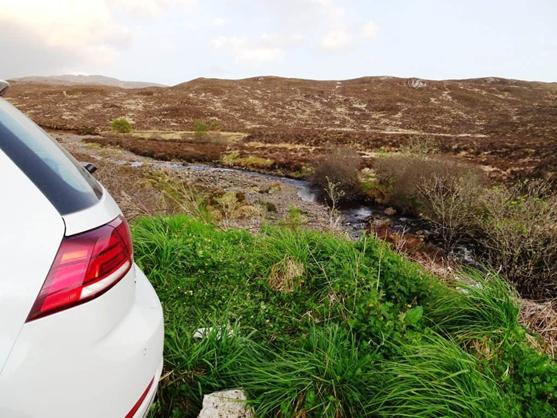
We do like to
get away from folks more than that. Besides, Steve had fallen and dislocated
his hip, which remained very painful, so we decided to foreshorten our trip and
flee home via Hawick, Della's father's birthplace. It is a bit ironic when he
goes to all sorts of truly wild places and comes back whole, yet falls on a
virtual lawn in a paddock near the ruined keep above and hurts himself
badly...We had planned to be away too long anyway. We should stick to a maximum
of ten days, I think. Three weeks is just too long. I worry about the sheep -
and the dogs.
On the way,
there was one place which was deserving of further exploration along the River
Spean:

The
Cairngorms though seemed to us to be just a repetition of the West Coast and
Skye. Dreadful (Steve Ends)

Della again:
'I love old
traditions and pride! Hawick, the little Scottish border town of my forebears,
is currently holding its annual Common Riding, a festival dating back centuries
that celebrates the annual tradition of riding out to check the security of the
town borders as well as a famous historical victory when a group of youths
overcame an English raiding party and seized their standard whilst the men of
the town were all off at war. The celebratory events are spread over several
weeks, reaching a peak this weekend. I just love this little video of
yesterday's pomp and splendour, compiled by the local newspaper. What a
wonderfully joyous town to be part of!
https://www.facebook.com/TheHawickPaper/videos/451537921948712/UzpfSTEwMDAwMTc2MTU0NzA0MDoxNjg0MDgyMTg4MzI3MTUw/
See
Also:
http://www.theultralighthiker.com/convert-a-car-to-a-camper-for-50/
http://www.theultralighthiker.com/genius-strainer-post/
http://www.theultralighthiker.com/happy-birthday-ultralight-hiker-2/
http://www.theultralighthiker.com/mattresses-i-have-known/
20/07/2018: How Warm a Bag or Quilt Do I Need? I was asked
this by a friend of mine who was planning his first overnight hunt (in winter)
years ago in an area I often visit too. I have never needed a bag warmer than
-1 to -3 C (and weighing just over half a kilo) even though I often sleep out
in winter - indeed I prefer winter camping. The weather is usually drier and
more stable, the night sky clear and brilliant with a billion stars, birdsong
and the wild dingo's call carry so much farther on the frosty air - and you can
have a cheery toasty fire with perfect safety. Once you are away from vehicle
tracks there is no shortage of firewood, so you can build your fire as large as
you wish. You can always put a few more clothes on if it gets a bit colder, or
get up and put another log on the fire!
In my hand is
my trusty old -1C Montbell Ultralight Spiral Stretch #3 down
bag compressed down to 2 litres in one of these: http://www.theultralighthiker.com/a-tardis-folding-space/


He bought the
biggest warmest sleeping bag available. probably something like -15 or 20C and
weighing several kilos - and he froze. He was so unhappy about it, he threw the
bag, the tent and the back pack in his breakfast fire and never went winter
camping again! He is like that: pig-headed. Some people have an aversion to
learning from their mistakes.
I had told
him also what mat I normally used - back then it was a Big Agnes Insulated Air Core which they
claimed (correctly) was good for around 15F, so I had always been warm enough
with it. Back then they only cost about US$50! And what did my friend take? You
guessed it. A blue foamy! He had spent literally hundreds of dollars on the
warmest sleeping bag he could find, and went away with a $5 mat which had
practically no insulative quality at all!
Winters here
in Victoria it rarely gets below about -10C, mostly not that cold. Of course
high up is worse. The general rule is that temperature drops by .6-.8 of a
degree Celsius for every 100 metre increase in elevation - and windier spots
are worse of course - why you have a shelter of some sort, such as a tent
really, rather than a bivy bag or swag. However, there is a 'sweet spot'
neither at the bottom nor at the top which is the 'ideal' place to camp -
provided there is water and a flat spot (unless you are hammock camping) where
you get the warmest conditions of all. The cold from the top does flow down the
hill and pool at the bottoms in the mornings, so you often have a frosty morn
just before daybreak along the river bottoms.
The human
body makes something like 150 watts of heat which is quickly dispersed unless
it is covered by some kind of insulation. Insulation just slows this heat loss
by a certain number of watts per square metre per unit of time. The higher the
'R' or 'Clo' rating the more that heat loss is slowed. Thinking only about the
rating of your bag ignores where your body is losing heat. It is possible (even
likely) that the ground is colder than the air and/or that conduction of heat
may mean that you lose more heat to the ground to the air (radiation and
convection). Further your body weight compresses the insulation in your bag and
reduces its insulative ability so that it may approach zero where you are
heaviest - and that is just where you will lose the most heat, and be coldest.
So, the most
important thing to have is not the warmest bag, but the warmest mat! Obviously
you are going to lose at least half your heat downwards, probably more. If you
can substantially stop or slow this, you will not need such a warm bag or
quilt. A brush or fern bed will help enormously at little cost or effort.
Further, as you can wear some clothes to supplement the bag, clothes which you
would need anyway, you can reduce the weight of the bag in this way.
I usually
carry a down vest and coat, and of course wool longsleeve top and longjohns (in
winter). I also own down trousers, though it would have to be very cold indeed
for me to need them. However, as they only weigh around 200 grams they are a
better (weight-wise) investment than the same (increased) weight of sleeping
bag would be, particularly as clothes keep you warm too when you are not in
bed. When it gets colder, I usually put on the down coat and slip my legs into
the down vest. I also have a pair of down socks, which I heartily recommend.
This strategy allows me to be comfortable down to probably -15C.
If I were to
use a warmer mat than my normal Thermarest Neoair Xlite Womens, I would be
comfy down to a much lower temperature, say -20C. That is one of the reasons
why I am investigating the Thermarest X-Therm and some other cold weather pads - not to
mention that I have a birthday coming up! With only half the heat loss, your
bag will feel at least 5C warmer - and a warmer mat adds much less weight than
a warmer bag or quilt. For example. a 5'6" Womens weighs 340 grams (R=3.9)
. An X-therm (R= 5.7) cut down to the same length will weigh 394 grams. Only 54
grams for probably a 10-15C increase in warmth! That 5.7 r-rating equates to
comfort at around -24C or -20F. Warm enough for you? Another way to think about
it is that if you are not losing heat to the ground you can 'afford' to lose
twice as much heat to the air - and it is harder to lose heat to the air. Air
is itself a good insulator. That is, if you have been cold outdoors (like my
friend was), there's a very good chance it was your mat's fault, not your
bag's.
Of course it
is also true that the insulation in the bottom of your bag doesn't do much good
(being compressed) so that you might be better off with a bag which has no
insulation there at all (eg the Zpacks bag - but more in the top) or
even a quilt - same principle. Some bags also have more insulation at the leg
end on the theory that you can put a warm coat on the top half of your body.
In either case
down is still warmer weight for weight than any synthetic insulation available.
it pays to keep your sleeping bag dry anyway (eg by not breathing or sweating
in it) as it will both become heavier and lose some of its insulative ability -
though the myth that down has no insulation effect
when wet is simply not true.
I encountered
a girl on the Dusky Track in 2009 (when I pack rafted
the Seaforth River) traveling with someone with the remarkable name 'Caspar'
who simply could not be broken of the habit of having her head inside her
sleeping bag and breathing in it to warm it up. During one afternoon and
evening I loaned her all my warm clothes and sleeping bag whilst her partner
tried to dry her bag out before a very measly fire at the Lake Roe Hut where
there is just about zero firewood. I even let her use my coat and vest
overnight, but she was still not convinced that she was causing the problem by
breathing inside her bag. She was having a very miserable trip of it and I much
doubt she has gone hiking often again.
PS: If you
find your eg -1C bag is not quite warm enough, you can add some down to it, as we did in
preparation for my Everest trip in 2016 where it can really
easily get down to -20C.
PS2: Of
course it also pays to keep your nose warm: http://www.theultralighthiker.com/are-you-beautiful-in-the-buff/
Just a
reflection: My sleeping bag, mat and (poncho) tent (including groundsheet) take up about
3 litres of space in my pack and weigh less than a kilo altogether. I am almost
without a doubt warmer, drier and more comfortable in them than someone with
one of those giant canvas swags you see piled up on the back of every SUV ute
heading 'up the bush' on weekends. Here I was set up on the upper Wonnangatta which I
pack rafted back in November. (Plenty of firewood and no-one else there!)
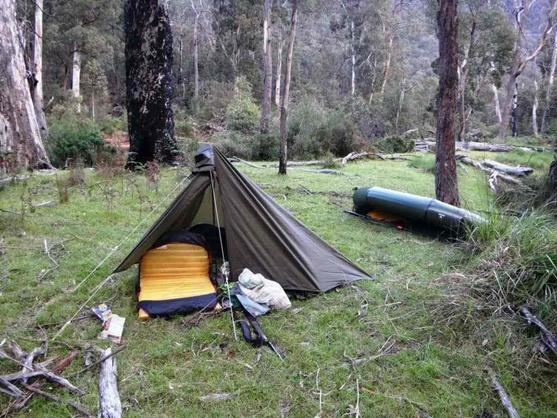
Those guys
with their swags usually have a 'comfortable' 2" open cell mattress. How
bad is that? What sort of R-rating do you suppose? Nowhere near the X-Lite
Women's even. Then, if it rains, that cold water (a much better conductor than
air - as much as twenty times better), is stripping their body's warmth away as
quick as thought. A swag is just the most dreadful device and an awful
encumbrance to boot. I made one once in my early years of hound hunting. After
an awful cold night in a puddle on a mountaintop waiting for dogs, I went back
to my K-Mart $20 dome tent. Much warmer, more spacious, drier and
cheerier. But the set-up above (including the Cyclone Chair), is superior by far.
See Also:
http://www.theultralighthiker.com/womens-are-great-in-bed/
http://www.theultralighthiker.com/cold-season-pads/
http://www.theultralighthiker.com/i-followed-my-footsteps/
http://www.theultralighthiker.com/adding-down-to-a-sleeping-bag/
http://www.theultralighthiker.com/dusky-track-canoeing-the-seaforth/
http://www.theultralighthiker.com/new-zpacks-sleeping-bag/
http://www.theultralighthiker.com/montbell/
http://www.theultralighthiker.com/the-pocket-poncho-tent/
http://www.theultralighthiker.com/pack-rafting-the-remote-wonnangatta/
http://www.theultralighthiker.com/cyclone-chair/
19/07/2018: Fox Airlite 100 Series Air Chamber Pad: This pad is
on sale right now for US$0.00 (18 July 2018 - you will have to pay freight)
which has to be pretty much an unbeatable price! Because of its integrated foot
pump it may be an excellent candidate to add some down to (as I posted about here) if you want to make yourself a
cheap cold season pad: https://www.foxoutfitters.com/airlite-100-series-air-chamber-pad/ As you can
see it comes in a 24" width (and 3 1/2" thickness) and could easily
be cut down to length.
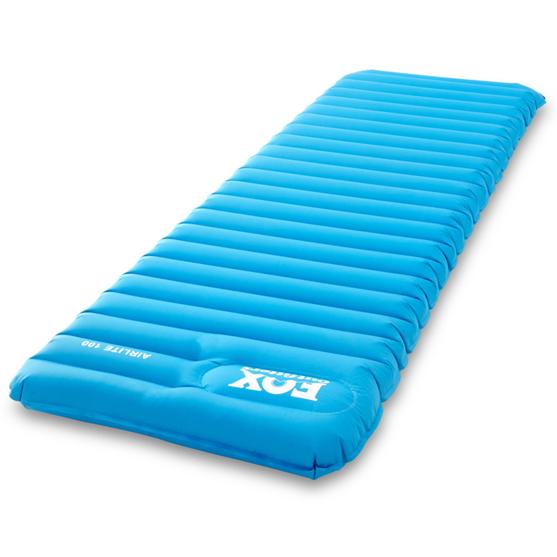
Specs &
Features
Thickness::
3.5"
R-Value:
1
Unrolled
(Long)::
24" X
78" X3.5"
Rolled
(Long)::
13" X
5" X 5"
Weight
(Long)::
1.8lb
Unrolled
(Regular):
20" X
72" X 3.5"
Rolled
(Regular):
12" X
5" X 5"
Weight::
1.5lb
18/07/2018:

17/07/2018: DIY firearms success in the US: The guy who
invented the printable gun has had a huge win in court. Interesting times: https://www.wired.com/story/a-landmark-legal-shift-opens-pandoras-box-for-diy-guns/
16/07/2018: White Moose: Just as the ‘polar bear’ is only a
‘sport’ of the grizzly bear, so every now and then nature throws up another
white creature better adapted to an environment of snow and ice: https://www.youtube.com/watch?v=0JoHGwSdRak In a similar
vein, over the years I have seen both a striped fox and a dingo. (With thanks
to Marg Tustin for the video)

https://www.youtube.com/watch?v=0JoHGwSdRak[/
I doubt I
will see one in Fiordland though - mind you it would stand out!
See Also:
http://www.theultralighthiker.com/the-lure-of-the-moose/
15/07/2018: The Mountain Gnomad: This young
Kiwi chap Arash Tahan contacted me recently about his plan to spend a couple of
years tramping and hunting the South Island of New Zealand. What an admirable
idea. If I was 40-50 years younger (and unattached) I can imagine doing so too,
but I have had my own adventures and continue to have the odd one still!
Anyway, he has now started out. I thought you might like to check on his progress
from time to time. Currently he is in one of my favourite places, Fiordland.
May he see a live moose! And hopefully not shoot it.
Here is what
he proposes to do:
'18 months of
solo hunting on public land; for either red deer, chamois, or Tahr. All the
while embracing the spirit of adventure, the dirt-bag lifestyle, and the
utterly refreshing freedoms which accompany them - such as being broke, growing
unruly, lice-infested facial hair, eating road-kill whenever my efforts in the
bush aren’t rewarded, and wearing the same pair of underwear for months on
end…mum will be proud.
I’ll live on the road between hunting trips and work odd jobs for farmers and
other rural folk, in return for brief accommodation or petrol/food...'
There is
going to be some spectacular photography:

Some great
stories...This one begins well: 'Broken logs. Frosty, serrated tussocks. Soggy
ground. I clawed and flinched my way along the edge of a swampy clearing; all
the while fastened on my destination - a North facing spur, roughly two
kilometers away. A likely spot for deer to bathe themselves in the warmth of
the morning sun...'
Even some
interesting poetry:
'I yearn for
a change of scenery.
An
opportunity to escape.
A reason to
greet each morning
with a smile
upon my face.
To hell with
conventional living!
‘Tis never
done me any good.
A heavy pack
is all I need,
and a rifle,
with walnut wood.
I will set
off on a big adventure
The horizon -
my guiding star
I will
explore the entire Southern Alps,
traversing
mountains, near or far.
Weathered and
wily deer I’ll seek
Perhaps a
chamois or two
I’ll drink
from the deepest alpine tarns,
and pen
experiences I shall never rue
And during
the final hours of my journey
As the sun
sinks through the sky
I will hope
that my handful of learnings,
will serve me
‘til the day I die.'
Already
really more or less at the very beginning of his adventures, there are some wondrous
things. It is going to be a great year. Anyway a great read for we voyeurs at
home who can only dream of trampming the mountains of Fiordland with just
a pack and a rifle. Check out his web site and blog here: http://www.themountaingnomad.com/blog/the-game-plan
And good luck
to you Arash, and happy hunting!
PS: This
seems to be a bit of a NZ thing. See eg my earlier post: http://www.theultralighthiker.com/thrilling-tales-6-new-zealands-remotest-family/
Another
couple have spent seven years living in trh NZ wilderness. There is a book and a Youtube:
See Also, eg:
http://www.theultralighthiker.com/from-dawn-to-dusky/
http://www.theultralighthiker.com/hunting-in-fiordland/
http://www.theultralighthiker.com/south-coast-track-fiordland-nz-waitutu-to-westies/
http://www.theultralighthiker.com/the-lure-of-the-moose/
14/07/2018: Magic Places: Traralgon Railway Reserve: Della: 'Milo
wanted to show me one of his favourite places today: the Traralgon Railway
Reserve, where he loves to feed the ducks. The ducks and pseudo-ducks were very
happy to see us!'
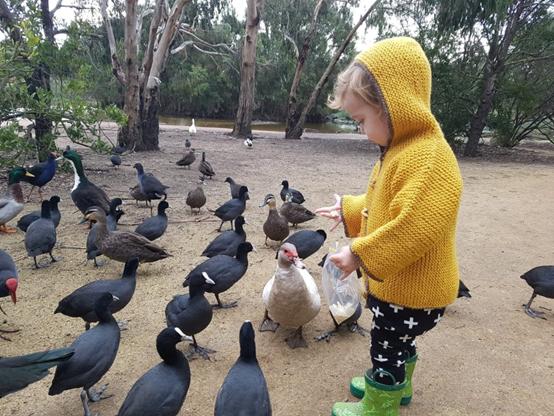
[embed]https://www.youtube.com/watch?v=KH5_sdcO8BI[/embed]
So many
magical places hiding just around the corner! PS: Isn't it great to have a
grandson with the same love of the great outdoors?
See Also:
http://www.theultralighthiker.com/moe-yallourn-rail-trail/
http://www.theultralighthiker.com/yarra-falls-shelter-house-2/
http://www.theultralighthiker.com/stealth-camping/
http://www.theultralighthiker.com/sale-common/
http://www.theultralighthiker.com/a-birthday-treat-mirboo-north-rail-trail/
http://www.theultralighthiker.com/invisible-worlds-the-weir/
http://www.theultralighthiker.com/morwell-river-falls/
http://www.theultralighthiker.com/gippslands-hidden-secrets/
and etc...
14/07/2018: The oldest Odyssey: http://www.thehistoryblog.com/archives/51974
14/07/2018: Don’t throw those old blurry snaps away. Have a look
at how the syncroton brings them to life: http://www.thehistoryblog.com/archives/51980

13/07/2018: Pine Down Blanket: Ultralight on a budget.
Over at Massdrop they have this interesting 3 season down quilt for just
US$99.99 (July 2018). It can be used as a blanket or a quilt due to some
interesting innovative features. If you pair it with their Massdrop Klymit Ultralight V Sleeping Pad at only
US$59.99 you have a very cheap warm weather sleep system. Reader Muzza has this
to say about his: ‘The Klymit Massdrop pad with a 4.4 R rating,light (is) way
comfy. I’m playing with it and the Massdrop Pine Down Quilt (US99 Jul 2018).
Slept in 3C the other night in Bendigo (Victoria Australia) with only a cheap
thermal top and bottom on. Had a puffy jacket and beanie and socks at the ready
and didn’t need them.’ These should be a really good option for the warm(er)
weather hiker on a budget to consider.

Specs
Shell
material: 20d 1.1oz downproof nylon
Insulation:
850-fill Allied HyperDry down (RDS certified and bluesign approved)
Temperature
rating: 40º F (4.4º C)
Loft: 2 in
(5.1 cm)
Sewn-through
baffles
Baffle width:
4.25 in (10.8 cm)
Cord channels
along each side
Hidden
stretchy cords and cord locks along short sides
3 pairs of
snaps along the side
4 hang loops
Open
dimensions, W x L: 54 x 86 in (137 x 218 cm)
Stuffed
dimensions: 8 x 11 in (20 x 28 cm)
Blanket total
weight: 19.2 oz (544 g)
Insulation
weight: 10.5 oz (298 g)
Stuff sack
weight: 0.4 oz (12 g)
https://www.massdrop.com/buy/massdrop-pine-down-blanket
If you are
abit more 'cashed up' you might consider the Enlightened Equipment Quilt: http://www.theultralighthiker.com/a-quilt-for-all-seasons/
See Also:
http://www.theultralighthiker.com/ultralight-hiking-on-a-budget/
http://www.theultralighthiker.com/budget-pack-mods/
http://www.theultralighthiker.com/cosco-quilt/
http://www.theultralighthiker.com/brawnys-tarptent/
http://www.theultralighthiker.com/cheap-insulated-inflatable-pad/
http://www.theultralighthiker.com/ultralight-ultracheap-backpack/
http://www.theultralighthiker.com/60-diy-ultralight-hiker-ideas/
http://www.theultralighthiker.com/emergency-cb-radios/
http://www.theultralighthiker.com/klymit-ultralight-pillow/
http://www.theultralighthiker.com/diy-dry-back-hiking-pack/
11/07/2018: Pack Raft Saves The Day: Della and I
had a foreshortened trip on the Wonnangatta River upstream of the Moroka
confluence when she developed a bad chest infection on the second night out
which turned out to be pneumonia. Fortunately I had brought along the Alpacka
'Fiord Explorer' raft, their 'moose boat' as they termed it (now the 'Mule'),
so we 'enjoyed' a rather bumpy and crowded ride downriver to our car for around
four hours. I'm not sure how otherwise I would have got her out, save
'Helimed', Victoria's helicopter ambulance, an excellent service I have not
(yet) needed to avail myself of - but we are paid up members!
We saw nine
deer in the four hours walking in, mostly just honking at us and running away.
During the night when we were sitting on our Cyclone Chairs in front of a cheery fire a
whole troupe of sambar came by and gave us an entertaining chorus for ten
minutes or so from not more than twenty metres away. You could actually see
their eyes shining in the fire light, Delightful. We were only half way through
our hike, so we will be back.
I'm afraid it
is impossible to get 'good' photos when two of you are squeezed into a raft
that is only 4' 6" long inside. Bad angles, difficulty focusssing &
etc. They now call this raft the 'Mule'.

I was told
never to publish this photo of Della because she thought she looked and felt terrible.
Well she did feel terrible, but she always looks good to me!

She
heroically had to struggle along boulder-hopping during portages whilst I
carried the boat and the packs.
It is a
lovely river as you can see in the background of the shots. If you really want
to have a good look at it, try these two posts: 
http://www.theultralighthiker.com/pack-rafting-the-remote-wonnangatta/
http://www.theultralighthiker.com/remote-wonnangatta-day-two/
It is not yet
time to trade her in though. We'll try again. I have this really lovely
campsite about six hours walk (for me) from my car which I really want her to
spend a few days at (thought it would be this trip) - followed by a relaxing
raft drift down the river on the way out. It didn’t quite work out that way
though…
PS: We have
been back a number of times. Next summer (2018-9) I plan to spend several days
with Della pack rafting down from the Humffray Confluence to Eaglevale. It is
one of the loveliest trips I know of anywhere.
She looked a
lot happier in this post from 2017:
http://www.theultralighthiker.com/pack-rafting-the-wonnangatta-mitchell/

In case you
are thinking Della is a chapter of accidents, this was her only other disaster:
http://www.theultralighthiker.com/10-days-in-fiordland/ dislocating
her shoulder on the Dusky Track and having to be helicoptered out to Invercargill.
However,
these two illustrate perhaps what I said in my 'About' post: 'I have camped out a lot,
more than two years plus of my life in total. I have seen the failure of just
about every type of gear, and experienced just about every disaster which can
befall you in the wilderness, and survived.' See also: http://www.theultralighthiker.com/trapped-by-flood-waters/
Published on:
Nov 19, 2011 Updated with pics etc July 2018.
10/07/2018: Trapped by Flood
Waters: 'I got away up the bush for a few
days recently. Lots of rain came in. The rivers were in flood, went up
over 2 metres and home was on the wrong side. Also discovered that the seam
sealer tape on ultrasil dry bags deteriorates - my sleeping bag and all my gear
was saturated wading through chest high water. Spent a rather uncomfortable
night getting dry. (NB: Body warmth will dry everything out eventually - as was
pointed out here, it is just not true that wet down has no insulative
properties: http://www.theultralighthiker.com/andrew-skurka-on-down-versus-synthetic/)'.
Just look at
the amount of debris the river brought down with it - acres and acres of fallen
timber.

I wrote this
back in 2010 when the rainfall forecast had me failed and I found myself for a
few days on the wrong side of a very swollen river. Nowadays I usually have supplies stowed in a drum for such an
eventuality. You could easily have to wait it out for a week or so until the
flood subsides!
This was back
when, though I owned a digital camera I still had not somehow got my head
around the fact that photos are now virtually free. Growing up with film
cameras where every snap cost say a dollar or more, you become quite stingy of
taking 'trivial' photos, so I don't have actual photos of the flood, roaring water,
etc. Next time...I went on:
'I saw lots
of deer though no good stags and had a good time really. An interesting test of
myself and various gear. Learned a lot. Many things I can improve. Finally swam
out (using my inflatable mat and pack tied together as a raft/kick board – as I
have done many times before) and am home safe'.
A nice sunny
day followed anyway for drying out the camp. You would not think on that slight
slope that your groundsheet would soak through, but during the night I guess
1-2 cm of water was flowing through the tent. The pressure of my bum was enough
to increase the water pressure so that the waterproofness of the Tyvek was
exceeded. A lesson there.
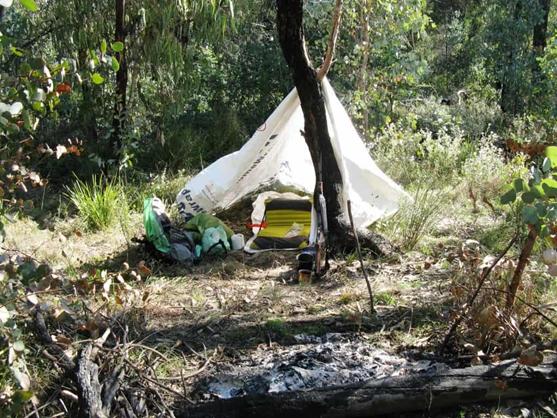
'I had a
Tyvek tent floor and Sea to Summit Ultrasil drybags leak through (also a wet
sleeping bag is not much fun!) and Tyvek is twice as waterproof as silnylon. I
think this guy has the solution to increasing waterproofness. (Also his Supercat stove
is excellent): http://jwbasecamp.com/Articles/Silnylon1/index.html'
I tried this
waterproofing method out on the floor of a Mountain Laurel Designs Supermid we
carried on our cross Tasmania hike in 2011 and it worked
a real treat. The ground was very sodden in some places we had to camp in
Tassie but all our stuff stayed nice and dry - as well it needed to since we
were nearly 8 days on the trail without resupply or any other shelter.
About the Sea
to Summit Ultrasil Dry Bags. I would not hesitate to
recommend these as pack liners and to keep your essential gear dry in your
pack. Apparently I had some of the earlier ones which had a fault (the tape
peeled). After this episode we part- filled each one with water to see whether
they leaked. Then we contacted Sea to Summit. Without even seeing the leaky
bags (which we could repair with seam sealer, truth be told) they sent us new
replacements which now have lasted many years.
I have even
swum rivers with them, and used them in canoes and pack rafts where gear can
get pretty wet (eg here and here) - but they have never failed me
again. I am also most impressed by the company's after-sales service. I have
experienced it also with a Black Diamond torch (from them) on which a part
broke - and they sent me the new part by express post same day. No questions
asked!
I spent a
couple of days trying to find a (safe) way across the raging floodwaters. I
walked upstream for about ten hours for example, but there was no safe place to
cross. A couple of times I found a spot where a large log spanned the torrent
but with the water lapping up to its underside. Downstream there was always
some huge tangle of debris or ruinous rapids such that if you slipped in you
would be swept to your death. You must cross where the river is widest and the
current least - but best to wait it out!
You have to
be very careful with river crossings if you don't want to end
up dead earlier than you would like. The corollary of this is folks who fanny
about overmuch trying not to get their feet wet. Hazards
will occur in the back country. Be prepared for them, and be careful. Be
especially able to light a fire in the wet.
However, this
post and this illustrate perhaps what I said in my 'About' post: 'I have camped out a lot,
more than two years plus of my life in total. I have seen the failure of just
about every type of gear, and experienced just about every disaster which can
befall you in the wilderness, and survived.'
See Also:
http://www.theultralighthiker.com/what-to-include-in-a-wilderness-cache/
http://www.theultralighthiker.com/mld-supermid/
http://www.theultralighthiker.com/south-west-track-tasmania/
http://www.theultralighthiker.com/tasmanias-south-coast-track-hells-holiday/
http://www.theultralighthiker.com/dusky-track-canoeing-the-seaforth/
http://www.theultralighthiker.com/pack-rafting-the-remote-wonnangatta/
http://www.theultralighthiker.com/river-crossings/
http://www.theultralighthiker.com/river-crossings-2/
http://www.theultralighthiker.com/why-you-should-get-your-feet-wet-when-hiking/
http://www.theultralighthiker.com/how-to-light-a-fire-in-the-wet/
http://www.theultralighthiker.com/pack-raft-saves-the-day/
Published Nov
30, 2010
This was by
no means the only time I have been 'trapped by flood waters'. I can remember
the farm I grew up on being isolated for many days during the 1955 floods in
the Hunter Valley for example. Once when I was a teenager I traveled on my
motorbike to a fairly remote sheep station in Western NSW (someone I had gone
droving for in years gone by) arriving at the shearer's quarters late at night
after several small creek crossings. No-one at all knew I was there. I had
intended to go into the small town about twenty kilometres away in the morning
to buy supplies. Instead the heavens opened and I was cut off there for a week
with only my trusty .22 Lithgow for company. What a treasure it was. Every day
I was at least able to feats on rabbit, kangaroo, galah etc. I was pretty sick
of burned and boiled meat seasoned with wild onions, cress etc after a week of
it I can tell you, but I was no worse for the wear!
See Also:
http://www.theultralighthiker.com/brer-fox/
http://www.theultralighthiker.com/how-to-have-fun-when-hiking-in-the-rain/
http://www.theultralighthiker.com/mattresses-i-have-known/
09/07/2018: Have you tried the new Pulse Pasta? Made only
from beans and peas instead of grains – and so much better for you. Especially
if you have a blood sugar problem. Also gluten free. We have and found it
delicious. It has more of a nutty flavour than normal wheat pasta: https://sanremo.com.au/products/pulse-pasta-spaghetti/

Of course you
will need a sauce to go with it. We have successfully dehydrated Campbells
canned Spaghetti Sauce which rehydrates well on the trail. Another suggestion
is the powdered Continental Spaghetti Sauce with the addition of some salami or
rehydrated jerky and some dehydrated tomato (you can use some Continental
Cupasoup Tomato flavour for example).
Another idea
which we quite like are the Gravox dehydrated flavored gravies eg French Onion,
Mushroom Sauce & etc. The addition of some salami to them will make quite
an acceptable meal. They go fine with this pasta – or with some Continental Deb
Mashed Potato. They also go well with Chinese sausage (which you should save the
from so that you can have falafels for breakfast.
See Also: http://www.theultralighthiker.com/a-hiking-food-compendium/
http://www.theultralighthiker.com/this-book-may-save-your-life/
08/07/2018: Ultralight Pack Raft: Supai Adventure Gear say, ‘At just 14
ounces, our pack raft paddle is the lightest on the market…When combined, our
pack raft (24 ounces) and paddle (14 ounces)…weighs an astonishingly light 38
ounces (2 lbs, 6 ounces).’
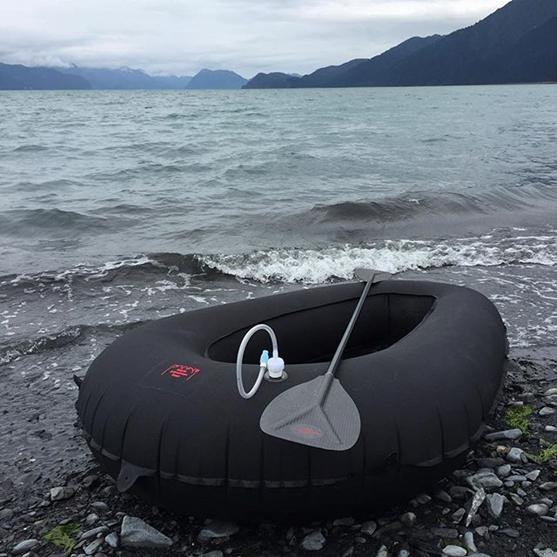
If you want
‘light’ these guys are the place to go! https://www.supaiadventuregear.com/ Their
pack rafts range from US$299-349 and weigh 24-28 ounces (685-798 grams) making
them just about the lightest on the market.
Naturally you cannot ruggedise
something this light, so they deem them suitable for mainly flat water – but
there are many such opportunities out there, and particularly if you are
carrying a boat just to get yourself across water obstacles on your route, they
might be a great choice (or for emergencies). That being said, these folks who
make them have even taken them down the Grand Canyon!
Probably their nearest
competitor is the Klymit Lite Water Dinghy raft I wrote about here: http://www.theultralighthiker.com/klymit-packraft/
It weighs 35 ounces (998 grams)
See Also: http://www.theultralighthiker.com/how-many-of-these-needed-to-make-a-pack-raft/
or Try a
search for 'pack raft' in the Search box at the top. Many pack rafting
adventures, including: http://www.theultralighthiker.com/pack-rafting-the-remote-wonnangatta/
07/07/2018: Wildlife Proof Fencing: There are
many kinds of theft. For farmers (such as us) one of the worst thefts
(after rules against clearing our own native vegetation on our ‘freehold’
property) is government (and others) stealing our livelihood by allowing their
livestock to stray onto our land. That is what wildlife and vermin are, ie
someone else’s stock. For example 1 kangaroo = .625 DSE (1 dry sheep equivalent
= eg one Merino wether/dry ewe).
Every day I
see a mob of over 50-70 grey kangaroos on the property next door across our
valley in just one 10 acre paddock where once we used to run 30-40 breeding
ewes when we leased it. (There are probably many many more of a night, plus
innumerable wombats judging from all the giant holes on the hillside). There is
no feed at all there now, and the roos are in poor condition, such that I would
invite prosecution if my sheep were so neglected – and of course they are also
heavily parasitised & etc.
Wombats, by
the way, in this Parish and many others are 'unprotected'. A farmer may legally
if s/he so desires shoot one any time at all, though I rarely do (only when
they are suffering terribly from mange, fly-blown and moaning etc - as they
often are because there are far too many of them). I prefer to fence them out,
if I can. There they can be someone else's problem to neglect as they see fit.
There is a veritable plague of wombats in the Strzeleckis. You should see the
damage they do in the forest where there is no vegetation - or soil at all
because of their ceaseless digging. They just have no predators any more except
cars. They are just giant rabbits.
The only
practical solution (though it is often not economic) is to fence the ‘wildlife’
out. Killing them will either earn you odium (or a penalty). Besides, more will
just move in until they reach the point where they are starving to death again
(apparently the chosen strategy of animal libbers and other ‘kindly’ souls). If
you fence them out they can at least starve to death on someone else’s land ie
on those who are responsible for their existence in the first place, so often
the government. The ‘rub’ is that the government will not contribute their half
to the construction or maintenance of the fence, as any other neighbouring
property owner must!
We
successfully built this type of fence on our last couple of properties and are
working our way around to doing so on our home property right now. The results
are quite astonishing – especially the build-up of small native herbivores,
carnivores and birds (things which are much more ‘endangered’) which are either
starved out by the large native herbivores or eaten by the foxes – the infinite
increase of which all seems to be the chosen management aim of those who would
have such things as eg ‘Land for Wildlife’ or ‘Trust for Nature’ and the like! http://www.theultralighthiker.com/vermin-proof-fence/
A picture is
worth a million words: (after just one month).
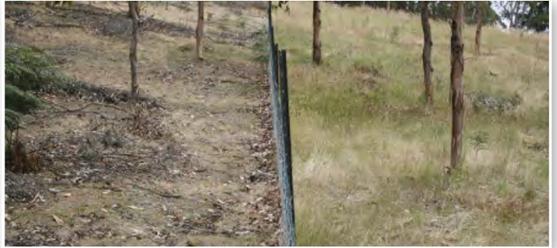
I’m sure you
can work out which side the native wildlife is on. Public land mismanaged thus
is just neglect - and animal cruelty. It is not something which should generate
a warm inner glow!

It is equally
absurd that whilst a landowner can easily obtain a permit to ‘cull’ an
insignificant number of the troublesome wildlife (say a max of 10% - including
eg up to five eagles, Really!) you are not allowed to make use of the carcasses
in Victoria – you may not eat them or feed them to your dog, even compost them.
They must be buried deeply. Who would comply with such absurd rules? Yet
kangaroos taste quite good. I was brought up on them actually.

See Also: http://www.utas.edu.au/__data/assets/pdf_file/0019/373501/Wallaby-proof-fencing-Tasmania-2013_web.pdf
07/07/2018: Why do people with any fat stores ever feel hungry? It is a very
good question, and there are some very good (brief) answers: ‘Our attitude is
that, if you have spare lard, feeling hunger is the happy sign that you are
burning fat rather than a signal that nutrition is needed. To burn lard,
embrace that feeling.’ http://maggiesfarm.anotherdotcom.com/archives/31895-Why-do-overweight-people-ever-feel-hunger.html
04/07/2018: How Many of These Needed to Make a Pack Raft? I recently
bought one of these for $A20 (July 2018) from K-Mart to play with. I wanted to
practice some seam heat-sealing with something available and cheap before I
began modifying an expensive hiking pad: http://www.theultralighthiker.com/axl-air-down-pad/ . I had in
mind that I would probably be able to make an inflatable pack frame with one of
them (You can make at least two as it turns out – more if you buy some extra
valves: https://www.diypackraft.com/shop/merchandise/valves/pressure-fit-inflationdeflation-valves/ ). The
material is quite heavy, so I wondered whether it would be suitable for a DIY
pack raft.
It looks very
similar to this one from Aliexpres for US$14.28 (July
2018) or this one from Amazon for US$24.11. Walmart
etc no doubt have them too - a double one might give more material at a lower
per square foot cost - and with more options.
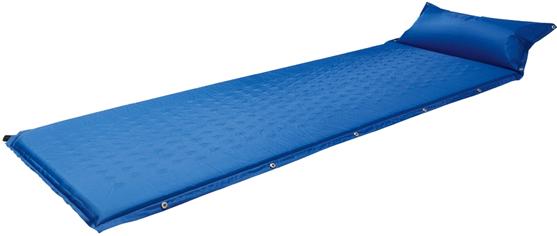
Some of you
have no doubt noticed my post about this back in 2011 where I reinforced a
cheap Intex brand raft with a blue poly tarp. (I have since seen these sold for
<$A30). We canoed 2 Grade 2-3 rapids with one all day with no problems at
all – only a very slight delamination of the cheap tarp was happening – but it
is easily and cheaply replaced (and you can carry a spare).


If you attach
it with tarp clips, this will be the work of a minute, and you can even use the
tarp for an overnight shelter! http://www.theultralighthiker.com/home-made-pack-raft/
It held up to 4 years stored in a drum in the bush quite well, such that
I was able to get it out for a trip in 2015: http://www.theultralighthiker.com/not-quite-alone-in-the-wilderness/
and put it back in the drum again against future need.

After
perusing some pack raft making instructions eg here: https://www.diypackraft.com/construction/how-to/v2/
and here: http://blog.hillmap.com/search/label/Homemade%20Packraft
and looking at some simplified pack rafts which are available to be
purchased eg http://www.theultralighthiker.com/klymit-packraft/
and : https://www.supaiadventuregear.com/
I am definitely of the opinion that the DIY pack raft is a worthwhile
project, and that there are simplified designs out there which will work quite
well. (PS: I also rather liked this guy’s DIY pack raft catamaran: https://www.diypackraft.com/2018/06/13/tims-pontoon-kayak-version-2/
)
The K-Mart
pad is comprised of two sections: an approx 5’ x 2’ pad and a 1’ x 2’ pillow.
Both have valves, so you get approx 24 square feet of quite tough fabric for
A$20 (July 2018), which compares favorably to the ‘genuine’ heat sealable
materials at perhaps US$14 plus delivery per yard (ie 15 square feet).
I admit the
‘exercise’ is mostly about ‘Can you do it?’ rather than ‘What’s the best way to
make a pack raft?’ but still, I think you should get a serviceable raft
out of perhaps four of these pads which you can pick up today for A$80 total.
Geniuses will no doubt make something out of three (or even two!)
You will also
need a heat sealing iron (which you would anyway) such as those readily
available for aircraft modeling and other hobby activities, eg: https://www.diypackraft.com/construction/tools/
These cost around $20.
K Mart’s A$20 pad.
https://www.diypackraft.com/
Another DIY Pack Raft supplier: https://iron-raft.co.uk/
A couple of cheap pack rafts for these who can’t be
bothered making their own:
https://www.klymit.com/litewater-dinghy.html
https://www.supaiadventuregear.com/
eg https://www.supaiadventuregear.com/products/canyon-flatwater-boat-manufacturing-seconds
at 24 oz 685 grams
03/07/2018: Several Winter's Fires: I have been
busy building a new wood shed and stocking it with rather more than my favourite
poet Edward Thomas' 'recommended' 'Fifty Faggots'. I can get
the wood to this one no matter how wet the paddocks are, and simply throw it
straight off the tray and into the shed. It has plenty of height for block
splitting, and a dry place to stand when I am doing so. This is luxury. I am
also lining the shed with corrugated iron so that when I throw the wood in it
does not shake the cladding off. I have also equipped the walls with several built-in
possum nests and don't doubt it won't be long before the possums find them and
move in.
There will be
16 possum platforms in the walls of the shed when I have finished cladding it.
I plan to build similar boxes for possums, parrots, kookaburras etc on
every strainer post (and elsewhere) over time. It is a delight to share your
home with these wild creatures too.

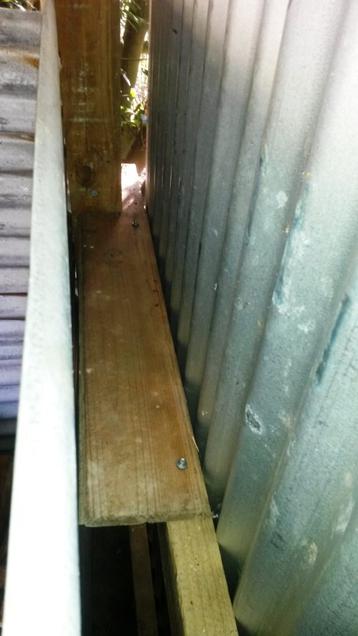
The frame up
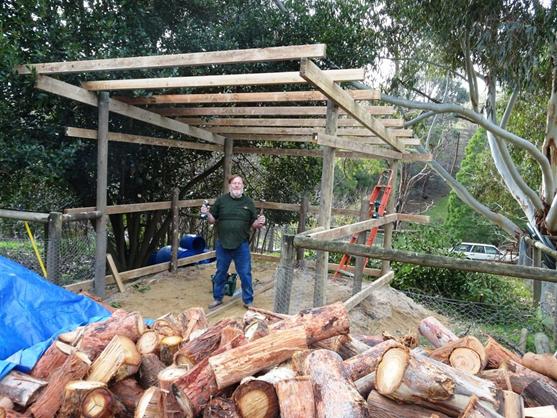
Of course I
am not quite finished yet. I have to suspend operations at this point to get
the sheep and fences ready for lambing. I have at least a week's hard work on
the latter project so that we can minimise losses to foxes. I am finding all this particularly
heavy going this year as I seem to have torn the cartilage in my left knee -
pretty much just standing in the paddock playing with a new drone which I hope
will simplify getting the sheep into a fox-proof area every night during
lambing. You can see how well that will work here: http://www.theultralighthiker.com/drone-hunting/
Ant ten
tonnes of wood in - this was hard going yesterday with this agonising knee.
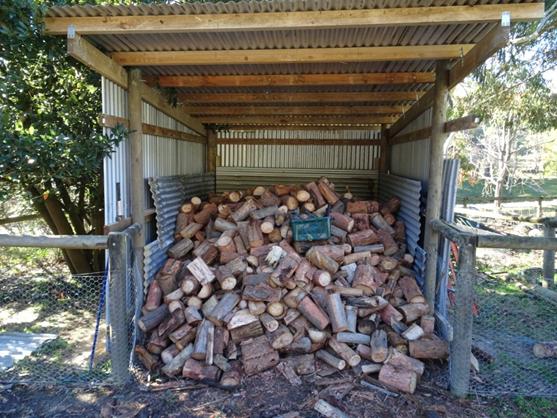
This is the
belated beginning of the replacement of the old Buggy Shed (1924) hopefully with something
which will last just as long (or longer). Later on in the year I will be
building a workshop in its place complete with hoist for working on our many
old cars - after nearly half a century of lying underneath them!
Interestingly, I am lining the new wood shed with iron off the old one.
Lysaghts Newcastle - where I worked briefly during the 1960s sure made good
galvanised iron back then. if the new iron on our house roof lasts as well, it
won't need replacing for a very long time!
There are six
metres of bedding sand underneath that ten tonnes of firewood. (Other people
think 'work' is having meetings. They should look up the scientific
definition!) The wood should last us through to next summer. We have enough old
trees dying, and enough new ones coming along to be largely self-sufficient in
wood - besides, we own a wood lot at the Eastern edge of the property, a patch
of bush I fenced last year much to the surprise of many local residents who had
long believed it was a public space. When they started riding motorbikes in it
though we had to act. We could not have the risk of such noisy idiots injuring
or killing themselves when trespassing on our land.
Here we
usually light our first fire around Easter and our last around Melbourne Cup
Day (Guy Fawkes Day if you are elsewhere than Australia). Of course we don't need
a fire every night in between. I have known days in July which were over 25C -
but i have also seen snow at Xmas. We have weather here in Southern Victoria,
whatever the meteorologists may think about 'climate change'.
It is a
lovely little warm sheltered valley here at Jeeralang Junction: we can have all
the cold season type of fruit (such as cherries - if the birds will leave us
any), but also we grow guavas, (sugar) bananas, mountain and American paw paws,
sapote - many things which you would expect to have only much further North. I
guess we have over a hundred different types of fruiting things growing in our
garden, and are adding to them every year. We are legends with all the local
parrots and currawongs - not to mention the possums!
See Also:
http://www.theultralighthiker.com/boastful-food-shots/
http://www.theultralighthiker.com/you-must-learn-to-shoot-your-own-dog/
http://www.theultralighthiker.com/you-will-not-live-forever/
http://www.theultralighthiker.com/my-life-was-wide-and-wild-and-who-can-know-my-heart/
http://www.theultralighthiker.com/rich-beyond-telling/
http://www.theultralighthiker.com/deer-oclock/
http://www.theultralighthiker.com/boastful-food-shots/
http://www.theultralighthiker.com/why-do-i-love-my-garden/
http://www.theultralighthiker.com/brer-fox/
http://www.theultralighthiker.com/only-the-moon-and-me/
http://www.theultralighthiker.com/a-tiny-life/
http://www.theultralighthiker.com/fifty-faggots/
http://www.theultralighthiker.com/in-troy-achilles-delivers-this-line/
http://www.theultralighthiker.com/pristine-beaches/
http://www.theultralighthiker.com/the-last-rebels/
http://www.theultralighthiker.com/most-travelled-cat/
http://www.theultralighthiker.com/birds-in-our-garden/
http://www.theultralighthiker.com/swallows/
http://www.theultralighthiker.com/thrilling-tales-daniel-boone/
http://www.theultralighthiker.com/welcome-swallows/
http://www.theultralighthiker.com/the-frogs-the-sequel/
http://www.theultralighthiker.com/the-wildlife-seems-to-get-wilder-everyday/
http://www.theultralighthiker.com/repurposing-camping-gear/
http://www.theultralighthiker.com/you-never-know-when-your-numbers-up/
http://www.theultralighthiker.com/venery/
http://www.theultralighthiker.com/her-craft-or-sullen-art/
http://www.theultralighthiker.com/not-such-a-dam-nuisance/
http://www.theultralighthiker.com/sour-grapes/
http://www.theultralighthiker.com/a-dam-nuisance/
http://www.theultralighthiker.com/things-that-keep-you-from-hiking-hunting/
http://www.theultralighthiker.com/lost-at-fromelles/
http://www.theultralighthiker.com/bend-that-knee-to-no-man/
http://www.theultralighthiker.com/progress-it-always-seems-more-than-it-really-is/
http://www.theultralighthiker.com/hidden-worlds-nocturnal-ants/
http://www.theultralighthiker.com/its-that-time-of-year-again/
http://www.theultralighthiker.com/bright-sky-at-night/
http://www.theultralighthiker.com/everyone-loves-a-good-fire/
03/07/2018: Our Valley of Plenty: Della: 'This
morning's light frost and valley fog has left us with a glorious winter day.
Climbing our hill just now to get the sheep down for their pre-lambing
injections I was struck anew by our wonderful home vista. I don't climb up to
see this every day, but perhaps I should: It has certainly given me a better
cardio workout than a morning at the gym! The power station steam is
Yallourn's, not Hazelwood's chimneys in the foreground which have sadly puffed
their last. Loy Yang is on the right hand side, visible to the naked eye but not
showing up amidst the mist in this picture. Our valley of plenty!'

We 'chose'
such a serendipitous spot to live (because it was at the time very cheap)
thirty years ago: in the winter we are just above the fog and just below the
cloud. The winter sunlight wakes us every morning streaming in our living room
windows brightly. Mid-morning we always witness the fog rising and wafting by
us quickly up the valley.
Our back
fence marks the beginning of a continuous band of forest which stretches all along
the South Gippsland Coast to Foster/Wilsons Prom so that we are often visited
by koalas, kangaroos, wallabies, deer etc - and of course by a myriad of
different bird species, including very rare creatures such as this one (http://www.theultralighthiker.com/white-headed-pigeon/)
and this (http://www.theultralighthiker.com/water-babies/) We
often take a walk further up the valley where there are enchanting fern gullies
and waterfalls. Just pottering around our (ever expanding) garden any day you will be
able to see (at any given time) a couple of dozen different species of birds
from any single vantage.
For more such
views (and video) see http://www.theultralighthiker.com/drone-hunting/
PS: We have
the first and most genetically diverse flock of Finnsheep in Australia which
has supplied hyper-fertile genetics to the Australian sheep industry and for
export for over thirty years. Ewes are just about to lamb - naturally bitterly
cold rain is forecast! If you want to purchase some (or find out more) contact
us via our website: http://www.finnsheep.com/index.htm
Finnsheep Quintuplets:

See Also:
http://www.theultralighthiker.com/you-will-not-live-forever/
http://www.theultralighthiker.com/my-life-was-wide-and-wild-and-who-can-know-my-heart/
http://www.theultralighthiker.com/rich-beyond-telling/
http://www.theultralighthiker.com/deer-oclock/
http://www.theultralighthiker.com/boastful-food-shots/
http://www.theultralighthiker.com/why-do-i-love-my-garden/
http://www.theultralighthiker.com/brer-fox/
http://www.theultralighthiker.com/only-the-moon-and-me/
http://www.theultralighthiker.com/a-tiny-life/
http://www.theultralighthiker.com/fifty-faggots/
http://www.theultralighthiker.com/in-troy-achilles-delivers-this-line/
http://www.theultralighthiker.com/pristine-beaches/
http://www.theultralighthiker.com/the-last-rebels/
http://www.theultralighthiker.com/most-travelled-cat/
http://www.theultralighthiker.com/birds-in-our-garden/
http://www.theultralighthiker.com/swallows/
http://www.theultralighthiker.com/thrilling-tales-daniel-boone/
http://www.theultralighthiker.com/welcome-swallows/
http://www.theultralighthiker.com/the-frogs-the-sequel/
http://www.theultralighthiker.com/the-wildlife-seems-to-get-wilder-everyday/
http://www.theultralighthiker.com/repurposing-camping-gear/
http://www.theultralighthiker.com/you-never-know-when-your-numbers-up/
http://www.theultralighthiker.com/venery/
http://www.theultralighthiker.com/her-craft-or-sullen-art/
http://www.theultralighthiker.com/not-such-a-dam-nuisance/
http://www.theultralighthiker.com/sour-grapes/
http://www.theultralighthiker.com/a-dam-nuisance/
http://www.theultralighthiker.com/things-that-keep-you-from-hiking-hunting/
http://www.theultralighthiker.com/lost-at-fromelles/
http://www.theultralighthiker.com/bend-that-knee-to-no-man/
http://www.theultralighthiker.com/progress-it-always-seems-more-than-it-really-is/
http://www.theultralighthiker.com/hidden-worlds-nocturnal-ants/
http://www.theultralighthiker.com/its-that-time-of-year-again/
http://www.theultralighthiker.com/bright-sky-at-night/
http://www.theultralighthiker.com/everyone-loves-a-good-fire/
02/07/2018:
Exped Synmat HL Winter M: My thanks to reader (Belle) for alerting me to the Exped Synmat HL Winter M (I had
overlooked) which weighs 430 grams and has an R-rating of 5.0 at 183 cm long 52
wide (35 cm at the foot) and 9 thick. You do need a 60 gram bag to blow it up,
but this also doubles as a pillow. This is an awesome pad. I only need a mat to
be 5'6' long, so I could cut this down to approx 394 grams.This is serious
competition for the Thermarest X-Therm that's for sure! (Same weight, slightly
lower R-rating ie 5/5.7, but over 1" thicker)

It also comes
in a wider configuration the SynMat HL Winter MW 65 cm at the
chest and 42 at the foot and 545 grams. This would come down to approx 500
grams at 5'6".
http://www.exped.com/australia/en/product-category/mats/synmat-hl-winter-m
http://www.exped.com/australia/en/product-category/mats/synmat-hl-winter-mw
See Also:
http://www.theultralighthiker.com/axl-air-down-pad/
http://www.theultralighthiker.com/cold-season-pads/
http://www.theultralighthiker.com/a-quilt-for-all-seasons/
01/07/2018: AXL Air Down Pad: I am thinking of
modifying one of Big Agnes' AXL Air Pads (by cutting it down say to 5'4")
and adding in approximately 4 ounces of Hyper Dry Down. This should give me a
pad which weighs approx 360 grams is 4" thick yet has an R-rating of
around 6.0 - so suitable for say -20C. The Hyper-Dry down should be water
resistant enough it should not matter if I blow it up directly by mouth.so long
as I hang it up to dry from time to time with the valve pinned open in some arm
sunlight eg next to my study window.
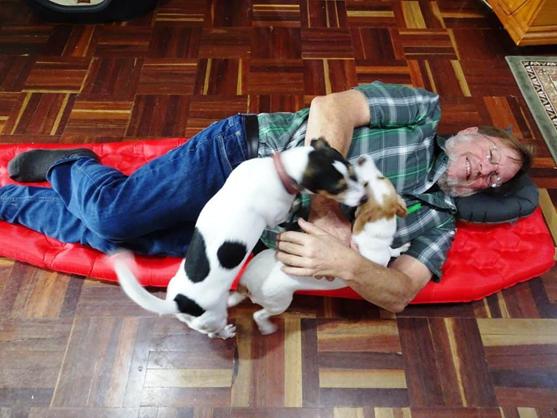
The down can
be purchased eg from eg Ripstop By The Roll for US$25 (800 fill)
to $38 (850 fill) per three ounces (plus delivery). The AXL Air pad starts at US$139.95 (July
2018). Note it also comes in a 25" width configuration. In this dimension
you could have a down filled pad that you can really luxuriate on at under 480
grams.
I do love my AXL Air pad - it is the most comfortable
night's sleep i have ever had in the back country - but it is not quite warm
enough for winter. I figure this mod will 'winterise' it.
PS: If I can wait for it I may be
better using this new Climasmart insulation from Downlite (as they seem to have 'solved'
the moisture retention problem: http://www.textileworld.com/textile-world/knitting-apparel/2018/06/downlite-introduces-new-climasmart-temperature-regulating-performance-fills/
PPS: As you
can see (below) a reader (Belle) has alerted me to an Exped Synmat HL Winter M
(http://www.exped.com/australia/en/product-category/mats/synmat-hl-winter-m
which weighs 430 grams and has an R-rating of 5.0 at 183 cm long 52 wide (35 cm
at the foot) and 9 thick. You do need a 60 gram bag to blow it up, but this
also doubles as a pillow. This is an awesome pad.
She also has
a point that some down would escape the AXL valve when you deflate it. I was
wondering how to attach some mesh on the inside of the valve (possible, though
a bit messy). Also technically I would only need 3 ounces of down to fill it
(85 grams) and I could cut the pad down with a taper (such as the Synmat has)
probably making the whole thing considerably lighter, possibly even less than
315 grams if you are short like me and can fit on a 5' mat. I still think this
might be an interesting option especially for a dedicated gram counter who
already owns the AXL Air pad.
The Synmat is
available from Summit Gear for A$ 219 (July 2018):
See Also:
http://www.theultralighthiker.com/modifyingshortening-hiking-mats/
http://www.theultralighthiker.com/massdrop-in-stock/
http://www.theultralighthiker.com/a-cure-for-slippery-mats/
01/07/2018: What a wave: https://www.youtube.com/watch?time_continue=130&v=bjKzJIu56oU
30/06/2018: No Cold Shoulder Spreader Hammock: I like the
spreader bar on this new hammock from Rei. This would stop that annoying thing
where the hammock fabric compresses the insulation of your sleeping bag at
shoulder-to-elbow and creates a cold spot.
There are
several other ways around this eg a wider mat, a pad extender, etc, but I feel that this is
genius and could also be done very lightly as a mod (by sewing in two
reinforcing patches and attachment points eg some webbing formed into tubes) to
any hammock and that the spreader could be as simple as a bent stick which
would go up above your head (towards the end of thr hammock so that it did not
interfere with getting into the hammock.
Only I am
resting a torn meniscus in my left knee today (and that it is raining) stops me
from getting out a hammock and the sewing machine and getting to work on
it. (You could probably even do it using a couple of tarp clips). I figure I
could do this without adding any more than 20 or so grams to the hammock. This
rivals that other wonderful spreader idea which allows two people to hang side by side
from just one pair of trees under a single tarp. Anyway, watch this space - my
knee cannot be stuffed forever (MRI Monday)!
The Rei Flash
Air Hammock system
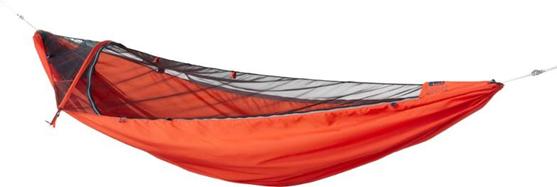
Detail of
their spreader bar

Rei Flash Air
Hammock System (including mosquito net, fly, etc) available here: https://www.rei.com/product/127400/rei-co-op-flash-air-hammock?cm_mmc=aff_AL-_-5889-_-7185-_-NA&avad=7185_e1262cadd
US$199.95 (July 2018) Weight:2lb 12 oz complete
Some other
hammock ideas:
http://www.theultralighthiker.com/klymit-hammock-pad/
http://www.theultralighthiker.com/simple-hammock-double-up/
http://www.theultralighthiker.com/hammock-pad-extender/
http://www.theultralighthiker.com/adjustable-hammock-ridgeline/
http://www.theultralighthiker.com/whoopie-slings-what-a-great-idea/
http://www.theultralighthiker.com/continuous-loop-another-great-hammock-idea/
http://www.theultralighthiker.com/hammock-camping-double-bunking/
http://www.theultralighthiker.com/hammock-hunting-till-dark/
http://www.theultralighthiker.com/a-hummingbird-in-the-hand/
http://www.theultralighthiker.com/side-insulation/
http://www.theultralighthiker.com/diy-netless-hammock/
http://www.theultralighthiker.com/tier-gear-catenary-cut-hex-tarp/
http://www.theultralighthiker.com/the-ultralight-deer-hunter/
http://www.theultralighthiker.com/australian-outfitter/
http://www.theultralighthiker.com/cheap-insulated-inflatable-pad/
http://www.theultralighthiker.com/a-quilt-for-all-seasons/
29/06/2018: The DIY Gunsmith: In the US this is a popular (and
legal) pursuit though quite properly it is an offence to misuse any firearm. In
Australia it is definitely a criminal offence to make your own, even a shanghai
(see below). Mind you the fact that here
(despite our draconian firearms laws) the great majority of guns ever sold to
us remain unregistered and their owners unknown indicates to me that there is a
great interest in this topic, and doubtless many thousands of practicing
enthusiasts.
I knew of a
chap who custom made 12 gauge shotgun-based shark killing guns for example. He
supplied a ready market. I have known quite a number of other people over the
years who have manufactured their own guns. Some even went on to patent them
and attempt to sell them on to the armed forces!
The famous
gun buybacks and gun registration laws only account for about 20% of the total
number of firearms definitely known to exist in Australia: https://www.foaa.com.au/buy-back-statistics-and-australia-stock-of-firearms-compiled-in-1998/ In
other words at least 80% are unaccounted for.
Hitler’s
Germany introduced a ban on privately owned firearms which carried the death
penalty. Though the ban still exists but does not carry such a hefty penalty,
after three generations a very small percentage of the guns which were the
target of the ban have ever emerged – which goes to show that the public’s
belief in private gun ownership is very strong.
There are so
many desirable designs: I particularly like this guy’s DIY air machine gun: http://thehomegunsmith.com/ This site
introduces you to the DIY AR-15: https://survivalblog.com/building-your-own-no-ffl-ar-from-an-80-complete-receiver-by-jag/
There are
lots of sites eg https://www.pewpewtactical.com/diy-gunsmithing/
& https://www.gungods.net/5-beginner-diy-gunsmithing-projects/
& http://www.shootingtimes.com/gunsmithing/10-must-have-tools-for-the-diy-gunsmith/
. A simple Google search for ‘DIY gun’ or 'firearm' will be most instructive.
It may now be
illegal even to publish (or own) such instructions in Australia. We are rapidly
descending into tyranny - and perhaps in an attempt to protect ourselves from a
worse tyranny.
Picture
yourself (with Churchill) and one of these:

Happy
Hunting!
PS: A helpful
and thoughtful comment from Scott: 'Checkout Clinton Westwood on Youtube https://youtu.be/WfvJtjbY9TM He has
several interesting builds including rifling your own barrels. Our ridiculous
laws only stop the law-abiding from making them, such a shame as it would be
such an interesting project'.
See Also:
http://www.theultralighthiker.com/great-way-to-advertise-a-shanghai/
http://www.theultralighthiker.com/how-to-make-a-sling/
http://www.theultralighthiker.com/pocket-slingshot/
http://www.theultralighthiker.com/diy-stun-gun/
http://www.theultralighthiker.com/miniature-weapons-the-toothpick-crossbow/
http://www.theultralighthiker.com/1-in-a-billion-police-shooting-cops-bullet-jams-suspects-gun/
http://www.theultralighthiker.com/tactical-pens/
http://www.theultralighthiker.com/how-to-treat-a-gunshot-wound-part-2/
http://www.theultralighthiker.com/hatchet/
http://www.theultralighthiker.com/the-ultimate-survival-gun/
http://www.theultralighthiker.com/greatest-sling-shot-man-ever/
26/06/2018: Massdrop In Stock: Massdrop now have some of
their great specials in stock - so you
don't have to wait for a drop. For example, they have the Enlightened Equipment
Quilt I recently posted about for US
$219.99 (Jun 2018).
Their
excellent Fizan compact hiking poles I wrote about here are just US$59.99 a pair.
The Massdrop Klymit pilllow I wrote about here is only US$14.99.
They also
have the Massdrop Pine Down Blanket (which would
make a real good summer quilt for US$99 (Jun 2018).
The Massdrop Klymit Ultralight V Sleeping Pad
is only US$59.99 (add $5 for a longer one). This is not quite the same pad I
wrote about here (it is not the 23" wide one, (which is US94.95 ) and
has an extra valve which increases its weight by around 14 grams, but it is
very like it. It still has that amazing for the price R- rating of 4.4. That is
a super cheap cold season pad.

You could
afford to play around with it and shorten it to just the length you need. Here
is a 20 second video from John Abela from https://hikelighter.com/ showing just how
easy that is to do:
[embed]https://www.youtube.com/watch?v=wW5MtF02POI[/embed]
If you need that in more detail and step by step,
Danny Milks has them here: https://www.massdrop.com/talk/2026/how-to-shorten-your-massdrop-x-klymit-sleeping-pad
Danny manages
to cut down the Klymit version of the pad down to 398 grams at 5' 8" for
example.
Check all the
in stock items out here: https://www.massdrop.com/all-communities/drops/stock
25/06/2018: The Other Kingdom: This autumn we were in
Scotland when our fields were alive with field mushrooms, alas. Mushroom time
is one of my favourites. I always collect heaps of them, fry them up with lots
of butter, onions and bacon then smother golden toast or pasta with them. I
guess my waistline isn't missing them. This evening I thought I would
just snap some of the many many different kinds of fungi which were
peeking out of the woods at us on our evening walk:
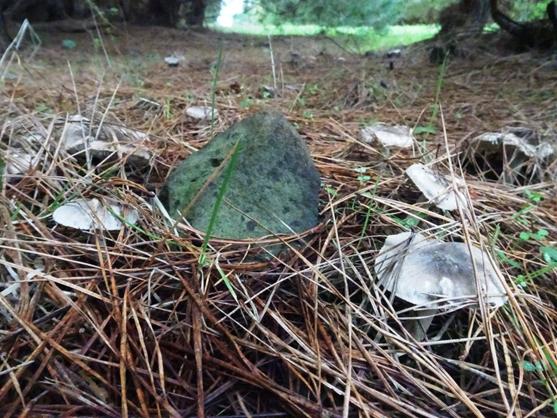
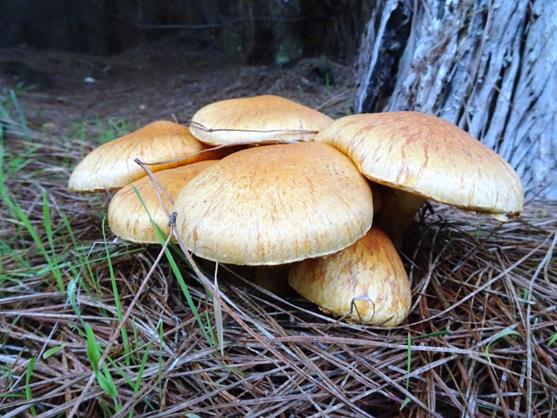
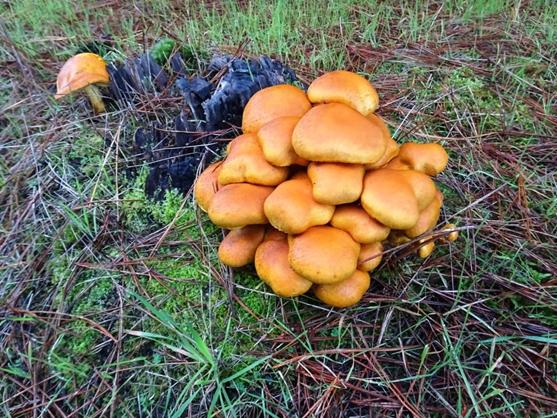
Some of these
guys are edible but the ones below are definitely not!




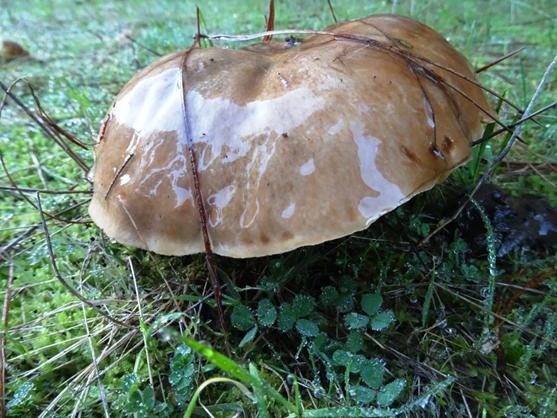

I
particularly like these ones cause they explode in a cloud of yellow powder
when they are ripe.
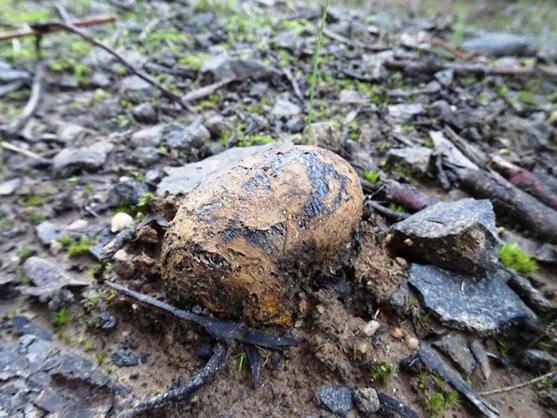
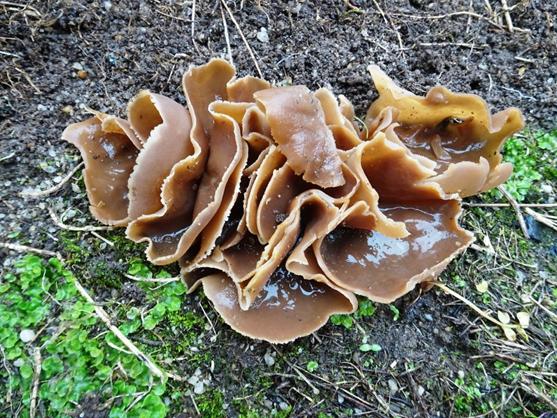
Fungi are not
a good survival or forage food actually. You need too much expertise to
identify them. Fruit and roots are a better choice - as indeed are beetle
larvae! The one below - one of the many kinds of bracket fungi though are
excellent (when dried) as tinder. Even straight off the log like this many will
smoulder for many minutes.
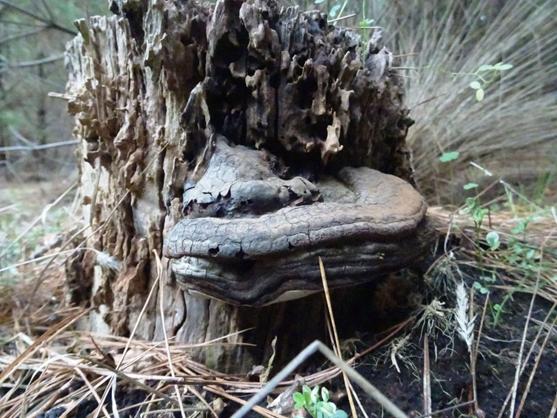
Below,
Della's collage. The dogs get into the act:
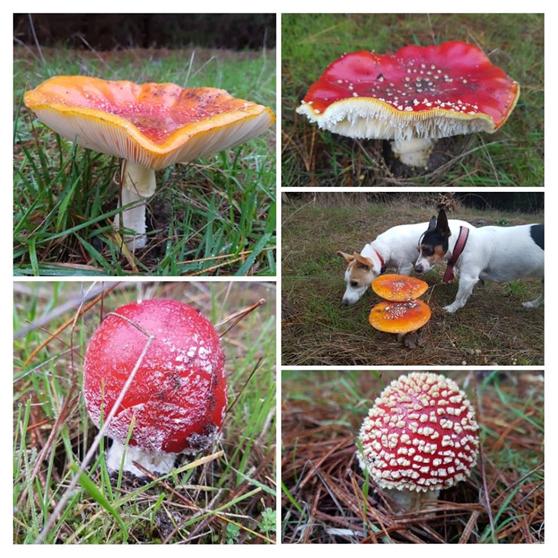 You
can see what Spot thinks of Amanita (Fly Agaric), the 'Santa Claus' mushroom so
called they say because it can give you the hallucination of flying - and
death!
You
can see what Spot thinks of Amanita (Fly Agaric), the 'Santa Claus' mushroom so
called they say because it can give you the hallucination of flying - and
death!

Of course I
could not resist snapping this lovely little fallow hind out for her evening
browse - until the dogs startled her!

See Also:
http://www.theultralighthiker.com/my-life-was-wide-and-wild-and-who-can-know-my-heart/
http://www.theultralighthiker.com/you-will-not-live-forever/
http://www.theultralighthiker.com/deer-oclock/
http://www.theultralighthiker.com/boastful-food-shots/
http://www.theultralighthiker.com/why-do-i-love-my-garden/
http://www.theultralighthiker.com/brer-fox/
http://www.theultralighthiker.com/only-the-moon-and-me/
http://www.theultralighthiker.com/a-tiny-life/
http://www.theultralighthiker.com/fifty-faggots/
http://www.theultralighthiker.com/in-troy-achilles-delivers-this-line/
http://www.theultralighthiker.com/pristine-beaches/
http://www.theultralighthiker.com/the-last-rebels/
http://www.theultralighthiker.com/most-travelled-cat/
http://www.theultralighthiker.com/birds-in-our-garden/
http://www.theultralighthiker.com/swallows/
http://www.theultralighthiker.com/thrilling-tales-daniel-boone/
http://www.theultralighthiker.com/welcome-swallows/
http://www.theultralighthiker.com/the-frogs-the-sequel/
http://www.theultralighthiker.com/the-wildlife-seems-to-get-wilder-everyday/
http://www.theultralighthiker.com/repurposing-camping-gear/
http://www.theultralighthiker.com/you-never-know-when-your-numbers-up/
http://www.theultralighthiker.com/venery/
http://www.theultralighthiker.com/her-craft-or-sullen-art/
http://www.theultralighthiker.com/not-such-a-dam-nuisance/
http://www.theultralighthiker.com/sour-grapes/
http://www.theultralighthiker.com/a-dam-nuisance/
http://www.theultralighthiker.com/things-that-keep-you-from-hiking-hunting/
http://www.theultralighthiker.com/lost-at-fromelles/
http://www.theultralighthiker.com/bend-that-knee-to-no-man/
http://www.theultralighthiker.com/progress-it-always-seems-more-than-it-really-is/
http://www.theultralighthiker.com/hidden-worlds-nocturnal-ants/
http://www.theultralighthiker.com/its-that-time-of-year-again/
http://www.theultralighthiker.com/bright-sky-at-night/
http://www.theultralighthiker.com/everyone-loves-a-good-fire/
24/06/2018: Rich Beyond Telling: Most
evenings if we go for a walk at the back of Yinnar a huge flock of
yellow-tailed black cockatoos comes in to roost after spending the day
dispersed sowing destruction on innumerable hapless plants all about (as is
their wont). I guess there has to be at least a thousand of them. Their raucous
calls ( a language in its own right I daresay) is
well-nigh deafening when you are close by and they are all around you - as they
were last night.
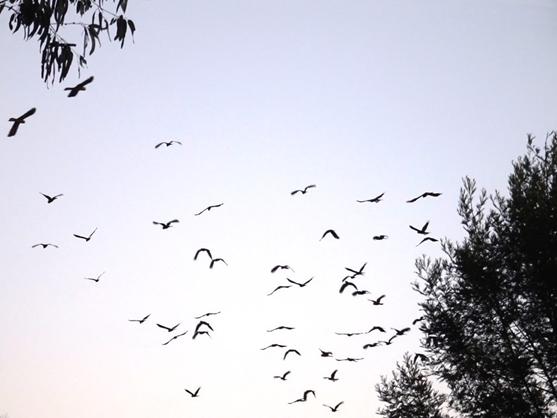
I tried to
get some shots of them silhouetted against the sky - as Della would like
to use them as patterns for some crafty textile thing she has in mind. I also
tried to get this one adjacent to the waning moon, but was not wholly
successful.

In some sad
pet shop elsewhere I doubt not a pair would be worth $10,000 - or more. This
noisy crowd which surrounded me or drank from a roadside puddle at my feet must
therefore be worth several million dollars - yet for a time each evening, they
are all mine. How rich am I?
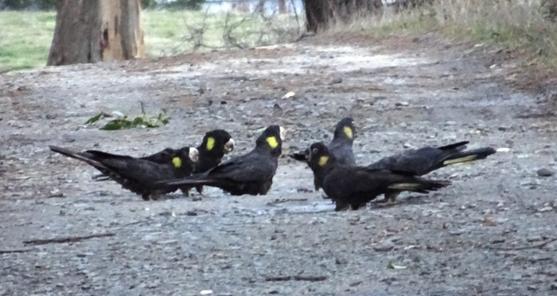
The new camera takes a passing decent
hand-held snap of the moon, don't you think? If only I could have captured it
and the cockie together with this sort of clarity.
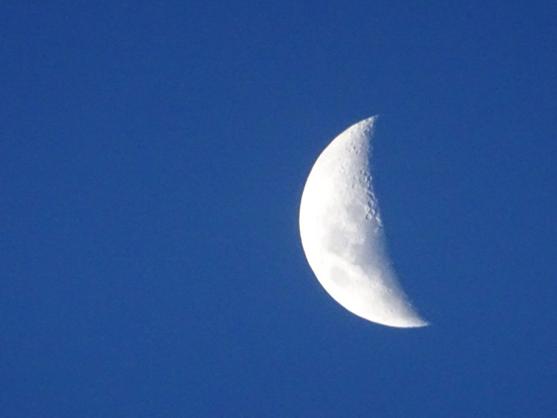
You have to
take a lot of snaps before you get a really great one, don't you?
Like this one:
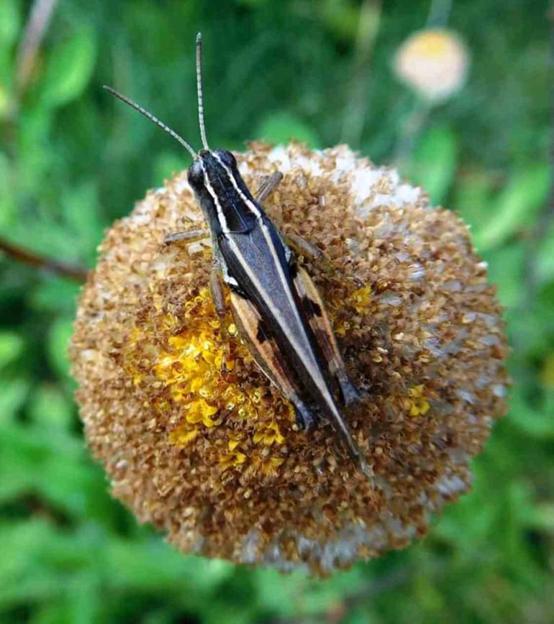
See Also:
http://www.theultralighthiker.com/deer-oclock/
http://www.theultralighthiker.com/boastful-food-shots/
http://www.theultralighthiker.com/why-do-i-love-my-garden/
http://www.theultralighthiker.com/brer-fox/
http://www.theultralighthiker.com/only-the-moon-and-me/
http://www.theultralighthiker.com/a-tiny-life/
etc.
22/06/2018: DIY Stun Gun: Personal Defense: How to make a stun gun with a disposable camera. This is
the guide to make a device which runs on a battery and produces sparks at tens
of thousands of volts very rapidly. No doubt illegal in Victoria and
many other ‘nanny state’ places, but very useful anyway.
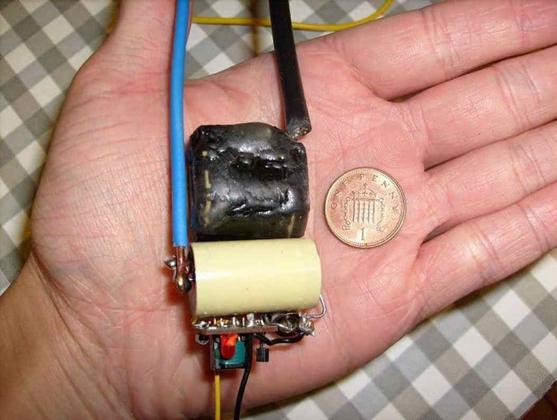
http://preppingfortheworst.blogspot.com/2012/10/personal-defense-how-to-make-stun-gun.html
SeeAlso:
http://survival-mastery.com/skills/defence/homemade-self-defense-weapons.html
https://www.skilledsurvival.com/homemade-survival-weapons/
http://www.returnofkings.com/97318/14-self-defense-tools-to-use-where-weapons-are-banned
https://www.lifehacker.com.au/2015/07/basic-self-defence-moves-everyone-should-know/
22/06/2018: Deer O'Clock: Three years ago we started to see the odd deer print on our evening walks.
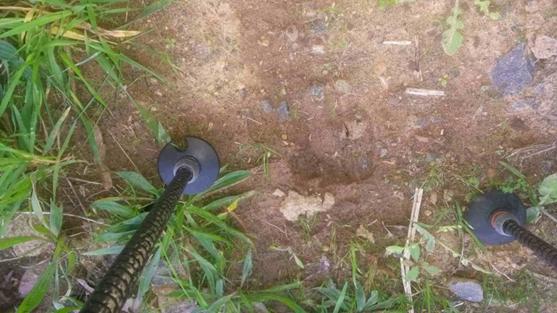
Then one day
a fallow stag kindly donated me this nice antler.

Back
in February when I was telling you about losing Tiny and the progress we were making with her
'replacement' Honey, I posted this snap to illustrate
how cheeky the wallabies were becoming.
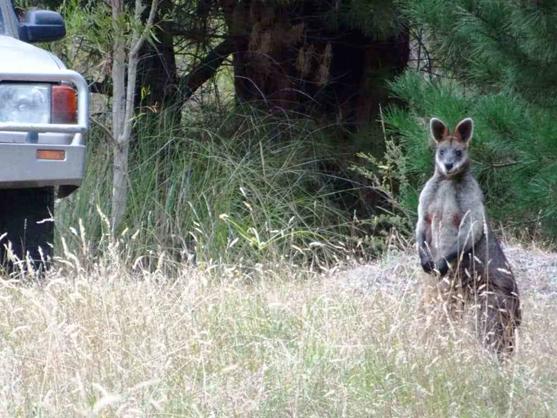
By
March I was seeing stags.
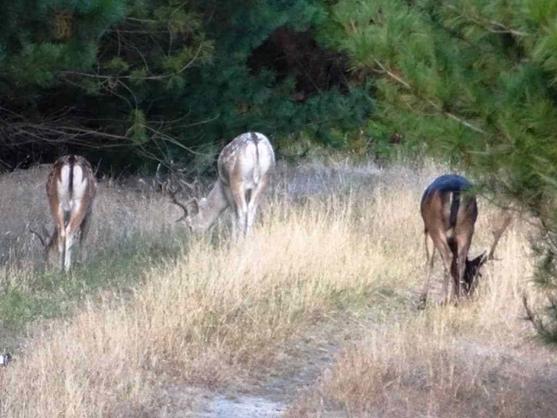
Last
week I was saw this little stag as I alighted from my car and was able to use
him to illustrate a few points about stalking.
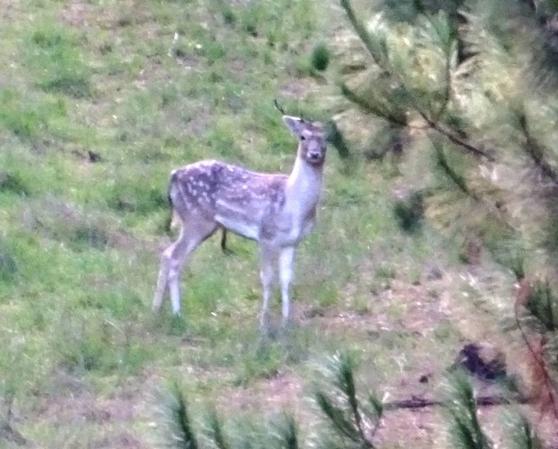
By
today the deer were emulating the wallabies and were waiting for us to return
to our car.

Isn't
it wonderful to live somewhere like Jeeralang where you can see so much wildlife just
five minutes from home on your afternoon walks with the dogs?
Or
they can be waiting for us on our front gate when we return home:
Like
this Frogmouth

or,
Hello Possums:
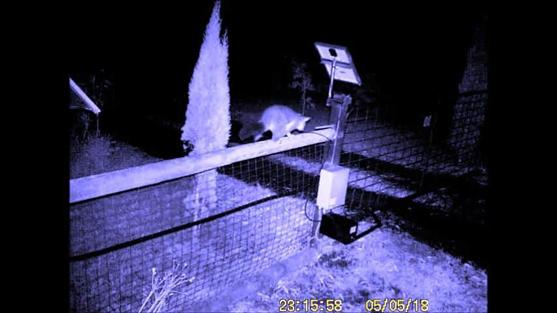
At
home we keep planting lots of trees to attract them,
and will be building more nest boxes for birds, possums and bats on our fence strainer posts, and elsewhere.
21/06/2018: More Power to You: These ‘new’ lithium
powered jump starters are amazing. I
had been thinking of installing a dual battery system in the (’95) Discovery
but it is difficult though not impossible to fit one in, as well as vey fiddly.
Anyway I realized that the main reason I would need one would be if the battery
went flat when I left it parked up the bush which I often do for a week or more
in very cold weather. Of course I always try to leave it on a bit of a slope so
that I can roll start it if the need arises (and it has) – but sometimes ther
just isn’t any convenient appreciable slope to use. I have’t been stuck yet,
but eventually I would be.
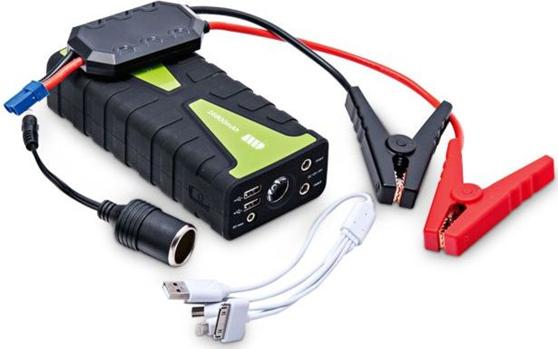
There
have ben jump starters for some time usually utilizing a fairly bulky sealed
lead acid battery, but the range now includes picket sized models which will
noinetheless start larghe diesel engines. The one I bought is an 18 mAh one
which also includes a very bright torch (which would clearly run for weeks!)
and a couple of USB outlets for charging other things. It is probably a bit of
overkill as a supplementary battery for charging your electronics whilst
hiking, but the smaller 10,000 mAh ones would do such dual service admirably
even on a long trip. These things will jump start your car up to a dozen times
– which is pretyy amazing for something you can fit in your back pocket!
Antigravity
Batteries were apparently one of the first cabs of the rank with this type of
product, and reputedly are still one of the best eg http://themicrostart.com/xp-10/ Their
18,000 mAh jump starter weighs 510 grams. This is not such a bad weight that it
could not see double use as a hiking (oe everyday) power supply. Of course most
people will not need that many amp hours. Small 2.5 .litre diesels will only
need 10-12,000 mAh which would be a considerable weight saving –probably over
100 grams, and of course smaller petrol engines might get by with much less.
I
bought an 18,000 mAh unit from Total Tools for
around A$240. This one has an amazing 1200 cranking amps! They had a smaller
unit available of less than A$200 but were out of stock on the day. Anyway this
will be more than adequate to start either of my two Landrovers should I leave
them up the bush for a couple of weeks in the middle of winter whilst I am off
hunting – and supposing their batteries go flat.
Very
compact.
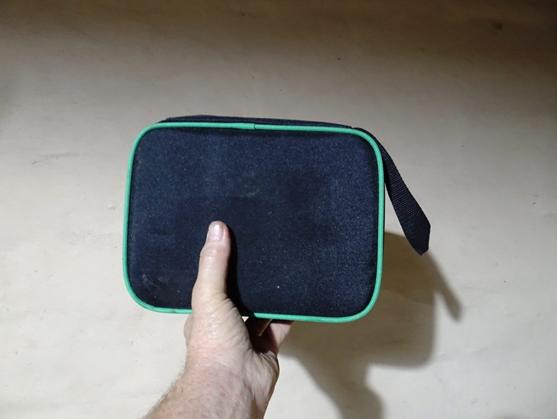
Everything
you need in this neat little bag.
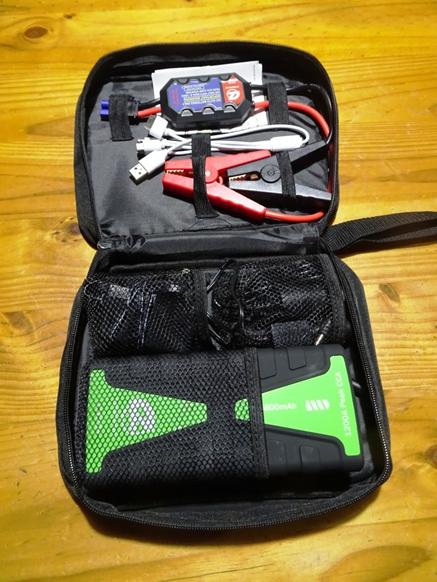
You
can just charge them at home or with the cigarette lighter socket when driving.
They remain charged for eg a year, so they are just great to have in the car
glove box in case something goes wrong. They come with all the leads, etc in a
neat little box.
18/06/2018: Garmin Inreach Mini: At last a fully
functional GPS, satellite communicator and epirb which weighs 100 grams (3.5
oz!) I already own the earlier model (190 grams) which I love, and can’t
imagine spending perhaps A$499 (Jun 2018) on its replacement in order to save
carrying 90 grams. Too bad. Maybe Garmin will offer me one to review! But if
you haven’t already got one (or something like it), it really is time you went
out and bought one. https://buy.garmin.com/en-AU/AU/p/592606
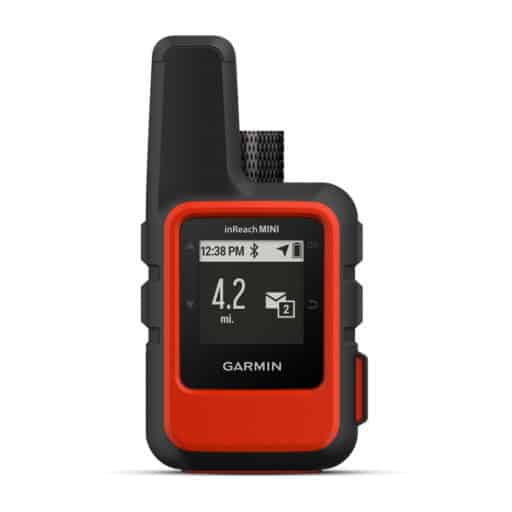
What
you get is a ‘Small, rugged, lightweight satellite communicator enables two-way
text messaging via 100% global Iridium® satellite network (satellite
subscription required)
Trigger
an interactive SOS to the 24/7 search and rescue monitoring center (satellite
subscription required)
Access
downloadable maps, color aerial imagery and more by using the free Garmin
Eathmate® app and compatible devices
Optional
InReach weather forecast service provides detailed updates directly to your
inReach Mini or paired device; basic and premium weather packages available
Send
and receive InReach messages through compatible Garmin devices, including
connected wearables and handhelds
Internal,
rechargeable lithium battery provides up to 50 hours of battery life in
10-minute tracking mode’
It
includes many other features such as, ‘Wireless unit-to-unit connectivity lets
you remotely control inReach Mini to send and receive messages using compatible
Garmin handhelds, wearables or other mobile devices. GPS-based location
tracking lets you share your whereabouts with those at home or out in the
field.’
This
will pair so well with my new ‘Atom’ mini phone: http://www.theultralighthiker.com/mighty-tiny-phone/
The
Go Tenna is also an excellent lightweight device for keeping in contact in the
field: http://www.theultralighthiker.com/gotenna/
The
Iridium Extreme (268 grams) remains the
gold standard for off-grid communication and epirb functionality, but it will
set you back nearly three times as much. I think it is worth carrying both
though – how much is your life (or your wife’s life) worth after all?
Hikers,
hunters and fishermen can fill their Xmas stockings with these three goodies!
PS:
I notice Spot also have a new model two-way Messenger/Epirb which weighs 7 oz
(200 grams) but is very much cheaper (US 250 Jun 2018) than the Garmin (though
with many fewer features): https://www.findmespot.com/spotx/lander.php
See
Also:
http://www.theultralighthiker.com/the-poor-mans-satellite-phone/
http://www.theultralighthiker.com/the-poor-mans-satellite-phone/
http://www.theultralighthiker.com/somewear-a-3-ounce-satellite-messenger/
http://www.theultralighthiker.com/get-lost-get-found-plbepirb/
17/06/2018: A Quilt for all Seasons: There is no
doubt though that a quilt can be lighter, more comfortable, and a lot less
inconvenient to enter and exit than a bag. A down quilt can weigh under 500
grams for something which will rate around -10C (providing you have a warm mat), so you can see that you can
definitely make one an integral part of your ultralight ‘system’. Over ten
years ago I often used to use a sleeping quilt before I had a bad back, but now
I toss and turn too much because of it, so I have gone back to my sleeping bag.
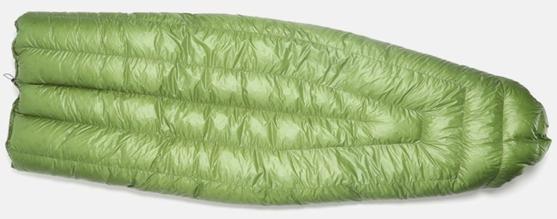
I
had two different quilts I used. One was made up from bits and pieces of a
Mountain Designs down bag plus some extras. The other Della made for me from a
kit purchased from Ray & Jenny Jardine (from US$109.95
Jun 2018). I could have slept on a Greenland Glacier in it. I found both
excellent (at different seasons) for hammock camping (because they are much
easier to ‘get in to’ in a hammock than a sleeping bag is). I used the former
(hanging in our lounge room from two eye bolts screwed through the wall!) for
over a year when my back was really bad whilst I waited for an op to fix it.
Nunatuk
for example, have some of the most awesome quilts, such as this 0C/30F model which weighs under 400
grams – but it will set you back US$ 320 (Jun 2018). No doubt it is superb.
Tier
Gear is an Australian quilt manufacturer who you can rely on for excellent
products and service. For example they have this -1C model for the Quenda which
weighs 566 grams for A$395 (Jun 2018): https://www.tiergear.com.au/shop/sleeping-systems/ultralight-top-quilts/quenda-quilt-1
Of
course Della's Zpacks sleeping bag is very like a quilt (and they make quilts
too - approx US$359 Jun 2018). In her size (and -7C) Hers weighs 499 grams in
its stuff sack: http://www.theultralighthiker.com/new-zpacks-sleeping-bag/
However,
on Massdrop this morning they have an Enlightened Equipment quilt which looks
very nice (for US$219.99 Jun 2018) This must be nearly half-price for an
excellent product. If you miss out on this ‘drop’ they will have another one.
Just keep watching.
It
has many interesting innovative features too. ‘On those three-dog nights, tuck
it snugly around your body with the included elastic straps and leave the
footbox closed. When it’s warmer out, let it hang looser to allow air to
circulate. And when it’s really balmy, unzip the footbox and let your quilt lay
open like a blanket. When it’s fully open, you can also drape it over your
shoulders while sitting around the campfire. Please note that because this
quilt doesn’t have a hood, you’ll want to wear a hat to stay warm at night.
Along
with creating more room around the knees, Enlightened Equipment’s signature
quilt shape is wide up top for wiggle room and tapered at the foot for
increased warmth and reduced weight. It also lines up the baffles to keep the
down where you need it. Vertical baffles around the torso prevent the down from
shifting from side to side, while horizontal baffles in the foot area ensure it
stays at your feet, rather than shifting up toward the torso.’ Check it
out.
Its
Specs are as follows:
Check
it out.
Its
Specs are as follows:
Massdrop
x Enlightened Equipment
15d
nylon taffeta fabric (DWR treated and calendared)
800-fill-power
DownTek down (hydrophobic, RDS certified, Zero PFC)
Temperature
rating: 20º F (-6.7º C)
20
in (50.8 cm) zipper #3
Elastic
drawstring at foot and head areas
2.5
in (6.4 cm) loft
Green
shell and charcoal liner
Weight
per included strap: 0.5 oz (13 g)
Made
in China
Short/Regular
Length:
Up to 5 ft 6 in (168 cm) tall
Width:
54 in (137 cm) head tapered to 40 in (102 cm) foot
Down
fill: 13.4 oz (380 g)
Weight:
20.7 oz (587 g)
Regular/Regular
Length:
Up to 6 ft (183 cm) tall
Width:
54 in (137 cm) head tapered to 40 in (102 cm) foot
Down
fill: 14.5 oz (411 g)
Weight:
22.1 oz (626 g)
Regular/Wide
Length:
Up to 6 ft (183 cm) tall
Width:
58 in (147 cm) head tapered to 42 in (107 cm) foot
Down
fill: 15.2 oz (431 g)
Weight:
23.4 oz (663 g)
Long/Wide
Length:
Up to 6 ft 6 in (198 cm) tall
Width:
58 in (147 cm) head tapered to 42 in (107 cm) foot
Down
fill: 16.4 oz (464 g)
Weight:
25.2 oz (714 g)
Included
2
removable elastic straps (1 straight, 1 looped): 0.9 oz (25 g)
Lightweight
13L (793 cu in) stuff sack: 0.7 oz (20 g)
Enlightened
Equipment’s limited lifetime warranty
See
Also:
http://www.theultralighthiker.com/ultralight-sleeping-bag/
http://www.theultralighthiker.com/cold-season-pads/
15/06/2018: The Deer Hunter’s Apprentice #2: To continue. Where is the deer? So, let’s
say you have mastered walking quietly, that you can reason out where a deer has
walked, and that you can see through the bush, so that if a deer is there it
will be visible to you. Still and all, you need to also be looking in the right
place. For example some places may be too thick, and though there may be lots
of deer there, you may never see them. Such areas are better suited to hound
hunting. The Upper Thomson springs to mind as an example.
You
need to pay attention to the topography, rainfall etc. Say for example a river
runs East-West (here in Victoria). The sun will heat the West facing slopes of
the ridges more than the east. The gullies which run from South to North will
be drier than those that run from North to South but they will also likely be
more open and grassier. The heads of the latter gullies will likely be too
thick for shooting. Deer will often prefer to bed on the North facing ridges on
the South side of the river but out of the cold wind, in some dogwood or wattle
for example where there is a bit of warm sunshine on a cold day. You should be
able to see how the system of tracks leads to such spots by looking at where
they begin and which way they trend.
When
you do see a deer (or any quarry) do not look at it when it looks at you. And
do not move. A single muscle. Unless you are going to shoot straightaway -
maybe the best option in many cases, and one reason why I prefer iron sights.
Mammals have the magnificent visual acuity they have for very good reason. The
eye and brain are hard-wired to sound alarm bells whenever movement is
detected, and the nervous system is brilliant at detecting it. Movement is
always (potentially) dangerous.
Watch
a cat stalking its prey: a mouse or a bird. In the presence of prey it will hold
still for a very long while. When it does move the movement will be slow and
smooth. Jerky, sudden movements always generate alarm. The only sudden movement
is the final pounce.
Sometimes
I have demonstrated to folk how to catch a wild wallaby by the tail. Whenever
you see a wallaby, if you approach it very slowly and methodically, averting
your eyes when it looks at you or looking away completely, remaining in a bent
position as if you were another wallaby, even lowering your head right down to
the ground, as if eating…you can walk right up to one and catch it by the tail.
Try it for yourself. It is a useful exercise in stalking. A black wallaby is
surprisingly hard to hold on to by the tail though. Do not try this with a grey
kangaroo (I have). Let us just say that it is unwise, and that Spot learned
straightaway from my demonstration not to approach the beasts at all!
It
is possible to do this with a sambar deer. Of course it is most appealing to
try it out on a mature stag. Again, make like a wallaby. A deer will have seen
lots of them. It is the most common biped in its experience – and no threat at
all to it. Indeed, it will flush them away if it feels like it. It is a matter
of pattern recognition. Herbivores do not generally have the cognitive
sophistication of primates. Mind you there are plenty of folks though who
nonetheless have walked blithely into veritable lions’ dens!
Bow
hunters become particularly good at getting up close to deer – because they
must. Even without camo a skilled bow hunter gets to within 20 metres of the
quarry regularly - probably almost every time they go out. Practice and
experience. They don't happen overnight. It might be a useful exercise for you
to go out in just such a way sometimes, armed only with a bow - or a camera.
Once
you get right up next to the sambar stag, you may overwhelmed by a wild
temptation to simultaneously leap upon its back and seize it by its horns,
perhaps thinking to cut its throat with your blade knife after some ‘slight’
tussle. This would be unwise in the extreme. Sometimes it is just very sensible
to resist temptation! My late old friend Arthur Meyers found himself on a
mature stag’s back in just such a circumstance many years ago. We were all
victims of youthful exuberance once. He did live to tell the tale (and many
others besides) and lived quite a long time, even more than me, but he also
regretted it considerably for some time!
I
have also wrestled a stag to the ground by its antlers and cut its throat when
I was younger. It was a seriously wounded stag, and I was out of ammo, so there
was no other choice really – but I hope I never have to do the same again. I
would not recommend this approach to anyone. Of course, if you had hold-down
dogs it would be a different matter, Sir Samuel Baker dispatched 400 of the
beasts in this way with just a bayonet.
Anyone
who has wandered around the bush in pursuit of deer for many years will have
had many such close encounters. I once found myself astraddle a doe in the
Flourbag, and bucked suddenly into the air and down again to a heavy, awkward
landing on my shoulder. Attempting to step over a sleeping deer you have
mistaken for a log will get you into this sort of situation mighty quickly. So
watching out over there for a deer instead of looking where you are putting your
feet isn’t always the right advice!
I
guess I have been bowled over (or nearly so) by a running deer over half a dozen
times and have only just managed to avoid their antlers on a couple of
occasions too. They take fright pretty quickly and without much care as to
direction when they bolt being only mad keen to be gone from danger. I have
even been in the midst of a stampede of probably 30-40 deer on the side of a
valley off the Mitchell a few years ago. That was a minute’s heart-starting
action, let me tell you! I guess it was my scent provoked the rush as there
didn’t seem to be anyone else about. But they behaved exactly as if when danger
threatens, it threatens all alike. And off they went. In a veritable thunder of
hooves. Pretty much right over the top of me. Frightened me silly.
I
have also been bowled over by roos and wombats which I think much more
dangerous in some ways because of heir immense teeth. I reckon they could just
about take a leg off if they set their mind to it. One of them tried to take a
swipe at me once. I was nimble enough to avoid him, but what a maw he had!
First
though, as I said at the outset, you have to find the deer – and where might it
be?
Some
people are immensely better at finding them than others. I once met a chap
years ago on the Lazarini Spur. He used to just shoot the deer and take the
tails as proof of his tally. On this day he had nine fresh cut tails! As I
said, this was thirty years, ago long before the deer population ‘exploded’.
Whilst I do not condone such wanton destructiveness, I include the story to
illustrate that it is possible to see (and shoot) a lot more deer than you are
now.
This
guy was able to do this just walking through the bush (and with iron sights).
No camo. No trail cams. No telescopic sights. Just his own unaided eyes and
ears. His living proof that it was possible inspired me to give much more
thought about how to do so.
Clearly
seasons, time of day, the moon, changing feed (and water) conditions, the
presence (or absence) of other hunters, oestrus, breeding & etc all create
separate conditions which determine the deer’s whereabouts. Nonetheless there
are always some good places to look, eg: feeding areas, bedding areas, nursery
areas, scent marking, wallows, crossings…
A
BTW: Drinking spots: mostly the deer using them will be does. The demands of
lactation and pregnancy require more water. Most of the year most deer
(especially stags) can get all the water they need from the food they eat (as
do sheep). Sometimes the deer will be up high (when birthing and when the fauns
are very young for example where there is often no water source, though
sometimes (I'm sure you have noticed a tiny stream will be flowing high up
which dries up or goes underground lower down. There are sometimes spring
scrapes too deep under tree ferns where it appears no water exists. Often a
group of does will have a stag with them, but most often it is just a spikey or
an immature stag. The master stag does not need to hang with the does save in
the rut. He won't be far away though down wind. Bachelor stags (the most
numerous kind) often hang together high in valleys together and never go near
the does. Quite often they are the most handsome and largest - just like Rock
Hudson I guess.
All
these areas have game trails leading to and away from them. The trails converge
and diverge. Clearly where they converge is a highly desirable spot for deer,
for whatever reason - usually feeding, bedding, scent marking (think wallows).
These are the areas where the cowboys place their trail cams and their
ambuscades.
Deer
are just as lazy as you (unlike wombats who seem to like to climb vertically).
Their paths take an easy line up teh ridges and gullies. For that alone they
are worth following, but get to know the angle of that line so you can
anticipate where they will be (in the genera;l topography) and where
consequently the deer will be. You should be able to spot the really likely hot
spots from the river bottom kilometres away.
I
know you will likely shoot more deer just waiting quietly (until dusk probably,
or after) in such spots, but it would not be fair. You should go seek out the
quarry where he has the opportunity to use all his senses to avoid you and
escape - else there will be no sense that taking him makes a trophy
representing something difficult and well done. It will be not much better than
having shot him on the road in the light of your car's head lamps really, and
that is too easy to do - as I notice from the evidence on the side of the road
practically every time I go up the bush.
The
game trails are not unlike a human road system; they branch and branch: there
are freeways, then highways, then back roads, and finally driveways. You may
remember my photo of Della on the post http://www.theultralighthiker.com/pack-rafting-the-wonnangatta-mitchell/,
along with the comment: 'This, believe it or not, is a deer path on public
land! This would be a good place to be at dusk with a .308 – if you were
hungry!'
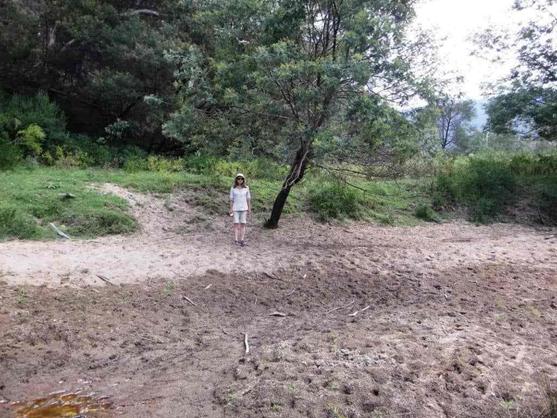
This
is a deer freeway, nearly a chain wide! Clearly they must have some compelling
reason to cross the river in such numbers at this point. Such numbers as this
is always down to feed, and when I say 'feed' I mean pasture, just as if they
were sheep or cattle, as pasture is their chief food whatever else they might
eat (and they eat many things).
That
is why I have said before that you will always find deer bedded behind a
farmer's paddock, no matter how much effort he has made to reduce their numbers
- and I know one who has shot over 400 of them in a the last year! If you are a
farmer (as I have been for over forty years and want to preserve your
livelihood, you are going to either have to fence out whatever critters prey on
your income or seriously reduce their numbers - whether it is legal to or not!
I
had a client who lost over 800 Merino ewes in a single night to dingoes, for
example. Once I went out with an old friend one night and counted over 3,000
roos in his wheat paddock. We built a huge pen in the corner, rounded them up
and seriously depleted their numbers, else there would have been no crop that
year!
With
a bit of practice you will get a map in your head of where any system of game
trails goes to and comes from. Right at the top (the driveway) is where you
will find the biggest stags, save in breeding season - and they do have a
season, though many young are born out of season. You can sometimes see a huge
increase in competitive stag behaviour for example: thrashing, rubbing,
preaching, push-and-shove grounds, howling and clashing etc. This is clearly
the mating season. At other times (in the bedding areas) the ferns are packed
with piles of tiny droppings and you will often trip over a fawn sleeping next
to a tree.
The
stags can smell the does are in oestrus from at least a kilometre away. They do
not need to move until they are so lured. That is why they will invariably be
camped uphill and downwind of the does. When they are in rut they are just as
silly as any other bunch of young blokes out for a night on the town, drunk as
lords and hoping (usually against hope) to get their legs over. They are as mad
as March hares.
And
reek - rather like the young fellows with their excesses of deodorant. If you
shoot a stag in rut you will have trouble eating the meat. I know I can't. It's
just too gamey for me. It can have been in the freezer for six months and will
still stink terribly when thawed out. If you have any sort of nose at all you
can follow this rut scent up the wind right to the stag who is making it!
You
should practice walking without making any sound at all. If you buy yourself a
pair of cheap hearing aids such as Walkers Game Ears and you turn them up
fairly loud they will alert you to just how much noise you are making. If you
can hear yourself, obviously a critter with ears ten times as big as yours will
be able to easily too. Such devices are good too if you are a bit hard of
hearing (my own is too far gone for the best aids to make enough difference).
It
seems like only yesterday that I could hear the bats hunting of a night, and at
the other end of the spectrum I could hear the hum of the power station
chimneys four kilometres away. I have completely lost those high frequencies. I
need 85 decibels of amplification to hear any of them. The low frequencies are
not quite so bad. I can usually hear a roo crashing off, but I can no longer
make out a doe stamping - which should be a dead giveaway if your ears are
still OK.
Before
i was quite deaf I had the fact I was losing my hearing underlined for me one
day years ago. I was walking quietly down a track with a friend., wending our way
down to a valley to what I though might be a good spot. Suddenly he whispered,
'Listen' - which I did, but to my ears, there was nothing. I was utterly
astonished when he quietly stepped off the track and took a (successful) shot
at a nice fat hind! His superior hearing had been able to pick up her faint
movements in the bush. A pair of these 'Game Ears' might get your hearing back
to that level! I have to rely on my ears and my nose.
Hearing
aids are good for protecting your hearing too as they Doppler down to a maximum
volume when you take a shot. These 'Game Ears' are also some of the cheapest
hearing aids on the market. If you think you might need hearing aids you most
certainly do! Try some. If you put off getting them you are causing your
hearing to worsen more than it otherwise would have. Act now.
Birds
can be your greatest enemies. They have such a predisposition to fly up when
alarmed. If you can avoid alarming them you should. Flying is such an energy
demanding pursuit that birds only take flight at need. You have surely noticed
how many birds starve to death each winter as compared with other sorts of
creatures? As I said, the demands of flight are huge.
Mind
you it must be a marvelous thing to be able to do. It is hard to imagine how
once having mastered it anything could possibly give up its obvious pleasures
and practicalities, as the dodo and the moa to name a couple clearly did. Oh
well. Of course their startle response to something large moving near them can
also be put to your advantage. You must have noticed how various birds,
particularly pigeons, kookaburras and the various magpies give a clear warning
that a deer is passing by where they are – somewhere up front of you?
It
will be moving away from you. As it is passing them, this gives you a line of
its travel. It is not much troubled yet and will quickly settle again. You
could note the line it is taking, estimate where it will stop, wait a little
while till you are sure it would have settled, then begin a circuitous
approach. it will definitely be watching its back trail so you must approach
from some other downwind direction which offers good cover.
I
like to get up above the stream to about the height I reckon deer will be
bedded at that time of day and year, and just gradually work my way (into the
wind) crossing from gully to gully. I enjoy walking all day anyway and would be
bored (as well as cold) just sitting around waiting. Besides you see lots of
interesting things moving along.
I
guess you only get a shot at perhaps 20% of deer you put up in this way, and
they are often up and off in a hurry if you are not particularly careful about
how quiet you are being, which I am usually not any more - as I really just
enjoy the walk these days, and usually have a Jack Russell or two for company,
so that there's not much point in being quiet anyway.
In
such circumstances it is usually snap-shooting through bush where the first
shot is the only one that counts, so the rifle probably goes up at least half a
dozen times between shots. I like to do a complete circuit of a large valley in
this way during the day and finish up somewhere near where I began - to camp on
the flats at the bottom with a nice warm fire and just the stars and the dogs
for company. Something like this or this.
What
to do when you see a deer. Maybe I can best
illustrate this with this series of photos taken on my afternoon walk with the
dogs yesterday (I know this is a small fallow stag; the same points apply to
other species). The snaps are a little grainy due to the failing light:
If
you come around the corner or over a rise and you see a deer in this position
you must freeze. This one is about 250 yards away. Deer (likely) have better
visual acuity sideways (unless you too have been hunted a lot). He will
therefore likely notice any movement straightaway and react. He is quite
relaxed, ears down. He is also too small to take except for the table where he
should taste just about as good as lamb!
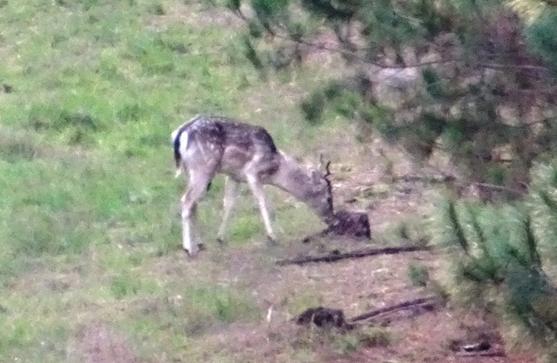
If
you don't move he will go about his business - in this case feeding on some
lush pasture. You can creep up quietly while his back is turned trying to keep
as much cover as you can between him and you so that when he turns this way you
can freeze but he will not be able to make you out as your outline will be
broken up.
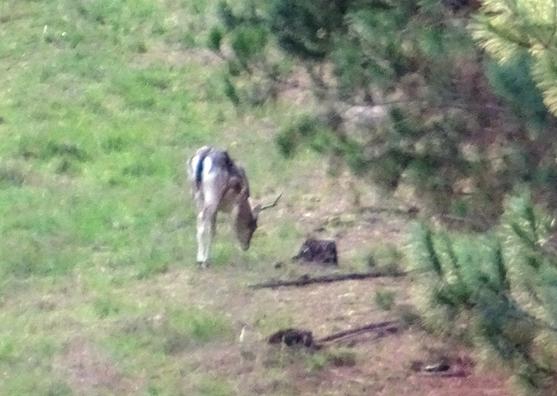
He
is just going to continue to go about his cervine business. You could creep
closer (as above) or creep along in cover out of sight then slowly pop your
head up for a closer look. Of course I realise that right at the start he was
close enough for a sure shot with a telescopic sight. I do not use them as they
reduce the deer's ability to use its senses so are unfair. Now I will want to
get to say within fifty yards for a sure shot with iron sights. Of course (when
I was younger certainly) I could have shot him at 300 yards with iron sights
without a rest - but we all get old! Hope you enjoy it as much as I do!
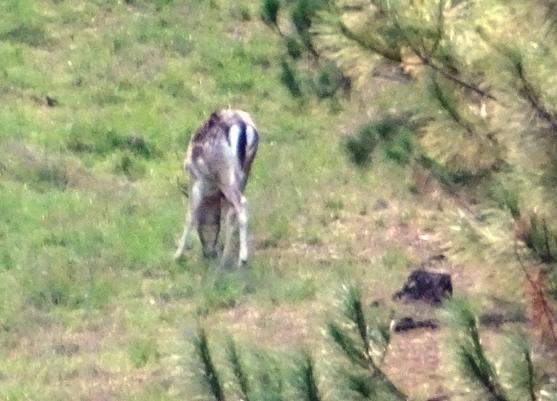
Now
you see his head has come up (and his ears). He has noticed something (probably
the two dogs who are romping in plain sight). If you saw him begin to do this
you could slowly crouch over (reducing your threat level) and freeze. Don't
look straight at him! Likely he will just remain attentive for a minute and go
back to grazing - in which case you can resume your stalk.
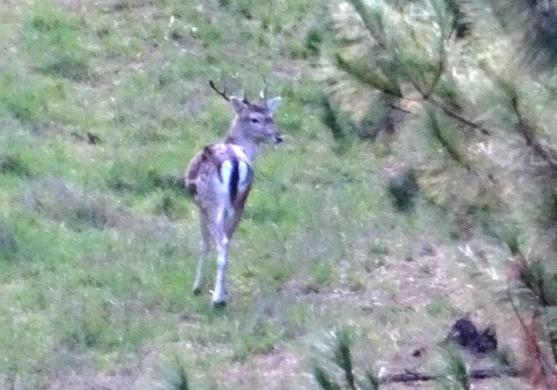
Now
he is watching (the dogs) and listening intently. His muscles have tensed up
ready for flight. If you are frozen (preferably in a bent over position), and
you don't have two dogs running around, he will still most likely quieten down
again and resume feeding. Wait. If you had not alerted him to this level, you
could likely have crept up to inside 20 yards of him (using cover), being dead
quiet and being very patient (and so long as you are downwind). He stood like
this for over a minute watching the dogs fool about, then decided to slowly
sneak off into the trees. BTW: For some bizarre reason fallow stags seem always
to have their pizzle hanging out like this.
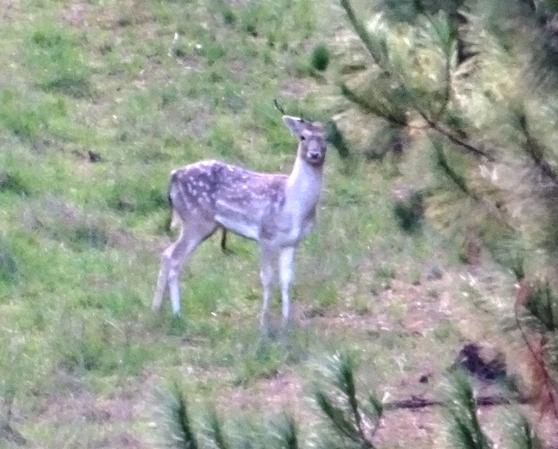
PS:
Another of my 'apprentices' recently took his first sambar stag, a small
spikey. This is a significant achievement and no doubt will be the first of
many, as he has learned a lot. As he is also a qualified chef, I think the
family will be delighted with this addition to their larder:
Such
a sweet little trophy. he will remember this for many years.
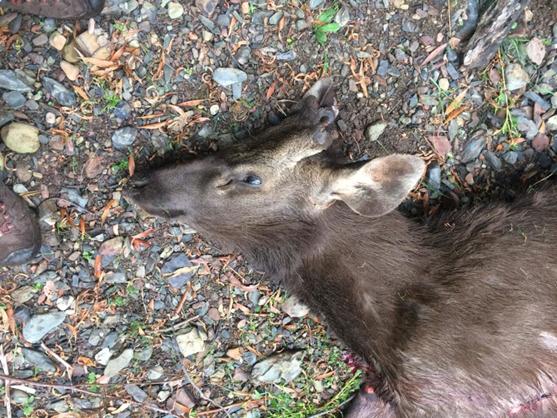
Some
careful dissection work ahead:

The
carcass has been well (and cleanly) butchered and all the meat was carried out
to be consumed at home.
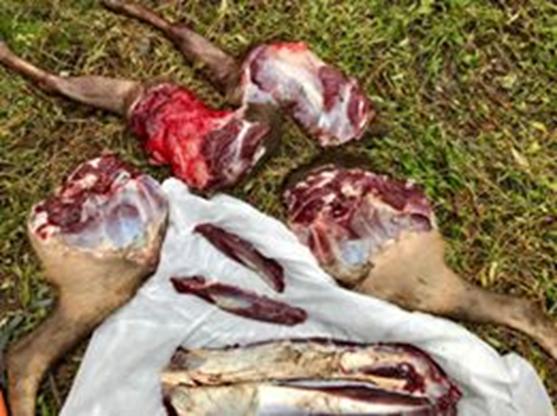
PPS:
Amerindians had a custom of 'counting coup' eg on their enemies (instead of
killing them), so that they would show their bravery and skill by coming close
enough to touch them. This might be a good idea to practice on deer as in this
video kindly sent to me by a young friend:
[embed]https://www.youtube.com/watch?v=7p7c3FokGgQ[/embed]
I
think this poor young stag has been blinded in a fight - damaged optic nerve
probably; maybe hearing impaired too. We had a ram which this happened to a few
years ago (always your best ram, dammit). The ram did not recover or
survive. I think you would have a bit more difficulty having a stag stand
for this kind of treatment, but why not give it a try?
Stags
can also get tangled when fighting, though I think this is much less likely
with sambar due to their fewer points than might be the case with red or
fallows. I was trying to find an example of this when I found this interesting
footage from somewhere in Fiordland:
https://www.youtube.com/watch?v=tVH8_cGAjCc[/
Here
are two tangled in a fence though:
https://www.youtube.com/watch?v=8vSqwpEPdvA[/
You
would wonder how this lady hunter got so close as to leave her bra on this
stag's antlers though:
https://www.youtube.com/watch?v=Df8vQNpNpKs[/
I
don't usually watch videos, but...this really is 'counting coup' on an elk:
https://www.youtube.com/watch?v=0A4eX1YYg0Y[/
Good
luck with your hunting!
Some
recent hunting related posts:
http://www.theultralighthiker.com/the-deer-hunters-apprentice-1/
http://www.theultralighthiker.com/the-lure-of-the-moose/
http://www.theultralighthiker.com/best-hunting-daypack/
http://www.theultralighthiker.com/ultralight-cookpot/
http://www.theultralighthiker.com/ultimate-blades-for-the-ultralight-hunter/
http://www.theultralighthiker.com/crkt-pdk-replacement-blades/
http://www.theultralighthiker.com/fire-umbrella/
http://www.theultralighthiker.com/are-you-beautiful-in-the-buff/
http://www.theultralighthiker.com/a-spot-of-solitude/
http://www.theultralighthiker.com/nz-moose/
http://www.theultralighthiker.com/follow-your-nose/
http://www.theultralighthiker.com/hunting-thumbtack-reflectors/
14/06/2018: Boastful food shots: Della: 'I have
generally eschewed these on FB, but this one is a little different from the
norm, I think. Nothing flash, not the good china, not the expensive restaurant,
just what I dished up for Steve and myself for tonight's tea after a latish
walk with the dogs. As a somewhat hit-and-miss vegie gardener, I often do a
mental stocktake of the origin of what is on my plate. Tonight's result was a
pleasing one (though not untypical): lamb backstrap from our paddocks
(marinated in our home-grown rosemary, garlic and lemon juice - olive oil and
salt as ring-ins), home- grown beetroot, parsnips and silverbeet with purchased
fresh corn and canned beans. I could have selected all home-grown vegies to
prove a point, but this is just a random, typical meal, and I had no prior
intention of doing anything other than eating it. I take more pride in this
humble home-cooked meal (is that an accidental oxymoron?) than in the fanciest
of restaurant offerings.'
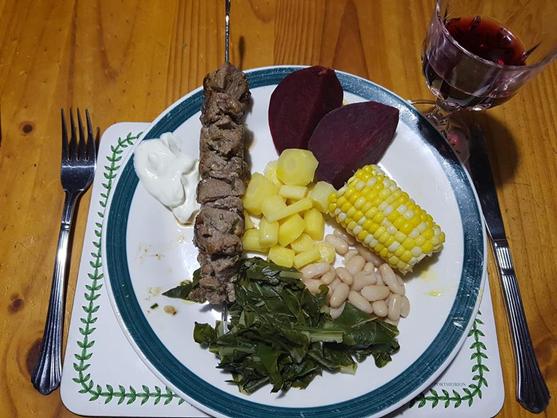
PS:
We have been mostly self-sufficient at least since we bought our first little
farm back in 1976. We have also done all our own car repairs (and most other
repairs), made many of our own clothes, even our furniture. In fact we built
the house we live in with or own hands, even making the mud-bricks it is
constructed from ourselves. Every saw cut, every nail driven was done with one
or other of these two pairs of hands. We may not have made much money over the
nearly fifty years we have been together, but we have saved a lot by such
economies and can afford to live modestly on our own means, a virtue which we
think is to be encouraged!
See
Also: http://www.theultralighthiker.com/natures-bounty/
13/06/2018: What to include in a wilderness cache:
I have a number of favourite spots I visit every now and then sprinkled around
the Gippsland bush mainly far from roads. Many are on the other side of large
rivers which sometimes rise unpredictably and can cut you off for many days
from ‘civilisation’ – whatever that is.
Here
I was two days ago just finishing a visit to two of them in the Wonnangatta
Station before the gates are closed till November. This is last crossing (of
seven) before you begin the truly terrible climb up the Hernes Spur.

And
here I was in the same spot (just behind the car) putting the pack raft in back
on 17 Dec 2017. What a lovely trip that was: http://www.theultralighthiker.com/wilderness-siligloo/ See
also: http://www.theultralighthiker.com/pack-rafting-the-remote-wonnangatta/
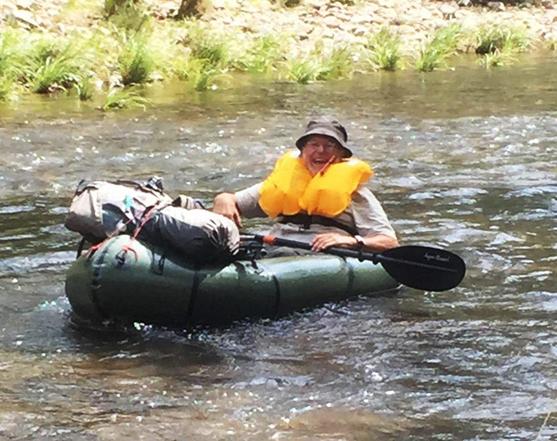
Frankly
I feel much more ‘civilised’ when I am alone in the bush than when I am thrown
together in some urban crowd, but each to his own I guess. In the event I do
find myself isolated by floodwaters for example when I may rather be at home,
something which has happened to me on more than one occasion, it is comforting
to know that I have a stash of necessities which will see me through such a
situation safely and in some degree of comfort.
Because
I often hunt/camp many days from my car there are many other mischances where I
may find such a stash a great solace. If I should lose my pack for example
several days from my vehicle, I would be most distressed. The closest I came to
this was having lunch high up. My pack nearly rolled down a slope where it
would have lodged high in a tree well out of my reach. One can imagine your
pack disappearing off the edge of a cliff into the sea (this nearly happened to
us on the South Coast Track, Tasmania (http://www.theultralighthiker.com/south-west-track-tasmania/
& http://www.theultralighthiker.com/tasmanias-south-coast-track-hells-holiday/
or being swept away by a raging river, falling down a (mine) shaft, &etc.
I
have also had the misfortune of having other people interfering with my gear
over the years. Someone stole a paddle for example I had left underneath my
canoe on a multi-day hunting/canoeing trip. Once I had my front hub locks
stolen from my locked vehicle on a very long steep slippery $WD track. Twice folks
stole my radio tracking collars from my hounds (which i noticed when i was
putting the dogs back in the truck). I had then to go and hunt for the collar
with my tracking antenna. Of course it was moving In each case and I needed to
holler out something like, 'If you don't put the collar down I will shoot' or I
would not have got it back. Lots of folks have had similar experiences, I’m
sure.
This
is why I like to go as far away from where there will be other people as I can.
Even though you hope to leave such perils of ‘civilisation’ behind, the
barbarians are ever ‘at the gate’. I am also always mindful that I might come
back to my camp to find it ransacked by wild dogs, or (unlikely) that my
smouldering fire has managed to creep along the ground and burn my tent down!
In all such circumstances having a cache is a handy back up.
Another
reason to have such a stash is if you plan to winter hunt beyond a seasonal
road closure such as applies in many Alpine areas of Victoria. This can be the
best time to be there, not only because you will be more likely to have the
place to yourself, and the animals settled down into a tamer state, but because
winter camping is just so much better than summer camping (but you need a warm mat).
A
winter fire serves so much more of a useful purpose without endangering the
bush to the risk of wild fire. Because the winter air is cold and dry (and
winter is the driest season), the skies are most often shot by the most
brilliant display of stars you ever saw lighting up the frigid nights. A
veritable Aladdin’s Cave entertains your every night.
For
that reason I leave a canoe drum or more in strategic spots where I can easily
find them again, but where they are unlikely to be stumbled on by even the
keenest-eyed hunter. Some folks say they bury their stashes but I do not. I
doubt they do either. I usually tie the drum up under a pile of logs somewhere
so that wombats etc will not roll them away. Obviously I place them well above
the highest point to which floods in the past have come in that particular
locale.
These
excellent 30 litre drums (they also have a 60 litre model) are available very
cheaply from Ampi Plastics (something like $10 each last time I bought some): https://www.ampiplastics.com.au/
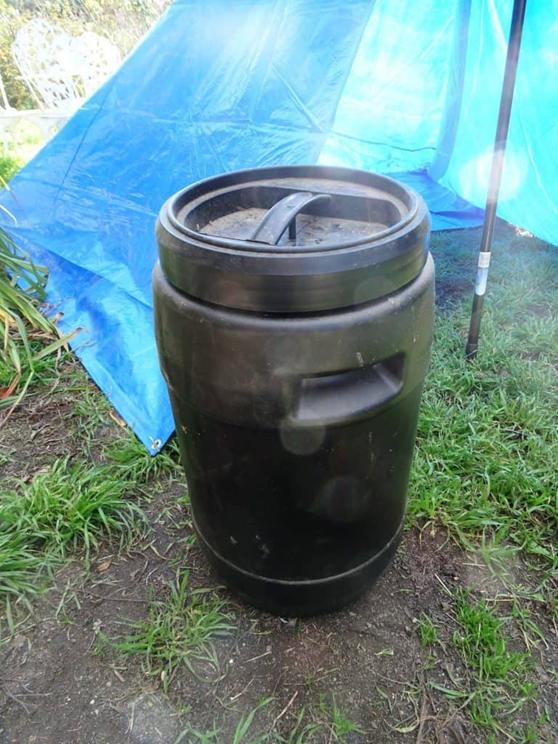
I
find you can fit 8-10 days food in each drum, plus a shelter (such as Brawny's or mine), fire lighting materials,
small billy, a couple of cups, plates and spoons and a metho burner (plus a
litre of meths). A small cheap blade is always a good idea (as is something to
whet it with. Enough tissues and wet ones for a fortnight is a
great idea. When I drank I used to decant some overproof rum into a 500 ml
bottle. A tipple of rum on a chilly night warms the cockles. I think a couple
of survival blankets or bags is good too - or a Blizzard Bag if you can afford it. A fishing line and a small frypan may come in
handy (or some heavy weight Alfoil such as barbecue dishes available in the
supermarket are made from) - for cooking fish or venison. A jack saw blade with two attached large key
rings will fit around the inside of the lid. Such an impromptu saw can come in
handy. When I get round to making some up, I think a 'fire umbrella' would also be good in case
you are stuck there with rain for ages.
Of
course the food I leave is all dried or canned
with long 'use-by' dates. The canned food is usually tuna/sardines to add a bit
of protein to a dehydrated meal. The Hormel Bacon is good for this too.
Everything is in sealed plastic or Alfoil packages which will not absorb water
(you might be putting the tarp away wet sometime). I may not after all get
round to eating it this year, though I plan to. I would want it to be safe in a
few years time.
Snap
lock bags are not impervious to water. Dehydrated contents will absorb water
through them if it is there to be absorbed. Oven bags are better. Just twist
the ends around tightly a number of items and seal with a wire bag tie or
similar. A pack of dry biscuits such as Vita Weats will keep well in them (and a jar of peanut butter goes well with them
as do many spreads). Grains and pulses (such as
McKenzies) will remain edible for centuries - so do not get too carried away
about those 'use by' dates, but do make yourself aware of the causes of food
poisoning.
I
choose Carmen's Porridges for breakfast (with canned powedered milk). The
former will not spoil in their foil wrappers, and the milk will be fine until
it is opened and can be decanted into snap locks.
For
dinner there are so many pasta, risotto and coucous dishes (which can be
improved with the addition of a can of fish). Then there are two minute noodles
and cupasoups of various sorts.
For
hot drinks I usually leave tea bags (in an oven bag) and alfoil sachets of
drinking chocolate. Coffee just goes into a hard undrinkable lump after a time.
A
large 370 gram pack of Nobby's peanuts in foil will stay fresh for many months
and can be eaten as 50 grams snacks at a time over a week. Similarly Craisens.
That
should get you started.
Some
places I have two or even three drums so I have many more 'luxuries' there. You
have no doubt seen photos of some of my larger fire shelters which half a dozen could
enjoy together. For example, a hammock is great for a relaxing lie in the
sun on a warm day. Even an emergency pack raft can be left here and there
eg for getting the meat out in the winter time. Some spare ammo can also come
in handy - but you'd better not leave your name on the drum!
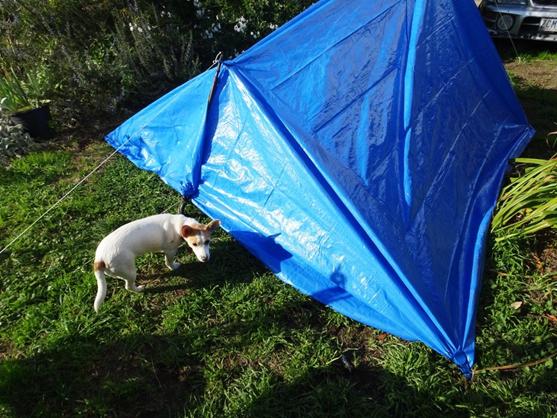
Of
course if the dogs are going to join you, you should include some dry dog food.
It keeps best in an empty plastic screw top jar. PS: Honey did actually survive
the encounter below:
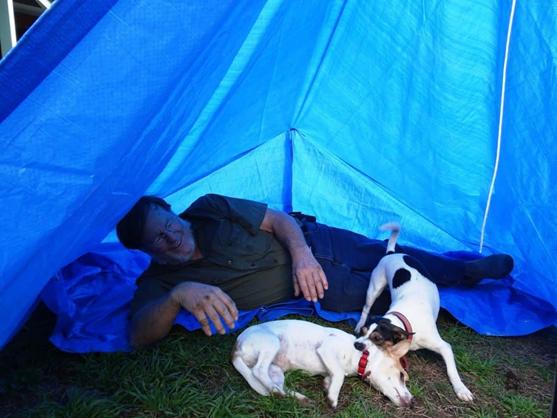
On
this trip I left two drums containing 8 days food each approximately four days
walk apart and around three days walk in from where my car will be in the
winter time. I expect I will go in there later on in the season for 2-3 weeks
by myself, or for half that time with a companion - if someone foolish enough
turns up!
See
Also:
http://www.theultralighthiker.com/cold-season-pads/
http://www.theultralighthiker.com/brawnys-tarptent/
http://www.theultralighthiker.com/poly-tent-by-the-ultralight-hiker-on-the-cheap/
http://www.theultralighthiker.com/ultralight-personal-hygiene/
http://www.theultralighthiker.com/blizzard-bag/
http://www.theultralighthiker.com/the-ultralight-fisherman/
http://www.theultralighthiker.com/improvised-bow-saw/
http://www.theultralighthiker.com/fire-umbrella/
http://www.theultralighthiker.com/a-hiking-food-compendium/
http://www.theultralighthiker.com/hammock-hunting-till-dark/
http://www.theultralighthiker.com/home-made-pack-raft/
http://www.theultralighthiker.com/fire-tent/
13/06/2018: Blizzard Bag: A cheap lightweight reusable
waterproof sleeping bag/shelter which will save your life in an emergency. I
have had one of these in the bottom of my day pack for over ten years. To date
(fortunately) I have never had to use it, though I have come pretty close a number of times. By
the same token I had an elastic bandage, a sling, painkillers and
anti-inflammatories in my bag for thirty years before they were needed (when Della dislocated her shoulder on the Dusky Track,
but when I did they certainly were needed (as well as a helicopter, and a
couple of ambos). It does not hurt to be prepared as Baden Powell used to say.
If you had been at Mafeking you might have thought the same!

I
have their original one https://www.blizzardsurvival.com/product.php/100/blizzard-survival-bag which
weighs 385 grams and has a TOG (a thermal rating somewhat like the R-rating) of
over 8. This is akin to a pretty warm duvet or doona. I don't say that you will
be comfy and cosy in midwinter in the Gippsland bush or if you become lost on
the snow fields but you will very likely survive a cold night - which is surely
a lot better than being dead. Costs UKL33.25. I know this may be more
than your life is worth! Perhaps you should consider buying one of
these before you eat out at that expensive restaurant or buy that new 4WD!
They
also have a number of lighter weight options. This one which has the same TOG
rating (8): https://www.blizzardsurvival.com/product.php/111/blizzard-survival-blanket-small It
weighs 320 grams and costs UKL22.50. Probably a better option. Why not buy two?
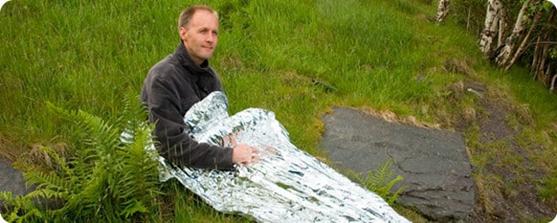
And
this one which has a lower rating of 6 https://www.blizzardsurvival.com/product.php/115/blizzard-2-layer-bag-active-range It
weighs 280 grams and costs UKL24.50.
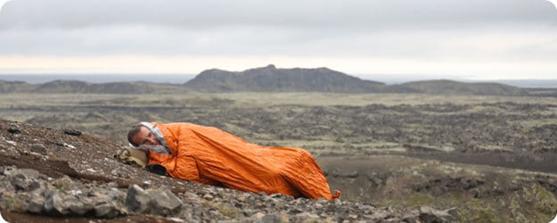
And
this interesting poncho shelter which weighs 480 grams and costs UKL48.25: https://www.blizzardsurvival.com/product.php/104/blizzard-rescue-jacket I
have one of these which I really must shrink back into a usable size with my
vacuum cleaner!
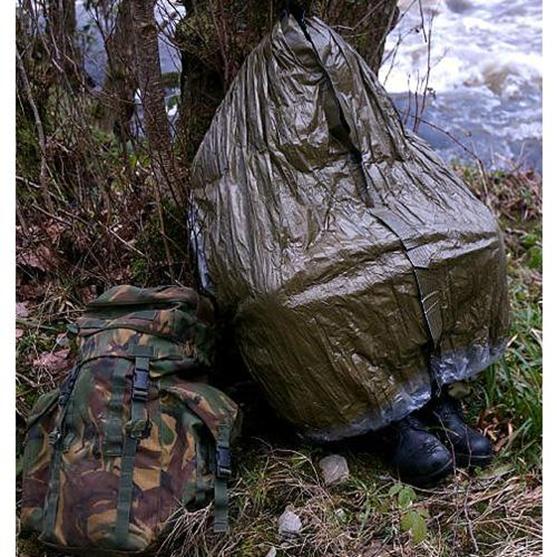
See
all their products here: https://www.blizzardsurvival.com/section.php/6/
I
particularly like this interesting 15 gram (TOG 8) UKL4 hat: https://www.blizzardsurvival.com/product.php/120/blizzard-beanie-hat-without-strap
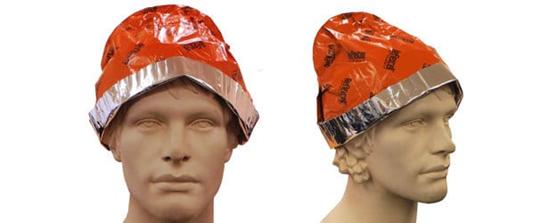
That
has to be a stocking filler for any hiker/hunter, surely? You can surely
imagine the ultra light hiker wearing one of those in the bush!At least I would
not get shot - or maybe I would!
They
even have a pet blanket: https://www.blizzardsurvival.com/product.php/125/blizzard-vet-blanket
I
think Spot can see himself in one of these (the cat may not agree, by the look
in its eyes):

Something
to consider though if you are hiking with cats: http://www.theultralighthiker.com/camping-with-cats/ &
http://www.theultralighthiker.com/most-travelled-cat/
This
kit looks like a good buy for UK 58 pounds. It includes two Reflexcell ponchos
and an emergency blanket: https://www.blizzardsurvival.com/product.php/118/blizzard-emergency-kit
Refelxcell is a three layer laminate which traps air and heat,
as you can see:

The
idea of Reflexcell™ was conceived 15 years ago when the
founder and managing director of Blizzard Survival, Derek Ryden, realized that
outdoor enthusiasts and professionals needed something more effective than
plastic bivvy bags and lighter than conventional sleeping bags.
Performance
Warmth:
8 Togs - equal to a medium weight regular sleeping bag.
Weather
protection: fully waterproof and windproof.
Storage:
bags may be stored indefinitely, and are not affected by temperature or
moisture, either during storage or in use.
Portability:
the bags' small size and light weight make them easy to carry, whether as
personal safety equipment, or for rapid deployment in emergencies involving
large groups of people.
Re-usability:
bags can be re-used many times without loss of performance.
When
you get home, a vacuum cleaner will enable you to re-pack a used Blizzard
Survival Bag to a very small size.
What
makes Blizzard's Reflexcell™ products so warm?
The
cells in the material trap warm, still air, providing insulation.
The
silver reflective surfaces block radiated heat.
The
elastic causes the material to hug the body, stopping drafts, reducing
convection, and keeping the material right next to you where it is needed.
The
outer layer is completely waterproof and windproof.
Unlike
most other insulating materials, ours works just as well when wet.
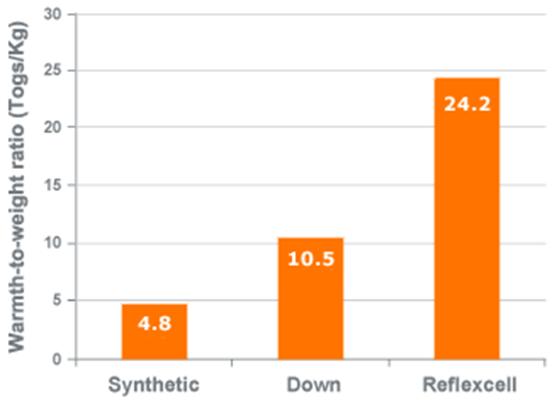
As
a rough guide, if you are wearing the type of clothes appropriate for the
season and you make some effort to find a sheltered spot and put some
insulation underneath you, then in spring, summer and autumn you should be warm
and comfortable. In winter you may not be so comfortable, but you should be
able to survive for several days in all but the most extreme conditions.
How
strong is Reflexcell™ material?
Surprisingly
strong. Single layer reflective blankets are very fragile because they are
easily punctured, and once a tear has started to develop, it rips right across
the material. This doesn’t happen to Reflexcell™ material because:
The
three layers reinforce each other, and even if one is damaged, the others
usually remain intact.
The
seams in the material act like the thick threads in ripstop nylon, stopping
tears from developing.
Materials
only tear when they are pulled tight. The elastic in the Reflexcell™ material
helps to keep the material in a relaxed state – if it doesn’t get pulled tight,
it doesn’t tear.
At
very least you should have some type of survival shelter on you at all times as
soon as you step away from your vehicle/comfort zone. I have written about this
many times. see for example:
http://www.theultralighthiker.com/survival-shelter/
http://www.theultralighthiker.com/new-ultralight-survival-shelter/
http://www.theultralighthiker.com/if-you-could-only-carry-two-things-in-the-bush-what-would-they-be/
http://www.theultralighthiker.com/raincoat-shelter/
http://www.theultralighthiker.com/pitching-the-poncho-warning-this-may-save-your-life/
See
Also:
http://www.theultralighthiker.com/a-gorilla-in-the-bush/
http://www.theultralighthiker.com/10-days-in-fiordland/
11/06/2018: Everyone Loves a Good Fire: Certainly
Della and the two dogs, Spot and Honey do. It’s been such a dry autumn that
burning off has been postponed into early winter to prevent the risk of fire.
This pile used to be a large cypress that needed to come down in my daughter’s
front yard in Traralgon. Nearly 60 metres in all the loads on the Defender to
get it her where it could be safely disposed of today.

How
time flies for dogs. Honey will be 6 months old next week and
looks like she might be going to be bigger than Spot. A little bit of Corgi in
with that Jack Russell looks like too, but maybe just a type variation. She
also looks like becoming the boss, poor Spot. Already 4 months since Tiny left us.

The
quality of the shots is not great as they were taken on my old Samsung Galaxy
S4 Mini (and the lens needed a bit of a clean too, by the looks). Maybe soon I
will have a new phone such as the Atom.
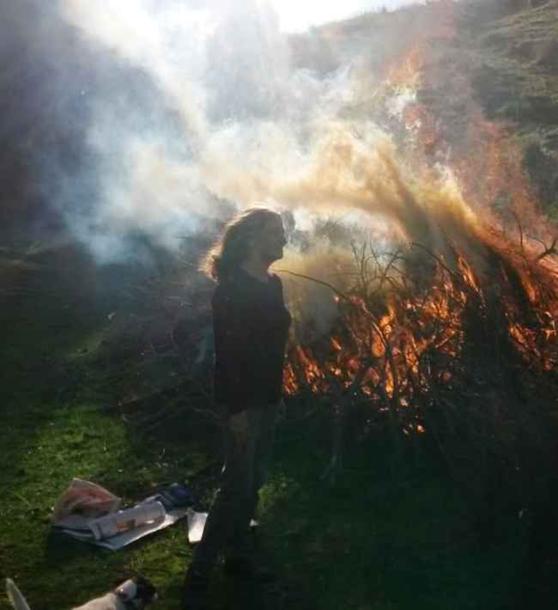
You
probably think burning off is all we do around here:
http://www.theultralighthiker.com/repurposing-camping-gear/
http://www.theultralighthiker.com/things-that-keep-you-from-hiking-hunting/
09/06/2018: How many miles can you paddle in a
pumpkin: This guy made 8.5 which is pretty awesome. What a wonderful
addition to DIY watercraft this hobby is: https://www.ripleys.com/weird-news/aboard-a-gourd/
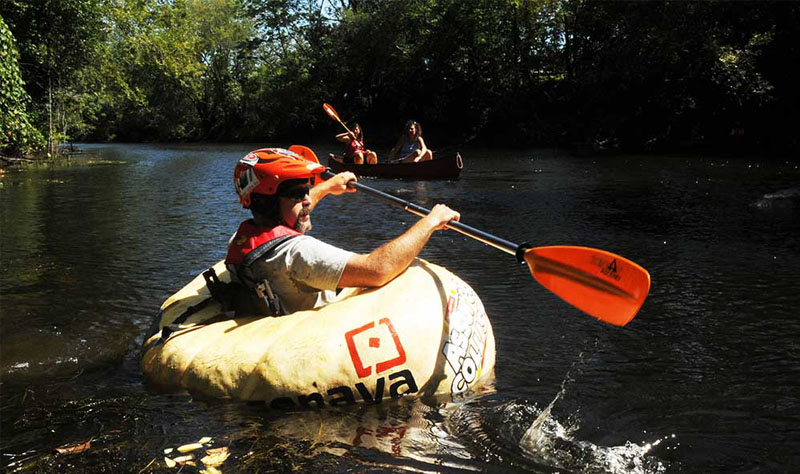
09/06/2018: Death Star Rising: Meteor 2018 LA
(ZLAF9B2)seen from farm between Ottosdal and Hartebeesfontein North West South
Africa: https://www.youtube.com/watch?time_continue=4&v=rnBvSNYy-EY
05/06/2018: Cold Season Pads: I have used the Thermarest Neoair Womens for years. It has
an (insulation) R-rating of 3.9. I was quite warm enough in it at around zero
Celsius with just a Columbia Silver Ridge shirt and trousers and a pair of thin
(Holeproof Heroes) wool socks in my - 1C Montbell bag. If it got a little
colder I might put on my down jacket as well.
My
new Big Agnes AXL has a lower R rating
(perhaps 3). Anyway at approx 4C a couple of nights ago I was still freezing
with three layers of wool plus my down coat (upper) and a pair of long johns
(as well as my Columbia trousers, a thicker pair of Wigwam wool socks together
with down socks plus a neck warmer and an insulated hat. Though the mat
is definitely more comfy than the Thermarest it just does not 'cut it' when it
is cold. Della always claims to not be warm enough too. One R rating in a mat makes
an awful lot of difference; I would not have believed how much.
I
am now investigating an even warmer mat. There are very few (compact) mats
which have an R rating over 5. The obvious 'go to' is Thermarest's X-Therm series at R 5.7. They
roll up to almost exactly the same dimensions as the Womens but are about 100
grams heavier (430 grams). Mind you, weight wise this 90 grams 'investment' in
warmth is a much better choice than trying to add more insulation and weight to
go over you. To add 5C extra warmth on top will be more like 500 grams, but the
two points of R rating will be more than 10 degrees Celsius.
Thermarest
X-Therm:

As
Jack Stephenson said, 'It’s good to minimize weight, but you can carry
much more if you get a good comfortable night’s sleep...We often hear of people
using short or narrow pads to save weight. When sleeping you need more
insulation at your feet since you are no longer producing lots of excess heat
in your legs and feet as you do when hiking. If your pad isn’t wide enough to
support your arms when on your back you won’t be able to stay comfortable and
won’t sleep well.' That first sentence is a gem. You should etch it into your
brain.
Stephenson
DAM below:

Stephensons
offer the only other real (compact) choice in cold weather mats, their
Down-Filled Air Mat (DAM). You should really read their FAQ page: https://www.warmlite.com/product/down-filled-air-mattress/
A 5'6" DAM (their smallest) will weigh 18-20 oz (say 530-590 grams; there
is a mis-print on their site) but it is 22" wide (your arms will thank you
for that extra 2") and it is 4" thick compared to the X-Therm's 2
1/2". That gets back to that comfortable night's sleep which will see you
with much more energy for hiking/hunting the next day! The R rating of the DAM is somewhere 5.5-15.5!
These
photos 'borrowed' from Trailspace's excellent site (see below) show the
6'4" dam compared to the X-Therm Regular (20"x 72"). The
5'6" DAM which is all Della or I would need would be very much the same
size as the X-Therm, but would add about another 100 grams (for comfort), and
would be warmer. Of course the DAM would have to be stored inflated (as with
other down things to preserve loft), and you need to inflate it with a bag or a
2 1/2 oz (inc battery) electric Microburst pump which is maybe a little less
convenient.
PS:
While you are over at Stephensons you should check out their bag 'system' and
particularly their Vapor Barrier concept which prevents your
sleeping bag from becoming heavier (and colder) from sweat.
Dam
on right (blue)
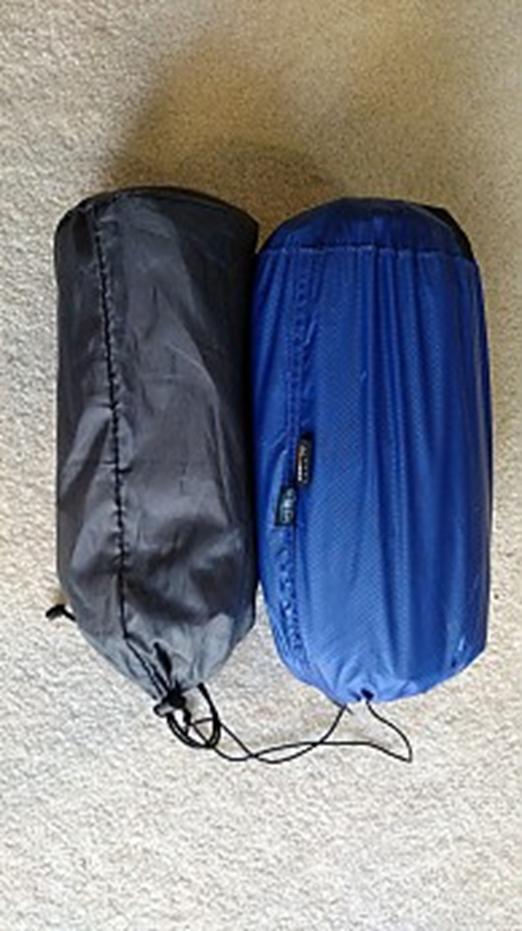
DAM
on left (red)

http://www.trailspace.com/gear/stephensons-warmlite/warmlite-triple-bag/
Another
pad to consider ( I own one and find it very comfy) but really much more
suitable for car camping is Exped's Downmat 7 which has an R rating of
5.9. The packed size though is 24 cm x 15 cm so it is going to take up a lot of
space in your pack.and it weighs 870 grams.
Yet
another pad to consider - R Rating of 4.4 and weight of just over half a kilo
(and costing only around A$100!) is this one: http://www.theultralighthiker.com/klymit-insulated-static-v-lite-sleeping-pad/
&
https://www.klymit.com/insulated-static-v-lite-sleeping-pad.html
See
Also:
http://www.theultralighthiker.com/mattresses-i-have-known/
http://www.theultralighthiker.com/unsung-genius/
Of
course, you really do need a pillow too:
http://www.theultralighthiker.com/diy-super-ultralight-pillow/
http://www.theultralighthiker.com/klymit-ultralight-pillow/
http://www.theultralighthiker.com/ul-pillows/
http://www.theultralighthiker.com/a-soft-pillow-and-a-warm-bed-under-the-stars/
http://www.theultralighthiker.com/exped-ultralight-pillow/
03/06/2018: Mattresses I have Known: I doubt
anything else about camping has changed so much as sleeping. When I was a lad I
always just slept on the bare ground. As a bit of a sissy, my only concession
to comfort was to dig the traditional hip hole (which was derided by
tougher-minded types) then maybe lean my head on something, a bag perhaps – or
just my arm.
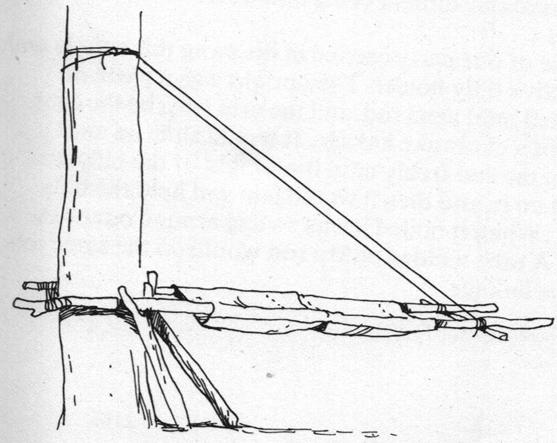
When
I was very young my parents were itinerant beekeepers so we ‘followed the flow’
of honey all over the Western slopes and plains of NSW in an old ten-ton Chev
truck, and sometimes a Willey’s Overland. Sometimes we towed a caravan but that
was filled with beekeeping equipment (extractors and such). At night we camped
in a duck tent usually on folding canvas army cots my mother set up for us.
They could very cold if you didn’t have enough blankets under you.
My
mother had a trick of folding blankets to make a bed, but I have forgotten it
now; nor can I find any reference article explaining how it worked – but it did
work very well, and the blankets never came untucked. There were never any
sheets, I remember that. We slept in our clothes and those blankets could be
quite scratchy.
This
was all before I started school. I can remember three very vivid events from
that era. Once we were camped out on the Dimbey Downs near Quirindi. During the
night a large willy willy (a sort of mini-cyclone) came and lifted all the
empty sixty pound honey tins off the back of the truck and scattered them for
miles all over the blacksoild plains. We were days chasing them up, and never
accounted for all of them. We all had to get out of bed and hang onto bts and
pieces of the tent for dear life so it would not blow away too.
I
remember the old black and tan hound Felix used to ride on the running board of
the truck. It took a long while to climb over the steep twisting road up from
Murrurundi to the pass at the top, and just about as long to creep down into
Willow Tree. Old Felix used to take this opportunity to slope off, have a hunt
then join us on the other side.
I
can also remember once my grandfather was in the car with us. The roads used to
go through a lot of properties then and there were usually gates which had to
be opened and closed before stock grids were put in. Grandfather alighted to
open a gate. Dad drove on to the next gate, then said to him, ‘George, are you
going to get out and open the gate’. He usually rode in the back with us kids.
Of course there was no replay as dad had forgetfully left him at the last gate!
Of
course I grew up North of Sydney, so much of the year (along the coast) nights
are quite balmy. You can often get by quite comfortably just sleeping on the
ground in your clothes, perhaps zipping up your jacket. If you were sleeping on
the beach as I often used to do perhaps after a night spent prawning or
spearing flathead, warm dry sand made an excellent insulator.
Further
inland, west of the Divide out on the black soil plains for example nights
often get a bit more chilly. I spent many months out there at a time as a
teenager droving sheep over a thousand miles at a time along NSW’s ‘Great Stock
Routes’.
You
would spend some time making up a ‘bough bed’ under a canvas tarp or the dray
if it rained (the smell of fresh eucalyptus is most refreshing), or gather dry
grass and ferns till you had a pile 6” to a foot deep as the nights can come in
pretty close out there rolled in your blanket with the other end of the tarp
thrown over you against the morning dew.
It
was quite delicious to slumber under cloudless skies lit by a billion brilliant
stars with only the curlew and mopoke for company – and a few thousand
‘jumbuks’. Usually there was a sheep dog to warm your back, one of the many
unimaginatively named ‘Ring’ or ‘Ginger,’ ‘Nugget’ or ‘Blackie’. All are but
memories now - along with the mates I went droving with.
Still
the introduction of the cheap blue foam mat was a godsend. For one thing it
wasn’t itchy! Laid on a 2” bed of grass or fern it created a level of comfort
and luxury undreamed of hitherto, and it wasn’t itchy. It took me a long while
before I was ready to carry one though, as they were so cumbersome when previously
all you had to lug around was a pocket knife, blanket, tarp, billy, spoon and
tucker bag – and obviously some tucker.
I
often used to head off into the bush by myself for a night or two when I was at
school. I can remember being rolled in my blanket camped under a rock ledge
high on the Watagan mnountains near Newcastle on my bough bed when I first saw
this: http://www.theultralighthiker.com/bright-sky-at-night/
About
then I was just about to buy a ‘blue
foamie’ when I noticed they were now selling inflatables which rolled up much
smaller, though they were a tad heavier – well over 500 grams for an
uninsulated pad - so I chose one of them.
Compared
to today’s mats the ones I had weren’t exactly the acme of comfort. None of
them was insulated. The first ones were just tube construction and were much
like sleeping on a rail fence. The later ‘box’ construction ones were much
better, but I never owned one of them until after I was married.
You
can hardly take your new bride on a honeymoon sleeping on the bare ground.
Being a city girl though Della had never seen the Milky Way (and was frankly
astonished by it) or woken in the morning covered in dew! Nearly half a century
later she is a country girl through and through, and still enjoys a night or a
dozen under the stars – we have just spent a fortnight camping out around the Scottish Highlands.
The
first insulated inflatable was made by the Stephensons: http://www.theultralighthiker.com/unsung-genius/
I never had one. Thermarest commecialised the idea (in open cell foam) and as
they say, ‘the rest is history’. I had a range of Thermarests over the years.
Before
I had a ‘bad back’ I could manage with a ¾ length mat, so for years my go-to
mat was a 350 gram model of theirs which I even used in a hammock where it left
a few bits and pieces a little chilly on a cold night. Now I find that having
my legs drop down that inch or two just gives me a nasty lumbar pain so I choose
a longer mat.
For
car camping we had their longer models and even their ‘luxury’ 2” thick self
inflating model (which took up a fair amount of the car)! You do get so used to
these luxuries. Nowadays I am apt to think I will die if I just had to lie down
for a night wrapped in only a coat or blanket straight on the cold ground as I
did a thousand times when I was a youth, mostly too with no shelter overhead,
just looking round for a bit of shelter if rain threatened: a rock overhang, a
hollow log or tree, or a bolt of canvas draped over me.
It
takes a bit more than that to kill a man though, so I would not. I have slept
sitting up in front a of a fire on a snowy night well below freezing wrapped
only in one of those ubiquitous 50 gram aluminium backed plastic space
blankets, which I recommend you carry in your day pack if you wish to survive.
It may not have been the most comfortable nights I have spent but all in all no
worse than a long aeroplane flight such as that from Melbourne to Edinburgh
which we just survived (both ways).
I
really can’t imagine how people become ‘travel junkies’. I would not go (or
have gone) if Della had not wanted to visit the land of her ancestors. And I
would not go again. How people can tolerate so many other people everywhere
they go is beyond me. I was not even tempted to travel down into England (where
most of my ancestors originated). Just too many people everywhere.
My
first insulated inflatable mat was a Big Agnes, the predecessor of their Air
Core model with its ‘I-Beam’ construction. It was way ahead of the old tube
type mattresses in comfort, plus you did not get a cold back on even the most
freezing nights. My first one weighed over 600 grams but I was utterly rapt in
its level of comfort. We found that we could fit on their ‘Petite’ (5’ long)
models so this reduced our carry to nearer 500 grams which I thought would
never be bettered. You did have to have them ‘right side up’ though, or they
did not work – this may still be the case. To Americans, ‘right side up’ means
‘face up’ ie the product’s name should be on top.
Then
Thermarest came along and revolutionized the field for years with their
‘NeoAir’ line of which the best representative (for me) was their Women’s model at 340 grams! I must have
slept on mine nigh on a thousand times over the last ten years. It has a few
pieces of sticky tape here and there where a thistle
or a dog poked/chewed a hole in it, but it is still quite serviceable and has
done double service most trips as a chair, and as a raft as well.
I
also have their ¾ length model at 270 grams but as I said my back won’t let me
really enjoy it otherwise it would always be in my hunting day pack along with my Montbell
sleeping bag (500 grams), a Cuben tarp (150 grams), a puffer jacket, an
ultralight billy and some tucker just in case I decided I was going to spend
the night somewhere remote and promising.
Now
I have Big Agnes’ new AXL pad which beats
everything I have ever owned for comfort hands down. Their regular 6’ model
weighs in at 300 grams yet is just under 4” thick, so you can really sink down
into it. I somehow doubt anyone will better that, but I’m sure Thermarest (for
one) are working hard on it. In the meantime, if you are in the market for a
pad, try one of these.
PS:
The illustration of a swagman's bag bed is just one of many similar types of
bed which could be made simply with a few boughs and a couple of hessian bags.
I particularly like the ingenuity of this one which makes use of another
bushman's favourite: some fencing wire. You always used to find such beds in
shearers' quarters and stockmen's huts. They should be on the National Trust as
priceless relics of a bygone era. Jute or hessian bags were much more
comfortable and serviceable (and recyclable) than today's ubiquitous poly bags.
They were reused like this endlessly until they were no use save as tinder. A
wet one was also excellent for helping put out a fire. Without them many more
lives would have been lost during the 1939 bushfire, for example.
30/05/2018:
Genius Strainer Post: This was one
of the most interesting things I saw on our recent trip to Scotland:1202 on 15th 1104 on 12th
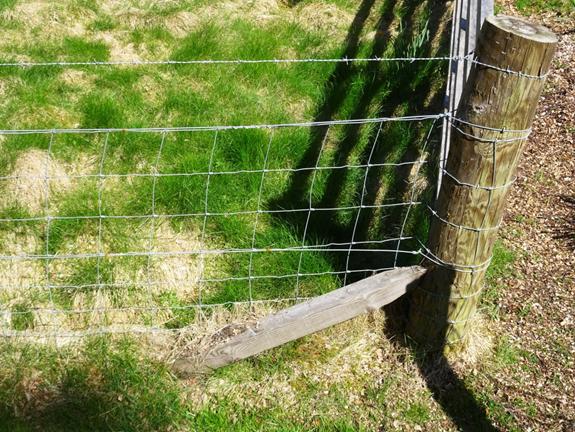

I
was astonished that (such a) short stay only about one-third of the way up even
a tall post such as used on deer fencing nonetheless maintained the wire at a
much tauter strain than I normally apply worked so perfectly – but it does. The
‘poms’ have a thing or two to teach us yet.
Instructions
here: https://www.lifestyleblock.co.nz/lifestyle-file/running-the-farm/fencing/item/427-strainer-assemblies
30/05/2018:
Verney Carron 'Stop&Go®': Considerable
angst is being generated this morning
about this ‘new’ action shotgun just as was present not so long ago about the Adler’s ‘new’ 150 year old action, and overlooking the
fact that it is already available in shops as a ‘Speedline’ rifle.

The
firearm in question ejects the spent shell ‘automatically’ using the firearm’s
recoil (like a semi-automatic) but it does not reload itself (watch the video
below). There is a bolt stop which you have to press to complete the reload
before another shot is available at the trigger. This two-step process makes it
pretty much the same as other manual loading firearms such as bolt, lever or
pump action https://www.youtube.com/watch?v=EMOABUq3FmQ
As
a lever action hunting rifle devotee
(because of its safety and speed at getting off the first and subsequent shots)
I would buy an Adler- type shotgun for hunting (if I was in the market for a
new gun – and when is this no the case; only when there is not enough money!)
but I probably wouldn’t buy this ‘Stop&Go action type firearm because it is
less safe to walk around with unloaded than a lever action.
However,
as many shooters walk around most of the time with a round in the breech (and
there is no legislation preventing this) relying only on the safety catch, I
can’t see any additional problem with this ‘new’ action – indeed it is
inherently safer than the previous strategy.
Of
course there is also the point that it would only be sold to licenced shooters
anyway, folks who already have controlled access to a whole range of
potentially lethal equipment without there being much evidence that any of them
ever abuse that access. On the other hand the public has uncontrolled access to
a bewildering range of kitchen and gardening equipment which is regularly used
to kill and injure people without anyone vociferously advocating bans on such
things as knives and axes that I am aware of. Mostly I would much rather face a
firearm in a public place than such a bladed weapon in a confined space, though
I would rather face neither.
People
are shot every now and then due to a failure of firearm’s safety (such as
over-reliance on safety catches). This is tragic, but I doubt that many
shooters would want further legislation to protect themselves from the
occasional very isolated accident. Life is fraught with all sorts of dangers.
We
once bought a farm cheaply as a deceased estate because the previous owner had
choked to death on a boiled lolly. Obviously as I benefited I would not be
advocating banning boiled lollies, but I doubt whether I could offer up a
compelling argument for their prohibition even if I had not.
See
Also:
http://www.theultralighthiker.com/308s/
http://www.theultralighthiker.com/the-ultralight-deer-hunter/
29/05/2018:
Brawny’s ‘Tarptent’: This is a very
useful video on how to create a lightweight shelter from a standard 10’ x 12’
silnylon tarp:
https://www.youtube.com/watch?v=ir-5R9PCIok
Many
other fascinating vids by this outstanding lady, Carol Wellman: https://www.youtube.com/results?search_query=brawny03
You
can buy such a tarp eg from Aliexpress for around $30: http://www.theultralighthiker.com/ultralight-hiking-on-a-budget/
Hiking does not have to be just for the well-heeled!
More
about ‘Brawny here: http://www.trailquest.net/ultralight.html
& http://www.trailquest.net/BRindex.html
Some
other interesting shelter ideas here: https://ultralighter.blogspot.com.au/2008/11/under-this-shall-ye-sleep.html
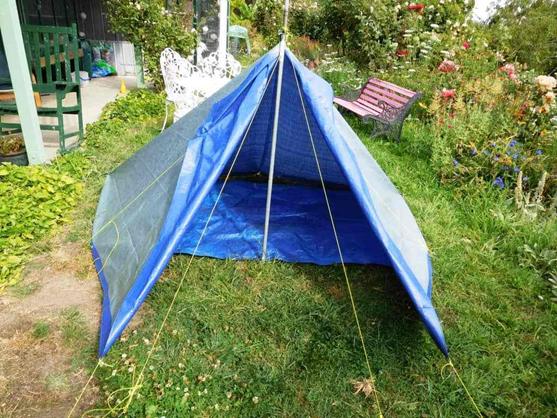
The
photo is from one of my takes on tarp tents, try this $10 tent: https://www.theultralighthiker.com/poly-tent-by-the-ultralight-hiker-on-the-cheap/ I
have been sleeping under tarps of various sorts for around sixty years - and i
am still here, so why not try one?
28/05/2018:
Corrugated Heat Diffuser, 3 grams. Sick
of having to clean the burned bottom of your pot, particularly after a long
simmer. Zelph has the answer. Place this underneath your pot above the burner.
I’m afraid he doesn’t give any other clues to how it was made, but I’m sure if
you have any experience in sheet metal work you will work something out. I
imagine you could fairly easily make one out of a piece of aluminium flashing,
or some titanium sheet. I hope he doesn’t mind my reposting his photo
here: http://www.bplite.com/viewtopic.php?f=2&t=6449
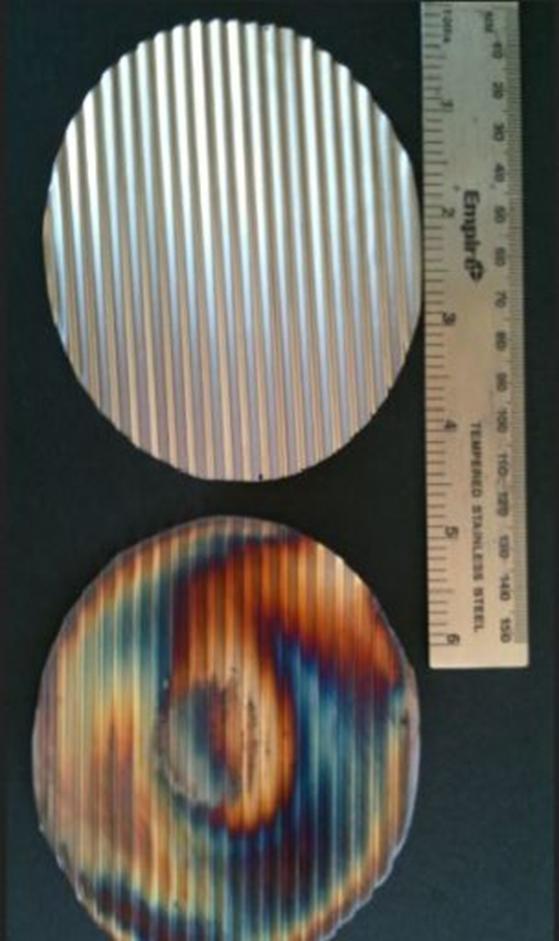
He
has many other interesting ideas. See here, for example: http://www.woodgaz-stove.com/ Perhaps
he will make you one?
See
Also: http://www.theultralighthiker.com/new-fancy-feast-stove/
28/05/2018:
Freedom and the DIY Gunsmith: http://americandigest.org/wp/long-read-of-the-week-the-mathematics-of-countering-tyranny-by-james-wesley-rawles/
& https://survivalblog.com/building-your-own-no-ffl-ar-from-an-80-complete-receiver-by-jag/
26/05/2018:
Happy Birthday Ultralight Hiker: Who
would have thought three years ago today that this blog would have over 1100
posts, probably a million words plus of content, over 15,000 images, and so
many followers - often more than one a minute!
My
daughter Merrin launched it with this Facebook post back in 2015. She said,
‘Lately I have been working on a new website and Facebook page for my dad
Steve's incredible Hiking Blog "The Ultralight Hiker". If you or
someone you know is interested in hiking, canoeing, camping, hunting etc in
Gippsland, Australia and New Zealand you might like to take a look or spread
the word. The content has been years in the making so you will find hundreds of
posts on everything from places to go, the best light weight equipment,
inspiring explorers, wildlife and more. Visit: www.theultralighthiker.com for more! Thank
you.’
Facebook
also reminds me this morning that this was also the day three years ago when I
published this story on Facebook and my old hiking blog: http://www.theultralighthiker.com/dusky-track-canoeing-the-seaforth/
What an adventure that was, but one I will probably not repeat if I want to
continue breathing!
Some
recent doings:
Exploring
a Brock in Northern Scotland last week:
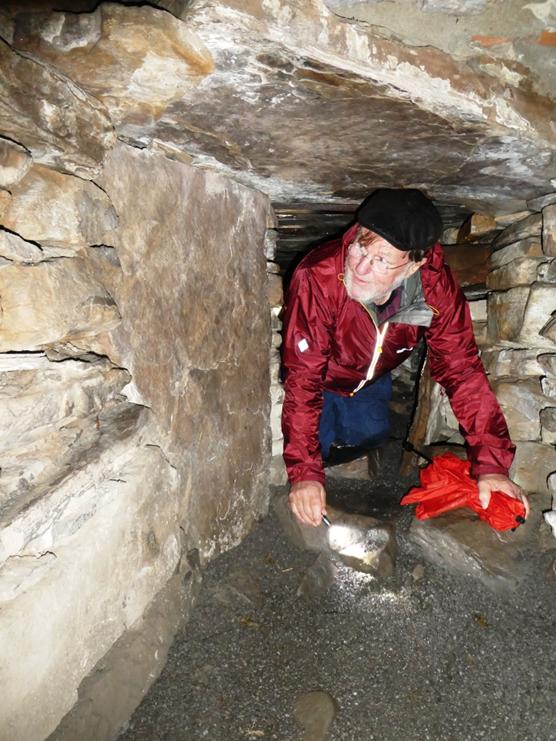
And
(ditto) relaxing by the Glen Orchy:
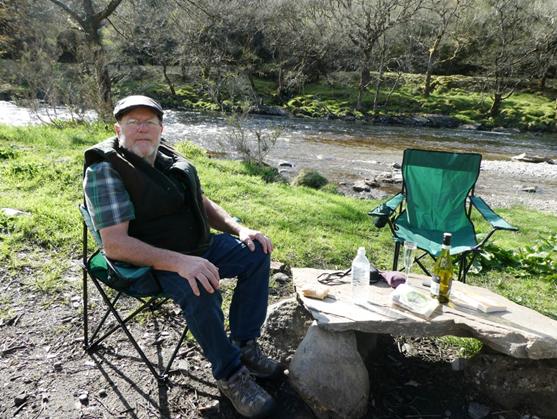
26/05/2018:
Mighty Tiny Phone: Following the
success of their ‘Jelly’ the smallest 4G smartphone, which
is still available for US124.99 (May 2018) Uniherrtz have developed
this little beauty the 'Atom' which comes with many other features (including
now a really serious 16 meg camera).

If
you remember the Jelly weighs only 60 grams and fits in the fob pocket of your
jeans. The new model is even waterproof. There is a special 47% discount offer
available now: https://www.ogadget.com/x1/atom#Join This
could be the perfect phone for hunting or hiking when weight really counts.
25/05/2018:
Nightcore Tube Hat Clip: My thanks
to Kiarnan over at Reddit for this idea https://imgur.com/gallery/JfLTn
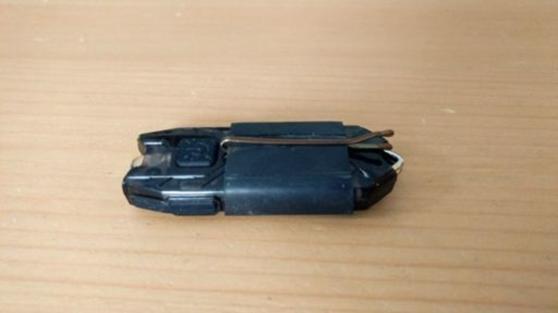
I
t worked just as well with a couple of 'O-rings' such as I usually use in my own head torch mod, but this has the
advantage of preventing the reflection on your glasses you get from mine, so it
is better in some ways.
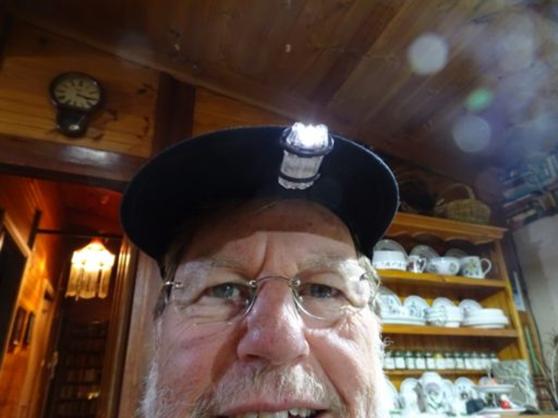
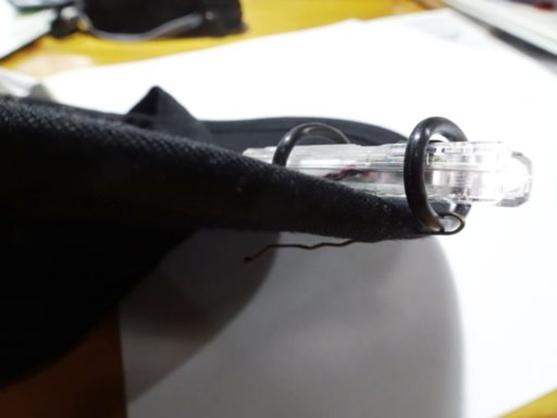
And
added a bare gram to the weight of the torch.
See
Also:
http://www.theultralighthiker.com/11-gram-rechargeable-head-torch/
25/05/2018:
New Evidence of Fiordland Moose:
Some time back I was contacted by a young journalist, Charlie Mitchell from
Stuff, New Zealand. I helped him out as much as I could from my experiences.
Over the last two days I have been thrilled to read and see what he has put
together of the continued existence of this wonderful herd. There are other
moose hunters out there as well. That is good news.

Les
Murrrell's two bulls in the Seaforth River, 1927.
There
have been two authentic DNA confirmations of the NZ moose this century. Only
last year I encountered fresh browse and fresh moose scent in the Hauroko Burn.
Eventually
someone's hard work will pay off with authenticated footage of one of these
'gentle giants'. Of course everyone involved hopes it will be their photos
which reveal this strange carry-over from an ancient era lurking in the
primeval forests of New Zealand. I will be having another crack at
finding them myself if my fitness and finances hold up. I will keep you posted.
Meanwhile
you can find Charlie's two fine articles here:
https://www.stuff.co.nz/national/103196185/new-zealands-moose-hunt-a-centurylong-quest-for-a-forests-final-secret
https://www.stuff.co.nz/national/104071821/there-are-signs-moose-still-live-in-nzs-wilderness
See
also my posts, eg here:
http://www.theultralighthiker.com/the-lure-of-the-moose/
http://www.theultralighthiker.com/from-dawn-to-dusky-day-2/
24/05/2018:
A Cure for Slippery Mats: I have
just spent a couple of weeks sleeping on my new Big Agnes AXL Air mat in
Scotland. It is indubitably the most comfortable mat I have ever slept on, but
it does suffer from being a tad slippery. I will be taking some of my own
advice below.
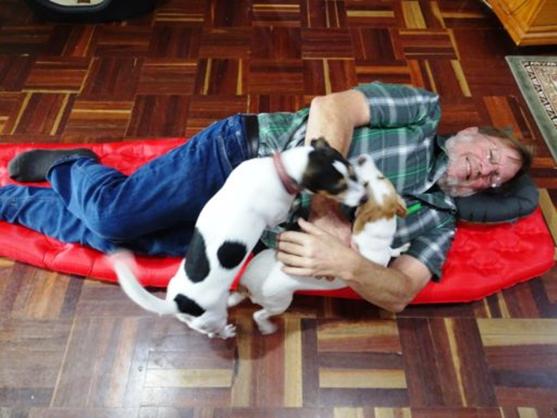
(The
dogs as you can see will not agree to being left behind again!)
Before
you begin on anything more complex remember the problem can just be caused by
an over inflated pad. For best comfort and stability the pad should be inflated
just enough to keep your bum from touching the ground. That way your body sinks
into the mat, making it comform to your shape. That is the secret of a comfy
night’s sleep anyway.
The
second secret to a perfect mat is to have it just about the length (and width)
of your body. Any part of the mat which sticks out from your body will just
fill with air which is not doing anything at all. In fact it is making the mat
less comfortable as you will have to inflate it more so that your bum doesn't
touch the ground. I recommend shortening your mat to exactly fit your
needs. You will also save a couple of ounces doing so.
But
‘if the problem persists’ as they say, then try some of these solutions:
- Roll
something like a t-shirt up and put it under your mat beneath your knees.
This will stop your bum from sliding down the hill. Eg:https://www.youtube.com/watch?v=fqlup8pgM7U
- Or
put it on the mat (just like a garment at the top to create friction): https://www.youtube.com/watch?v=kpZTf8_NS-k
- Add
strategic dots or lines of seam sealer to the mat : https://www.backpacker.com/gear/how-can-i-stop-sliding-off-my-sleeping-pad
- Add
a Gossamer gear Thin light pad – this will also increase the ‘R-rating- of
your setup a bit.
- Add
a piece of anti slip grid matting approx 9 x 12 (such as you can buy from
caravan stores) just below your bum.
- Thermarest
non slip fabric spray such as this https://www.amazon.com/Performix-075815100139-Super-Fabric-Spray/dp/B000UDCC8K
Thermarest used to sell a proprietary product which apparently worked well
and lasted for years. You may still be able to find some.
I
would be a bit careful using such spray ons. Check them out on some cheap
fabric first. Ideally you will want one which just makes the material of your
pad slightly tacky (without increasing weight) and without attracting dirt! You
will also want one which does not harm the pad.
See
Also:
http://www.theultralighthiker.com/modifyingshortening-hiking-mats/
http://www.theultralighthiker.com/adding-down-to-a-sleeping-bag/
23/05/2018:
Lentil and Bacon Soup: Here is a
simple tasty lentil soup (for those who don't like curry) made entirely from
dry ingredients. I made some up for my lunch today and found it pleasant but
perhaps a bit strong tasting. Next time i will go easier on some of the
stronger ingredients such as the onion and garlic powder and the tomato puree.
Still, it makes a meals big enough for two for just a few cents and is very
light to carry.

To
3 1/2 cups of water add:
i
cup red lentils14o grams Hormel bacon pieces
2
teaspoons onion powder
1
teaspoon garlic powder
1/2
teaspoon ground white pepper
1
sachet Continental garden vegie cupasoup (or similar)
1
50 gram sachet of tomato puree (or 1/2 sachet of tomato cupasoup)
4
teaspoons milk powder
Bring
to the boil then simmer for 10 minutes stirring occasionally
Enjoy!
See
Also:
http://www.theultralighthiker.com/a-hiking-food-compendium/
17/05/2018:
Car-Camper Conversion: $50: We have
recently been on a car camping holiday in Scotland where we wanted to stay away
from people as much as possible on such a crowded island, and save on accommodation
costs by sleeping in the rental car wherever we could find a pleasant spot. The
car we hired turned out to be a VW Golf which you might think would be a tad
small for this purpose, but when the front seats are all the way forward and
flipped over there is over 6' of room. All that was needed was to create a
platform to fill up the well in front of the rear seats once they were folded
down into the stowage position.
A
4' x 2' x 1/2" sheet of plywood from the local hardware and a few short
lengths of 3" x 2" were all that was needed to create a platform with
two legs which would support our weight. I had my trusty Fiskars pruning saw for this purpose and a
$10 hammer. Then it was only a matter of rolling out the hiking mats and sleeping
bags - and Voila! Our bedroom for the night. I just used some 3" flat head
nails to assemble this but you could use the nail holes as guide holes for
screws if you wanted a more secure permanent structure
Just
make the platform like this:
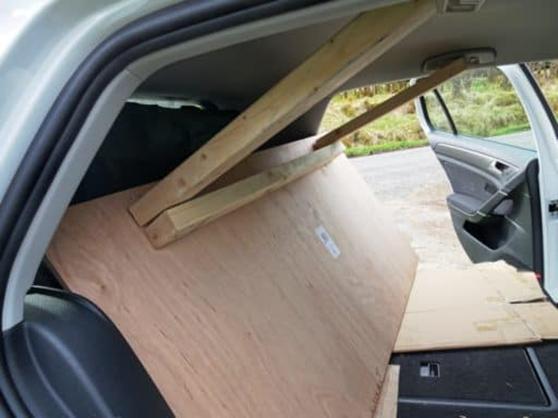
Pop
it down like this. We packed some flattened cardboard boxes behind so we did
not feel the 1/2" drop.

And
there we are, as cosy as. There was plenty of room too stow all our gear while
we slept. We quickly got into a routine of knowing where everything went, and
could be quickly in/out of bed and making a cuppa in the front seat with the
car heater on those frosty mornings. We did not have to worry about rain/wind
carrying off our small hiking tent or being bothered by strangers.
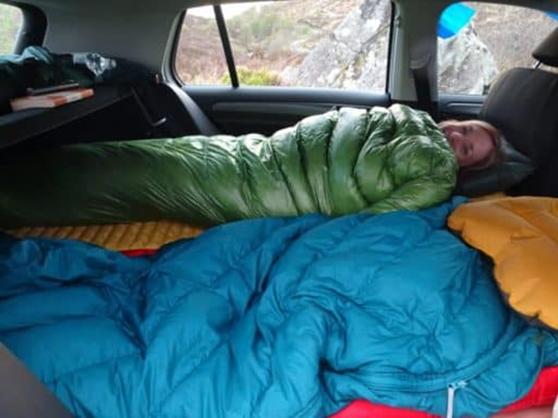
Detail
of the window flaps:

Leaving
about a 1"gap:

Then
we were able to find some lovely private spots - complete with: 'A Flask
of Wine, a Book of Verse —
and Thou Beside me singing in the Wilderness —
And Wilderness is Paradise enow'. — from
The Rubaiyat of Omar Khayyam
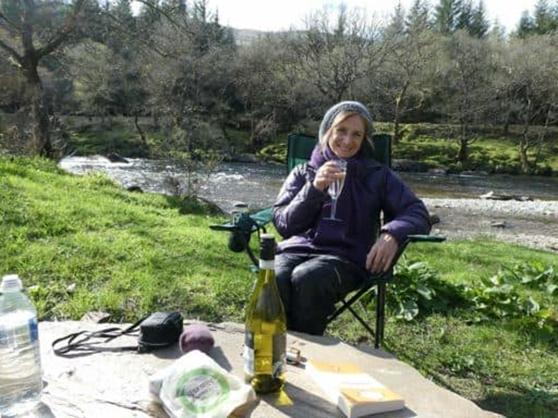
The
Loch, the loch the beautiful loch - I wish I was in it up to my hock'!
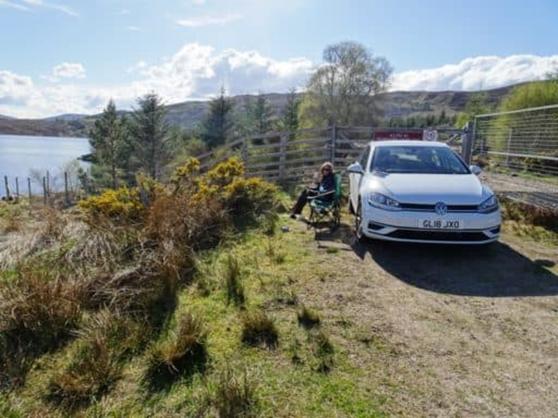
Should
be some wild otters along here any minute. Plenty of trout anyway:
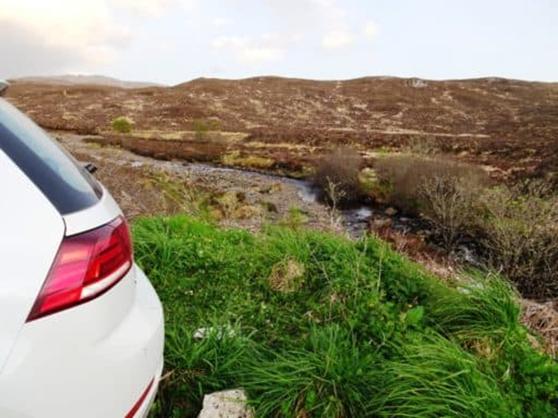
This
is where the other 'free campers' stop (on the island of Skye). You can find
better places than this if you get off the main roads. It is quite lawful to
car camp pretty much anywhere in Scotland at least. We more or less
circumnavigated it - the best bits were definitely on the Borders.

We
also carried a Sakura peltier-type cooler bag which kept
our food and drinks adequately cool and we have a couple of gas burners for
cooking and warming water for a Sea to Summit portable shower. I also cut
down a 6' x 4' poly tarp into two pieces for standing on when we are getting
changed and two strips to keep the rain out of the windows when we have them
open about an inch of a night. All of this works very well. It is astonishingly
easy to find free, private spots to spend the nights even in an island as
crowded as the UK!
06/05/2018: Hello Possums: As Dame Edna would
say...just installed some security cameras. This one shows our front gate.
Pretty much as soon as it got dark our wild critters got very busy: one fox,
two ringtails, two brushtails, two rabbits. Who know what will turn up as time
goes by: https://youtu.be/BDcQRD4e-_s/
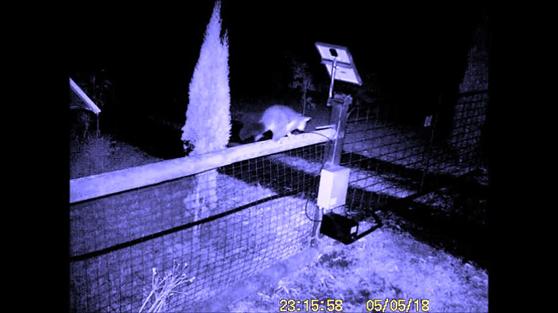
So
Brer Fox hasn't eaten all of them
after all!
05/05/2018: A Career in Whale Dissection: https://www.atlasobscura.com/articles/how-anatomists-dissect-whales
04/05/2018: These Jeans Will Outlive You: These
jeans are 52% Dyneema which as everyone knows is stronger than steel. It is
envisaged that you will never wear them out so that their high price of US$275
may well be justified: https://gearjunkie.com/outlier-dyneem-denim-jeans-review
& https://shop.outlier.nyc/shop/retail/end-of-worlds.html

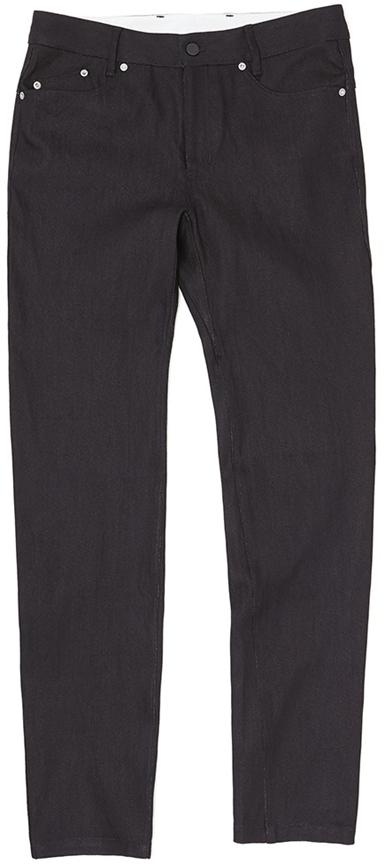
You
could pair them with this top which is claimed will last a century
http://www.theultralighthiker.com/never-buy-clothes-again/
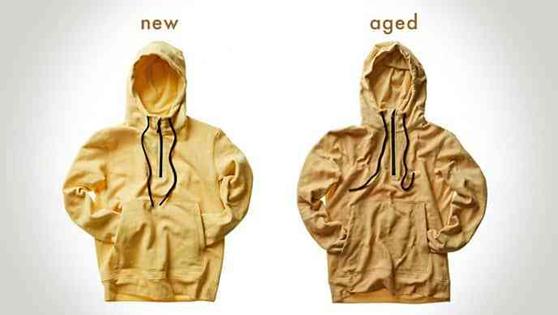
or
these other bits of gear which are also supposed to never wear out – or your
money back:
http://www.theultralighthiker.com/woven-dyneema/
http://www.theultralighthiker.com/warranties-on-outdoor-gear/
04/05/2018: Some people are just crazy – riding an 80’
wave: https://www.youtube.com/watch?time_continue=30&v=-2jbS7uiCuU
03/05/2018: Nepalese Roads: http://twistedsifter.com/videos/dangerous-waterfall-road-in-nepal-pov/
02/05/2018: The Littlest Hiker: My grandson Milo
‘intent’! I have raised or helped raise a tiny army of little hikers. Some
advice: always move at the pace of the slowest ‘little hiker’. This is best
achieved by having him/her out the front. Little hikers’ prefer to skip, dance
or run than walk. (You also will benefit from changing your gait).

They
are also particularly susceptible to ‘I Spy,’ ‘pick up sticks’ and ‘skipping
stones’. Games of all sorts make life more fun no matter your age. Never forget
the ‘little hiker’ in yourself! They will want to stop and look more than you
usually do. The world is a newer place for them. It is a worthwhile trick for
you to relearn too. There really is no reason to hurry. The journey is
everything!
A
jolly song will raise the spirits and keep them tramping happily along the
trail. Here are some of Milo’s favourites: www.theultralighthiker.com/i-love-to-go-awandering-hiking-songs/
. If they begin to flag, grandad’s (any adult’s) shoulders are the best place
to be, and a better view can be had up there.
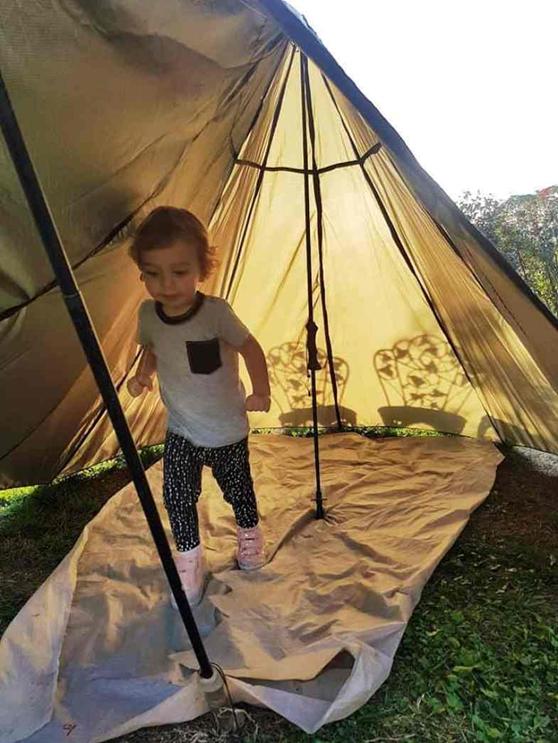
Lightweight
gear is specially important for tiny hikers. They can carry their own stuff,
but keep it light and make it fun! For example, they will particularly enjoy
lighting a fire. Knowing how to do so may save their lives
one day, so do not stint on this game. A pack of marshmallows to roast on a
stick might be a good thing to have in your pocket, apart from a cigarette
lighter. PS: Always carry an umbrella. Rain is much more fun from under a roof!
Della:
'This week Steve has been putting the finishing touches to one of the
ultralight tents he has been designing and making. Here is little Milo enjoying
its aesthetic splendour in our garden while we were measuring and fitting its
bathtub floor. (Thanks Merrin for the lovely pic!) Just some seam-sealing to
finish today before it is packed into its bag weighing only about 650 grams
including stakes and guys. Made from waterproof silpoly and silnylon it will
keep us dry in the roughest of weather: Looking forward to enjoying this
delightfully backpackable home-away-from-home! Sadly the Milo-accessory is not
included, but we have some far-flung destinations in mind! '
PS:
This is my Silgloo Tent now with a bathtub floor. Here it is in use.
02/05/2018: You have a lot to look forward to! I am
certainly happier at 60+: NB To really enjoy these years you need to ramp
up your physical activity: particularly leg work, strength and endurance – use
it or lose it: https://nypost.com/2018/04/28/science-proves-that-happiness-begins-at-50/
01/05/2018: Ultralight Rain Gear: Our new Montbell
raincoats and umbrellas have arrived just in time for testing on an upcoming
trip. The two shown are Dellla's (modelled by our daughter, Merrin) in front of
our Siligloo tent which we have been making a bathtub floor for. The coat is the Versalite Women's Medium (colour Mallard)
which weighs 160 grams (on our scales). It s claimed waterproofness is 30,000
and breathability 43,000. Della is very pleased with it. It will save her a
couple of hundred grams off her pack weight. Some of that saving will be taken
up (on some trips) by her Ultralight Trekking Umbrella at 128 grams.
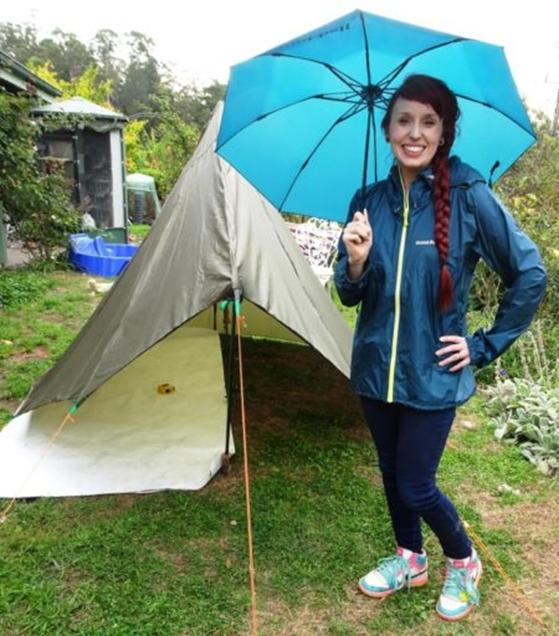
I
have a matching jacket (Burgundy Mens XL = 200 grams) and an 'emergency'
umbrella, their Travel Umbrella at 86 gram. Unbelievable.
Yet durable too! It is a magical piece of gear which as to be seen to be
believed - but a real life saver if you are ever stuck outside for a protracted
period in freezing rain - something which can
happen at any time of the year given the right (wrong) circumstances.
These
items come highly recommendedby lots of other folk. We have heaps of other Montbell gear including their Ultralight Super Super Stretch Spiral Down Hugger #3
sleeping bags, Superior Down vests and coats,and Thermawrap vests and coats for
example. Their gear has always been just about the lightest, best priced, and
best gear we have found. The items are available in Australia from Larry Adler here.
We
can now have fun hiking in the rain.
30/04/2018: The greatness of others can uplift us all.
The astonishing story of Maximilian Kolbe is a case in point: https://quadrant.org.au/magazine/2018/04/love-creative/
28/04/2018: Ultralight Bathtub Floor: I have made
an ultralight bathtub floor for my Siligloo tent in preparation for a trip we
are soon taking. It replaces the piece of spinnaker fabric we have been using,
adding less than 50 grams. You will remember that the Siligloo Tent weighed 385
grams when I made it. I have added some extra guys against really inclement
weather which add less than 20 grams. This floor weighs less than 150 grams, so
the total for the tent including stakes is less than 600 grams, but as you can
see it is really huge! When I am bush camping I usually just use a couple of
bush poles for tent poles.
This
is how I sewed and arranged the eight corners. 1 1/4" in and 2" down.
Once the gear is in it will work very well.
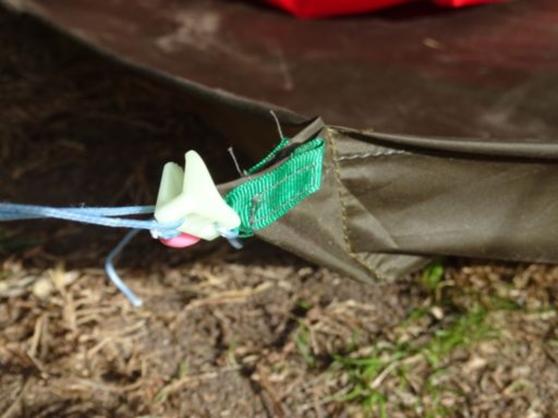
The
sides sit up off the ground nicely without pulling the tent in at all.
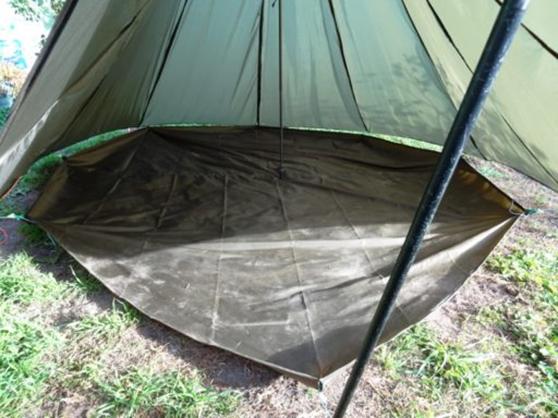
You
can see how much room there is with the two pads inside. The one on the right
is the Thermarest Neoair Womens.The one on the left is my new Big Agnes
Insulated AXL Air Pad (300 grams) and 3 3/4" thick! This is the most
comfortable hiking pad i have ever owned. I could still cut it down by 6"
to save 30 grams.
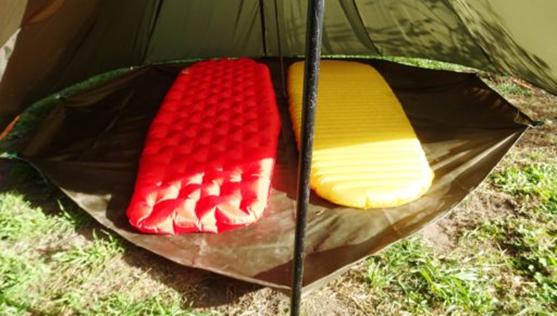
You
can easily reduce the height of both poles if it comes in to rain. This will
make sure you stay dry no matter how much rain thee is. I see no reason for
doors - just something to go wrong. or insect netting. A head net and some insect repellent is all you need.
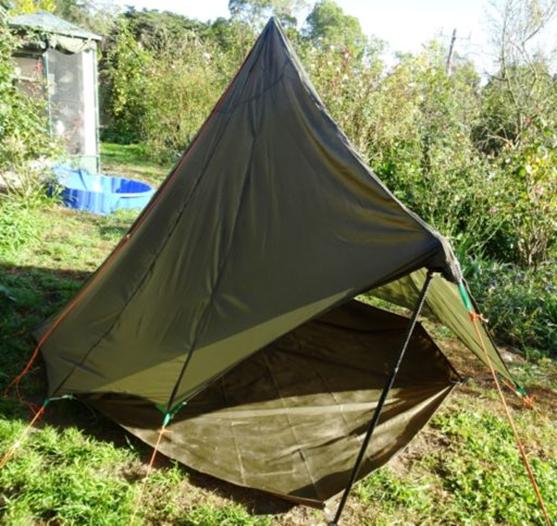
Just
a couple of bush poles makes us happy anyway. Canoeing
the Wonnangatta recently.
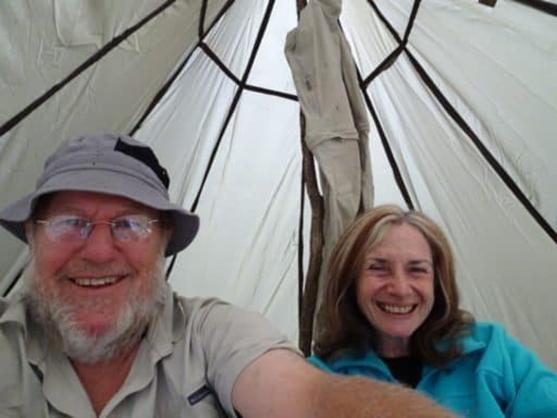
26/04/2018: Della’s New Camera: ‘Trying out my new
camera today in the gloriously warm autumn light. Thank you Steve Jones for the
great Mother's Day gift, and for allowing me to play with it ahead of time! The
first pic was snapped on auto through the maple branches in our garden. No
filter, only the warm glow of the autumn sun. Nice job, Panasonic TZ90! The
second one does allow a little tweak with a Google filter to heighten the
contrast and looks a little more special, I think. So, having tried auto mode,
tomorrow I will play with the camera's 30x optical zoom...no privacy for the
Jeeralang bird-life now!’ (Della) We can look forward to a veritable visual
feast now!
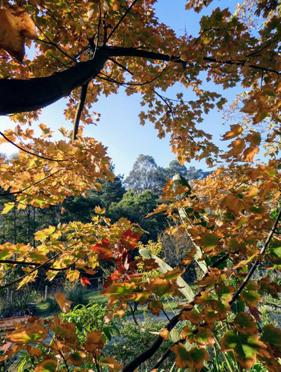

26/04/2018: Fuyu: ‘Our Fuyu persimmon tree is
loaded this year. The birds have started feasting on them so we picked the
ripest and will finish them off inside. The tree is a young one so we haven't
had enough of them to beat the birds before. They are firm but still edible at
this stage, so hoping that they will ripen satisfactorily inside despite being
picked earlier than optimal!’ (Della) We are going to try putting them in the
fridge to keep them from spoiling and just taking out a couple each day to
ripen on the window ledge.
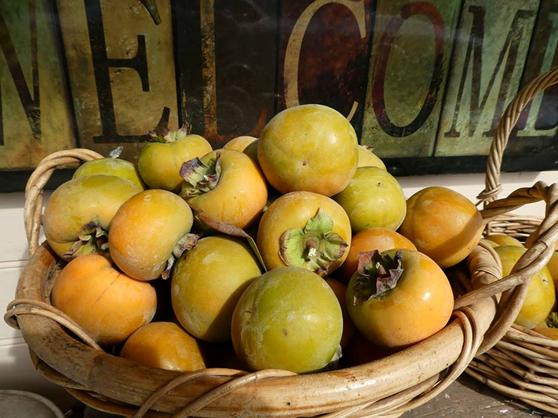
26/04/2018: Honey Sticks: Young
Honey loves sticks. This one clearly won't fit through the doggy door! Spot is
trying to tell her as much!
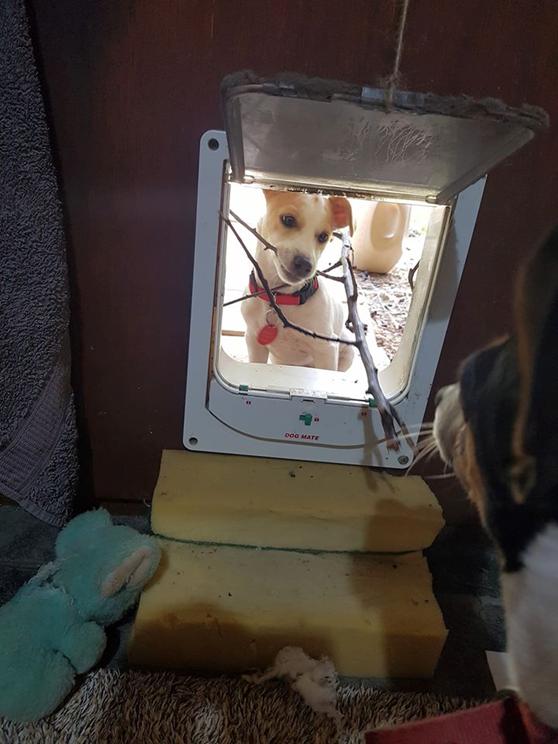
26/04/2018: Why do I love my garden? Well, one of
the many reasons is that it is full of memories of wonderful fellow gardeners.
Today's pumpkin harvest is a perfect example! These are called "Greg's
pumpkins", a variety developed by Greg Roberts and given to me by Claire
Roberts 2 autumns ago to make a batch of pumpkin soup. They were so delicious
that I kept some seeds with the intention of planting my own. The seeds are
(typically) still in a jar but the excess seed waste must have survived in the compost bin and struck after I spread
compost on the asparagus bed last spring. So here they are today, ripe
pumpkins, a reminder of the late Greg's daily pleasure and industry in his own
beautiful garden! And whilst picking them and thinking of Greg, my thoughts
wandered amongst other keen gardeners who are also sadly missed but whose
memories are a constant presence in the garden plants they have given to me:
Mrs Sawyer who owned our farm from around 1900 to the late 1960s and planted
our treasured plum trees, our "helicopter tree" and our "naked
lady" and snowflake bulbs; Marg Davies from Tarwin Lower whose potato vine
has been a dominant feature of the garden for over 25 years; John Snell, whose
flowering dogwood, mock orange and violets are beautiful reminders of his joy
in gardens. A garden, you see, does not belong to just one person: It is a sum
of all its parts, and carries in its life force the memories and spirits of all
who contributed to its abundance and beauty.
Thanks, Greg Roberts, for the pumpkins and the
memories!

22/04/2018: Trees and Tree Guards: This is a
genius idea of Rowan Reid’s for cheaply planting trees in sheep paddocks. It
will also protect them from wallabies. You can plant cuttings of willow/poplar
for example in situ and clearly you will have a pretty decent sized tree in
twelve months time particularly if you start with a large cutting in autumn.
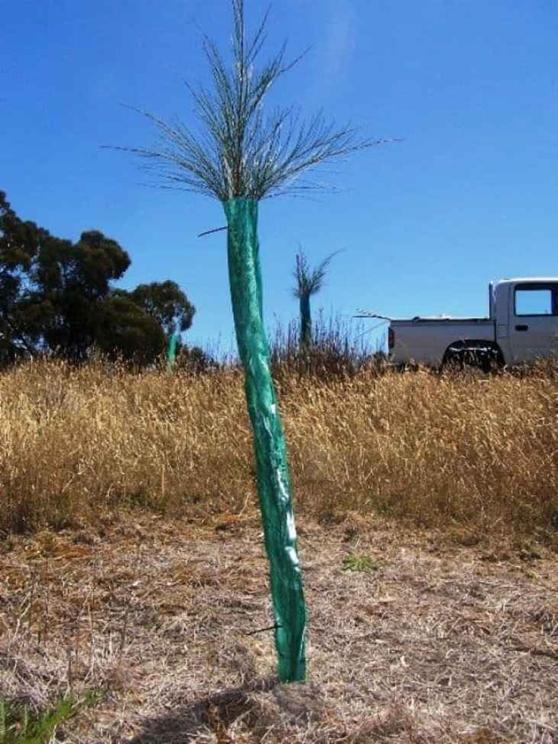
The
idea is simply a plastic tube (which comes in a roll) supported by a length of
¾” PVC electrical conduit and a couple of cable ties. Apparently stapling the
guard to a short stake on the opposite side (bottom) to the conduit will
improve air flow and prevent fungal damage from high humidity.
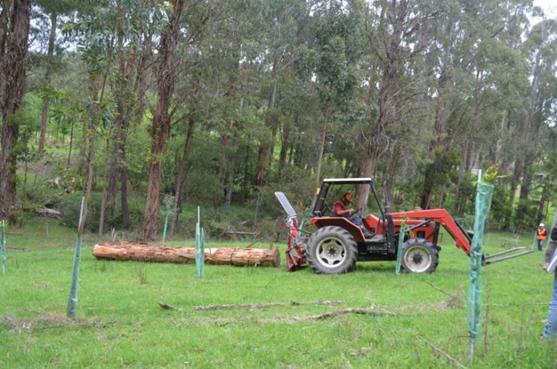
Because
the guard is flexible sheep will not rub on it or stand on their hind legs to
eat the tree which quickly grows out the top. Per tree this method initially
costs only a couple of dollars – but the conduit can be used numerous times. I
am off tomorrow to get some evergreen willow cuttings to plant my first 100
trees with using this method. This time next year I will show you how well they
went.
See
Also:
http://www.agroforestry.net.au/main.asp?_=Tree%20Guards
http://www.nufg.org.au/nufg_visits_the_otway_ranges.htm
20/04/2018: More Bird Brained Things: I have been
making Della a non-fouling pigeon waterer. Given the huge number of people who
are pigeon fanciers you would think such a thing would be widely available from
pigeon suppliers but we have never been able to find one. I have made up two
here out of some PVC guttering, a float valve and some hinges. I have used the
metal gutter supports to sit them on. The bottoms are easy enough (just glue
and drill) , but the lid needs you to cut down the guttering slip the cut off
piece inside and rejoin it with pop rivets. You also have to cut down the end
caps. An angle grinder makes this easy. You can just lift it out for cleaning
every now and then I have spaced the drinking holes 3" apart which seems
to work well..
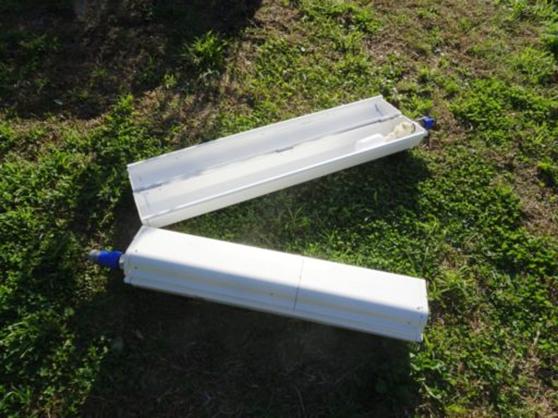
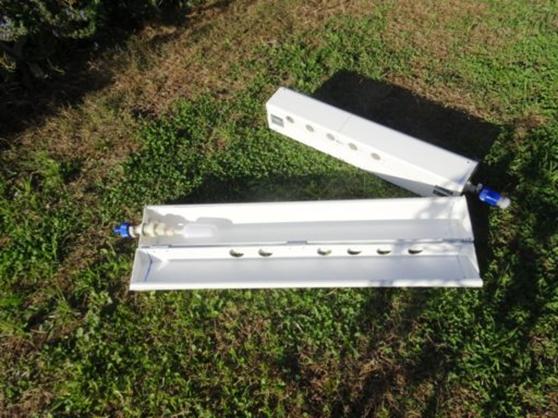
I
made the perch up from a piece of 3" x 1" treated pine and a length
of 1/2" dowel. Invisible here are the 2" strip of aluminium flat bar
(Bunnings) and galvanised gutter hanger it is sitting on. The hangers are screwed
through the aluminium flat bar to the perch so that they fit tightly against
the wire. Then you go inside and snip out the wire where the drinking holes are
with a pair of side cutters. The perch is sitting out 3" in the centre of
the piece of wood. Next one I will place the perch nearer the bottom of the
wood for greater comfort. The birds took to it right away - which is unusual
for pigeons who are usually desperately wary of novel things.
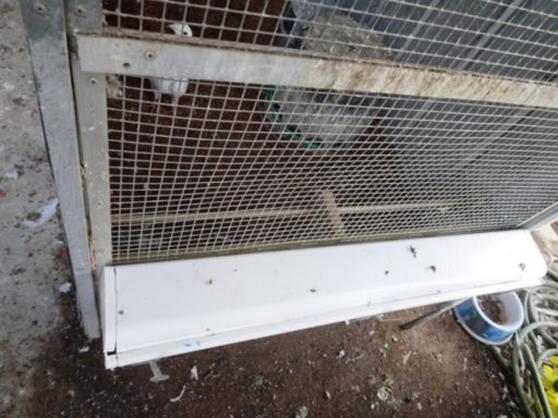
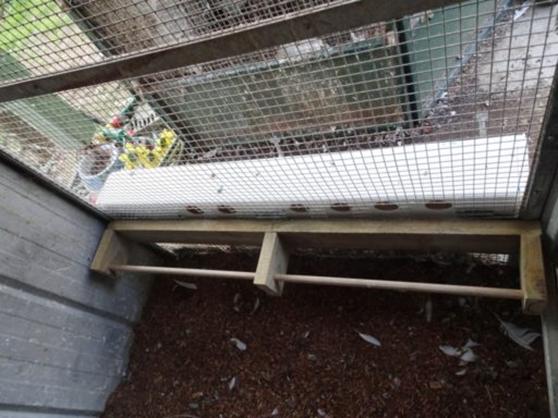
I
have used a Pressure Reducer to decrease the chance that the hose will burst:
Pope
brand Poly Pressure Reducer available Bunnings
A$10.24 (April 2018). They come in 100 and 300 kPa
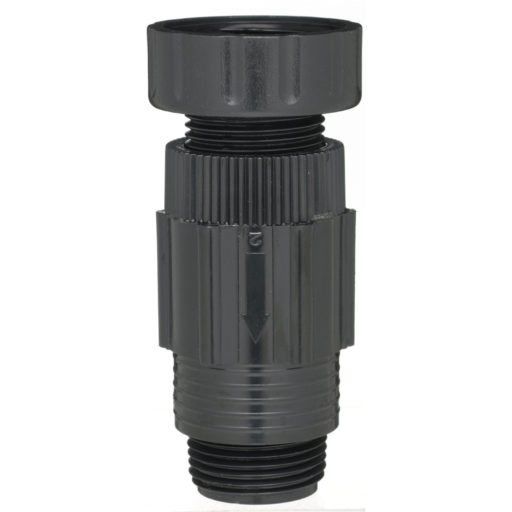
See
Also:
http://www.theultralighthiker.com/self-cleaning-pet-water-bowl/
20/04/2018: Self Cleaning Pet Water Bowl: I posted
this back in 2013 but somehow it did not make it to theultralighthiker It is a
self-cleaning pet water bowl. It is a modification of a small animal watering
'trough' which you can buy at many rural supplies stores in Australia. As you
can see a timer empties the bowl (as often as desired) and it refills with a
float valve (you could add a tap or another timer here to better regulate it).
I
have used a ¾” ‘Yorkshire’ copper elbow, some ¾” rubber hose and some ¼” micro
irrigation outlets to help ‘flush’ the bowl. You could make the anti-drowning
feature out of stainless mesh - standard galvanised 1 cm bird mesh shown. It
turned out not to be needed by lorikeets who enjoy a swim without it and have
no problem getting in and out when wet.
This
has worked well for messy birds (such as Della’s Dusky Lorikeets) and would
also be good as a dog waterer on the verandah. We have had it installed in
Della's lorikeet cage for five years now. Obviously the timer is on the outside
of the cage so the birds don't interfere with it, so there is a bit of pipework
(both in and out) not shown in the photo.
It
has worked flawlessly to keep these exceedingly messy birds' water pristine. I
set it to flush 4-6 times a day for a couple of minutes each time. These
'cheap' timers have needed to be replaced a couple of times - mostly because
lorikeets keep tossing all sorts of objects into their water bowls!
Key
features:
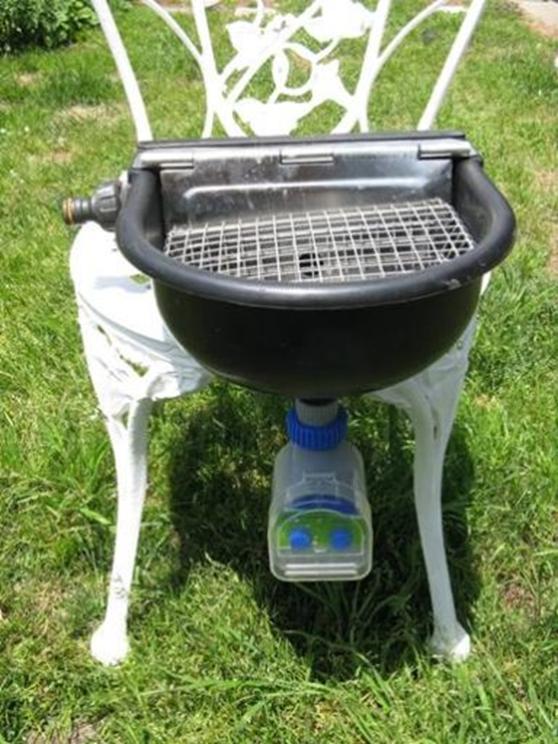
The
microjet outlets (without caps) swirl the rubbish out of the bowl - much like
flushing a toilet.
What
you see here is a short section of rubber tube to join the Yorkshire elbow to
the length of poly pipe, three hose clamps, and six microjets. All this fits neatly
under the metal plate which protects the float valve. This drinker comes with a
3/4" threaded outlet at the bottom.
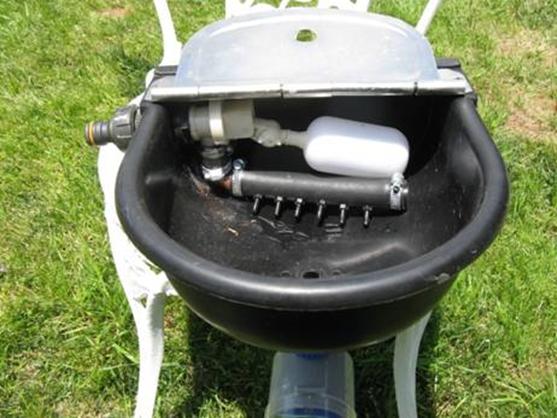
A$20
(2013) timer

A
Pressure Reducer might prevent the hose from ever bursting:
Pope
brand Poly Pressure Reducer available Bunnings
A$10.24 (April 2018). They come in 100 and 300 kPa

See
Also:
http://www.theultralighthiker.com/more-bird-brained-things/
16/04/2018: ‘Hunting Desperadoes’: I have been a
deer hunter for nearly 40 years. Spotlighting deer was outlawed in 1975 yet
there are still drongos endangering the public and breaking the law in this
fashion but these evil scum knocking a man down on a country road and leaving
him to die are too vile to contemplate. There would likely have been at least
two of them in the car. One of these evil cowards should long ago have come
forward to take his punishment. They should lock these guys up and throw away
the keys. Not only do they bring the hunting community into disrepute, they
shame the entire human race: http://www.news.com.au/lifestyle/real-life/news-life/cryptic-last-words-of-man-killed-in-hit-and-run-lead-police-to-illegal-deer-hunters/news-story/1035d4177cf39c15523d33bd39a12ce2
15/04/2018: The Deer Hunter’s Apprentice #1: I’ll
probably never stop taking in stray kittens even though I tell myself I will,
and know that all the love and care you lavish on them is only preparation for
the day they meet their ultimate roadside, still…
Over
the years I have taken dozens and dozens of aspiring youngsters deer-hunting,
and practically every day I receive a message seeking advice, or asking me to
recommend a spot or to take someone somewhere. Mostly I don’t, (‘No company is
better than bad company’ – as I’ve said before) but sometimes I weaken. So, I
have been up the bush for a week with a young fellow keen to learn a thing or
two about hunting deer.
My
thanks to another 'apprentice' who sent me this beautiful photo - just about
the best sambar photo I have ever seen:
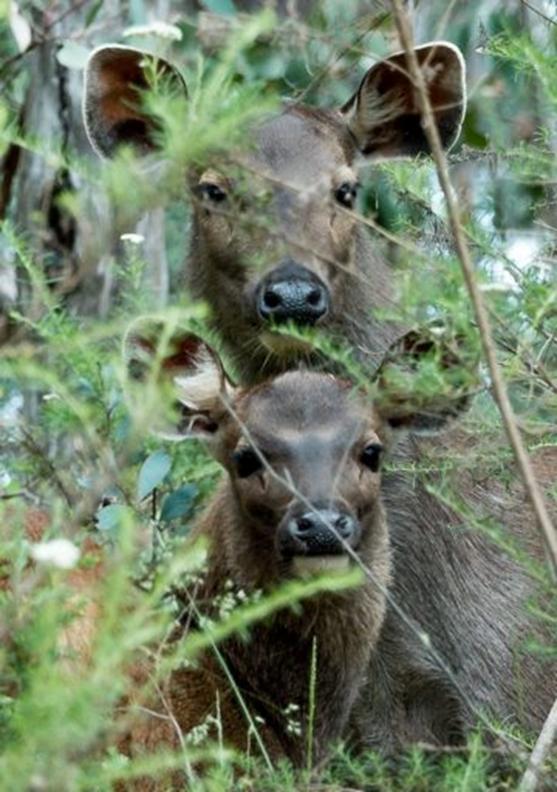
I
frequently get messages like this, for example, ‘I've gotten into going after
sambar. I found tons of fresh deer tracks, droppings and beds. Followed tracks
for hours, searched east facing slopes in mornings and near creeks in the arvo
but couldn't find any deer. I was just wondering if you could give me a tip or
two about what you look for once you know a deer is in the area/you've found
fresh sign? Also what do you think I should look for in terms of environment
deer would be in?’
I
own that I used to be a better teacher (before I gave it up - is it really
nearly thirty years ago?). I no longer have/had so much patience or good humour
I guess - and now I have become over-fond of my own company. Mine and a Jack
Russell or two (or my wife, Della) at most I guess, and maybe one or two of the
truly great story-tellers on the e-reader on my phone: Dickens or Conrad
perhaps?
So,
I let someone tag along with me, then forget to talk. Having been alone most of
the last thirty years it's no surprise My eyes are used to taking in every
clue, my ears every sound (well, nowadays they have to be much louder ones),
and my nose drinks in every odour of the bush. Decades ago I developed the
ability to track and locate a deer (stags particularly) just by smell, though I
usually only do so out of curiosity. I am in an instant transfixed when I catch
the pungent scent of stag upwind as has happened so many, many times. I cannot
resist the urge to drift up that scent to where he lurks. You should always follow your nose.
So
many tips I could have been passing on, but I found myself just silently
sliding along through the bush with the young fellow tagging, failing to point
out a thousand things he should know. Oh well, I hope he enjoyed the week
anyway.
At
the outset I just forgot to point out all the browse for example, something
that I have long since just taken in ‘on automatic’ so to speak. You know the
sort of ‘invisible’ things perhaps. No, not the blackberry browse. Sambar
really only browse that when they are relatively short of feed. They have many
more favourite things. They suck the fruit from coprosma for example, so it is
their absence which stands out. You can see all the fruit missing from just
their height.
They
love fruit just like most of us, and they adore lush pasture plants such as
clover as much as any jumbuk ever birthed. Coprosma branches they run through
their mouths, rolling the ruby pea-sized fruits to the back of their tongue as
they go. If you are following closely you will sometimes see how the foliage
and the prickles even are still damp with their saliva, and how they have
dribbled a trail of spilled berries out - like Hansel and Gretel. If you
collect a small handful yourself sometime you will soon appreciate why they do
so. There are not so many delicious treats in the Victorian bush! 'Prickly' are
good. 'Sweet' even better. Coprosma I mean.
But,
first things first. I honestly don’t know how to re-train someone to walk
quietly. So many folks have spent good money at their local shyster outfitter
and have a tonne of expensive gear and a huge hole in their bank balance. (Why
I wrote this post recently: http://www.theultralighthiker.com/ultralight-hiking-on-a-budget/).
The trouble with that tonne of gear is it makes you a clod-hopper even if you
had learned to walk quietly.
You
know, starting with those $500 ‘must-have’ ‘bulletproof’ 1 kg ea waterproof
(unbelievably - how does anyone come to believe they are going to maintain dry feet deer hunting?) hunting
boots for example - which almost certainly will not grip on wet rock, twigs or
bark. It’s probably just about impossible to walk quietly in such boots.
Please, try not to buy them. If you have a light pair of (non-waterproof)
sneakers already, try them out first.
There are almost certainly better ones for the purpose than the ones
you already own – but maybe not. At least you are used to them, and know they
will not rub! Or fall apart or perhaps tip you on the back of your neck in a
twinkling. Probably you also know that they will not weigh like lead when they
are a bit wet. I know they will not protect your feet as well, but you should
not be hurrying anyway, and you should be paying attention to where you put
your feet in the first place.
I
suppose you have all seen John Clease’s ‘Silly Walks’ skit from the
Monty Python show. Nothing will prepare you better for the knowledge that there
really are lots of ways to walk. I am an elderly man now, but unlike other old
men I do not totter, shuffle or walk on my heels. You have to some significant
spend time at squats, lunges, balancing etc if you are to preserve the strength
and flexibility of your legs. Most do not, and it is incredibly apparent.
Do,
before it is too late! A couple of hours at day at very least. The saying 'bend
your knee to no man' is a falsehood. You should keep your knees bent. indeed
never straighten your legs at all. That is what leads to all the problems with
knees, hips, back. The infernal jarring of bone on bone because of such a silly
habit. Maintain the spring in your step with a knee like a bow!
You
should resist the temptation to ‘kick back’ and ‘take things easy’. Whether
that leads to an earlier grave is moot, but it will certainly soon limit how
interesting and varied your life is. If you want to stay home and bore yourself
silly watching TV, go for it! I forsook asking my contemporaries to come
hunting or go for long walks, canoe trips etc with me twenty years ago, when
they could no longer do so anyway.
(I
have to apologise to him for leading this young fellow on several days' walk of
25 km or more each with loaded packs through the trackless bush. I was just not
thinking it would tire anyone!) Myself, I would rather my ancient bones glinted
in the dappled sunlight under some tree fern in a distant gully than that I
died blubbering and drooling back home in bed.
If
you have soft light shoes and not too much weight on your back you
really should not find it too hard to learn to walk quietly. Well, silently.
The main two secrets are: eschew those macho giant strides. Mince. I know short
steps might make you feel effeminate. Get over it. Surely you know already what
your gender choice is, and do not care a hoot what others might think.
You
could also (if you choose) let go that affected baritone voice that has given
you a hoarse throat the last thirty years. If anyone thinks you are not ‘manly’
because you are a natural tenor (or higher), that is their problem. Your voice
might even become less a monotone if you follow this advice.And you might sing
somewhat prettily around the campfire at day's end - if that is your wont!
So,
shorter steps lads. Second, and give up that stiff-legged ‘habit’ of walking on
your heels. It is why you have sore knees, hips and back anyway – if you are
old enough to have ruined them. You have been wearing out your joints by
standing on your bones rather than on your muscles. You must learn to creep
along on the balls of your feet. 'Dig' your toes in. After a time it will
become ‘second nature’.
Spend
a little more time paying attention to where you are placing your feet. So much
easier if you lead with your toes. You really don’t want to be letting off
rifle-shot sounds every other stride by breaking every single branch which lies
on your route. If possible, break none! Thinner shoes will help with this. The
Topos for example. If you do loudly snap a twig. Stop. Stand totally still for
two minutes. Every eye (and ear) is turned in your direction.
Vary
your pace. Pause a lot. There is nothing attracts attention to a sound (save
its loudness or its juxtaposition, ie its ‘out-of-place-ness’) than its
regularity. You must all have heard something crash off in the shrubbery.
Didn’t you pay careful attention to that ‘Thump…thump…thump’ to ascertain
whether that invisible fleeing creature was a macropod – ie a wallaby or a roo?
And
make use of cover. If you haven't noticed the deer doing it yet, you haven't
observed many - you know how hard it is to see the deer which just honked at
you. Almost to the last whisker s/he is standing stock still behind a tree or
bush. So, as you 'scan' a new field of view (emerge from a thicket, come around
a corner or over a rise for example) do so slowly so that your
eye can take it all in - which takes longer than you think, rather like the
'Where's Wally' children's books!
President
Teddy Roosevelt (a truly great hunter – read some of his books) once said
‘speak softly, and carry a big stick.’ If he had been giving advice about
hunting rather than foreign policy, he would have said ‘walk softly and carry a
big gun’. He gave a speech for over an hour by the way after he was shot once
in the chest himself - and survived. Quite a guy. I love the film 'about' him
(amongst other things eg Barbary Pirates), 'The Wind and the Lion'. You will too.
Watch it. Candice Bergman was delicious! Or Sean Connery too!
BTW:
About that gun: It only really needs to be a single shot. One well-placed shot
is enough. A single shot rifle will teach you care and patience. Certainly
though, you should ‘walk softly’. I use a lever action so that my gun is never
loaded, but I can get a shot off very quickly, albeit noisily at need. It will
take practice.
Incidentally,
the less weight you put on your feet as you set them down, (ie the more you
'glide') the less effort walking is. You will find that you can effortlessly walk
twice as far! Emulate that cat. It is a matter of balance which so many folk
ignore. The better your balance the fewer falls you will have too.
Hiking
poles play merry hell with one's balance. Walking sticks are a geriatric's tool
really though they certainly make walking easier and prevent falls. Give a pair
to your Nan! Or better still ballet of karate lessons. I carry a shortened pair
(which fit in my pack) for walk-outs. If you are carrying a very heavy load
they are a blessing.
Next,
just as there are lots of ‘Silly Walks’, there are lots of ways of seeing. Most
are just one kind of blindness or another. Some ways of seeing become
semi-automatic after a time, so it is hard to explain. For example, in the
beginning you will no doubt be paying lots of attention to deer tracks – and other
tracks.
An
aside: You know how lots of creatures love the same water-hole. It has ever
been a predator’s strategy to lie in wait by the waterhole (by ‘the great, grey
green greasy Limpopo’ - Kipling, ‘The Jungle Book’, or elsewhere) and wait for
dinner to perambulate towards him. Personally I haven’t the patience for that.
I love to be about seeing and doing, and have long since shot more creatures
than I want to anyway.
You
must have sometime followed a game trail to a watering spot by a lake, creek or
river. There you will have found many different sorts of tracks: deer, roos,
wombat, birds, goannas, wild dogs etc. I’m sure you have looked carefully at
all those wild dog tracks and ascertained that they all have claws. Not one
large pad was ever made by a large ‘dog’ with retractable claws – yet folks who
rarely venture into the bush are forever seeing ‘black panthers’ – and Yowies!
Astonishing!
To
continue: An almost irresistible early ‘habit’ is to pay attention to deer
tracks, which is natural. Mind you, no-one ever saw a deer by following its
tracks. It is just too hard to look in two places at once. It will not be
standing in the tracks you are looking at. To see the deer you need to look up!
However, you also need to pay attention to which way it went in order to be
looking in the right direction. It is a bit of a conundrum!
You
will develop the habit of seeing ‘the line’ the deer has taken. It too has its
own ‘silly walk. Its stride has a metronomic regularity. You can better tell
just how big it is by the length of its stride than the size of its feet. Just
like people, the same sized deer have different sized feet, but a deer with a
longer stride is obviously a bigger deer. I have followed a deer for several
kilometers (because I could not believe it!) whose stride was longer than I
could pace – so close to a metre! What a monster!
So,
you don’t need to ‘see’ every footprint to perceive the line the deer has
taken, and be able to ‘project it forward…so that it either angled this way or
that. Oh, up ahead there is a scuff just in the right place there, so look out
that way. After a time you will be able to follow the line of tracks without
looking down. You have to train your eyes (and yourself) to do this.
A
similar sight-training exercise: It should be no surprise that deer (usually)
see you first. That’s why the first thing you often ‘notice’ is the deer
honking at you (happily) or simply crashing off in the distance (alas). Of
course they live in the bush (which you don’t) and have (lots of) predators
which you also don’t – else you would have better manners! Deer have the
ability to look right through the bush which is largely invisible to them.
You
can develop this ability. For example, if you live in a town (poor thing) and
have acquired the habit (you should) of every day taking an evening walk, then
you are probably walking past a lot of picket fences. Discretely develop the
habit of becoming a ‘Peeping Tom’. Yes, seriously. When you are standing still,
focus through the cracks or gaps in the fence between the pickets into the
people’s yards. Keep looking into the yard and slowly begin walking. You will
notice that you can still see into the yard and that the fence has effectively
disappeared.
You
can do the same thing when you are driving (certainly when you are a passenger)
by focusing through the fringe of trees and vegetation which makes up the
roadside verge into the paddocks beyond (or through a hedge if you are in the
city). After a while you will be able to see the entire contents of the paddock
without paying any attention at all to the intervening vegetation. That is what
a deer is doing all the time. It is ever looking through the
bush.
Once
you have quite mastered this knack. It takes some conscious effort. And will
confound your friends who will think you have developed X-ray vision like Clark
Kent’s alter ego. You will begin to see lots of deer (and other creatures)
which were invisible before. It has the added advantage that you will also be
able to much more clearly see the ‘lie’ (or ‘fall’) of the land so that
you can plan your route more intelligently to consume
less effort and encounter fewer obstacles. Finding your way, and your way back will
also be enhanced. (These links are just some of the woodlore you should try to
master).
So,
two main skills for the deer hunter’s apprentice to practice: walking and
seeing. There are many more, but they will have to wait another day…
Oh,
and this particular 'deer hunter's apprentice' should understand that the
remarks herein were not addressed to him. He is instead the origin of the idea for
the article. And, he was good company, and will get to come again!
I
will find photos to illustrate this later. So far as I have noticed none of
Dickens' or Conrad's book have single pic, but millions have managed to read
them. Not that I am comparing myself to them
-
Written on a wet afternoon when I had a sore ankle - else I would be out doing.
Still, it is clearly now the autumn break, so time to clean up that rifle,
break out the kit and plan the next hunting expedition!
Some
recent hunting related posts:
http://www.theultralighthiker.com/the-lure-of-the-moose/
http://www.theultralighthiker.com/best-hunting-daypack/
http://www.theultralighthiker.com/ultralight-cookpot/
http://www.theultralighthiker.com/ultimate-blades-for-the-ultralight-hunter/
http://www.theultralighthiker.com/crkt-pdk-replacement-blades/
http://www.theultralighthiker.com/fire-umbrella/
http://www.theultralighthiker.com/are-you-beautiful-in-the-buff/
http://www.theultralighthiker.com/a-spot-of-solitude/
http://www.theultralighthiker.com/nz-moose/
http://www.theultralighthiker.com/follow-your-nose/
http://www.theultralighthiker.com/hunting-thumbtack-reflectors/
14/04/2018: A Blast of a Pack:

I
borrowed my son-in-law Matts’s Zpacks Arc Zip just so I could try it out.
I loaded it up with about 10kg of stuff I would usually carry for a trip of
about a week I guess and went for a five mile (8 km) walk in a local pine
forest. Just the other day on our walk there was a beautiful sambar deer and
her youngster just standing at the other end of the dam behind me – and do you
think I had a camera? Sure. They really are water deer. They love water plants,
cumbungi and such. On this occasion I did have my camera.

I
guess this is about the lightest frame pack you can get. 595 grams (and 55
litres) in this hybrid cuben fabric which seems plenty tough enough to me, and
is a good colour for deer hunting as that orange really stands out to other
hunters, but you might chose their larger (62 litre) model one in Dyneems which
would weigh 680 grams if you were going on a very long trip or had a lot of
meat to carry out for instance.
The
50 litre (539 gram) Arc Scout model would suit Della as it is especially
designed for smaller folk. She is just on 5 foot, but their Nero pack at 38
litres and 309 grams might actually suit her better for most trips where she
does not need to carry much gear. It would also suit me as an overnight or a day pack.
Have
a look here: http://www.zpacks.com/backpacks.shtml
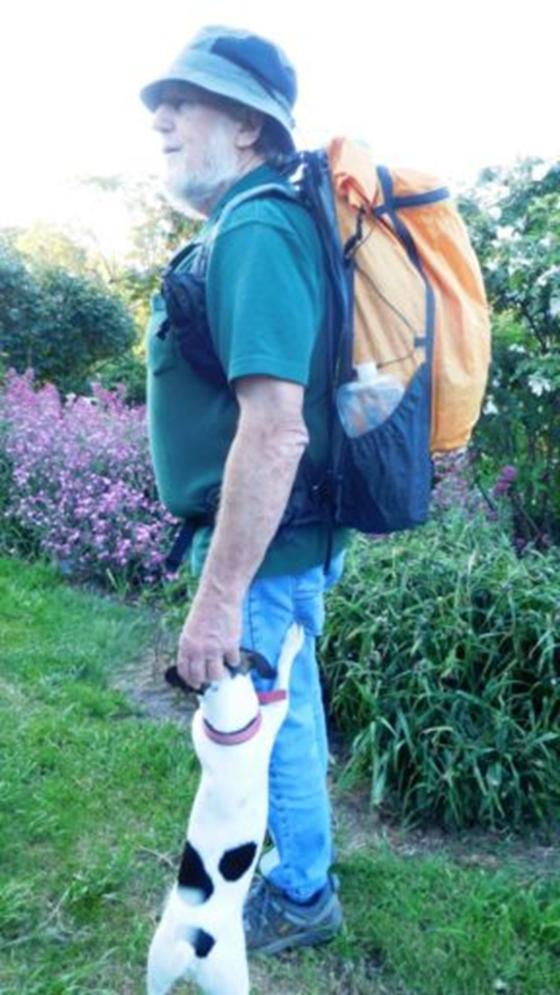
I’m
not sure you can see how the mesh panel holds the pack away from your back, so
there is some ventilation and you don’t get that dreadful wet hiker’s back.
This suspension system also makes the pack very comfortable too. I found the
pack tucked right into the small of my back perfectly. I really didn’t need to
cinch the waist belt up at all (or the chest strap) to get that weight transfer
downwards, which is a truly remarkable piece of design. Congratulations Joe!
I
guess you have figured that this is the ‘Zip’ model. I’m sure Joe has chosen
nothing but the very best zips, but I am terribly hard on equipment, and chary
of zips. I have managed to destroy a number of packs over the years, so I don’t
think I would go for a Zip model myself even though no doubt it would be more
convenient to load/unload perhaps, especially if you were using it mostly for
travel. I am pretty organized with where everything goes in my pack, so that I
never need something from the bottom anytime during the day.
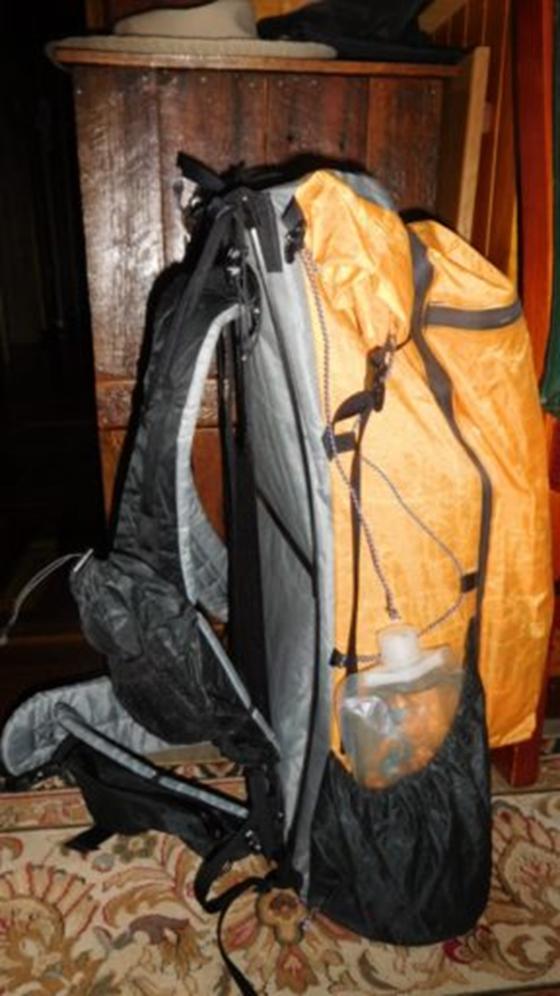
This
particular version would be extremely waterproof (from rain) though, so that you
might not need a pack liner bag – though I always use one anyway against those
occasions when you have to swim. Such things happen to me anyway. There is a
point of ingress for water where the hydration tube is meant to exit the body
of the pack. I never use one, so I might order mine to not have this feature,
if possible – or I would tape it over.
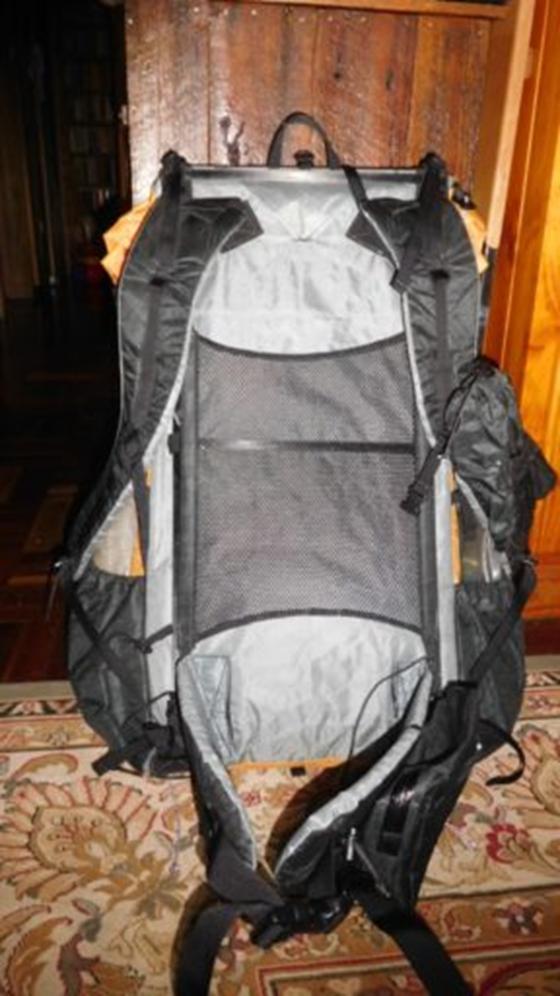
You
can certainly see the mesh panel here. The panel can be tensioned more or less
giving you just the ‘Arc’ your back needs (probably more than I have here). The
length can also be adjusted up or down somewhat. Still, your lower back is
pressing up against the waterproof back of the pack so that you are going to
get damp just there. To prevent this if I was making the pack I would have
included a pad pocket such as Gossamer Gear packs have so that I could
use their new airflow sit pad to help with the dry back
problem.
I
think this Zpacks Arc Blast pack design would be just excellent for a deer
hunting pack particularly the Dyneema model if you plan to carry a lot of gear
– or deer! You can order the ‘Haul’ in orange or green for example – either one
would be suitable.
I
am personally sorry he has stopped making the original ‘Blast’ pack (which I
still have in grey dyneema. With all the ‘bells and whistles’ on it weighs just
under 400 grams and totes 54 litres. I have used it on 10 day+ trips where I
carried all my own food and gear, finding it more than ample.
Imitation
is the sincerest form of flattery. Zpacks could have done something like what you
see on the pack below (which is a Montane UltraTour 55) – just to ‘dehydrate’
the bits which touch your back.
 Here
it is a little closer up.
Here
it is a little closer up.
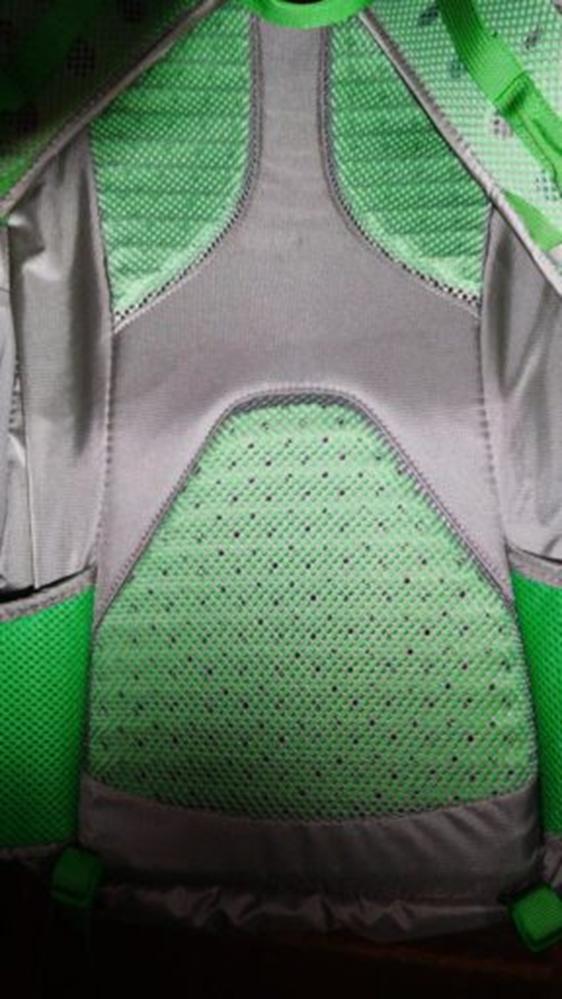
As
you can see the triangle of mesh is enclosed by some kind of super-wicking mesh
and is both ridged and impregnated with holes so that the sweat has somewhere
else to go. I don’t actually know how well it works. Della has ordered a
Montane pack in her size from Backpacking Light which is taking a long
time to come from England, so when it does, we shall see.
Nonetheless,
I think my son-in-law Matt’s Arc Zip will give him many years of faithful
service in the sambar deer forests of Gippsland – and elsewhere. It is
certainly very difficult, if not impossible, to find such a well-designed and
solidly made pack which weighs in at under 600 grams, will last for years
putting up with substantial abuse, is comfortable to carry and capacious.
Highly recommended. For myself, well, I don’t need a new pack. Joe’s old
‘Blast’ pack is still going strong after tens of thousands of trail miles. I
do, however ‘need’ a new hunting day pack. My old one is looking pretty
trashed. This Della, is a hint!
14/04/2018: Wow! Hubble Finds An ‘Einstein Ring’: https://wattsupwiththat.com/2018/04/13/the-hubble-space-telescope-finds-an-einstein-ring/ How long before they find a Dyson
Sphere: https://en.wikipedia.org/wiki/Dyson_sphere
14/04/2018: Della: 'A lovely welcome at our front
gate tonight after a counter meal at the local. Poor photo quality due to only
having my phone to hand. Tawny Frogmouth?
If so, I have heard it on the edge of my sleep for years too numerous to
mention, but have never suffered from insomnia, so wandering abroad for the
purpose of identification/location never seemed relevant. I love these brief
insights into the lives of the creatures who also call our valley home!'
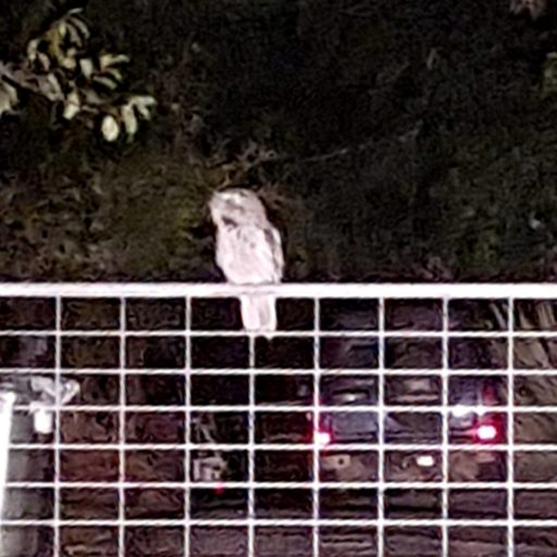
Another
snap sent (by phone) from friends Ian & Debbie Holmes who just dropped in
for a wonderful visit (from North East Vic). Taken on their way home on the
Jamieson-Licola Rd. You have to love Victoria. is there any other place in the
world like it?

11/04/2018: Urban evolution: ‘Two Czech scientists
counted the species of plants in the city of Plzen compared with a similar area
of surrounding countryside. In the city the number of species had risen from
478 in the late 19th century to 773 today. In the countryside it had fallen
from 1,112 to 745.’ Always fascinating: http://www.rationaloptimist.com/blog/the-wealth-of-urban-biodiversity/
10/04/2018: The South Coast Track, Fiordland NZ: Posted
this day in 2014. Oh, I wish I were there again this year. I am going to miss
Fiordland this year. Hopefully I enjoy Scotland as much! ‘The Fiordland South
Coast Track is so much better than the similarly named South Coast Track in
Tasmania. You can have a number of different trips there.
What
will best suit most is a jet boat ride down the Wairaurahiri River staying
either at the Wairaurahiri Hut or at the Waitutu Lodge ($30/night + hot
showers). From the Lodge you can spend a few days exploring the bush and the
sea, perhaps venturing on to the Waitutu or Big Rivers. Then you can walk back
staying perhaps at the Percy Burn Hut (where there is an enormous timber
viaduct built from Australian hardwood c1920!) or at the Port Craig Hut, or the
(new) Port Craig Village - where you can enjoy hot showers and BOOZE for twin
share $100/night.
It
is 6 ½ hours walk back to the Rarakau carpark just out of Tuatapere (you can
arrange with the jet boat people to be picked up from the car park). It is 5 ½
hours walk along the beach only if the tide is low with some scrambling over
rocks. You can break your walk with a camp on the grassy edge of Blowholes
Beach (approximately half way).
You
can (if you are very intrepid) push on along the beach or through the bush
after Westies Hut (in a sea cave after Big River) all the way to Puysegur Point
lighthouse on Preservation inlet. There is a hut there at Te Oneroa from which
you can explore the C19th ruins of the gold mining town of Cromarty. You can
fly out by float plane from here (or stay at a luxury resort there – if you are
exceptionally well-heeled!)
After
the Waitutu River you can push on up the Waitutu River to the hut on the
Slaughter Burn and onwards to Lake Poteriteri, thence to Teal Bay on Lake
Hauroko and on to the lake Hauroko car park where again you can be picked up by
the jet boat operators.
Port
Craig Schoolhouse.
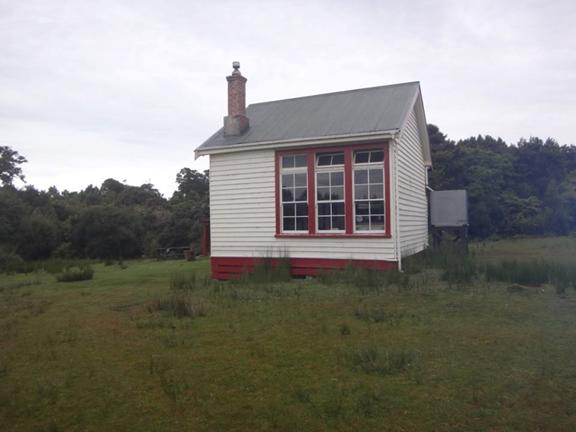
Blowholes
Beach.

See
also:
http://www.theultralighthiker.com/dusky-south-coast-tracks/
http://www.theultralighthiker.com/fiordland-2014-2/
http://www.theultralighthiker.com/a-walk-in-fiordland/
http://www.theultralighthiker.com/bucket-list-westies-hut/
http://www.theultralighthiker.com/fiordland-wairaurahiri-to-rarakau/
http://www.theultralighthiker.com/fiordland-wairaurahiri-to-waitutu-part-4/
http://www.theultralighthiker.com/westies-hut-topo-map-errors/
http://www.theultralighthiker.com/waitutu-forest-fiordland-warm-air-pockets/
http://www.theultralighthiker.com/westies-hut/
Other
Fiordland Posts
http://www.theultralighthiker.com/insects-can-ruin-a-camping-trip/
http://www.theultralighthiker.com/dusky-track-canoeing-the-seaforth/
http://www.theultralighthiker.com/dusky-track-adventures-1/
http://www.theultralighthiker.com/eddie-herrick-moose-hunting-at-dusky-sound/
http://www.theultralighthiker.com/eddie-herrick-moose-hunting-at-dusky-sound/
http://www.theultralighthiker.com/a-friend-i-met-on-the-dusky-track-fiordland-nz/
http://www.theultralighthiker.com/dusky-south-coast-tracks/
http://www.theultralighthiker.com/dreaming-of-the-dusky-track/
http://www.theultralighthiker.com/the-dusky/
http://www.theultralighthiker.com/moose-hunting/
http://www.theultralighthiker.com/fiordland-moose/
http://www.theultralighthiker.com/fiordland-moose-2/
http://www.theultralighthiker.com/hunting-in-fiordland/
http://www.theultralighthiker.com/off-to-fiordland/
http://www.theultralighthiker.com/shadowland-fiordland-video/
http://www.theultralighthiker.com/the-best-toilet-view-in-the-world/
http://www.theultralighthiker.com/10-days-in-fiordland/
http://www.theultralighthiker.com/fiordland-2009/
http://www.theultralighthiker.com/fiordland-nz-with-bryn/
http://www.theultralighthiker.com/fiordland-april-2007/
http://www.theultralighthiker.com/weather-for-fiordland/
10/04/2018: Somewear a 3 Ounce Satellite Messenger:
These clever folk have rethought the Epirb and Sat communicator with this
lightweight device. It functions as a PLB with the touch of an SOS button but
it can also send and receive SMS/email messages (up to 160 characters each).
Each message also sends your precise geolocation.
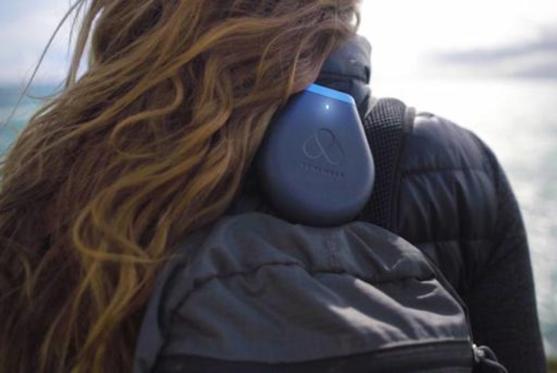
It
is available on Kickstarter for US299 so it is about $100 dearer say than the
Spot PLB (and lighter) and at that price cheaper by about $100 than a Satellite
Messenger (and about 100 grams lighter).
You
can just wear it attached to your pack (as shown) because it is waterproof
(IP7) and shockproof. It has a rechargeable battery which can handle up to
1,000 messages. How long that will last in practice I don't know. I do know
that when my Inreach is searching for a signal (in the thick vegetation and
mountains I usually inhabit), it really chews through the battery - so that I
turn it off and on again when I stop for a spell if I want the battery to last
for days. By the same token you can recharge in various ways. I do not know what the capacity of
the battery si. For some details we may have to wait for the product release.
The
cheapest plan is $12 per month for 10 messages, so cheaper than Inreach but I
have my Iridium sat phone on a $10 per month plan, believe it or not! I pay
more only when I use it - seldom. You pair Somewear to your phone with an App.
There are a number of other interesting features including mapping and
emergency information.
I
already have the Inreach Messenger which I bought as a backup to my sat phone
when I had it fail once – the Service provider had phased out the Sim card
without telling me! On that occasion I had to ring the police to assure Della I
was OK. Because this device is 100 grams lighter than the Inreach I would
probably have chosen it as my fail-safe, if it had existed then. Other gram
conscious folk will probably do the same.
One
thing I like about the Inreach (in comparison) is that it is a stand alone
communicator if you drop and break your phone, whereas this one has no keyboard
– but then there is also less to learn! If you broke your phone you would just
have the SOS button. Mind you, as it is called a 'Hotspot' I would assume that
you could pair it with another phone, so if you were traveling in company you
might even share one between two of you (at half the cost!) I think this would
be fine if you are hiking popular trails, not so much if you are completely in
the wilderness as i usually am.
Naturally
you would not press that button if you weren’t in any danger but whoever you
normally communicate with wouldn’t know that, so they would worry. That’s why I
carry both a sat phone and a communicator, or when Della and I are traveling
together each of us carries one of them so we both have a way of communicating
with the outside world – or with each other if we become separated, which we do
not, but anything can happen. I always venture where there are no trails, or at
very least where there are no people so it pays to have secure communication.
I
would like to trial this gadget, and would even consider the saving of the 100
grams weight, but as we are retirees and already have the Inreach, I think this
is unlikely. As you can see from some of my recent posts, I am always working
on cheap ways to save a few grams.
People
on a strict budget might consider an emergency CB radio for less than $50. Of
course there is no certainty you will get a message out, but some of these
devices are multi-band, and there are in many countries repeaters and emergency
channels people are listening on. Check before you go.
I
definitely think there is a place in the market for this product (particularly
for safety conscious couples and gram counters) at the Kickstarter price and
that it should do well, but if it should be offered at the suggested price of
$450 I am not so sure that folks would not prefer either the Spot or the
Inreach. Of course its ruggedness will count.
https://gearjunkie.com/somewear-smallest-two-way-satellite-communications-device-global-hotpsot
& https://www.kickstarter.com/projects/124657937/somewear-limitless-communication-built-for-adventu/description
See
Also:
http://www.theultralighthiker.com/personal-locator-beacon/
http://www.theultralighthiker.com/get-lost-get-found-plbepirb/
http://www.theultralighthiker.com/the-poor-mans-satellite-phone/
http://www.theultralighthiker.com/the-not-so-poor-mans-sat-phone/
http://www.theultralighthiker.com/gotenna/
http://www.theultralighthiker.com/emergency-cb-radios/
http://www.theultralighthiker.com/backcountry-radio/
http://www.theultralighthiker.com/emergency-dial-112/
http://www.theultralighthiker.com/epirbs-are-not-taxi-hailers/
09/04/2018: Waratah Bay: You can walk practically
the entire Gippsland Coast from Phillip Island to
NSW. After you have walked along Venus Bay Beach, (there is a path inland)
past the Arch Rocks and rounded Cape Liptrap, if you have managed to make your
way down to Maitland Beach, you will soon come to Bear Gully (or you might have
walked along the very pleasant quiet road from the lighthouse to Bear Gully)
where you will have seen numerous wallabies and kangaroos and perhaps some
koalas in the roadside trees - keep an eye out.
Obviously
there is water at Venus Bay No 1 Beach - the township is less than 1 km inland
from the beach. There are various shops. There are also shops at Tarwin Lower
about 5 km away. A walking track joins the two towns.
There
is usually permanent water at the Ten Mile Creek before you get to the Arch
Rocks. It is often possible to camp amongst the sand dunes inland from the
beach. There is plenty of driftwood for a camp fire - though camping may not be
'permitted' so far from any authority.
As
I mentioned the very small stream at the Five Mile is likely to be dry in the
summer, though you might walk up it and dig for water where there is a patch of
cumbungi (rushes) about 100 meres upstream (if you are desperate). There is
likely to be water at Morgans Creek between the Arch Rocks and Cape Liptrap. If
you are walking along Maitland Beach there might be water in 1-2 very small
streams you cross, but there will be water at Bear Gully, where you have to
book with Parks Vic for (vehicle) camping. After that there is water at
Walkerville, Waratah Bay Sandy Point, in streams near Hourigans camp & etc.
Bear
Gully is a beautiful but popular camping area. If you are walking you will find
somewhere to put up your tent at the west end before you get to the vehicle
camps. You may want to filter your water along the Gippsland
Coast as there are livestock upstream. This is Bear Gully looking back towards
Liptrap the way you will have come.

And
this is the view onwards towards Walkerville South.

Looking
across Waratah Bay to Wilsons Promontory.

I
have walked back to Cape Liptrap in the past. There is some rock scrambling but
quite a lot of easy going on Maitland Beach. You sometimes see tiny
beautiful Hog Deer like this miniature stag in velvet particularly at
dusk and dawn and if you are quiet. Hunting in the Marine Park is not permitted
even in season (April).
By
the same token the Government used to poison thousands of them every year,
probably still does. Astonishing that such can be deemed less cruel and more
socially acceptable than harvesting one occasionally for the family table. They
are delicious, much like lamb.
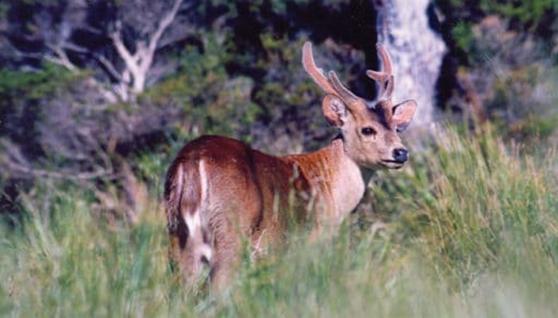
Going
around Cape Liptrap is a low tide only option and mainly for the young.
You
can walk along a quiet path inland at Bear Gully, through the tea trees.

Past
a yellow robin sunning himself.
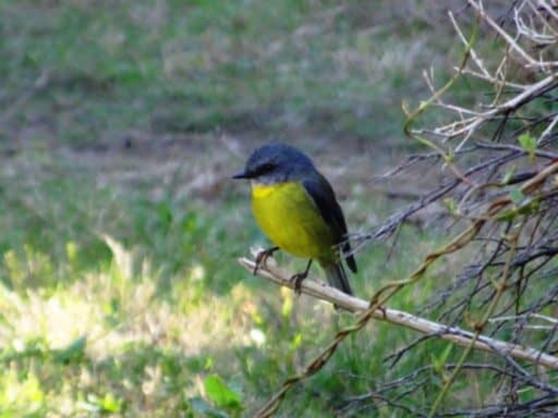
The
Banksias (named after Sir Joseph Banks, Captain Cook's botanist) are just about
always in bloom and alive with a myriad of different honey-eaters. 
Like
this wattle bird.

You
can continue along the coast from Bear Gully to Walkerville South. There are
some pretty little isolated beaches and a little easy rock scrambling - and as
you can see some interesting islands. There are oysters aplenty, rock lobsters
and fish to be caught.
This
is the view looking back towards Bear Gully from Walkerville South.
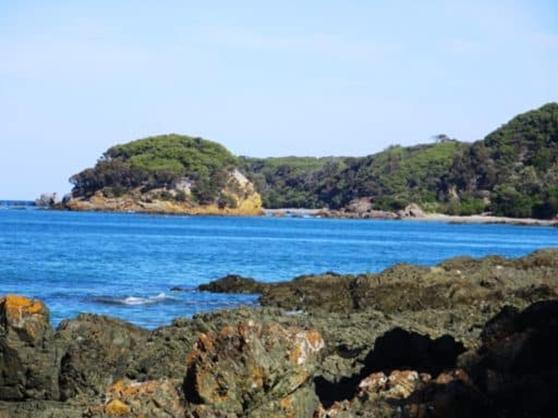
This
is the sort of rock hopping I am talking about. The two dogs, Spot and Honey (if you came in late) are enjoying
it. Tiny would have too, She had many similar
adventures during her eighteen years.
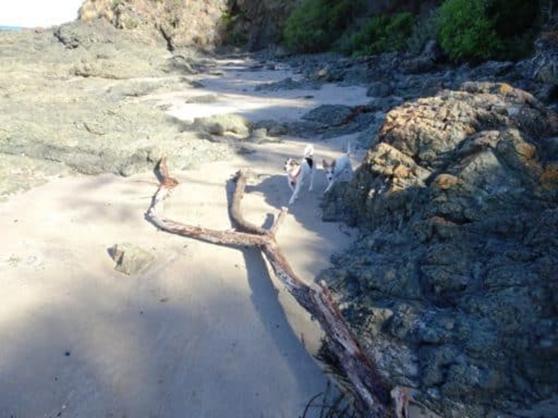
View
of the Bird Rock from the Bear Gully side.
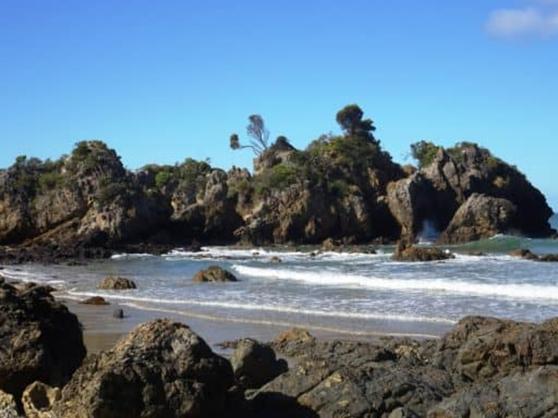
Honey
is taking the lead. Bitches often become better hunters - perhaps because of
the need to feed puppies. We shall see in this case.
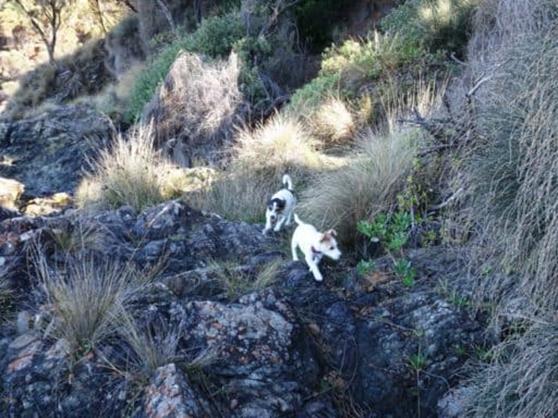
There
is a set of steps and a path which takes you back to Walkerville South.
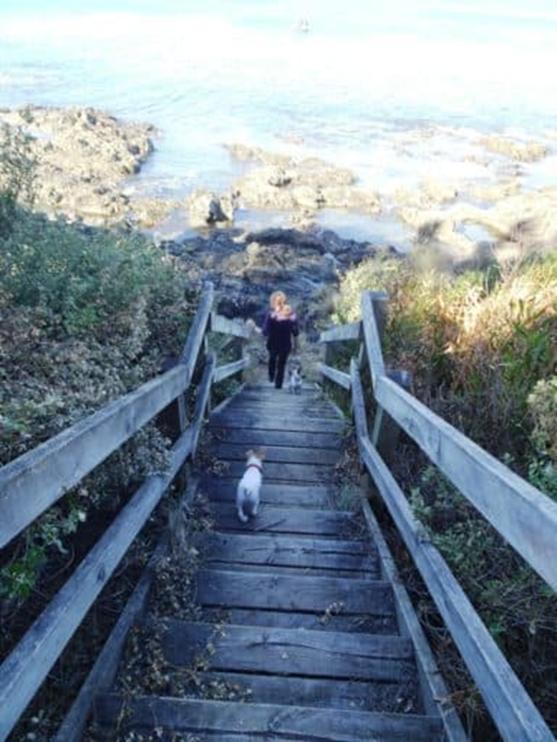

The
Bird Rock from above.

And
with Wilsons Prom in the background.There is a path down to it.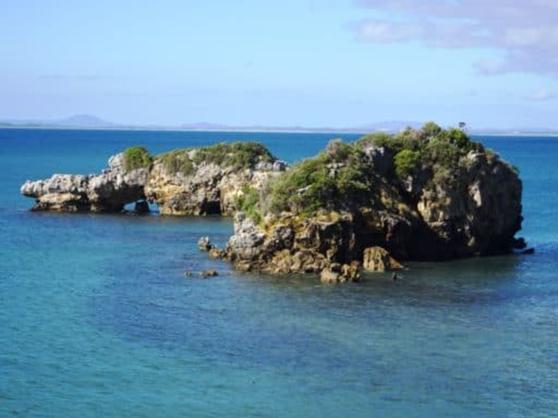
Look
at the colour of that seaweed!
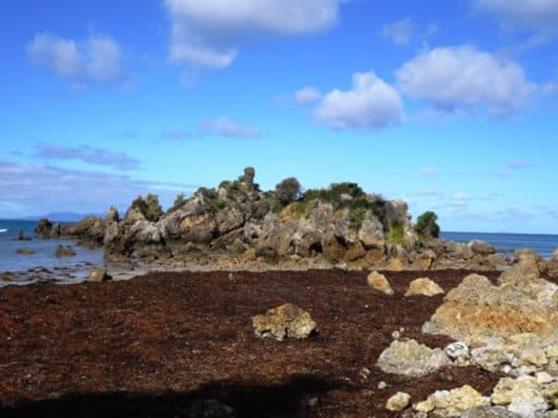
We
saw wrens and swallows as well as seabirds.
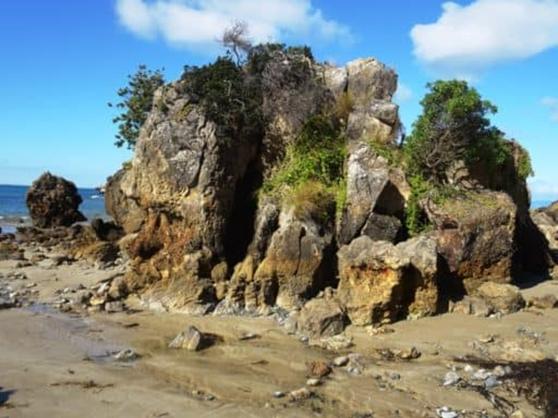
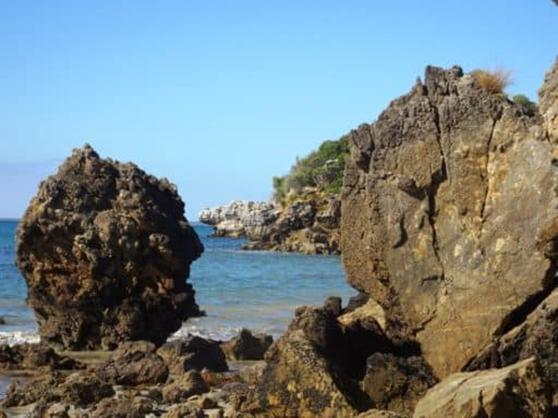
From
the Bird rock looking towards Walkerville.
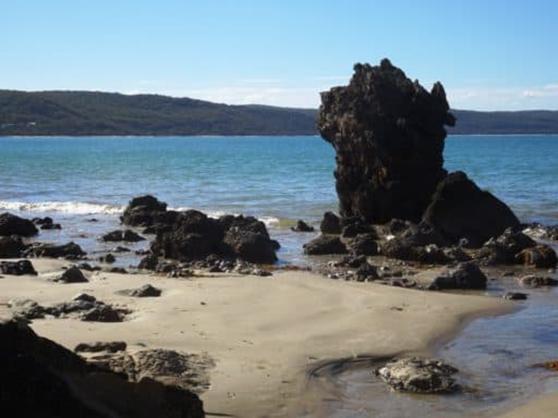
Walkeville
South beach looking towards Bear Gully. The Bird Rock on the point.
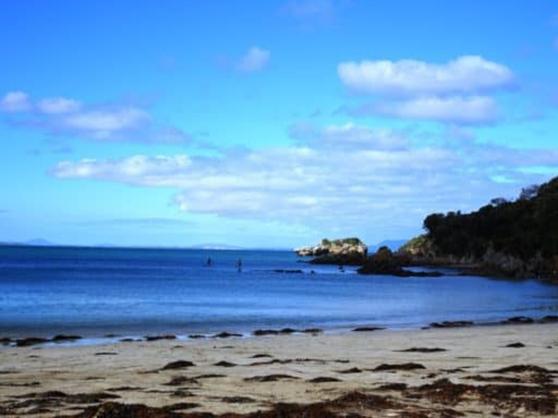
Looking
(800 metres) towards Walkerville North.
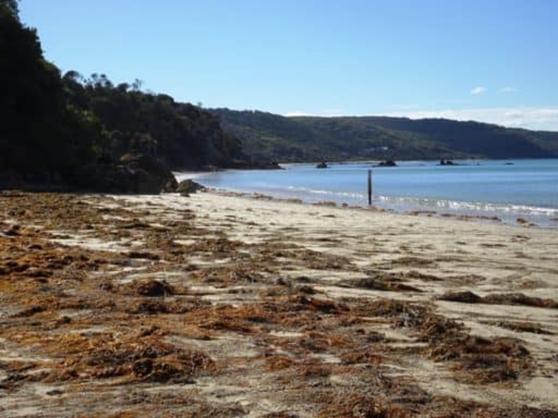
From
Walkerville North looking towards Walkerville South.
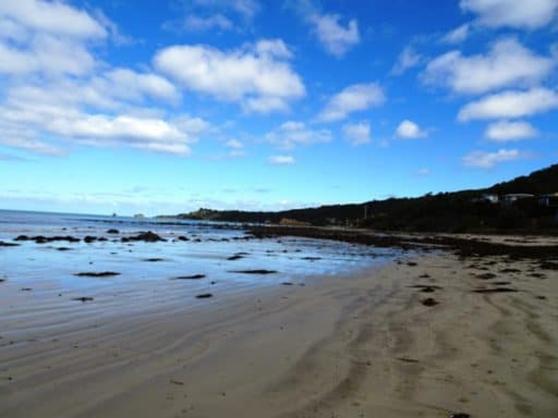
And
towards Walkerville and Waratah Bay (caravan parks/kiosks)
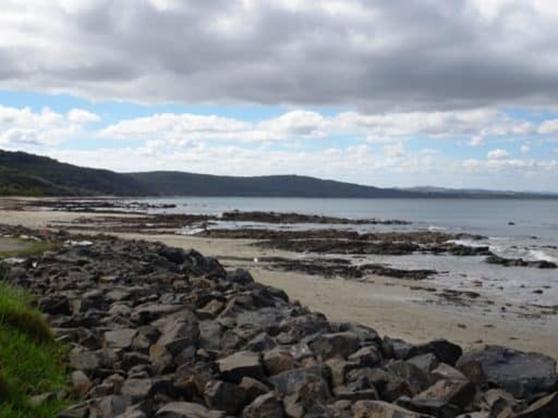
Across
the skerries towards the Prom. 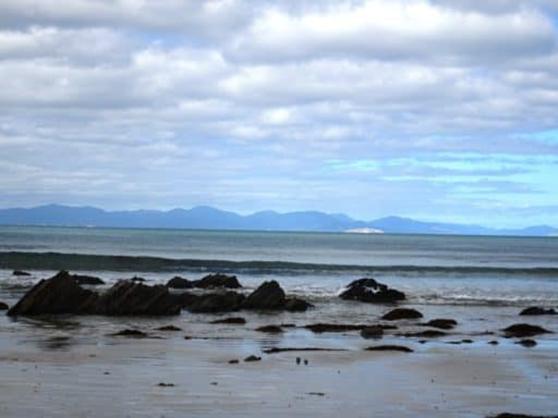
A
shag on a rock.

And
Honey practicing her leaping.
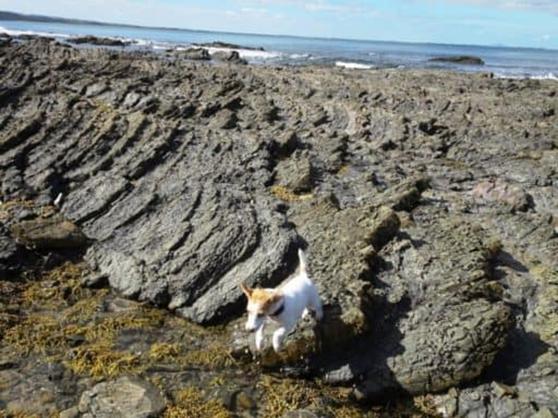
At
Waratah Bay looking back towards Walkerville.
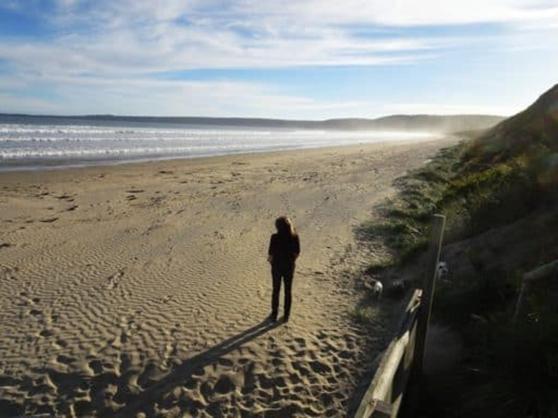
And
onwards to the Prom. You can walk right along this beach to the Darby River
(once you get across Shallow Inlet) and then on to Tongue Point - and the lighthouse. A pack raft such as this might be a good idea for this trip.

This
gull is 'puddling' up some tucker.
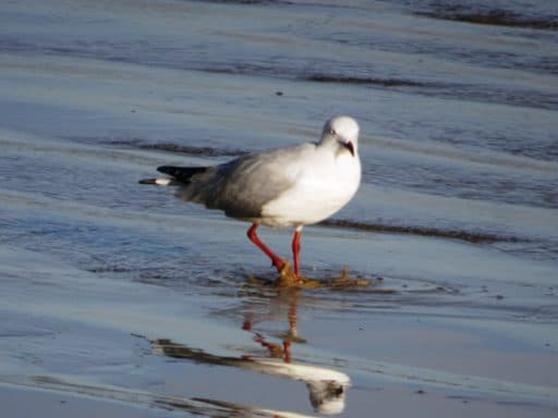
Honey
is getting really good at stairs.

This
is the boat launching spot on Shallow Inlet looking West. You can drive along
the shore here. At low tide it is only a paddle of about 100 metres across to
Hourigans camp on the other side. From there you walk all the way to Darby
River. There are some streams with fresh water as I mentioned here.
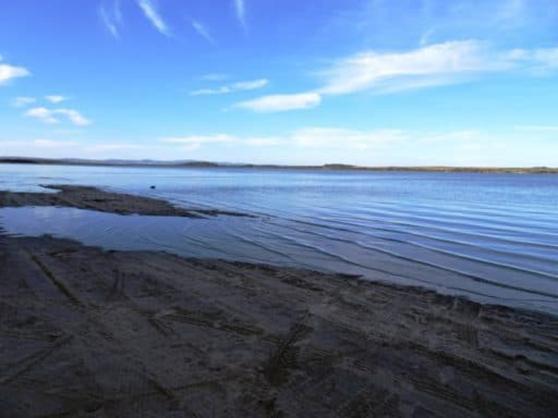
Looking
across to Hourigans Camp. If you can't paddle across, you can walk around the
road.
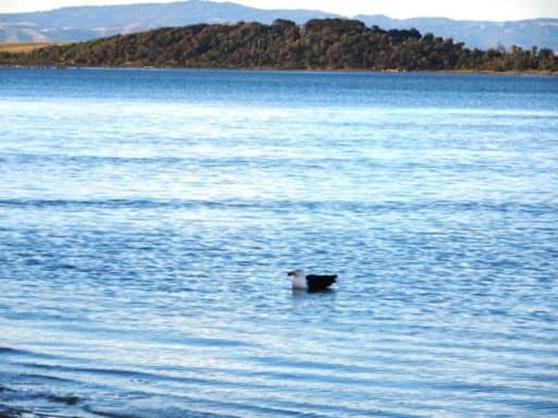
Some
pelicans enjoying the afternoon sun.

Looking
across the Shallow Inlet towards the Darby River and Wilsons Prom.

See
Also:
http://www.theultralighthiker.com/the-great-gippsland-circuit/
http://www.theultralighthiker.com/rail-trails/
http://www.theultralighthiker.com/george-bass-coastal-walk-2/
http://www.theultralighthiker.com/a-walk-on-the-wild-side/
http://www.theultralighthiker.com/venus-bay-no-4-beach-gippsland-victoria/
http://www.theultralighthiker.com/andersons-inlet/
http://www.theultralighthiker.com/the-five-mile/
http://www.theultralighthiker.com/liptrap/
http://www.theultralighthiker.com/waratah-bay/
http://www.theultralighthiker.com/killer-bees/
http://www.theultralighthiker.com/the-isthmus/
http://www.theultralighthiker.com/on-the-tip-of-the-tongue-2/
http://www.theultralighthiker.com/to-the-lighthouse/
http://www.theultralighthiker.com/glamping-wilsons-prom/
http://www.theultralighthiker.com/nooramunga/
http://www.theultralighthiker.com/there-is-simply-nothing-like-an-old-port-walking-trail/
http://www.theultralighthiker.com/sale-common/
http://www.theultralighthiker.com/blond-bay-lake-tyers/
http://www.theultralighthiker.com/blond-bay-roseneath-reserve-hollands-landing/
http://www.theultralighthiker.com/beautiful-east-gippsland/
09/04/2018: Something to celebrate: ‘This August is
the 250th anniversary of the sailing of HM Bark Endeavour, captained by Lieutenant James Cook, from Plymouth on August 25, 1768.’
https://quadrant.org.au/magazine/2018/04/banksia-men-transit-venus/

06/04/2018: Eradicate European Wasps: It is possible
to bait European wasps (with readily available products eg Permethrin,
Finitrol) in such a way that it does not harm anything else (bees, birds). The
wasps take the poison (from converted milk bottle traps) back to their nests
and kill the nests. Every wasp for 200 metres will be eliminated. My view is
that this should have been done by Government 30 years ago. Astonishingly in
Victoria it is illegal to post instructions on how to do it on pain of a fine
of $7500 though the Tasmanian Government has instructions on how to do it! You
can try a Google search (eg bait European wasps) There is a useful Facebook Group. Below are a couple of
useful links

Link 1
Link 2
05/04/2018: Powerfilm Lightsaver: I am looking to
upgrade my solar charging ability. I have the Powerfilm USB + AA Charger at 1.5 watts
which I have found adequate for myself. But we now have more rechargeable
devices some having larg(er) wattage capacities so that I find
it struggling. Ideally I think I would prefer a rollable panel which does not
have its own battery backup (as I would prefer to configure this myself).
It
also makes it harder to compare the performance of the various units as the 'rate
of charge' you get on your device (eg 1% per minute on your smart phone say) is
likely to be more a factor of the size and performance of the solar charger's
own internal battery than the output of the panels themselves.
For
example, 5 watts should give you 1 amp (1,000 ma/h) at 5 volts (standard USB
current - Watts = amps x volts). An approx 3,000 mah battery such as your
phone or an 18650 battery should charge in 3-4 hours of bright sunshine
therefore. There are two of us, so such a setup should charge both our phones
in one day and two 18650s the next day. This is quite enough to charge other
devices we might carry such as Nightcore torches, our cameras, satellite messengers and GoTennas. We usually use our phones for
mapping/GPS functions.
Powerfilm
Lightsaver 3 watts:

Clearly
you need a flexible solar panel (such as this one) as you will want to 'wear'
the panel on your back pack, or store it safely in your pack without fear of
its breaking. You also need one which can be pegged out or tied out so it does
not flap in the wind - something which will surely break small electrical
wires. The voice of experience here!
https://www.amazon.com/LightSaver-USB-Roll-up-Solar-Charger/dp/B016N2NMBC
& https://www.powerfilmlightsaver.com
3200mah battery 1 amp 5 volts 3 watts panel 4.9 oz (139 grams
- you can probably save 10 grams by cutting off the 'tail'). 7.8" x
18.5" US98.97 (April 2018) Certainly good enough for one person.
Its
‘Big Brother’ https://www.powerfilmlightsaver.com/lightsaver-max Unrolled:
34.5” x 13.5” Weight: 1.5 lbs Battery: 18,000 mAh Too big for a pack!
There
do exist other stand alone rollable panels such as this one at 269 grams. It is 7 watts but
is 368 x 584 (14" x 23") so would be a bit big to fit over your pack.
Still 7 whole watts would get your devices charged pronto in the middle of the
day. Unfortunately as you would not get any use out of it while walking you
would have to make do with the last couple of hours of the day which would
probably mean in a hiking situation you would not get much more out of it than
the one pictured. I will be conducting a bit of a survey of them before I
commit to buy.
I
may even have to do some modification to them to get just what I want. For
example cut this one down to just the panel/charger
and make it charge my own 18650 batteries. It has 4.5 watts and the panel alone
appears to weigh only 50 grams. 200 x 550 (8" x 22") would fit your
pack better than many options. And 4.5 watts - much closer to what we might
need as a couple.
You
can buy a 5 volt output circuit with USB for less
than $5. If you are up to a bit of soldering you could discard most of the mass
and have a pretty handy solar panel to attach one of your 18650 chargers to eg this one or this.

NB:A
word about high altitude: I took the USB + AA
on my Everest Base Camp Trek. At that altitude (above 3,000 metres it failed to
keep up with my phone batteries' charging needs even though it was bright
sunshine all the time! By the same token the spare charged batteries
themselves were rapidly going flat even when just stored in my pack. This
applied to both Eneloops and Lithiums. It was not a temperature thing as it was
nowhere near as cold as it normally is camping out in the Gippsland mountains
in the winter. It was clearly an altitude/pressure effect. It may be possible
to store the batteries in an inflated/pressurised bag to prevent this. Worth a
try.
BTW:
It is very difficult to keep your phone batteries charged on this trek even
though all the accommodation places offer phone charging (at around $5 a charge
- compared to $1-2 for the night's accommodation itself!) If you have a large
battery (my friend had some around 10 mah) the solar systems they have in Nepal
will be unable to charge them. I recommend you stick to your phone battery and
maybe 1-2 of the rechargeable 18650 batteries and one of the two chargers
recommended (below) for them. A hot(ish) shower also costs around $5 - far more
than a meal! Watch out for the dread Khumbu Cough. I did not. Have fun.
See
Also:
http://www.theultralighthiker.com/ultralight-power-bank-nitecore-chargers/
http://www.theultralighthiker.com/universal-magnetic-usb-charger/
http://www.theultralighthiker.com/powerfilm-usb-aa-solar-charger/
http://www.theultralighthiker.com/power-from-heat/
http://www.theultralighthiker.com/power-from-heat/
http://www.theultralighthiker.com/11-gram-rechargeable-head-torch/
http://www.theultralighthiker.com/charging/
http://www.theultralighthiker.com/mobile-phone-battery-life/
http://www.theultralighthiker.com/nitecore-continues-to-push-the-boundaries/
http://www.theultralighthiker.com/clear-pvc-backpack-lid-for-solar-charger/
http://www.theultralighthiker.com/gotenna/
http://www.theultralighthiker.com/the-poor-mans-satellite-phone/
http://www.theultralighthiker.com/never-get-lost-just-20/
http://www.theultralighthiker.com/ultralight-camera/
31/03/2018:
Amazing Rock Balancing: https://www.facebook.com/pjrockbalance/?fref=mentions
30/03/2018:
Ultralight Cups: It's surprising how
much weight you can save in small ways. For example, my improved Fancy Feast Stove created a simmer stove
which weighs under 15 grams. This shaved 30 grams off my stove weight. Using small aluminum containers to store the
various ointments etc you carry has cut nearly 100 grams from my pack weight. A
lighter cup such as the one shown cut 21 grams. Somewhere during this process,
I culled through my pack and discarded a total of around a quarter of a
kilogram (1/2 a pound) of quite unnecessary weight. I am currently modifying my
Pocket Poncho Tent so it will take two
people (and weigh less than 300 grams including pegs and guys). And so it goes
on...
Here
are a few 'cups' for comparison. The blue $2 shop cup (top centre) weighs 29
grams. I have carried it for over 20 years, and weighed many cups before I
settled on it as the lightest. I still think it is probably the solidest.
However, here are some other options. The yellow 250 ml cup weighs 16 grams.
The 240 ml jar weighs 16 grams (lid 7). The empty Simmenthal 214 gram 220 ml
can weighs 12 grams. The red cups weigh 3-4 grams each bare. With the blue
plastic handle (bottom cut out) from Aliexpress (pack of 5 for $1.95) it
weighed 13 grams. The one with the (unwieldy) felt handle was 8 grams, which I
cut down to 7 grams with the sewn felt ring on the scales. This is just
polyester felt from Spotlight left over from this propagation project.
The
strip of felt quite adequately insulates the hot cup from your hand. You have
to wrap an approx 2" (50 mm) strip around the cup, mark it on both sides
with a felt pen, sew (twice) then trim to get a neat conical 'grip'. It occurs
to me I could have made it the full length of the cup if I wanted my coffee to
stay warm longer. Usually though on the trail I am impatient to get it inside
me!

BTW:
Aliexpress have a pretty neat stackable aluminium 390 ml cup which
weighs 38 grams for US$4.72 (April 2018).
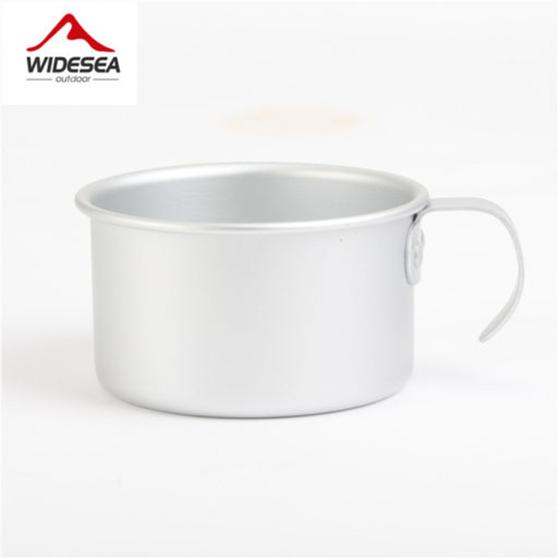
Close
up of that 7 gram coffee cup.
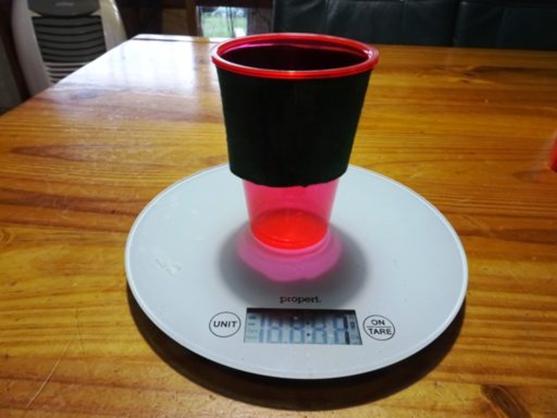
Have
fun performing such experiments of your own.
See
Also:
http://www.theultralighthiker.com/new-fancy-feast-stove/
http://www.theultralighthiker.com/small-is-beautiful/
http://www.theultralighthiker.com/single-use-antibiotic-packs/
http://www.theultralighthiker.com/the-pocket-poncho-tent/
http://www.theultralighthiker.com/capillary-mat-plant-starters/
http://www.theultralighthiker.com/60-diy-ultralight-hiker-ideas/
29/03/2018:
Broken: At least two of my old
sites have been broken or seriously glitched for ages. I have been working on
fixing them over the last few days. There is still quite a lot of work to do on
some of other these old pages. It will get done. In the meantime, if you would
prefer a format where the page just loads and you are able to just scroll down
through all its content (as I do), why not check out (for example) http://www.finnsheep.com/Ultralight%20Hiking.htm
I think it and all its sub-pages work again now.
Cheers,
Steve.

28/03/2018:
Liptrap: Cape Liptrap at the Western
end of Venus Bay beach in South Gippsland is a scenic extravaganza as you walk the Victorian coastline perhaps
beginning at Phillip Island and ending in Eden NSW, a journey which will no
doubt take you several delightful weeks. Where else in the world could you have
such an adventure?
This
is the lighthouse near the point of Cape Liptrap which has warned off ships
from dangerous rocks for many years.
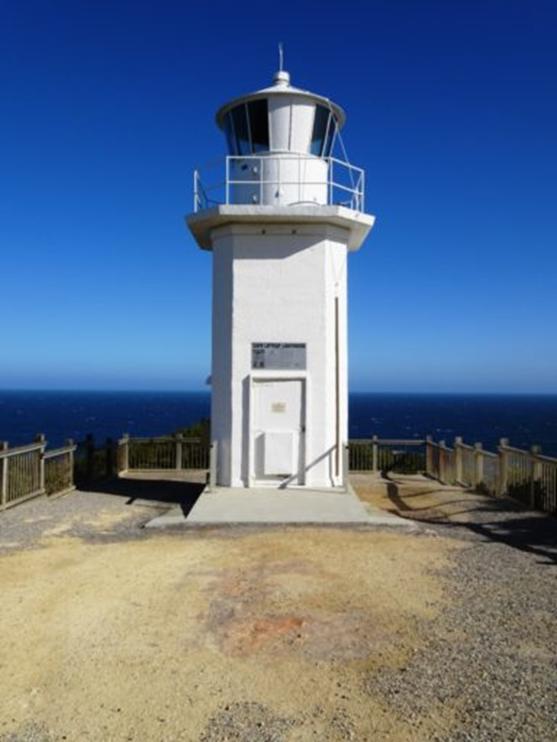
You
can see some of those (dangerous and ) beautiful rocks below:

This
is the view East across Maitland Bay towards Waratah Bay and Wilsons Prom. 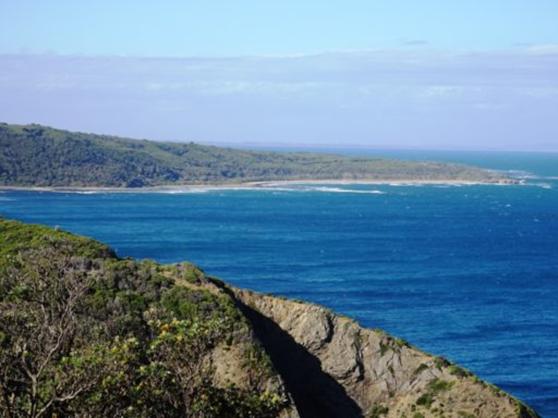
We
happened to see a rare 'water sprite' one of very few I have seen and the first
I have ever managed to snap. They are such an evanescent emergent phenomenon
they are well nigh impossible to photograph. Strong Westerly winds whipping
around the point here can create such vortices. Be on the lookout for them on
windy days.
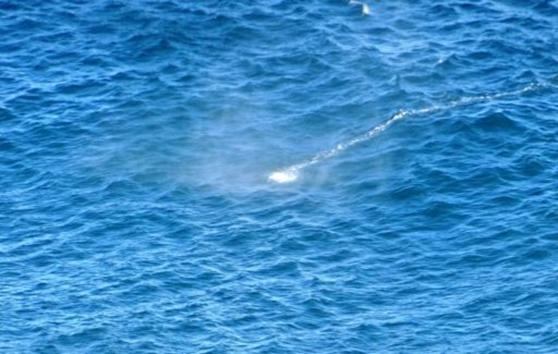
I
particularly admired this enigmatic DSE sign. ('Walk/Don't Walk?)
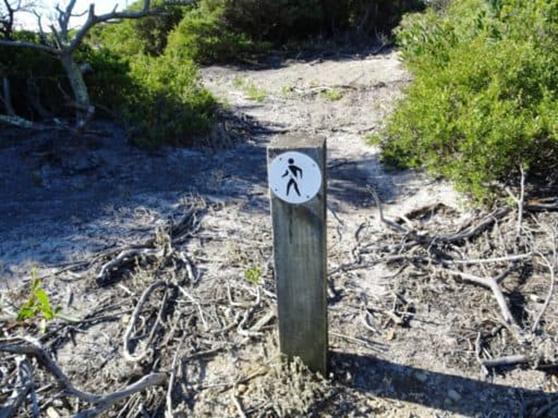
Looking
down to the West you can just make out a beautiful little beach beneath the
heath.
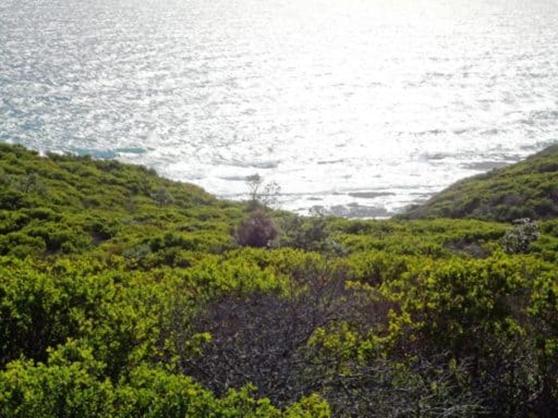
Where
the mighty waves of the Southern Ocean beat against the rugged rocky coast.

There
is a path down: Less than 100 metres back towards Walkerville you will see a
locked gate on the Western side. Follow this path down a ridge.
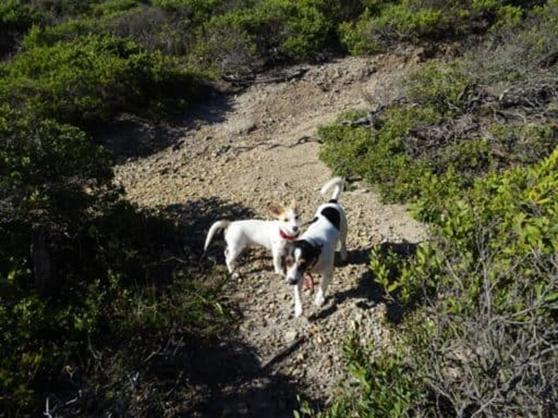
You
will then have to cross this gully. Watch out for the path as there is only
one. You have to be particularly careful on the way back up, as so many people
have obviously missed it and wandered for hours searching for a way back out
onto the road. 
The
view down onto the beach (facing West here) just keeps getting better.
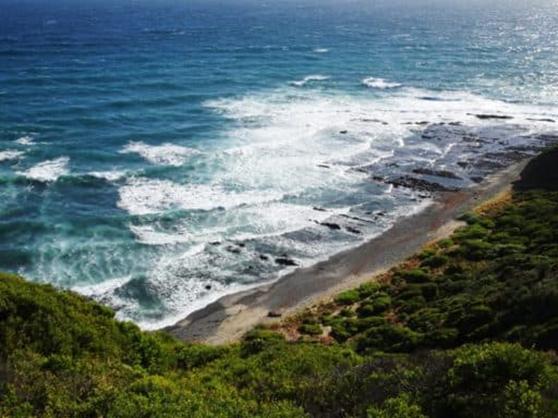
A
panorama from Della's phone.

Close
up of the web of the spume on the skerries. 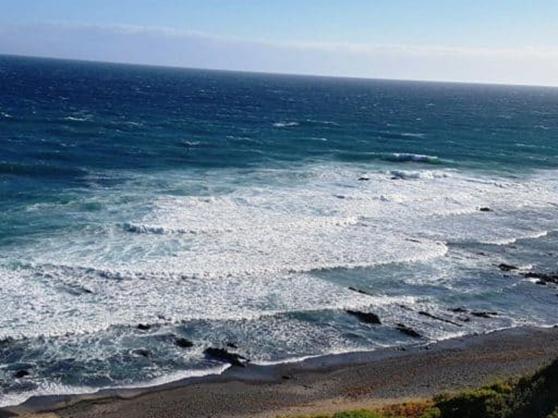
Further
down still.

Looking
East.

Breaking
through the Banyalla onto the beach. Banyalla has edible fruit in season (as
does pigface - there is plenty of that here too).

Spot
leading the way.

This
is the view back up (if you are walking along from Venus Bay. You have to watch
for this gully as it is your last safe point of exit. The path travels up the
West side of the gully then crosses over to the ridge on the East side.
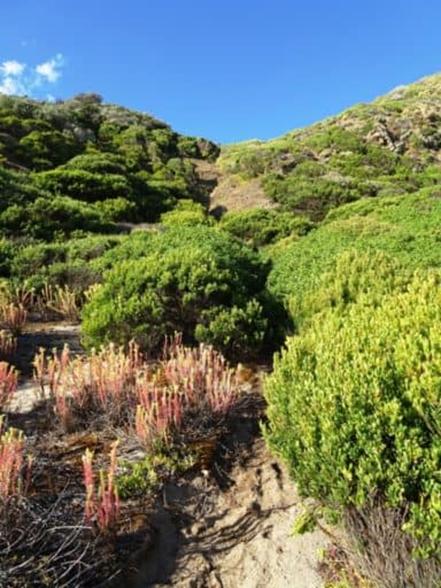
The
dogs love the beach.
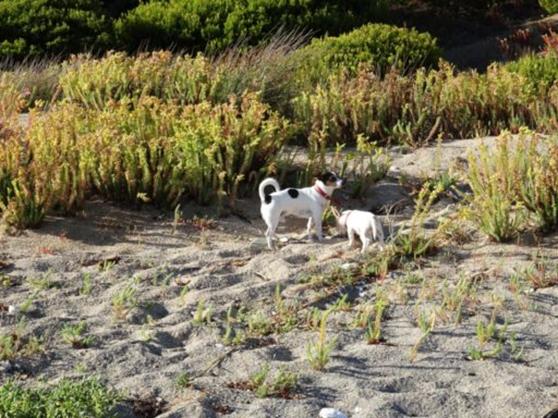
The
bay to the East.

Look
at that chop.
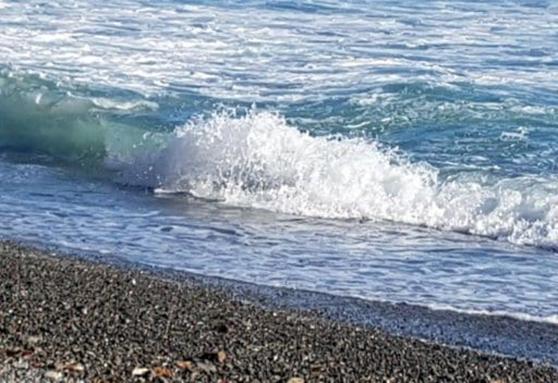
Immediately
to the West there is this interesting sea-cave being created in the syncline by
the waves.
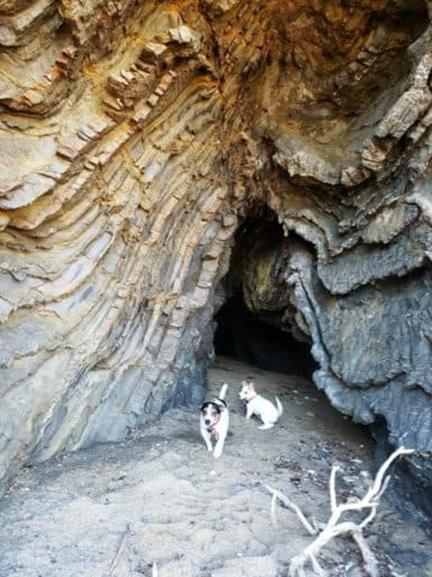
The
westering sun echoing off the skerries.
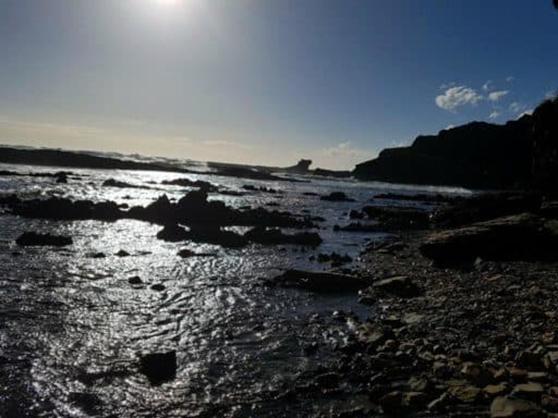
And
again. 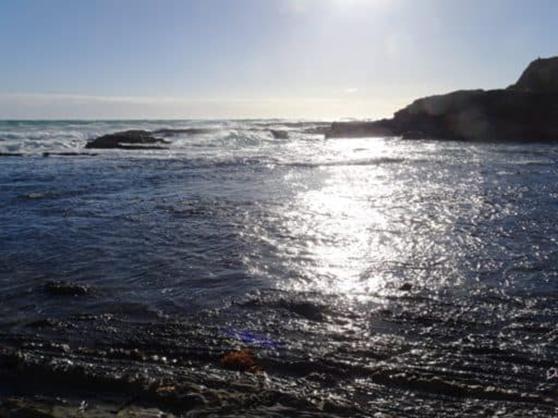
Except
at high tide the Government reckons you can walk all the way along here (from
the Arch Rocks (nearer the Ten Mile) to Walkerville. I think they should say it
is 'possible' at low tide myself. A couple of the points (Cape Liptrap itself,
for example) could be quite dangerous even then. This is the view that greets
you after you scramble around the first point heading West. You may be better
to exit here then walk along the road to Bear Gully - but there is a way down
to Maitland Bay on the other side of Cape Liptrap through the bush.
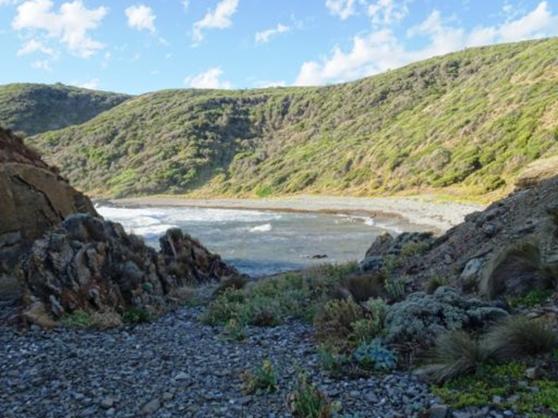
A
long Southern wave rolling in to this seagull-bobbing cove. 
Above
could almost be a moonscape - a desert scape anyway.
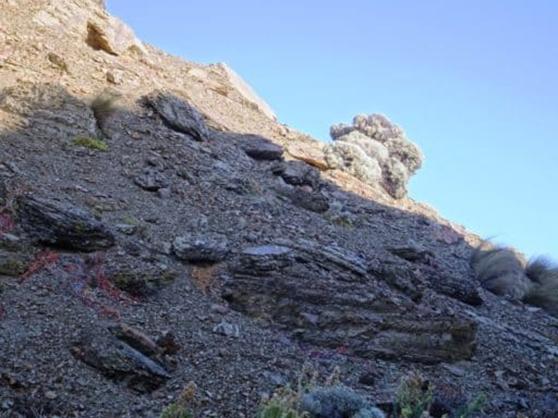
There
are so many interesting rock formations. You can imagine the wonders laid down
in the layers of this ancient stone.
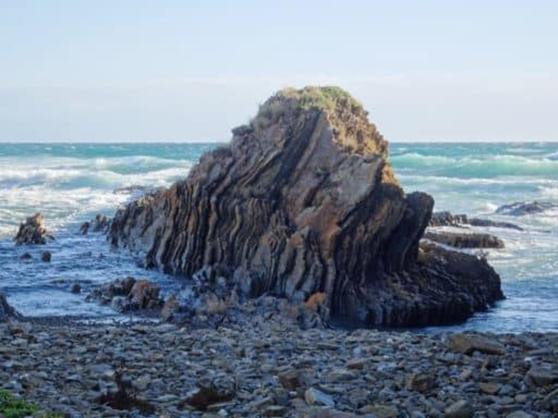
Some
of the rocks have been painted by nature rather more spectacularly than by any
human artist.
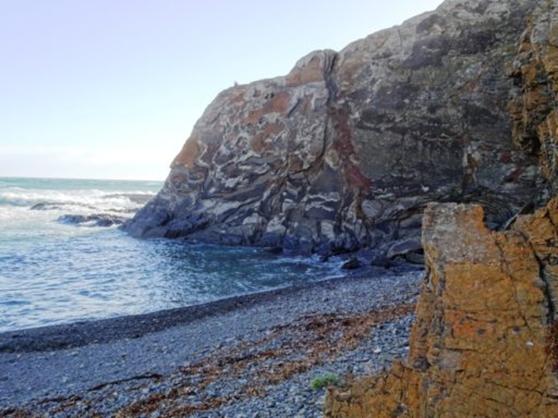
The
tide has been coming in quite quickly. You need to watch out for that. Check
the tide heights here: Waratah Bay would be the closest
station. For the dogs especially (Well, the puppy, Honey anyway) getting
around here is becoming a challenge. And, it is time for dinner. MaCartins
Hotel in Leongatha is one of our favourites.
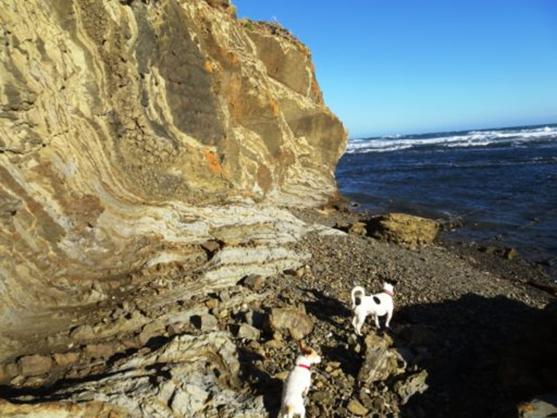
See
Also:
http://www.theultralighthiker.com/the-great-gippsland-circuit/
http://www.theultralighthiker.com/rail-trails/
http://www.theultralighthiker.com/george-bass-coastal-walk-2/
http://www.theultralighthiker.com/a-walk-on-the-wild-side/
http://www.theultralighthiker.com/venus-bay-no-4-beach-gippsland-victoria/
http://www.theultralighthiker.com/andersons-inlet/
http://www.theultralighthiker.com/the-five-mile/
http://www.theultralighthiker.com/liptrap/
http://www.theultralighthiker.com/killer-bees/
http://www.theultralighthiker.com/the-isthmus/
http://www.theultralighthiker.com/on-the-tip-of-the-tongue-2/
http://www.theultralighthiker.com/to-the-lighthouse/
http://www.theultralighthiker.com/glamping-wilsons-prom/
http://www.theultralighthiker.com/nooramunga/
http://www.theultralighthiker.com/there-is-simply-nothing-like-an-old-port-walking-trail/
http://www.theultralighthiker.com/sale-common/
http://www.theultralighthiker.com/blond-bay-lake-tyers/
http://www.theultralighthiker.com/blond-bay-roseneath-reserve-hollands-landing/
http://www.theultralighthiker.com/beautiful-east-gippsland/
25/03/2018: Budget Pack Mods: Recently I bought a
couple of cheap approx 40 litre packs from Amazon for less than US20 each. I
thought these would be a good recommendation to someone who wanted to begin
hiking on a small budget. The first thing you need after all is something to
comfortably and reliably carry your stuff in. I bought this one for US$ 17.99 and this one for US$19.99. Straight out of the
bag the packs weighed 335 grams and 382 grams on my scales.
Vidong
Polo:

The
Vidong Polo was lighter than the G4Free and claimed to be 2 litres bigger;
otherwise they are pretty well identical. Both of them look to me to be made of
a quite robust material which should take quite a lot of use, and are generally
well made (as well as $250 back packs anyway!) I could fit all my gear for a
trip of 4-5 days in either. For a trip of more than a week, there is plenty of
room to stow an extra compression sack underneath the lid. Notice the 'spare'
length in the compression straps.
G4
Free:
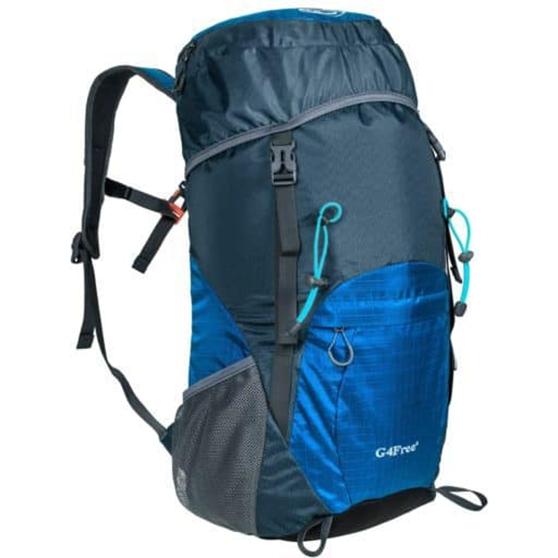
First
I stripped the Polo down to 315 grams. After my modifications the Polo weighed
pretty much 350 grams. I could cut away another possibly 50 grams if I wanted
eg to sacrifice a couple of pockets, lid, tie-out loops etc. This is a pretty
great weight!
I
think it is a good idea to start on your DIY backpack 'career' by doing some
'mods' to a cheap existing pack like this as you learn so much. For example, I
learned that the hip/waist belt on every pack I own is in the wrong place! I
first sewed it on pretty much in the manner that such things are 'always'
attached (ie on the 'flap' where the bottom 'anchors' of the back straps are),
and it just didn't work especially for Della, which surprised me as these are
quite 'short' backpacks which ought to be eminently suitable for her. She is a
very neat 5 foot and around 40 kilos.
This
led me to the other major thing I learned which is that practically every back
pack I own is too long for me, (I am am approx 5'7") which is why I have
often found them uncomfortable - and Della has found them well-nigh
impossible.With the belt sewn on at the bottom of the pack there is 16"
from the point of attachment of the shoulder straps to the top of the belt.
This is so much better than the usual 'minimum' of 18" that you probably
need to buy one of these packs just to try that out, if nothing else.
Also,
because the belts are 'normally' sewn in the wrong place (and all the way to
the sides) they are also much wider than they need to be which nonetheless does
not make them work better. The converse is the case. I have sewn the belt on
(just in the middle six inches) so that when you cinch it up it tightens around
your entire torso instead of 'jutting out' at the sides. This provides so much
better grip at a lower tension that the pack has no inclination to slip down
and take your trous with it! But it also transfers the load so much better that
these unpadded straps are not a problem at all. They are just holding the pack
from falling off your shoulders, which is as it should be.
I
have already noted that back packs are normally constructed too straight. They
need to curve so they naturally swing into the 'small' of your back and stick
there, just as this one does, and these are reputed to do (You will note
that the 'Exodus' weighs 454 grams). This would involve cutting a curve into
the side panels if you were making your own. This pack is short enough that it
does that naturally.
I
first of all got rid off the elastic straps at the top. There is nothing I want
to attach here, but if there is later on I will construct lighter ones out of
1mm dyneema and a micro cord lock (approx 1 gram each). I also similarly
replaced the cinch cord at the top of the pack. 20 grams was saved here.
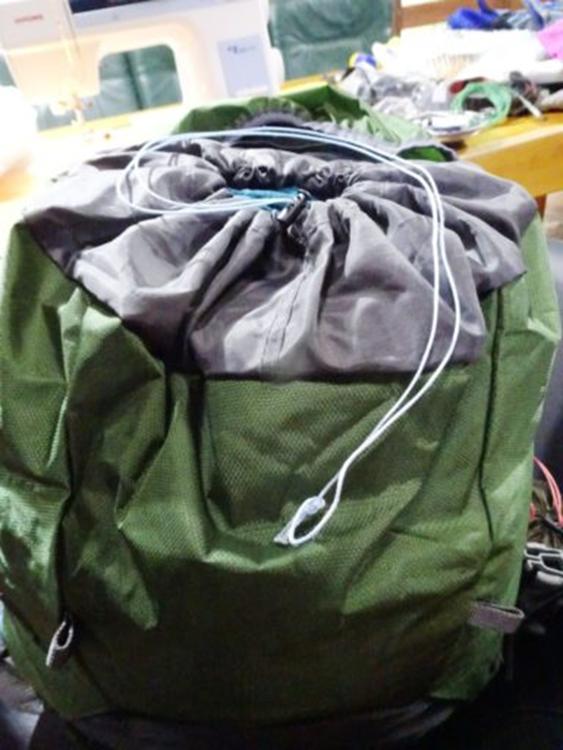
I
wanted to attach a sit pad to the back and try to do something to reduce the
wet back phenomenon. I sewed four gross grain ribbon loops, then used the above
arrangement of dyneema and a micro cord lock. I have found this works very
well and weighs very little. i don't like elastic. it is heavy,
absorbent, perishes and breaks too easily. Dyneema is bullet proof!
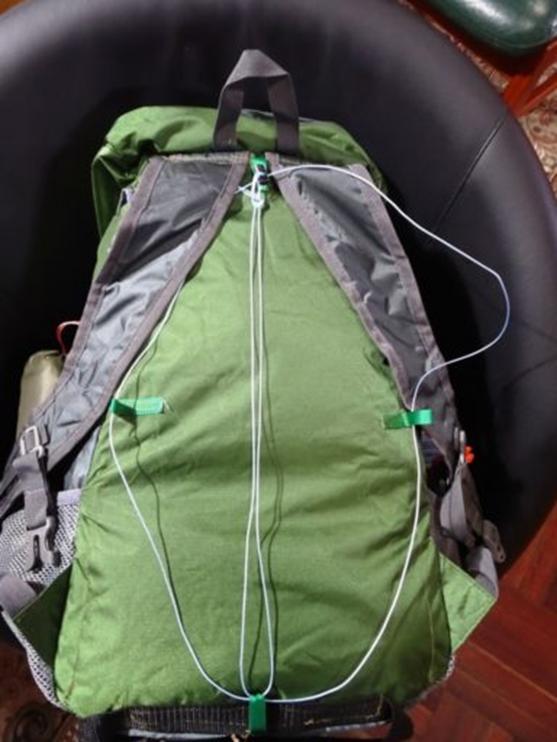
I
also reinforced the back pack straps with a piece of 1" webbing and sewed
them through a couple of times.You can see this stitching at the top of the
previous photo. You will also notice that I have constructed two cloth
'tubes' by hemming the internal pocket, then sewing on a piece of tape above to
extend the tube the full length of the pack. Those two carbon fibre tubes are
only 3mmm but are enough to create some solidity and load transfer. They weigh
less than 3 grams together.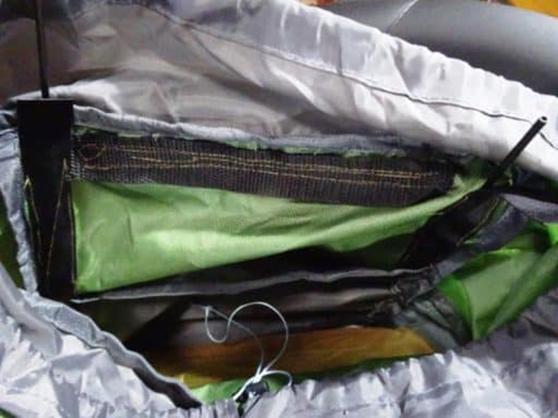
I
sewed a couple of side straps (with buckles above the pockets which I thought a
but short. i sewed them 100 mm (4") above the pockets which was a bit
much. 65mm would have been better. You see you can just use a 'normal drink
bottle to carry your water. One will last for thousands of miles.

Other
side containing my Pocket Poncho Tent attached with a 2 gram
Niteize S-Biner as a safety measure. You don't want to lose your tent. There is
still room in this pocket for a folding umbrella. Ther is also room on the back
zip pocket for a raincoat. Phones, sunscreen, snacks for the trail (all sorts
of things) will fit in the lid pocket. I would probably keep my passport,
hunting licence, wallet or other such documents in the hidden inside
pocket of the lid. I have no immediate use for the hydration pocket.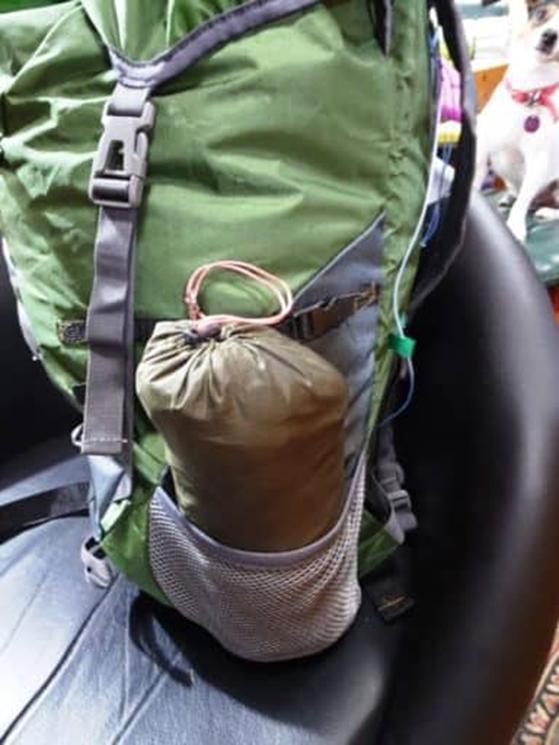
This
is a microfibre towel from a $2 shop. I have sewn buttons and button holes to
it so it can enclose the Gossamer Gear Sitlight pad I have punched
additional holes in for ventilation. (They now have a new one which might work even better).
For
the budget conscious Aliexpress have foam sit pads for less than US$2. You
could punch a lot more holes in them with a wad punch than I have. I figure the
microfibre towel will add some wicking/drying - and I carry one anyway.
Something with more holes, more channeling would work better (eg a section of a
Z-lite pad. Again a better wicking material such as this one from Ripstobytheroll would no
doubt work even better. Nothing I have tried works better than this. I may try to make one out of carbon
fibre rods which is a bit better shape (and weight).
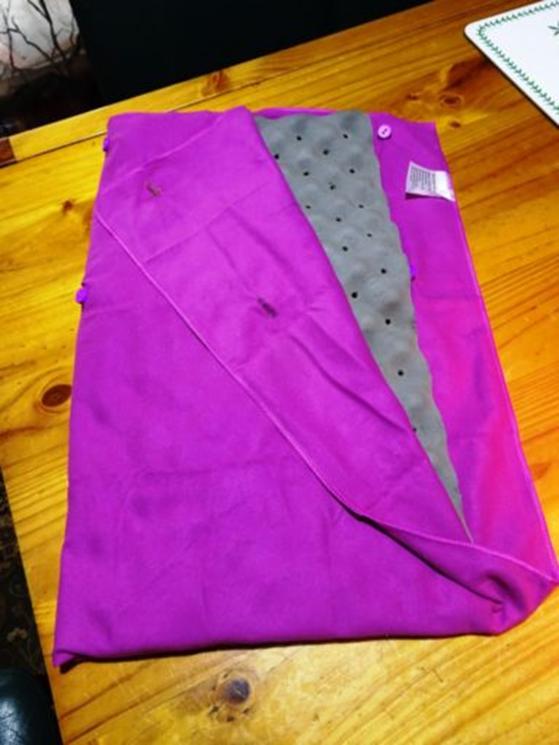
Here's
how it fits on the pack.
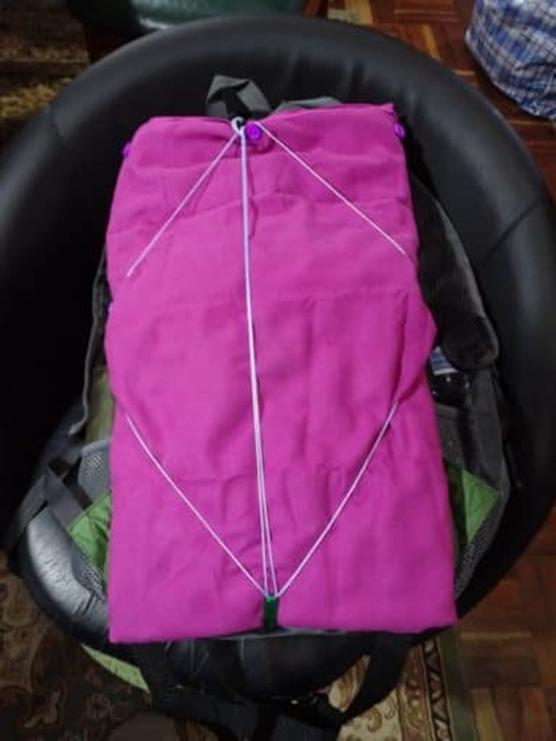
Della
thinks this pack will be just about perfect for her. It suits me fine too, and
I am out of pocket less than $30!
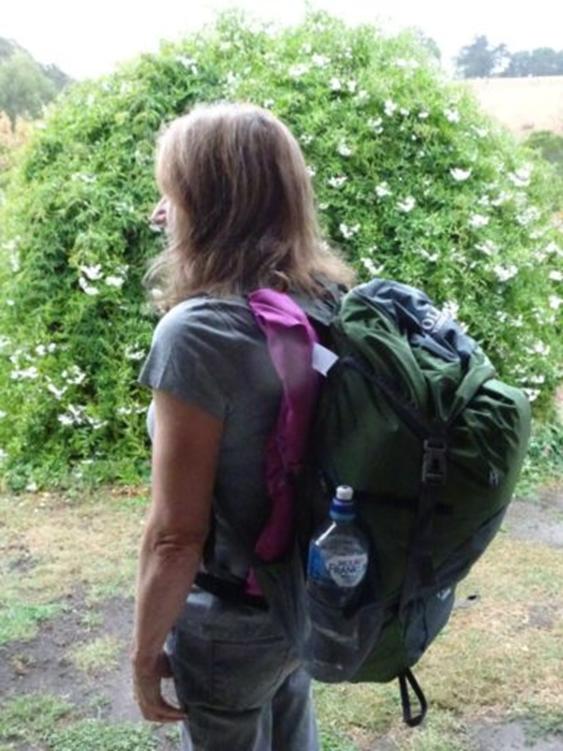
See
Also:
http://www.theultralighthiker.com/ultralight-hiking-on-a-budget/
http://www.theultralighthiker.com/ultralight-ultracheap-backpack/
http://www.theultralighthiker.com/poly-tent-by-the-ultralight-hiker-on-the-cheap/
http://www.theultralighthiker.com/new-fancy-feast-stove/
http://www.theultralighthiker.com/60-diy-ultralight-hiker-ideas/
24/03/2018: Hiking Tarka Dal: This continues a
series of recipes on simple Dals which you can make quickly from dried
ingredients for hiking. Each of these dals has its own unique taste so that you
will not tire of them (at least so long as you intersperse them with some of my
other recipes).

To
a litre of water, add:
Ingredients:
250
grams (1 cup) of red lentils
1
1/2 Teaspoons of Turmeric powder
2
Teaspoons of garlic powder
3
Teaspoons of onion powder
1
Teaspoon of cumin powder (or cumin seeds)
1
Teaspoon of garam masala
10
Teaspoons of coconut milk powder
1
teaspoon hot paprika
1
Teaspoon ginger powder
1
1/2 Teaspoons of sweet paprika
1
pinch - 1/4 Teaspoon of salt (to taste)
1
teaspoon of coarse ground black pepper (to taste)
1
50 gram sachet of Tomato Paste
Bring
to the boil and simmer approx 20 minutes.
Optional
1
teaspoon of coriander (if you like it. I don't)
A
quantity of chopped salami or Hormel Bacon Pieces (eg -2 Tablespoon) if you
'need' some meat.
NB:
All the dry ingredients and the sachet of tomato paste can be stored in a
ziplock bag for a short time until needed.
See
Also:
http://www.theultralighthiker.com/a-simple-backpacking-dahl/
http://www.theultralighthiker.com/hiking-makhani-dal/
http://www.theultralighthiker.com/a-hiking-food-compendium/
23/03/2018: Brer Fox: I have such a love/hate
relationship with this guy. We have farmed sheep here and on other farms nearby
for nigh on thirty years now, (and far longer elsewhere). When we first moved
here Col Francis, a (now late) friend I used to go deer hunting with came
around and managed to spotlight 34 foxes on our (home farm of) 25 acres in a
single night!
We
used to shoot a lot of foxes in the 1980s when the furs were still worth
something (sometimes A$30+ per skin!. My friend paid for a brand new Toyota
Land-Cruiser out of fox skins in a single year! They certainly paid for all our
family Xmas presents back then - though it was a smelly unpleasant business
getting them off, pegged out etc.
For
years every Sunday I used to go hound hunting for foxes with my friend (the
late) Dick Davies of Tarwin Lower. There were usually about half a dozen of us
including Ray Quinney, Ken Fisher, John Harris, Brian Holcombe, Max
Butterworth...half of us gone today.
We
would normally surround a 'fox patch' (any small remnant piece of scrub) on
local farmland, then let a couple of hounds in to flush them out. It was quick,
exciting and simple work. Every year we shot over a thousand foxes! And sold
their skins to people who wanted (wickedly) to wear them.
Dick
also had a couple of Jack Russells ('den dogs' as he called them) which could
be put down a fox's burrow to harry it out. You should always have a couple of
these about the place - as we do. These little guys are incredibly
plucky. Though smaller and lighter than a fox they have more courage than any
other dog known. They would not hesitate a second to fight a fox. After a few
minutes they would be bleeding profusely from the nose - and you could bet Brer
Fox was too.
It
was then that you would catch the dog and put it back in the truck, and wait
patiently and quietly. In almost exactly a timed five minutes that fox (or
foxes) would come out of the earth like a shot fired from a cannon. You had to
be right on the ball to 'nail' him or he would be gone. As much skill required
as shooting a snipe - if you are old enough to have done this (legally) since
the Government donated all our snipe to the Japanese years ago.
We
once had lots of farms, some owned, some rented, some we used for free. But we
are old now so have shrunk the acres down to this small patch which we will
only leave for the grave.
There
have always been so many foxes here, as we live in a small valley. Behind us is
forest comprising numerous 'Land for Wildlife' small holdings where they breed
up. Each night they flow down the valley like a small flood to raid the vast
Morwell River flats and the neighbouring University town of Churchill.
I
used to bait them starting back in the early 90s. I would put out two fox baits
morning and night on opposite sides of the property (on 'game' trails - as you
would). I scent marked the buried baits with a little (sild) sardine oil, which
works very well to lure them in. Every day four baits were taken - equaling
four dead foxes.
I
did this for over two hundred days before there was a break - which lasted for
only about a week, then another one hundred days of four dead foxes a
night...The bush behind us was littered with dead foxes - yet I made no real
impact on them. I did this for years.
This
'Land for Wildlife' is just protecting foxes, large macropods (kangaroos and
wallabies) and innumerable wombats, all of which come down of a a night to
freeload on our land - and the neighbours'. Well they don't get to feast on our
place much as we have had it ring-lock fenced with electric outriggers since
around 1990, but they sure pass by in large crowds.
It
is as nothing to see sixty kangaroos late afternoon in the paddocks on the
opposite side of the valley. No-one else does anything to control all these
pests. People's stocking ratio is terribly limited by them. Between the wombats
and the roos there is no vegetation at all under the bush in back of our place
- just bare dirt. A veritable native plague. There is nothing for anything smaller
to eat and nowhere to hide - and the innumerable foxes would lap them all up
anyway! Land for wildlife...
We
also have a plague of kookaburras in our valley. Since everyone else's land was
subdivided all the townies who have moved in feed these blighters. They are
veritable foxes of the air. There is a roaming flock of over a dozen of them
here. They snap up every smaller bird they see if it is found out in the open.
We hardly ever have a pair of wagtails any more. They actually even ate out all
the Indian Minahs in our valley!
They
need to be relocated, or an open season declared on them. They monopolise every
tree hollow so there is nowhere for parrots and other birds to nest. Anything
which becomes too numerous becomes a pest.
As
I have mentioned here, we are slowly working our way to
building a 'vermin-proof fence' around our entire perimeter. Another year or so
and it will be complete. There will then be no repetition of the tragedy I
found when hanging out the washing this morning.
Some
time ago a ring-tailed possum had moved in. He often used to greet us by
walking across the front gate of a night as it opened for us
(you can see he is a male). Recently he built a large nest in the shrubs we
planted along the slope at the back of the house. Here it is:
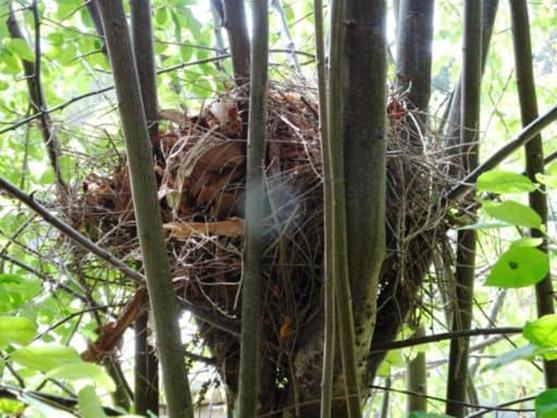
He
had put quite a lot of work into that mansion no doubt in the hope that Mrs
Possum would soon be moving in to join him. Over the years we have planted many
hundreds of useful edible type trees for them to dine off. We will continue
until the whole 25 acres is so covered. There will still be lots of feed for
the sheep under. More actually, counting the nutritious leaves and fruits which
tumble down and our sheep just love to vacuum up!
Not
the rubbishy native weeds other folks plant: gums and wattles, which are just
the rubbish that comes up as a result of aboriginal burning and denutrification
as nothing else will grow in phosphorus poor soil - appalling land management
practices. They knew no better. It is why there were only a few hundred
thousand of them in 1788 in a country which feeds nearer fifty million today,
on a fraction of the land!
They
had practically starved themselves out. It has been a lot of work to restore
the productivity of farmed Australian soils. Our aim has been to have dozens of
species of food trees producing at all times of the year. We have done the same
on previous farms. About ten years after we first began, it came to be called
'Permaculture'. Lots of native critters appreciate our efforts. They come from
miles around to our 'diner'.
So
unfortunately does Brer Fox. Last night he dined (as you can see) on Mr Possum.
I am deeply shattered by this. I will be (borrowing money if necessary to)
complete our vermin proof fence this autumn. That way we will never lose
another possum, nor another lamb either. These red menaces have been gnawing
their way through between a third and a half of every lamb born, lambs which
are actually worth a lot of money to us. In future they can go elsewhere for
their free-loading.
Most
of the time we have lived here we raised only rams on our home paddocks, so
there was not the pressing need to protect lambs here. Baiting nowadays would
kill many wandering pet dogs. Shooting would draw complaints. We will just
fence them all out, and mop up the rest with one or two carefully controlled
Maremmas which will likewise be contained when the fences are complete.
I
think it will be surprising what (native) critters return after the foxes can
no longer prey on them. Obviously first, lots of birds. We do love birds.The
ducks will once again be able to raise their large waddling clutches on the
farm dams. Quail will once again boom at dusk.
Before
the Myxomatosis epidemic in 1956 everywhere you went there were endless
bandicoots, pademelon wallabies, antechinus, infinite native jumping rats and
mice, native and tiger cats (quolls they call them now - they have even
forgotten there used to be a larger striped one!) - and, of course innumerable
rabbits.
When
'The Myxo' killed the rabbits there was a huge stench of dead and rotten meat
that lasted nearly a month. The odour was overpowering. We sincerely wished we
could take a 'holiday' from it. Something like Bergen Belsen it was. The foxes,
starved for anything else, ate them all out. To this day I have not seen a
bandicoot, a quoll or a pademelon in the wild - though sometimes I see sign of
them (bandicoots especially). They used to make these strange conical holes (with
their noses) when feeding. Unmistakable. My hope is that they will come back
when the predation ceases. They are back on my cousin's property at Paterson
where my great-great grandfather Thomas Westbury was sent out as a convict back
in 1828.
Poor
little guy:

PS:
You know it was a fox as they always eat from the head down. With such a
predilection for devouring brains you would think they might have evolved some
horrid disease such as Kuru which inflicted the people of Highland New Guinea
when they were cannibals - imagine a life form whose only means of transmission
was feasting on the brains of the dead! Life will certainly 'find a way'. Its
symptoms were not unlike motor neurone disease. You wish just such a nasty end
to a fox who does this.
Foxes
are however a beautiful life form which I admire very much much - as I also
loathe their abominable habits. What great survivors they are - and how clever.
I once watched one 'de-flea' itself by holding a stick in its mouth and walking
slowly into a dam until only the tip of its nose was out of the water but all
the fleas had climbed out onto the stick!
We
once hunted foxes out of a dead whale on Andersons Inlet with bloodhounds! What
a din and a stench that was. If you have never heard a bloodhound belling from
the stomach of a dead whale you have not lived! You can imagine 'Trusty' from
'Lady and the Tramp' pursuing the evil Reynard therein. Perhaps that is how he
lost his sense of smell! Dick Davies' 'Tracker' certainly did not. What a
mighty voice he had. 'Thunder' is also a popular name for bloodhounds!
Another
day we put the hounds into a large dryish dam - nothing but a patch of an acre
or so of cumbungi. There were an even dozen foxes in there, so many the
foxhounds could not sort them out at all. Only 'Tracker,' Dick's favourite old
bloodhound was up to the task.
Punctiliously
he followed the trail of each one out to its corpse in succession - we shot
them as they came out, you see. On this occasion I shot a pair of foxes
together, one with the right barrel of my father's old double barrel Breda
shotgun and one with the left. Tracker had been on the scent of only one of
them. He sniffed it peremptorily then went back for the last one.
It
must have taken him well-nigh ten minutes to untangle and chase its trail right
back to its corpse which had all along been lying not ten feet from the first
one he was on. He had an amazing nose, that dog. he could scent trail across
running water. I have sometimes seen him cross the Tarwin on a scent (a fox or
betimes a tiny delicate hog deer) that I would have thought would have been
carried far downstream by the current. He was the sire of my great old
Bloodhound, Belle.
Oh,
to be young again! Back then I got up on a Saturday morning in winter around
2:00am and drove over 200 kilometres to be eg on the Jordan River at 7:00am to
hunt sambar deer (after a walk in leading dogs of 7 km!). Often I would not be
home again until after midnight. Then I would be up again in the morning to
make my lunch and help Dick load the hounds etc and be off fox hunting around
Tarwin Lower at 8:00am Sunday.
Some
days Harpoon, my best foxhound would have his pads worn down to the flesh by
running all day. There were days he must have traveled nearly a hundred
kilometres on them. On a Sunday morning he would be so footsore he could hardly
drag himself out of his den. One morning I remember I felt sorry for him and
purposed to leave him home. He would have none of it. he rushed over our
electrified dog fence like a mountain torrent, exclaiming a couple of o loud
doggie 'Ouches' as he came!
He
was such a great blackberry dog. The bloodhounds were really too big and slow
for blackberry patches. Harpoon had no thought for personal safety. He went
through blackberry bushes like grease through a goose. in the winter time all
the fur on his muzzle was always quite worn away and bald.
For
many years I killed several hundred foxes. Like all deaths even theirs touched
me with some regret. One day years ago I walked up the creek on our property
into the 'Land for Wildlife' zone beyond. You can do this with impunity as the
owners never venture into their 'back paddocks'. The valley of over a thousand
acres behind us was subdivided years ago so that people could build houses on
the very top of the rim, then neglect the other 99% of their properties (save
for putting the compulsory 'virtue signalling' signs at their front gates).
In
the bottoms of the valley it is just a wilderness of weeds and vermin: tussock,
'Purple Top', blackberries, ragwort - you get the picture... Still, it was
quite beautiful to come upon a vixen's earth inhabited this spring morning by
her litter of kits playing together in the dappled sunlight. Such a beautiful
sight as they tumbled together in their joy and innocence. Much the way atomic
bombs are awesomely beautiful but wholly destructive, I guess.
Despite
my continuing war on foxes and my ongoing efforts to build a vermin-proof fence
around our entire property so that wildlife may flourish undisturbed by their 'ministrations,'
you should understand that I am not a 'conservationist'. No farmer is. Ask any
of the virtue signalers. We are all to a 'man' (even though better than half of
us are of the fairer sex) rapacious despoilers of the land. If you actually do anything
to improve the lot of wildlife by your own efforts and using your own money,
you are (by definition) not a conservationist.
To
be a real conservationist you need first to 'have your heart in the right
place'. Ergo, no hunter could possibly be. Despite the fact that most of the
'duck swamps' in Victoria were donated to the State (and maintained) by Field
and Game (and like) members - & etc. Second, you need to seek the warm
inner glow of conniving that it is the Government which spends other people's
money (and effort) on your pet projects, though well over 90% of this money
goes to pay an army of uncivil servants - who do absolutely nothing! And will
not.
Therefore
those who advocate for vast, unmanaged 'National Parks' where weeds and vermin
may proliferate and wildfires episodically destroy everything, (yet everyone is
excluded from) are 'true conservationists. If you would rather see no national
parks, as I would, but a more sensible 'conservation' strategy (on public and
private land - but without property confiscation) which might have really positive
outcomes for real creatures (and plants), and maybe see people getting a
livelihood too - and making a profit, (say from grazing, logging, mining,
tourism etc) then naturally you are just base, and beneath contempt. Cheers,
Steve.
See
Also:
http://www.theultralighthiker.com/vermin-proof-fence/
http://www.theultralighthiker.com/water-babies/
http://www.theultralighthiker.com/the-wildlife-seems-to-get-wilder-everyday/
http://www.theultralighthiker.com/white-headed-pigeon/
http://www.theultralighthiker.com/three-stags/
20/03/2018: Cheap Insulated Inflatable Pad:
Klymit’s Ultralight V Sleeping Pad is on Massdrop this morning for US63.74
delivered to Australia ($64.34 delivered to USA address). They have an R rating
of 4.4 – enough for the coldest night. You can also pick up one of their
excellent pillows for an extra US15. I would go for the 5 foot model (150 cm –
440 grams) which will just fit me (I am 5’7” or thereabouts). So long as your
feet don’t touch the ground they won’t be cold – it is a waste carrying a pad
longer than yourself, and only makes the pad less comfortable actually. If you
miss out here you can get one direct from Klymit for US$119.95. This one is 6
foot long and weighs 431 grams (same R rating) https://www.klymit.com/insulated-ultralite-sl-sleeping-pad.html

19/03/2018: K-Mono Cut: I am looking for new
lightweight raincoats for each of us. I came across this wonderful innovative
cut on Montbell’s Versalite rain jacket (Womens Medium 142 grams, Mens 168
grams A$190). This is a really genius idea.

‘Cut
from a single piece of fabric, K-MONO CUT drastically reduces the amount of
seam lines eliminating areas where water can penetrate, promoting the jacket to
be lighter and durable. This innovative pattern is based on Montbell's
philosophy of "Ki-no-bi" which is a Japanese term for "Function
is Beauty".
<
WATERPROOF > Reducing the amount of
seam lines eliminates areas where water can penetrate the jacket.
< LIGHTWEIGHT > Minimizing
the amount of seam lines and tapes reduce the jacket's final weight.
< DURABILITY > Limiting the
amount of seam lines around the stressing shoulders and hips improve the
jacket's durability.'
PS:
The raincoat looks pretty hard to beat too:
17/03/2018: Nitecore Continues to Push the Boundaries:
They have a variety of ultralight rechargeable torches, as well as this excellent charger/powerbank which is
all you need to charge them (and anything else!) I already wrote about their
remarkable Tube torch here and here. Now they have much brighter models
available such as the:
Thumb (85
lumens + 25 grams with rotatable head - so easy to slip under a head band)

Tip (360 lumens 23.5 grams):
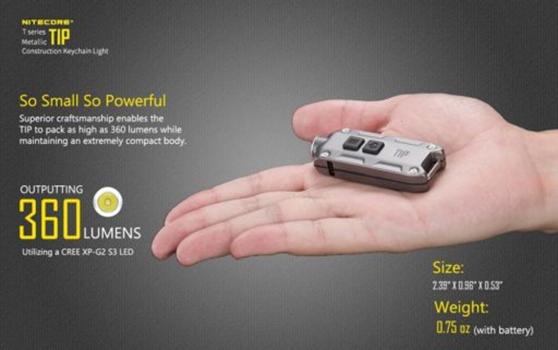
Tini (380 lumens 13.5 grams!):

and
this remarkable head torch the:
NU25 rechargeable headlamp - 360
lumens, 28 grams):
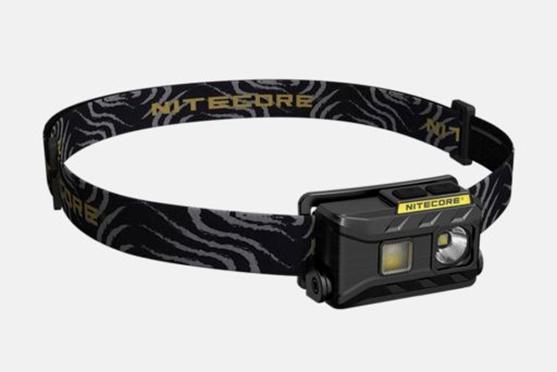
How
good is that?
See
Also:
http://www.theultralighthiker.com/ultralight-power-bank-nitecore-chargers/
http://www.theultralighthiker.com/smallest-rechargeable-flashlight/
http://www.theultralighthiker.com/11-gram-rechargeable-head-torch/
15/03/2018: How few of us know how to set up our own
TVs: http://www.coyoteblog.com/coyote_blog/2018/03/setting-up-your-tv-correctly.html
13/03/2018: DIY Simple Hearing Aid Safety Clip:
This is the simplest and cheapest way to make sure you don't lose your hearing
aids on a hiking or canoeing trip (such as this). Works with any BTE (Behind
the ear) type hearing aid. Bulldog clip, (dyneema) string, two simple slip
knots. Attach clip to back of shirt collar. Cost: cents. Cheers.

3
grams is not a bad (weight) spend to save yourself a few thousand dollars!
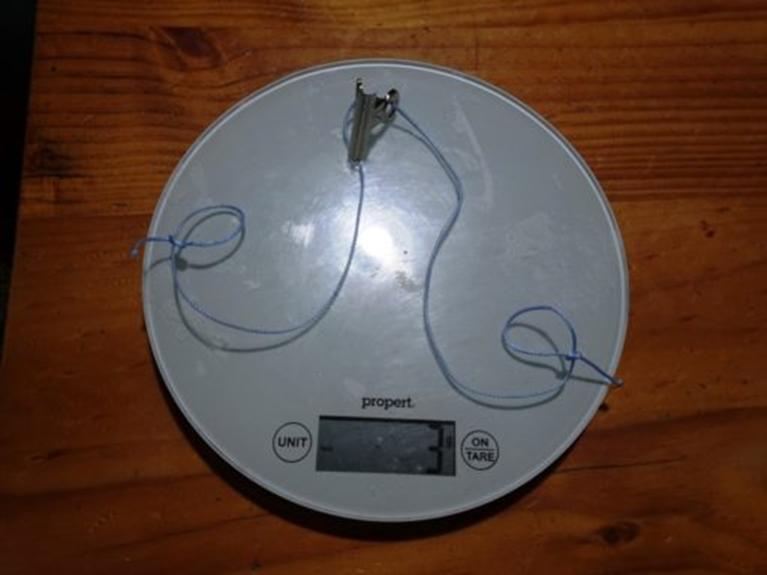
See
Also:
http://www.theultralighthiker.com/waterproof-hearing-aids/
http://www.theultralighthiker.com/never-lose-your-hearing-aids-again/
http://www.theultralighthiker.com/securing-hearing-aids/
http://www.theultralighthiker.com/zenni-the-hearing-company/
http://www.theultralighthiker.com/eyeque-personal-vision-tracker/
http://www.theultralighthiker.com/ultralight-glasses-case/
http://www.theultralighthiker.com/dyneema-braid/
http://www.theultralighthiker.com/the-ultralight-fisherman/
http://www.theultralighthiker.com/60-diy-ultralight-hiker-ideas/
13/03/2018: I have long
thought that SETI may be listening 'wrong' and that's why there always seems to be no-one home (an
improbability considering the vastness of the universe; ie if 'intelligent'
life arose here, it is unlikely that it is not quite common elsewhere). Now we
can see that 'quantum entanglement' has speeds of at least 10,000c which makes
a return message from Alpha Centauri about 7 hours by my calculations. In the
windjammer days a return message from ‘Blighty’ took 3+ months. At the higher
measured value (140,000c) a return message would take just 30 minutes, so we
could have meaningful dialogue with folks a very long way off indeed! ET folks
out there are unlikely to be crawling along with communication using radio
waves at 1c when they can use something that zips along at 140,000c. I suspect
the same fate awaits the NBN! http://www.gizmag.com/quantum-entanglement-speed-10000-faster-light/26587/
12/03/2018: Things we don’t know about water. Move
over Kurt Vonnegutt. Here comes Ice VII – Wow! https://wattsupwiththat.com/2018/03/10/weird-stuff-type-vii-water-ice-found-inside-diamonds/
11/03/2018: Only the Moon and Me: Packrafting
the Thomson River, Gippsland #1: You start this trip just
downstream of the historic Brunton's Bridge where the road of the same name
crosses the river on its way to Happy-Go-Lucky and Walhalla. This road in turn
is reached from the Cowarr-Erica Rd after leaving a vehicle at the picnic and
camping area at Cowwarr Weir. For a longer trip (add approximately 3-4 hours
paddling time) you can start at Coopers Creek which can be accessed off the
Tyers-Rawson Rd a couple of kilometres before the Walhalla turn-0ff. I would
allow three days for the trip from Coopers Creek (better four) and two days
from Bruntons (better three). Pick your weather.
It
is not a trip for novices. A number of people have lost their lives in this
section of river over the years, and emergency services have had to conduct
many searches. You need to be competent in Grade 2 and 3 rapids. You also need
to watch the river height carefully.
The
river is probably safest at a Gauge Height at Coopers Creek of about .3
of a metre, though it can be canoed at .2 (I have), though you would have to
walk a dozen or so pebble races during the course of two days. This trip it was
at .25. I had to get out of the boat due to insufficient water only once. I
have done the trip at a gauge height of .5 metre a number of times. At this
height the river is really tearing along particularly in the gorge, and some of
the larger rapids are quit challenging. You need to be an expert to canoe the river
above this height. I have not and would not.
In
this post I want to illustrate how to safely canoe this section of river over a
couple of warm summer days. The most dangerous rapids can all be portaged, but
the Gorge cannot be avoided - and it can be quite dangerous in high water.
Bruntons
Bridge:
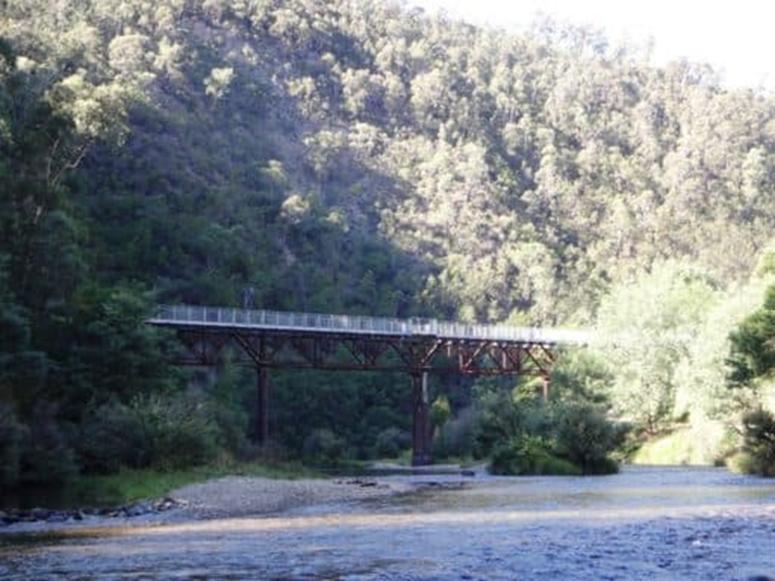
All
set to go.
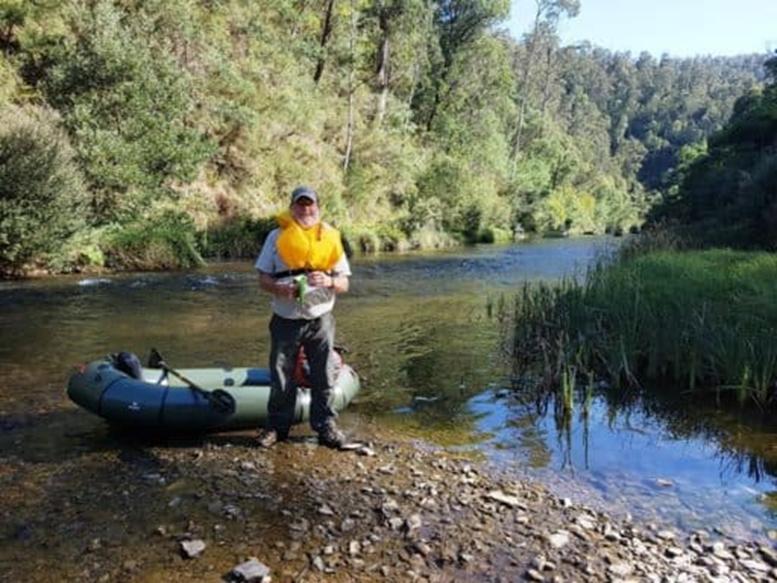
Most
of the river consists of long, tranquil deep leads such as these interspersed
with Grade 1 rapids and pebble races.
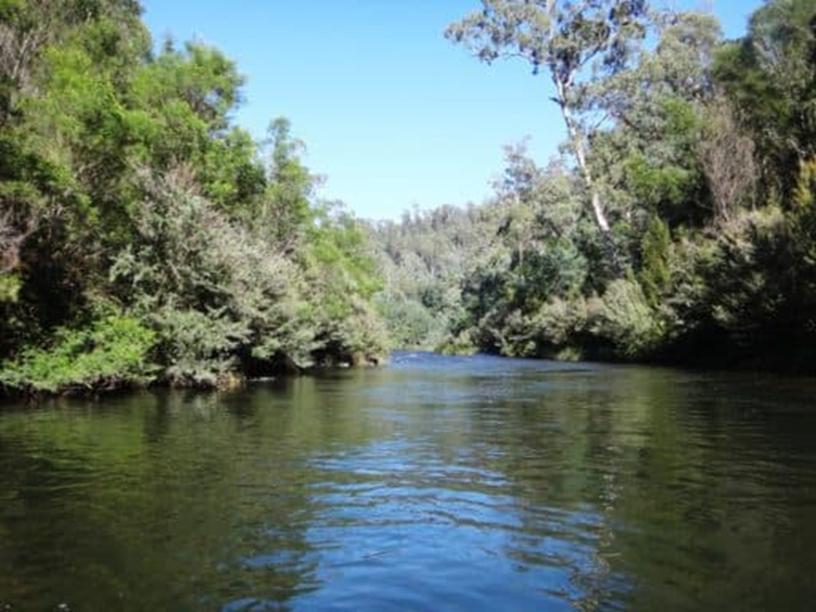
The
river starts out deceptively easily.
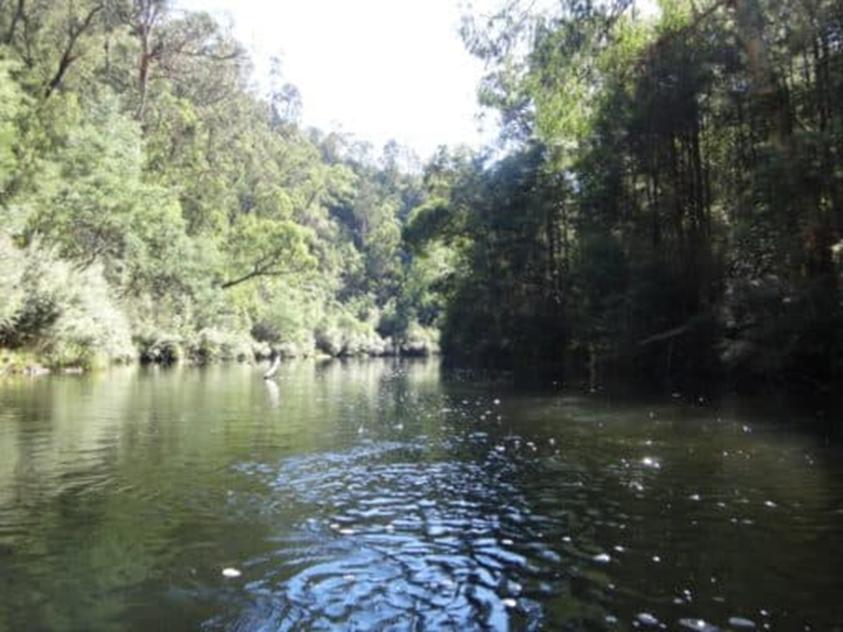
This
early section is a good time to troll for trout if you have an esky bag to keep
them in for tea. I usually dine on trout when canoeing this river.
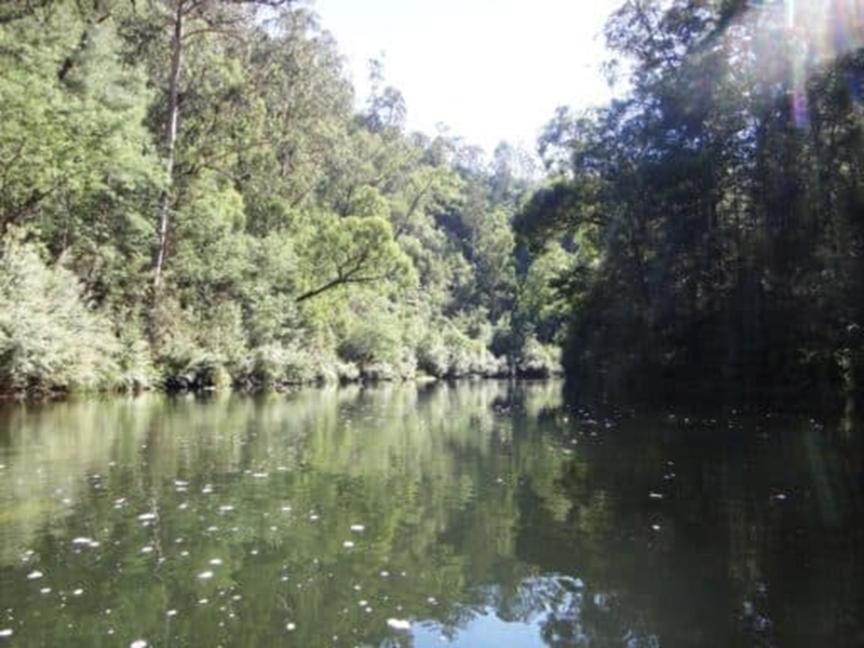
An
entertaining little drop.
There
is a car camp about 3/4 of an hour down the river on the right hand bank. It is
now the only spot you can access the river by vehicle, though not so long ago
there used to be several. You will see some wooden steps leading up to it.
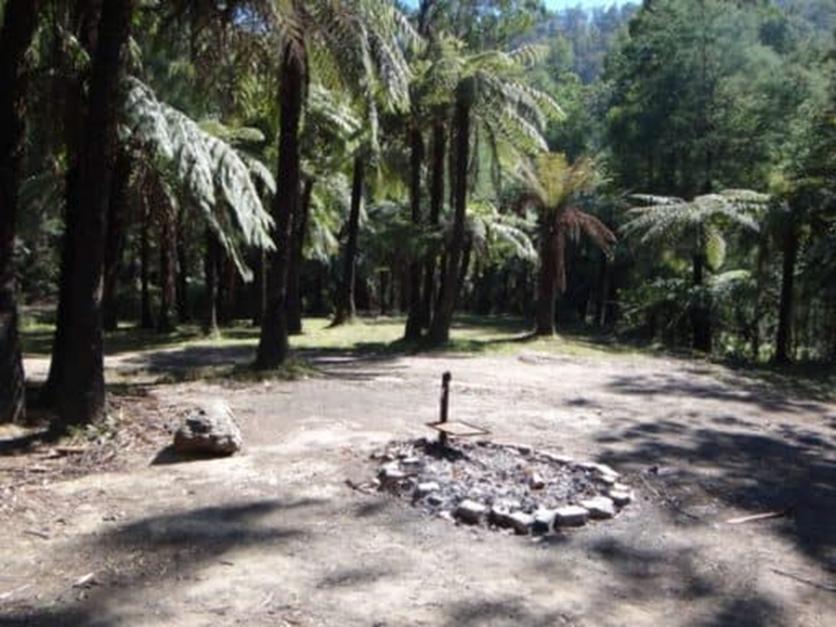
Another
long dolorous section. I used often to see deer along here particularly on the
left hand bank.
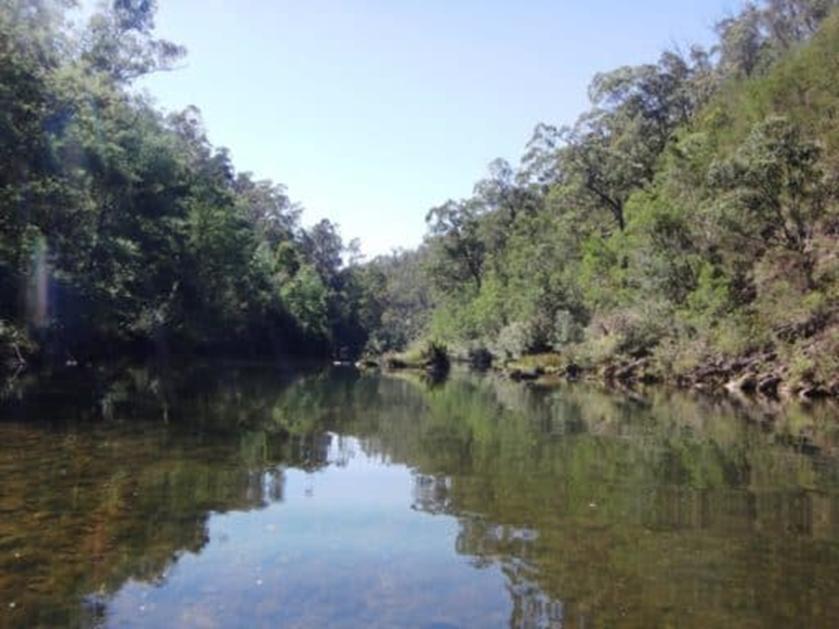
There
are a few Grade 2 rapids however. This one would be quite challenging if there
was a bit more water.
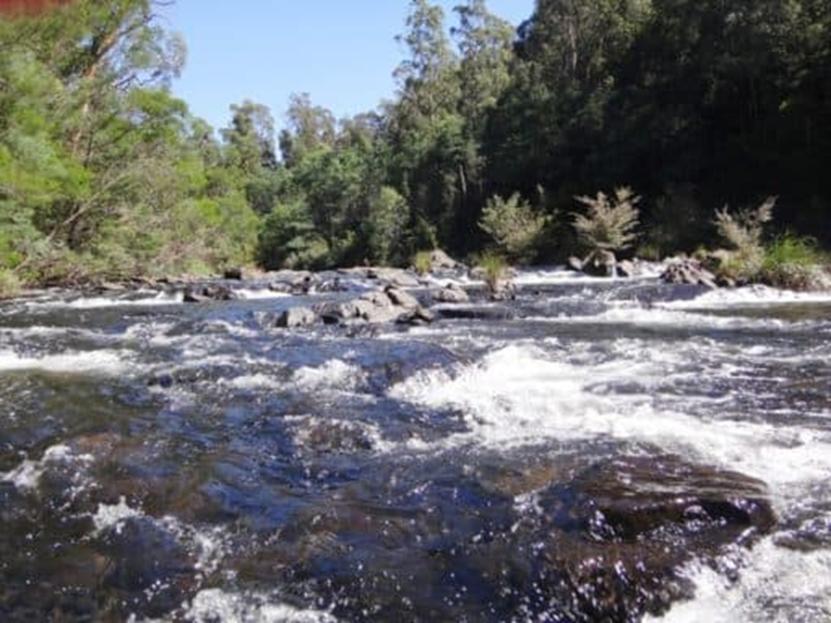
A
memento of earlier times.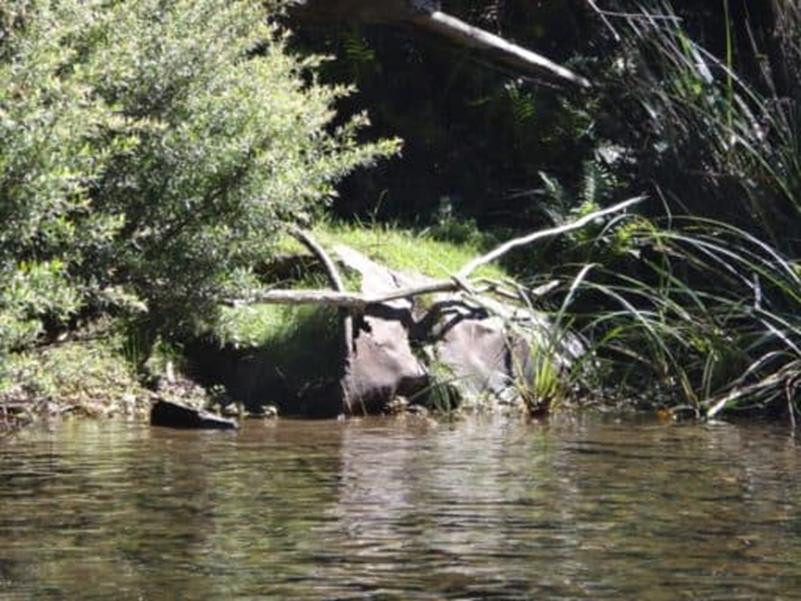
Marble
Quarry. This spot is where a gully flows into the river on the right hand side
just above (West of) the C22.1 (Marble Quarry) track. There used to be a
(marked) walking track up to teh road above from this spot. You could go ofr a
(tough) stroill and check out the interesting old pack track which led off to
the marble quarry itself - on the right hand side about fifty metres before the
end of the track. It slopes down and up into the gully below.
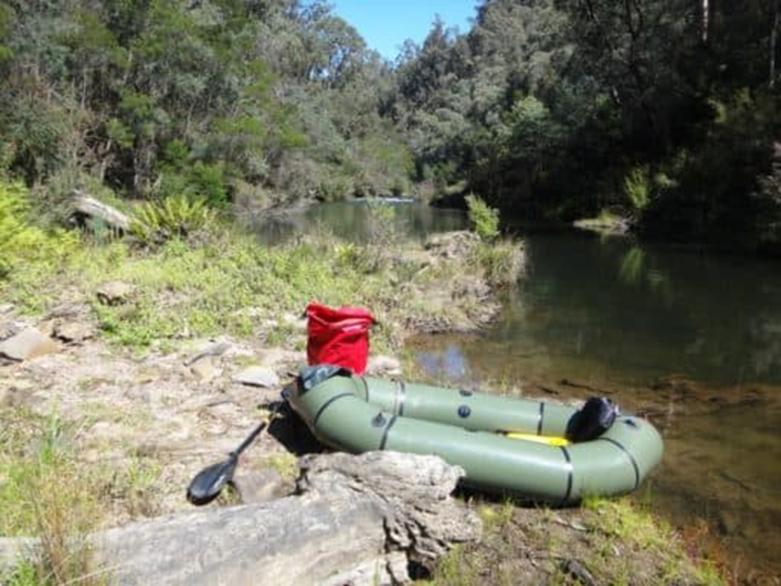
There
used to be a vehicle track to this pot down the ridge off the B3 track to a
gold mine here, I guess in the 70s. The track is pretty overgrown today but
could be accessed on foot or by motorcycle perhaps.

It
led to the mining camp - a lovely peaceful spot just twenty yards from a great
swimming hole on the river.
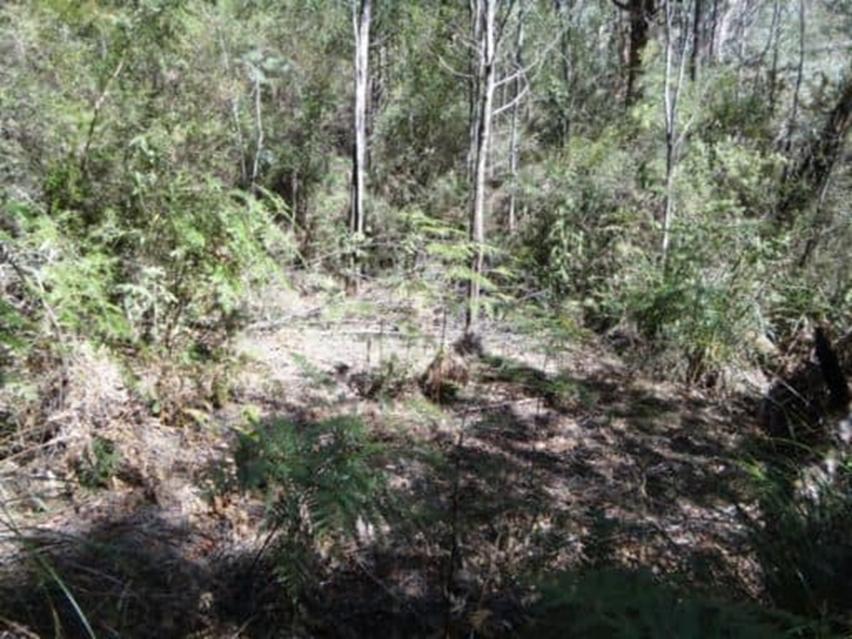
The
first rapid downstream from here can be quite dangerous. You can portage it on
either bank. As you can see it has a large boulder right in the middle at the
bottom which has turned many people out, including me.
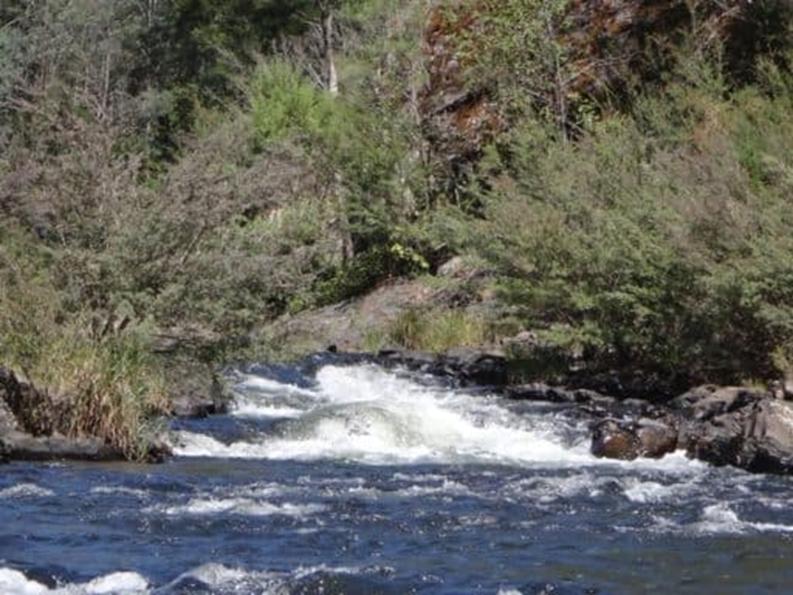
There
are many tranquil camping spots along the river often under the shade of these
beautiful cottonwood poplars which are such a feature of the river - and its
history.
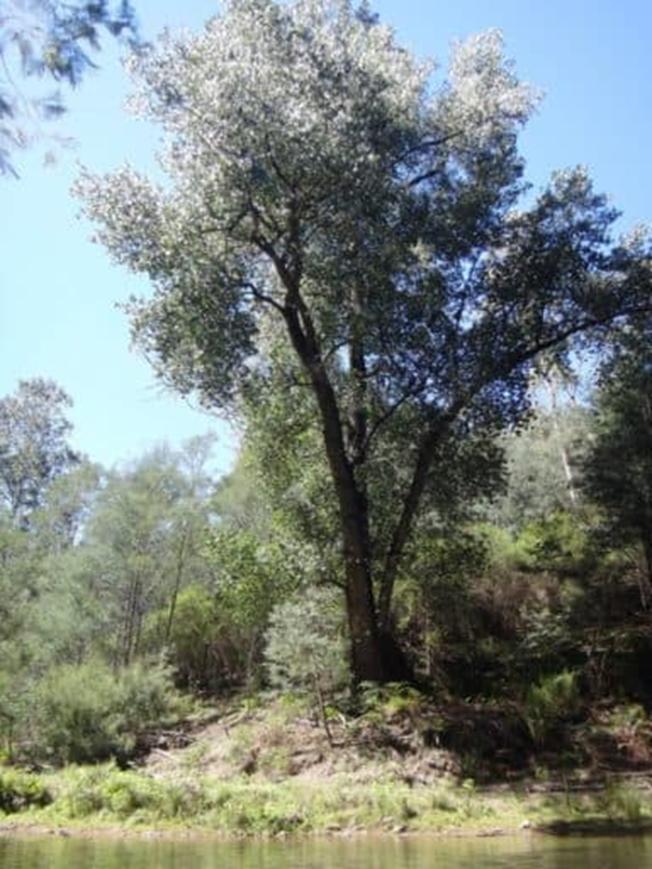
A
grassy spot at the bottom of Lammers Gully on the left.

The
river slopes down perceptibly to the Deep Creek confluence.

With
a few pleasant ripples along the way.

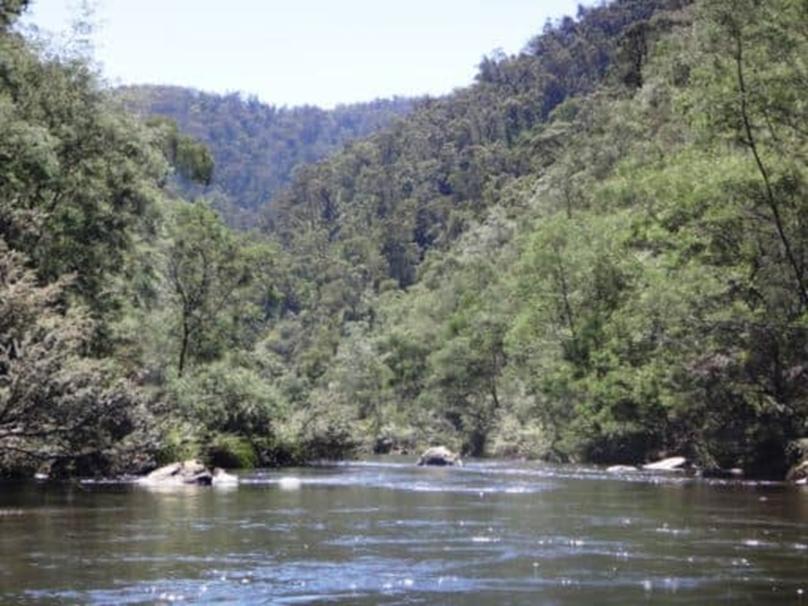
Lots
of folk attempt to camp at the mouth of Deep Creek. It is not really flay
enough for me, but it is a spot which holds many memories for me. I used to
hunt Deep Creek (with hounds) many years ago. I can still visualise Harpoon and
Belle bailing a large stag for me only metres upstream from this spot.
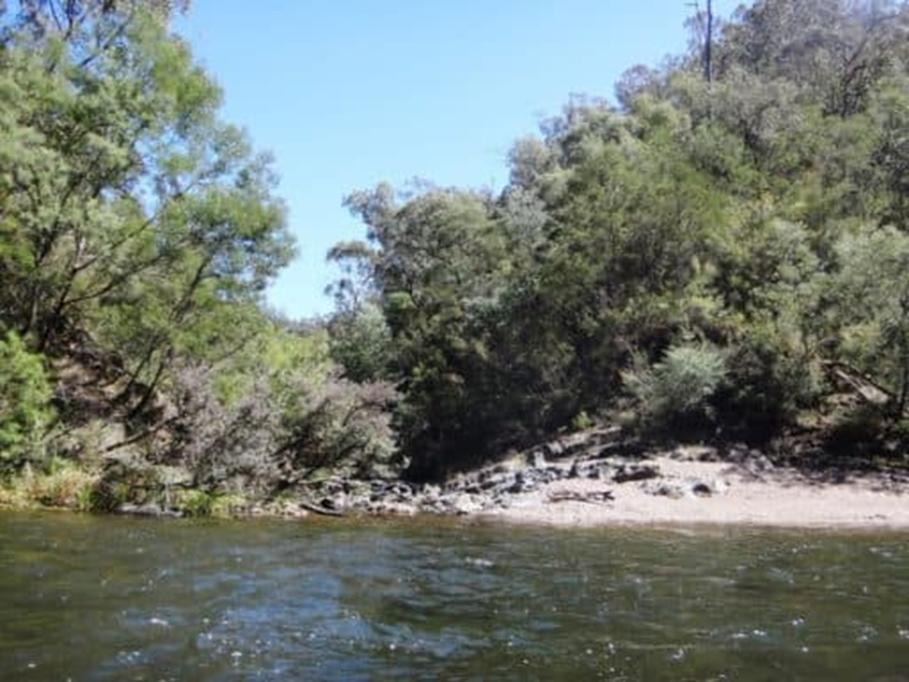
I
always stop here for a bite to eat anyway.

You
can wade up Deep Creek for miles as I have started to do here.. There are
plenty of small trout - and blackfish in the deeper pools.
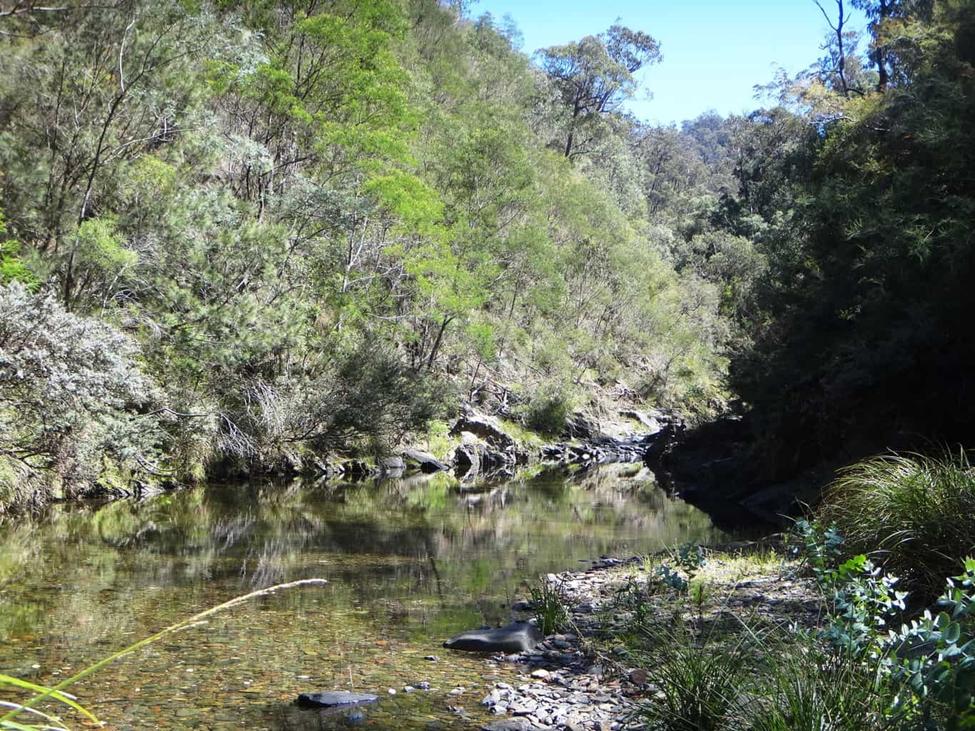
After
Deep Creek the river runs noticeable downhill for kilometres. There are two
sets of islands in the river. Sometimes deer camp on them. I have startled them
there in my canoe, and once on foot. On that occasion I managed to blunder
right into the midst of at least a dozen sleeping deer. They erupted in such a
cacophony of action and alarm that I was quite nonplussed as to which way to
point my rifle so that they all made off in very direction quite safely!
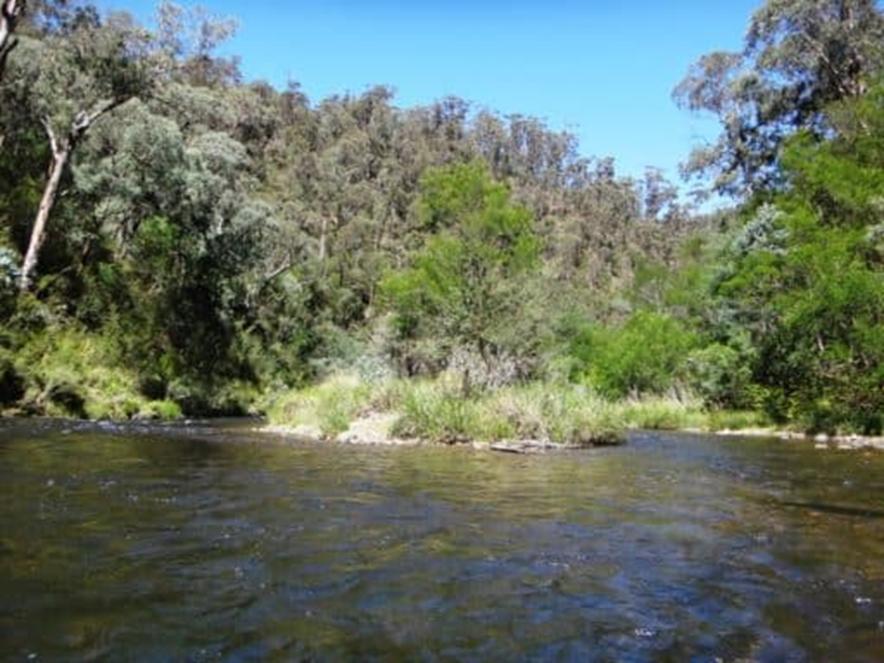
There
are several good camps along here. If you plan to camp before the Gorge, you
should stop here. good trout for your supper await a fly cast on the waters.
You can see my ( alas, late) friend Steve Cleaver catch one or two such in this
video of our trip on the river in 2006. We
were so young - was it so long ago? Trout 15-20 minutes in.

Lots
of these little guys along the river.

And
a rather poor shot of a fox - practically the first fox I have seen in the bush
in over thirty years hunting etc. They are usually so elusive in cover.
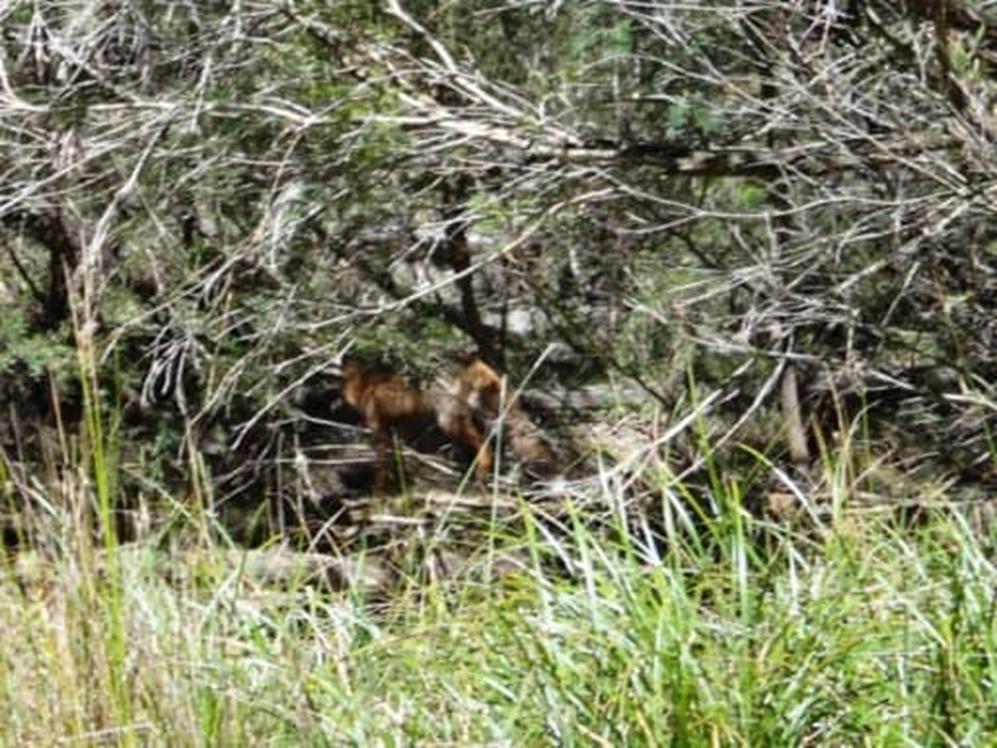
After
the second set of islands,
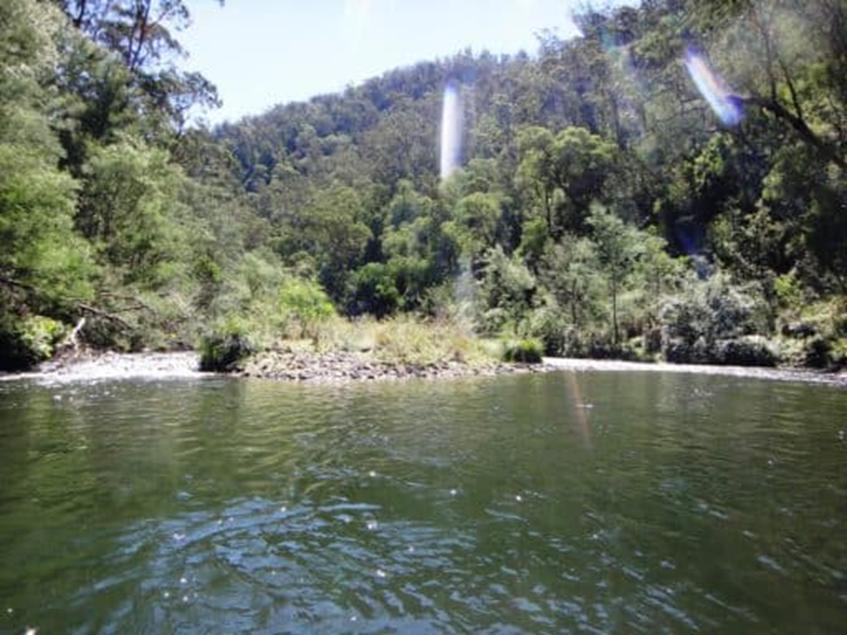
Look
out for a cottonwood tree with a sign on it announcing that you are half-way
(doesn't seem like it to me) and that this uncampable spot is the
designated campsite on the 'Thomson River Canoe Trail - there may still be a
few DSE brochures about it in their offices. i doubt they have done any work on
it since it was published at least thirty years ago!.
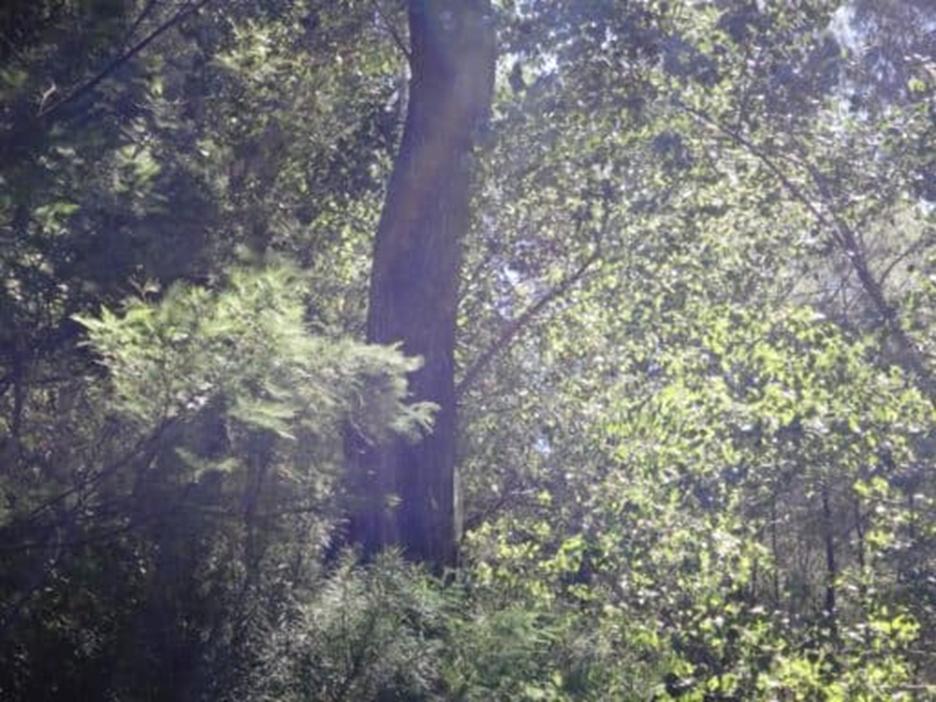
This
spot should serve as a warning: if you are going to camp before
the Gorge, do so now. There is one small spot on the left
bank. Here it is:
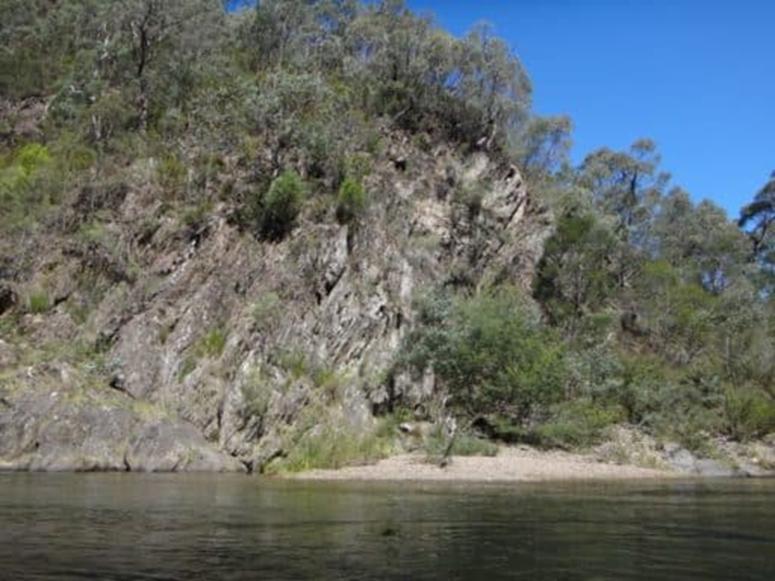
The
Gorge is committing, and takes some time. particularly if you fall out a few
times, as it can be quite difficult to get back into your boat in high water.
It also comes upon you unexpectedly. At the end of a deep section there is this
gully facing you (photo below). The Gorge begins just around the corner to the
left. I suggest you check out the first rapid from the left bank. It is a
doozy! You can portage it on the right side.

Here
it is (looking upstream). After a rough sort of chute on the left hand side
with many boulders there is an abrupt turn to the right. Lots of folks will
empty their boats again here.
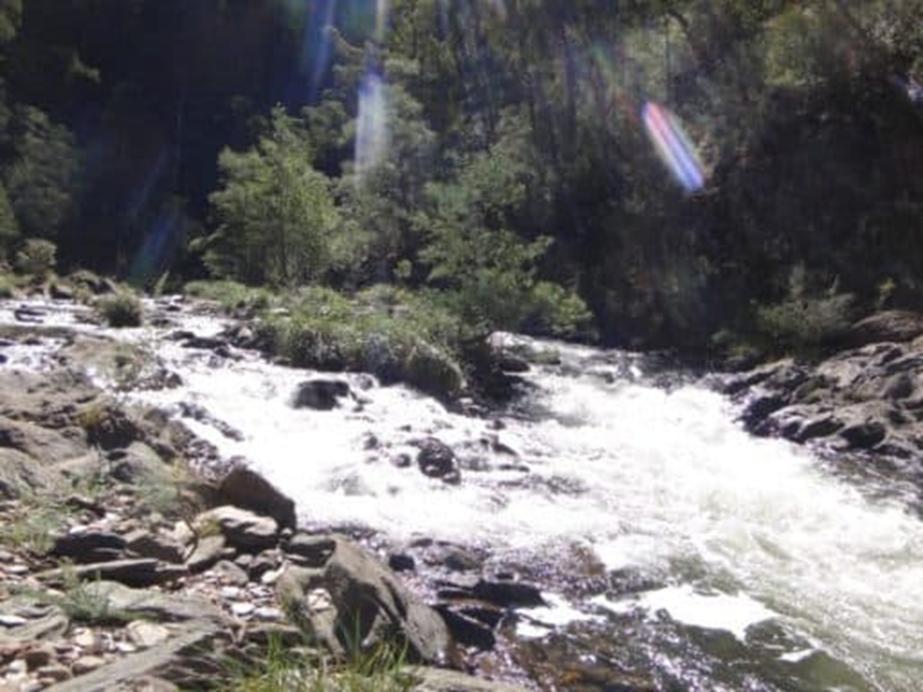
And
off we go: 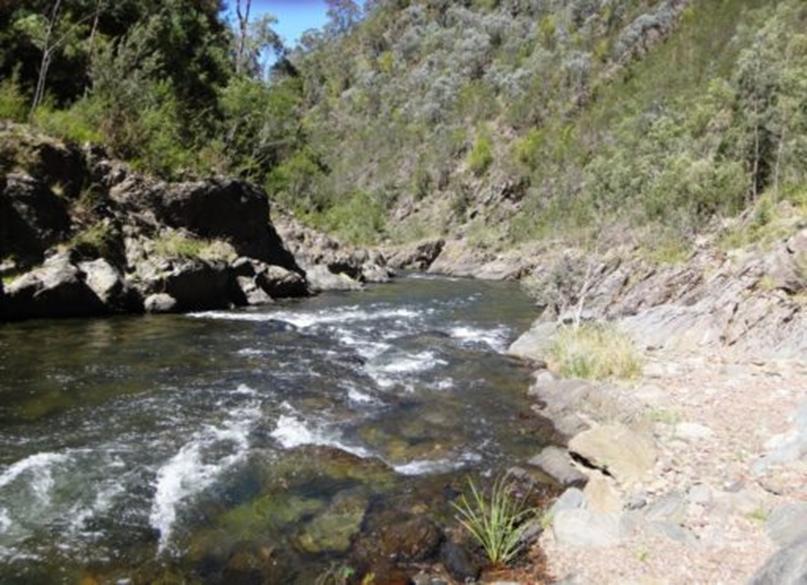
There
are quite a number of entertaining little (and big) drops in the Gorge.
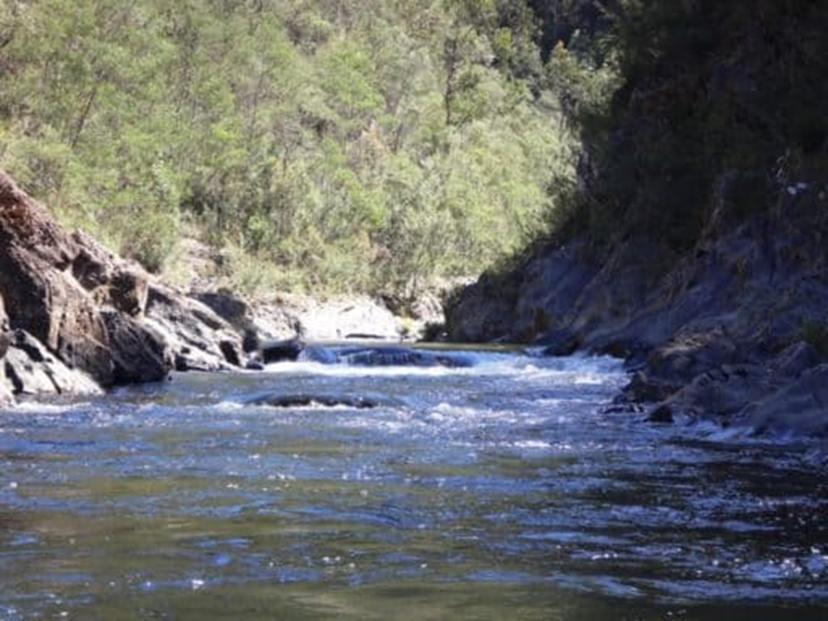
And
long, fast deep sections.
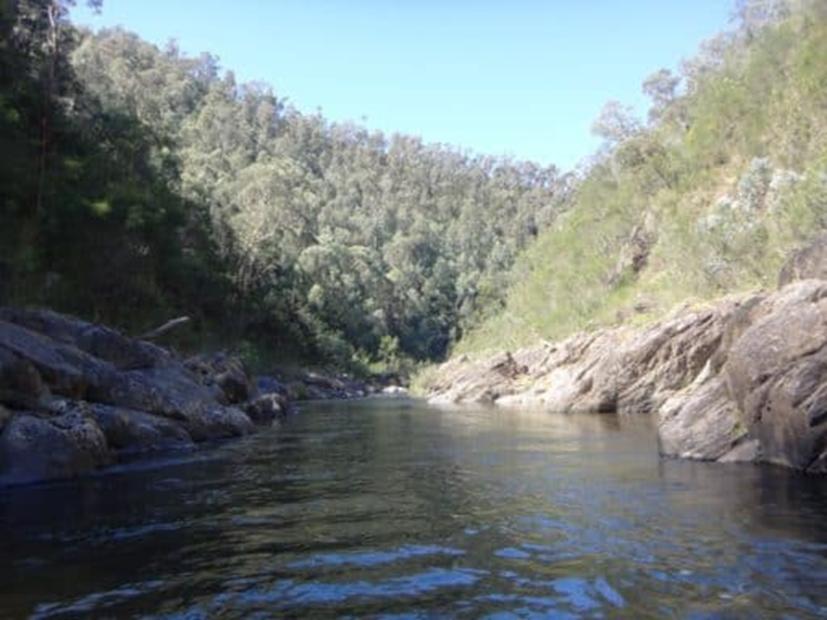
This
one would tip you out if you chose the wrong side.
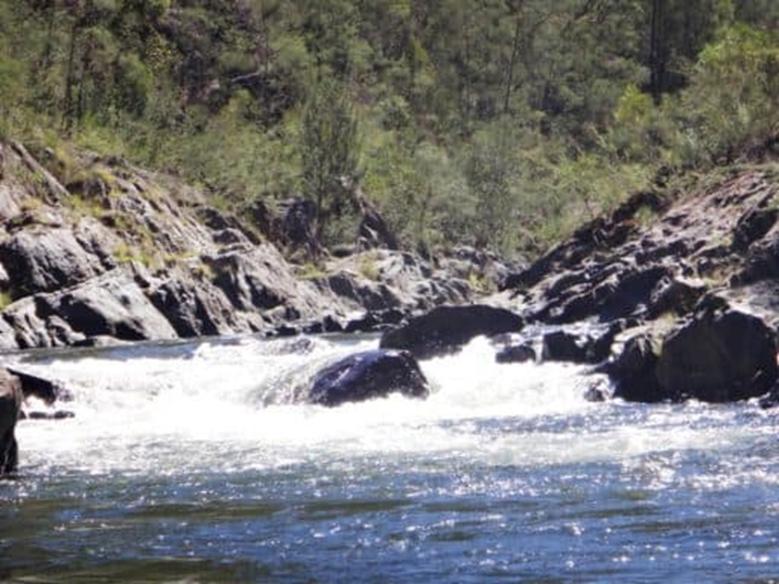
Another
one:
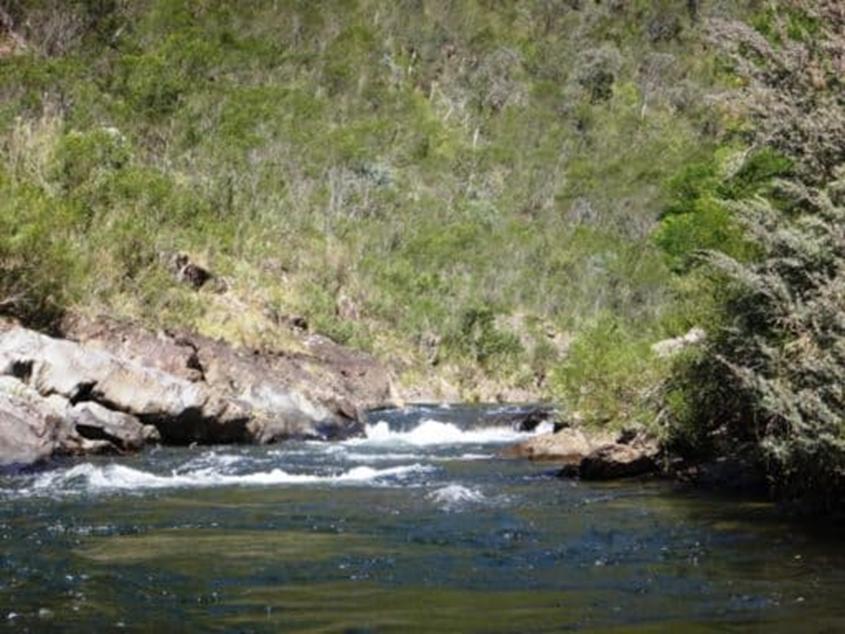
And
another. If you come out it can be difficult to empty your boat and get back
in, but there usually are shallow places or tiny miniature beaches between
drops (at lower heights). Sometimes though you might be in for a bit of a swim.
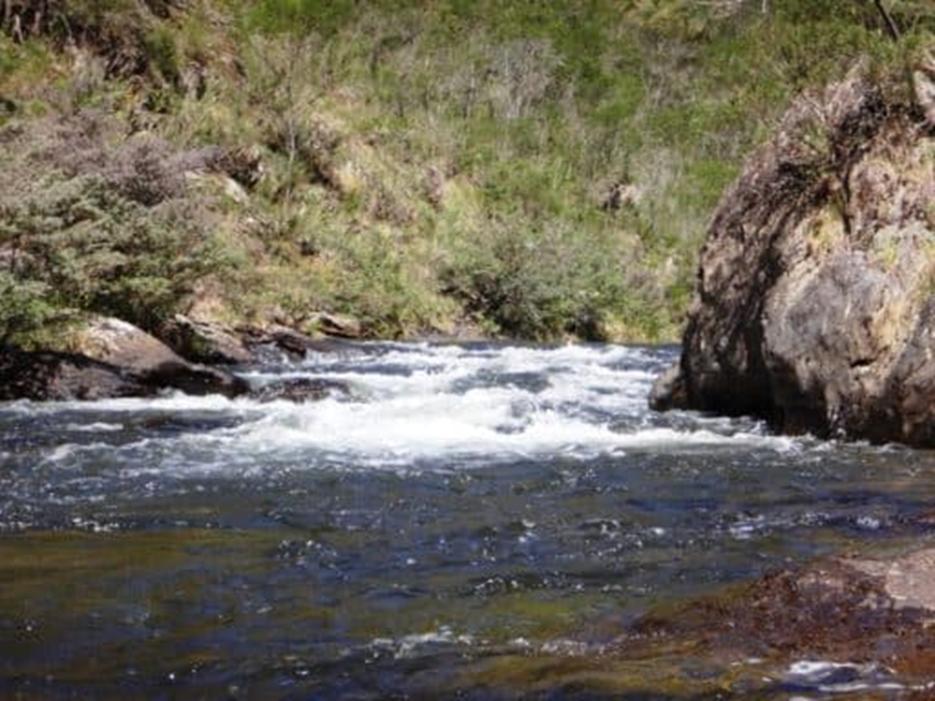
See
that shallowish spot on the right. That might be as good as it gets - so don't
fall out. This is just one of the reasons why I say the river is not for
novices.
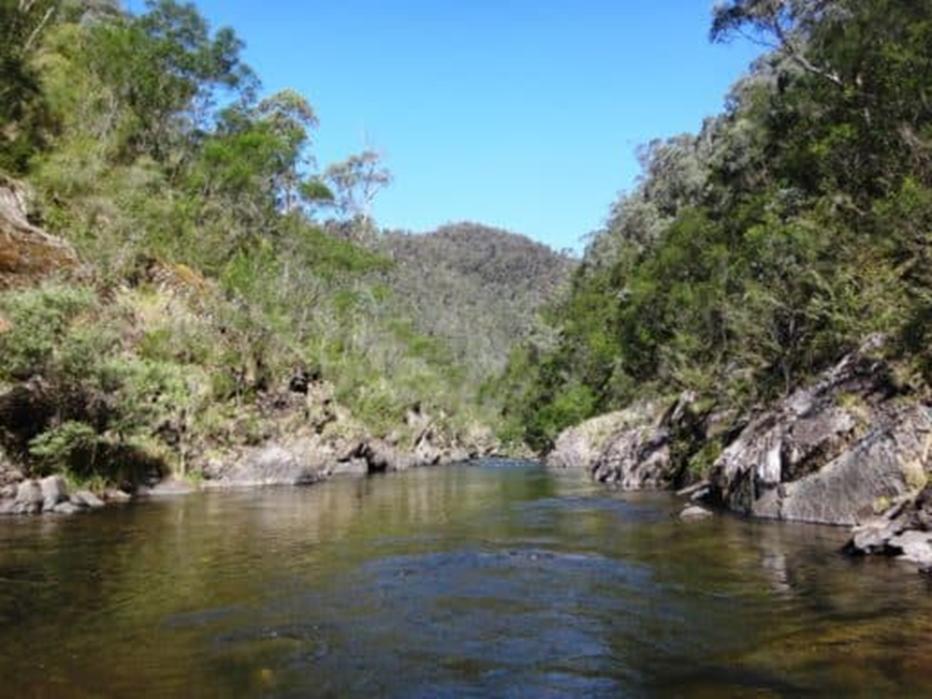
About
half way down there is this amazing little beach on the right hand side with a
fabulous swimming (and fishing) hole. If you are a small party you could camp
here.
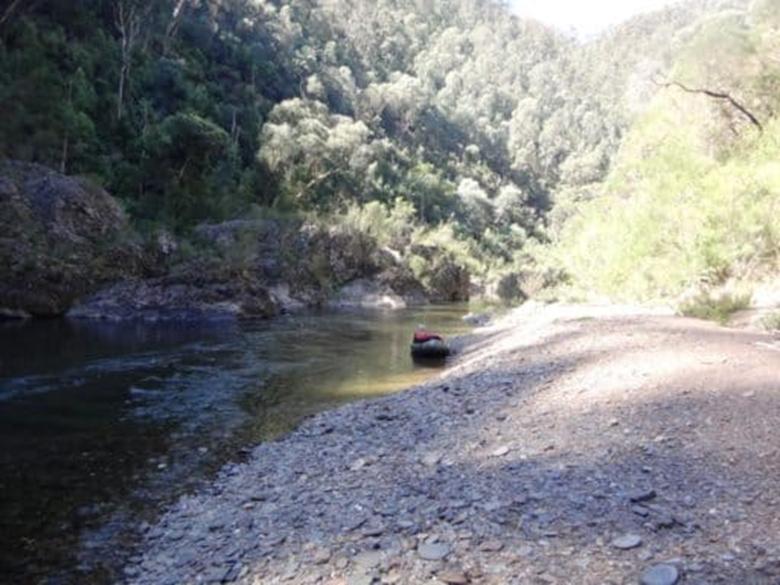
This
one would be tricky.
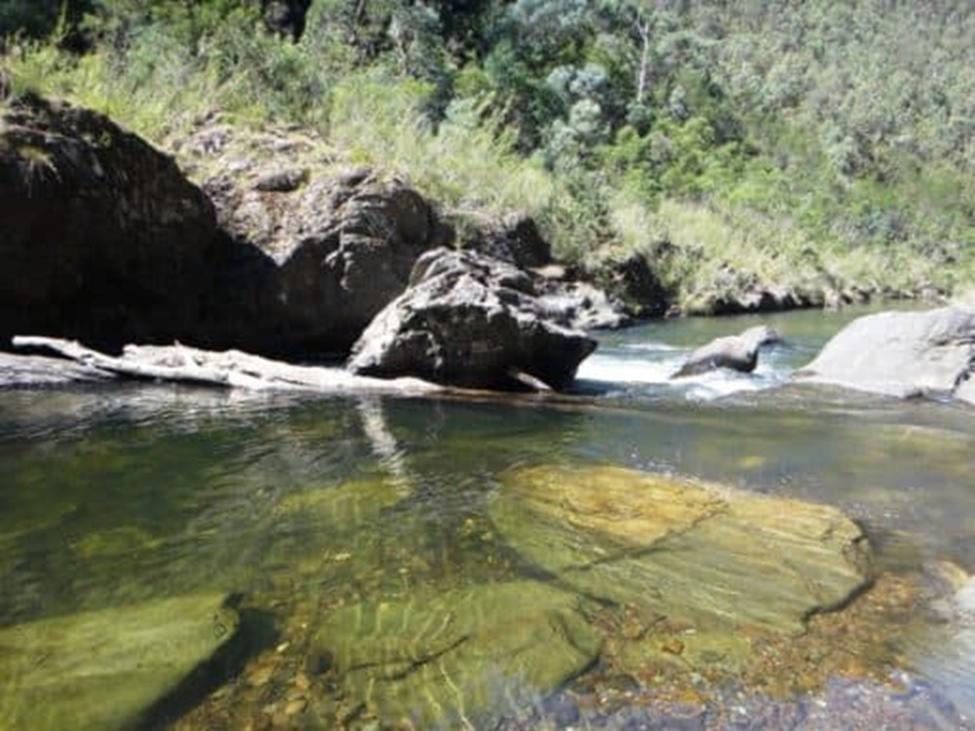
And
this:
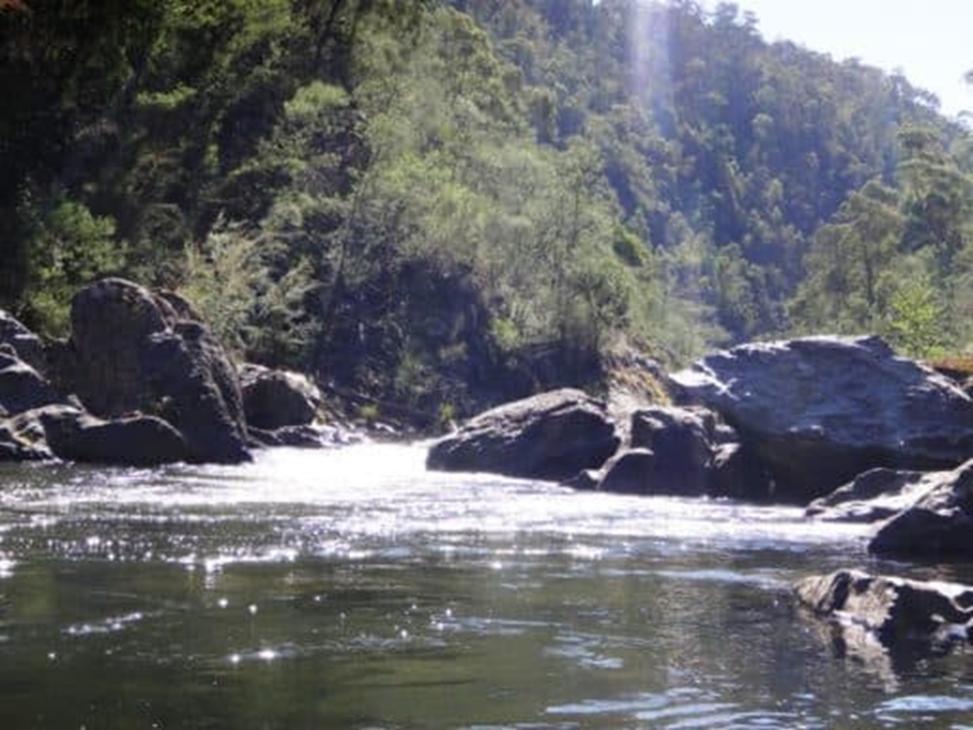
There
is a drop near the end with a log-jam in it. Forgot to take a photo. You will
have to portage it on the right hand side. After that, the river settles down a
bit.
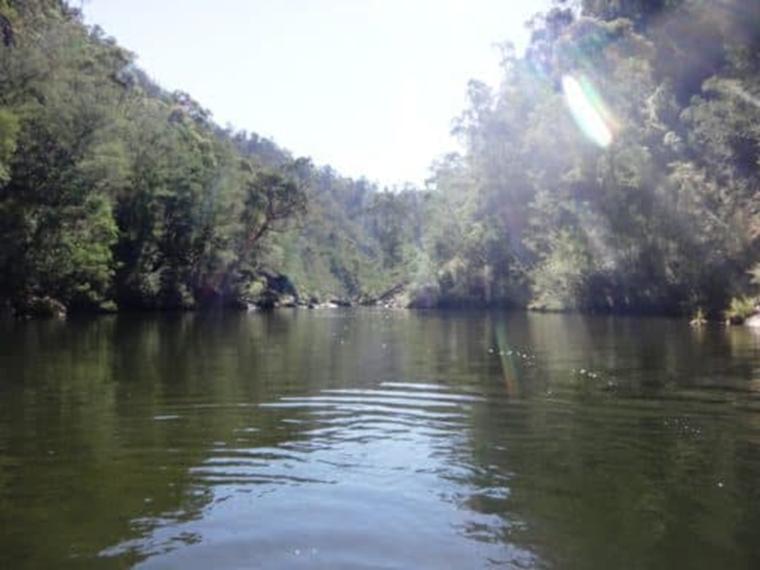
You
could also camp here (one tent anyway) on the left bank. You would have plenty
of firewood at least.
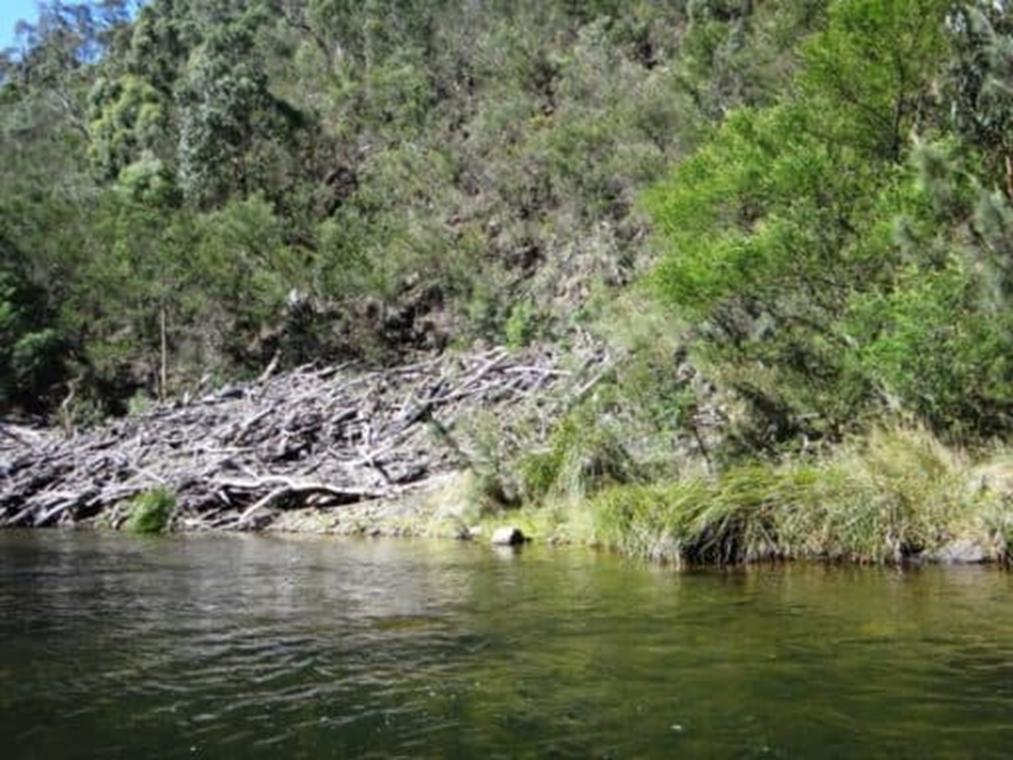
This
spot pretty much at the end of the Gorge on the left hand side is chosen by
many.

I
have camped here several times. There is a fine pool for fishing/swimming. i
thought I would travel on a bit further as I did not want company (unlikely
though). it has happened to me before however.
I
was canoeing the river with my friend, Brett irving. We had set up camp for the
night and were enjoying a few cold light ales and a yarn in the westering
sun. I guess no more than half an hour before full dark. We had a small fire
going. Idyllic really. Along came half a dozen drunken, callow shirtless youths
on sit-on-top canoes. Their 'leader' was convinced the weir was just around the
corner and would not accept our advice that it was over four hours away - and
impossible to reach in the dark. Some wanted to stay with us. We put an abrupt
stop to that.
I
gave them a cigarette lighter with the advice that they should stop at the
first spot with lots of wood and gather as much as they could as it would be a
very cold night without a fire. It is particularly cool in the Thomson Gorge.
Well they sailed on foolishly until dark stopped them, and then lit a miserable
little fire whose light was too feeble to reveal to them a thousand tonnes of
firewood less that fifty metres away! We could hear them all night yelling at
each other and having bouts of fisticuffs. Is it any wonder we were not eager
to have them join us?

On
this occasion I canoed on for another half an hour or so until I found another
really nice spot on the left bank. No-one had camped here. There was lots of
wood, though not cold enough for me to have a fire.
Her
are some very amateur selfies of me enjoying myself before my Pocket Poncho Tent.
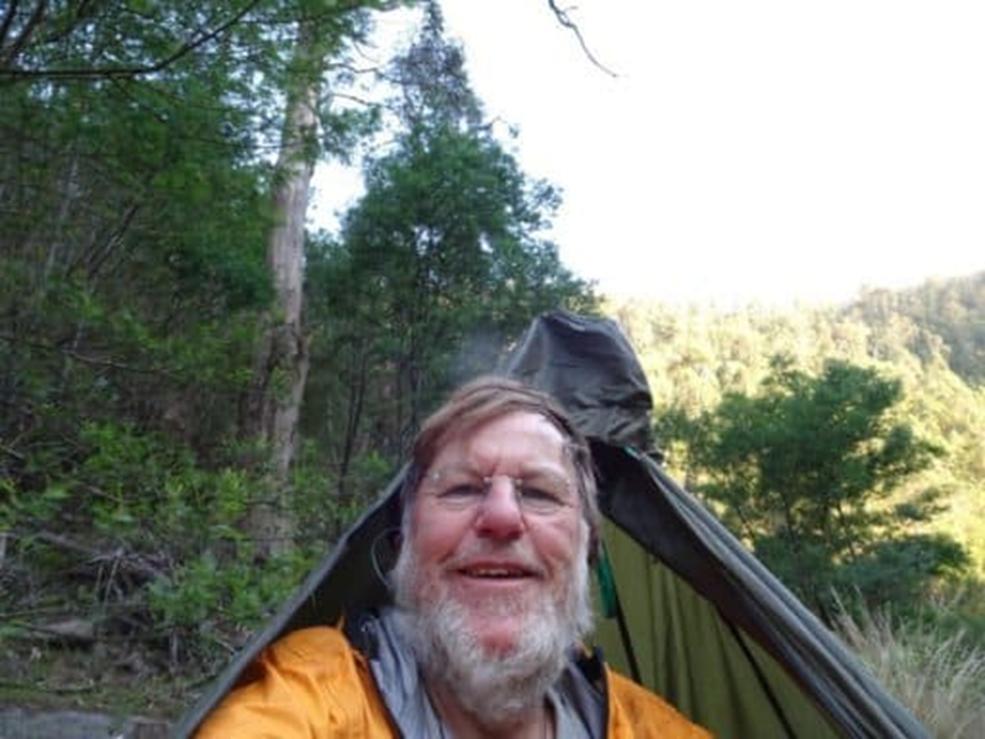
I
will get better at these selfies I promise!
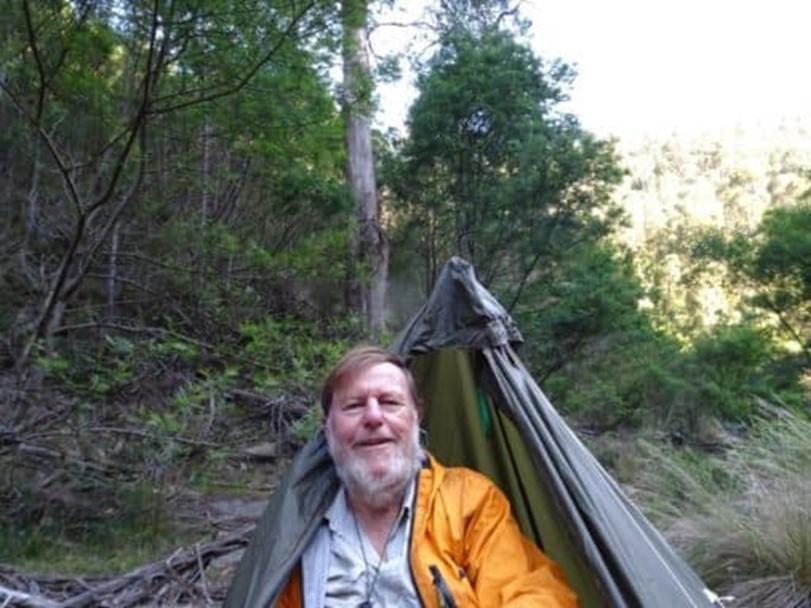
I
had this delightful spot to myself all night - no company but the moon!
Delightful! How many such nights I have enjoyed I hardly dare imagine. I am
greedy and hope there will yet be many more, even at just shy of seventy.
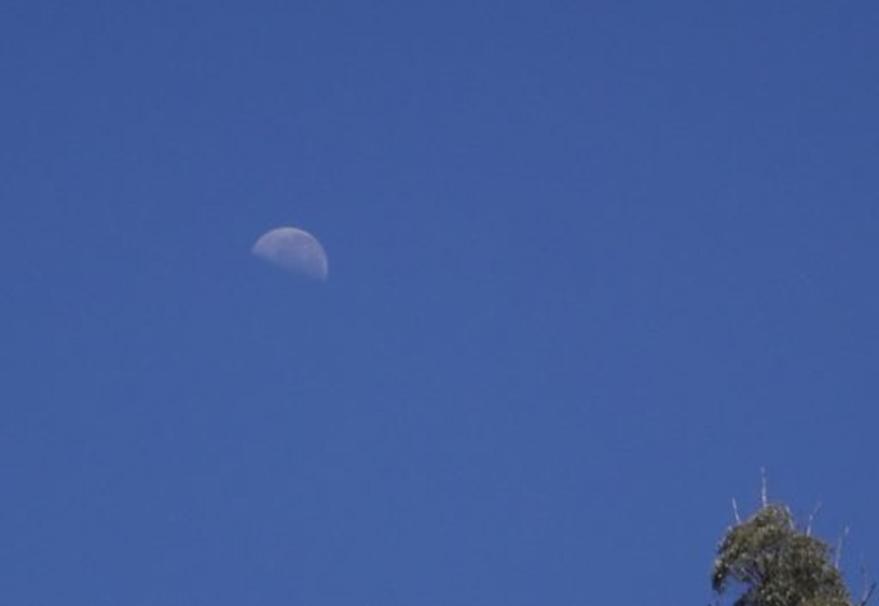
11/03/2018: How Green Was My River:
Packrafting the Thomson River Gippsland #2: After a delightful
night's sleep on My Neoair (Womens) mat on the soft warm sand snuggled in my
little poncho tent, I awoke to a morning you only dream of. Look at the quality
of the light behind me! A camera can only capture a faint taste of it really.
You just have to be there. And if you never have, or never will you are the
poorer for it!
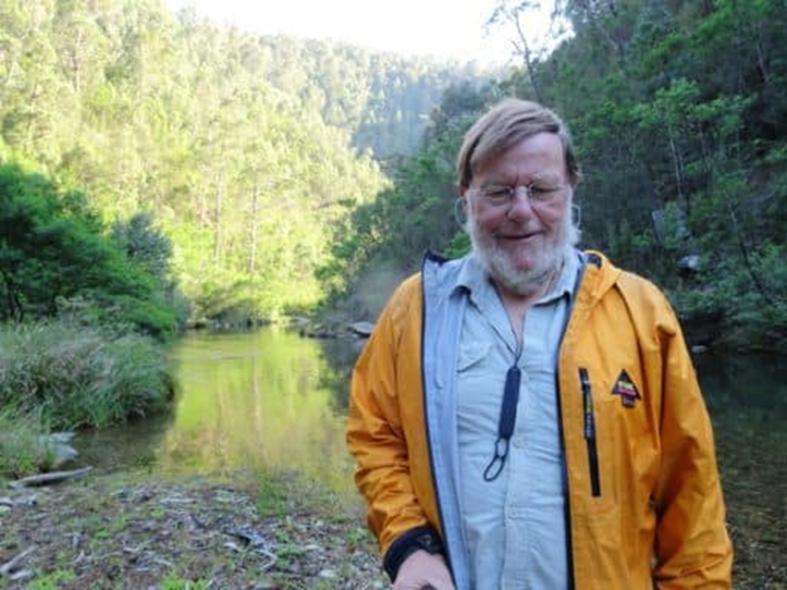
A
deer had splashed by me during the night only I guess 5 metres from my tent.
Here are its tracks (amongst my washing up) in the elven light of dawn.

I
just could not stop snapping this rill on the living water.
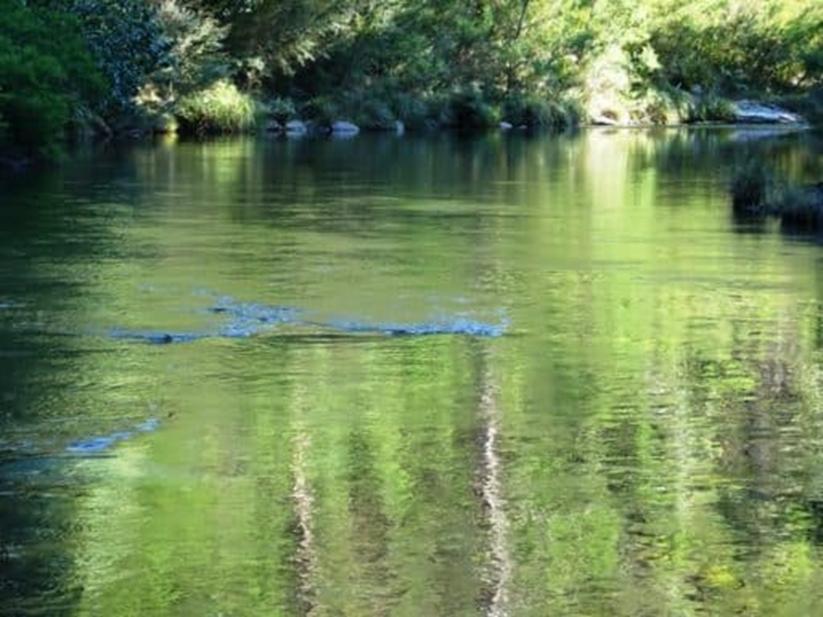
And
up closer:

Breakfasted,
all packed up and ready to go:
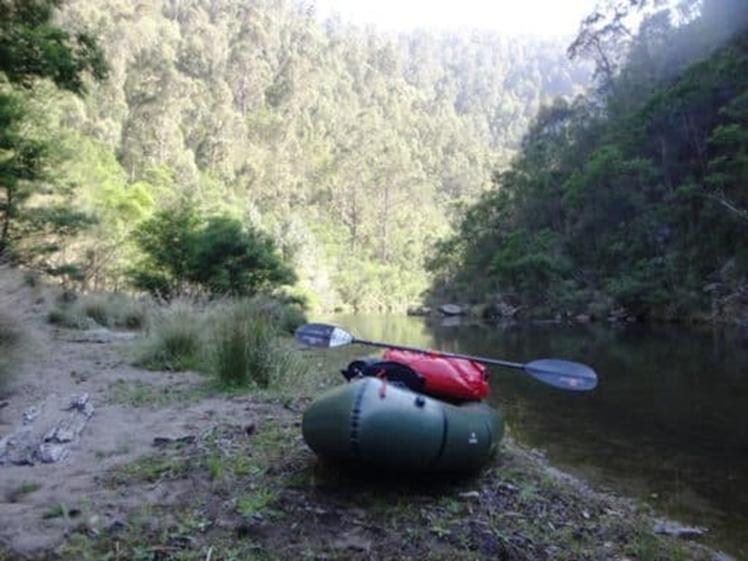
Lots
of other good spots to stop. Find your own. You are here for the solitude!
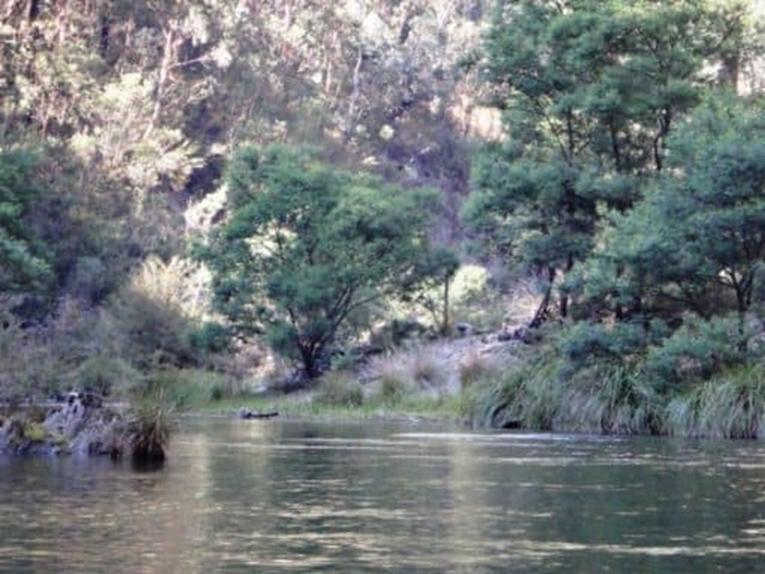
A
faint mist waked by sunbeams.
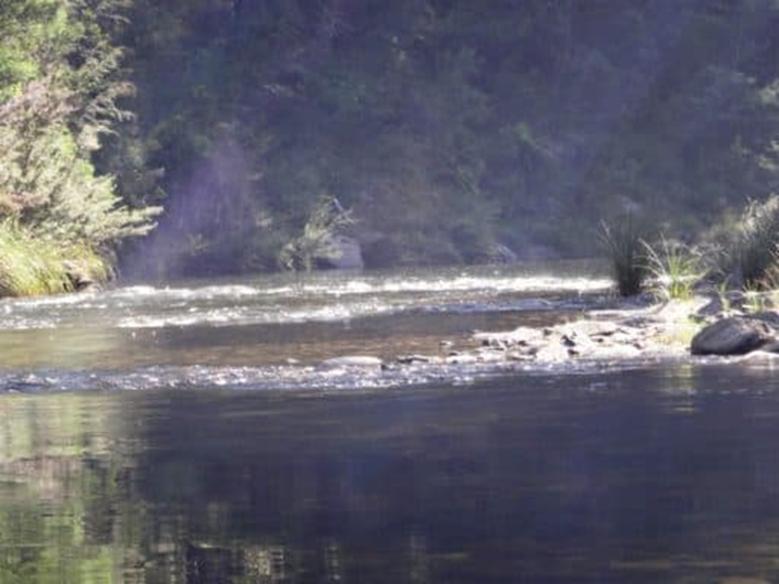
Some
pleasant rills as the sun gets up.

I
know these rainbow lenses are a bane to photographers, but I love them.
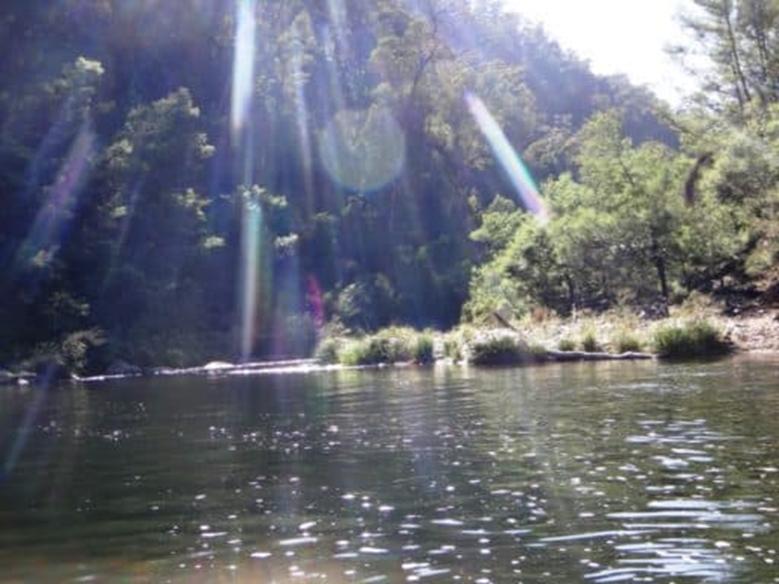
Look
at that for a camp on the right bank!
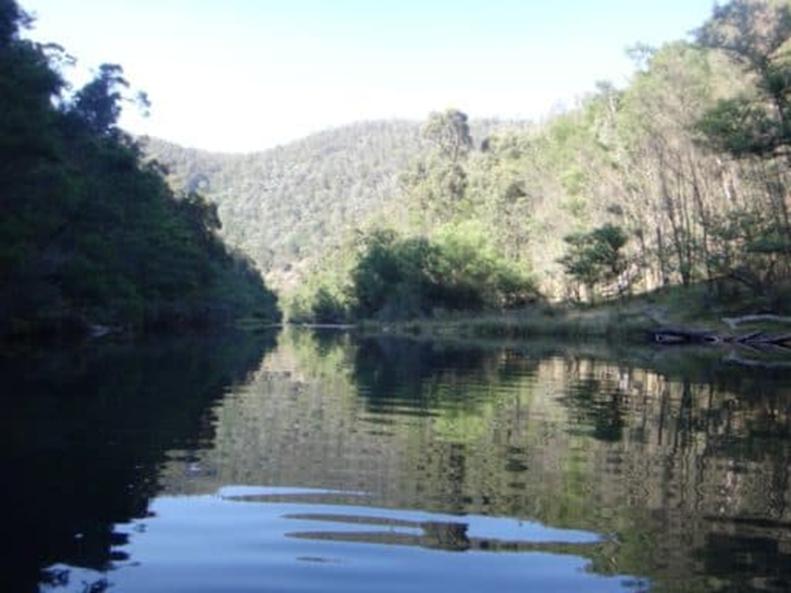
Or
that beach on the left bank.
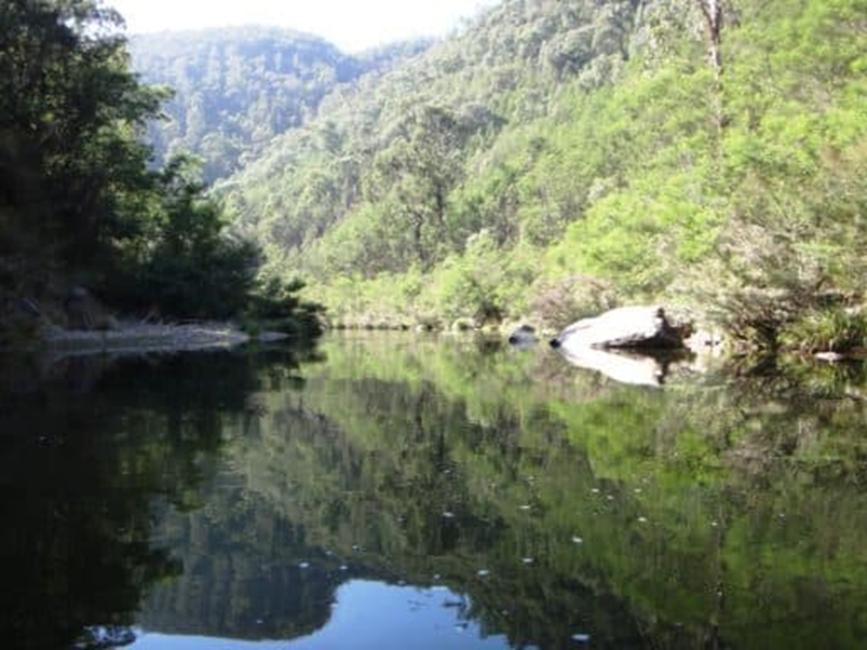
I
think the rapids on the Thomson are a lot rarer than the Wonnangatta actually.
There are so many long deep sections, but when it does fall away, it often does
so a lot more. Della prefers the many small grade 1 drops and pebble races of
the Wonnagatta - and I confess I am leaning that way myself. Age!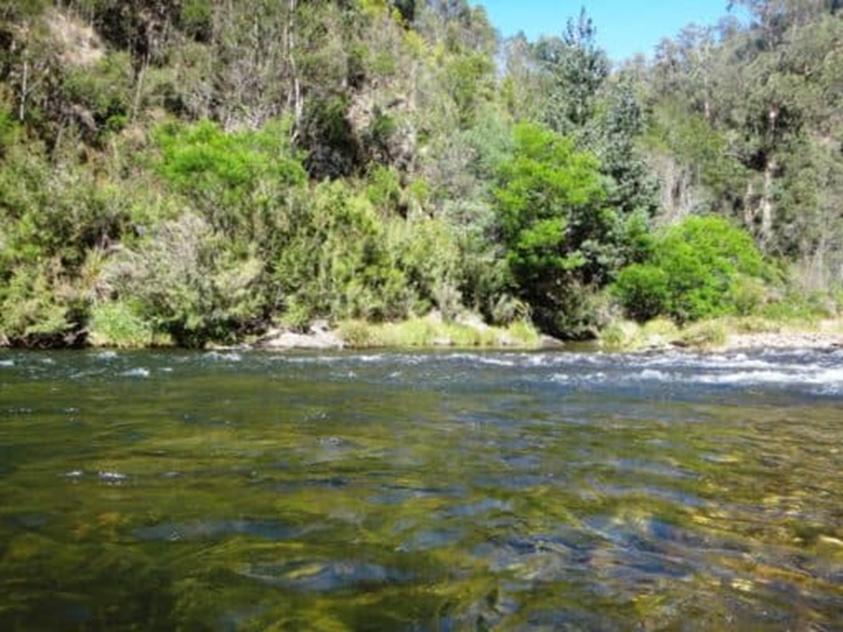
There
are two bends like this along here on the right with cottonwoods leaning out
majestically over the river.
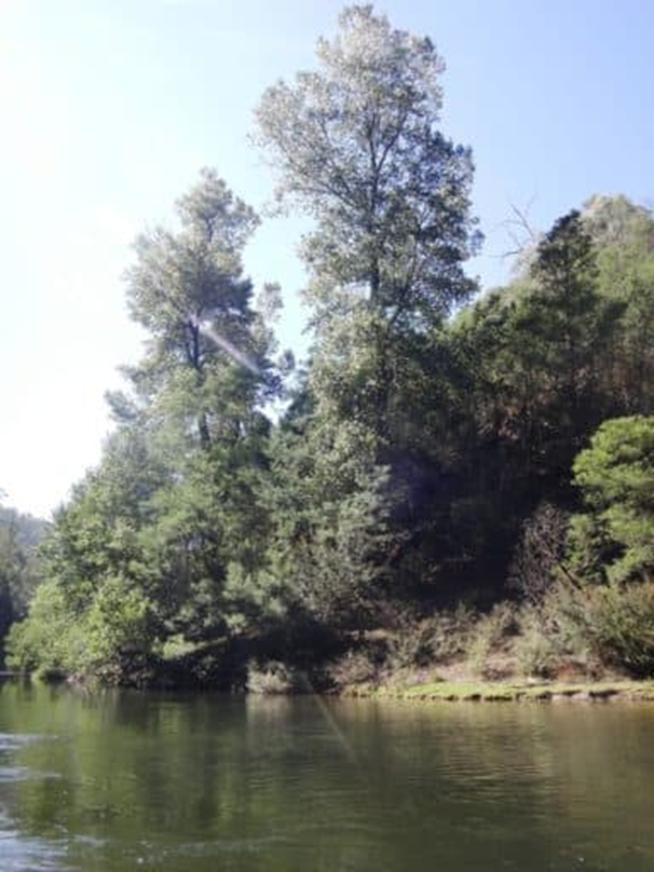
It
is a quiet section until the Triple Stage rapid.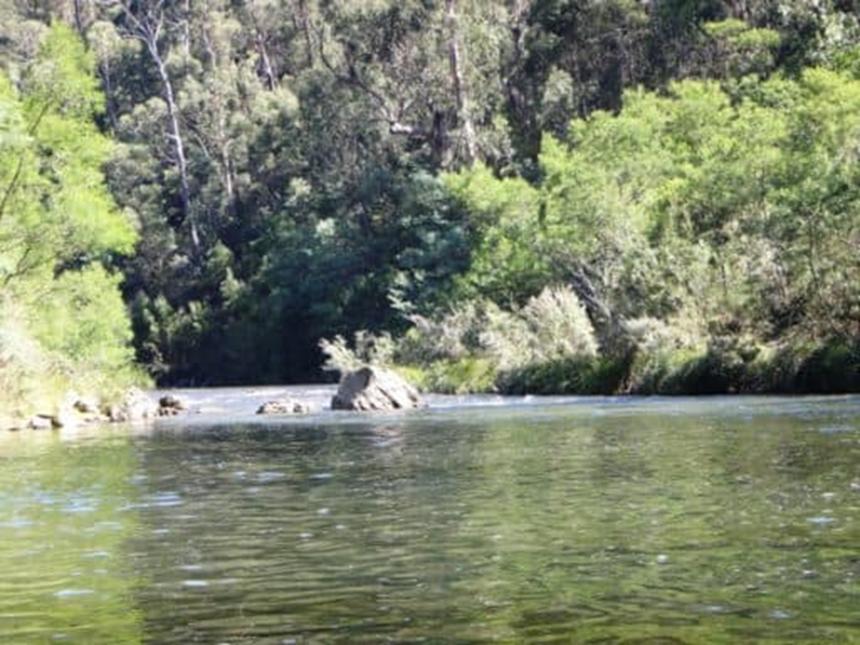
You
could lull yourself to sleep. I did once and awoke falling out of the boat as I
dropped down the First Stage. iIam still here. Just. Don't repeat that mistake!
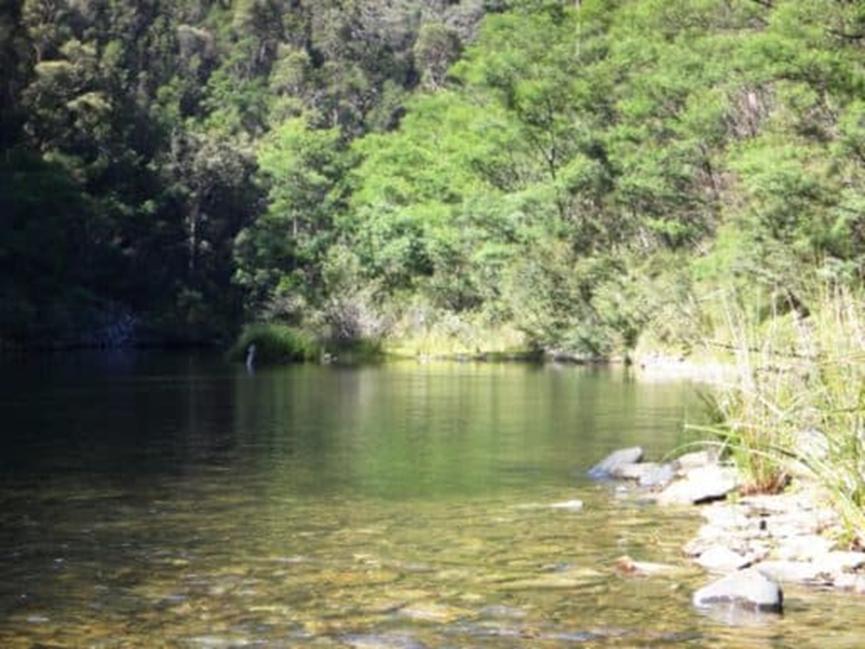
You
are looking out for the second bend on the right with cottonwoods. This one.
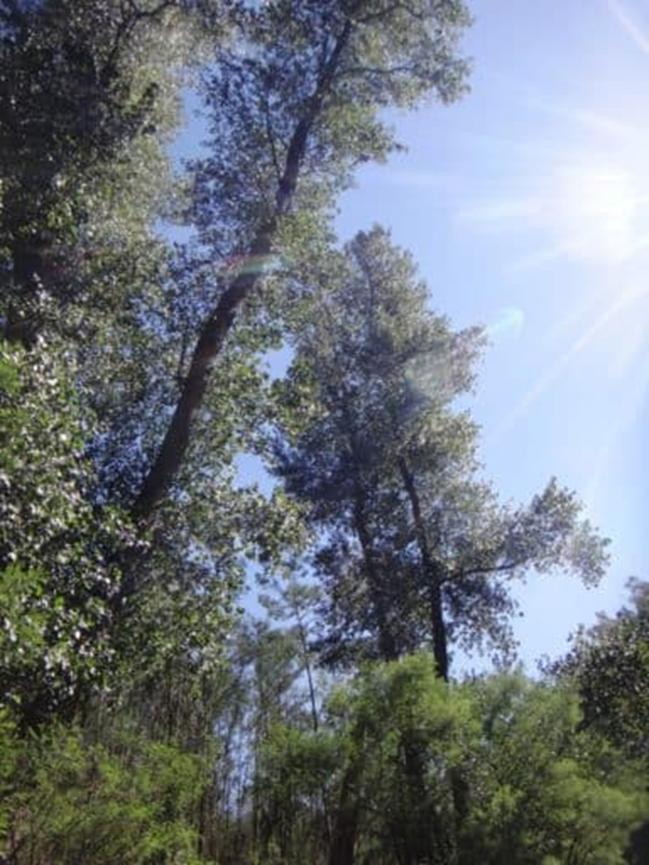
The
Mitchell Creek Track C34.4 (I think) used to come within walking distance of
here - and folks walked in (or 4WD motorbiked!) and camped. It would be a good
idea to re-clear this as a walking track, as it makes for an excellent one-day
trip on the Thomson.
The
only other possibility was the T9 track (now officially closed) off the Stoney Creek
Rd. It went (goes) to within a stone's throw of the river (just above the
cottonwood with the DSE sign in the previous post). I made a walking track to
the river some years ago off to the right at its end and we used to have one
day trips on the river from there. Turning around at the end of the track is a
bit of a challenge. Walk down first to check.
Anyway
this is the campsite amongst the cottonwoods at the end of this particular
Mitchell Creek track. If I were canoeing this section of the river over three
days, I would probably stop here the second night (The first I would stop above
the Gorge - on the right bank where the islands are - where Steve was fishing
in the video).
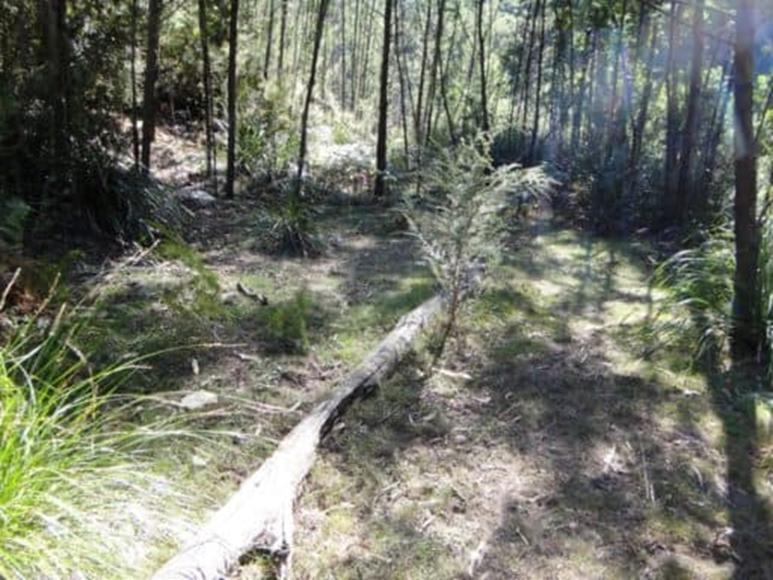
There
is one little rapid just below the cottonwoods, then this huge long deep pool.
(It lulls you into a soporific trance. Beware!) Along here before the fires it
used to be like a rainforest. There were stags wallowing on each side of the
river roaring challenges to each other. A few still hanging about. One honked
and crashed off on the left bank just here. 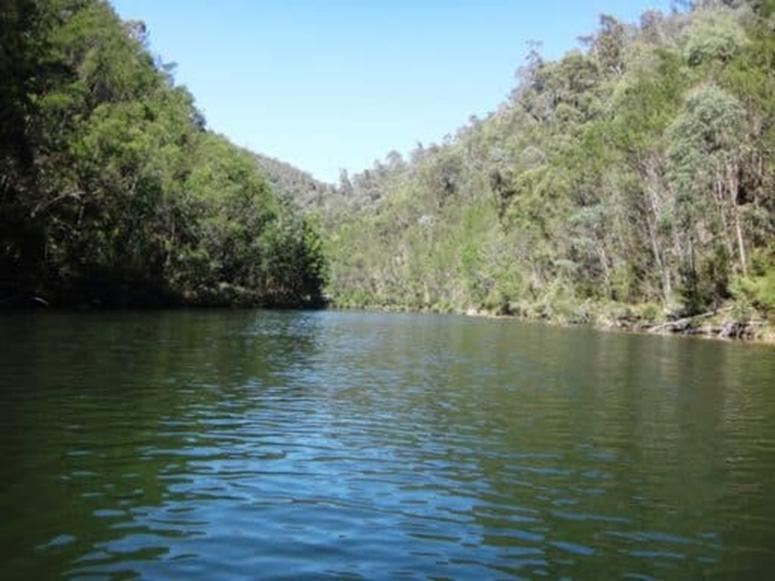
You
have to be watching for the Triple Stager. I have canoed down it many times,
but I have worked out (carefully) its every trick. For the novice, well it can
all be portaged on the right bank. Again you are looking at a flat at the
bottom of a gully (in this photo) and the river disappearing round to the left.
The river splits in two. Do not take the left fork.
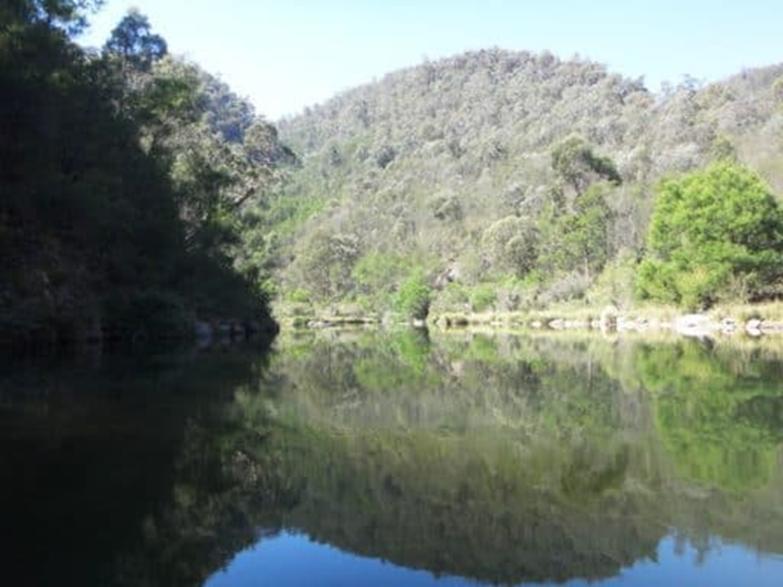
There
are really five stages. In the right fork there are two small
drops you can take unless the river is really high - and perhaps you should not
be here? You can get out at the bottom of the second.
If
you do not, this is the first stage. If you had come down the left fork you
would fall out here - and find it difficult to get over onto the right bank and
back into your boat or out of the water altogether safely. If you are in the
right fork you can drop down it and pull over into slack water which you can
see on the right below it. (I am giving directions as if you were facing down
the river, which you would be).

And
this is the second stage. Again you can sneak down it and pull over into slack
water on your right hand side.
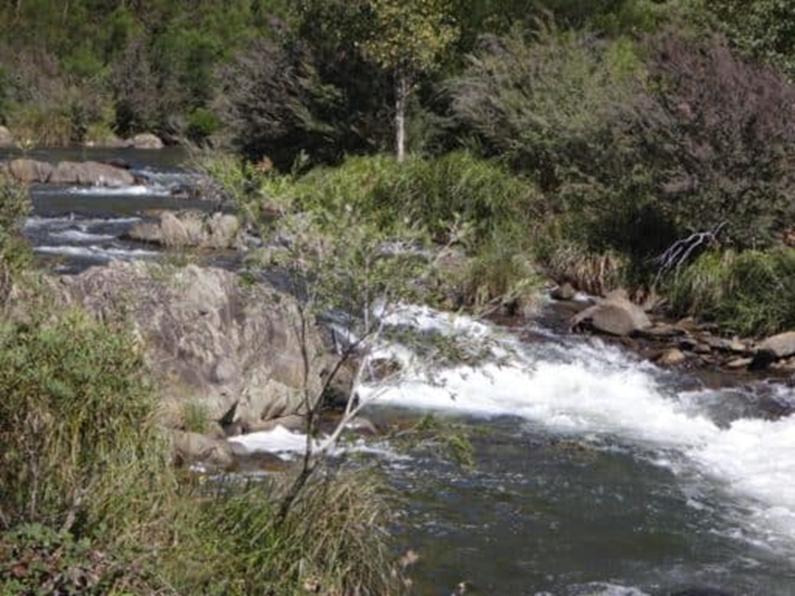
And
that is the third stage around the corner. I suggest you have a good look
before you try it. You can pull out there on the right and drag your boat a few
metres past it in safely. The approach is to be on the left hand side of the
river ready to swing to the right, then right again past the boulder at the
bottom of the rapid which will otherwise have you out.
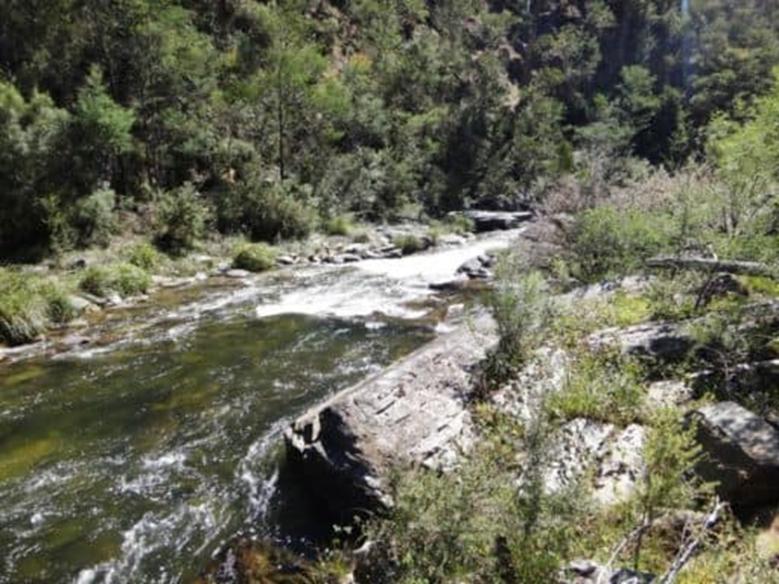
You
can see what I mean looking back up it. That boulder on the right of the photo
will have you out if you hit it head on or try to pass it to your left. 
Still,
you fall out there and it into relatively calm water. fall at the first stage
and you will be a bit battered and bruised (if you are lucky) before you climb
out here. When I came out, the boat was stuck on that last boulder and I had to
go back into the maelstrom in order to retrieve it.

There
are a few other little drops ahead:
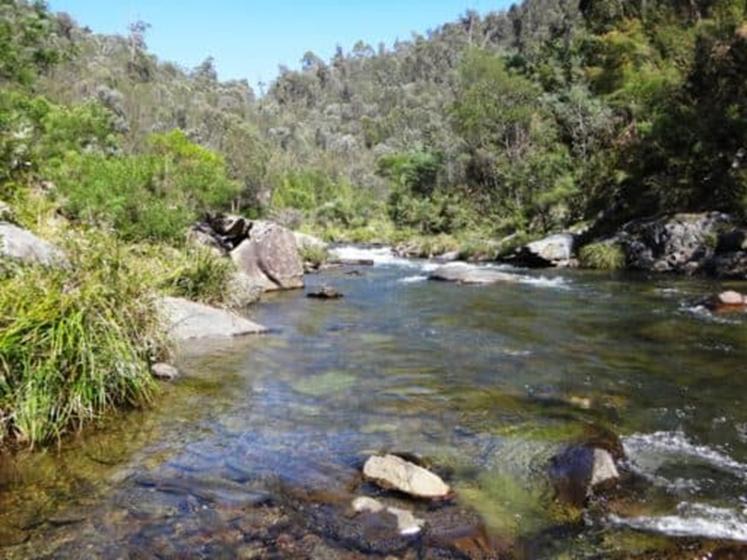
Like
this:
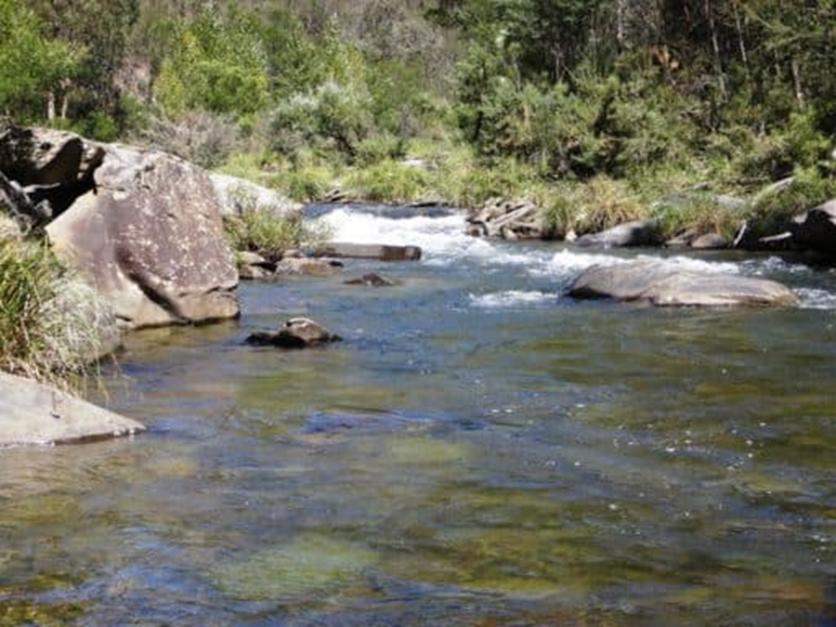
And
this:
Well,
actually this one is a bit nasty. If in doubt, walk!
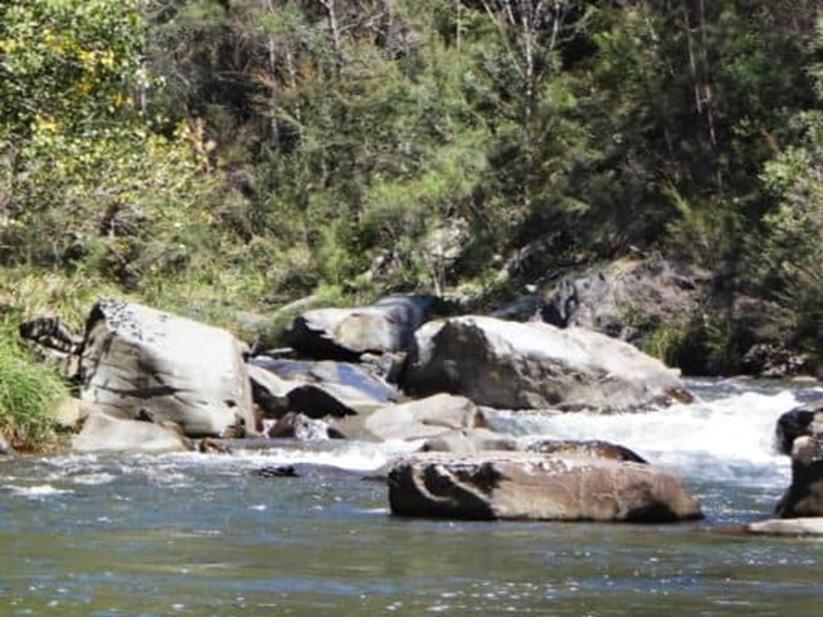
There
is a long downhill slide:

Another
little rapid: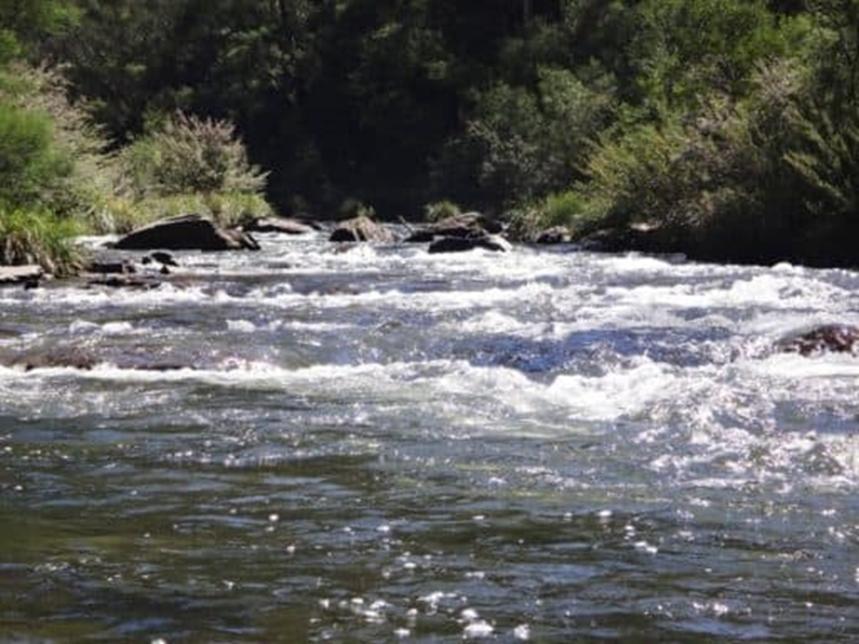
Then
a sinister deep pool with this enormous boulder seeming to block the entire
river. Get out and look (on the left hand side). You can easily portage it on this
side. If not, it is a very quick left turn, then a right, then straighten up
and head for the middle drop. The one on the left will likely
break your arm!
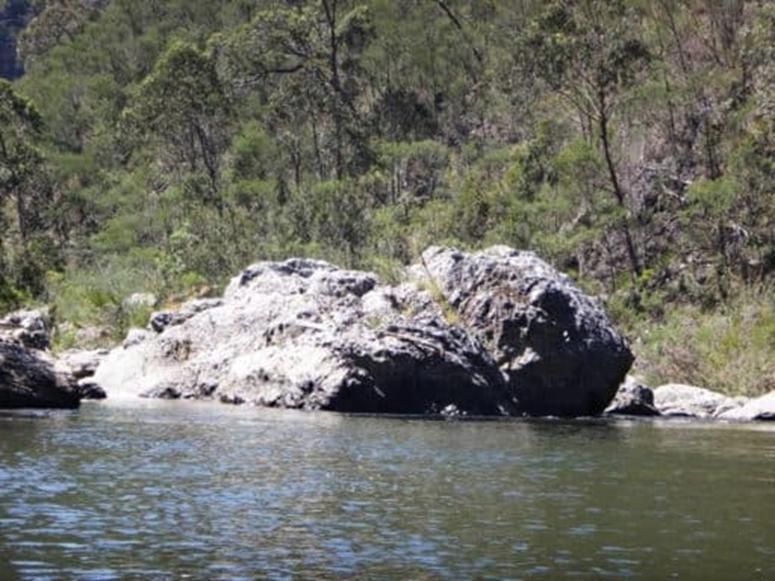
You
can sort of see here:
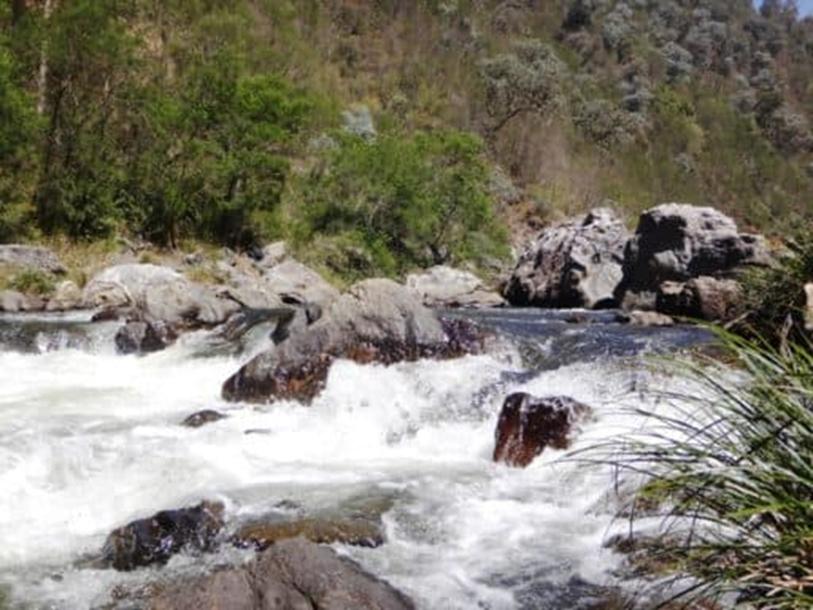
And
here:
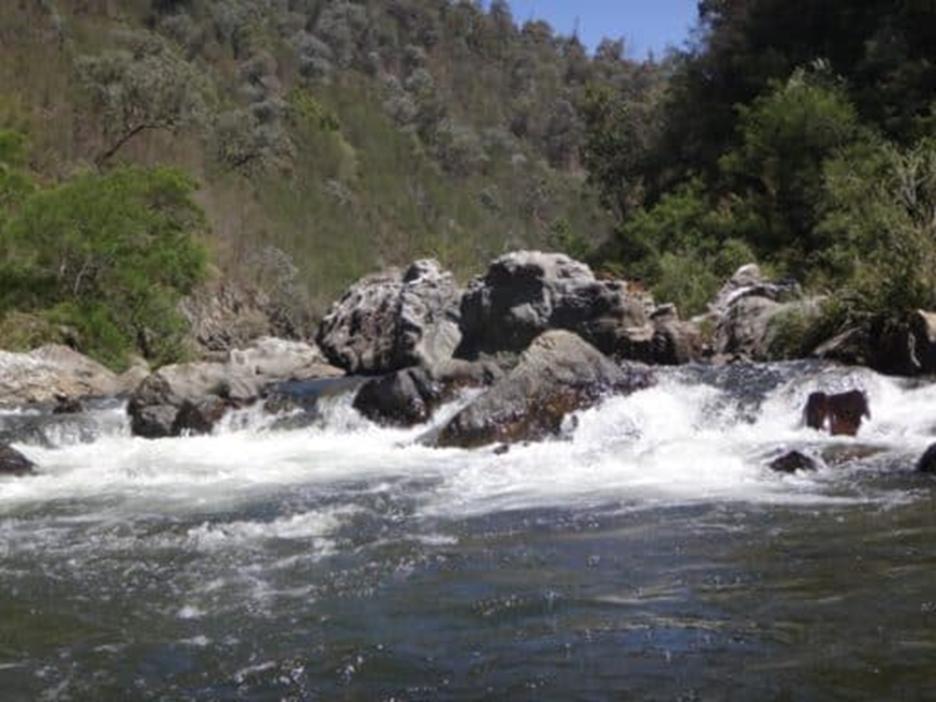
Then
around the corner off you go bum-pity bump down here, I usually use the right
hand side. However you can walk around it on the left hand side. We have always
called it 'Crocodile Falls' as a child's inflatable crocodile was hung up here
on a tree for a couple of years.

As
you can see looking up it, there is no clear course. You can easily get side on
to a rock and over you go, banging your knees and what-nots on rocks as you are
tumbled along!
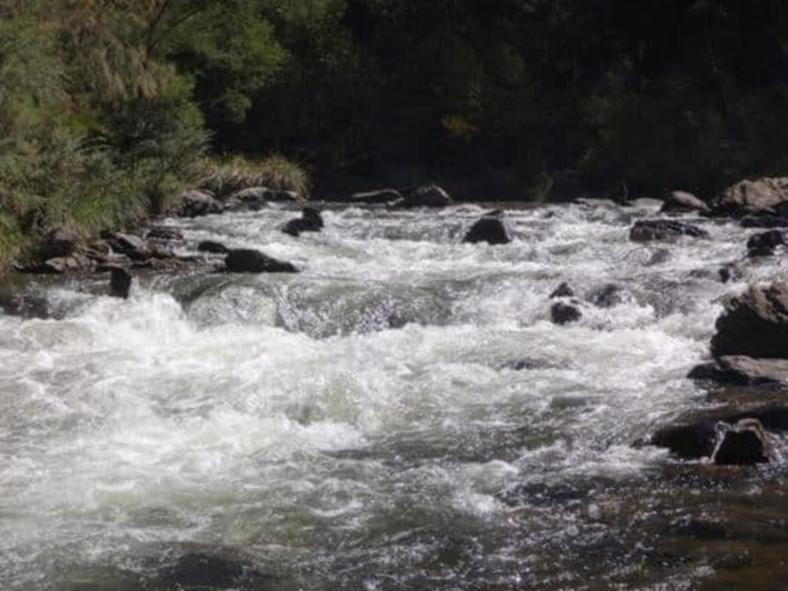
Just
around the corner there is another small rapid folks often get hung up on. I
still have not worked out which is the best course through this one. Some
rapids are worse at low water. These last two are like that.
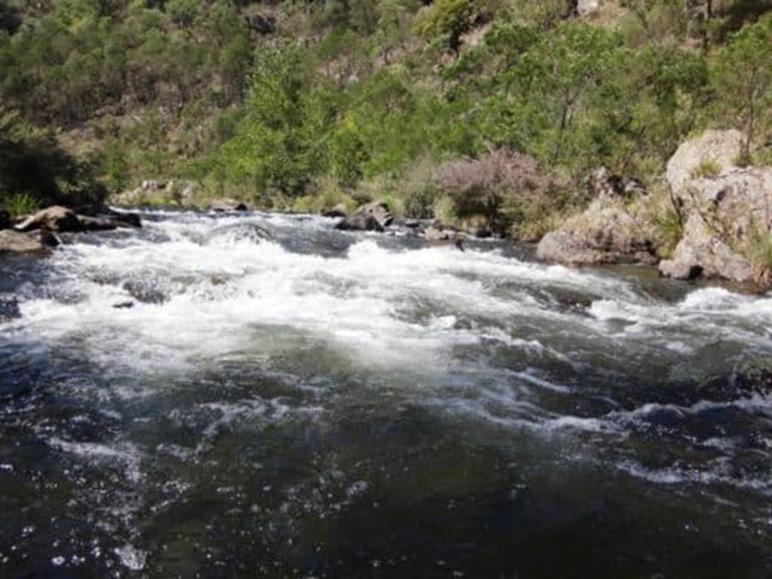
Next
thing you see is the steepest staircase in Victoria which accesses the Chute
Gauge. You can drive to here down the T1 track off the Stoney Creek Rd if you
have a serious 4WD. Folks sometimes come here swimming, and suicidally throw
themselves through the Chute! Madness really. I have even seen women with
primary school age children letting them do such foolishness.
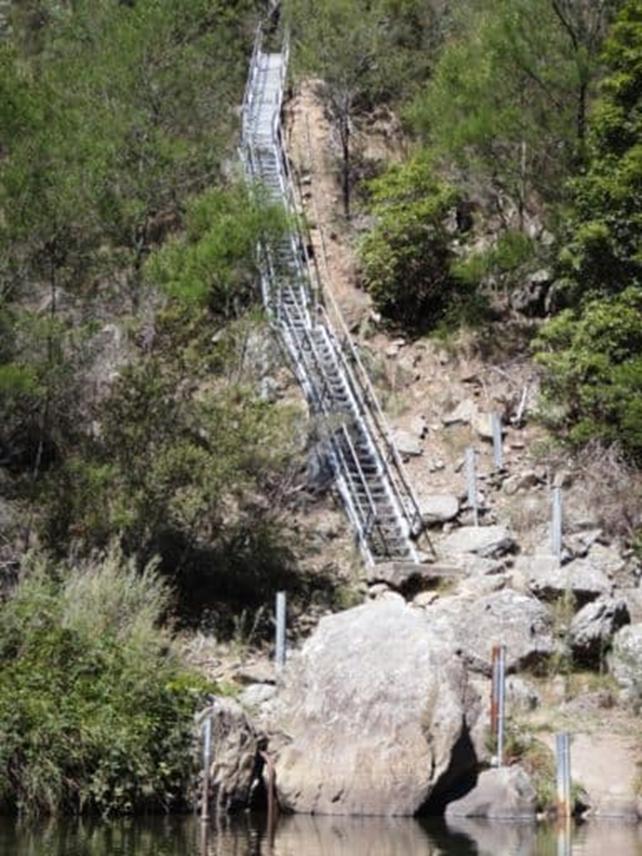
Just
around the corner (to your left) the entire river falls out of a large pool
through a chute which is narrow enough if you reach out you can touch both
sides. You can easily come out in the little drop going into this pool. Swim
immediately to your right if this happens. Remember the Chute is on your left.
You do not want to get sucked through it accidentally!
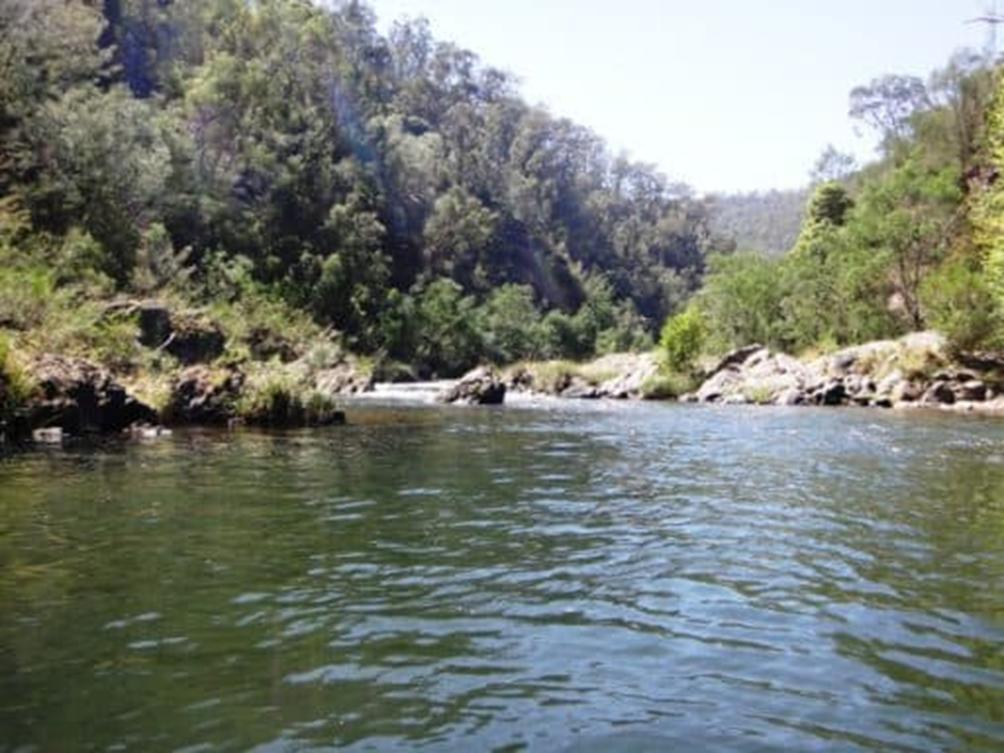
It
looks innocuous enough, and it is if you are lined up correctly. Go down the
left hand side with your boat pointed slightly to the left.

And
you will pop right out like this:
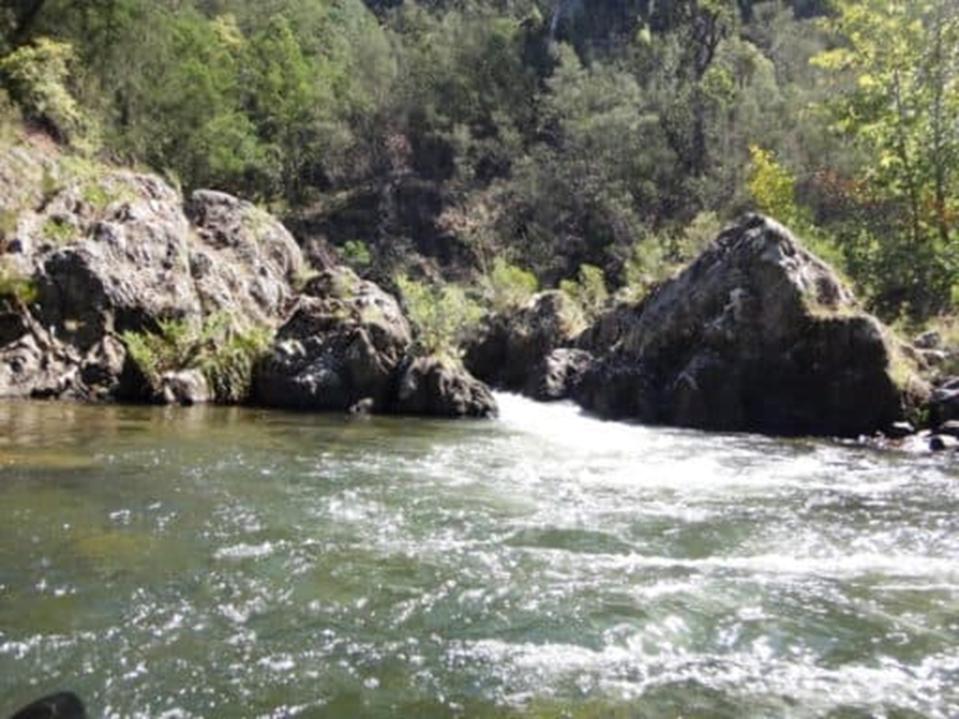
Gazing
back from further down the river. 
Along
the river below the Chute on the right there used to be a veritable
forest of pittosporum with an undergrowth of periwinkle, fringed with these cottonwoods.
It was so green and lush I would have thought it was immune to wildfire, but
the Seaton wildfire killed every single pittosporum (a native I had thought
virtually 'fireproof'). The cottonwoods survived, and the periwinkle, though it
was singed came back too.
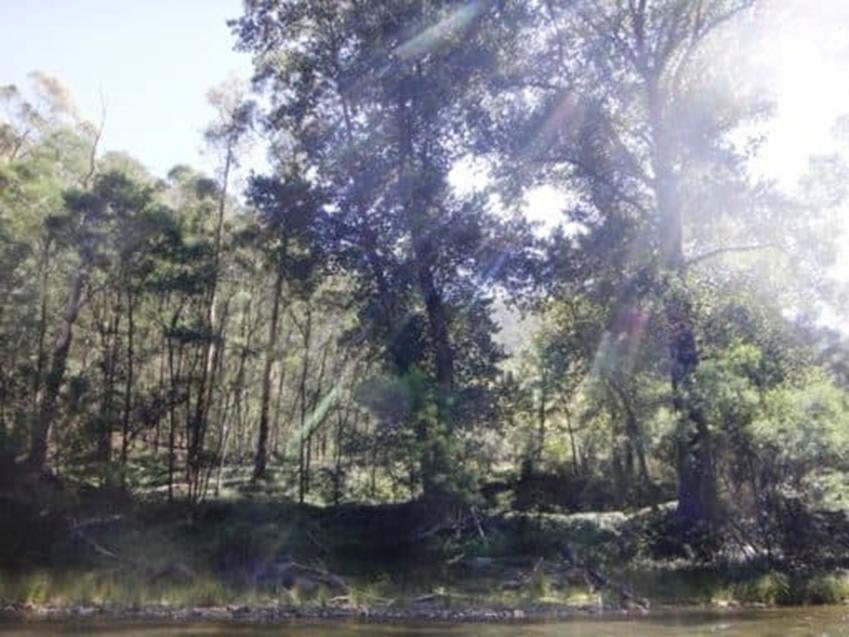
Yet
on the dry hillside above the pittosporum withstood the fire. Glad I wasn't
there on the day though!
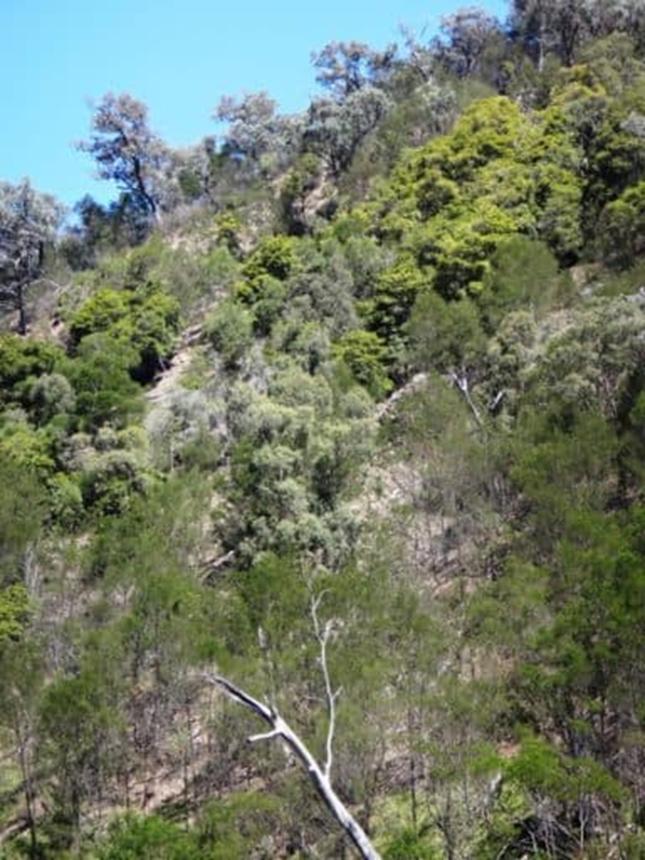
The
river still has a couple of little rapids to throw at you. You could walk down
to the Chute with the kids (with a couple of pack rafts) and paddle back safely
to the Weir. It is about an hour.
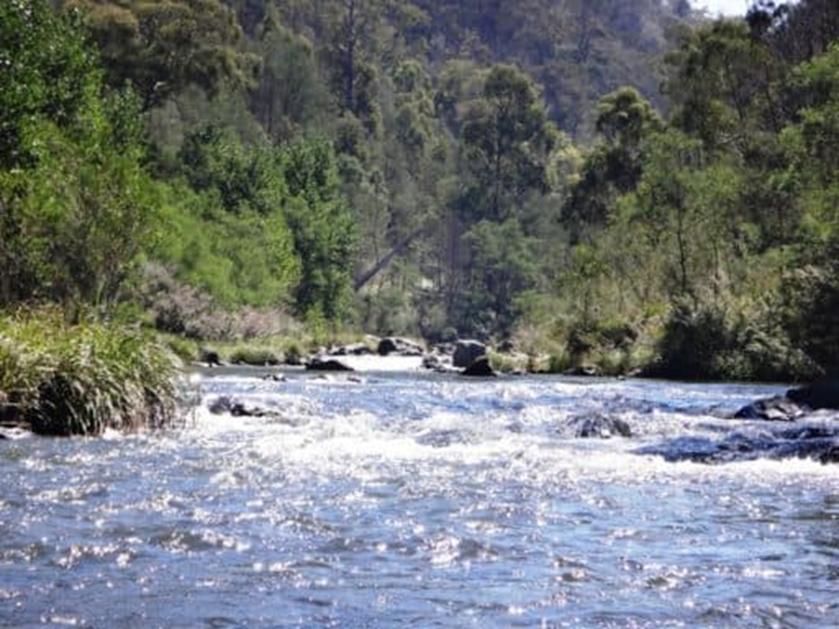
I
pulled over to have some lunch beneath a little stand of shady cottonwoods and
found this deer wallow. No antlers though sadly. 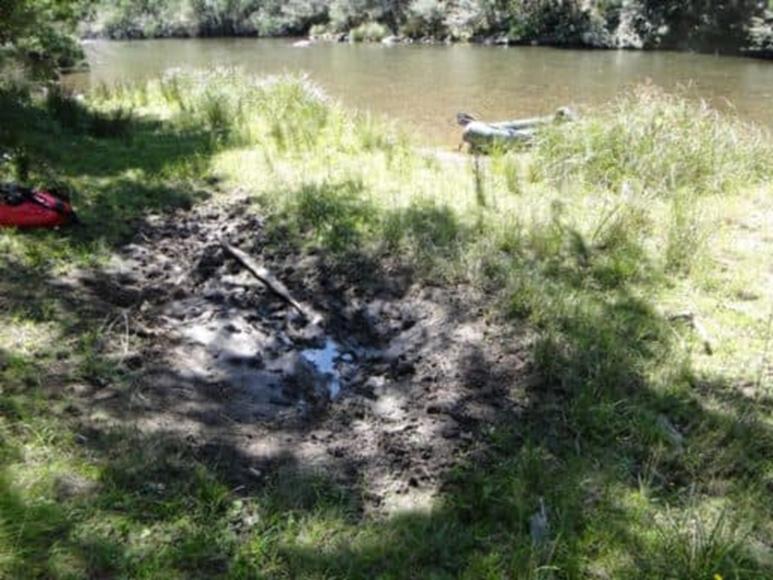
It
was a nice shady spot to have a (late) lunch though, you would have to agree.
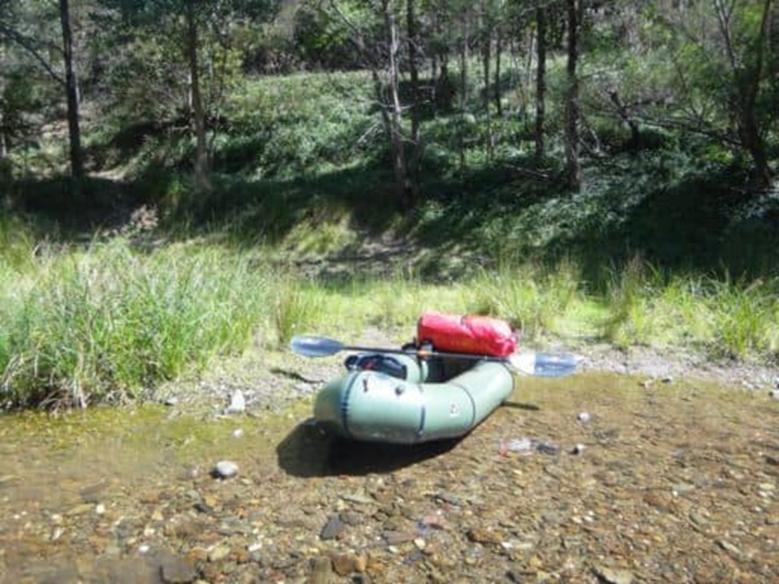
Once
you see that folks have been building toy dams across the river (as here) you
know you are at the weir.

It
is all heavy paddling now (the last half hour - no current) and somehow there
is always a wind blowing up the weir wherever the wind may be
blowing elsewhere!

And
finally you are back at your car (the small silver Subaru Impreza - right) just
near the new bridge which leads to the Stoney Creek Road and a back way to
Walhalla, or on to the Springs, Mt Useful and Licola or Woods Point, Jamieson
& etc. For me the road leads to the right, past the new RV camp and home to
my darling Della who was good enough to drop me off at Bruntons Bridge to do
this trip. Try if you can to find yourself a wife like that! . What a lovely
two day trip it was though. I will do it again, and again! If I am not too old!
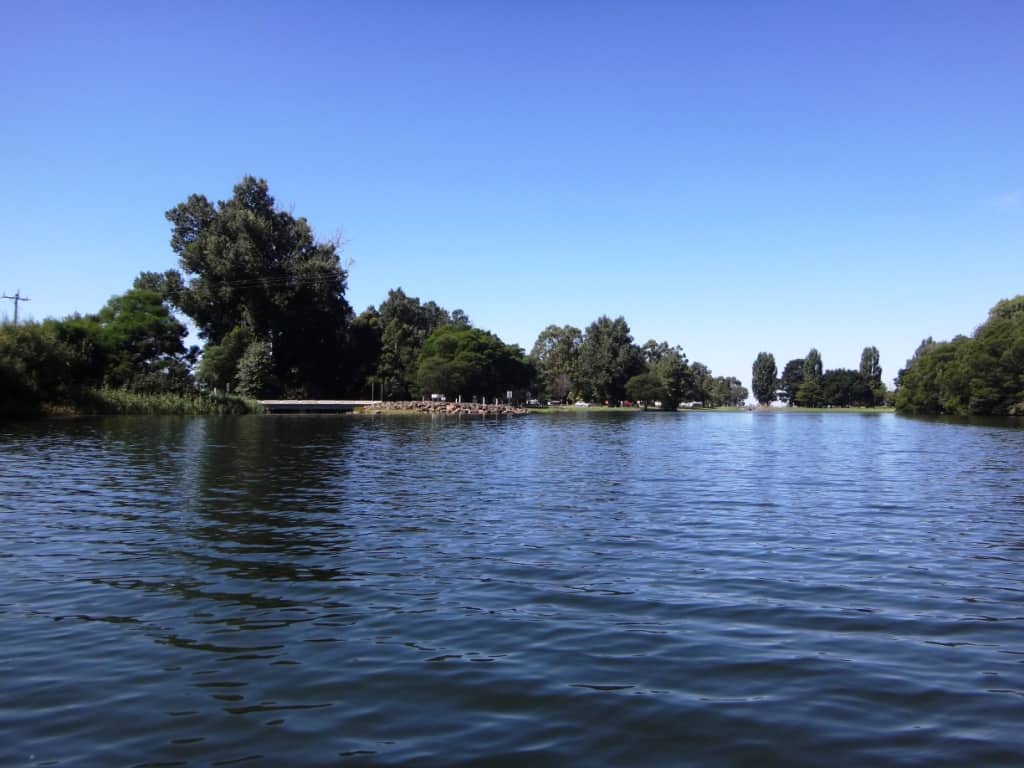
See
Also:
http://www.theultralighthiker.com/only-the-moon-and-me/
http://www.theultralighthiker.com/two-days-canoeing-the-thompson-river/
http://www.theultralighthiker.com/canoeing-the-thomson-river-gippsland-victoria/
Ultralight
Hiker Thomson River Canoe Trip 2006 (Video):
As
a foretaste, here is Steve powering down one of the Thomson's signature rapids:

http://www.theultralighthiker.com/thomson-river-canoe-trip-2006-video/
Same
trip here: https://www.youtube.com/watch?v=n4ntrDS5GNE
07/03/2018: Fifty Faggots: I love this poem (much
as I hate the war that stole the poet from us!) I so agree with the sentiment.
It is the small acts of conservation count most. We have an archway I
constructed 20+ years ago harbours many fine birds who are maybe our friends.
The wrens and antechinus love the blackberries I labour to destroy. The
pardalotes find a home in a raw bulldozer cut on the hillside. The sea eagles
nest in the open cut, finding the cliffs to their liking. The peregrine sees
the Station stacks as merely an eyrie. The
whistling kites hunt the ‘pest’ tilapia in the Pondage. Marsh warblers sing
from the cumbungi in the roadside drains. The thornbills love spiders in our
old sheds. Many birds collect our sheep’s cast wool for their nests…life WILL
find a way: we do not need vast National Parks to destroy with vicious
wildfire. SUCH ‘conservation’ is folly:
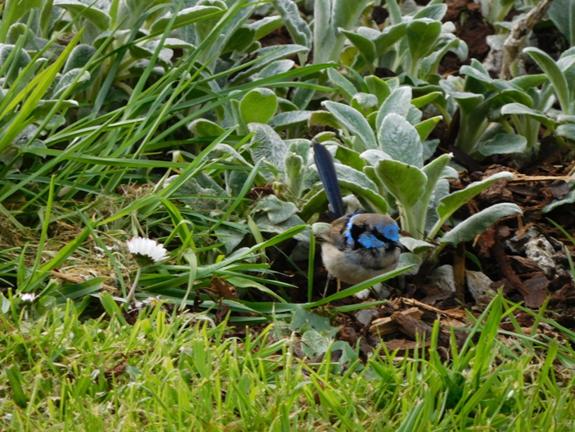
2015
0166 Birds
Fifty
Faggots: Edward Thomas 1878-1917
There they stand, on their ends, the fifty faggots
That once were underwood of hazel and ash
In Jenny Pink's copse. Now, by the hedge
Close packed, they make a thicket fancy alone
Can creep through with the mouse and wren. Next spring
A blackbird or robin will nest there,
Accustomed to them, thinking they will remain
Whatever is for ever to a bird:
This Spring it is too late; the swift has come.
'Twas a hot day for carrying them up:
Better they will never warm me, though they must
Light several Winters' fires. Before they are done
The war will have ended, many other things
Have ended, maybe, that I can no more
Foresee or more control than robin and wren.
One
thing (at least) I miss about the Hazelwood flats farm were the skylarks, or
pipits as they are known here; also the whistling kites which I observed still
hunting there yesterday, as I passed:
To
a Skylark: Percy Bysshe Shelley:
Hail
to thee, blithe Spirit!
Bird thou never wert,
That from Heaven, or near it,
Pourest thy full heart
In profuse strains of unpremeditated art.
Higher
still and higher
From the earth thou springest
Like a cloud of fire;
The blue deep thou wingest,
And singing still dost soar, and soaring ever singest.
In
the golden lightning
Of the sunken sun,
O'er which clouds are bright'ning,
Thou dost float and run;
Like an unbodied joy whose race is just begun.
The
pale purple even
Melts around thy flight;
Like a star of Heaven,
In the broad day-light
Thou art unseen, but yet I hear thy shrill delight,
Keen
as are the arrows
Of that silver sphere,
Whose intense lamp narrows
In the white dawn clear
Until we hardly see, we feel that it is there.
All
the earth and air
With thy voice is loud,
As, when night is bare,
From one lonely cloud
The moon rains out her beams, and Heaven is overflow'd.
What
thou art we know not;
What is most like thee?
From rainbow clouds there flow not
Drops so bright to see
As from thy presence showers a rain of melody.
Like
a Poet hidden
In the light of thought,
Singing hymns unbidden,
Till the world is wrought
To sympathy with hopes and fears it heeded not:
Like
a high-born maiden
In a palace-tower,
Soothing her love-laden
Soul in secret hour
With music sweet as love, which overflows her bower:
Like
a glow-worm golden
In a dell of dew,
Scattering unbeholden
Its aereal hue
Among the flowers and grass, which screen it from the view:
Like
a rose embower'd
In its own green leaves,
By warm winds deflower'd,
Till the scent it gives
Makes faint with too much sweet those heavy-winged thieves:
Sound
of vernal showers
On the twinkling grass,
Rain-awaken'd flowers,
All that ever was
Joyous, and clear, and fresh, thy music doth surpass.
Teach
us, Sprite or Bird,
What sweet thoughts are thine:
I have never heard
Praise of love or wine
That panted forth a flood of rapture so divine.
Chorus
Hymeneal,
Or triumphal chant,
Match'd with thine would be all
But an empty vaunt,
A thing wherein we feel there is some hidden want.
What
objects are the fountains
Of thy happy strain?
What fields, or waves, or mountains?
What shapes of sky or plain?
What love of thine own kind? what ignorance of pain?
With
thy clear keen joyance
Languor cannot be:
Shadow of annoyance
Never came near thee:
Thou lovest: but ne'er knew love's sad satiety.
Waking
or asleep,
Thou of death must deem
Things more true and deep
Than we mortals dream,
Or how could thy notes flow in such a crystal stream?
We
look before and after,
And pine for what is not:
Our sincerest laughter
With some pain is fraught;
Our sweetest songs are those that tell of saddest thought.
Yet
if we could scorn
Hate, and pride, and fear;
If we were things born
Not to shed a tear,
I know not how thy joy we ever should come near.
Better
than all measures
Of delightful sound,
Better than all treasures
That in books are found,
Thy skill to poet were, thou scorner of the ground!
Teach
me half the gladness
That thy brain must know,
Such harmonious madness
From my lips would flow
The world should listen then, as I am listening now.
07/03/2018: Cleo the Drone: https://newatlas.com/cleo-drone/53395/
06/03/2018: New Fancy Feast Stove: 'Zelph' is
clearly a genius (like Jim Woods who made the original of the Super Cat Stove - if you have not made one
yet, do so today!). He has taken the 'Super Cat' to a whole new level - and I'm
definitely impressed. I hit upon his website yesterday, saw that he doesn't
ship to Australia (You would have to use Shipito - recommended!) and decided I
could not wait, so made one myself with what was available to me.
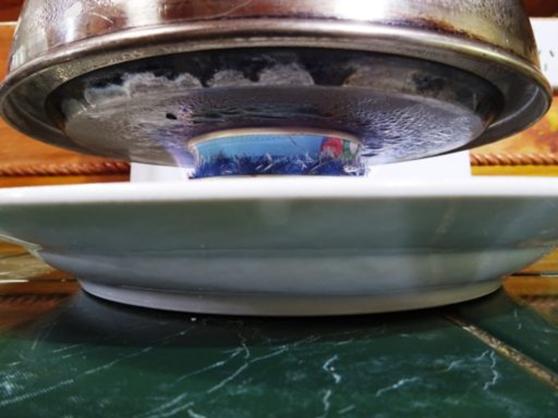
I
only had some fibreglass matting for the wick (material would be better - and
carbon felt, available from Aussie Outdoor Gear) even better.
Otherwise you only need three empty cans of the right diameter. You can see
what I used. These were already in the cupboard, but if you hunt around in your
local supermarket and particularly delicatessen) you will find three of the
right size - then you are away!
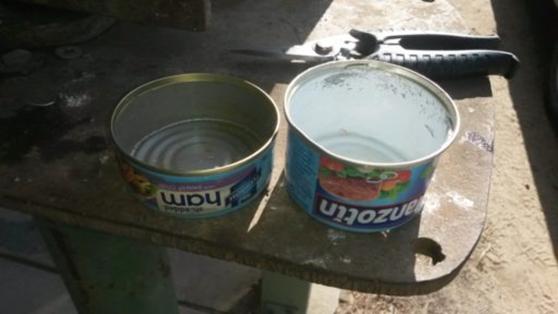
You
can buy one (and some other interesting stuff) from Zelph (with a simmer ring)
for US$25: http://www.woodgaz-stove.com/fancee-feest-stove-and-simmer-ring.php
Two
things I like so much about this stove. You can light it from the outside with the
pot already on, so there is no fuel/heat wasted (or fingers burned!) Second, it
burns in a really neat ring around the outside, giving a beautiful even heat.
Add a windscreen and you are good to go.
PS:
The sizes of can I found are probably better than the (original dimensions of
the Super cat as they are substantially wider, so providing a more secure
support for your cooking pot.
The
original cat food can = 2 5/8" - 65mm
Inner
Can = 2 15/16" - 74 mm
Outer
Can = 3" - 76 mm
Simmer
Can = 3 3/8" - 86mm
My
DIY stove (burner only) weighed 32 grams. It is a little heavier than the
original, but it is also substantially better. Still the whole set-up is
lighter than almost all canister stoves (and you don't need the weight of the
canister. I usually carry my meths in a Platypus bottle - a half litre is
usually enough for me for a week's trip!
'Zelph'
also recommends you check out this stove making page - and he's right: http://www.bplite.com/
You
put an approx 1 1/4" (30 mm) strip of wicking material in the space
between the two cans. Obviously the inside can needs to have (four x 1/8"
in this case) holes drilled in it (or the bottom removed - it will be stronger
and flatter for supporting your pot as is though).
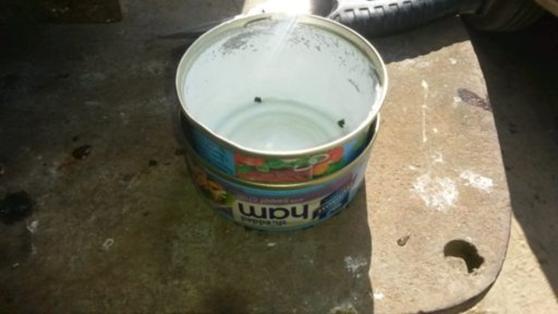
This
can will make a simmer ring. You will need to cut it down until it is just the
same height as the stove, then start putting holes around the top (start with
four, add as required until you get a good simmer)

Only
32 Grams! Not bad!

See
Also:
http://www.theultralighthiker.com/the-ultralight-trail-baker/
http://www.theultralighthiker.com/the-egg-ring-ultralight-wood-burner-stove/
http://www.theultralighthiker.com/cookset-woes/
http://www.theultralighthiker.com/soda-can-stove/
http://www.theultralighthiker.com/diy-side-burner-metho-stove/
http://www.theultralighthiker.com/the-best-alcohol-stoves/
05/03/2018: Three Stags: I just love living at
Jeeralang. Every day there is something new or wonderful to see, sometimes
several. On our evening walks we often see some deer. Usually I only have my phone,
so I have lots of lousy shots of them. This evening I had my new camera. I had thought until
recently that they were all does, but they have now all grown fine sets of
antlers, particularly the dark coloured one. Could he be a sambar cross, do you
suppose? One of them left us an antler some time back. I
couldn't get any closer than this because of the Jack Russells who would have
chased them away.
One
Stag...
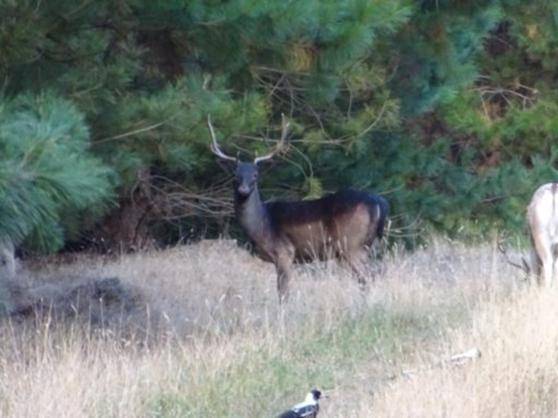
Two
Stags...
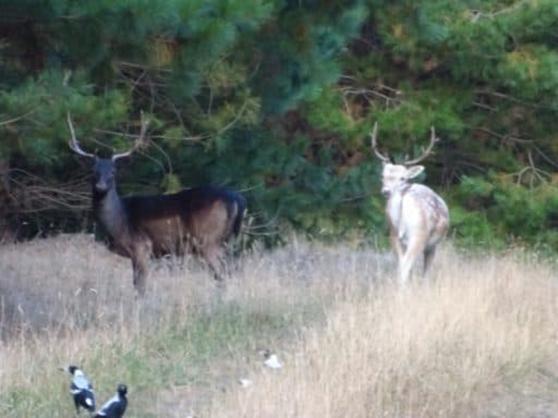

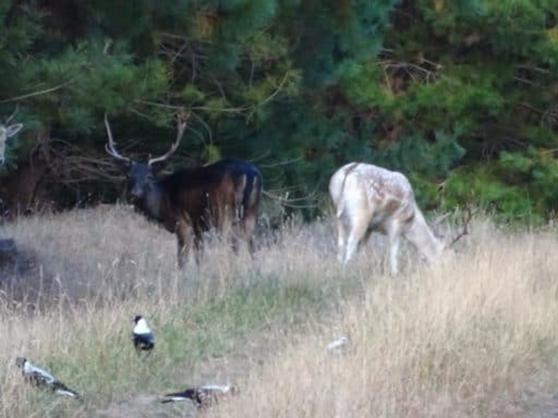
Three
Stags:


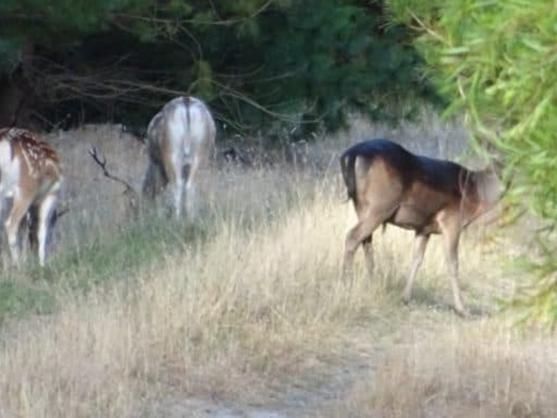
I
even managed to get some video of them, but I needed a tripod such as this: http://www.theultralighthiker.com/4-gram-string-reverse-tripod/
Still,
here it is: https://youtu.be/bAJaGd7LuFM
PS:
I have found over the years that the two most common groups of deer (sambar or
otherwise) I encounter in the bush are family groups comprising a mature stag,
a few does and their young - some of them as old as spikers, or groups of
stags like this which have been driven away from the hinds and flock together
for company. I have seen as many as seven in one group, usually at the heads of
gullies.
See
Also:
http://www.theultralighthiker.com/ultralight-camera/
http://www.theultralighthiker.com/must-take-a-gun-with-us/
http://www.theultralighthiker.com/how-green-is-my-valley/
04/03/2018: Ultralight Hiking on a Budget: The
'Big Five' for less than $100 and under 3 kg! I recently posted
about this 362 grams cheap 40 litre pack which you can buy from
Amazon for US$20. I bought one just to see and found it very good indeed - as
good or better than many more expensive packs I own/have owned, (First though I
added a belt to this pack which came without one. This made it ride a bit
better. It is a short pack quite suitable for children/wives etc). It fits all
my gear for a week's trip easily enough, so I got to thinking about the
(hypothetical) problem of kitting out a beginning hiker/hunter who is on a
pretty limited budget.

I
had already posted about this DIY tent which you can make for A$10 and
which will weigh around 800 grams including groundsheet. Of course I have many
other DIY ideas which could also save you money.
Here
are a couple of other shelter ideas, a cheap silnylon tarp 3 x 3 metres and 510 grams with 18
tie out points US$ 31.95 (Feb 2018) or this ultralight one person tent (750
grams) US$69.10 (Feb 2018)
The
next four items our novice is going to need are raincoat, pad, sleeping bag,
cookset.
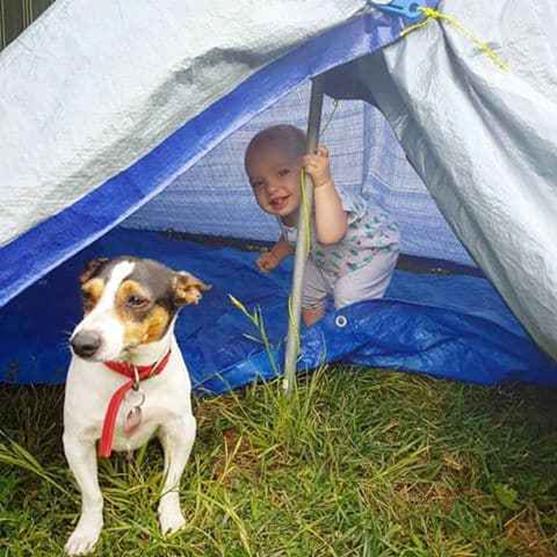
Undoubtedly
the cheapest raincoat is the disposable ubiquitous plastic poncho for around
A$2 which weighs around 50 grams. As a raincoat they are quite adequate but
they have a tendency to shred in any rough going. However, treated carefully
they will last several days and can be repaired with some cheap tape. Besides
not everyone wants to go hiking in the rain!
If
you shop around you will find some pieces of kit which are reasonably priced.
Perhaps you are better off spending 'big' money on a comfie air mat but I slept for years
straight on the ground, so I'm sure you can too. Better than that would be the
ubiquitous blue foam hiking mat which can be bought lots of places for <$10
(and which weigh around 225 grams usually). They have an R' rating of about 1.5
from memory, fine for summer(ish) weather, but not good enough for the cold!
Still you can always add a brush bed for free.
I
used to buy lots of cheap gear from stores such as 'Aussie Disposals' and
'Mitchells' whom I would still recommend highly - or 'Ray's Outdoors'. Just
looking at the current Aussie's catalogue which was given to me by another
'Steve', the manager of the Traralgon store. (Say 'G'day' from me!)
They
have a Hi Country Basic Self -Inflating Mat (down from A$34.95) to A$19.95 (Mar
2018) - probably over a kg though.

They
also have a 0C Hi Country Compact Mark II Sleeping Bag 1200 grams for A$49.95.

They
have a 360 Degrees Stove and Pot Set for A$59.95 - though I would probably go
for their cheap aluminium billy (<A$10) and a Super Cat Stove and a plastic plate from a
pack of Sirena Tuna and beans (Spoon from Chinese takeaway or similar).
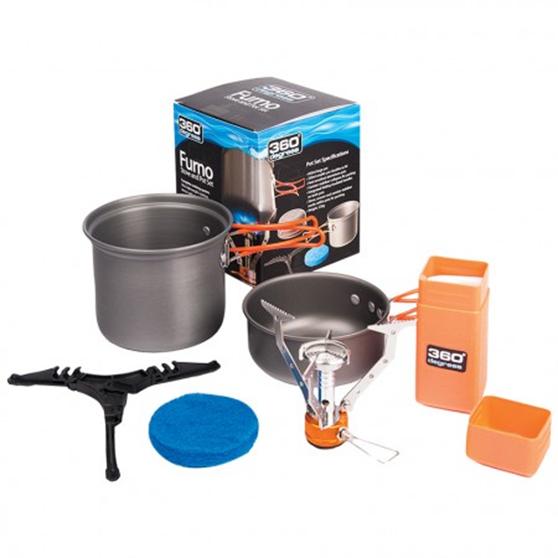
The
Super Cat Stove:

And,
Oh, talking of raincoats, they have a Blizzard Storm Jacket for A$29.95. All
these items will give many years of good service and can be replaced with
lighter substitutes for hiking later on whilst still being useful for car
camping - or to lend to a friend.
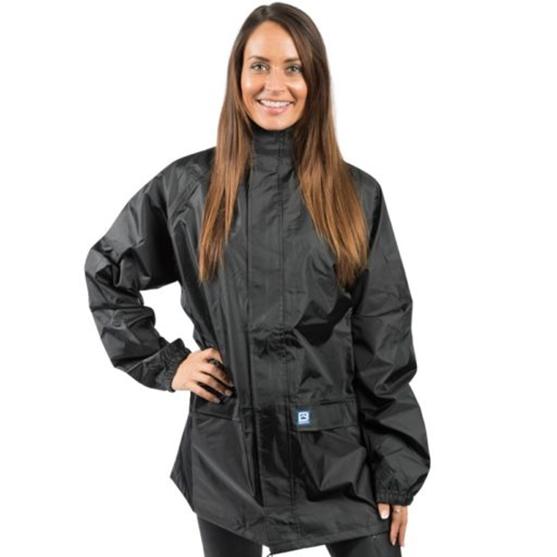
So,
you can buy the big five pack $20, + tent $10, + raincoat $2, + pad $10, +
sleeping bag $50, + billy and plate <$10 Stove $0 (though $1 to purchase
hole punch from $2 store or similar).
Total
cost to begin your 'ultralight' hiking career = $100!
Weights:
Pack:
362 grams + 30 grams webbing belt & buckle
Shelter
800 grams
Pad:
225 grams
Sleeping
Bag 1200 grams
Raincoat
50 grams
Billy
and cup approx 200 gram
Total:
2837 grams.
04/03/2018: Choking Death: Always a horrible
tragedy when your toddler does this. I know my infant son began choking once,
colour changing rapidly, extreme distress. We lived miles form any help. All I
could think to do was upend him, slap him on the back, then a big quick hug around
chest. The offending object popped right out (raspberry jelly lolly found
dropped on floor by an older sibling perhaps). He is now 33 years old. Hope
this helps someone: https://www.9news.com.au/national/2018/03/03/15/05/alby-fox-davis-mum-reveals-bouncy-ball-that-caused-son-s-death
03/03/2018: 11 weeks and ears UP! What a champion
she is going to be:

03/03/2018: Tyvek: Over the years I have made many
projects out of this wonderful material, particularly tents but other things
besides (see below). I use the 3 metre wide 'Homewrap' version which I source
by the 30 metre roll from Bensons (Home) Hardware in Morwell nearby at
about A$200 per roll. Each roll is enough to make many, many tents!
The
Whelen Forester Tent in Tyvek:
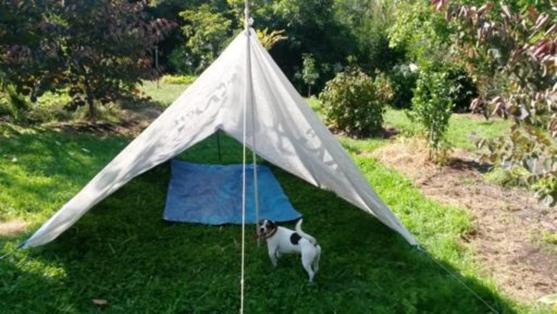
I
like that it is waterproof (2500mm), breathable, comes in a wide roll so little
sewing is needed, cheap, reasonably light (1.85 ounces per square yard = 63
grams per metre 2), stands up (or drapes) really well, has a great sound in the
rain, reflects heat really well whilst blocking wind, is mildly insulative, and
has an ignition temperature of 400C which is pretty much a naked flame (which
will really just melt it).
It
is quite immune (in my experience) to burns and pin holes from wind blown
sparks (when you throw another log on the fire). There is a special Tyvek
sticky tape which can be used for joining it, and if you can't sew, tarp clips
work very well with it. It also makes an excellent ground sheet.
There
is a new Fire Retardant Tyvek: 68 grams per square metre = 2 ounces per square
yard It seems to come only in 1.5 metre wide rolls though. http://www.dupont.co.uk/products-and-services/construction-materials/tyvek-building-envelope/brands/tyvek-breather-membrane/products/tyvek-firecurb-housewrap-fire-retardant-membrane.html
‘DuPont
Tyvek is combustible and should be protected from an open flame and other high
heat sources. If the temperature of DuPontTyvek reaches 750°F (400°C), it will
burn and the fire may spread and fall away from the point of ignition’ http://www.dupont.ca/content/dam/assets/products-and-services/construction-materials/tyvek-building-envelope-CA/K-16743_TyvekHomeWrapPhysicalProperties_CanadaEN.pdf
Just
a few of my Tyvek designs. You can find lots more by doing a 'Search' (top
right) with the word, 'Tyvek'.
http://www.theultralighthiker.com/new-tyvek-forestertent-design/
http://www.theultralighthiker.com/the-deer-hunters-tent/
http://www.theultralighthiker.com/fire-umbrella/
http://www.theultralighthiker.com/tyvek-solo-fire-shelter/
http://www.theultralighthiker.com/bathtub-groundsheet-chair/
http://www.theultralighthiker.com/ultralight-poncho-tent/
http://www.theultralighthiker.com/an-open-shelter/
http://www.theultralighthiker.com/tyvek-jack-russell-rain-coat-13-grams/
http://www.theultralighthiker.com/honey-i-shrank-the-tent/
http://www.theultralighthiker.com/tyvek-twin-fire-shelter/
http://www.theultralighthiker.com/new-decagon-octagon-tyvek-igloo-tent-design/
http://www.theultralighthiker.com/tyvek-bivi/
http://www.theultralighthiker.com/tyvek-solo-fire-shelter/
http://www.theultralighthiker.com/ultralight-chairgroundsheet/
02/03/2018: Honey: As you have probably noticed we
have a new puppy (for Spot) whom we have called 'Honey'. We had a very unhappy
'Spot' following Tiny's death in early February. We decided
to do something about it quickly (this was also the vet's recommendation) so a
quick trip to Digger's Rest and we became the new owners of a beautiful little
female Jack Russell. I will be 86 if she lives as long as Tiny, so I wonder
whether she will be my last dog.

Like
many things you only get a finite number of dogs, though I have been most
fortunate and have owned and loved a great many. My first puppy when I was
perhaps 3-4 years old was white too, very similar to Honey. Sadly that puppy
died from distemper when she was only a bit older than this little tyke. (This
one won't). I still remember where I buried her, though that entire forest (a
thousand miles away) is a field now, and our large isolated farm a series of
hobby farms today. Some things live on only in memory or the mind's eye.
Eventually the mind too falters and cools. Nothing remains.
Unless
a Homer comes along and writes a lovely immortal paean such as this, to
Odysseus' faithful old hound, 'Argos' (clearly the template for Rip van
Winkle's):
'As
they were speaking, a dog that had been lying asleep raised his head and
pricked up his ears. This was Argos, whom Odysseus had bred before setting out
for Troy, but he had never had any enjoyment from him. In the old days he used
to be taken out by the young men when they went hunting wild goats, or deer, or
hares, but now that his master was gone he was lying neglected on the heaps of
mule and cow dung that lay in front of the stable doors till the men should
come and draw it away to manure the great close; and he was full of fleas. As
soon as he saw Odysseus standing there, he dropped his ears and wagged his
tail, but he could not get close up to his master. When Odysseus saw the dog on
the other side of the yard, dashed a tear from his eyes without Eumaios seeing
it, and said:
'Eumaios,
what a noble hound is that over yonder on the manure heap: his build is
splendid; is he as fine a fellow as he looks, or is he only one of those dogs
that come begging about a table, and are kept merely for show?'
'This
dog,' answered Eumaios, 'belonged to him who has died in a far country. If he
were what he was when Odysseus left for Troy, he would soon show you what he
could do. There was not a wild beast in the forest that could get away from him
when he was once on its tracks. But now he has fallen on evil times, for his
master is dead and gone, and the women take no care of him. Servants never do
their work when their master's hand is no longer over them, for Zeus takes half
the goodness out of a man when he makes a slave of him.'
So
saying he entered the well-built mansion, and made straight for the riotous
pretenders in the hall. But Argos passed into the darkness of death, now that
he had fulfilled his destiny of faith and seen his master once more after
twenty years.'
Surely
that story shakes a tear from even the hardest heart, even after nearly 3000
years!
You
already saw her first trip:
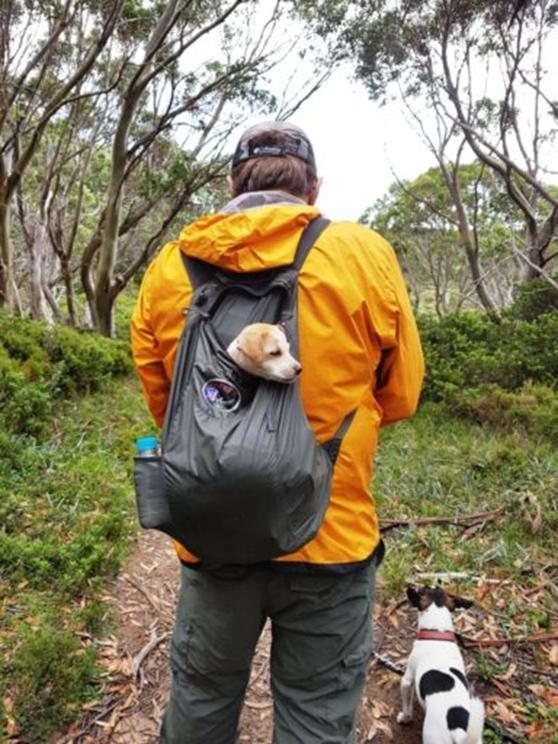
Full
version here: http://www.theultralighthiker.com/honey/
01/03/2018: Hidden Worlds: Nocturnal Ants: We have
lived in this house for 27 years yet still there are things which surprise.
Tonight I was taking the puppy (Honey) out the front door for her 'Goodnight'
toilet stop. (She is making progress) when I noticed for the first time that
there is a nest of these 1 cm+ golden beauties right at our front door, yet we
never see them - as they only come out in the dark! They do not seem to bite or
sting, so they can stay there as far as I am concerned. I am not so keen on
'jumping jacks' which get short shrift around here!
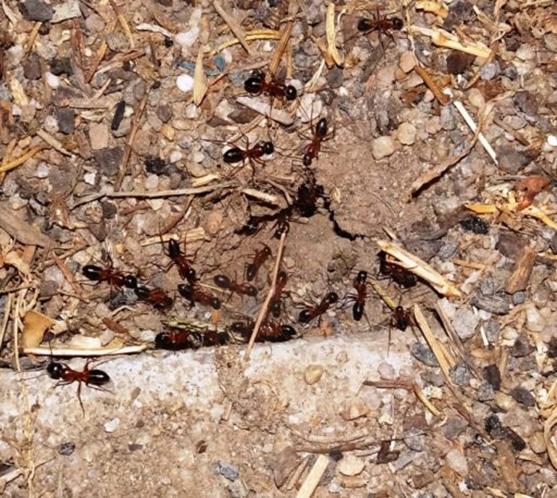
We
have lived alongside many other such creatures here in our little valley for
nearly thirty years, as I have explained in previous posts, some of them rare to unique. We built our
own mud-brick house here (with our own hands) and planted an orchard and garden
(our third such). Our first, way back in 1976 (on our first farm) was what
would later be called 'permaculture'. So that together with our sheep flock we
have always been largely self-sufficient - at least for the last 40 years!
Our
own humble aim was to have as many different types of food/fruit growing all
year round as we could. Winter is the most difficult time for fresh food, but
even so there is a bewildering variety of things will flourish here in
South-Eastern Australia with just a little help. Our children grew up just
'grazing ' from the garden, and all still love fresh fruit and vegetables - and
particularly asparagus and broccoli, surprisingly enough! Now it is our
grandson's turn!
Some
other posts about Farming and Gardening (See Menu above under 'About')
http://www.theultralighthiker.com/its-that-time-of-year-again/
http://www.theultralighthiker.com/progress-it-always-seems-more-than-it-really-is/
http://www.theultralighthiker.com/political_correctness/
http://www.theultralighthiker.com/paw-paw/
http://www.theultralighthiker.com/winter-fruit-surprises/
http://www.theultralighthiker.com/invisible-worlds/
http://www.theultralighthiker.com/how-green-is-my-valley/
http://www.theultralighthiker.com/the-last-rebels/
http://www.theultralighthiker.com/vegie-gardening/
http://www.theultralighthiker.com/bronzewings/
http://www.theultralighthiker.com/things-that-keep-you-from-hiking-hunting/
http://www.theultralighthiker.com/a-thrush-passes/
http://www.theultralighthiker.com/a-merry-shear-mas-to-all/
http://www.theultralighthiker.com/welcome-swallows/
http://www.theultralighthiker.com/capillary-mat-plant-starters/
http://www.theultralighthiker.com/jurassic-update-the-culprit-caught-in-the-act/
http://www.theultralighthiker.com/instant-archways/
http://www.theultralighthiker.com/perennial-vegetables/
http://www.theultralighthiker.com/birds-in-our-garden/
http://www.theultralighthiker.com/water-babies/
http://www.theultralighthiker.com/root-vegie-pots-no-dig-no-weed-growing/
http://www.theultralighthiker.com/instant-trellisfence/
http://www.theultralighthiker.com/vermin-proof-fence/
28/02/2018:
Mountainsmith Slingback Chair: I have become aware of this ‘new’ hiking
chair this morning, the Mountainsmith Slingback
Chair. It is normally US$24.95 but vailable on Massdrop for
US$17.99 (Feb 2018) You have to say this chair
looks very like the ‘Jerry Chair’ I posted about here: Don’t know whether it is a ‘chicken and the
egg’ thing or an ‘Imitation is the sincerest form of flattery’ one. Still you
might like to add it to your ‘wish list’ For a little extra weight penalty I
would personally prefer Big Agnes ‘Cyclone Chair’
though this one is exceptionally cheap way to keep your tail dry and comfy on
the trail.
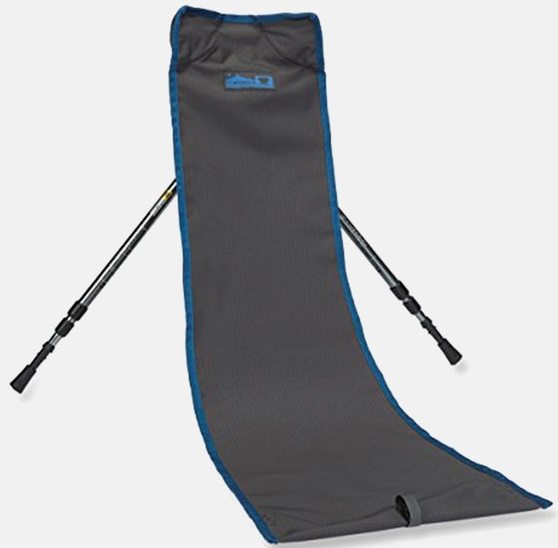
‘Awarded
the 2017 “Editor’s Choice” by Backpacker Magazine, the Mountainsmith
Slingback chair is a light and simple solution to backcountry lounging. Made of
610d Cordura fabric, it’s built to withstand water, abrasions, tears, and
whatever else you throw its way. At less than 5 ounces, it can be set up using
two trekking poles and packs down to the size of a water bottle when not in
use. To sit in the chair, simply hold your poles steady and lean back in one
smooth motion, using your body weight to balance yourself.
Specs
· Fabric: 610d Cordura
· Sets up with 2 telescoping trekking poles
(not included)
· Rolls up into its own storage pouch
· Minimum height: 24–30 in (61–76 cm)
· Dimensions: 40 x 14.75 in (101 x 37.4 cm)
· Weight: 4.75 oz (134 g)’
See
Also:
http://www.theultralighthiker.com/ultralight-chair-the-litesmith-qwikback-2/
http://www.theultralighthiker.com/the-ultralight-bush-chair/
http://www.theultralighthiker.com/ultralight-chairgrounsheet/
http://www.theultralighthiker.com/cyclone-chair/
28/02/2018:
Universal Magnetic USB Charger: Another interesting idea for charging
those 18650 (or etc) lithium batteries (and the like) Only 20.5 grams.
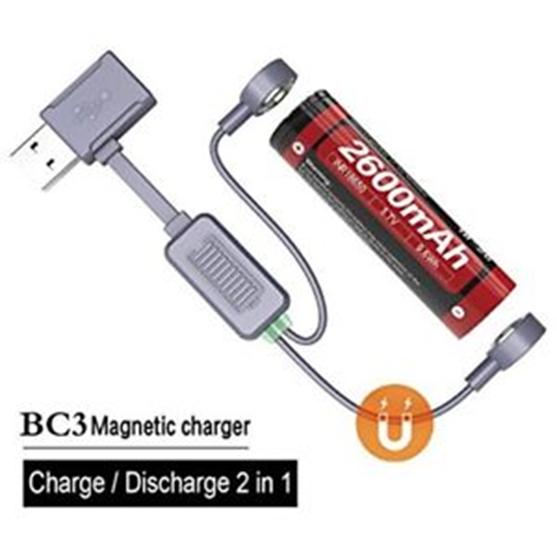 Weltool version, Folomov version from approx US$12.69 (Feb
2018)
Weltool version, Folomov version from approx US$12.69 (Feb
2018)
Presumably
you would use it in association eg with a usb/micro usb adaptor (Avail approx A$5.99
Feb 2018) to charge something else, say your phone. NB the 18650 batteries are
usually 3600 mAh (eg Panasonic version) and may be as much as 4000 mAh
(claimed). This is a reasonably sized Powerbank which will charge most
electronic devices.
The
batteries could be charged by a solar device such as this one, or this.

Here
is another one which only charges: Olight Universal Magnetic USB Charger
US$9.99/ A$13.95 (Feb 2018) This one will also charge Nicads.
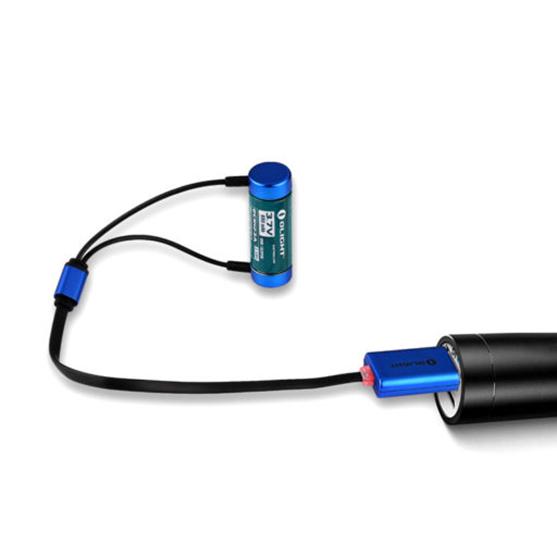
Review
here: http://lygte-info.dk/review/Review%20Charger%20Olight%20UC%20UK.html
You
will have to decide whether it has greater utility than the Nitecore I reviewed
here. It is certainly lighter, The single
cell Nightcore is 30 grams without cable. Mind you, you are likely to have a
cable anyway. As an additional point the dual battery Nitecore (at 46.5 grams)
has a capacity of 7200 mAh making it able to charge much larger batteries.
See
also:
http://www.theultralighthiker.com/ultralight-usb-cables/
http://www.theultralighthiker.com/powerfilm-usb-aa-solar-charger/
25/02/2018:
Worth knowing: T-rex would need to
consume @ one ten year old child per day in order to survive. I'm sure we
have all known at least one of the latter who would best be utilised in this
way (Think: little brother/sister!) Alternatively each T-rex would need about
80 Big Macs, so even a small town could support a few: http://what-if.xkcd.com/78/
24/02/2018:
Knee Pillow: I sleep on my side too (and have suffered from
sciatica) but I must have enough padding of my own, so I have never needed one
– but evidently lots of folks do. John Abela has helped out all such people who
enjoy hiking with this DIY instructional on how to make your own inflatable
knee pillow.
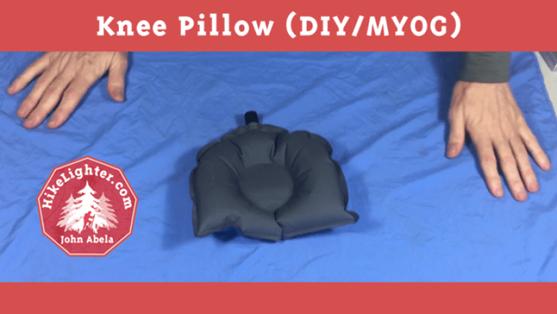
He
has some other great tips on his website. One of the things
which impresses me most is his long-term use reviews of various products. He
seems to be able to make a pair of light trousers or a wool t-shirt last practically
forever.
I
am much tougher on my gear, alas! Still it is good to know which products have
proven the most durable especially if you are tired of those review sites which
pretty much praise everything to the skies (because they are indebted to the
manufacturers), so that there is little to be gained from their
recommendations.
I
am often beset by such people wanting to give me ‘free stuff’ to praise, but
which I can see at a glance is unfit for my purpose though it might suit
someone else who is into car camping, for example. Where I typically use gear
is off-trail (I hardly ever walk a trail) in a hunting, fishing exploratory
mode so that I beat gear up pretty badly.
Over
the years also I have found that most of the gear available does not suit as
well as a piece you made yourself would which is why I have so many DIY things
(even if they are not particularly elegant).
I
am quite impressed by John’s knee pillow therefore: https://hikelighter.com/2017/11/04/knee-pillow-the-making-of/
He
cuts his down from a Klymit Cush which cost about US12.

These
pilows/seats weigh 82 grams and come in 29″ x 9″ x 1.5″ / 74
cm x 23 cm x 3.81 cm. I have been wondering about using one instead of their Air Beam Pad which seems to be discontinued
as a pack frame.(We are both very impressed by their Ultralight Pillow by the way – and by
their Pack Raft.)
Here
is his interesting step-by-step Youtube about how it is done: https://www.youtube.com/watch?v=MVPUQD0SB-0
The
finished pillow weighs .86 ounce or 24.4 grams. Well done, John!
I
think this project would be very good practice for someone who needs to repair
a leaky seam or shorten an inflatable hiking mat,
(ie one which use heat sealable matrial as most do) as I intend to do with my
new Big Agnes AXL Air Mummy when I get around
to buying it. Being vertically challenged it is 6” (150mm) longer than I need
it to be; naturally I want to shed that ounce! (30 grams) I will have to cut a
whole foot off Della’s – if we like them, as I’m sure we will! It might be good
practice if you are thinking about a DIY Pack Raft – incidentally the materials
to make the knee pillow from scratch could be purchased from the same folks.
PS:
I have John’s kind permission to re-post his idea here.
Here
is a review about knee pillows which you can purchase; many would not be
suitable for hiking: https://completehomespa.com/best-knee-pillow-for-side-sleepers/
I
am wondering how an empty wine bladder would go. Once upon a time when I drank
like a proverbial fish I had a large output of such things; nowadays I would
have to waste a gallon of wine to get one for myself! Della is more of a wine
connoisseur – an empty bottle would not make much of a knee pillow! We usually
decant our chosen tipple into a Platypus bottle – they now even make a special
bottle for that purpose! Here is another idea: http://www.theultralighthiker.com/diy-super-ultralight-pillow/
Incidentally,
have you seen the (new) 250 ml cans of wine at Woolworths for A$3. A couple of
these might be a good idea for a weekend hike. I always used to drink Bacardi
151 (as it was half the weight) which does not seem to exist any longer (in
Australia at least). You would not think that the Ultralight Hiker going on the
wagon would have had such an effect on Bacardi’s fortunes!
23/02/2018:
How to have Fun When Hiking in the Rain:
Having spent I more than fifty years working outside in the rain I was
delighted to see this take on the subject. It reminds me a
bit of the old adage, ‘When it don’t rain the roof don’t leak; when it do (you)
can’t fix it nohow!’
Most
times I love being outdoors in the rain. Having been a farmer most of my life,
rain generally means good things to me: it means for example the grass will
grow and so will the lambs. Having survived a number of quite distressing
droughts I know what I would prefer. The sight of ewes and lambs up to their
bellies in lush green clover never fails to warm my heart.
It
also means the rivers will fill with cool clear water. I also love canoeing,
eg: http://www.theultralighthiker.com/pack-rafting-the-remote-wonnangatta/
I
love the sound of the rain on a corrugated iron roof such as we have in our
owner built house – ie we made every brick, sawed every piece of timber, drove
every nail…just as I love hearing it spattering (or thundering down) on my
raincoat or poncho hood. I love to gaze out my window at our valley drenched in
the morning's light.
I
love tramping through the sodden bush peering out at the rain as it slopes
down, delighting in the small encapsulated space beneath the peak of my cap.
How
many thousands of days’ off I spent hunting deer in the mountain forests of
Gippsland in cold winter rain I cannot enumerate. The squelch of the wet road
on the tyres and the steady beat of the wipers barely able to keep up. Valleys
below drowned in cloud. As the sun breaks above the heavy cloud screen, the
mist rises and swirls up the valleys chasing around the mountain tops. A quick
cuppa and a biscuit in the shelter of the canopy as the rain drums down on the
car's roof, and then off. The hunt begins.
Here
is the mist rising up the Seaforth Valley upstream of Lock Maree,
Fiordland New Zealand one such morning in 2006. There had been a rare lone
moose out there on those Dashwood flats sometime overnight!
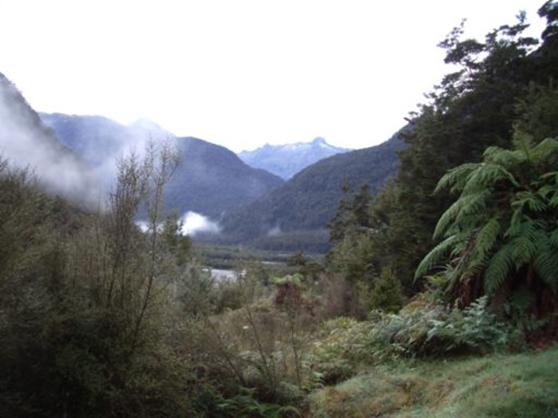
I
have often pushed all day through sodden bush which no rainwear will protect
you from, drenched to the skin trying to keep up with the hounds or get in at
the final ‘bail-up’, the omnipresence of damp making the forest preternaturally
quiet save for the sounds of water running everywhere, lending an advantage to
the hunter compared with the constant crunch and crackle of footfall on a sunny
day.
I
love the sound of rain drumming on the roof of the forest, the rills and
runnels pouring down the trunks and washing a foam of saponins as it roils, the
swollen drops shaking from branches overhead, as you look up the dimmed light
glistening through a million suspended raindrops on the canopy overhead. Heavy
wading up a swollen stream hearkening to the faint roar of a hound further up
the gully its sound all but drowned by the morning deluge.
I
can recall such a scene as this in my mind's eye. A great stag brought to bay
up to his chest against a rocky drop in the gully, the mist swirling about his
antlers, my ancient bloodhound, Belle raising her head to the sky and booming
at him as if her heart would break, the stag scything a swirl of water off his
antlers, his back arched, tail up, a sodden splash as his mighty foot strikes
the ground in warning...
I
often used to hunt by myself with a couple of hounds back in the 80s and
90s...why, there are Poono and her mother, Belle (and a much younger me) with
just such a stag still. This one was I stopped, jumping down from the bank
(right) injudicious enough to be crossing a woodland track I was hurrying along
- a sunny day though by the look of it!
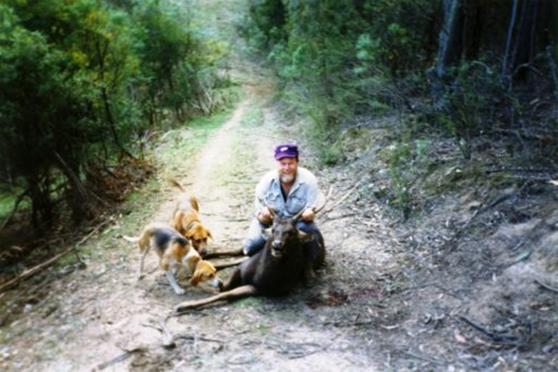
During
a wet day I sometimes had a hot cuppa to warm the cockles of my heart (and my
hands) while listening to the dogs voices waking the distant gullies. An egg-ring or esbit stove and a metal cup are all you need. After you have
had a hot soup or chocolate for example, you will feel much better.
If
you look there is always a fallen log to shelter under, a hollow tree or just
the lee of a large tree or rock face. The much rubbed wild cherry makes for a
dry space for a pause on a misty morn. Sometimes you have to chase a sheltering
deer out from under it.
Of
course it is peaceful too at the end of the day to get back to a dry tarp
propped against a tree, a cheery fire, a dry change of clothes and a warm (or
cold) drink! A long yarn around the fire as the daylight dims and the embers
hiss and glow. Maybe the sizzle of a fragrant sausage with onions in the pan.
Something
like this perhaps taken many years ago (with Brett Irving). He still has a
smile on his face as you can see - after a wet day in the bush, and even though
it is still raining. I remember him saying he wished he could stay the night
under the tarp - he used often to have to go home ('work' is such a nasty word
on such occasions) while I waited in solitary splendor for late hounds to
straggle in.
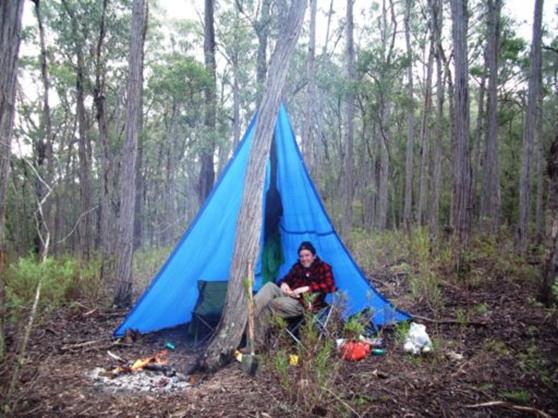
The
10’ x10 ‘ (3 x 3 metres) poly tarp kept us dry and comfy yarning round the fire
on many a night waiting for late hounds to return from the hunt. And many's the
night I slept under it. It kept me dry in all sorts of weather, cost less than
$10, was used innumerable times and still has a place in my garage against
future need. I also made a number of poly tipis over the years which will form
the basis of a future post - great for camping in the snow as well if you know
how to have a fire inside!
Of
course it is important you don’t get cold. As I have pointed out before, water
can strip heat from your body 20 times faster than air. You need to know that
and to take action if necessary - as hypothermia is no joke. I have encountered
and treated folks who were suffering from it a number of times. Wear clothes
which will keep you warm when wet. Stay warm. Dry is not so important.
Our
solution as deer hunters was always to wear wool (as you can see Brett doing).
We used to wear the old ex-army khaki woolen trousers with a multiple layers of
wool on our upper body usually topped off with a Swandri bush shirt (as seen), and of
course wool socks and beanie. This is anything but ‘ultralight’ but it is
‘ultrasafe’ and ‘ultracomfy’ which is more important in the scheme of things.
Here
is that woolen clothing in action back in 1990:

There
are too many folks who become obsessed with 'gram counting' to the extent of
jeopardizing both of the latter – which is just silly, and dangerous. There are
other materials than wool on the market these days and I have tried them all.
In my opinion though none is better than wool. Certainly none which will keep
you both warm and sweet smelling! Of course I have spent many years sheep
farming, so I may have some bias in this.
It
is one thing if you are a track hiker with (maybe) the ‘certainty' of a dry
shelter at trail’s end – how many times does that go awry though, with dire
consequences? You should never be out in the bush without (the ability to make
or find) some dry shelter. Or the ability to light a fire (and keep it going) in the wet. I have
encountered people suffering, even dead in the bush who failed of just such
basic skills. Don't let it be you.
A
shelter may just be an umbrella, or even sheltering under your raincoat, but really
it should include a poncho/tarp (so you can lie down)
which can be as light as approx 150 grams (eg for an 8’ x 8’ cuben square) or
at very least the knowledge and ability to find and construct a shelter with
natural materials – and the tools to do so (See Hatchet). The minimum to take with you
even on a day hike is a mylar space blanket which you can pitch like this if you have a few bits of string, and maybe some of these from your fishing kit, or eg one of these fancy emergency shelters.
There
is nothing at all wrong with a cheap 5' x 7' (150 x 210 mm) nylon poncho -
though a bit longer (8' or more) is even better. I used one as a raincoat for
many years, and I have slept under it in the rain numerous times. It might be
minimal, but it is enough, if you are careful - and it is infinitely better
than being wet and cold. Mine cost me under A$20 over thirty years ago but it
has done good service. I see they are now more like A$80 but worth
every penny. A poncho will keep you drier on those extremely humid days than
any raincoat, as they admit more air flow.
You
never know when you will lose the trail (or your way), or the trip cannot be
completed due to flooded rivers, a twisted ankle, a companion suddenly
staggering with hypothermia, etc. The old Boy Scout’s motto of ‘Be Prepared’ is
ever a good one, though I was never a scout myself, as I grew up in the
trackless bush far from any town. Baden Powell though, the hero of Mafeking was not a sissy!
Just
as an example, here are Della and I out in the very wet bush of the South Coast Track Fiordland New Zealand in
2016, and loving it! I should point out that our combined age on that trip was
125+, and we are still going strong! Della is a bit less fond of wet and cold
than I am as she has more trouble staying warm (more layers needed). That
adipose comes in handy betimes!
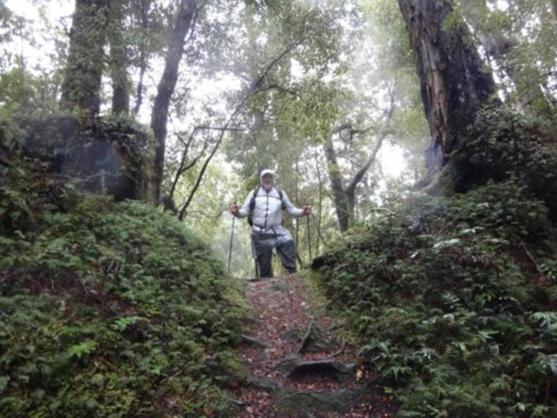
The
burns were in flood
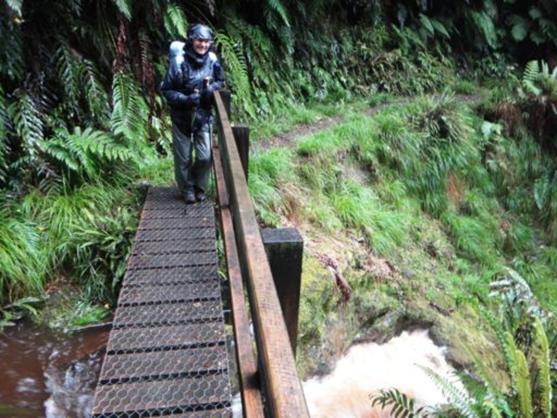
And
it was wet enough even to ‘drown’ a waterproof camera.
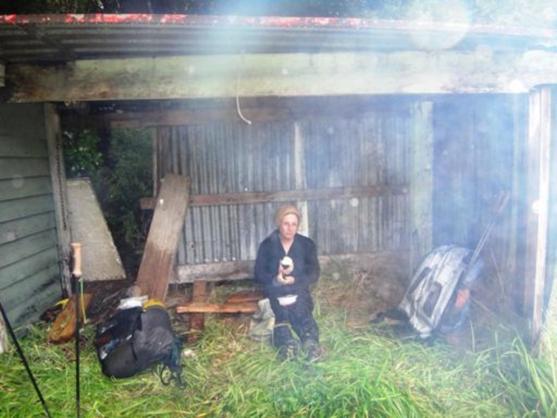
All
of the above is a ‘by-the-bye’ really. I hope you take a look at these folks'
excellent website though. It certainly reminded me (if I needed it) that
walking is for fun, and was replete with excellent advice, which I admit I have
not had time to properly absorb - having spent nearly two weeks working on Tiny’s eulogy (below):
https://myopencountry.com/
PS:
I have Jenn's kind permission to re-post her ideas here.
See
also these posts mentioned in main article:
http://www.theultralighthiker.com/the-importance-of-a-roof/
http://www.theultralighthiker.com/from-dawn-to-dusky-4/
http://www.theultralighthiker.com/the-egg-ring-ultralight-wood-burner-stove/
http://www.theultralighthiker.com/ultralight-esbit-stove/
http://www.theultralighthiker.com/ultralight-cookpot/
http://www.theultralighthiker.com/how-to-light-a-fire-in-the-wet/
http://www.theultralighthiker.com/fire-on-the-snow/
http://www.theultralighthiker.com/hiking-in-the-rain/
http://www.theultralighthiker.com/raincoat-shelter/
http://www.theultralighthiker.com/the-pocket-poncho-tent/
http://www.theultralighthiker.com/pitching-the-poncho-warning-this-may-save-your-life/
http://www.theultralighthiker.com/worlds-lightest-tarp-clip/
http://www.theultralighthiker.com/the-ultralight-fisherman/
http://www.theultralighthiker.com/new-ultralight-survival-shelter/
http://www.theultralighthiker.com/a-walk-in-fiordland/
http://www.theultralighthiker.com/pack-rafting-the-remote-wonnangatta/
Tiny’s eulogy (below): https://myopencountry.com/
23/02/2018:
A Tiny Life: 1st May 2000
- 8th Feb 2018: Over the years you will have noticed many posts which featured
our beloved Jack Russell Tiny, (who would have been 18 this May). During that
long life, these 'Tiny' paws covered a lot of country.
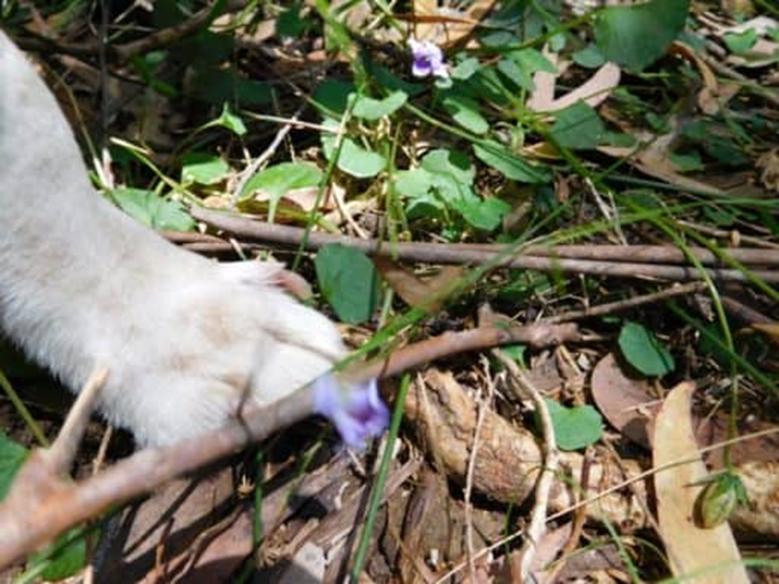
It
all began like this when my son Bryn was 15 years old. That Tiny pup spent a
lot of her time in his bed or even inside his shirt!

She
was such an alert little mutt.

I
had not noticed until now how much she looked like Spot when she was a puppy. She
has been grey around the muzzle so long you forget what she was like 'in her
prime'.

She
was raised carefully and lovingly by her West Highland (adoptive) 'mother'
Maggie. This was their favourite place in front of the fire.

Maggie
trained her faithfully. She has clearly locked her outdoors in this picture
perhaps because of some naughtiness.

As
a puppy there were lots of good times also with her 'Aunt' Bridie and other
dogs about the farm. At one time we had (at least) 17 dogs, sometimes (eg when
there were puppies passing through) there were even more. You see we had Tiny,
the two Westies, several Maremmas (to guard the sheep) and a pack of Foxhounds
- always more than the 8 you were allowed in a hunting pack then - as there
were also puppies in training and bitches which had to be left home when they were
'in season'. The foxhounds had to be replaced by beagles in 2005. Hunting was
never the same after that.
In
the photo below my daughter Merrin has had to lock herself in Della's new
pigeon loft to save herself from rampaging dogs. They have her bailed up just
as if she was some monster stag!
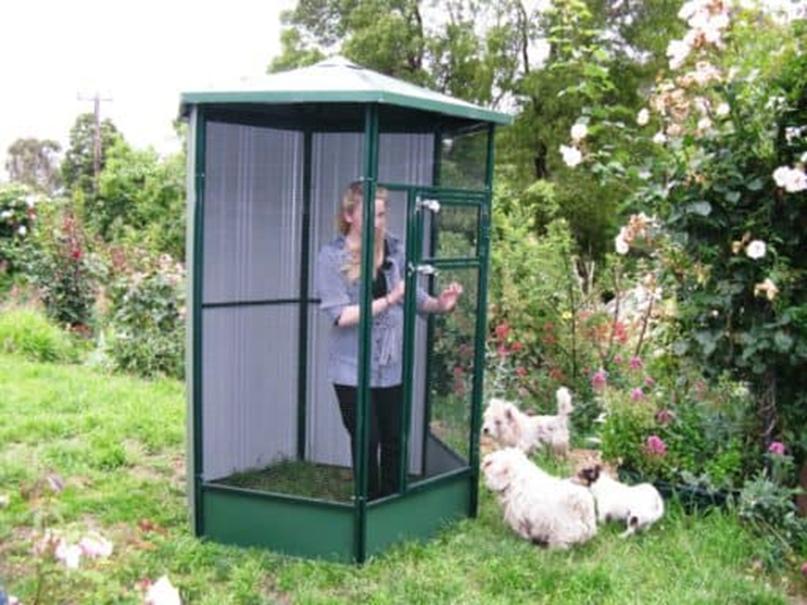
Maggie
and then Bridie passed on, so did our two Maremmas. This happened pretty much
in the same week that our beagles went to a new home as I could no longer hunt
with them because of my back and deafness. Tiny was suddenly the only dog. She
took to her bed. She was inconsolable with grief. She just had to have a new
companion.
That
was how come Spot came about. This was on our fortieth wedding anniversary five
years ago. You should have seen the adoring look in her eyes the moment she
first saw him. It was 'love at first sight'. Straightaway they shared a bed.
She was a much happier dog:

Though
this little scamp wasn't allowing her much room in there. See how much he
looked like her.
He
insisted on sharing her position on the couch too - and her dog blanket!

He
was her 'baby', the only one she ever had, though she had helped (as an auntie)
raise Maggie's and Bridie's puppies. You can see she loved him dearly.

As
Spot grew bigger there wasn't always room for him in Tiny's bed.
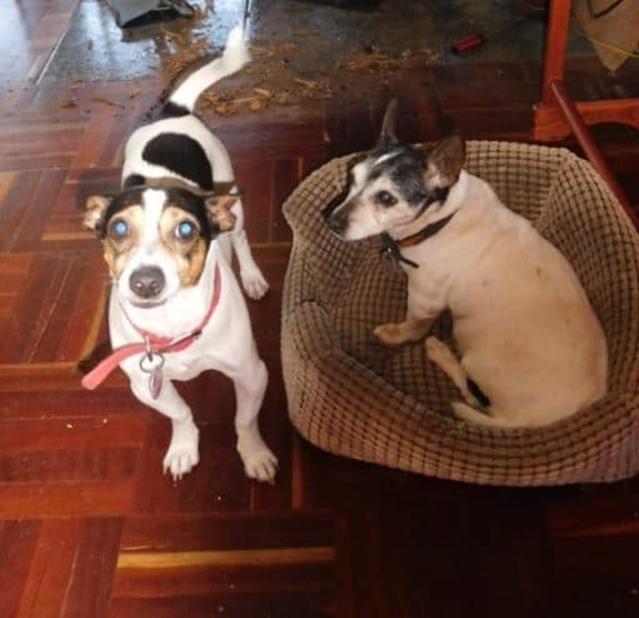
Even
if there was room for an orange toy animal!

She
was a good mother though, and would help with raising any small orphaned
creature such as this lamb. 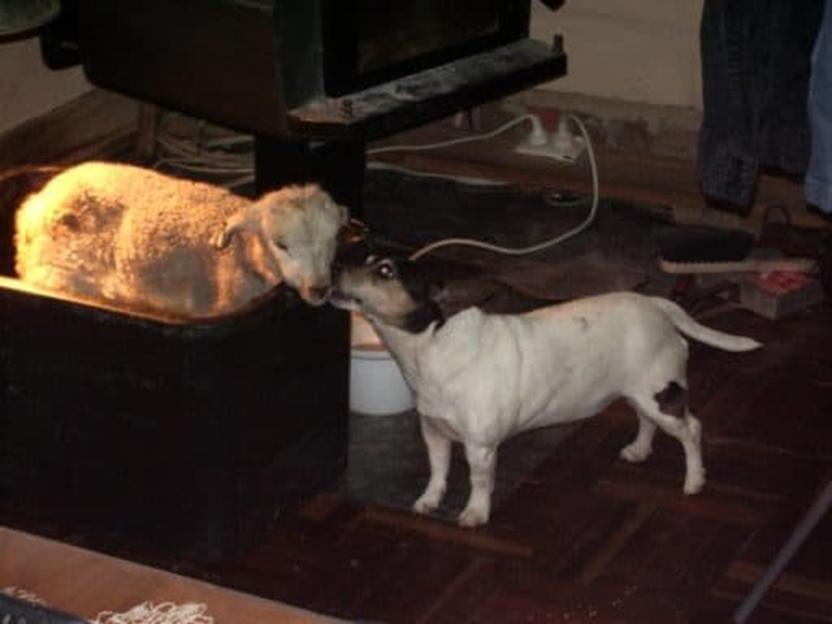
Many's
the time they curled up next to me in the old Landie Defender just like this
coming or going to some camping or hunting adventure.
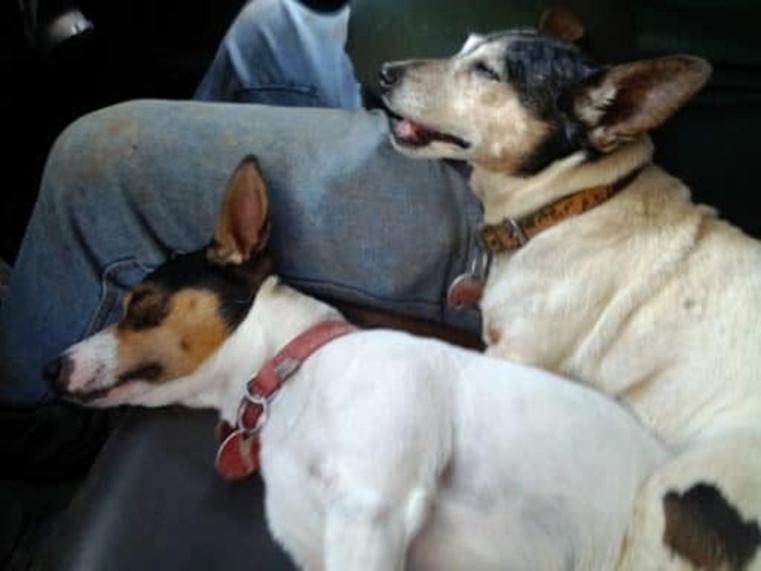
She
did so love water.

Drying
off after a refreshing plunge.
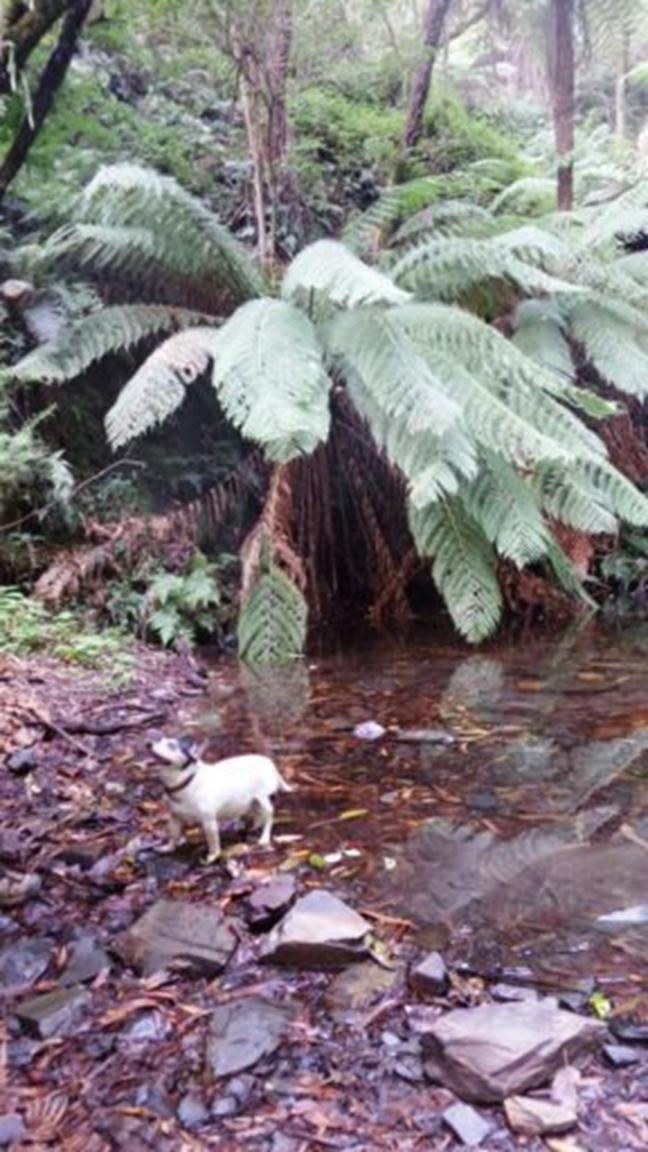
Contemplating
another plunge into a deer wallow by the river.
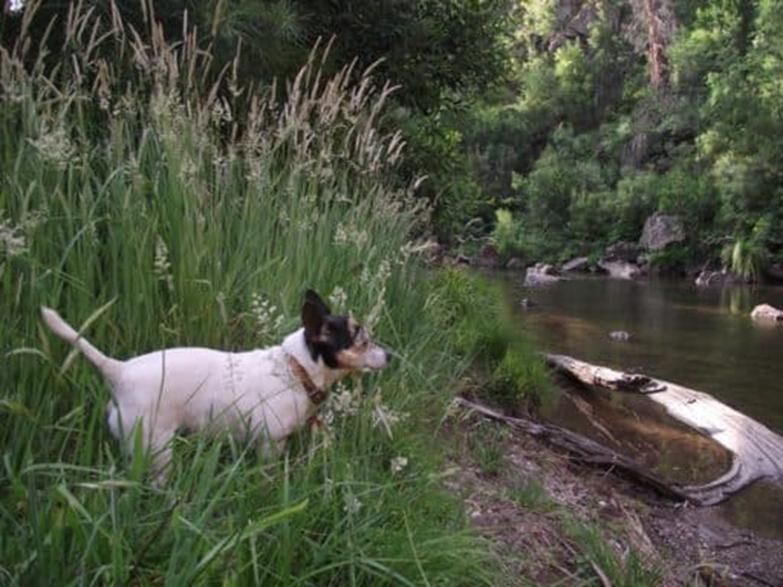
Cooling
her belly on a hot day in an icy stream.

And
reflecting on her swim.
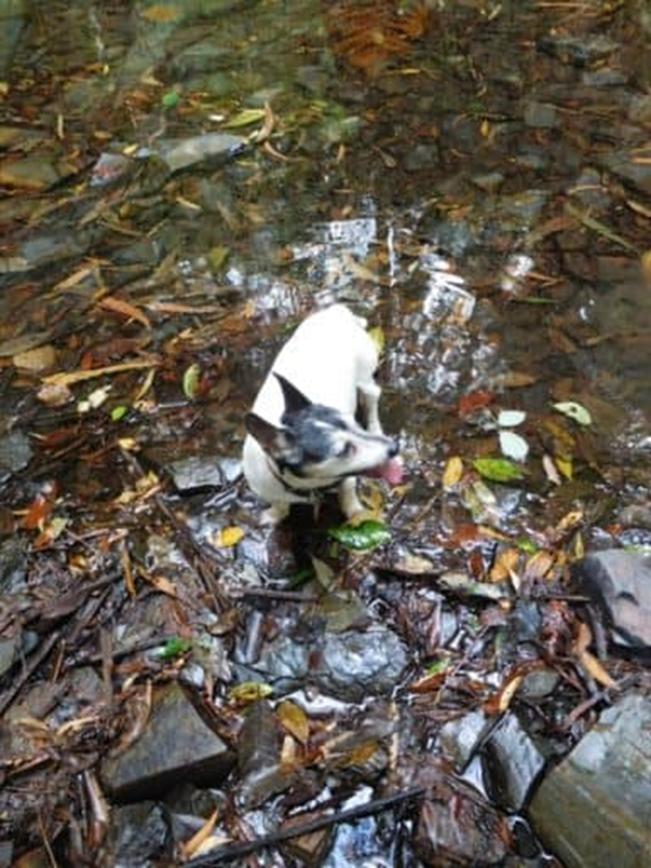
No
matter how muddy the water. Indeed she would plunge into a deer wallow and come
out quite a 'black dog'. Spot walked around this huge puddle but Tiny would
just plough right through!
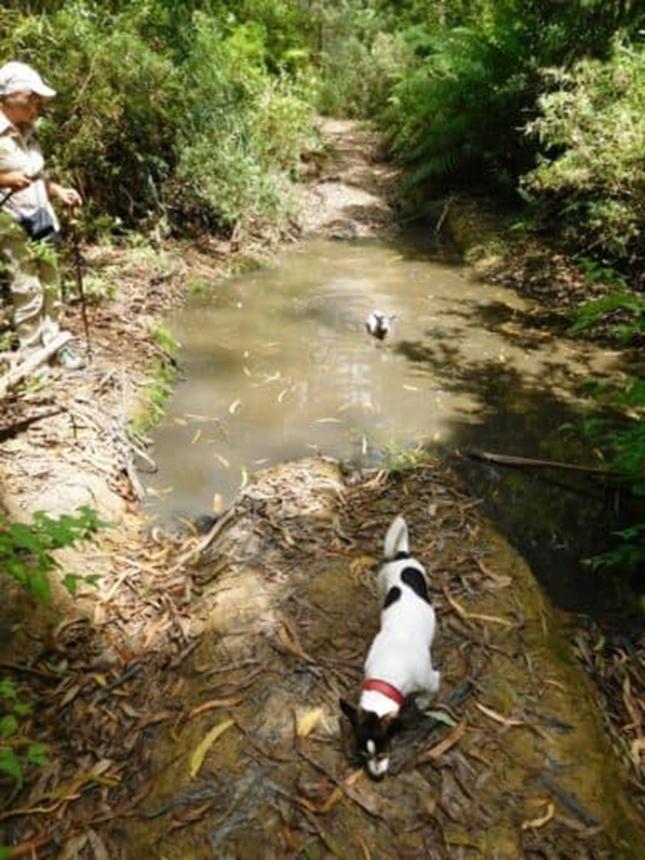
She
even liked the frozen kind like this at Mt Useful
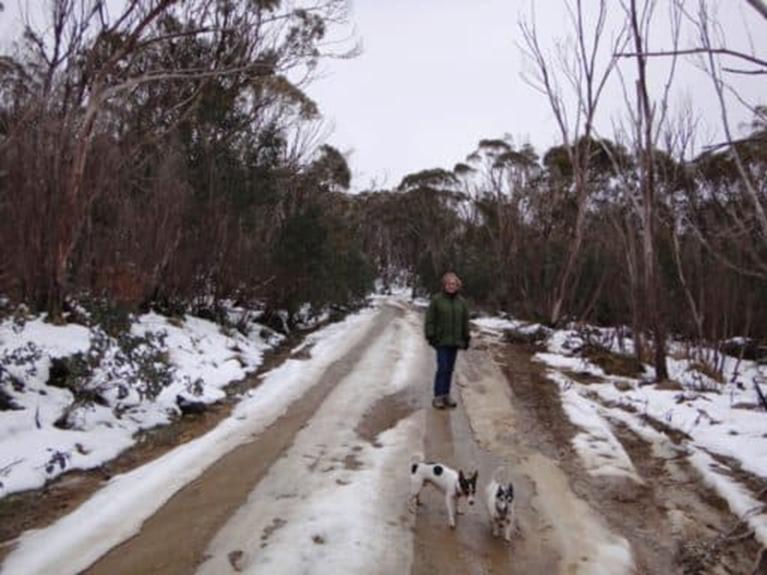
Or
this: Spot's Third Snow Trip
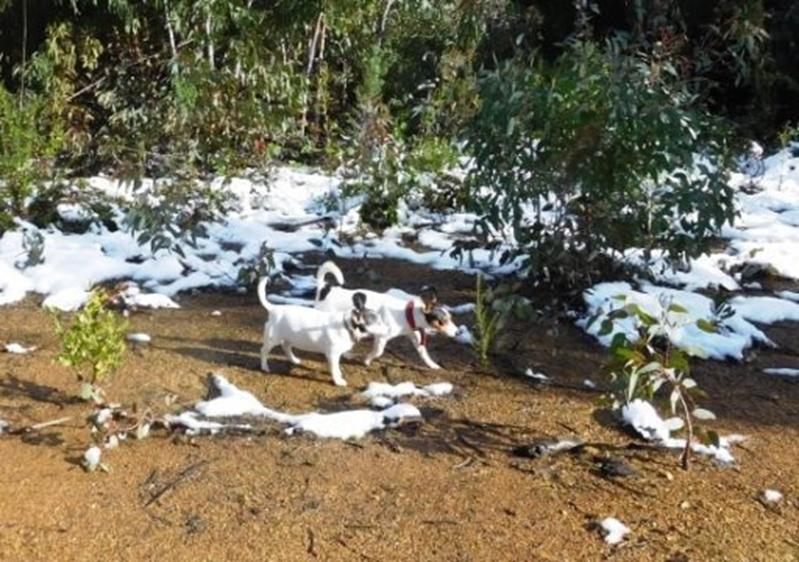
She
did so love tent camping and would always help with setting up.
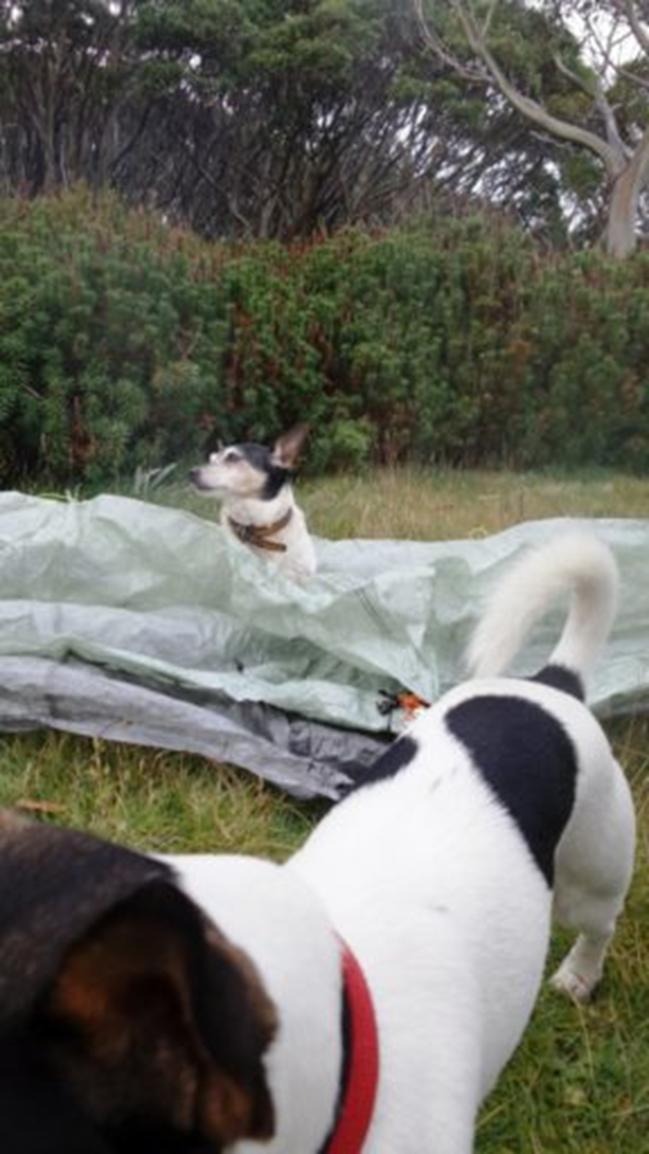
She
was keen to always be first inside.

And
loved to snuggle up.
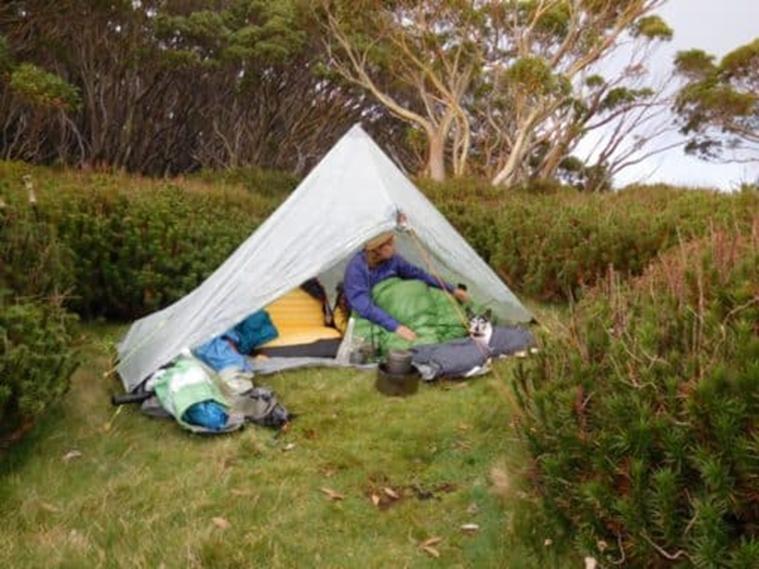
And
make herself comfortable.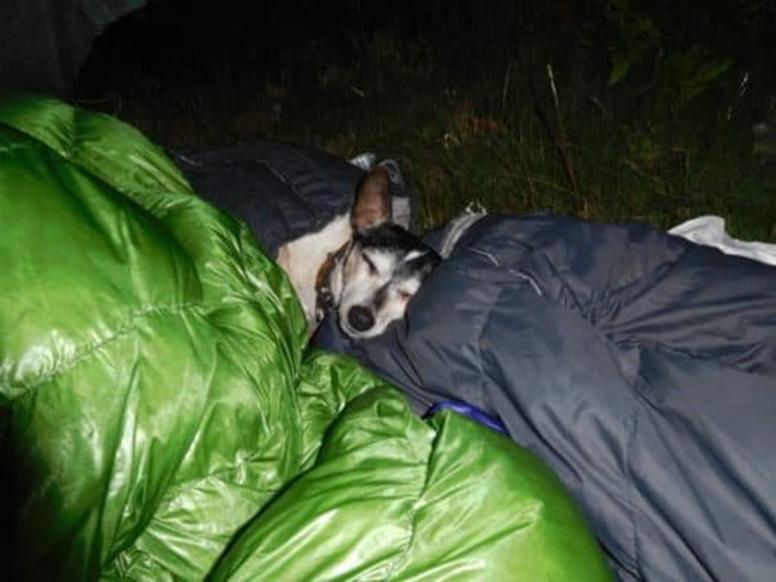
Here
she is again helping with the set up in The Last of the Mountain Men.
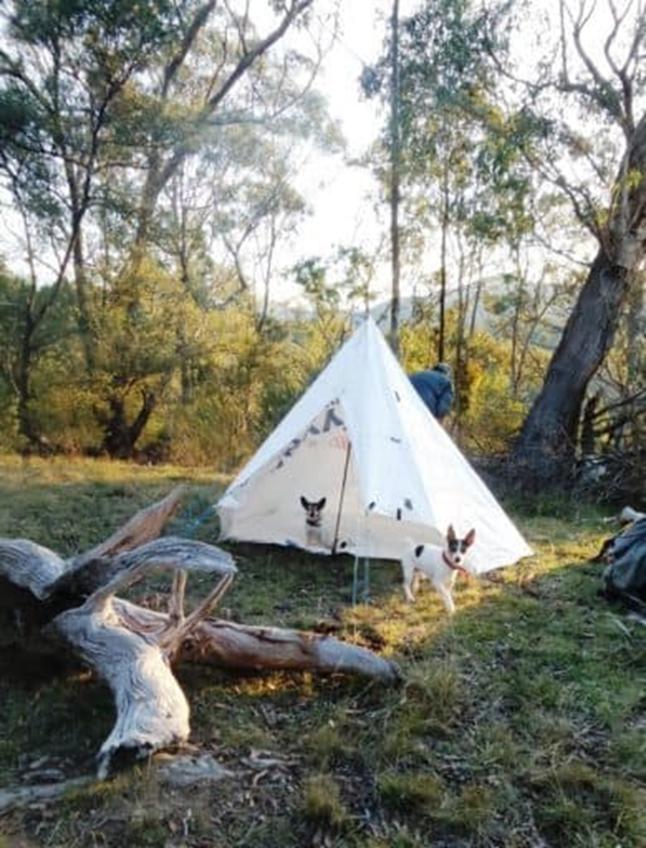

And
here in http://www.theultralighthiker.com/canoe-wonnangatta-kingwill-to-meyers-flat/
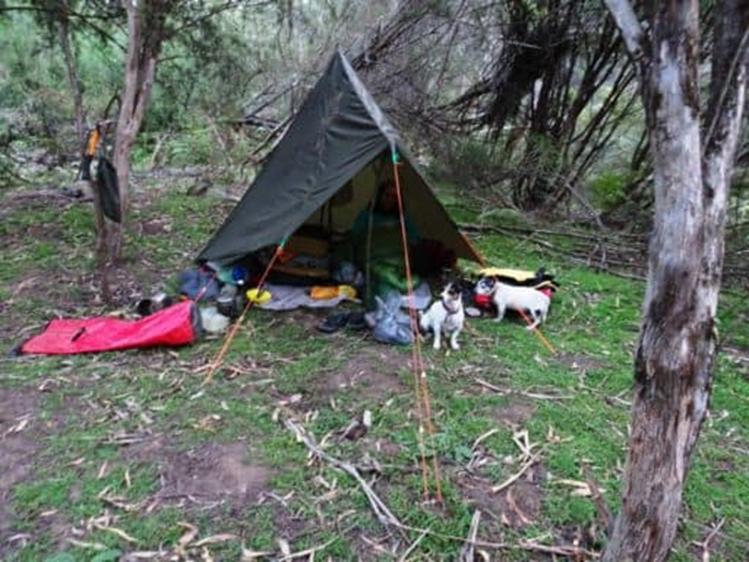
And
here in Not Quite Alone in the Wilderness.
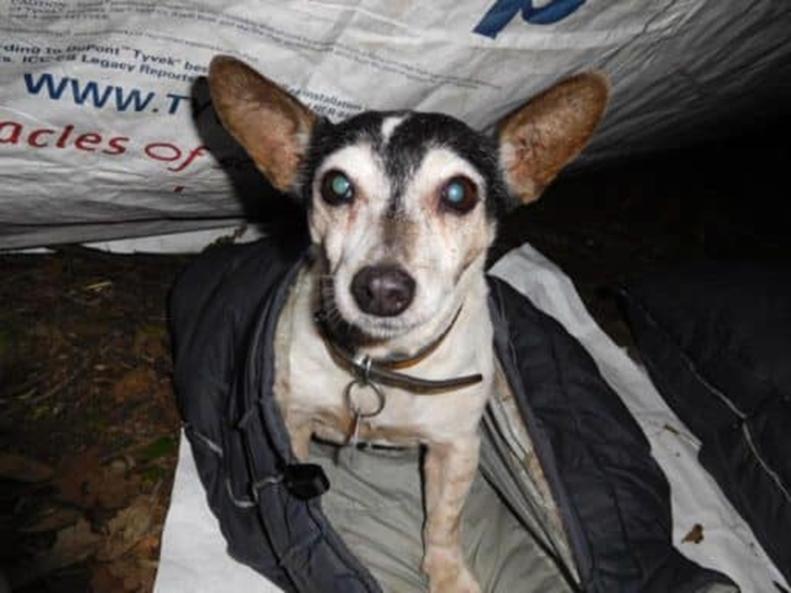
Just
myself and the two dogs. Paradise.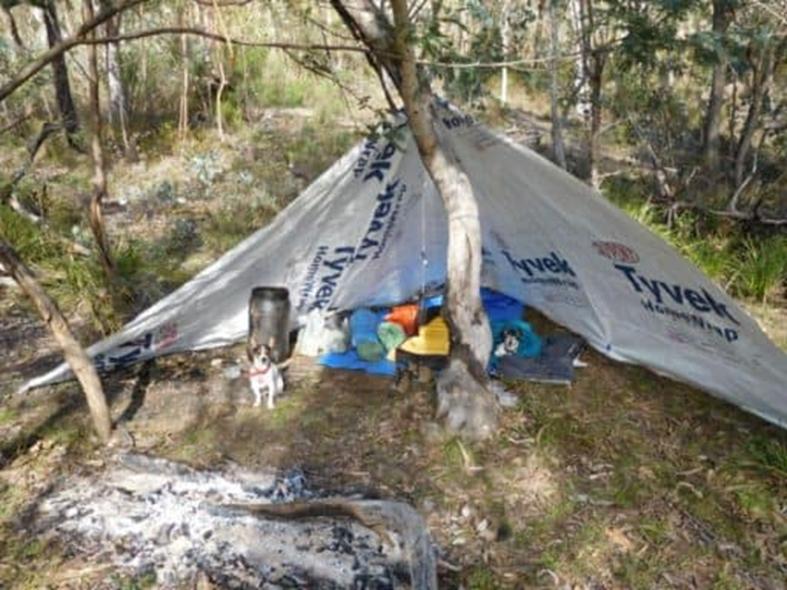
Tiny
enjoyed my sleeping bag.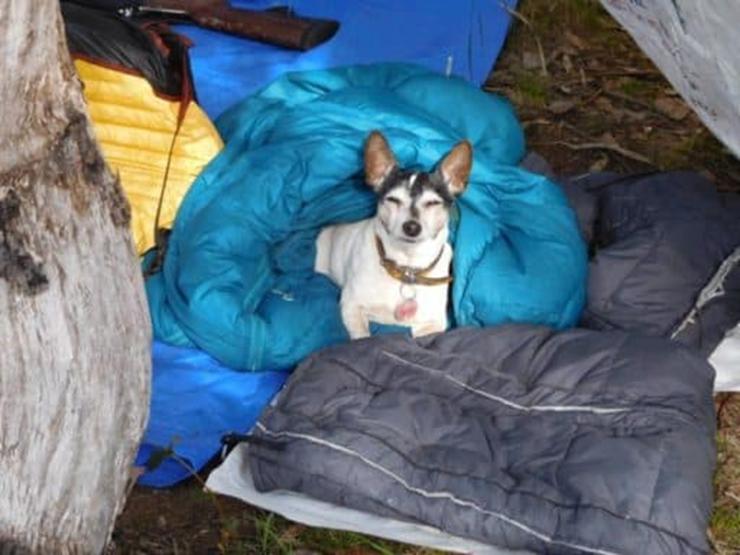
And
Della's.
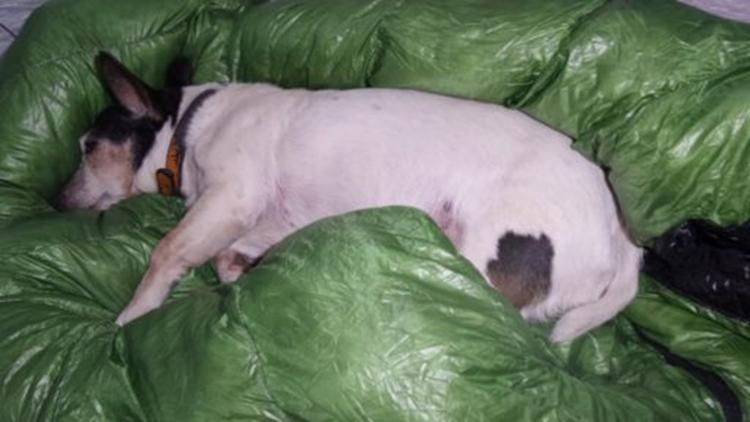
She
had some competition here.

but
not here in Hunting the Wonngatta-Moroka
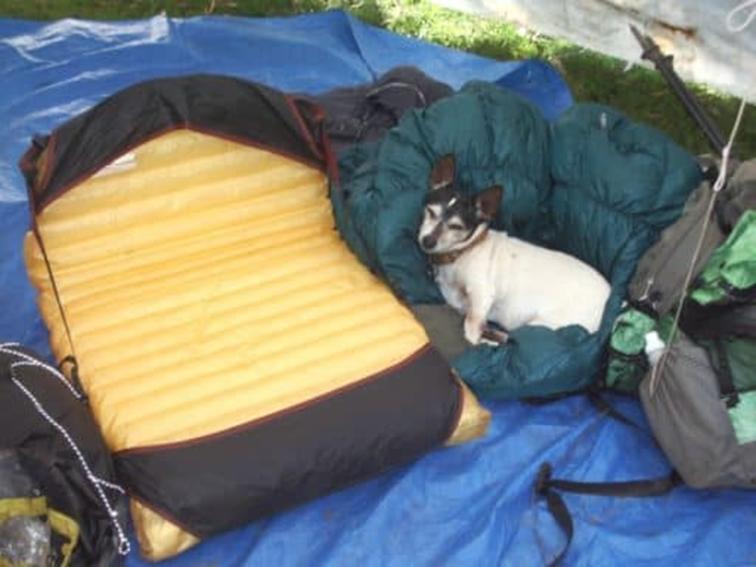
Here
she is helping set up my new Pocket Poncho tent.

She
loved to be 'on the trail'. She was a great walker. She accompanied us
everywhere we went, sometimes covering thirty or more kilometres in a day. She
was still following us (slowly) on our evening walks the day before she died.
Here
she is on the Avon.

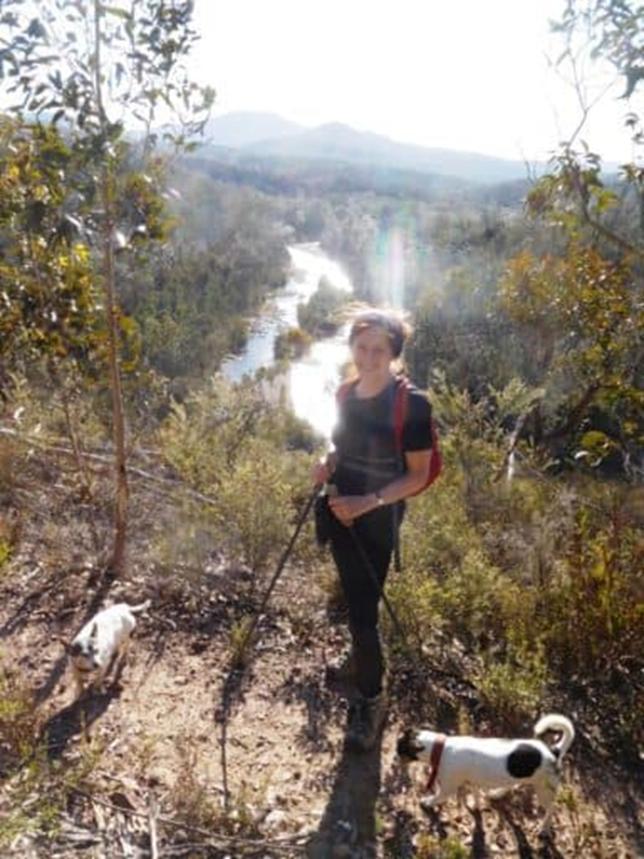
Newlands Rd.
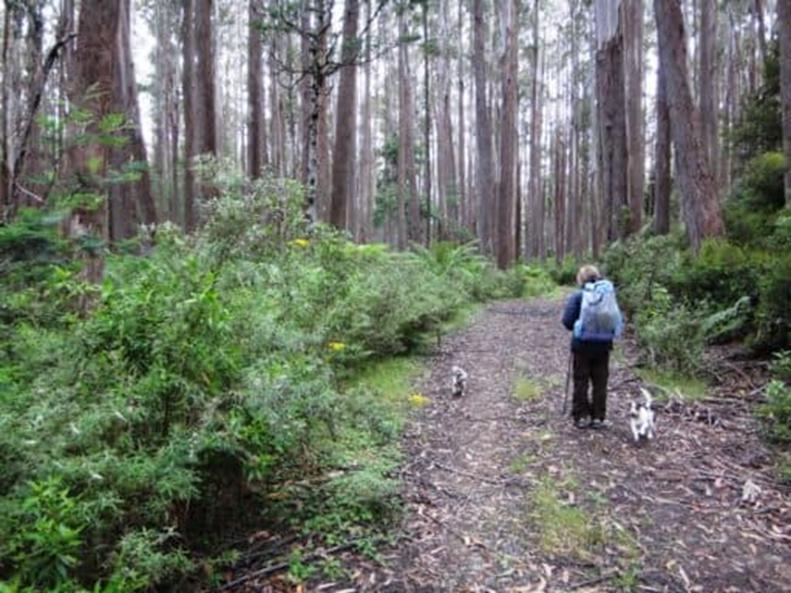
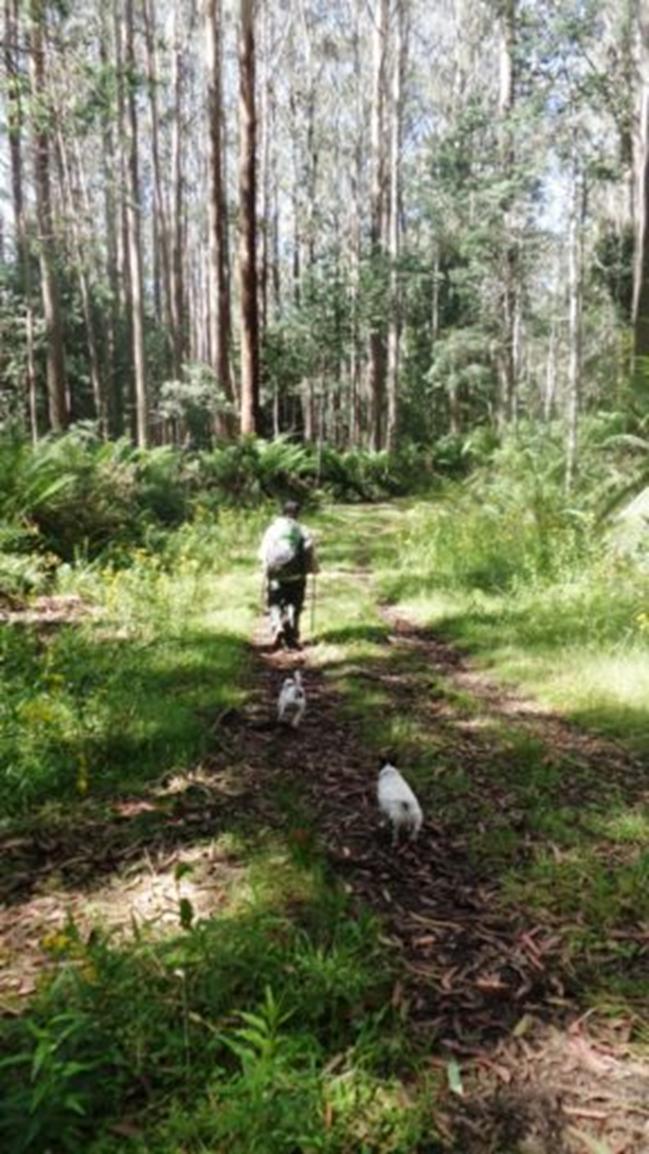
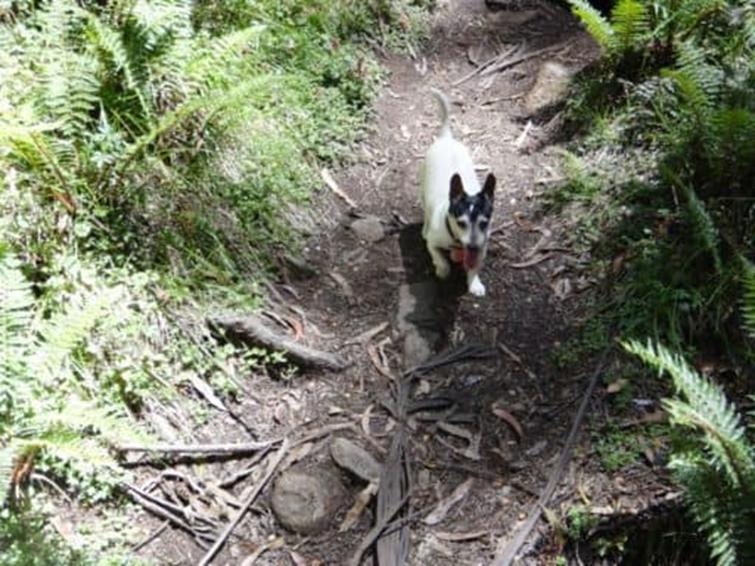
http://www.theultralighthiker.com/upper-yarra-track-section-seven-mushroom-rocks-carpark-to-phillack-saddle/
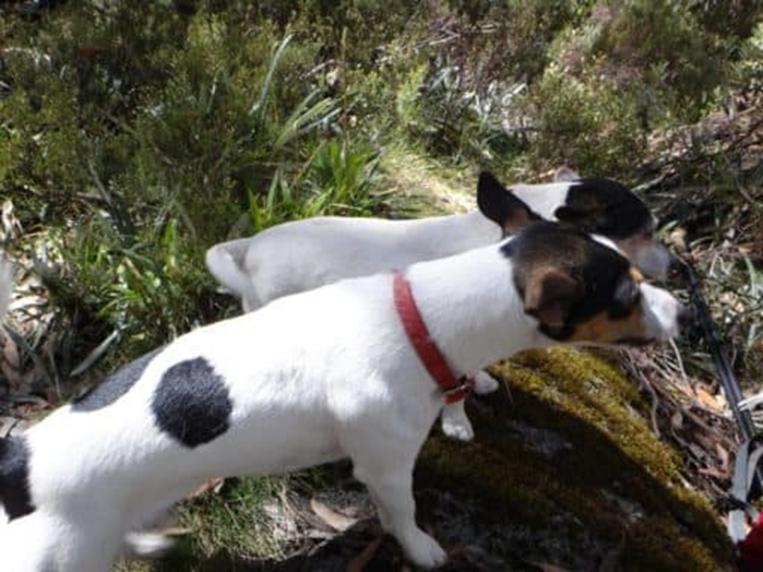
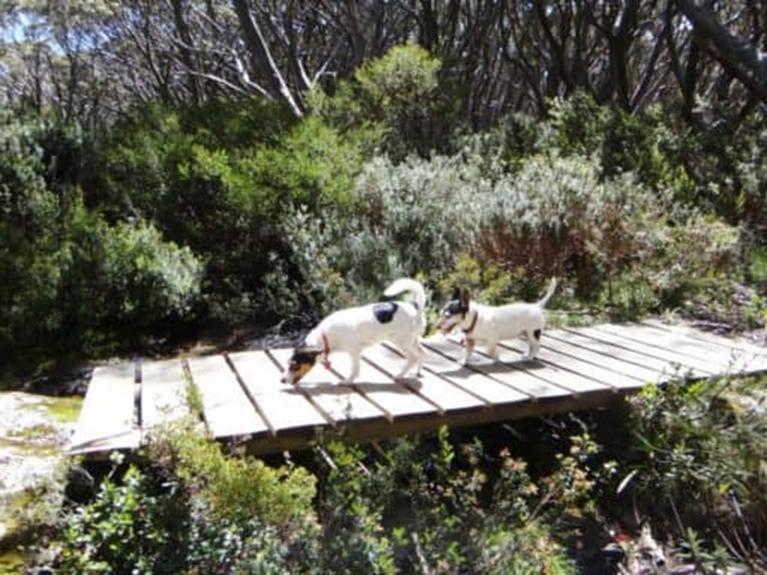
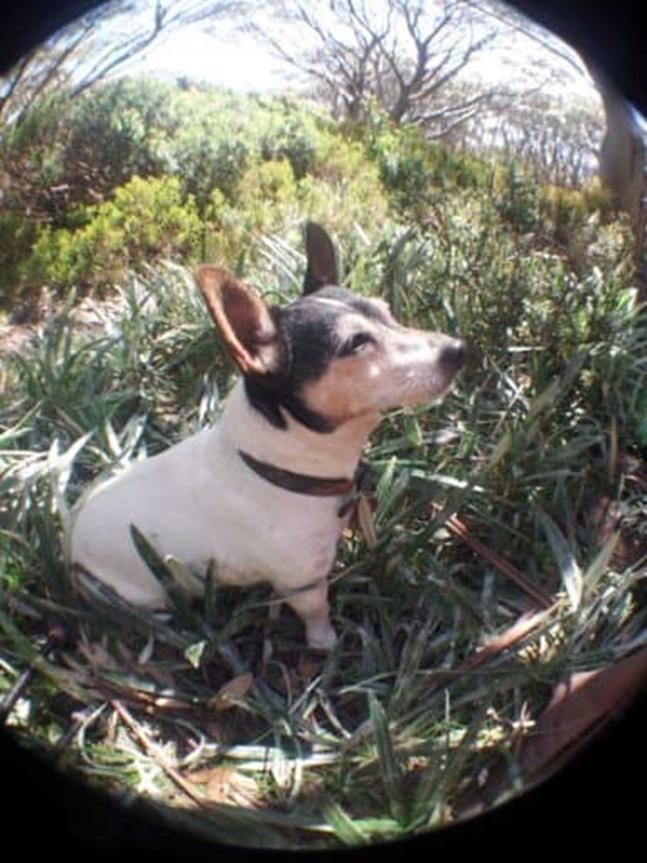


Though
sometimes she got cold and wet and liked to snuggle under her own tarp.

At
home in the Jeeralangs.
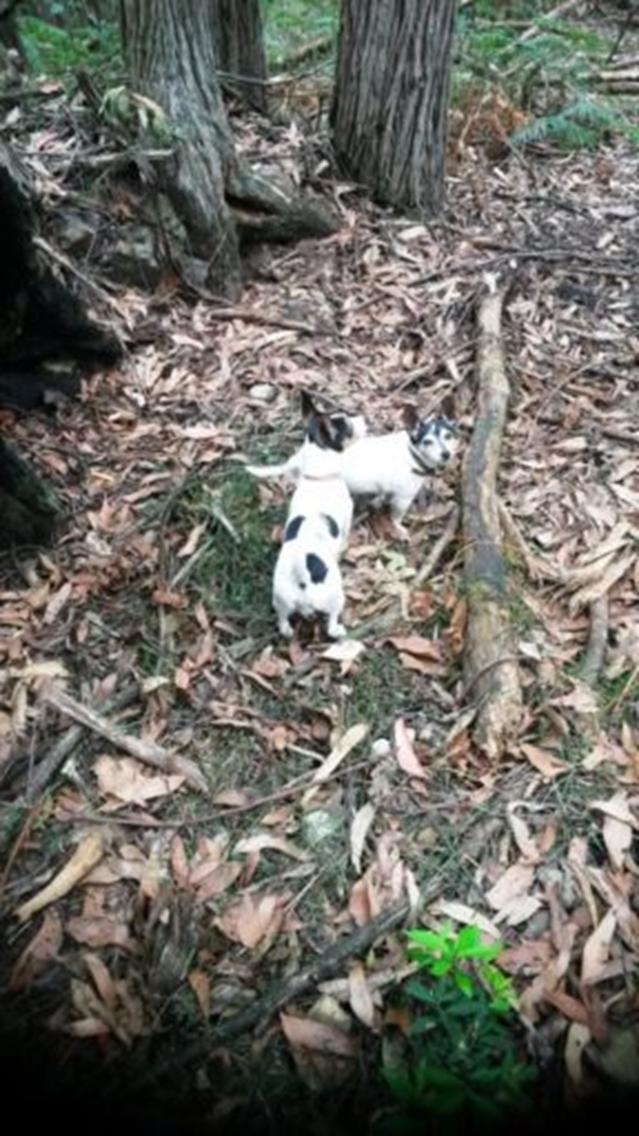
With
her friend Schnitzel.
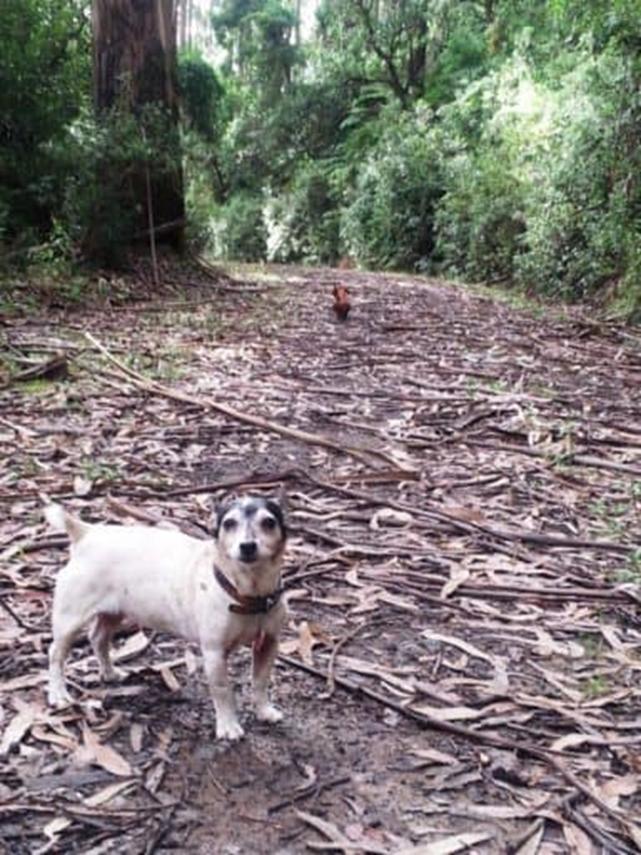
Wirilda
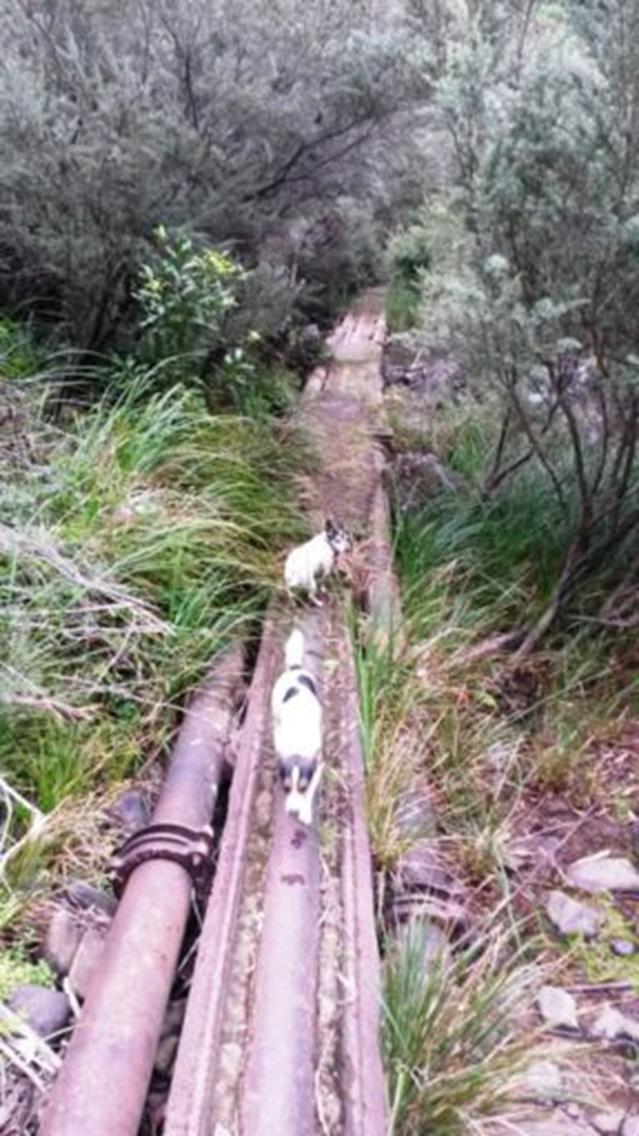
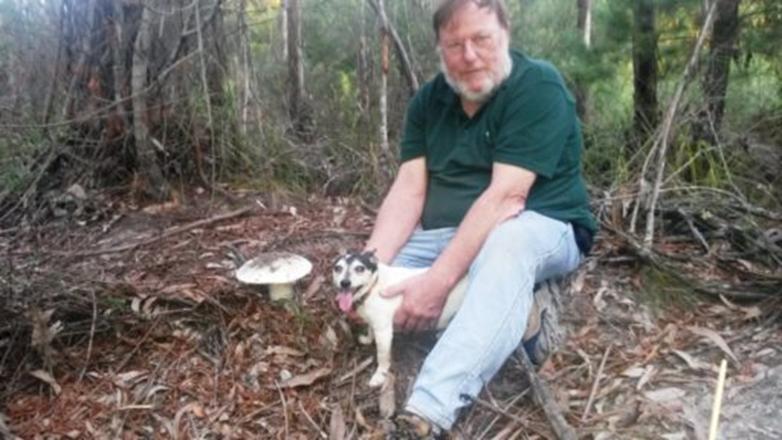
Here
she is at the Horseshoe Tunnel.
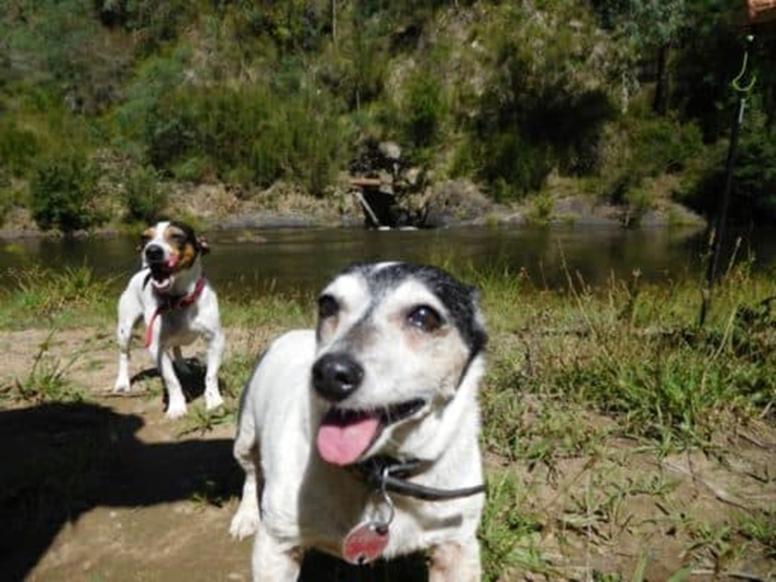
At
My St Phillack http://www.theultralighthiker.com/upper-yarra-track-st-gwinear-track-junction-to-whitelaws-hut/
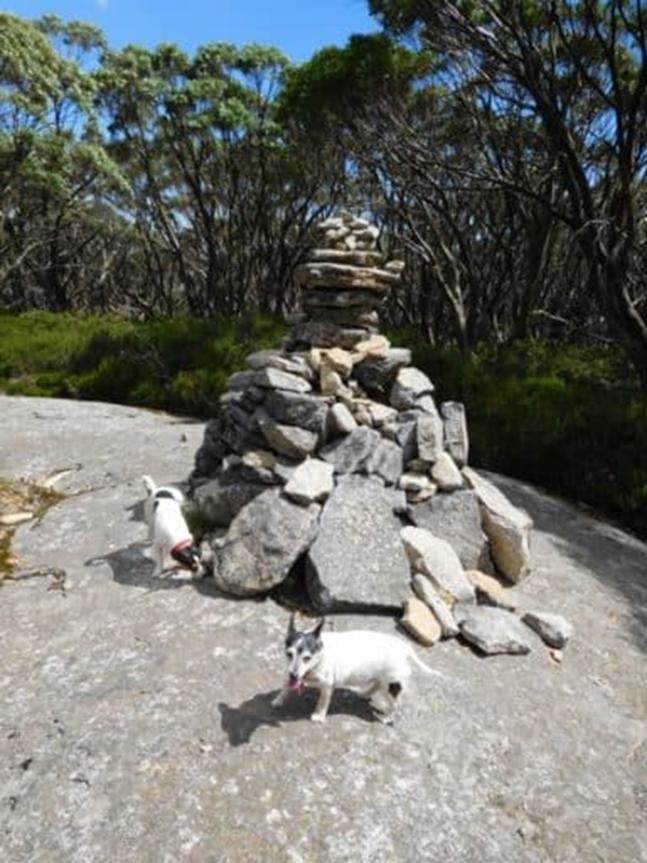
http://www.theultralighthiker.com/a-birthday-treat-mirboo-north-rail-trail/
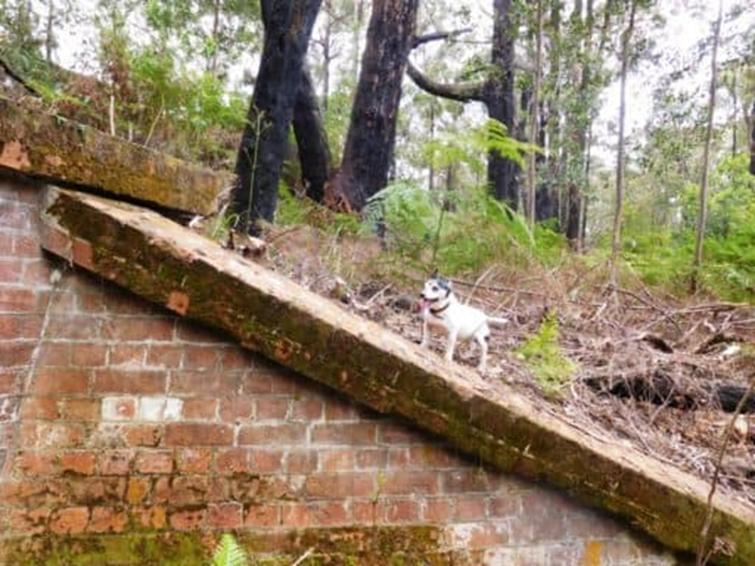
Though
she did get thirsty on such a hot day. Even so she was polite enough to let her
'pup' have the first drink.
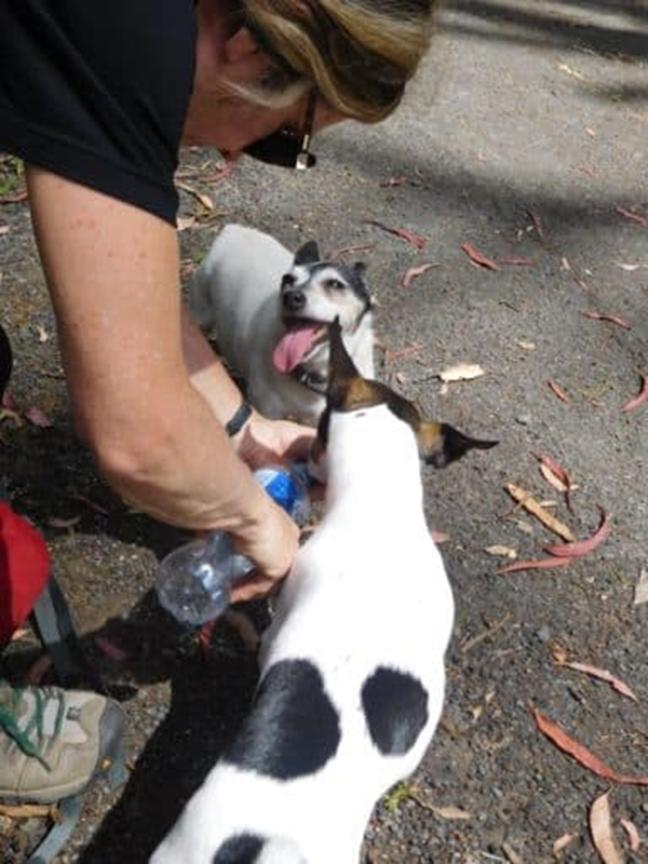
Here
she is in East Gippsland.
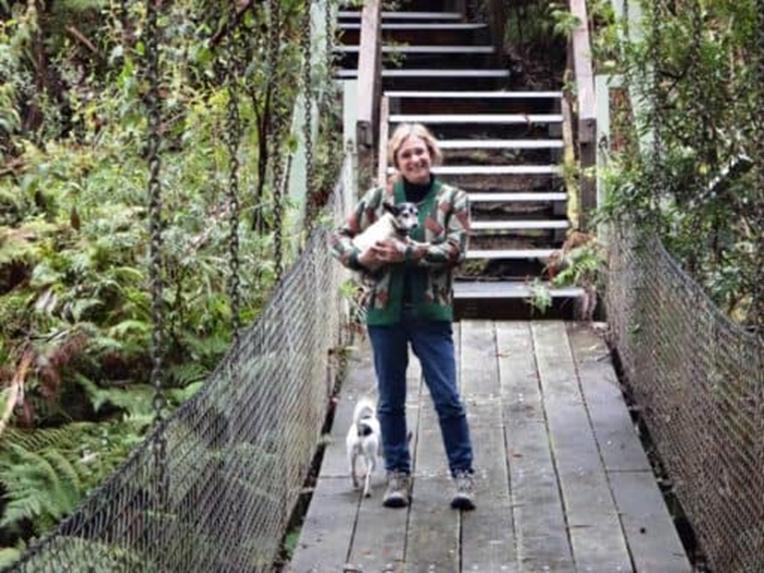
Sometimes
the trail was overgrown but she would 'soldier' on.
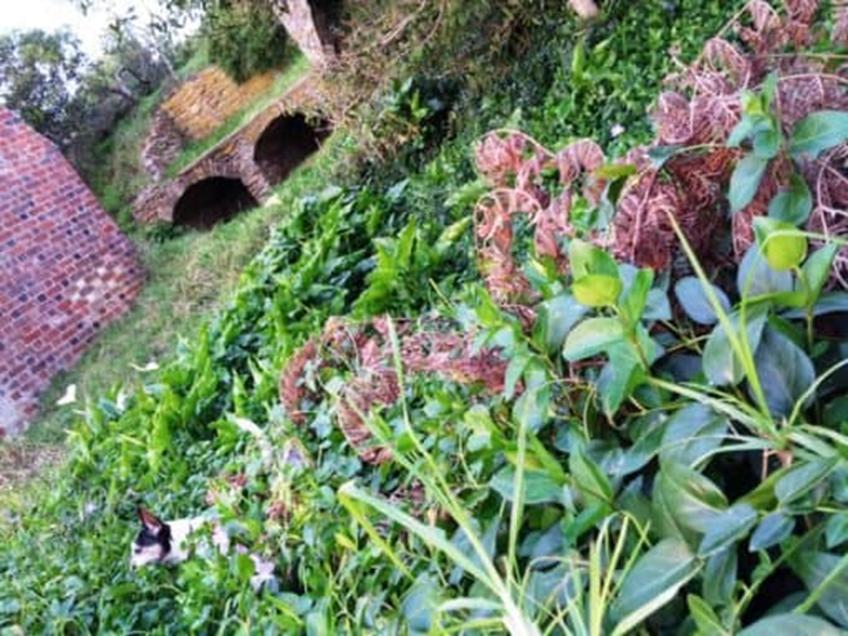
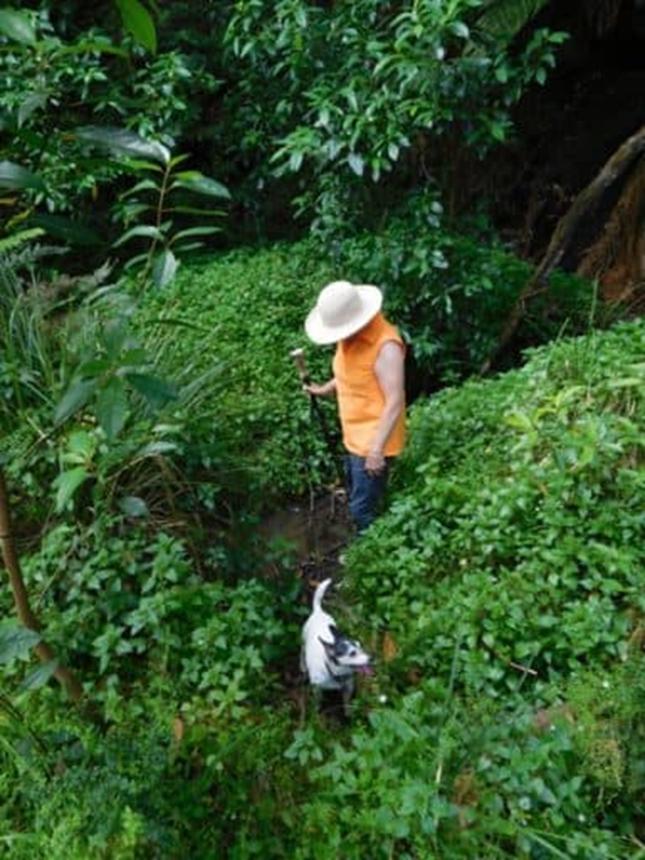
This
was Kirchubel.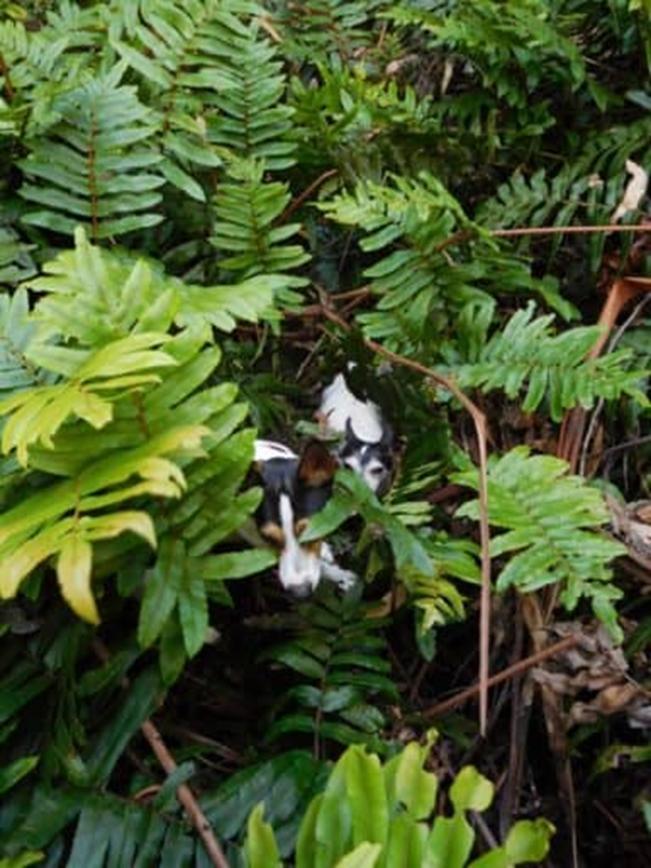
Sometimes
it was even 'verboten' by environmental Nazis. It
wasn't Tiny (or me) who painted out the dog in the picture. In any case, the
picture was never of a 'Tiny dog', so I guess it didn't apply.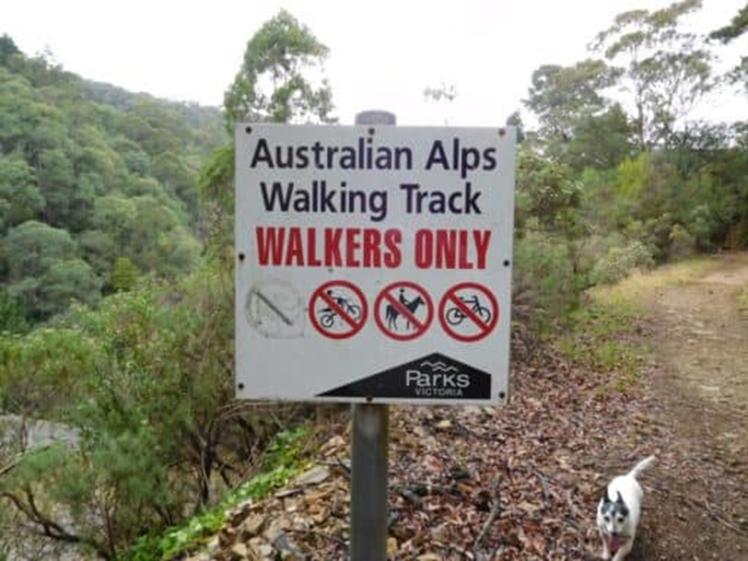
She
loved trips in the camper

When
Bryn moved out at 19 into his own house Tiny stayed on as this was her home and
she would be lonely when he went to work - besides we always had other dogs to
keep her company.
The
boy and the dog grew older together - as you can see (he will miss her):
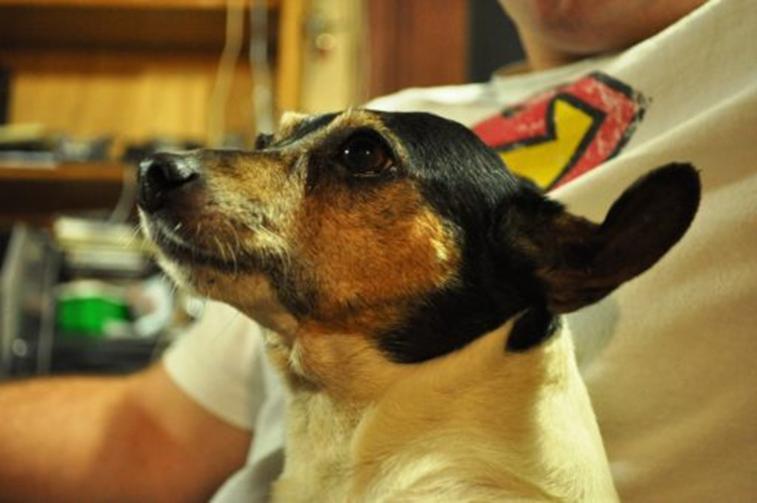
Of
course he visited her regularly - more than twice a week I guess, and when he
did there were always cuddles. As she grew older Tiny liked sitting on one's
lap less and less. The last several years she would never let me pick her up
though she cruised by my chair several times a day for a long pat. But she
would always sit contentedly on her boy's lap.

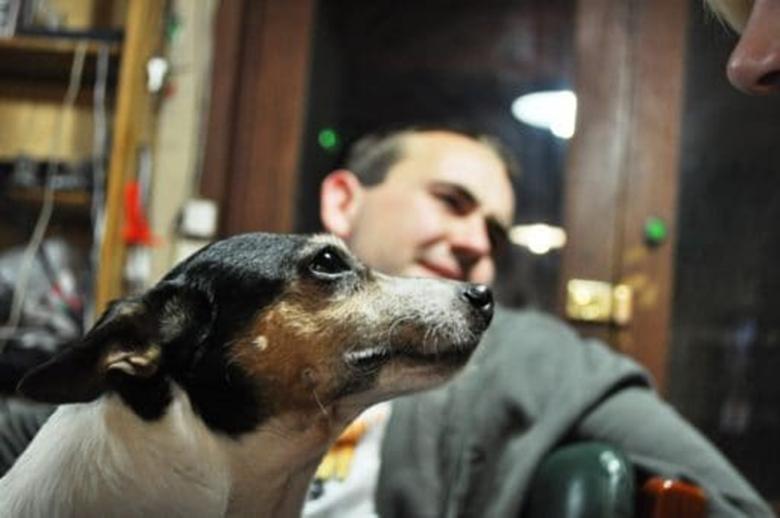
Or
curled up in the crook of his arm.

Or
playing hide and seek in her bed.
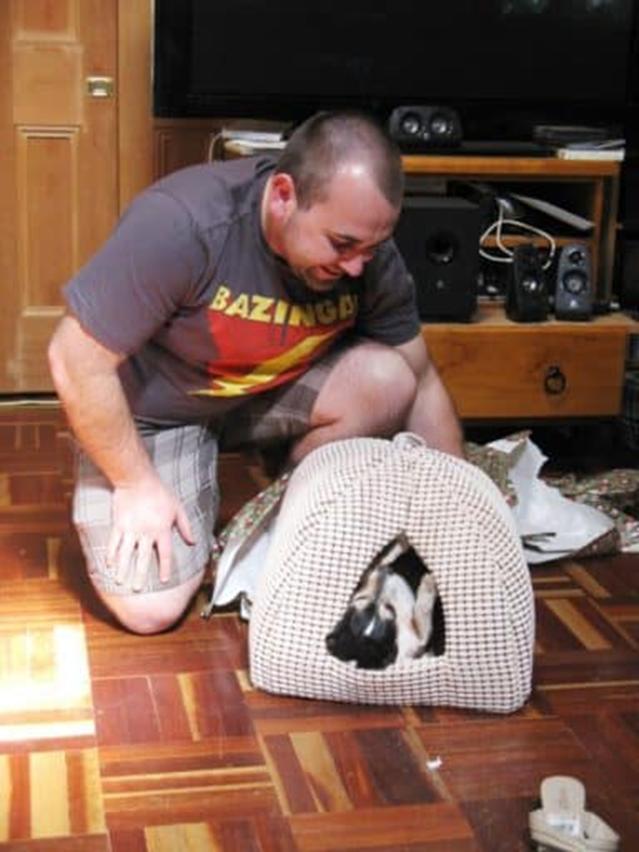
Or
sitting on my mother's chairs in the garden.

Helping
to eat cracker biscuits.

There
was never a family event she missed out on: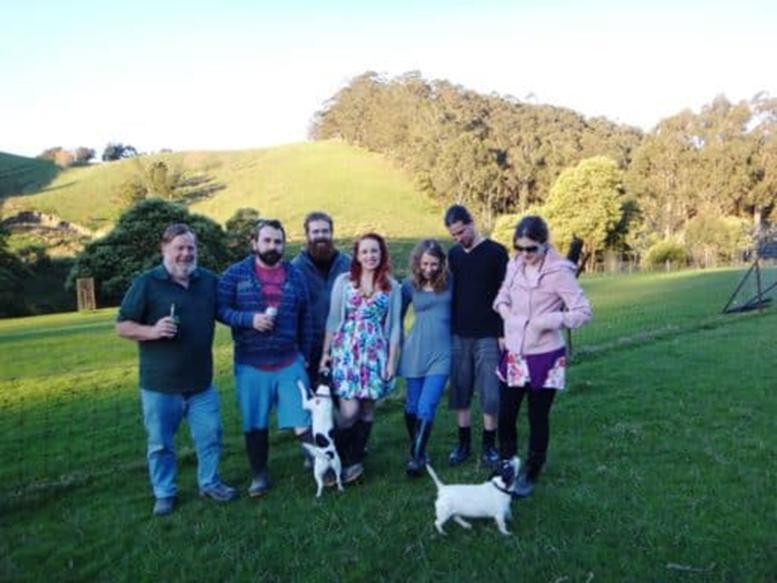
She
has her eye on those leftovers!

She
was entitled to special treats. 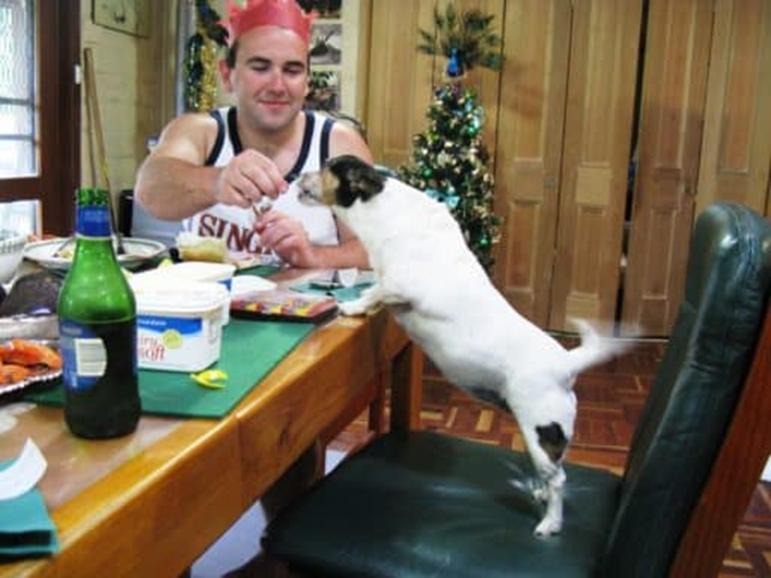
Or
even a ribbon.

Even
sharing with her friend, Schnitzel.

We
celebrated her birthdays. This was her sixteenth - as close as a dog gets to
the hobbits' fabulous eleventy-first!

She
never mastered blowing out the candles.
Though
Bryn encouraged her, saying "Say 'Brr' Tiny". He blew them out for
her, but she enjoyed the cake. She was especially fond of rum balls.
And
she so loved 'messing about in boats'. She began this activity with Maggie and
Bridie when she was just a puppy and the children were all still in school.
unfortunately this was before the era of digital or waterproof cameras so that
period of her life is just a fond memory. I think you can guess how much she
enjoyed being on the water from these later photos though.
Here
she is on the Macalister
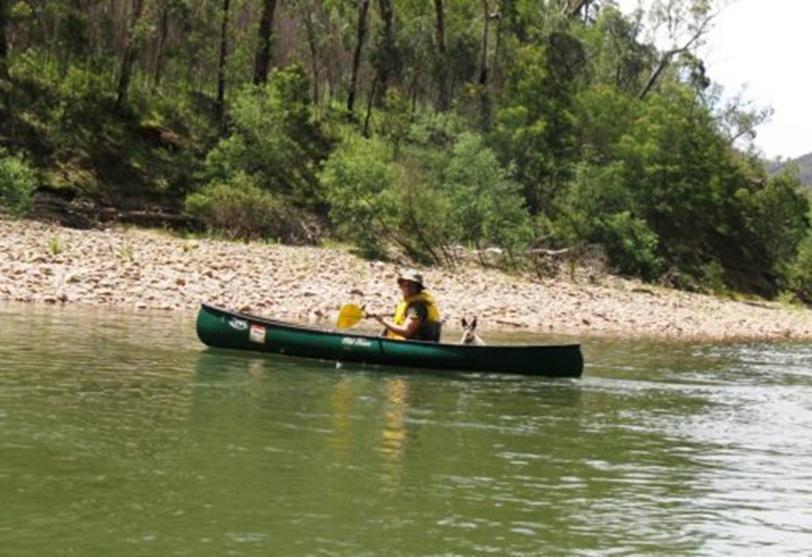
Really
loving it.
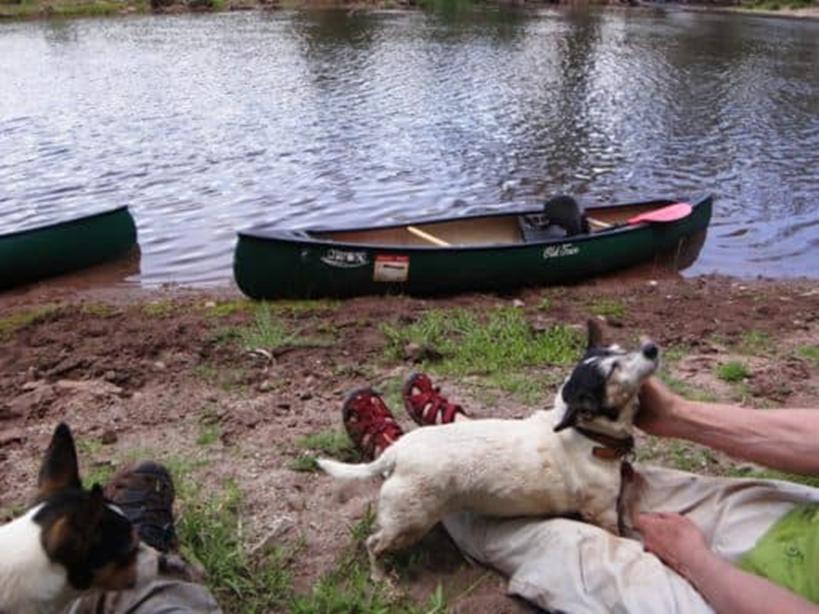
Though
she looks a bit charry of the 'faux' pack raft here.

This
was a trip on the Wonnagatta, Kingwell Bridge in the
background.
This
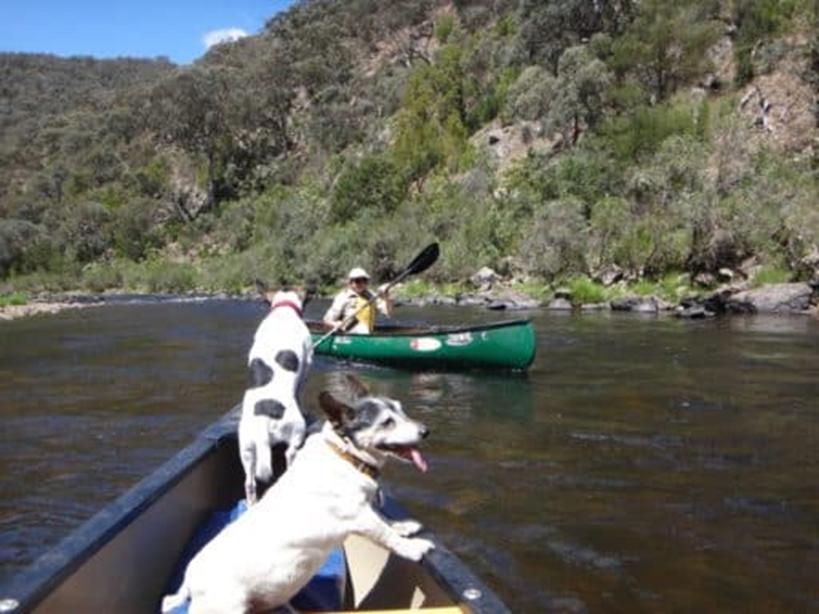

She
was quite proud of this strange 'find' on the river shingle. it has pride of
place amongst Della's 'mathoms'.
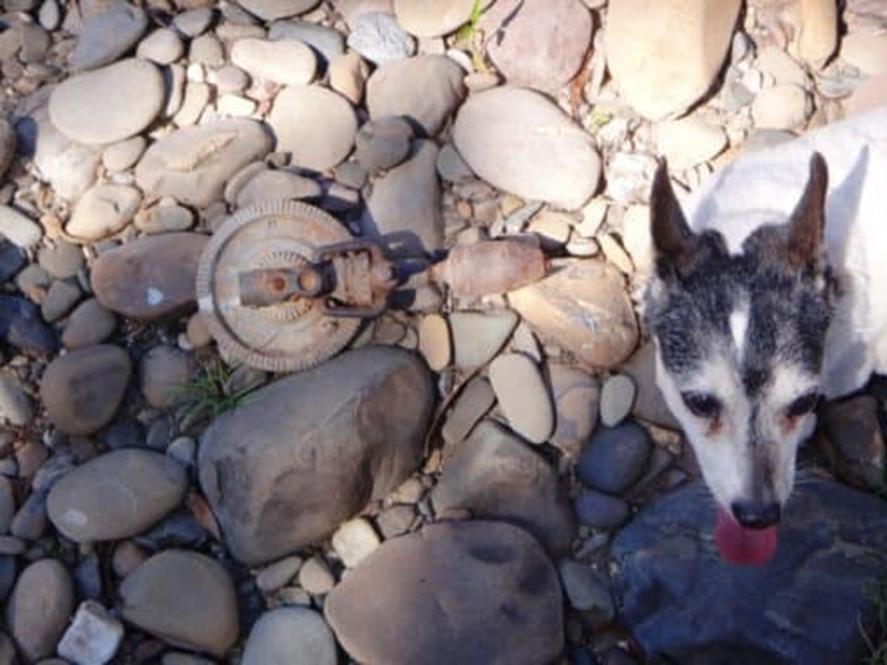

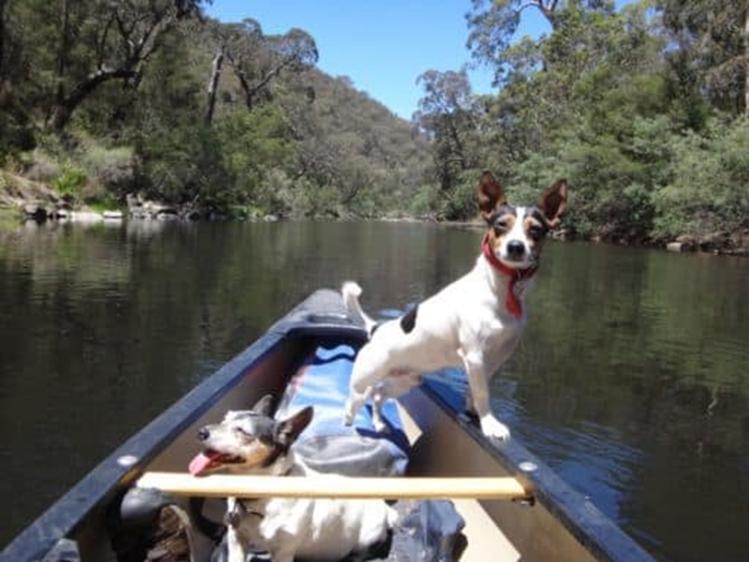

This
was Spring 2017 http://www.theultralighthiker.com/a-wonnangatta-spring/
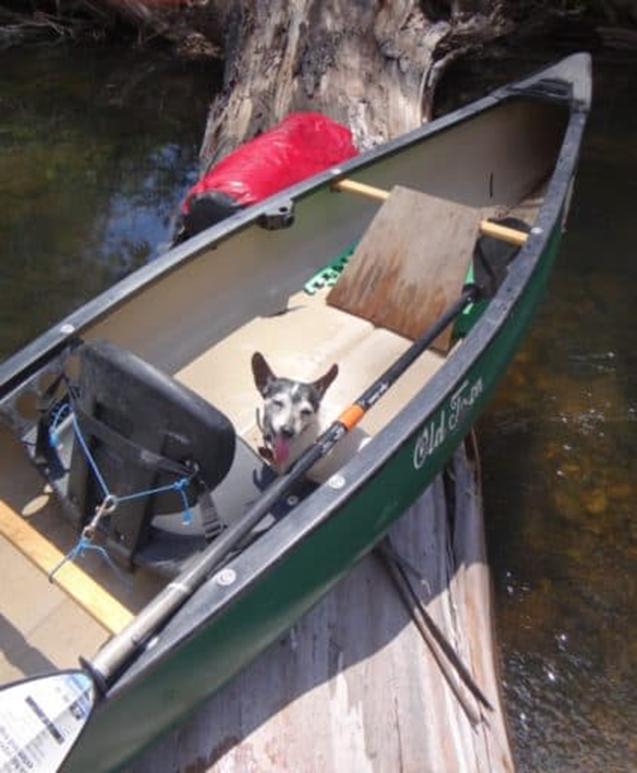
This
was her last trip in January 2018. As you can see she was still
loving it.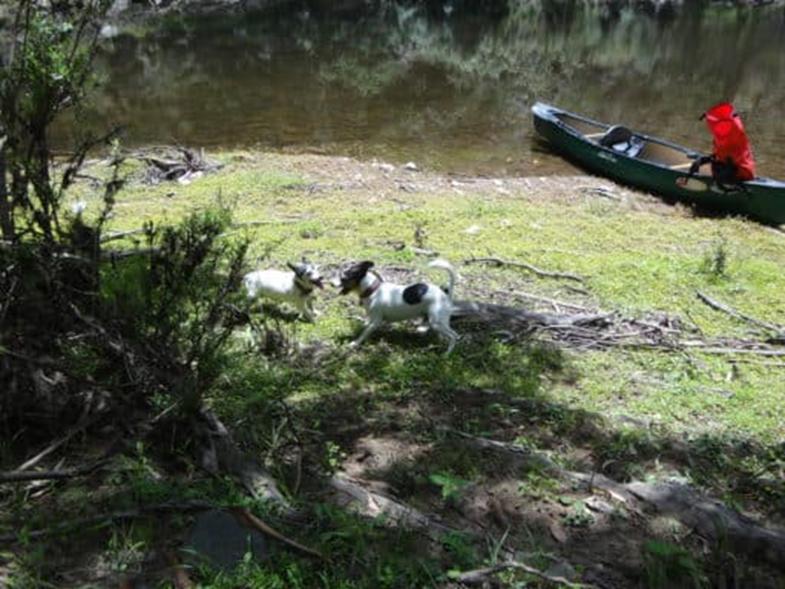

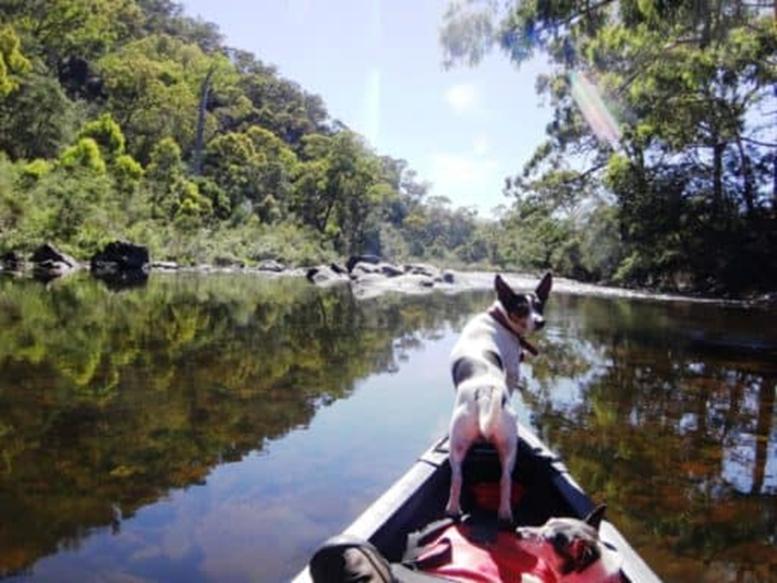
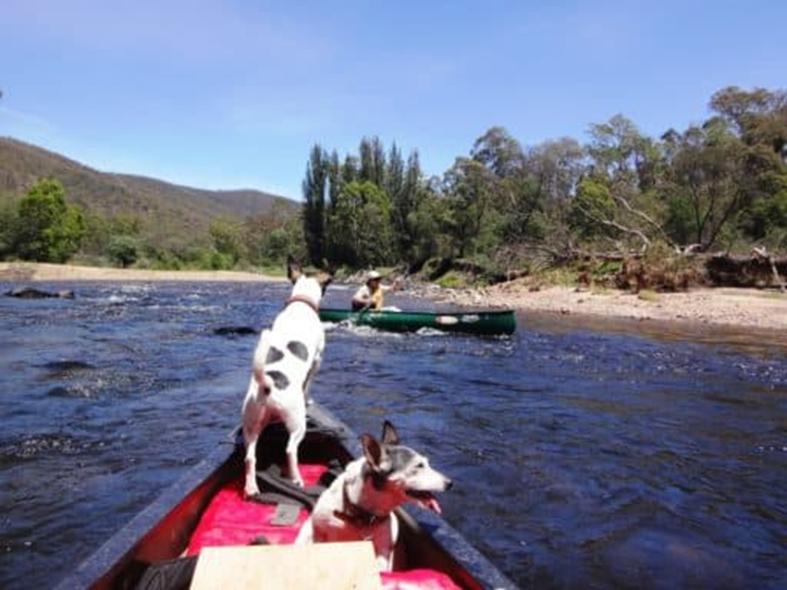
And
she definitely loved hunting 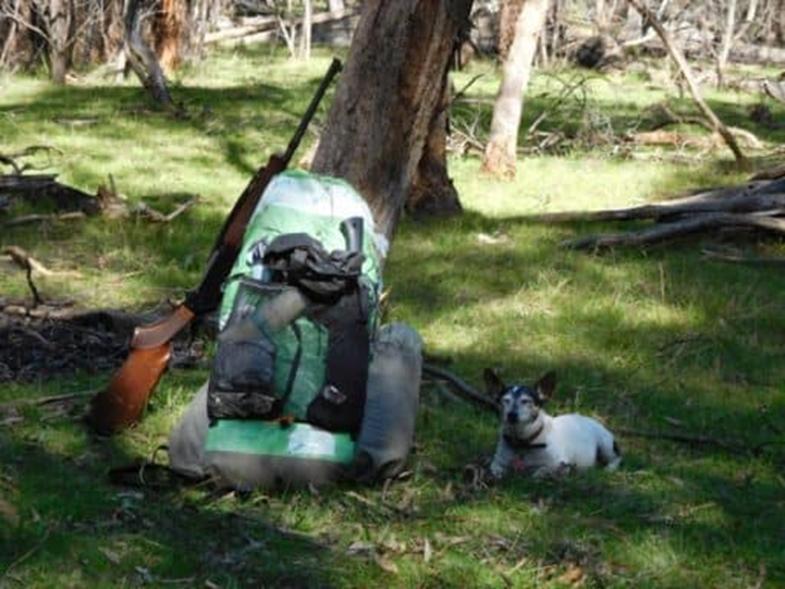
Even
when it involved deep river crossings

She
is maybe saying she would like to ride on my pack here.
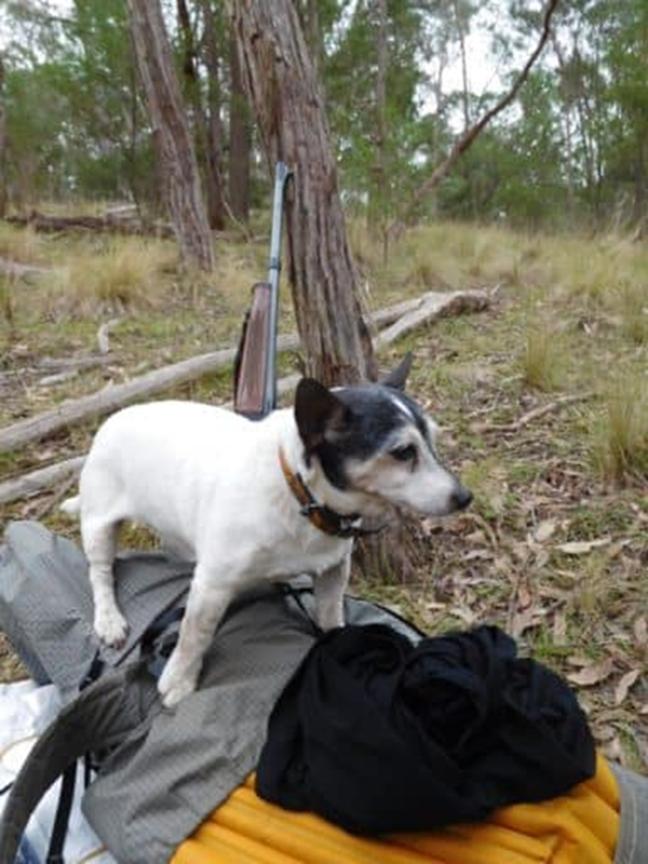
And
she could definitely ride on a deer.
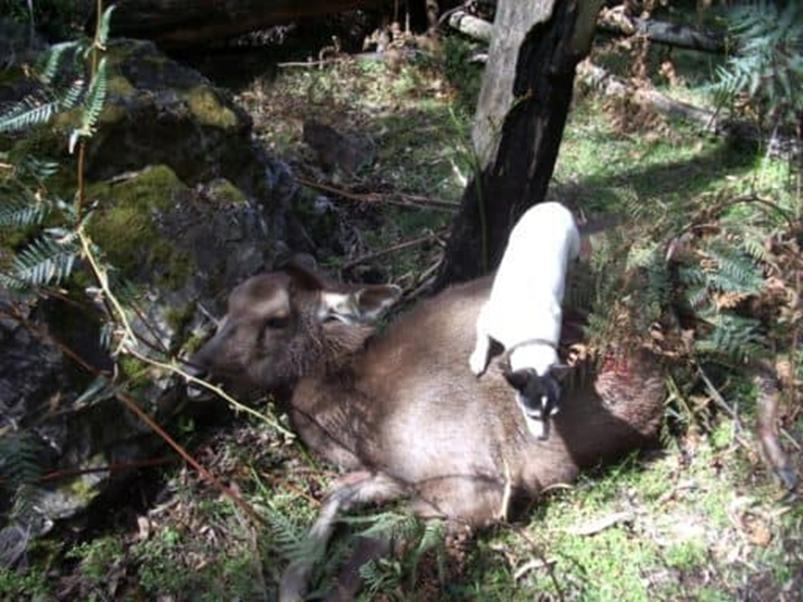
Every
so often she would 'hunt something up on her own. Here it was a sheep's foot.
She knew this was naughty.
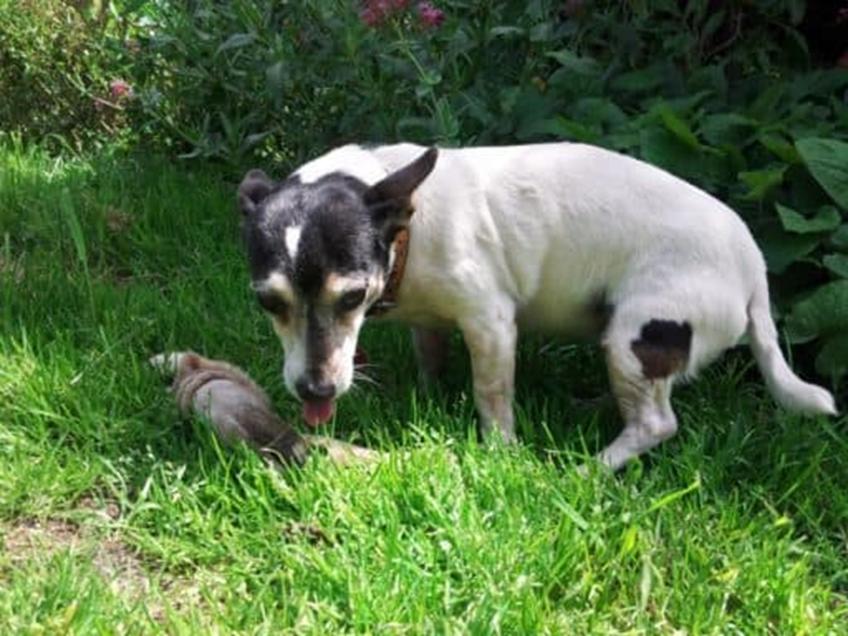
And
here at Mt Whitelaw she has stolen Della's muesli
bar and is enjoying the 'forbidden fruit' exceptionally.
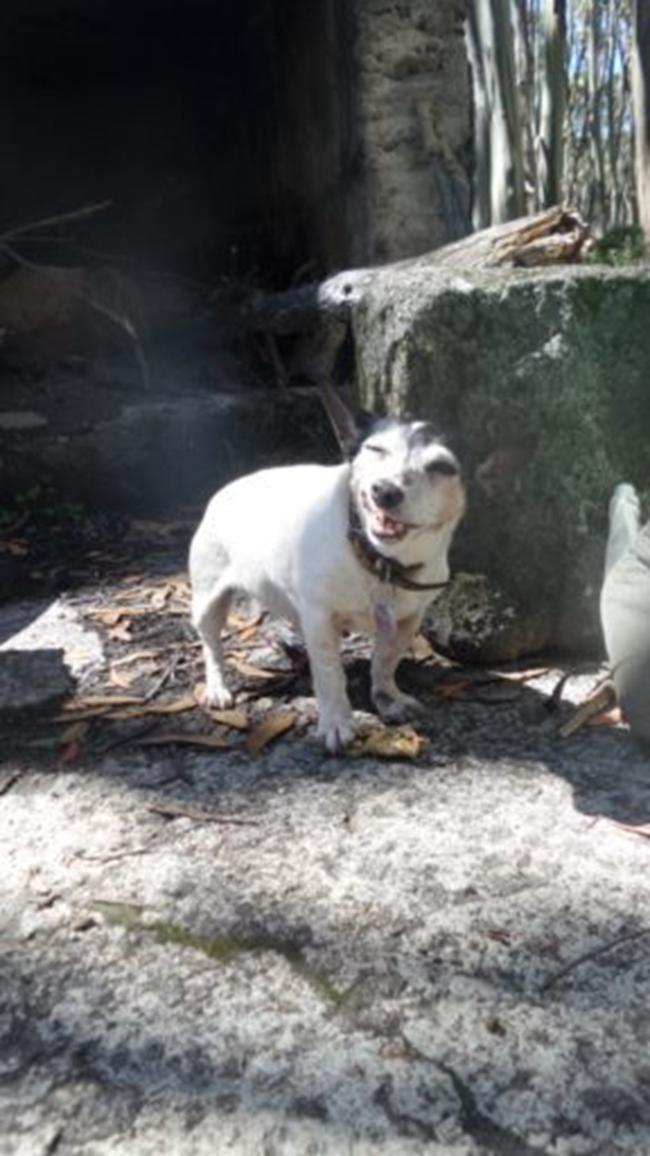
She
enjoyed an apple or pear from the garden.
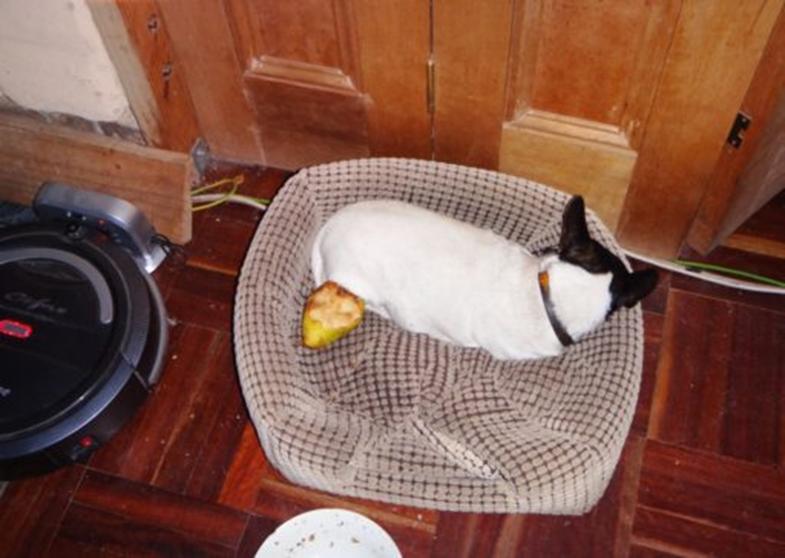
Or
one she helped herself to. Here she has the label stuck to her eyebrow as
evidence of her philandering. Thise new 'Jazz' apples sure are delicious!

And
Oh, she loved a romp on the beach on a warm sunny day so much too: 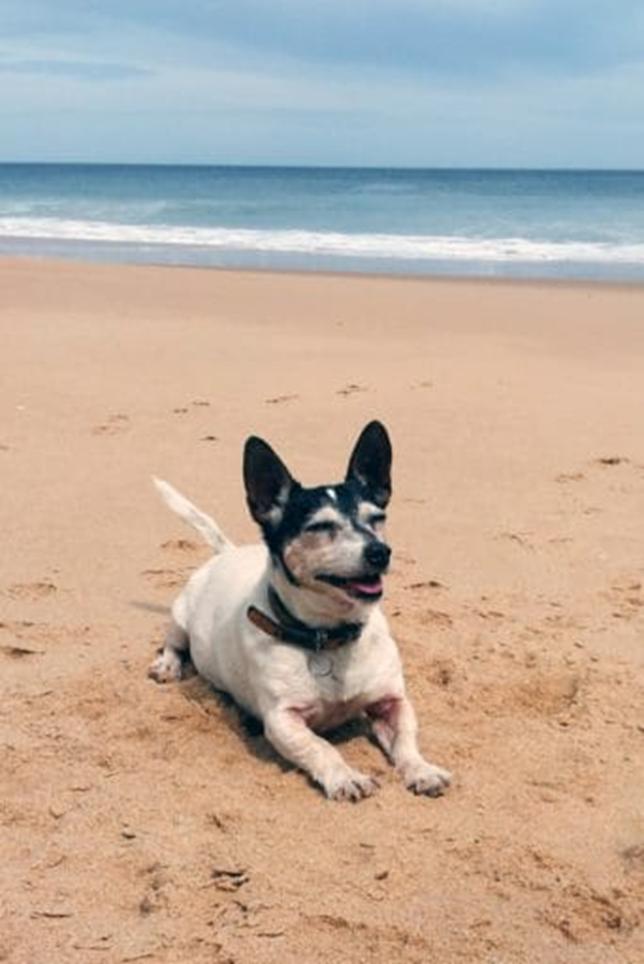
Such
as this one at Shallow Inlet.

Or
even a colder day.
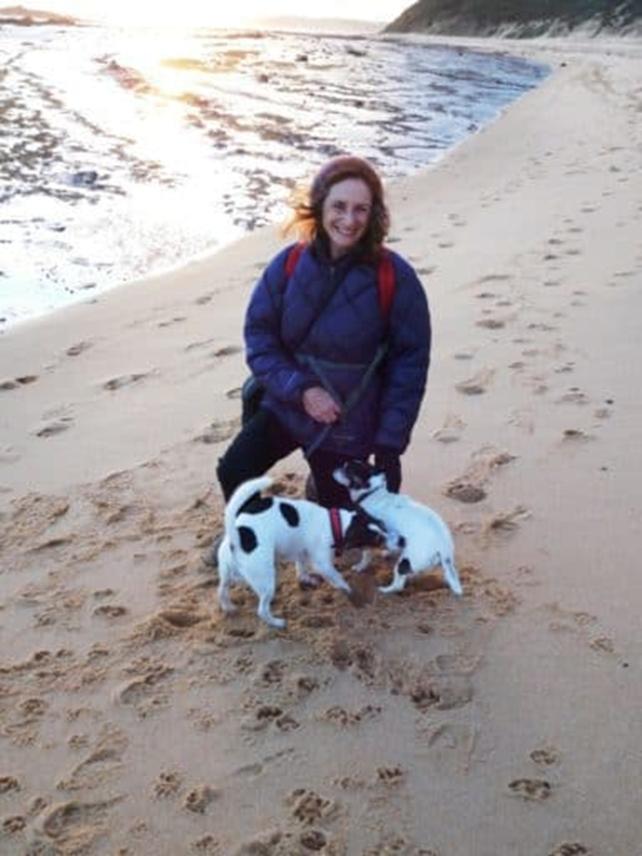
Such
as this at Port Albert.
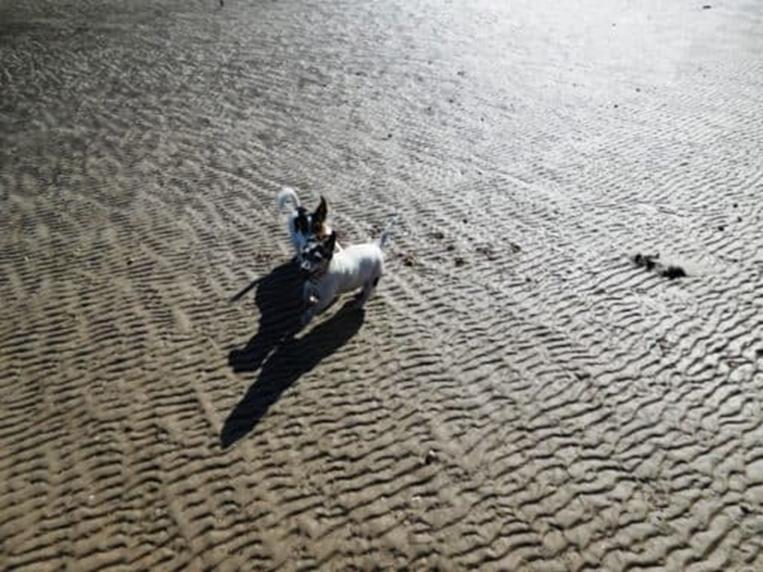

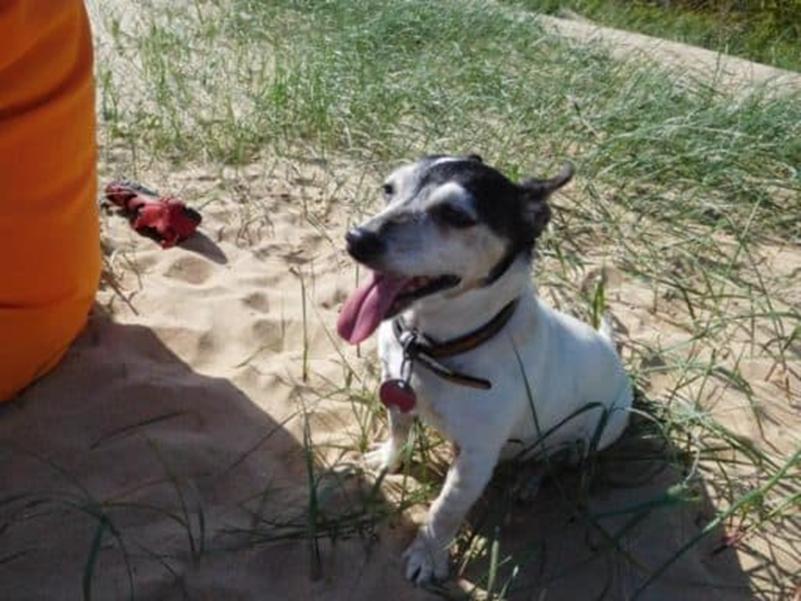
She
sure loved that sand.
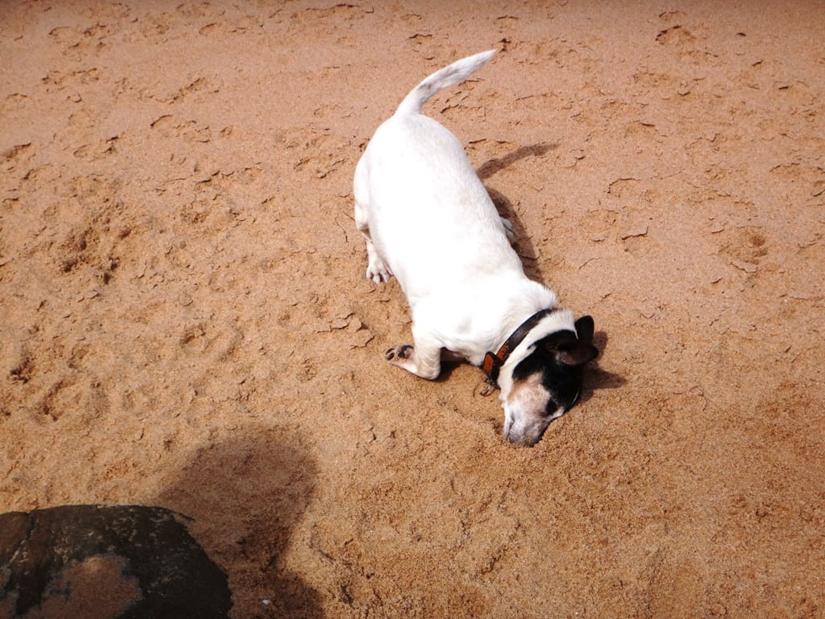
Everywhere
we go we will miss her absence so much, but will be forever grateful she chose
to share her 'Tiny' life with us. She was a lovely little dog. So quiet,
patient and affectionate. She has been a constant and loving companion for so
long, it is hard to accept she is gone forever and that these photos and our
memories of her is all we have left.

Rest
in Peace you lovely little mutt.
23/02/2018:
Extinction is Forever? Isn't this just great: a beautiful plant not
seen for 30,000 years! Wonder what they will find in Lake Vostok? Will the
Russians succeed in their efforts to clone a mammoth? The modern world is
surely a wonderful place: http://www.popsci.com.au/science/russian-scientists-grow-pleistocene-era-plants-from-seeds-buried-by-squirrels-30-000-years-ago

23/02/2018:
The Universe is even weirder than you
could believe: ‘a UC Berkeley mathematician has found some types of black
holes in which this law breaks down. If someone were to venture into one of
these relatively benign black holes, they could survive, but their past would
be obliterated and they could have an infinite number of possible futures.’ https://wattsupwiththat.com/2018/02/22/weird-some-black-holes-erase-your-past/
21/02/2018:
It's that time of year again. Della:
‘There are not enough hours in the day to pick and preserve nature's bounty
from our garden. What we don't use, the birds will certainty appreciate. And
because I am a total fruit loop, we are about to take some containers with us
on our afternoon walk with the dogs to grab some of the luscious wild
blackberries we discovered yesterday. Cream and ice-cream are waiting!
There
was no room on the little table for the nashis and pears and damsons that are
also falling in bucketloads. It does seem like the Garden of Eden at times, but
then I only have to neglect the gardening for a short while and it turns into
Sleeping Beauty's overgrown forest!
Damsons
are tiny, deep purple plums, sour if eaten fresh, but if cooked with sugar make
an intensely plummy jam or paste. They certainly grow enthusiastically here in
Victoria. We are not in a particularly cold region so I reckon they would grow
just as happily in NSW- anywhere that other plums grow. We just got our tree at
a local nursery. If you want to grow one and can't source one, yell out and
I'll save you some seeds. Our's has self-seeded so that we have several growing
nearby now.
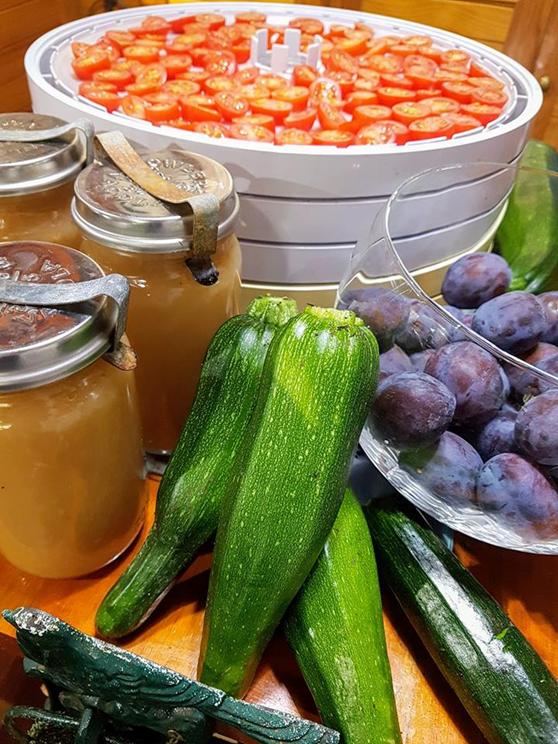
Mini
tomatoes for semi-dried tomatoes later in the year.
We
also find ourselves constantly trying to outsmart the birds in the eternal
battle for a share of the crop. My only suggestion where birds are concerned is
to plant enough trees to feed both birds and man...although we haven't managed
to accomplish this yet...
And
yes, we planted it all when we moved here in 1990. The sheep used to graze up
to the front door and the only food growing here were some golden plum trees
planted in the early years of the 20th century and which are still going strong
today- and lots of wild plums which have spread across our valley courtesy of
the birds (no doubt originating from the golden plums) over decades. We have
moderately good soil, good rainfall and our own creek so the place had all the
ingredients we needed. 11 years of drought from the late 90s resulted in slow
growth, but now we are really seeing the results of our youthful labour and,
with more time now available, we are increasing our forest each year.’
21/02/2018:
Tired of Google’s intrusiveness? Some
alternative search engines: https://hackernoon.com/untraceable-search-engines-alternatives-to-google-811b09d5a873
20/02/2018:
Strange Things: Killer Whale Imitates
Outboard Engine: https://www.youtube.com/watch?v=05EdMzIxZvE
19/02/2018:
Cheap Packrafting Daypack: Isn't Amazon
wonderful? Jeff Bezos deserves to be the richest person who has ever lived
(which he is!) When I was doing the post below I found this excellent cheap packrafting day pack for US$16.99 (Feb
2018) which just about has to be a 'must have' to add to the G4 free below. It even comes with a free
waterproof phone case.
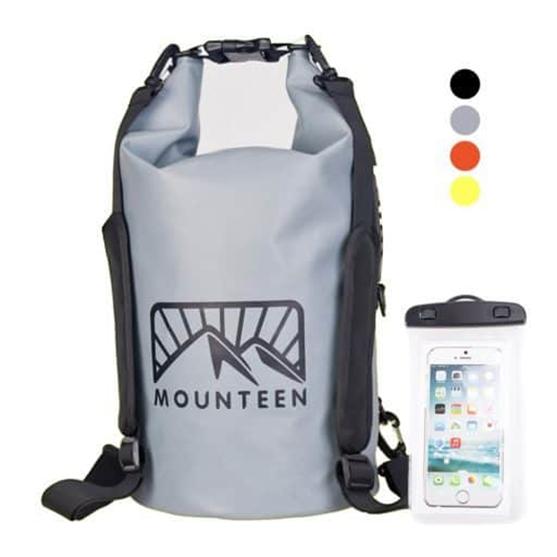
Here
is another, larger 35 litre one for US$59.96 (Feb
2018)
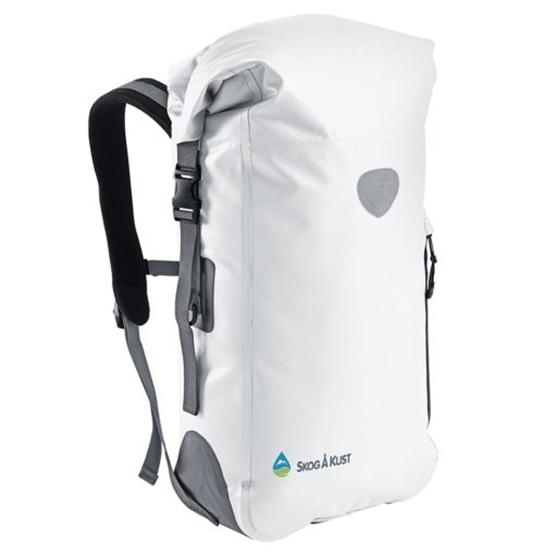
For
more packrafting posts, see:
http://www.theultralighthiker.com/pack-rafting-the-remote-wonnangatta/
http://www.theultralighthiker.com/remote-wonnangatta-day-two/
http://www.theultralighthiker.com/new-diy-pack-raft/
http://www.theultralighthiker.com/you-take-the-high-road-and-ill-take-the-low/
http://www.theultralighthiker.com/moose-hunting-pack/
http://www.theultralighthiker.com/more-about-diy-pfds/
http://www.theultralighthiker.com/gippsland-pack-rafting-routes/
http://www.theultralighthiker.com/ultralight-pack-rafting-life-vest/
http://www.theultralighthiker.com/pack-rafting-the-wonnangatta-mitchell/
http://www.theultralighthiker.com/klymit-packraft/
http://www.theultralighthiker.com/dusky-track-canoeing-the-seaforth/
http://www.theultralighthiker.com/a-gorilla-in-the-bush/
http://www.theultralighthiker.com/home-made-pack-raft/
http://www.theultralighthiker.com/the-ultralight-fisherman/
19/02/2018:
90 Degree Takeoff: The new 737.
Boeing has a winner here: https://www.youtube.com/watch?v=hZqGxWv1OKs
18/02/2018:
Ultralight Ultracheap Backpack: You
really don't need a heap of expensive gear to get into hiking (or a ten ton
load). You can start eg with a lightweight pack. You could consider the simple
dual compartment 362 grams, 40 litre G4Free available at Amazon for US$19.99
(Feb 2018), and you could shave a bit off that weight if you wanted to, but I
would add a simple waist belt though which might weigh about 30 grams. It comes
in lots of swanky colours too - I like the light green myself. The pack has
additional tie out points top and bottom to which more gear can be secured, if
needed early on in a long trip.
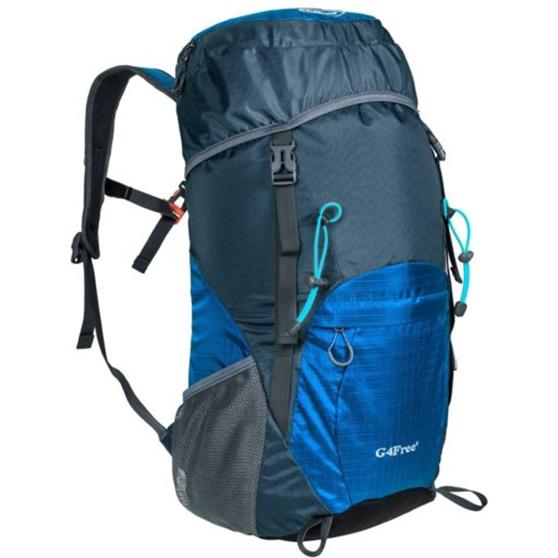
Another
option is the Coreal 35 litre backpack (also US$19.99 at
Amazon).

Anaconda
have this one for US$55 (Feb 2018):
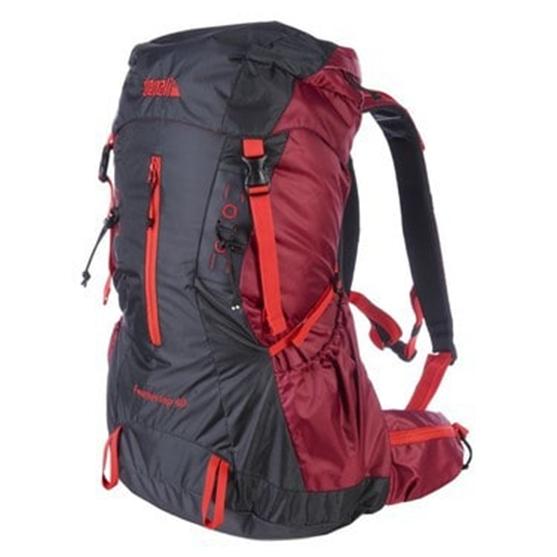
or
(if you are in Australia), this one for A$47.99 (Feb 2018) - which is about
what the first two would cost you after you add currency conversion and freight
(via Shipito):
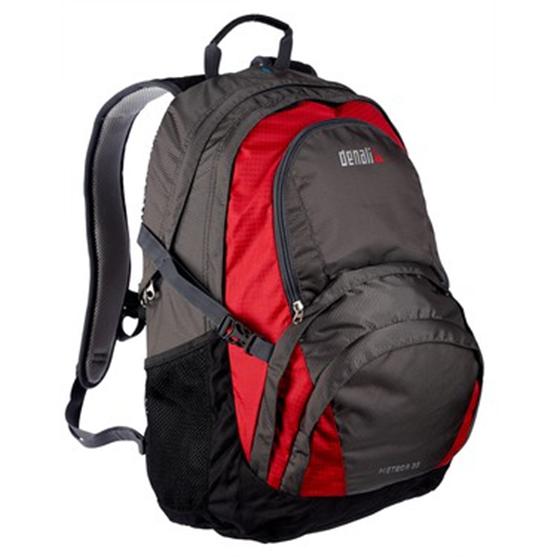
I'm
sure if you hunt around $2 stores, Aussies, Ray's, KMart etc you will
find number of other options though they may not compare favorably as to
weight with the G4Free!
Another
option is to troll the 'free shipping - to Australia' online stores such as
Aliexpress, Dino Direct etc where you will find things like this for US$18.18 (Feb 2018)
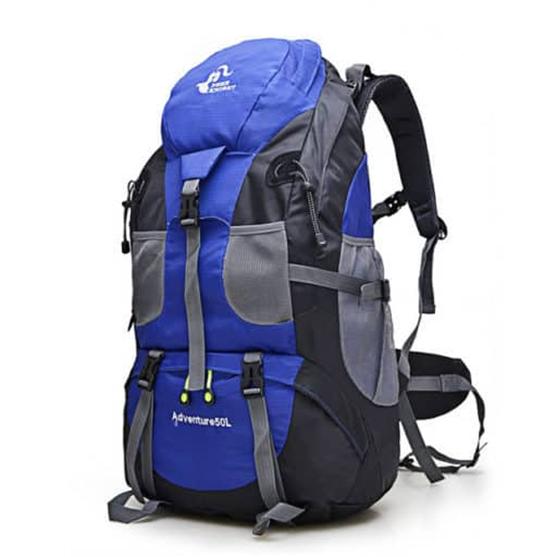
The
next thing you might need is a cheap tent, say like this: http://www.theultralighthiker.com/poly-tent-by-the-ultralight-hiker-on-the-cheap/ which
will set you back about $10! Then you only need a cheap mat (Big Agnes are hard to beat - unless you
choose to compromise on comfort) a sleeping bag/quilt (more about that in a
later post), a cookset and a rain jacket, maybe a pair of lightweight poles - and
you are good to go.
PS:
A sub 500 gram frameless pack is all you need when you keep your total weight
for a week's trip (including food) down to under 10 kg starting out weight as I
have done for many years. After all this guy has traveled the world for over a year
with a 20 lb backpack!
See
Also:
http://www.theultralighthiker.com/the-ultralight-deer-hunter/
http://www.theultralighthiker.com/best-hunting-daypack/
http://www.theultralighthiker.com/ultralight-pack/
18/02/2018:
Basic human needs – Art is at least
250,000 years old: http://www.amusingplanet.com/2016/10/venus-of-berekhat-ram-worlds-oldest.html
18/02/2018:
Drowning, as you fall through ice may be
accompanied by a beautiful sound: http://www.neatorama.com/2018/02/13/The-Sound-of-Thin-Ice-Singing/
17/02/2018:
Another World: 2,000 Days on Mars; Perhaps
you can understand why Elon wants to go there: https://www.theatlantic.com/photo/2018/01/2000-days-on-mars-with-the-curiosity-rover/551984/

17/02/2018:
If you want to live forever, you may
have to hang upside down more: http://www.newsweek.com/bat-dna-holds-doesnt-degrade-shows-secrets-long-life-801266
16/02/2018:
The Mysterious Rat King: http://www.amusingplanet.com/2018/02/rat-kings-mysterious-conjoined-creature.html
16/02/2018:
Human behaviour is so often very strange: https://www.livescience.com/61736-ancient-heads-on-stakes.html
15/02/2018:
Arrow Storms: Remember the arrows
blotting out the sun at Thermopylae and Leonidas saying, ‘Good, we shall fight
in the shade’…but how many arrows could a good archer get away in a minute?
Seems like in a contest between ‘cowboys and Indians’ the Indians would have had
an advantage: http://www.strangehistory.net/2018/02/10/really-arrow-storms/
14/02/2018:
A must read new book: Jordan Peterson: Rules for Life: an Antidote to Chaos
https://www.amazon.com.au/12-Rules-Life-Antidote-Chaos-ebook/dp/B078C6C7QS
Rule
1 Stand up straight with your shoulders
back
Rule
2 Treat yourself like you would someone
you are responsible for helping
Rule
3 Make friends with people who want the
best for you
Rule
4 Compare yourself with who you were
yesterday, not with who someone else is today
Rule
5 Do not let your children do anything
that makes you dislike them
Rule
6 Set your house in perfect order before
you criticize the world
Rule
7 Pursue what is meaningful (not what is
expedient)
Rule
8 Tell the truth – or, at least, don’t
lie
Rule
9 Assume that the person you are
listening to might know something you don’t
Rule
10 Be precise in your speech
Rule
11 Do not bother children when they are
skateboarding.
Rule
12 Pet a cat when you encounter one on
the street
14/02/2018:
Can B52s really fly until they are 100 years old? Airframes are amazing
things (and clearly we were better at building things when I was born! Very
clearly! But you should read Michael Crichton’s novel of
the same name) however scrapping more modern aircraft (this
may include our so far non-existent F35s) is astonishing: http://www.news.com.au/technology/innovation/b21-raider-stealth-bomber-usaf-budget-calls-for-early-retirement-of-b1-b2-bombers/news-story/a57e54c4d18ee3398484c2e2494c70d9
14/02/2018:
What a life saver this will be: https://www.wsj.com/articles/experimental-drug-promises-to-kill-the-flu-virus-in-a-day-1518264004
13/02/2018:
LL Bean has dropped its ‘lifetime
guarantee’. I think this is sad. It is not because their products will no
longer ‘last a lifetime’, it is idiots wanting to scam them by wearing them out
(over years of service) then wanting new ones: http://neveryetmelted.com/2018/02/10/l-l-bean-drops-life-time-guarantee/
13/02/2018:
Some Days are Sapphires: Yesterday
was. Our 45th wedding anniversary - so naturally we went for a walk! Mt St
Gwinear to Mt St Phillack return makes an enjoyable 12 km on a very hot day
down here in the valley (34C). Up there (in the clouds) it would have been at
most 21C but with a cool wind blowing (40 kph) and light drizzle it was at
least (delightfully) cool.
I
have mentioned before that a walk over from St Gwinear car park to Mt Baw Baw
(luxury accommodation overnight plus excellent restaurant - book both) makes an
excellent 'glamping' trip over the Baw Baws. An
opportunity too to experience a little of the wonderful Upper Yarra Track. Or you can walk back to
Mt Erica or onwards to Mt Whitelaw, camp the night in a wonderful setting then
walk back the next day. Loop tracks are over-rated: the trip back is just as
delightful as the trip out. There are always thousands of things you missed
seeing or which you can delight in all over again.
Just
the drive up the Thomson Valley Way is mind altering: these majestic mountain
ash which have grown from the ashes of 1939 to be this size are something to
wonder over.

A
well-made and beauteous trail begins right at the Mt St Gwinear car park. Spot
is keen to be off.
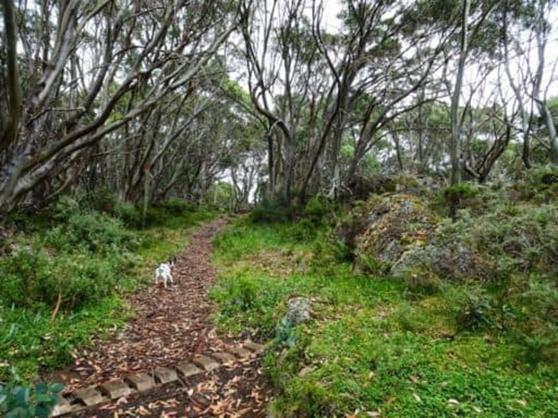
He
is proud of his ascent of Mt St Gwinear.
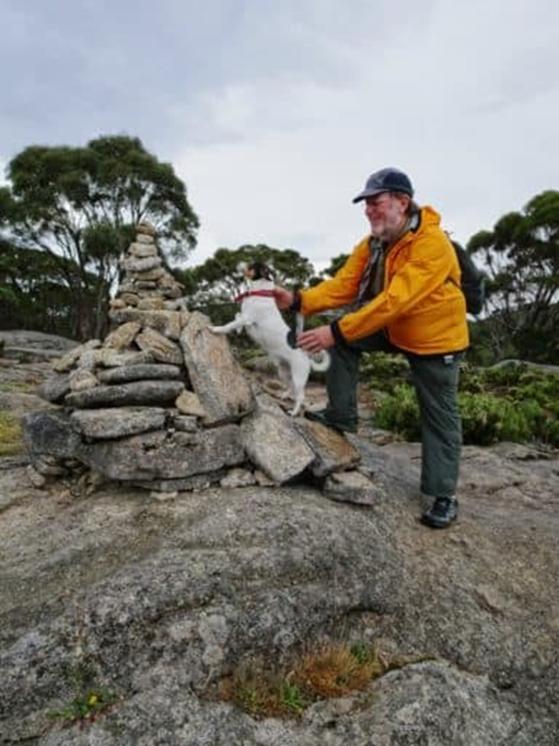
1509
metres, as you can see.
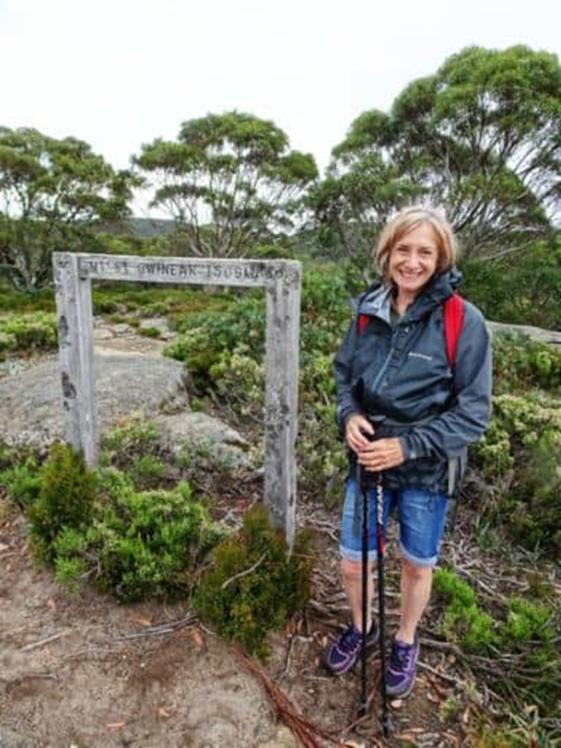
The
new JR ('Honey' - seven weeks) has a rest in my day pack from time to time.
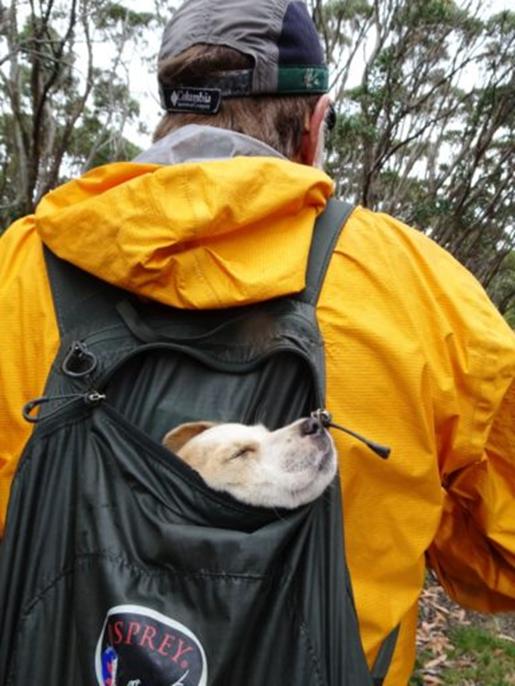
It
is a gentle climb up St Gwinear, then a small descent to a little valley.
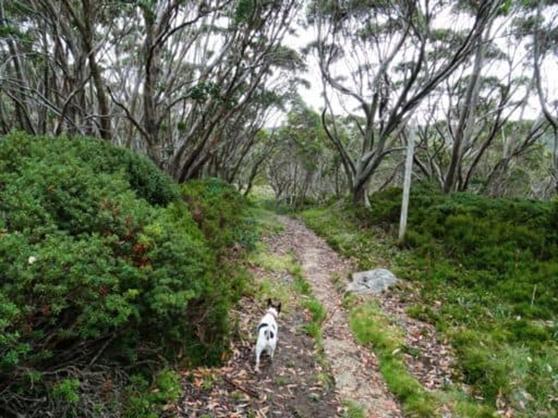
Spot
keeps an eye on Honey.
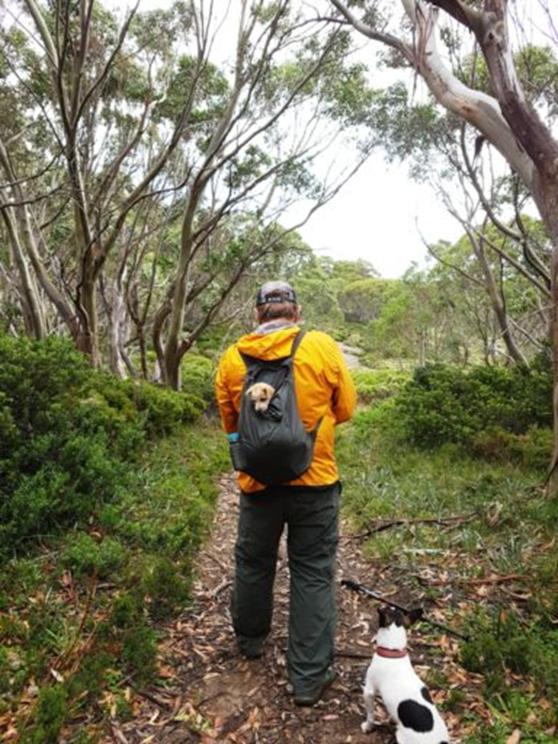
A
delightful little valley, a pup's playground really.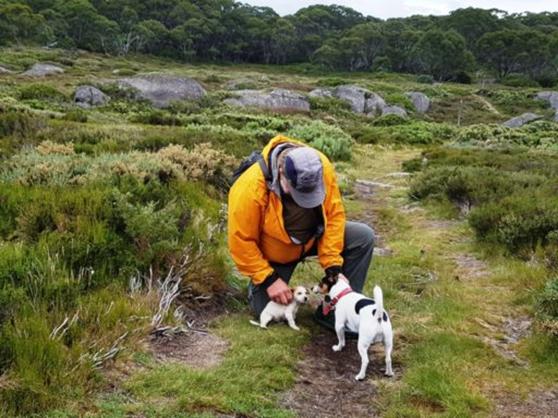
With
some splendid velvety campsites amid the heath.

Replete
with wildflowers.
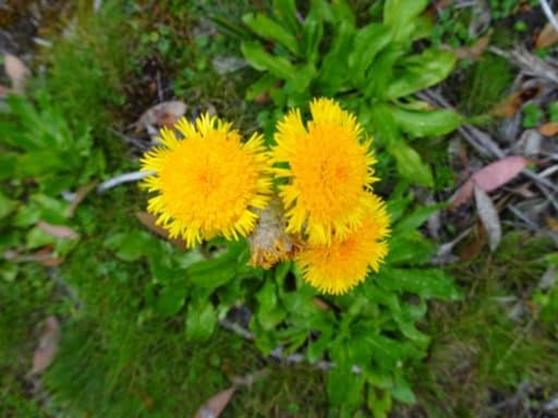
Of
many kinds.

At
the Divide where this trail meets the Upper Yarra track, there is a camp site
(Camp Saddle) with about a dozen tent sites - and a rocky bivy.
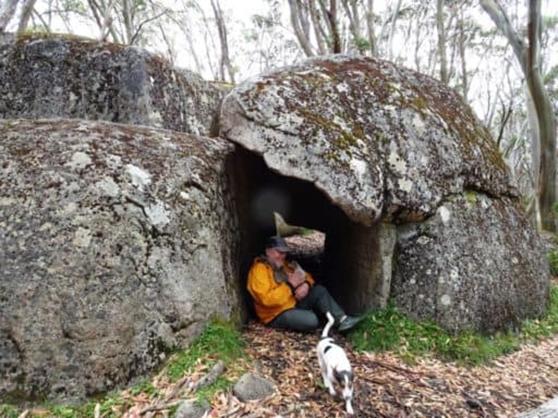
Here
would be a good place to spend a 'two dog night' - that is the correct number
to keep you warm up here!
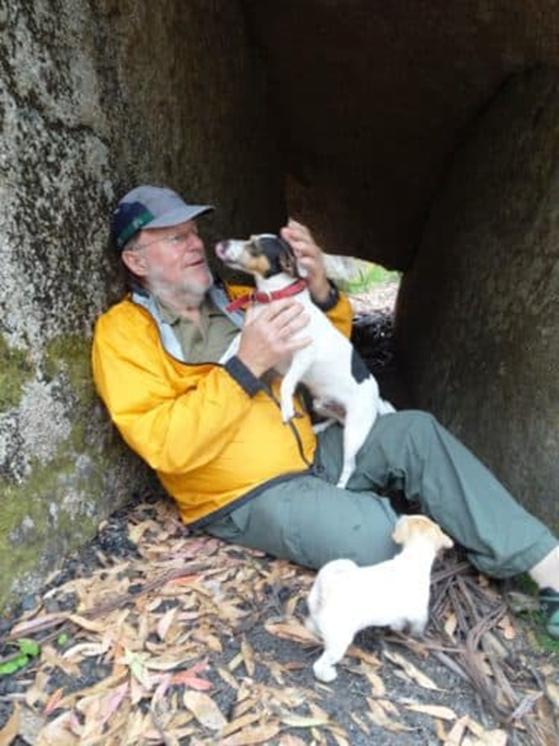
Honey
at Camp Saddle. She walked more than half the 12 kms - a momentous trip for a
pup. She was the first one out of the den; why I chose her. a JR cannot be too
game!

The
old signs and the new. The old signs were erected before metriification (1972)
and were reflective and easy to follow - even in the dark (I have). The new
signs mandated by some twisted green madness quickly disappear into the
undergrowth and are good only for barking your shins on!
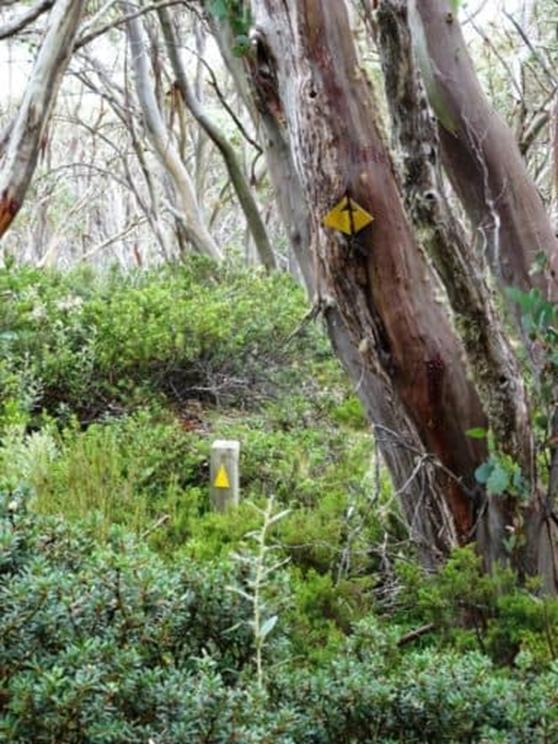
Autumn
is coming.
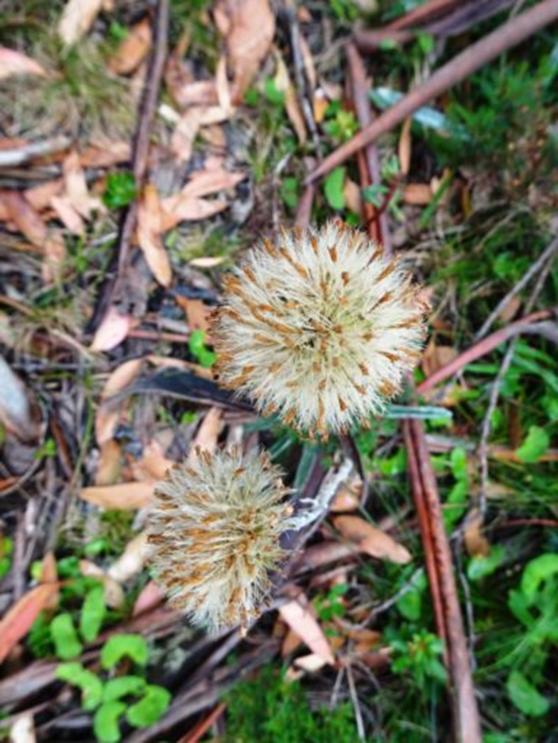
Here
is the well-marked intersection and the rock bivy.
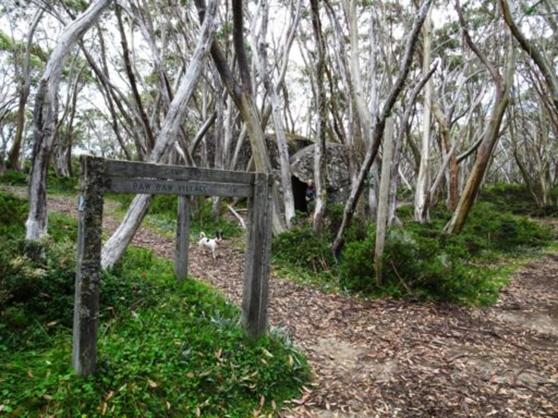
There
is a small stream only fifty yards back along the trail towards St Gwinear from
the bivy big enough already to form pools inhabited by yabbies.
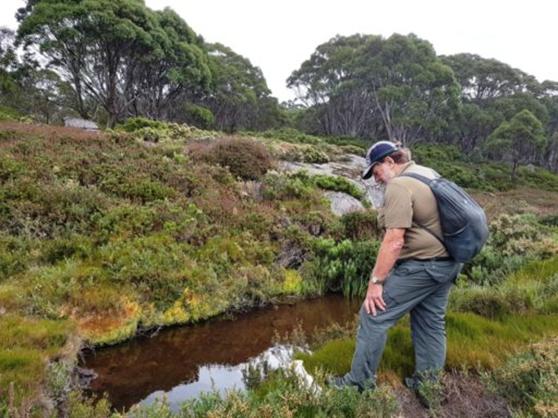
Beautiful
fresh, clear running mountain water.
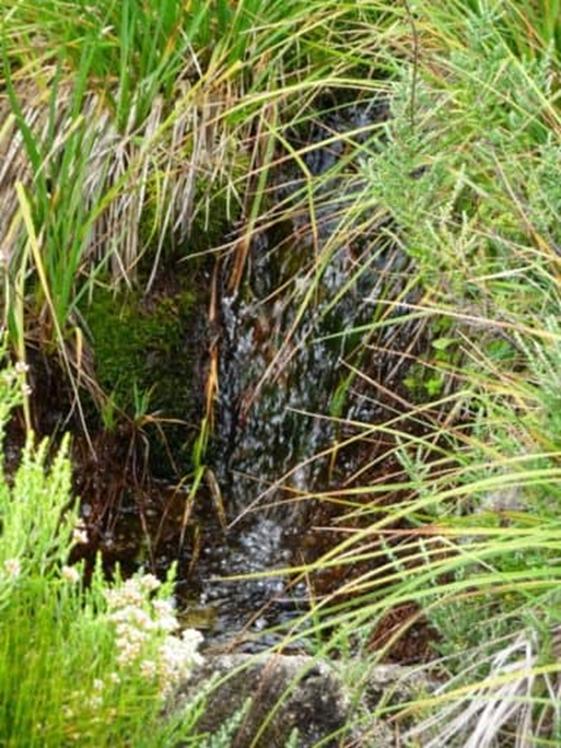
A
good spot for a photo opp. You can see why I married her 45 years ago.
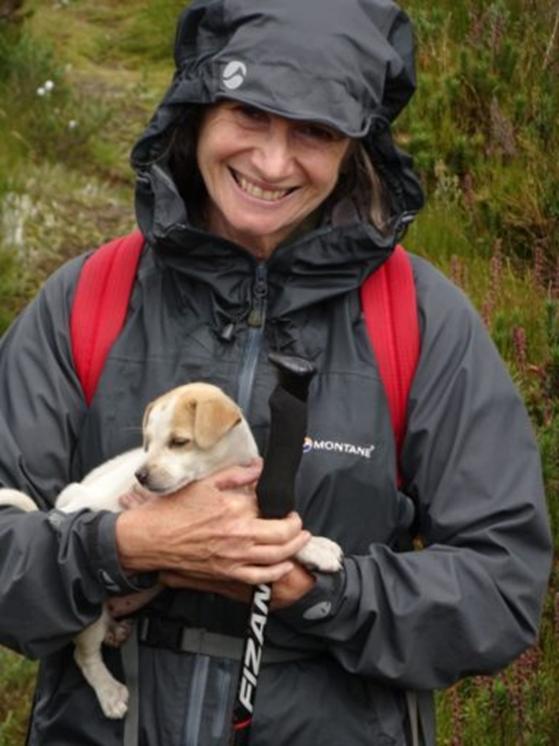
You
can walk along this valley and pop out at Mt St Phillack. there is a lovely
green lawn you can camp on over there.
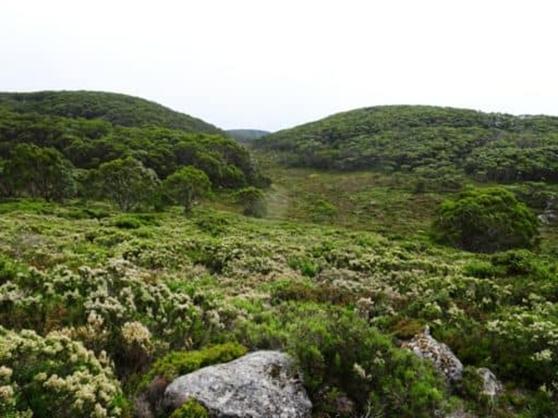
Wherever
and whenever you go in the Australian bush there is a myriad of wildflowers.
they may not all be showy, but they are amazingly diverse and ubiquitous.
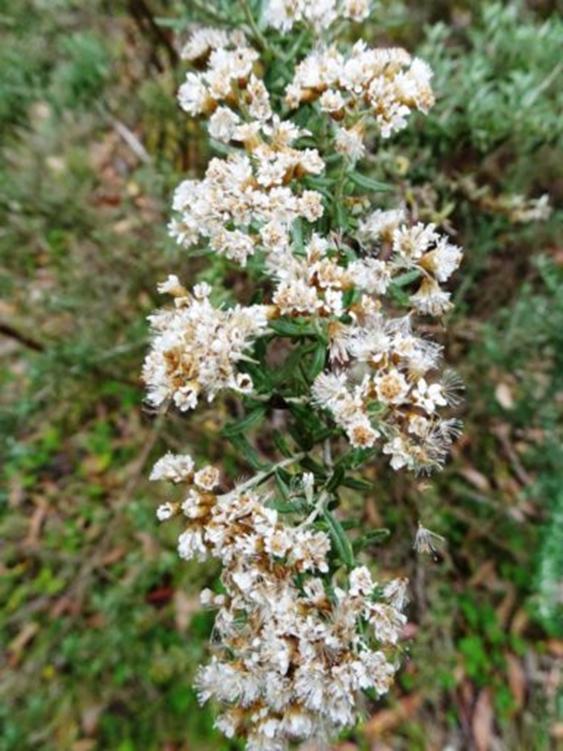
A
couple of native bees are loving this large wild daisy.
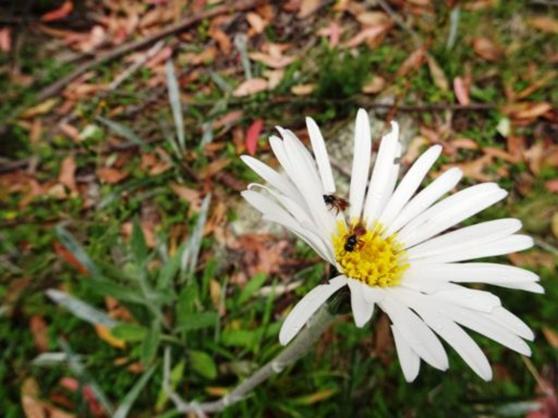
A
fox had eaten a rabbit right at the rock bivy. Further back towards Gwinear he
had eaten a lyre bird. there were at least a pair of them as I spotted scats
from a kit on the path back. Yet, even though I hunted these hills with hounds
for years long before folks dreamed of its becoming a National Park, small dogs
such as ours are not welcome. As if a small companion dog such as Honey would
do any harm in wildernesses where you are most unlikely to ever meet another
person. We have over a million public servants in Australia where I think 500
would be excessive. Amazingly they all manage to do practically no work at all
- save foment a mountain of onerous rules which none could or should obey.
These
tracks were never made by any such. They (the tracks) were made way back in the
C19th century (never by public servants who are loath to even maintain them) so
you have been able to legally walk your dog on them for 90% of their existence.
It will be so again. Meantime such fines as I might garner for going everywhere
with my pets, if ever I met a public servant (out of his office or car -
unlikely) and if he dared to fine me...would be merely the price of my admission
to such places - just as you must pay to go the zoo or museum (nowadays).
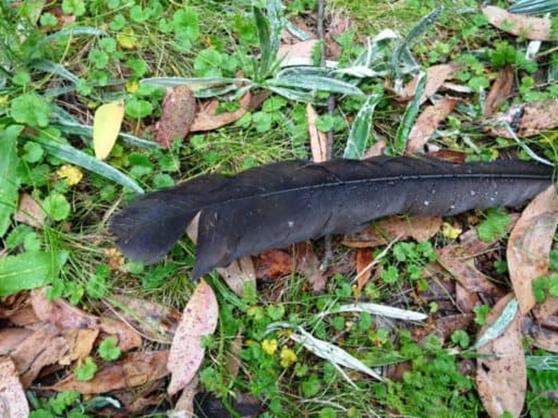
The
snow gums make a beautiful sight.

And
the manifold granite tors. I am glad I was not on the mountain when it was
spitting out these beauties (just a handful of millennia ago too!)
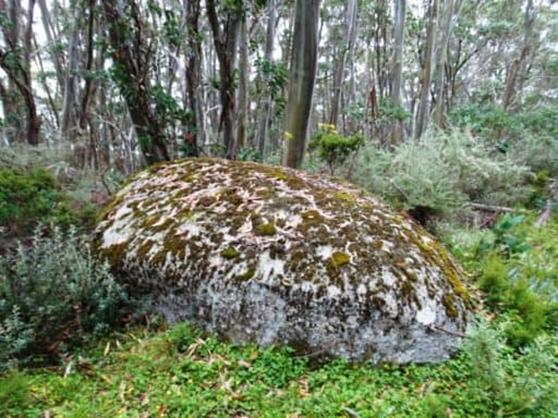
Much
of the ground is a beautiful carpet of native violets.
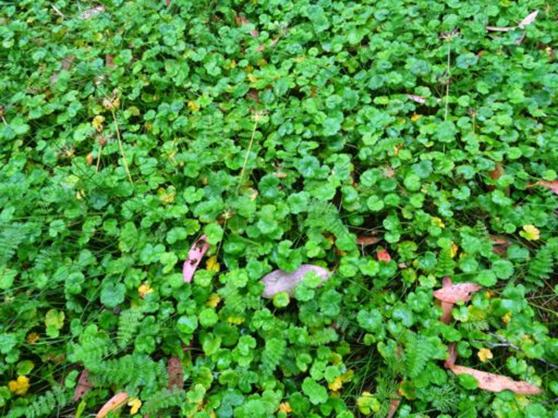
And
there are clouds of golden butterflies dancing on the wildflowers.

And
everywhere shocking displays of these wonderful native berries.

See
also:
http://www.finnsheep.com/THE%20UPPER%20YARRA%20WALKING%20TRACK.htm
http://www.finnsheep.com/Track%20Instructions.htm
http://www.theultralighthiker.com/upper-yarra-track-update-section-one-moe-yallourn-rail-trail/
http://www.theultralighthiker.com/upper-yarra-track-update-section-two-yallourn-north-to-wirilda-park/
http://www.theultralighthiker.com/upper-yarra-track-update-section-three-wirilda-to-moondarra/
http://www.theultralighthiker.com/upper-yarra-track-section-four-moondarra-to-erica/
http://www.theultralighthiker.com/upper-yarra-track-section-seven-mushroom-rocks-carpark-to-phillack-saddle/
http://www.theultralighthiker.com/upper-yarra-track-ada-tree-to-big-pats-creek/
See
also Upper Yarra Track Winter Route:
http://www.theultralighthiker.com/western-tyers-river-great-for-crays/
http://www.theultralighthiker.com/the-western-tyers/
http://www.finnsheep.com/THE%20UPPER%20YARRA%20WALKING%20TRACK.htm
http://www.theultralighthiker.com/upper-yarra-track-update-section-one-moe-yallourn-rail-trail/
http://www.theultralighthiker.com/upper-yarra-track-update-section-three-wirilda-to-moondarra/
http://www.theultralighthiker.com/upper-yarra-track-section-four-moondarra-to-erica/
http://www.theultralighthiker.com/upper-yarra-track-section-five-erica-to-walhalla/
http://www.theultralighthiker.com/upper-yarra-track-st-gwinear-track-junction-to-whitelaws-hut/
http://www.theultralighthiker.com/upper-yarra-track-summary-cumulative-distancestimes/
http://www.theultralighthiker.com/upper-yarra-track-osheas-mill/
http://www.theultralighthiker.com/a-beautiful-world/
http://www.theultralighthiker.com/upper-yarra-track-winter-route-caringal-scout-camp-tyers-junction/
http://www.theultralighthiker.com/upper-yarra-track-winter-route-western-tyers-morgans-mill-skinners-camp/
http://www.theultralighthiker.com/upper-yarra-track-winter-route-western-tyers-to-tanjil-bren/
http://www.theultralighthiker.com/kirchubel-if-you-go-nowhere-else-in-the-world-at-least-go-here/
http://www.theultralighthiker.com/upper-yarra-track-winter-route-downey-to-newlands/
11/02/2018: White Headed Pigeon: Della: 'My pigeon
coop had an unusual visitor today! A little research has identified it as a
White Headed Pigeon, a common rain forest and woodland bird of the east coast
of Queensland and NSW. The internet tells me that they are beginning to be seen
in rain forest areas of Victoria. It is so lovely to see the increasing number
of bird species that are attracted to our garden as the diverse range of trees
we have planted increase and mature!
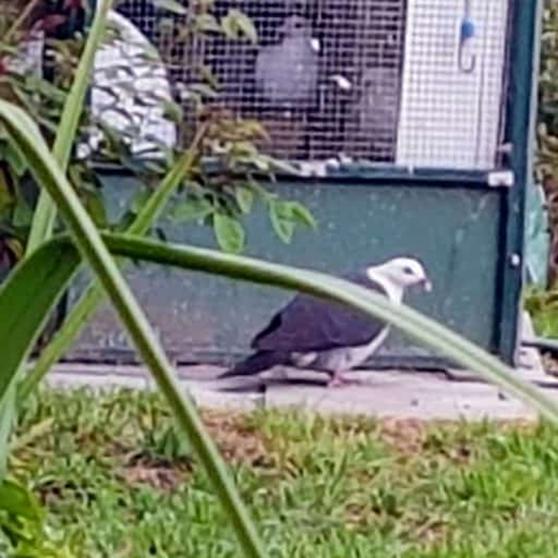
I
thought he had flown off, but he was back sitting on the top of the coop and
allowed me to get quite close so I have given him some lunch!
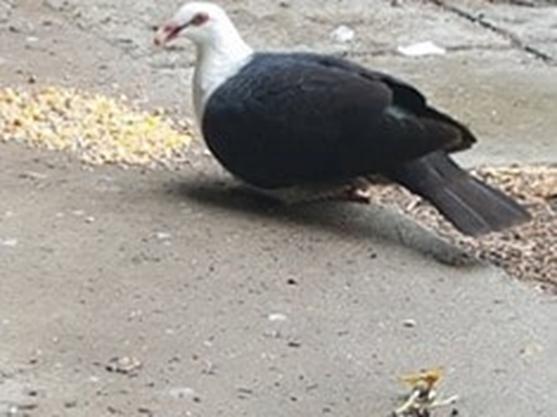
Just
back from a shopping trip to Traralgon and s/he is hanging out in the garden
now. I wonder what s/he will do when I let the pigeons out for their evening
fly? Thanks to Steve for taking this pic with his excellent zoom!

Update:
No sign of our visitor when the pigeons flew this afternoon. Perhaps it had
retired to a safe roosting spot for the night. Will look for him again tomorrow
and put some seed out. It would be nice if s/he chose to hang around in the
garden.
Steve
rescued an injured turtledove fledgling
the spring before last in the main street of Yinnar and we reared it to
maturity before it managed to escape one day. We were pleased to sight it
frequently near our dam and then this spring Steve discovered a pair of them
with a nestling in the garden behind our house. How nice to think that the
turtle dove has chosen to make its home here! It would be pretty unlikely that
this new pigeon would find a mate nearby, but perhaps it has arrived as one of
a pair or small group, all of which are possibilities according to Wikipedia.
Hmmm...the garden always has something new to divert me!
Update
#2 'Falconio' was back this morning, sitting atop the coop and waiting for a
feed. Here s/he is, enjoying elevenses. What a beautiful creature! I do hope
s/he makes this a daily habit!'
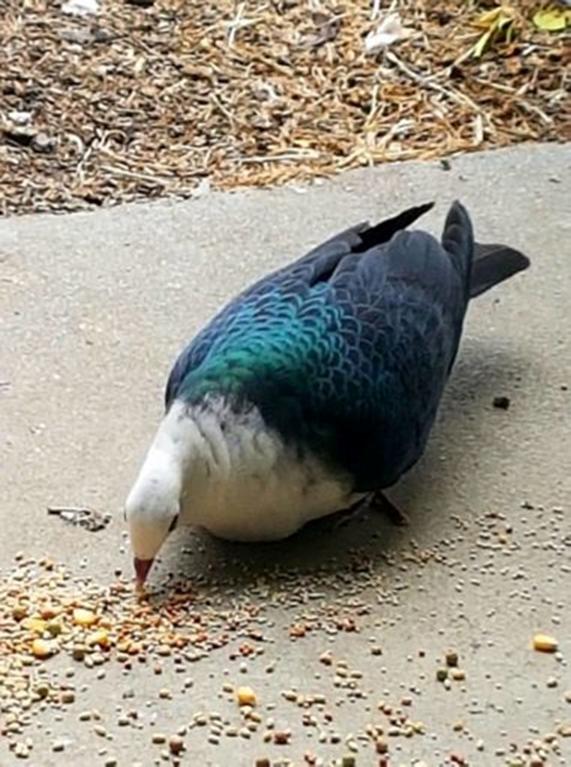
Unfortunately,
as mysteriously as s/he appeared s/he has moved on to other climes. Such
'volunteer' species are interesting. I suspect there will sometime be a colony
of them in the Jeeralangs behind us - just as there are brachychitons
(Kurrajongs) near Dargo - hundreds of miles from where they are 'normally'
found! Or this red wallaroo come all the way from the
Northern Territory only to be hit by a car at our back door.
10/02/2018: Sapphires: 45 years ago today I was 23 and
Della 19. I have no idea whether I would have supported then, as I do now
the metaphor of one’s beloved as a precious stone… Rare, beautiful,
imperishable…Yes. She has been my ruby for five years and is now my sapphire.
(She has a pretty new bracelet to underline this). All along I have felt she is
a diamond though that particular milestone (for us) is five years in the future
– a future which I have no doubt will be as joyous and as blessed as the last
45 years!

09/02/2018: This is the most amazing thing I have ever
seen: Falcon Heavy’s two boosters landing simultaneously: https://www.youtube.com/watch?v=0hjKpcKtPs4
08/02/2018: First Car in Space: Watch that beautiful
bird fly; the Falcon Heavy Take off. Wonderful. Well Done Elon. Next step:
Mars (go to about 29:59 for the lift off): https://www.youtube.com/watch?time_continue=1852&v=wbSwFU6tY1c
06/02/2018: Woodcraft: George Washington Sears
:‘Go
light; the lighter the better, so that you have the simplest material for
health, comfort and enjoyment.’ So he said way back in 1884. There are so many
treasures you can download for free from Project Gutenberg or the Internet
Archive for example. I mentioned some others here. So much of what Sears recommends is
still relevant today. Here is a little more to whet your appetite:

‘Of
course, if you intend to have a permanent camp and can reach it by boat or
wagon, lightness is not so important, though even in that case it is well to
guard against taking a lot of stuff that is likely to prove of more weight than
worth—only to leave it behind when you come out.
As
to clothing for the woods, a good deal of nonsense has been written about
"strong, coarse woolen clothes." You do not want coarse woolen
clothes. Fine woolen cassimere of medium thickness for coat, vest and
pantaloons, with no cotton lining. Color, slate gray or dead-leaf (either is
good). Two soft, thick woolen shirts; two pairs of fine, but substantial,
woolen drawers; two pairs of strong woolen socks or stockings; these are what
you need and all you need in the way of clothing for the woods, excepting hat
and boots, or gaiters. Boots are best—providing you do not let yourself be
inveigled into wearing a pair of long-legged heavy boots with thick soles, as
has been often advised by writers who knew no better. Heavy, long legged boots
are a weary, tiresome incumbrance on a hard tramp through rough woods. Even
moccasins are better. Gaiters, all sorts of high shoes, in fact, are too
bothersome about fastening and unfastening. Light boots are best. Not thin,
unserviceable affairs, but light as to actual weight. The following hints will
give an idea for the best footgear for the woods; let them be single soled,
single backs and single fronts, except light, short foot-linings. Back of solid
"country kip"; fronts of substantial French calf; heel one inch high,
with steel nails; countered outside; straps narrow, of fine French calf put on
"astraddle," and set down to the top of the back. The out-sole stout,
Spanish oak and pegged rather than sewed, although either is good. They will
weigh considerably less than half as much as the clumsy, costly boots usually
recommended for the woods; and the added comfort must be tested to be
understood.
The
hat should be fine, soft felt with moderately low crown and wide brim; color to
match the clothing.
The
proper covering for head and feet is no slight affair and will be found worth
some attention. Be careful that the boots are not too tight, or the hat too
loose. The above rig will give the tourist one shirt, one pair of drawers and a
pair of socks to carry as extra clothing. A soft, warm blanket-bag, open at the
ends and just long enough to cover the sleeper, with an oblong square of
waterproofed cotton cloth 6x8 feet, will give warmth and shelter by night and
will weigh together five or six pounds. This, with the extra clothing, will
make about eight pounds of dry goods to pack over carries, which is enough.
Probably, also, it will be found little enough for comfort.
During
a canoe cruise across the Northern Wilderness in the late summer, I met many
parties at different points in the woods and the amount of unnecessary duffle
with which they encumbered themselves was simply appalling. Why a shrewd
business man, who goes through with a guide and makes a forest hotel his
camping ground nearly every night, should handicap himself with a five-peck
pack basket full of gray woolen and gum blankets, extra clothing, pots, pans
and kettles, with a 9 pound 10-bore and two rods—yes, and an extra pair of
heavy boots hanging astride of the gun-well, it is one of the things I shall
never understand. My own load, including canoe, extra clothing, blanket-bag,
two days' rations, pocket-axe, rod and knapsack, never exceeded 26 pounds; and
I went prepared to camp out any and every night’.
Ebook
here (to read online) http://www.gutenberg.org/cache/epub/24579/pg24579-images.html
or here (to download for free): http://www.gutenberg.org/ebooks/24579
06/02/2018: Della: ‘I got Steve the new
lightweight zoom camera that he fancied for Christmas (A Sony Cyber-shot
DSC-WX500) and I think I need one too! Both these pics were taken in our garden
on around 30X zoom. Steve took the Gang Gang cockatoo eating our apples and I
snapped the kookie surveying our garden yesterday morning. Pretty easy zooms
and very nice results! Not long to Mothers' Day, methinks’.
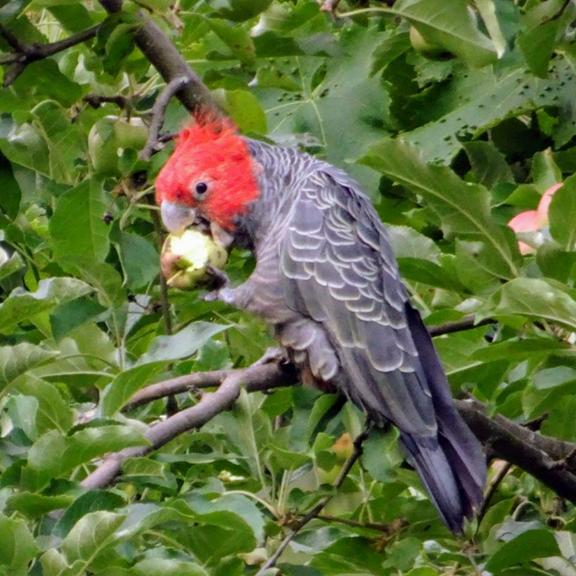

04/02/2018: Ultralight Power Bank - Nitecore Chargers:
The Nitecore F2 Charger: 46.5 grams plus battery weight, eg two X 18650s at 48
grams each = 6800 Mah of charging for a weight penalty of 142.5 grams (not
bad), but if you add a second pair of batteries (96 grams) you have 13600 Mah
for 238.5 grams which is just about unbeatable. The best bit is you can even
use smaller, lighter lithium batteries for a shorter trip: http://charger.nitecore.com/CHARGER/F/F2/
The batteries can be recharged with a USB cable even from a solar charger on
the trail.

The
Nitecore F1 charger is even better weighing only 30 grams. Add one 18650battery for 3400Mah at 47.6 grams
(Total 77.6 grams) or as many more as you need, so this little guy plus four
batteries equals 220.4 grams for 13600 Mah!. You can’t beat that. Or you can
add an even lighter battery if your needs are small: http://charger.nitecore.com/CHARGER/F/F1/ I bought one of these for under A$10 on eBay!
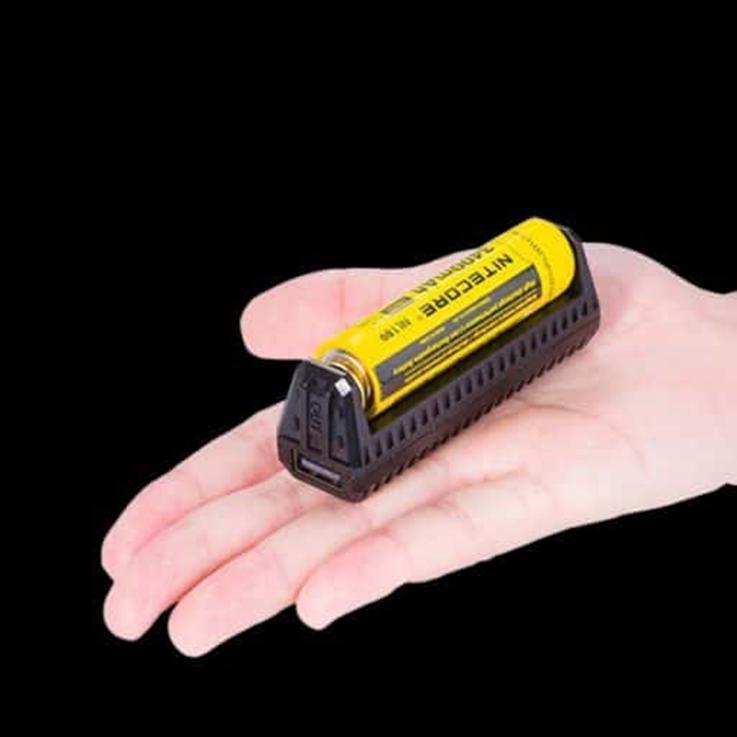
PS:
You
will notice that the device will charge other battery sizes. The 14500 battery for example is identical in size
to a AA and the 10440 is identical in size to the AAA. Some/many torches made
for this size battery will take a lithium 3 volt battery though they will heat
up a lot on full beam - and may burn out the LED. You will need to check this against
the torch you own.
When
storing (lithium) or any batteries in your pack you should keep them together
with a rubber band and place them in a ziplock bag to prevent their
touching/discharging – there is very little if any risk of fire from 18650
batteries as they have internal circuit protection against such risks.
See
Also:
http://www.theultralighthiker.com/charging/
http://www.theultralighthiker.com/ultralight-usb-cables/
http://www.theultralighthiker.com/powerfilm-usb-aa-solar-charger/
http://www.theultralighthiker.com/smallest-rechargeable-flashlight/
http://www.theultralighthiker.com/11-gram-rechargeable-head-torch/
http://www.theultralighthiker.com/recharge-needs/
http://www.theultralighthiker.com/clear-pvc-backpack-lid-for-solar-charger/
http://www.theultralighthiker.com/mobile-phone-battery-life/
http://www.theultralighthiker.com/power-from-heat/
04/02/2018: Hiking Makhani Dal: You can make a
delicious Makhani Dal for the trail very simply and inexpensively. The recipe
below will make over a litre of dal which is more than Della and I can eat for
a meal between us. If you want to halve the cooking time you can put the
lentils in a zip lock bag in the morning with some water to soften for the
evening meal. Otherwise just carry the ingredients in a single ziplock bag and
put them together in your pot, bring to the boil, stirring occasionally and
simmer uncovered for approx 20 minutes (that would be about 40 mls of alcohol
fuel). This meal would be about 800 calories. Obviously if you prefer a bit
more 'bite' to your meal you could add a touch more of any of the ingredients
(eg the chilli/paprika). More protein could be added (as with the other Dal
recipe below) by adding some of this: http://www.theultralighthiker.com/hormel-real-bacon-pieces/ Freeze
dried peas (such as Surprise) may also make a welcome addition.
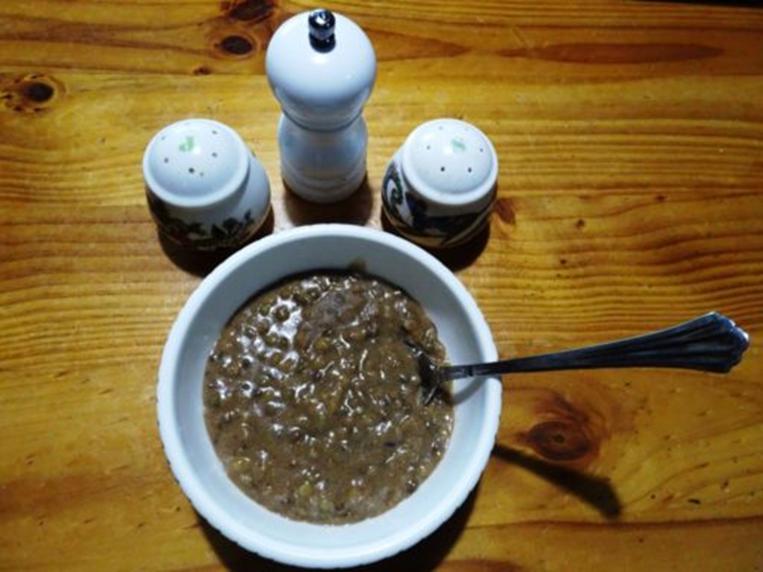
Ingredients:
See
Also:
http://www.theultralighthiker.com/a-simple-backpacking-dahl/
http://www.theultralighthiker.com/a-hiking-food-compendium/
04/02/2018: The International Space Station transits
the face of the moon (zoom): https://www.flickr.com/photos/nasahqphoto/25126863227/in/album-72157692848342575/
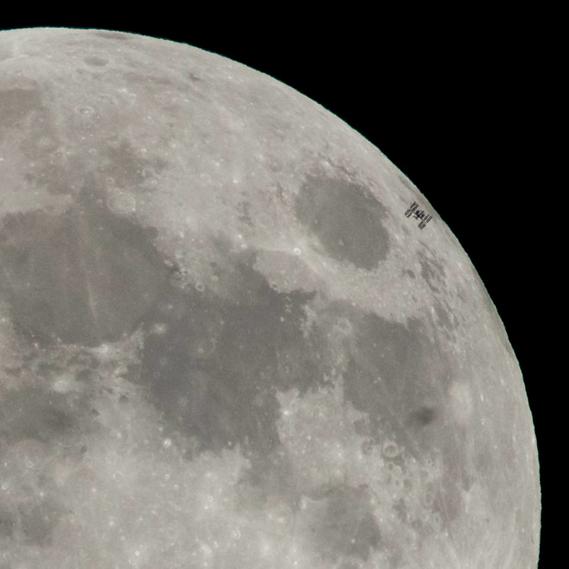
04/02/2018: Serpentine feathers: Della may begin
collecting all her pigeons’ feathers once she sees this :
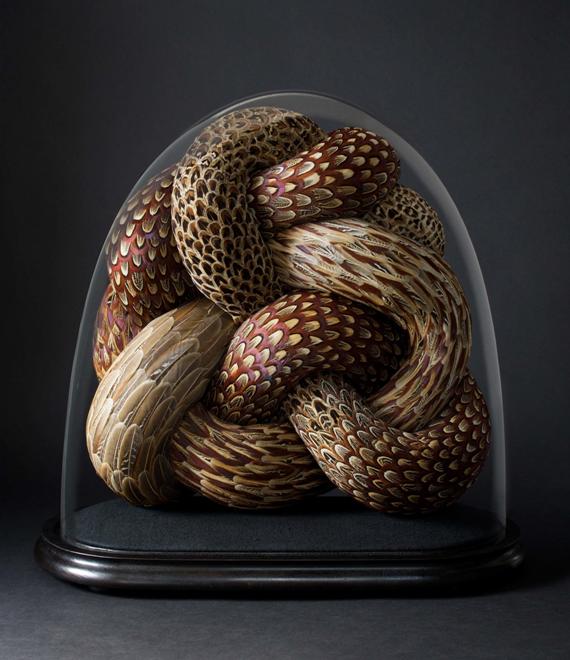
http://www.thisiscolossal.com/2018/01/seething-sculptures-kate-mccgwire/
02/02/2018: Meanwhile, I need to get my hands on a
bunch of these (Midas) bacteria: https://wattsupwiththat.com/2018/02/01/weird-science-bacteria-that-poop-gold-nuggets/
30/01/2018: Five years ago
today: reflections on my back op: After
just 4 days in hospital spent mostly fighting for my freedom, I can definitely
say that the worst thing anyone can do to you is take that freedom away;
unfortunately that is just what sundry busybodies, do-gooders and major and
minor tyrants see as their vocation in life. The only appropriate punishment
for such folks is death; instant and without either hesitation or remorse. In
the context where they had me imprisoned, they understood that I was at the
bottom of their hierarchy - instead of being at its top where I was, in fact
their employer (having even paid in advance) and they were my servants, having
been paid to provide me with a designated service. Instead of eagerly conceding
to my every wish (such as a whole two Cascade Premium Lights with my tea once
per day) they fought to a standstill with what they saw as the benevolent
concession of one (and very old stock at that!). Fortunately I had an ample
supply of Dimensions Cab Sav cleverly disguised by the masterful Della as
Cranberry Juice. It was more than somewhat amusing to be delicately sipping on
this before their very eyes whilst energetically arguing for my second stubby
of Cascade...
The
experience did however sharpen my focus on the relativity between punishments
other than Death, and itself. Some time ago a Roman writer named Sallust wrote
a book named 'The Catiline Conspiracy, (You can download it here: http://www.gutenberg.org/ebooks/7990 ). In
this book there is a lengthy discussion about the virtues of various
punishments which might be awarded to the nabbed conspirators in the case (who
had in fact done nothing - conspiracy not then being agin the law). Some argued
for a thorough whipping (howled down as fit only for slaves); others for
imprisonment (completely ruled out as un-Roman and too, too cruel), so the
obvious conclusion was the fairest and most sensible: Death - and so it was
done. When I first read this book, I too was still a captive and victim of
demonic and dispirited leftist orthodoxy and thought 'how different - indeed
how wrong - the ancients were to ourselves'; Now I realise it is us who are
very wrong. Death is certainly the lesser penalty to imprisonment and should
always be the first choice. It makes no sense to cruelly (not to mention
expensively) imprison an offender and continue to punish him, (then later let
him out to offend again) when it can mercifully be over in a trice and the
offenders' spare parts used to save a multitude of lives! So mote it be!
29/01/2018: Cairns: We had a week near Cairns at
the end of August I forgot to share. All I mentioned so far was our ascent of Mt Bartle Frere and the crocodile we
encountered in Lake Placid. We also walked up to some
waterfalls in the Barren Gorge. There are heaps of tracks. You can even hike up
to Kuranda and catch the Skyrail back - which would be a good trip.
Here
is the croc basking on the bank of Lake Placid
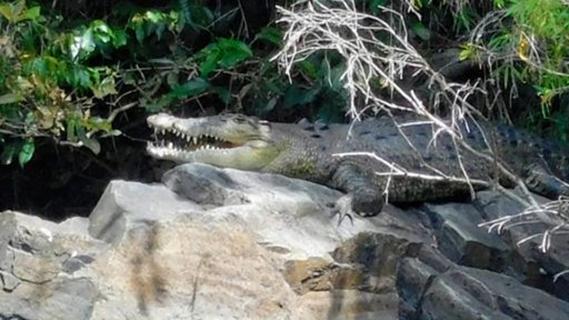
Barron
River
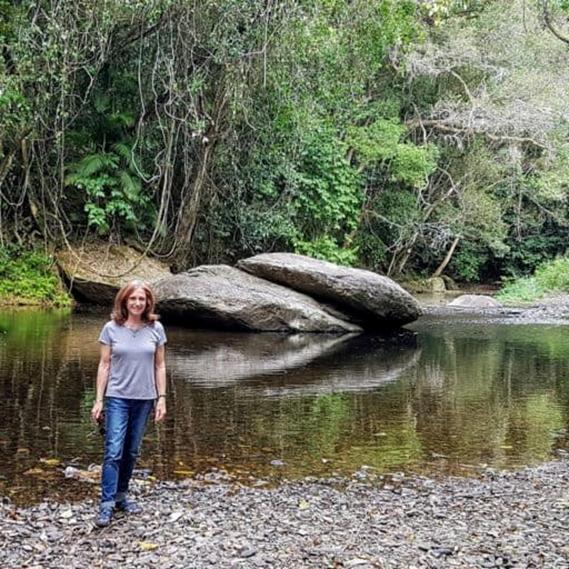
Cairns:
Crystal Cascades. A short walk to remove the flying kinks. A pretty nice
looking swimming hole; will pack swimsuit next time, as weather here is a
pretty warm 27 degrees max. Preparing to tackle the big hike up Mount Bartle
Frere over the next couple of days.

Crystal
Creek Cascades

A
lovely day acclimatising to sunny Cairns! Kim Henry accompanied us on some
small walks around Lake Placid, the Cattana wetlands and along the Stony Creek
Weir Track. Unexpectedly we were able to see a good sized croc on the edge of
Lake Placid after only a 5 minute ramble along the opposite bank. Steve's
little Nikon Coolpix S7000 captured it very nicely!
Kim
Henry Stony Creek Weir Track
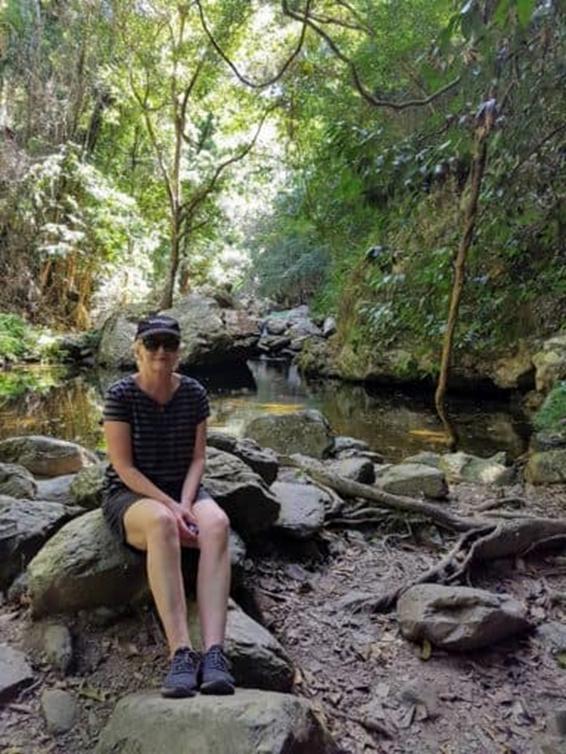
Stony
Creek Weir Track
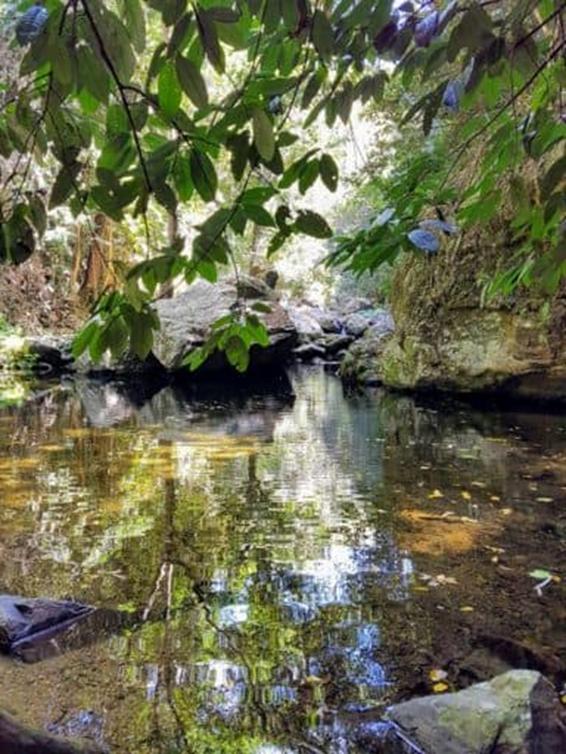
Cattana
wetlands
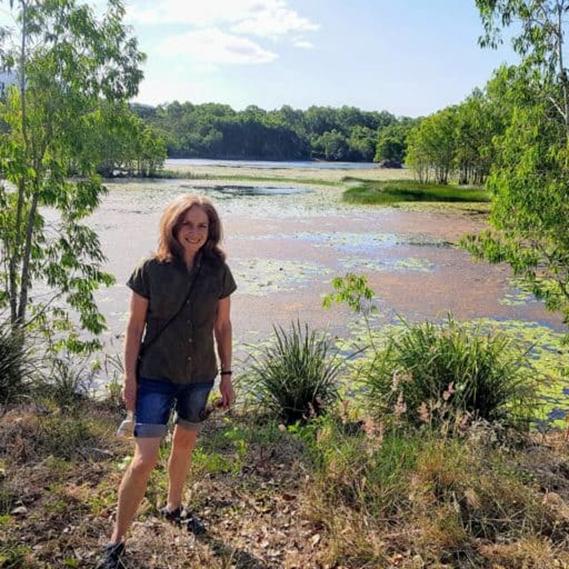
Cattana
wetlands
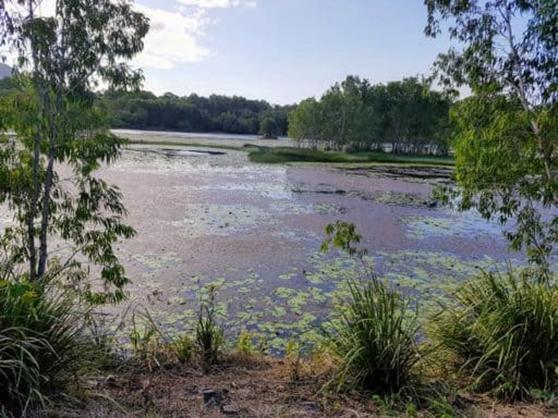
Della's
take on Bartle Frere:
Tonight
we are camped just near the summit of Mount Bartle Frere. The going has been
tough but we expect to make the summit early tomorrow. Mobile service is
unexpectedly available. A little weary but not heart-sore! (PS: Della is very
pleased with herself as she has been exercising like mad to overcome
microvascular angina. This was her first big walk, and she triumphed!)
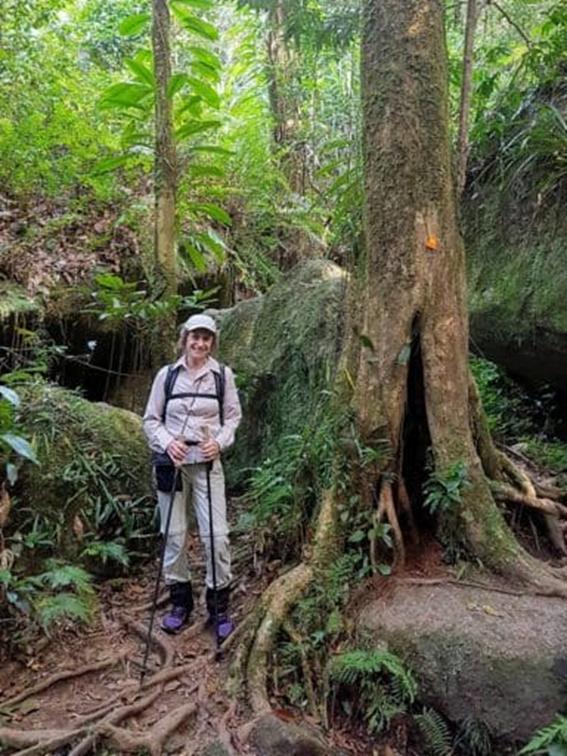
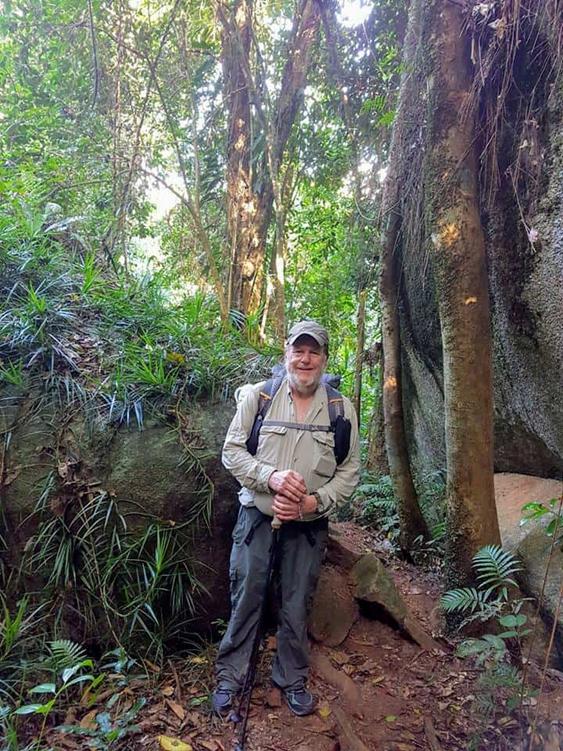
Lots
of tree-root ladder work...in fact most of the track has been constantly
vertical. 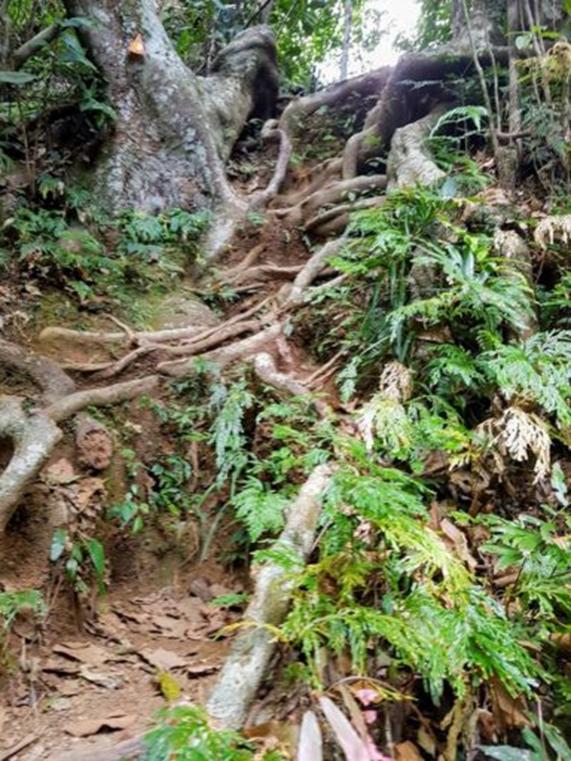
One
of the stream crossings

Delightful
bracket fungi!

Victory!
Mount Bartle Frere done and dusted. In a motel in Innisfail tonight too tired
to even contemplate a champagne....Tomorrow night may be a different story! We
reached the top in cloud forest mist this morning after an amazingly
challenging climb. The approach to the top involved negotiating a formidable
boulder field that felt like a mountain climber's nightmare. Some of the leg
ups were far wider than my short limbs could possibly reach so I was very
grateful for Steve's assistance in hauling me over the yawning chasms! The view
from the top was non-existent, due to the heavy mist, but Bartle Frere was all
about the journey rather than the destination. The steep descent that took us
all of today was cruel on our overstretched leg muscles so I may be hobbling
for a day or two!
Cloud
forest this morning
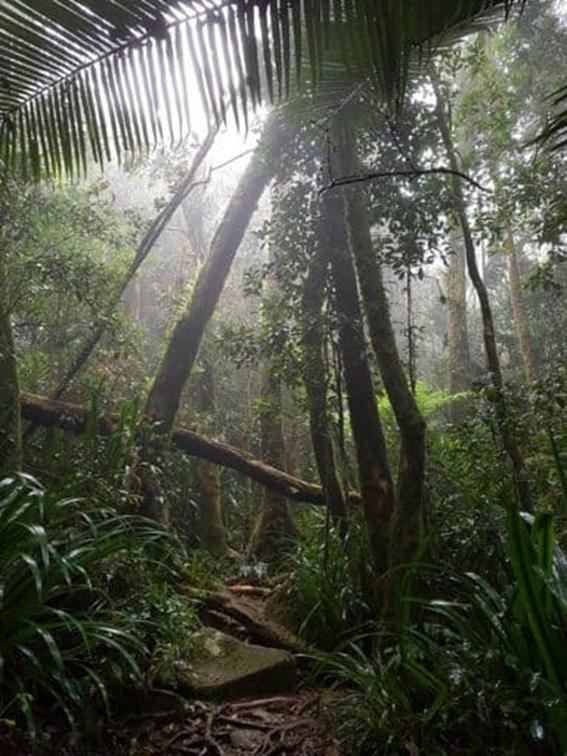
Hanging
out with some bracket fungi this morning. 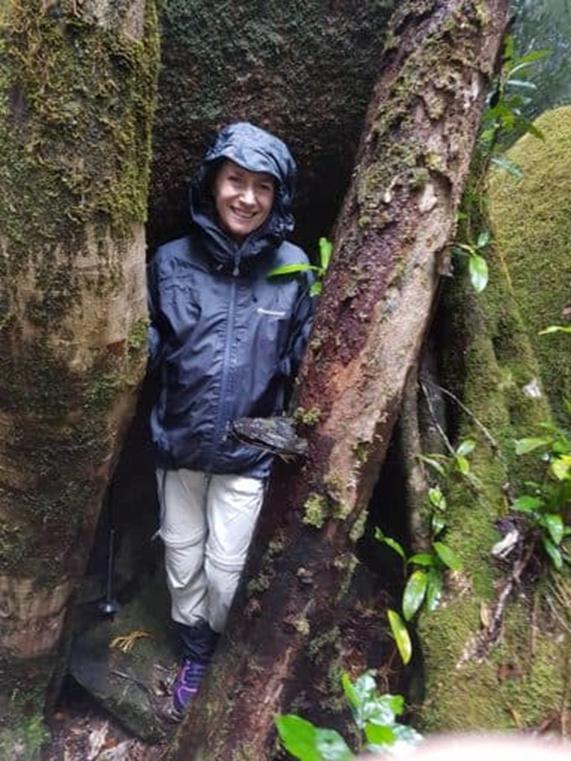
The
boulder field begins.
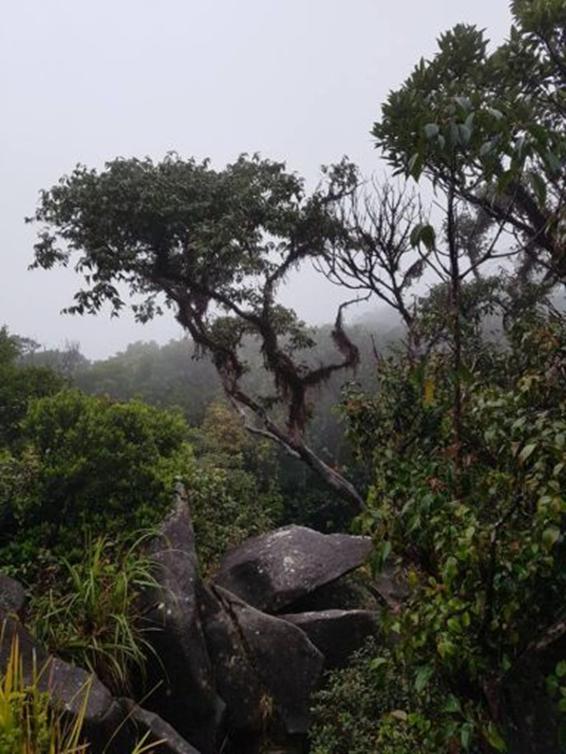
Half
way up the boulder field, looking down the route. No pictures can quite capture
the steepness of the climb! 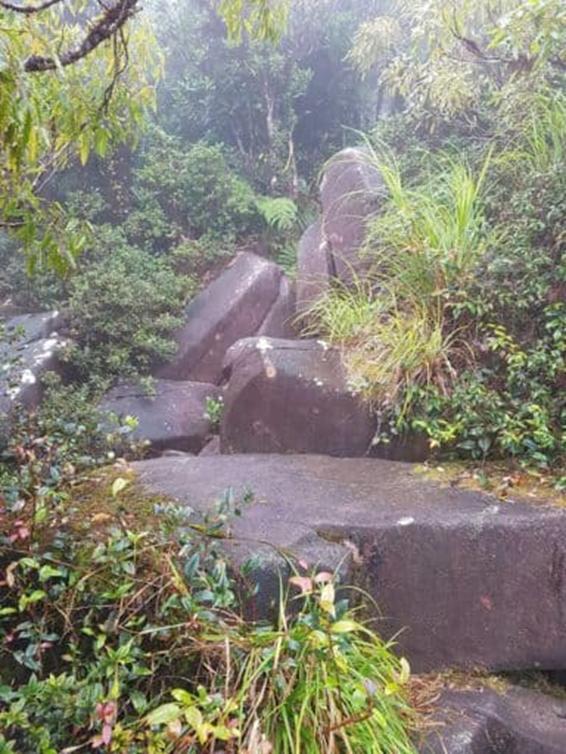
Bartle
Frere - the final ascent.
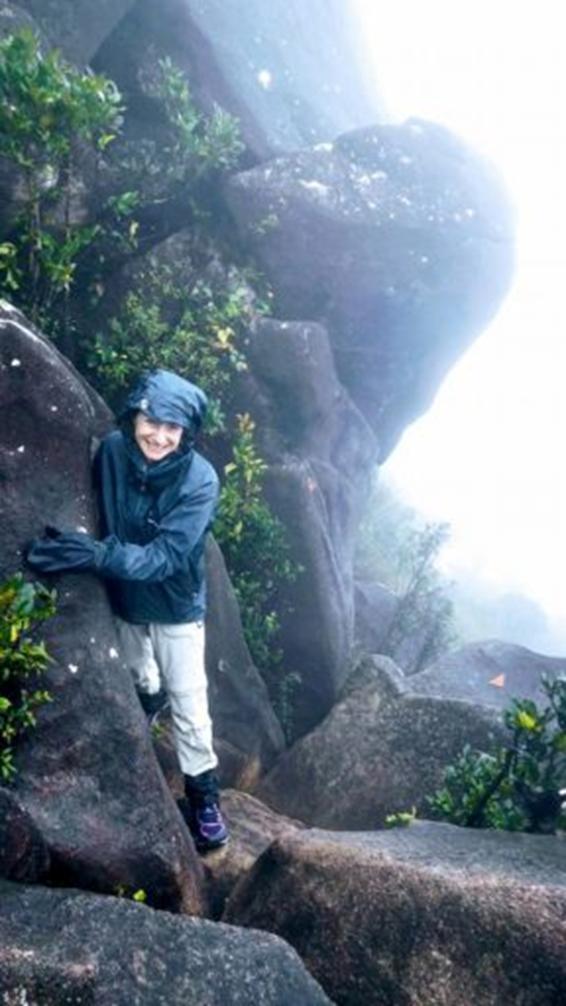
View,
such as it was, from the top.
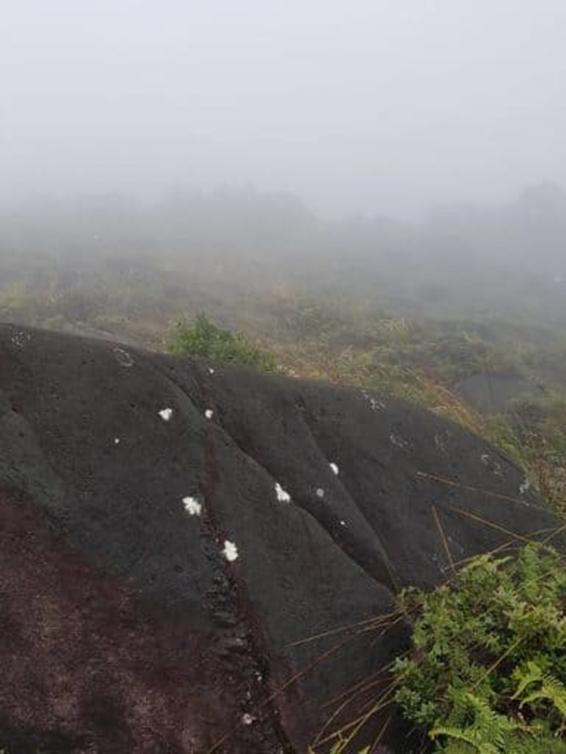
Last
night's camp: Tent in the mist! 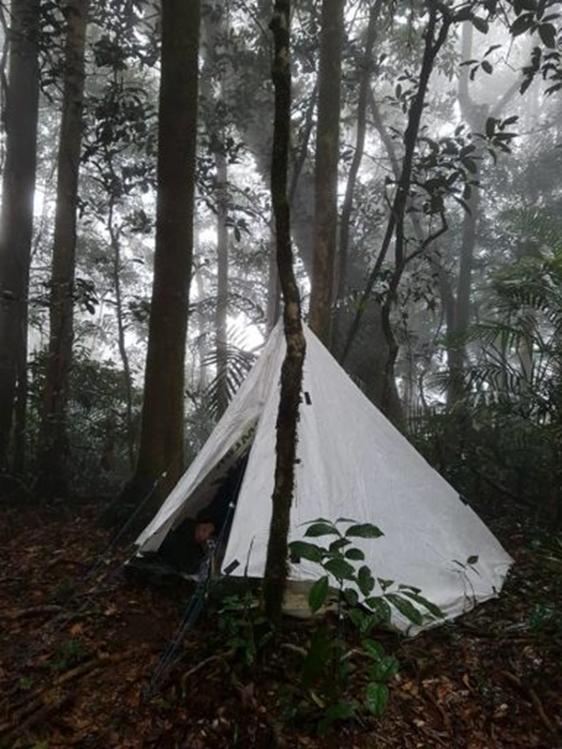
Looking
back towards Bartle Frere from the Palmerston Highway - 1650 feet or so...a
satisfyingly big mountain.
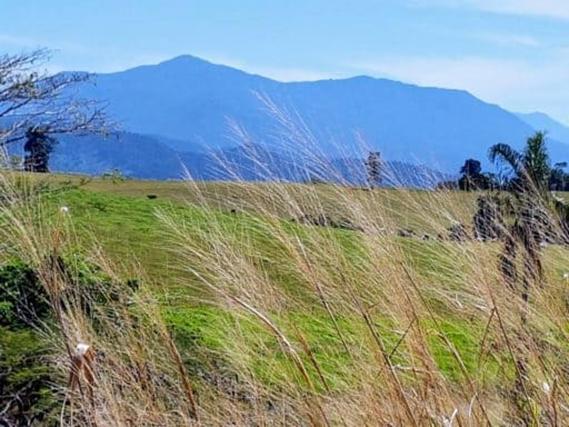
A
tale of 2 waterfalls: The first one, Milaa Milaa Falls, is the most
photographed waterfall in Australia. I snapped it on my camera phone amidst a
riot of tourist buses, Winnebagos, heavy-duty camera apparatus and shoulder-
deep people.The second and third , Millstream Falls, only about a half-hour's
drive away, is one of the least visited waterfalls. We had it totally to
ourselves. The surrounding vegetation was not quite so tropical, the feature
not so manicured, but a far more impressive display in my opinion!

I
really liked the Millstream Falls too, and its association with WW2 history.
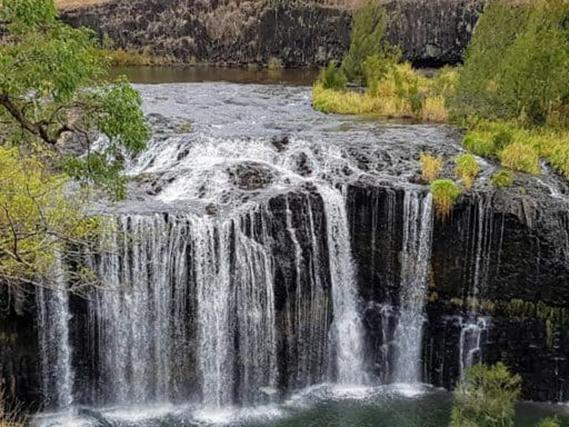
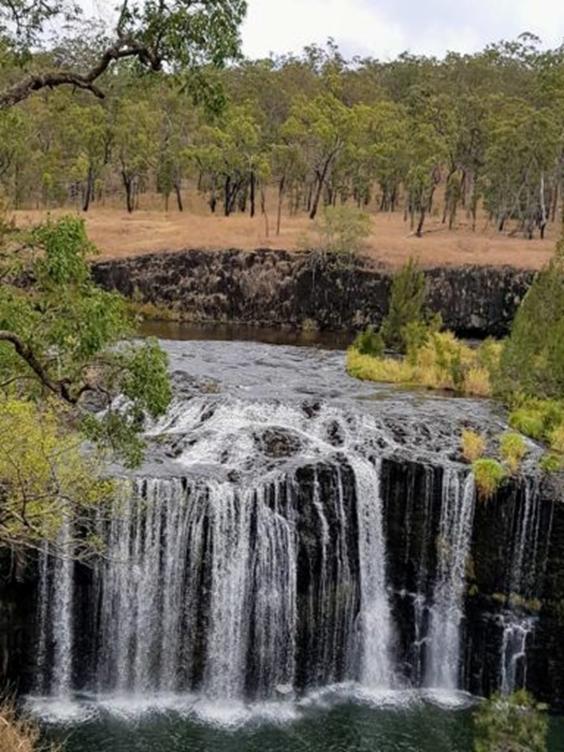
So
we have spent the last 3 days exploring from Atherton across to the old mining
towns on the edge of the savannah lands: Innot Hot Springs, Herberton,
Chillagoe and Mungana. The land changes so quickly from rainforest to savannah
and the old mining towns were well worth a look!
Chillagoe
Creek - quite a respite from the heat of the day.
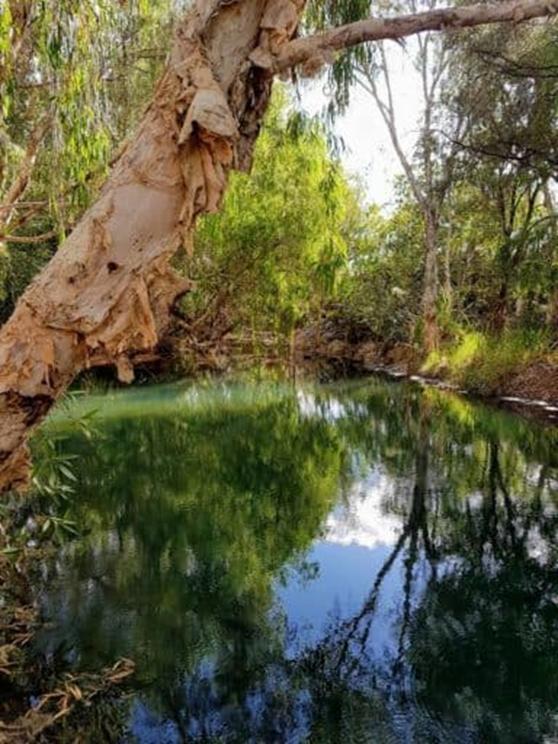
Inside
one of the limestone caves at Chillagoe-Mungana National Park.
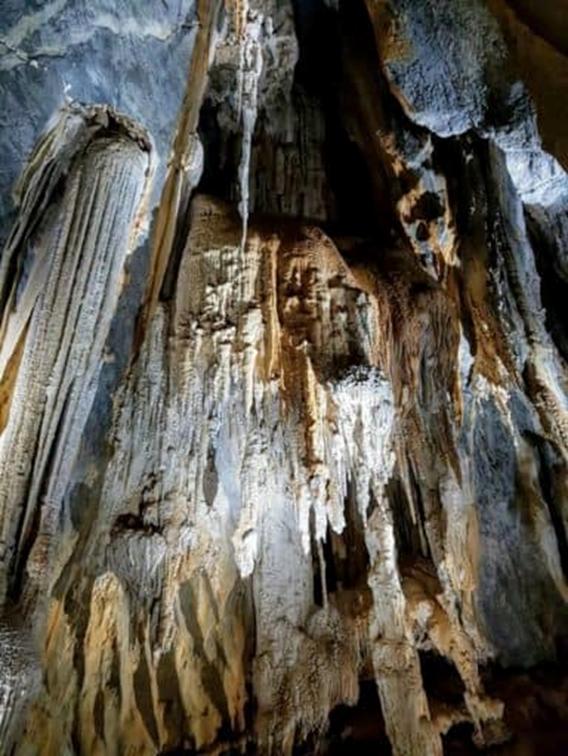
And
this interesting paper wasp's nest.
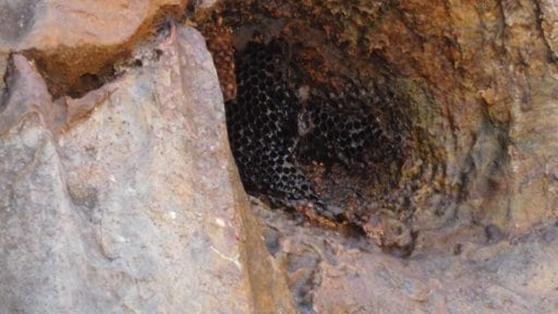
Snapped
this guy inside a very dry cave! 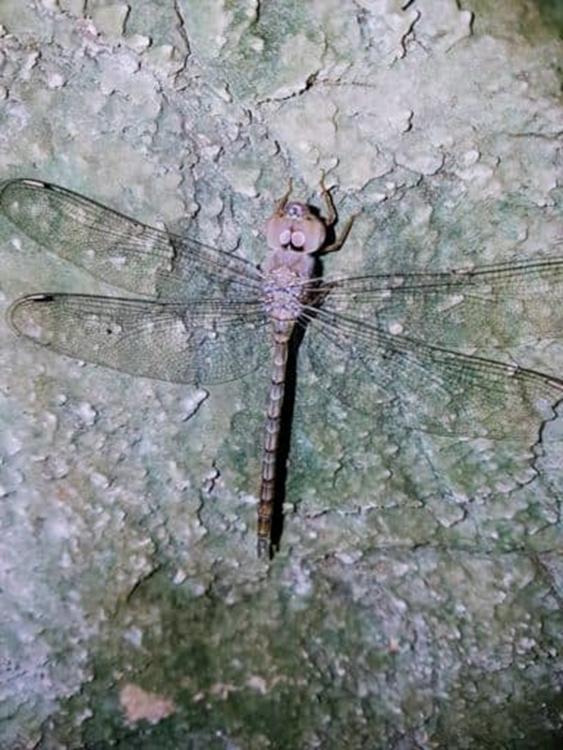
View
from old Chillagoe copper smelter across the savannah. 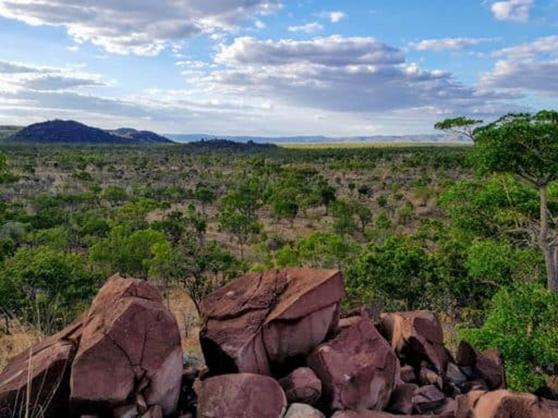
Remnants
of the old Chillagoe copper smelter.
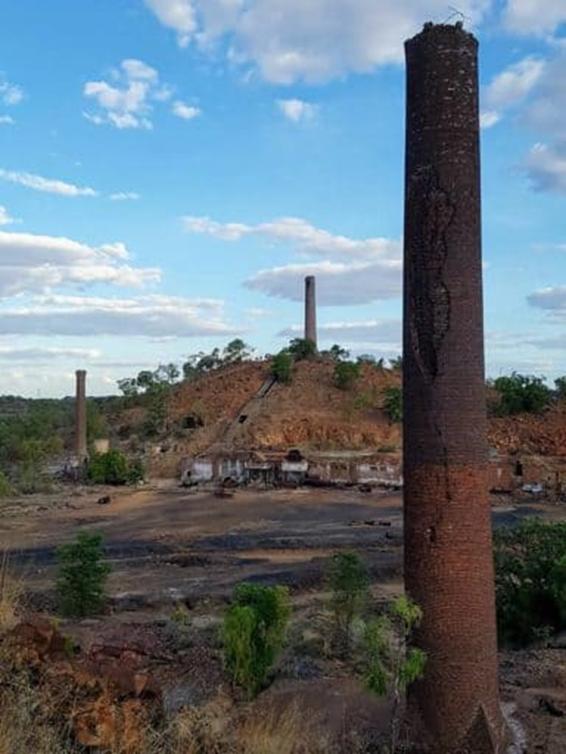
The
kapok tree is quite a stunner.

An
Agile Wallaby. What a beautiful little guy this one was.
Don't
you wish you loved a bath as much as this?

The
light in this Mungana cave was delicious. Steve inside the Archways, Mungana
National Park.
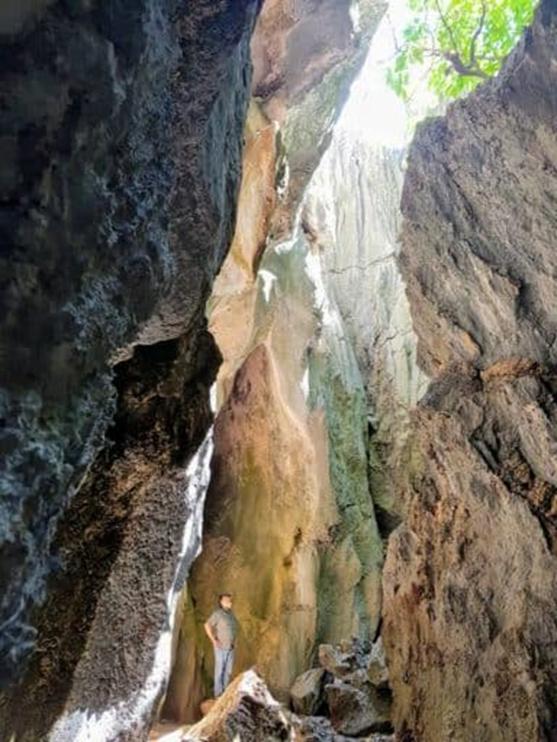
Love
these dry riverbeds - they look like great spots to camp, particularly if you
love birdlife.

Dry
creek bed on the road from Herberton. Cows, brumbies...lots of road hazards
with unfenced stations.These wonderful Qld cows seem to love them.
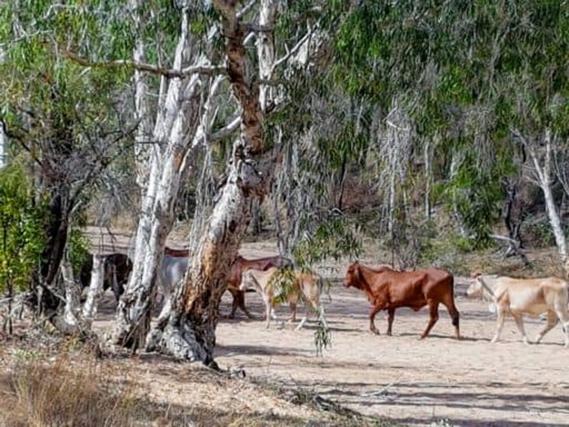 According to the locals you should never buy termite country
because it is low in phosphorus - this patch must be particularly low!
According to the locals you should never buy termite country
because it is low in phosphorus - this patch must be particularly low!

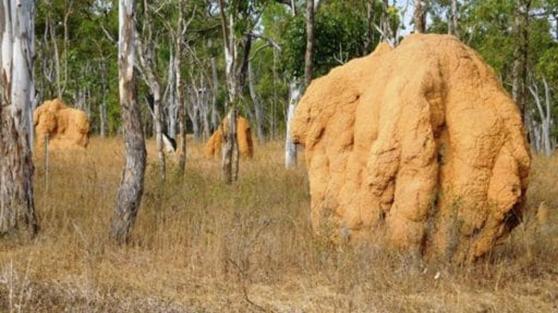
Many
grand spider's webs around Chillago 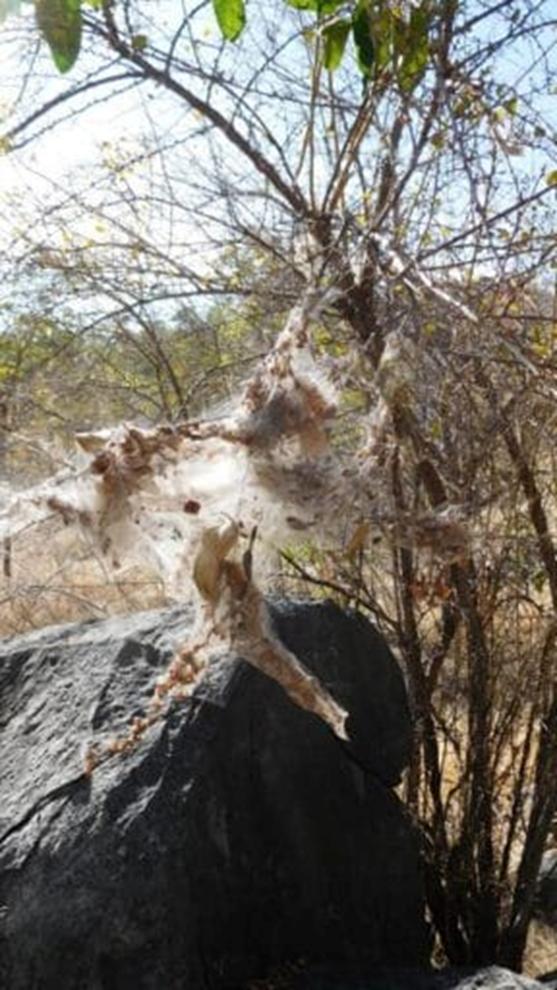
So
many wonderful pigeons up here. Della is in seventh heaven.a Top Knot. 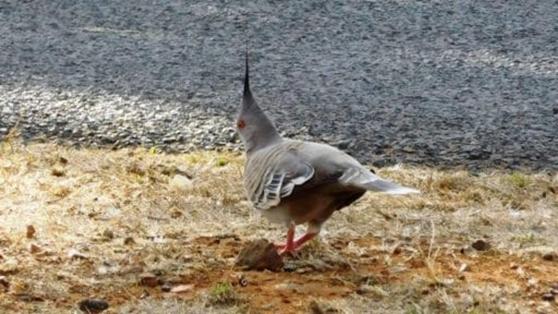 A prosaic farm dam can be a thing of great beauty.
A prosaic farm dam can be a thing of great beauty.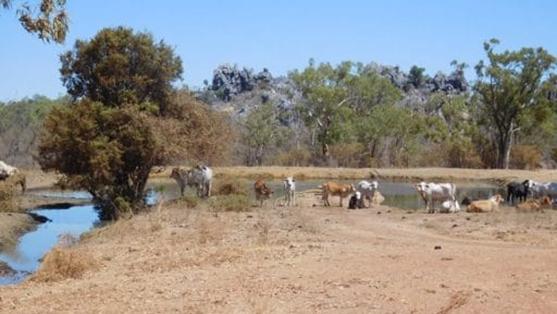
On
the 'Development Roads you do have to watch out for
these guys - and the immense dust cloud they trail.
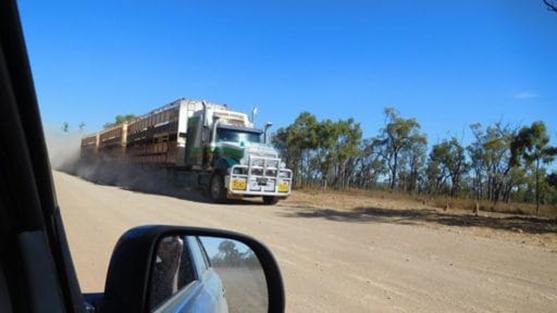
See
Also:
http://www.theultralighthiker.com/mount-bartle-frere/
http://www.theultralighthiker.com/you-can-do-it/
http://www.theultralighthiker.com/lake-placid/
http://www.theultralighthiker.com/cloud-forests-of-north-queensland/
http://www.theultralighthiker.com/cairns/
29/01/2018: The human
story just got older still: http://www.bbc.com/news/science-environment-42817323
28/01/2018: Drone
Hunting: My son had a lot of lazy money so he bought one of these DJI Mavik
drones I had been talking about for some time. What an amazing little gadget it
is. It is only a question of time before they are banned.
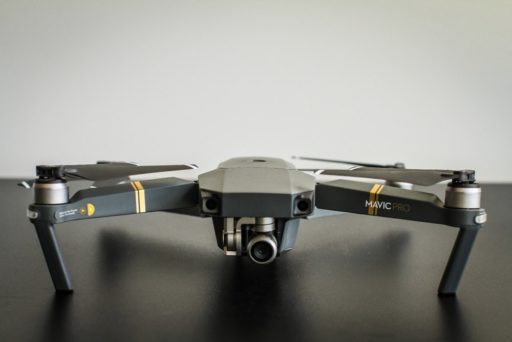
He
brought it round one day in Spring when we were having a social gathering (a
birthday perhaps) so we could all see how it worked – and it worked
wonderfully.
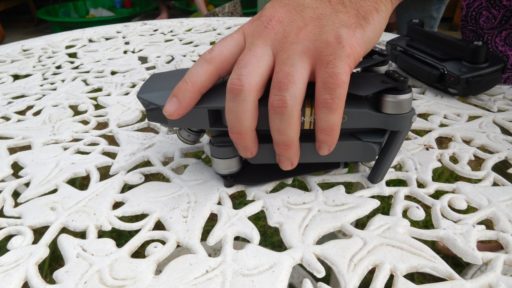
It
starts off (and lands) on an outside table. He can take it way up so that you
get a bird’s eye view of our (messy) farm and its environs. The swallows
swooped it mercilessly.
He
could send it way out of sight down to the farm dam on the creek where he could
observe the behaviour of some wood ducks with it.
Then
he used it to round up the sheep from the paddock. This could be handy.
These
little guys are amazing. They fold up about as big as a large grapefruit. They
clearly stow in a backpack. They weigh 734 grams including the battery - and
the batteries weigh only approx 250 grams each. A battery gives you a run out
and back about 12 km and nearly thirty minutes. They return automatically to
base and won't run into things. They are so quiet. They shoot high def video.
They are amazing! Check out the details below.
It
could also easily be (mis) used to observe deer, even to chase them back to
your vehicle for easy shooting and retrieval. Who needs hounds? No doubt
others will invent even more nefarious uses for them. As I say, it won’t be
long before they are banned. This one cost around A$1500 from JB Hifi (Nov
2017).
I
think we will have a lot of fun with it anyway before they ban them.
I
have stitched together some video taken of it on the day with my old camera,
and from it into the Youtube video below. this is my first attempt at video
editing, so it is not very professional. Still, I think you will enjoy the
drone rounding up the sheep from the hill paddock (last minute or so.:
https://youtu.be/aV0xPoHGcuE
DJI
Mavic, the pro-grade camera drone that fits in your pocket:
https://www.dji.com/phantom-4
http://www.dji.com/mavic?site=brandsite&from=nav
https://newatlas.com/dji-mavic-pro-review/48204/
https://newatlas.com/dji-mavic-pro-review/48204/
27/01/2018: Gossamer Gear Air Flow SitLight Camp
Seat: The quest for a dry back when hiking is never ending. I confess I punched
a pattern of holes with a wad punch just like this in my Sitlight Pad prior to
our Bartle Frère walk
back in September for use on my Gorilla Pack. It certainly improved the
situation a lot, but it was so humid in Nth Queensland it was hard to tell how
efficacious the modification was. GG have added some wicking mesh as well which should
improve the situation even further however. It only adds a fw grams,
and makes a comfy trail seat during the day as well. Worth a try anyway at only
US$24 (January 2018).
My Gorilla. See holes in pad. Note lightweight belt.
Gossamer gear now sell a similar one.


Details:
‘This
upgraded air flow sit pad doubles as a back panel padding for our packs and an
ultralight camp chair. Available in 3 sizes.
For
the Kumo or Murmur you will want the Medium size pad for all other packs order
the same size as your pack.
The
Air Flow Sit Light ultralight camp seat. Designed specifically to be used in
the pad pocket of any of our overnight backpacks. This multi-use featherlight
pad will give structure to your pack, cushion your back and allow some air to
circulate between you and the pack while keeping the pack body close to you.
The SitLight can also be used to sit on in camp or during breaks, to lengthen
your existing sleep pad or as a base for your pillow.
The
foam is amazingly light and strong for its density. The pads are tough,
flexible and resilient, and exhibit good UV stability.
Weight
- Varies slightly; all weights are approximate averages
Dimensions
Material
See
Also:
http://www.theultralighthiker.com/hip-belts/
http://www.theultralighthiker.com/pimping-a-gorilla/
http://www.theultralighthiker.com/the-silverback/
http://www.theultralighthiker.com/attaching-tie-downs-to-your-pack/
http://www.theultralighthiker.com/a-gorilla-in-the-hand/
http://www.theultralighthiker.com/a-gorilla-in-the-bush/
http://www.theultralighthiker.com/a-tardis-folding-space/
27/01/2018: Don’t bite
a smart phone battery: https://www.theverge.com/2018/1/23/16923200/china-customer-bites-iphone-battery-replacement-explosion
25/01/2018:
Ultralight Gardening: I bought one
of these mini picks for Della. The handle was a little short, so I cut it off
and welded a longer one on (her length). I have been out in the paddock hoeing
thistles with it (It weighs less than a kilogram) and it is just marvelous. I
will get another and weld a slightly longer handle on it to better suit my
height. Just used a length of light weight galvanized metal pipe. At A$55 (Jan
2018) it is a great tool. Just sharpened it up a bit with the angle grinder.
Best thistle tool I have ever used! You can even swing it one-handed. http://www.minersden.com.au/walco-mini-pick
‘Mini pick ideal for gold fossicking. Handle Length: 40cm. Pick and Hoe
Size: 23cm x 8cm. Weight: 796 grams’.
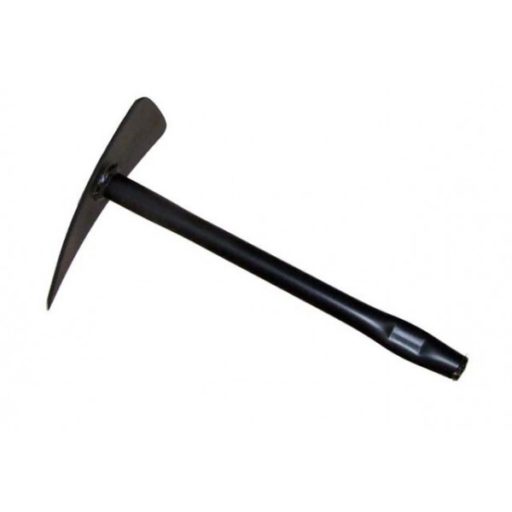
Another
gift for her was this lightweight Fiskars shovel. It isn’t suited to heavy work
such as digging postholes in hard ground. But it is great for turning the spoil
in the veggie garden or planting out shrubs etc in moist garden soil. And it is
light enough she enjoys using it! http://www.fiskars.com.au/products/gardening/shovels-spades/light-digging-spade-1019605
These are available at Bunnings A$42.58 (Jan 2018)
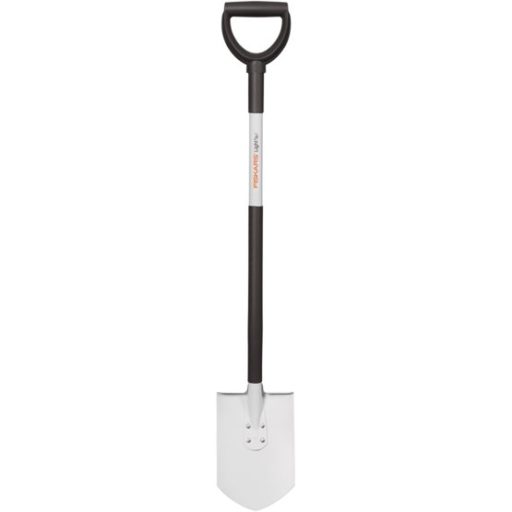
For
light weight pruning these are hard to beat too. The 120 grams Fiskars Xtract
Garden Saw. As you can see it telescopes and clips to your belt. A wonderful
tool – also great for hiking. https://www.bunnings.com.au/fiskars-xtract-garden-saw_p3360611
These are also available at Bunnings. A$39.98 (Jan 2018)

Other
light weight Fiskars tools. The rake would be my next purchase perhaps: http://www.fiskars.com.au/products/gardening/ranges/fiskars-light
You
also really need the Gerber/Fiskars Brush Thinner Machete. It is lightweight
(under 400 grams), and the hooked design means it really cuts instead of
bouncing off. It will easily slash away hanging blackberries which nothing else
will touch, but will also lop away 1"+ thick branches and trees with a
single blow. It's just great. Try to get the Gerber version which has a cordura
sheath. Try a supplier in NZ if you can't source one in Oz - otherwise you will
have to go the route: Amazon > Shipito > Oz..

See
Also:
http://www.theultralighthiker.com/hatchet/
http://www.theultralighthiker.com/ultralight-saws/
http://www.theultralighthiker.com/the-worlds-greatest-machete/
25/01/2018:
I see I had my back op four years ago
today. For those of you who continue to suffer back agaony let me reprise
you. I had a laminectomy which in my case involved removing several bony spines
which were threatening to anytime sever my spinal cord. I went in to the op
pretty much in a constant state (for years) of being in tears with the pain
which no medication would touch. When I woke up from the op, I could get
straight out of bed and go for a long walk without any pain at all. I had
microsurgery from a neurosurgeon. A neurosurgeon can repair damage to the dura
which no orthopedic surgeon can. The incision was about an inch long and quite
invisible once it had healed in less than a week. There was nothing I could not
do straight after the op. Next day I was building a fence. I went for a long
hike as soon as the skin had healed over so I did not get any nasty infections
in it. I hope (for your sake) you didn’t need to know this, but if you do, good
luck. I hope your outcome is as good as mine has been. I have my life back!
25/01/2018:
I’m glad my kids didn’t demand this, as I might not have survived –
toast soldiers and fairy bread triangles were hard enough: http://publicdomainreview.org/collections/the-art-of-ornamental-orange-peeling/
24/01/2018:
22 Jan 1879: Remembering Rorke’s Drift: 11 VCs were awarded for this single engagement; the
greatest number in history: http://neveryetmelted.com/2018/01/22/rorkes-drift/ & http://en.wikipedia.org/wiki/Battle_of_Rorke%27s_Drift
There should have been 12 but back then you could not win an award
posthumously. Strangely one hero was forgotten for over a century: http://www.telegraph.co.uk/history/9971953/Forgotten-survivor-of-Rorkes-Drift-returned-to-official-records.html
23/01/2018:
Ultralight Clothes Pegs for Hiking:
How to dry your clothes when hiking? I have had a number of strategies.
First
I always wear clothing which is quick drying such as light weight ‘super wash’
wool and nylon for example. My first resort has always been my own body’s heat.
For many years I would wash my clothes at the end of the day, hang them overnight
to get them dry as best as I could – sometimes in front of a warm fire
this works excellently – all my home-made tents for example can have a fire out
the front to warm them – and include an inbuilt clothes line (Yes, even the Pocket Poncho Tent’) so that oftentimes my
clothes would be clean and dry in the morning to put on. If they are not I
would put them on anyway ('Ouch’, I know – especially on a cold morning with
the frost on the ground, but I have done this lots of times, (even in Fiordland
- you have to grow up sometime) and they would be dry in about fifteen minutes.
Only the first 2-3 minutes is unpleasant!
You
can see some clothes hanging right here in my Siligloo for example. They were dry by
morning, but this was a summer canoe trip on the Wonnagatta River,
Gippsland, Victoria where we live.
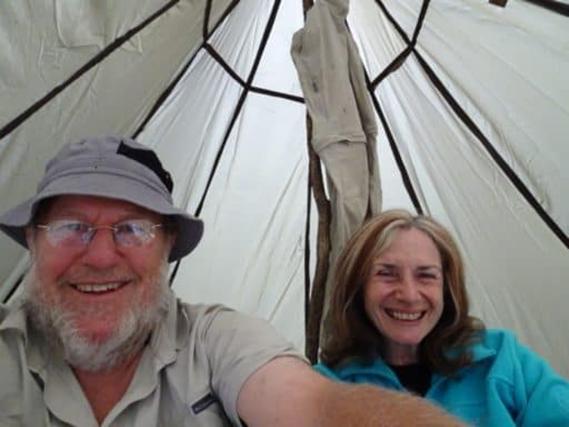
The
packs I use have side pockets and/or cinch straps on the sides, and also have a
back pocket from which you can hang your clothes with pegs/pins for safety. If
they do not I tie a piece of cord across the back. Then, when I am walking I
can peg/pin a pair of socks on one side, underpants on the other, and a pair of
trousers or shirt at the back.
On
a summer’s day your clothes will get dry in this way so you don’t have to put
wet clothes on. I have done this on the South Coast of Tasmania, on the Everest Base Camp Trek and many other
places.
Some
ultralight pegs/pins can still come in handy:
Go
fast and Light Ultralight Clothespin Clip: http://www.gofastandlight.com/Ultralight-Clothespin-Clip/productinfo/TO-D-PIN/
6.4 grams ea. Too heavy by far!

Plastic
bread bag clips: Interesting idea.
‘Tumbleweed’:
‘Simply go around the first tree with one end of the line until the tree is
about in the middle of the overall length of line. Then go to the second tree
with both ends, twisting the two lines (both ends of the line) together.
When
you get to the second tree, go around it, pull snug, and tie a half hitch or
two.
You
will then have two lines (connecting the two trees), that are twisted together.
Simply put the clothes between the two lines. No clothespins needed. Works
great. The twists in the lines keep the clothes from getting loose.
Takes
longer to explain it than to do it’. Good idea.
Modified
Hair Pin clothes peg: https://www.youtube.com/watch?v=k2PrpkpbA8w Doubtful.
You
can use your Kabar knife etc to split large twigs
halfway along their lengths to use as clothes pegs.
Or,
the peg in the centre below is a standard plastic peg from the supermarket.
Weight 4 grams. The two on the outside also from the supermarket weigh just
under 3 grams. I cut them in half, so approx 1.5 grams each. They work very
well. You don't need ,many pegs after all - half a dozen should suffice, say 10
grams!
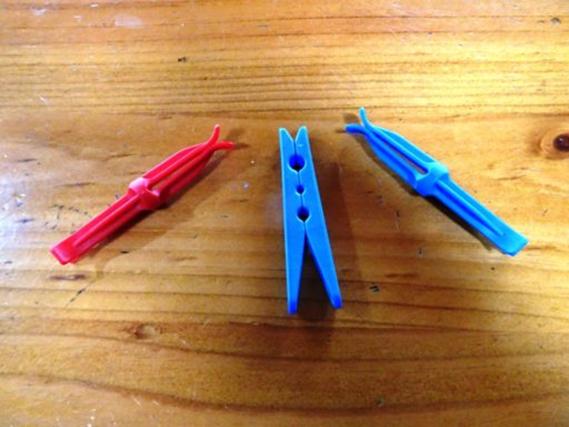
22/01/2018:
Amazing Lives: Jim Corbett and the
Man-Eaters: For those of you who came in late Jim Corbett’s life and
stories will still be an eye opener. During his ‘holidays’ he used to stalk and
kill man-eaters. Some of them had killed and eaten thousands of people! Really!
So this was tremendously dangerous ‘work’. As a youngster these 'ultimate'
hunting stories completely thrilled me - and they still do!
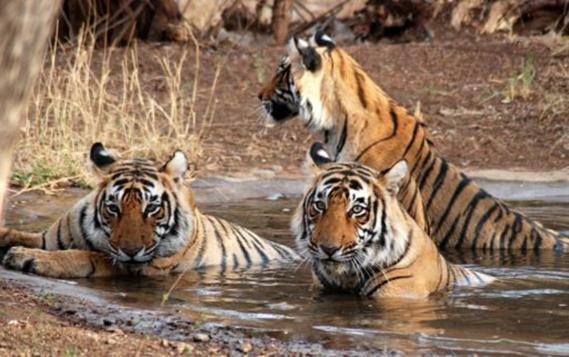
These
man-eaters were truly awesome: Who would have though t a leopard could silently
leap over a high wall (3.6 metres or 12') with the body of a cow in its mouth,
or that it could silently make its way through a crowd of sleepers
sprinkled over the floor of an inn in the middle of the night, its fur brushing
some terrifyingly as it passed, then selecting one, silently make its way out
again, leaping over a high wall with her body. Sitting up in a tree (no
protection really against such excellent climbers) in the middle of the night
again and again just waiting for a crack at one in the dim light was truly
harrowing and heroic 'work'.
He
was a First World War man. Corbett dedicated most of his life to service in
India. He stayed on in India after independence working for Indian wages, such
was his love of that country: https://en.wikipedia.org/wiki/Jim_Corbett

Such
was his recognized service to India that the largest National Park in India is
still named after him in his honour. There you can ride on an elephants and
still see wild tigers, sambar deer Indian rhinos, wild elephants & etc.
Possibly the best way to get there is (seriously) to hire a taxi for a few days
from New Delhi: https://en.wikipedia.org/wiki/Jim_Corbett_National_Park
& http://www.corbettnationalpark.in
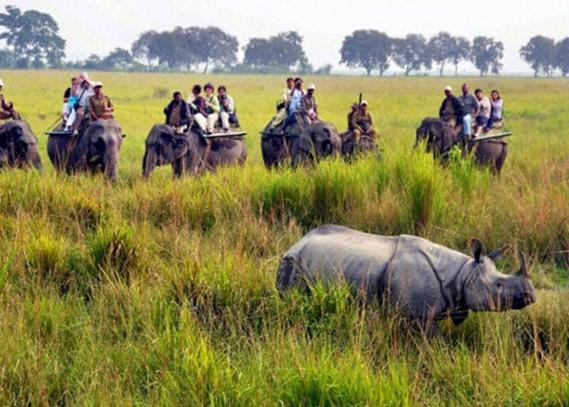
Many
of his books are free to download. For Example:
Man
Eaters of Kumaon: https://archive.org/details/in.ernet.dli.2015.215066
Tree
Tops: https://archive.org/details/TreeTops1955
The
Temple Tiger & More Man Eaters of Kumaon: https://archive.org/details/TheTempleTigerAndMoreMan-eatersOfKumaon1954
The
Man-Eating Leopard of Rudraprayag: https://archive.org/details/TheMan-eatingLeopardOfRudraprayag1947
My
India: https://archive.org/details/MyIndia1952
About
Jim Corbett: https://archive.org/details/00000CorbertBookFULLVersionWithPhotos
Lives
in the Wilderness: https://archive.org/details/LivesInTheWilderness-ThreeClassicIndianAutobiographies
PS:
I use the 'Cool Reader App to read such books on my phone. This is a wonderful
pastime when you are alone in the wilderness!

The
only book/adventure to compare with Corbett's was Col John Patterson's
Man-Eaters of Tsavo https://en.wikipedia.org/wiki/The_Man-eaters_of_Tsavo about
the truly giant lions which feasted on the poor Indians building this African
railway in the early years of the C20th. You can also download his book for
free. The Internet Archive is just great:
Col
John Patterson: The Man_Eaters of Tsavo: https://archive.org/details/in.ernet.dli.2015.37068
21/01/2018:
How to Travel Around the World With Just
a 20lb Backpack: People carry too much gear. We are planning a trip to Scotland this year
so we are working on how to fit everything we need into a couple of sub 500
gram backpacks such as these . For about a month
away we will want to be carrying sub 20 lb (<10 kg) on our backs at
all times, usually much less, so we will take these day packs as well..
We
will be hiring a camper, but we will also be doing some overnight/multi-day
hikes so we need a tent (so I will have to make a silnylon
version before we go) and all our camping gear. As Scotland is hardly the
untamed wilderness, there are things we normally take on forays into wilder
climes (such as Fiordland) which we will not need. This post gives you some idea of things
which I might normally take for a week’s trip into the wilderness.
This young man has spent a year touring
the world with just a 20 litre backpack and 20 lb (or <10kg) of gear). He is
wise. I see lots of travelling folk virtually crushed by 60+ litre backpacks
(which clearly weigh around 3kg empty - more than my basic gear list!) and
which are obviously 30+kg full. That’s a lot of weight and gear you just don’t
need and which can just make your trip a misery.
I
walked the Everest Base Camp Trek about 12
months ago (without a guide/porters) carrying all my own stuff, way less than
10 kg, probably not much over 5! I was prepared to camp out (on ice if
necessary) in sub -20C temperatures, and was prepared for every contingency.
Fortunately I was also prepared for the pneumonia which I contracted – as I
otherwise probably wouldn’t be writing this! So I am not arguing for anything
risky.
A
BTW: On the EBC there is a ‘tea house’ with accommodation/food/shopping every
few hundred metres – and there is mobile service practically all the way. I was
even able to video talk with Della via Messenger from nearly 6,000 metres up
from the top of this ‘hill’ near Dingboche:
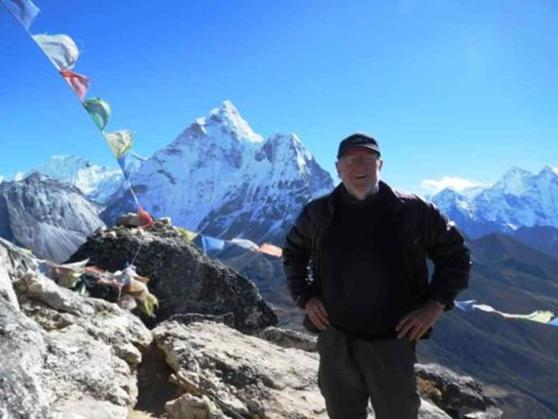
By
the same token, you can get stuck on some pass at this sort of altitude (in a
snowstorm perhaps), so you need that warm sleeping bag and comfy pad – and some sort of shelter, such as this. In such a situation you
might not be able to drive tent stakes in, and a helicopter might not be able
to land – or come!
For
example, I always have at least a Satellite Messenger/PLB. Della and I carry
these handy goTenna communicators which work
independently of the mobile system in case we become separated. To guard
against getting lost if you are inexperienced these Brunton devices are a good idea at
37 grams.
This
guy’s advice as to how he cut down his travelling gear to sub 20 lbs
(ie<10kg) is worth a look: https://www.artofmanliness.com/2015/01/21/how-to-travel-around-the-world-with-just-a-20lb-backpack/
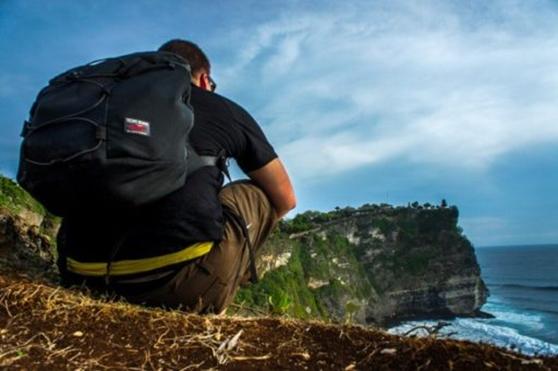
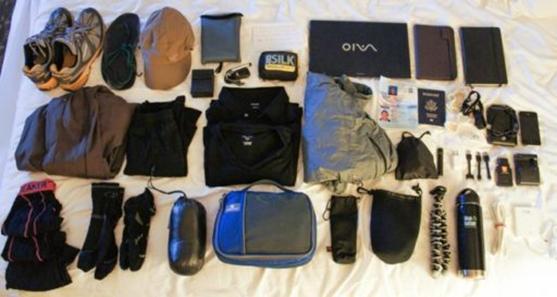
Here
is his gear list. (I would normally make quite a few weight/space savings on
this list – and of course I would also include gear which would give me the
ability to camp out. I might take an extra change of clothes if I was going
away for a year though – but you could get by with one change, I agree. Clearly
he is always planning to stay in some sort of accommodation - which would be
the opposite of what I would want to do! There are some ridiculously
heavy/bulky items here, eg the thermos! I could easily cut a couple of kilos
off his list - which would allow me the essentials of camping out! Some of
my alternatives in italics.)
‘The
everyday clothing I packed included:
2
t-shirts (Icebreaker)
2
pairs of socks (one by SmartWool, one by Icebreaker)
3
underwear (2 by Icebreaker, one by Exofficio)
1
pair of pants (Prana)
running
shorts (Prana)
cap
(Arc’teryx Spiro)
shoes
sandals
(Invisible Shoes)
The
cold weather gear I took included:
long-sleeve
Merino wool shirt (Icebreaker)
down
jacket (Montbell EX Light)
rain
jacket (Patagonia Super Cell) http://www.theultralighthiker.com/ultralight-rain-jackets/
mittens
http://www.theultralighthiker.com/ultralight-mitts-and-gaiters/
long
underwear bottoms
beanie
http://www.theultralighthiker.com/best-deer-hunters-cap-best-ultralight-cap/
scarf/face-mask
http://www.theultralighthiker.com/are-you-beautiful-in-the-buff/
Electronics
I packed:
laptop
with charger (Sony Vaio Z-Series)
camera
with charger (Sony NEX-5) http://www.theultralighthiker.com/ultralight-camera/
waterproof
sport camera (Kodak Play Sport)
Amazon
Kindle (I would read books on my phone)
pocket
flashlight http://www.theultralighthiker.com/lighter-brighter-better/
universal
travel adapter
USB
mini-cables (3″ cables for phone, Kindle, and Kodak) http://www.theultralighthiker.com/ultralight-usb-cables/
1.5
TB external hard drive
8
GB flash drive
Apple
iPhone Samsung Galaxy S4 Mini
The
miscellaneous gear continues to follow this theme:
insulated
water bottle (Platypus)
travel
clothesline
sleep
mask with ear plugs
silk
sleep sack
tripod
(Gorillapod) (http://www.theultralighthiker.com/4-gram-string-reverse-tripod/)
sunglasses
(Ray-Ban Foldable Wayfarers)
pen
(Inka Expandable)
towel
(PackTowl Ultralight XL)
notebook
(Moleskine)
toiletries
My
extra pouches/bags within the backpack:
toiletries
bag
chargers/cables
pouch
padded
pouch for external hard drive
vertical
padded laptop pouch
packing
cube for cold weather gear
bag
for clean clothing (http://www.theultralighthiker.com/a-tardis-folding-space/)
bag
for dirty clothing’
Check
out David’s main page. You will be pleasantly surprised: http://www.thequestforawesome.com/rtwticket/
See
Also:
http://www.theultralighthiker.com/hillwalking-across-scotland/
https://en.wikipedia.org/wiki/North_Coast_500
http://www.scotlandsgreattrails.com/
http://www.scotlandsgreattrails.com/wp-content/uploads/2017/07/A2351963.pdf
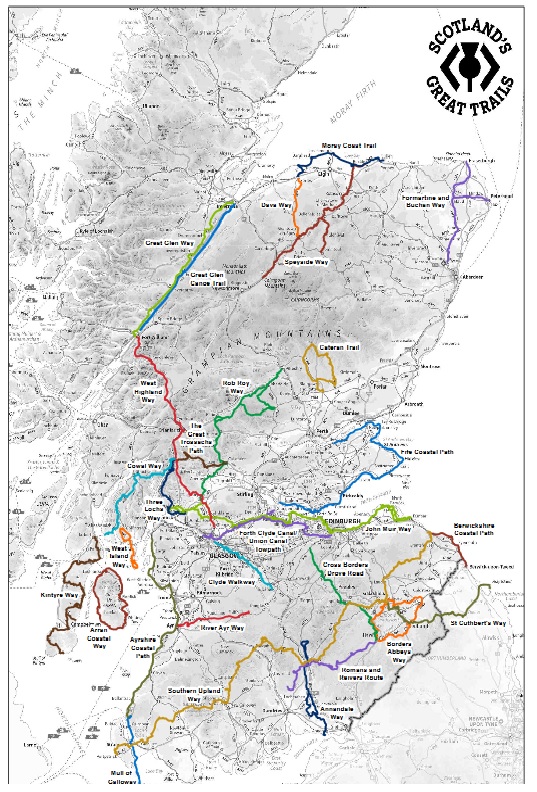
18/01/2018:
Never Get Lost - Just $20: Only 37
grams, the Brunton Get Back Mini GPS: Quickly shows
the way back to your starting point by the shortest, most direct route. Instead
of retracting your steps at the end of the day, you can head straight home, as
the crow flies, always on course. Points directly back to any of three points,
adjusting direction as you move, showing the route by arrow and the distance in
meters or miles. Can also be used as a digital compass, with or without
satellite coverage. Tough, indispensable, and not a toy. Feel comfortable no
matter where the adventure takes you, the GET-BACK will get you back.
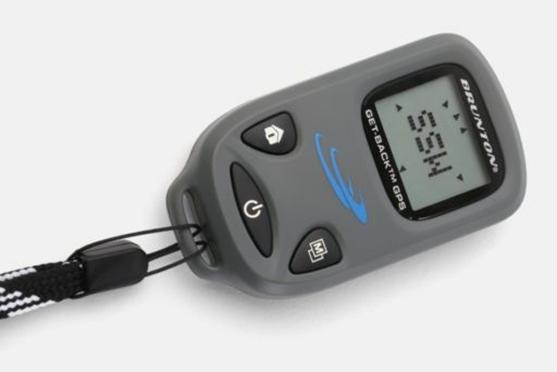
Curiously
this is almost the identical product I tried to patent 25 years ago!
Available
on Massdrop ( US 19.99 Jan 2018) This is 80%
off!
17/01/2018:
Ultralight Shooting Stick: The Flipstick: I used one of these
for years before my neurosurgery back operation – recommended, as I had
absolute agony staying on my feet without a break for any period of time.
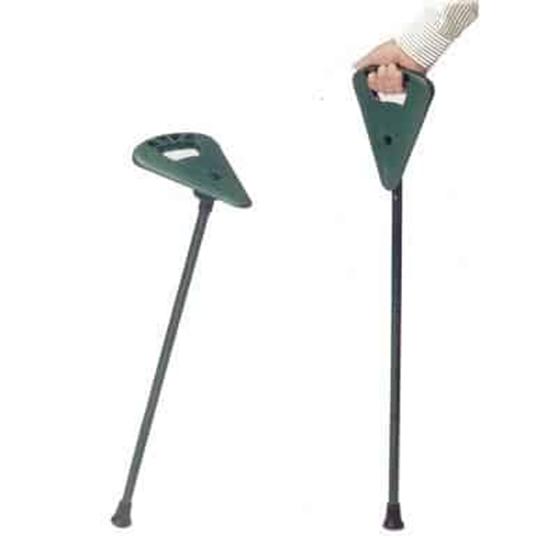
They
would also be useful if you were sitting up waiting for a trophy stag – or a
man-eater, as Jim Corbett used to do I particularly
enjoyed his Man Eaters of Kumaon and The Man Eating
Leopard of of Rudraprayag which you can download here: https://archive.org/details/TheMan-eatingLeopardOfRudraprayag1947.
If you enjoyed these two you will love Col Patterson’s Man Eaters of Tsavo)

It
is decribed thus: ‘A dual purpose walking stick/seat, constructed from 4
interlocking aluminium tubes and strong polyester stock cord (this product
practically assembles iself in front of you when released from its bag),
non-slip rubber foot suitable for indoor and outdoor use, with comfortable
plastic seat/handle. A spring-loaded button securely locks the seat/handle in
either the walking or siting position. As a seat, it transforms a person into a
very stable tripod.Lightweight to carry and yet capable of safely supporting
130kgs(280)lbs. This product comes with a comfortable, stylish, non-bulky,
adjustable shoulder bag for ease of carriage. Height (seat up) 82.6cm. Weight
0.58kg.
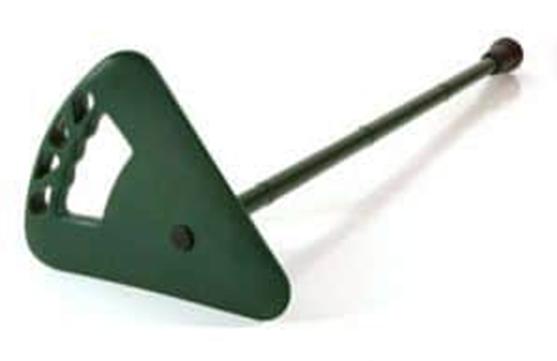
Feature:
Supplied
with easy to carry shoulder bag
Lightweight
and easily transportable
Easy
to operate
Designed
to securely support 130Kgs
UK
manufactured
Exchangeable
Rubber feet
Manufactured
from tough and durable aluminium & high quality plastic moulded seat
Suitable
for left and right-handed users https://www.flipstick.co.uk/Flipstick_Foldaway_Short--product--21.html
Sitpack
Zen: Here is another option, a little lighter 360 grams), more compact and
perhaps more comfortable, but not so much use as a walking stick perhaps: https://www.indiegogo.com/projects/sitpack-zen-x-the-worlds-most-compact-chair-design-travel#/
and https://www.kickstarter.com/projects/rest/sitpack-zen-the-worlds-most-compact-chair-perfect?ref=FundedToday&utm_medium=referral&utm_source=33dsa.fnd.to
It
is certainly a very clever, ultralight and compact design for a shooting stick.
It should give you years of service bird-watching, glassing, at the footy, etc.
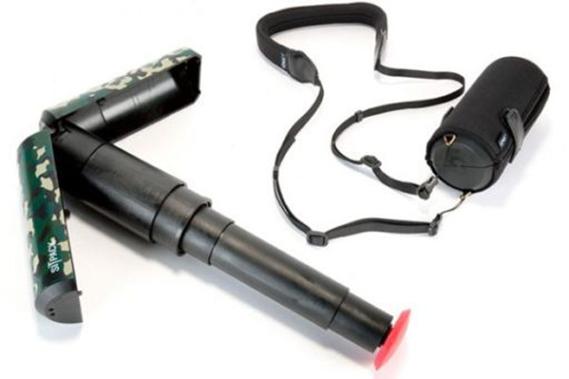
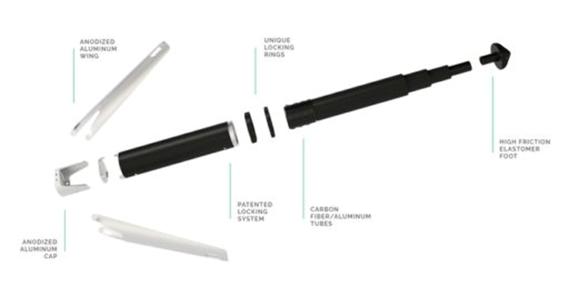
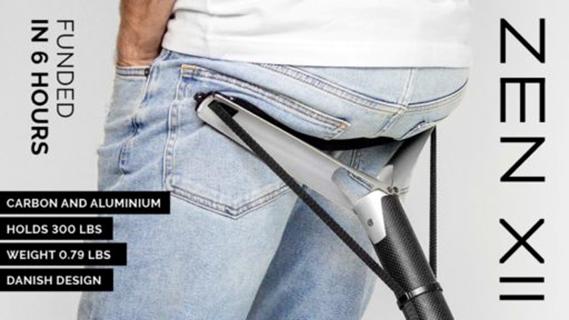

https://www.youtube.com/watch?v=BhCEEbNhfF0[/
16/01/2018:
Simple Hammock Double Up: You can
hang two hammocks side by side from the one pair of trees using just one tarp
with this simple expedient. You need one (or two) spacer bars (3/4" thick
branches or parts of your hiking poles will do) and some of these 25 mm (1
inch) poly plumbing fittings from eg Bunnings at
A$1.67 (Jan 2018) each. If you have some 1" poly pipe you can just cut
four approx 2" lengths and drill eg 3/8' holes in them (as I have done)
for the hammock suspension - they will weigh 6 grams each. Double bunking for
24 grams; how good is that?
As
you can see, Spot thinks there will be room for a couple of dogs too!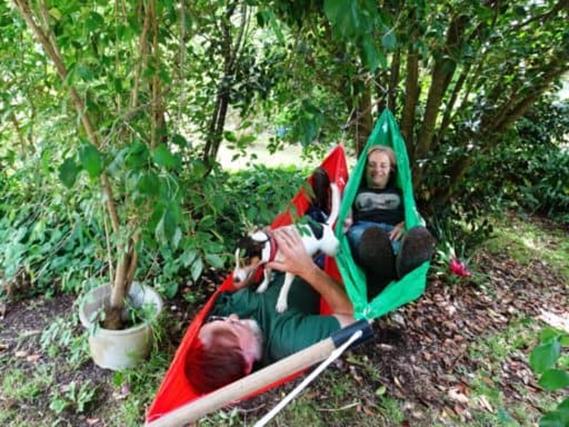
Detail
of the poly pipe and sticks - the sticks only need to be about 16" (40
cm).
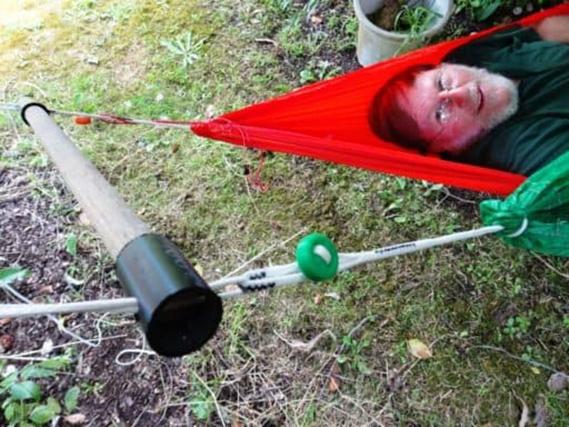
My
hammock needs tightening up a bit, but you can easily see we would both fit
under the one hammock tarp. This will be wonderful safe Fiordland NZ travel for
us. See eg: http://www.theultralighthiker.com/a-walk-in-fiordland/
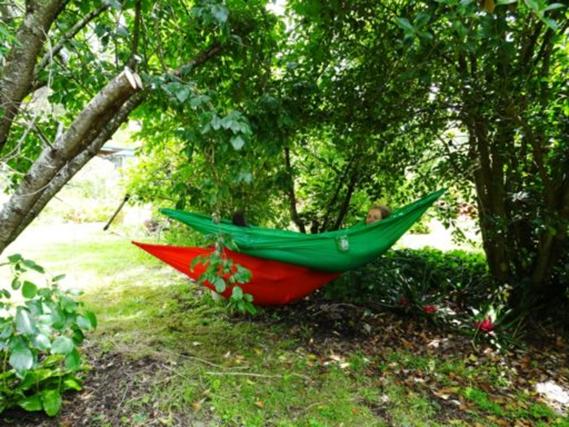
NB
These are my Hummingbird (Single) hammocks which weigh
a mere 147 grams each. They are a superb hammocks with a wonderful easy set-up
and one of the best and lightest suspension systems (60 grams!) I have seen.
Highly recommended. I took one with me on my Dusky track Fiordland NZ trip last year
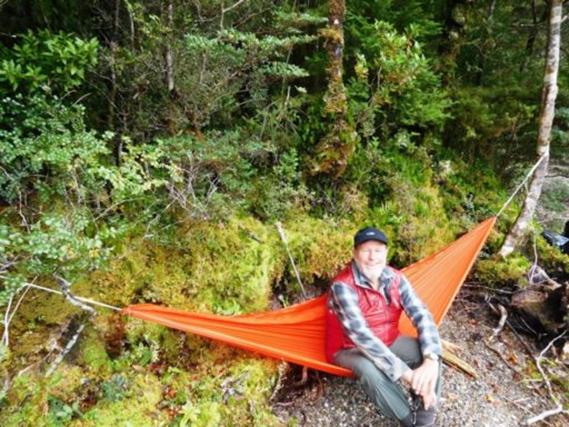
If
you are using the plumbing fitting, you place the spacer bar at the point where
the hammock attaches to the hammock suspension. One end of the bar fits in the
middle 'leg' of the tee which is slipped onto the hammock suspension. If you
sleep head to toe the bars can be shorter and you won't need a wider tarp, but
if you sleep side by side the bar at your head end will be longer and you can
dispense with the bar at the foot end altogether.
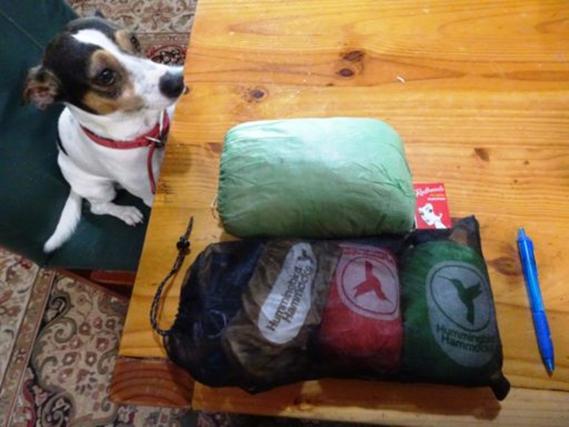
Above
is my complete hammock and tarp set-up for two people (and a small dog or two)
weighing less than 800 grams including stakes. This will keep us both safe in
the worst weather the world can throw at us. I could whittle this weight down
further. A Zpacks Cuben hammock tarp weighs 198
Grams. if I tied the two hammocks to the tree with dyneema each hamock would
weigh 165 grams. I would then need four 7 gram stakes and some dyneema to pitch
the tarp. Total say 570 grams. Pretty good for two people!
Some
cord and micro cord locks or mini carabiners might help eg to stop the hammocks
from moving away from each other and dropping the bar on the ground or to stop
the bar from moving up the suspension rope, though it doesn't seem necessary to
me. You can easily drill holes in these poly fittings if you feel you need to.
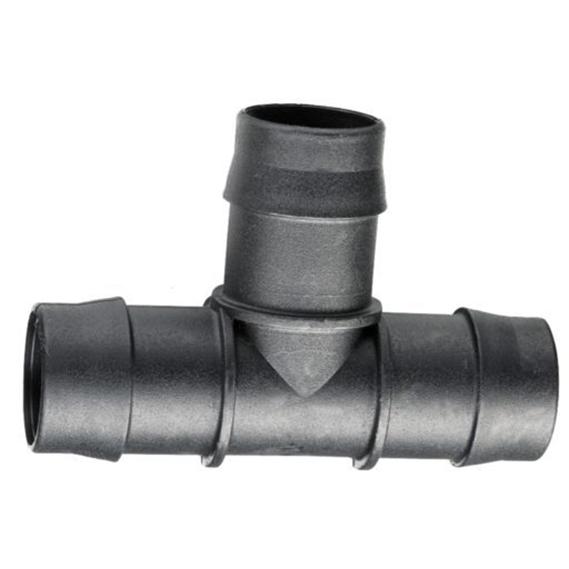
I
just used some pieces of poly pipe like this. They worked fine.
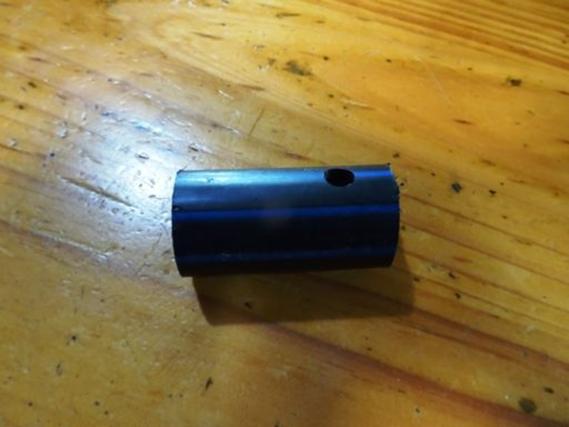
Another
alternative (if you carry a small saw such as the Darlac at 35 grams) is just to cut a 'V'
notch in the ends of the stick and to tie the two ends together with some cord
over the top of your hammock suspension.
If
you are sitting out a prolonged wet spell this idea will work well - you could
even play cards!
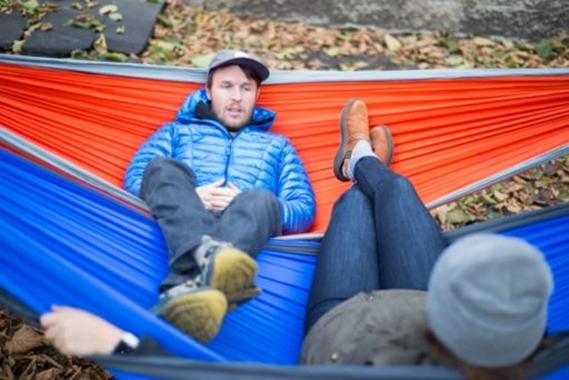
A
commercial version of this idea (which will weigh a lot more) is available
here: https://www.eaglesnestoutfittersinc.com/shop/lifestyle-gear/fusetm-tandem-hammock-system/ for
US$29.95 It weighs 9.8 oz (279 grams.)
Review
here: https://gearjunkie.com/eno-fuse-spreader-bars-tandem-hammock-system-review

PS:
I also use one of these fittings to protect my groundsheet
See
Also: http://www.theultralighthiker.com/hammock-camping-double-bunking/
http://www.theultralighthiker.com/60-diy-ultralight-hiker-ideas/
Other
Hammock Related Posts:
http://www.theultralighthiker.com/a-hummingbird-in-the-hand/
http://www.theultralighthiker.com/simple-hammock-double-up/
http://www.theultralighthiker.com/adjustable-hammock-ridgeline/
http://www.theultralighthiker.com/continuous-loop-another-great-hammock-idea/
http://www.theultralighthiker.com/whoopie-slings-what-a-great-idea/
http://www.theultralighthiker.com/side-insulation/
http://www.theultralighthiker.com/hammock-pad-extender/
http://www.theultralighthiker.com/diy-netless-hammock/
http://www.theultralighthiker.com/klymit-hammock-pad/
http://www.theultralighthiker.com/make-your-own-tarp-or-hammock/
http://www.theultralighthiker.com/hammock-camping-double-bunking/
http://www.theultralighthiker.com/hammock-hunting-till-dark/
http://www.theultralighthiker.com/all-in-one-hammock-tent-poncho-backpack-at-1-2-kg/
http://www.theultralighthiker.com/laybag/
http://www.theultralighthiker.com/all-you-ever-need-to-know-about-tarps/
http://www.theultralighthiker.com/tier-gear-catenary-cut-hex-tarp/
http://www.theultralighthiker.com/900th-post/
http://www.theultralighthiker.com/sleeping-pad-reinvented-big-agnes-q-core-slx/
http://www.theultralighthiker.com/modifyingshortening-hiking-mats/
http://www.theultralighthiker.com/catenary-cut-tarp/
http://www.theultralighthiker.com/thermarest-speedvalve/
http://www.theultralighthiker.com/upper-yarra-track-section-seven-mushroom-rocks-carpark-to-phillack-saddle/
http://www.theultralighthiker.com/hole-less-ponchoshelter/
http://www.theultralighthiker.com/hammocks/
http://www.theultralighthiker.com/hammock-camping/
http://www.theultralighthiker.com/the-ultralight-deer-hunter/
http://www.theultralighthiker.com/hunting-in-fiordland/
14/01/2018:
Bright Sky at Night: If you have
spent as many nights sleeping under the stars as I have (literally years) then
you will many times have encountered nights when it is bright enough without a
moon to safely walk through the bush without a torch even if it is not bright
enough to read a newspaper with as it is on some full moon nights. People
have puzzled about this for centuries.
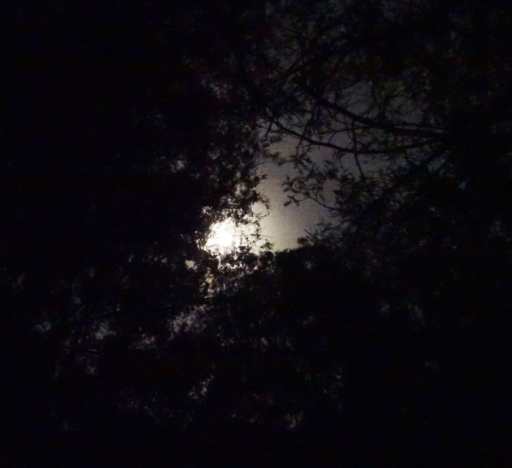
Unfortunately
because of artificial lighting most people will have never seen this
phenomenon. Most indeed have never seen ‘the glory of the everlasting stars’ as Clancy of the Overflow did – or even
the Milky Way. My wife Della did not even know you could see the Milky Way with
the naked eye (Yes, the largest thing in the night sky!) until I took her
camping when we were first courting when she was 18 – and she was astonished
(and hooked!) She was a city girl back then and I was doing my (short) stint of
living in the city (less than 5 years of my life) it seems now expressly for
the purpose of meeting her (the best bit – the degrees have never been much use).
Since then we have mostly lived our lives out of sight of the nearest house.
One
of the first times I noticed it (though I must have seen it many times before)
was when I was camping out (alone) miles from anywhere after a long walk on the
top of the Watagan Mountains near Newcastle at age 13-14. I was at first
delighted then concerned when all about me became clearly visible. I thought at
first it was search lights from the Flying Boat Base at Rathmines many miles
away, but I would have been able to see their beams snaking across the sky.
Then I thought it was the beginning of moonrise but it never appeared. Even
wilder thoughts raced through my head (flying saucers and such) but I suffered
no abduction, so I just lay back and enjoyed the light show.
I
have encountered it many times since then. Now there is an explanation which
you can find here and here. ‘The Romans referred to it as the
“nocturnal sun”. Later accounts describe it as an unexplained glow – bright
enough to read a book by – that would sometimes light up the night sky…Using
satellite data, two atmospheric scientists from the Toronto institution suggest
that the bright nights are not due to the sun or meteors, but instead the
result of converging “zonal waves” in Earth’s upper atmosphere…finding that
wavelengths in the upper atmosphere were at times superimposed over each other,
brightening the airglow by as much as tenfold.
Their
analysis showed these bright nights occurred 7% of the time and were highly
localised, confined to an area about the size of Europe. But outside of remote
areas, chances of seeing an event nowadays are slim, due to widespread light
pollution.’
13/01/2018:
Night Sights: If you are old like me
you are likely having trouble seeing your front sight in dim light, yet dawn
and dusk are the premier hunting times. What to do?
As
you know I eschew telescopic sights. I would not object to folks using a 1:1
ration scope or red dot aid, but stealing the ability to take down an animal
which is clearly too far away to be able to detect you is in my opinion not
fair chase. It is culling, not hunting.
I
agree there is a place for culling where animals become too numerous or are
becoming a nuisance, but if everyone adopts the culler’s methods or mindset it
diminishes the spirit of the chase, it devalues the game we hunt. It makes what
should be a test of yourself and your skills into a slight achievement at best.
It
will over time reduce the game resource and worsen the hunting situation for
all. After all, if there is no game to hunt then the right to own firearms will
clearly come under serious question too. You don’t want that, surely?
However,
as one’s eyes dim with age, so that front sight (especially) becomes harder and
harder to see. What to do? (Wait for your cataract operation!) Or you could, as
I suggested above adopt a 1: 1 or red dot type scope but such gadgets are very
delicate. When hunting rough country the occasional fall is inevitable, and
such things are easily damaged so that when you really need them, they may not
work. You will not want to wound an animal and have it suffer, or miss it
altogether!

A
better solution is to replace the sight/sights with a light gathering type
(like the Williams Fire Sights) which will really
shine out in dim light conditions. This is an expensive and technical exercise
which you may not want to undertake.

An
alternative is to buy some glow paint and apply some especially
to that front sight. If you can’t afford that, some fluoro nail polish, or even
the humble white out will improve your prospects no end.
Happy
Hunting!
12/01/2018:
The Moon Wind: What a fascinating
article; I have often noticed the 'terminator' wind, but I confess regretfully
I have not been outdoors over the ocean enough on warm full-moon nights to
notice the moon wind: With felicitations to the
amazing Willis Eschenbach:
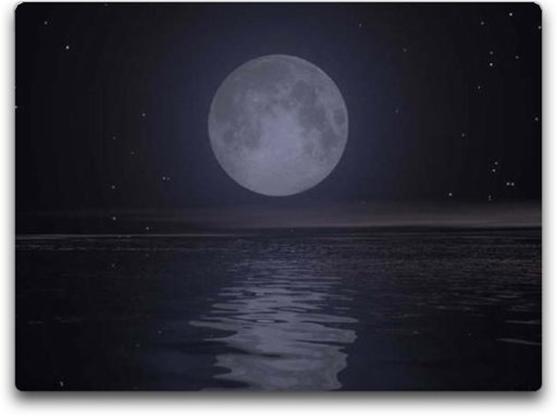
‘A
“terminator wind” is a wind that blows across the “terminator”, the moving line
on the earth that divides day from night. The sun heats the air on the day side
of the terminator line. The heated air rises, and cold dense air from the night
side of the terminator flows in to replace the rising heated air on the day
side. As a result, the terminator wind always blows from night to day. This leads
to a morning/night difference. In the morning the dawn breeze blows from the
dark areas further to the west of my location, and towards the sunlit areas
east of my location where the sun has already risen. In other words, the dawn
breeze is always and forever a west wind.
In
the evening, on the other hand, the sun has set in areas to the east of my
location. So an east wind blows from the nighttime there, towards the west,
where the sun still warms the earth. As a result, the dusk breeze
is always and forever an east wind.
The
opposite direction of these two winds leads to a curious phenomenon. This is
that for relatively steady overall winds, the dawn and dusk winds will
alternately oppose the underlying wind, or it will increase the underlying
wind. This is most visible when there is a light constant east wind. At the
dawn breeze is a west wind, so it opposes the light east wind and leads to a
short period of calm around dawn. At dusk, on the other hand, the terminator
wind blows from the east, so the dusk breeze reinforces the underlying east
wind and leads to a brief gusty period around dusk … and if there is a light
underlying west wind, the opposite is true.
Now,
here is where the moon came in. After I’d spent enough nights at sea, watching
the comings and goings of the moon, I noticed that the moon has a terminator
wind just like the sun. I started calling it the “moon wind”, I didn’t know
from terminators, I was on a boat in the middle of the sea, I made up a name. I
first noticed the moon wind in the doldrums, where the air is often quite calm,
with no wind of any kind. In those peaceful conditions, with the boat not
moving at all, the terminator wind from the moon is quite apparent … at least
it is to sailors hoping for any kind of wind in the doldrums. It obeys the same
rule as the dusk and dawn wind in that it always blows from areas with no moon
to areas with the moon. Of course, it is much weaker, and only detectable on
calm nights. On a calm night it is a sliver of a breeze, just enough to send
small wavelets shimmering in the emerging moonlight.’
See
Also: http://www.theultralighthiker.com/crepuscular-birdsong/
11/01/2018:
Hatchet: I’m sure most of you are familiar
with the best-selling children’s story ‘Hatchet’ by Gary Paulsen, which spawned
the film Cry in the Wild and a heap of sequels. I
guess it was inspired by the classic Heinlein SF ‘Tunnel in the Sky’ which if
you have not read, do - withal it may be a tad sociologically dated.It remains
one of my favourite books, a classic of the 'Castaway' genre which began with
the Odyssey and continued with Robinson Crusoe, etc.
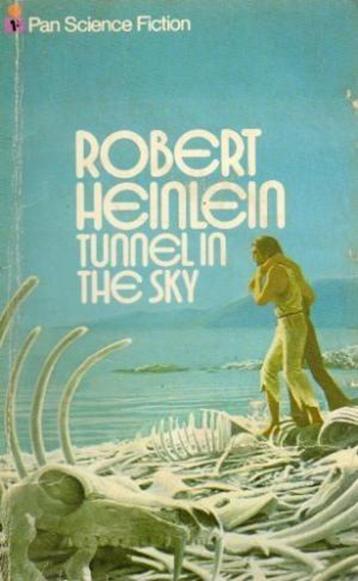
Young
Brian Robeson’s hatchet becomes an indispensable survival tool when he finds
himself alone in the Canadian wilderness amid bears, wolves etc - and with huge
challenges of food, shelter, survival, rescue etc.

If
you read the book you can easily imagine how you might find yourself in a
similar situation - of course my point here will be how ultralight all the
functions the hatchet might have can be construed).
You
can all imagine cutting and splitting wood, eg for fire lighting, or to
construct a shelter, etc. A hatchet might also make a handy weapon. It is also
good for pounding things, and as an anvil – and if you have a flint, for
striking sparks and fire.
Fewer
will realize how vital it might be for procuring fresh water in fairly dry
circumstances where no water flows, and no spring beckons. I have mentioned
before how water might be found with your sense of smell. See: http://www.theultralighthiker.com/follow-your-nose/
Some
wild birds are particularly good indicators of the proximity of water holes,
springs, small streams, etc: pigeons and finches especially are infallible and knowledge
of their presence has have saved many lives.
If
there is no above ground water though, you will be in dire trouble without a
digging and/or cutting implement. Your metal trowel can be used to dig for
water eg on the inside edge of dunes or the outside tighter bends of dry
watercourses. If there is no such available, many roots contain water.
The
water in (tree) roots and in branches invariably flows upwards towards the
crown of the plant, so that when you cut a section of either to drain their
water eg into your billy (or cook pot), you always have to invert them. As an
aside this is a compelling reason for carrying a cookset even if you do no
cooking. The 'no cook' fad is yet another kind of ultralight folly.
That
(heated) billy is a couple of hundred grams (at most) which may save your life.
You can capture condensing water from underneath its lid and shake it
carefully into another receptacle, maybe using your raincoat as a sort of
funnel. Of course it can also sterilise water which would otherwise be
undrinkable or dangerous.
A
3 metre length of succulent (current year) growth from a sapling will provide
over half a litre (2 cups) of usually very good water in a very short period of
time (minutes). It will be difficult to get enough without something to dig
&/or something to cut with. Hence the hatchet. And the trowel.
Of
course you should (generally) avoid milky sap. It is often an indication of
unpleasantness or even poison. The usual 'taste-test' procedure applies (as
with wild food), ie first touch a drop to a sensitive area of skin, (eg your
inner elbow or wrist). If nothing unpleasant happens within a few minutes,
touch a drop to your tongue, and again wait for a few minutes, then consume a
very small quantity and wait a few minutes...if nothing untoward happens then
the water (or plant) is probably fit to consume.
I
have mentioned before how those on the Kon Tiki consumed a 'shandy' of 50:50
fresh and sea water (for months) without any ill effects. This strategy means
you only have to find half the water you would otherwise expect. Consumption of
straight sea water when you are already dehydrated is dangerous and should be
avoided. Fresh is definitely best.
My
Gerber Brush Trimmer Machete weighs 487
grams:. A machete is a very useful multi-tool, so this weight should instruct
your choice of a cutting instrument. It will be difficult to source a
functional hatchet which weighs much better than this. Still, many people
prefer a hatchet.

Here
are some examples:
Fiskars
Hatchets: X7: http://www.fiskars.eu/products/gardening/axes/chopping-axe-xs-x7-1015618
Width 13 mm Length 231 mm Height 28 mm Weight 560 g
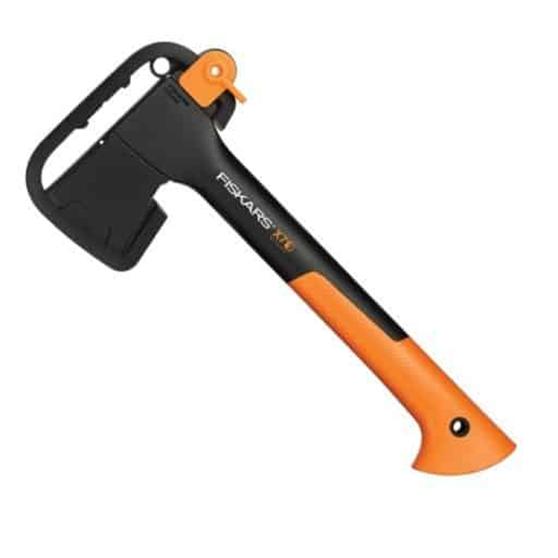
Fiskars
X5: http://www.fiskars.eu/products/gardening/axes/chopping-axe-xxs-x5-1015617
Width 130 mm Length 354 mm Height 33 mm Weight 640 g
Gransfor
Bruks Small Hatchet: https://www.gransforsbruk.com/en/product/gransfors-small-hatchet/
Length with handle: 26 cm (10”) Weight: 0.3 kg (0.7 lb)

The
Gerber Packpaxe (17 oz), and the Gator Combo Axe at 23 oz and which
has a useful fixed blade knife stowed in its hollow handle are certainly worth
consideration.

A
couple of other interesting sources of information about ‘ultralight hatchets’:
https://www.ragweedforge.com/ThrowingCatalog.html
& http://www.oldjimbo.com/survival/tinyhatchets.html
Steven
Evans of Suluk 46 came up with a 4.4 oz Titanium Hatchet here. Unfortunately it is not currently
available , and it might be that his Uki Saw is a better choice anyway at 127
grams.

Folks
will have their own opinions and make up their own minds about which hatchet to
carry, or whether to carry a machete instead of a hatchet – much more useful
for trail clearing, for example.
Readers
of my post about Ultralight Saws (which might substitute
for either hatchet/machete) will be aware that the ‘to beat’ weight here is the
Darlac at 35 grams.

I
think the minimum you should carry therefore so you can do all your survival fire lighting, digging and tree/root
cutting are the Darlac saw at 35 grams, the Ka-Bar’s Johnson Adventure Piggyback Knife (US$11.59)
at 23 grams and the Suluk 46 Tarc Trowel at 13 grams and US$35
(Jan 2018) – the trowel also makes a handy super tent stake.
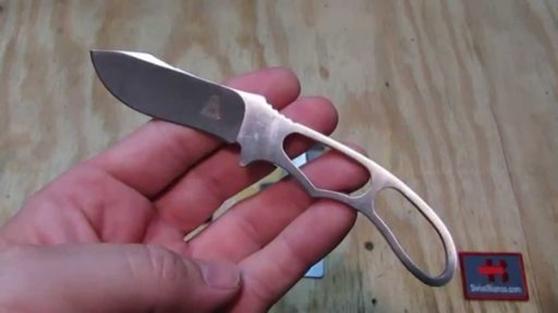
The
reason I would choose the Titanium trowel (Vargo also make one) over a very similar
weight aluminium one is that it is very carefully designed to not wear out your
hand, and being stronger and harder than aluminum (more than double) it will
wear out much more slowly, therefore justifying the extra coast especially in a
survival situation where you may need to do an awesome amount of digging. Of
course you may even need to use it to dig a shelter. Or a cat hole!
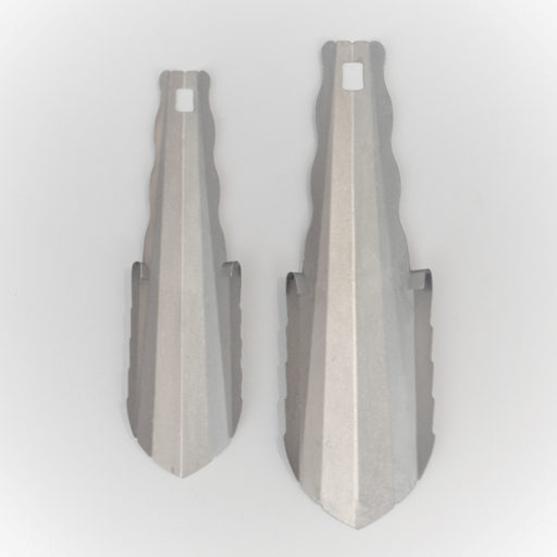
Some
other interesting survival stories:
http://www.theultralighthiker.com/i-felt-quite-rich-when-i-found-my-knife-flint-and-steel-in-my-shot-pouch/
http://www.theultralighthiker.com/the-wreck-of-the-commerce/
http://www.theultralighthiker.com/thrilling-tales-the-diy-motorcycle/
http://www.theultralighthiker.com/jeremiah-johnson-1972/
http://www.theultralighthiker.com/thrilling-tales-lewis-clark/
http://www.theultralighthiker.com/jim-bridger-the-greatest-plainsman/
http://www.theultralighthiker.com/man-in-the-wilderness-1971/
http://www.theultralighthiker.com/john-colter/
http://www.theultralighthiker.com/thrilling-tales-37-days-of-peril/
http://www.theultralighthiker.com/tim-severin/
http://www.theultralighthiker.com/kon-tiki-thor-heyerdahl/
See
Also:
http://www.theultralighthiker.com/water-hiking-desalinator/
http://www.theultralighthiker.com/sawyer-water-filter/
http://www.theultralighthiker.com/dehydrated-water/
http://www.theultralighthiker.com/rivers-in-the-sky-never-die-of-thirst/
http://www.theultralighthiker.com/survival-still/
http://www.theultralighthiker.com/water-filter/
http://www.theultralighthiker.com/collecting-water/
http://www.theultralighthiker.com/the-egg-ring-ultralight-wood-burner-stove/
10/01/2018:
Uki Buck Saw: Steven Evans’
wonderful Suluk 46 website is up and running again, so that I can add this
excellent ultralight saw to the recommendations on my previous list: This saw would also make a perfect hunting saw.
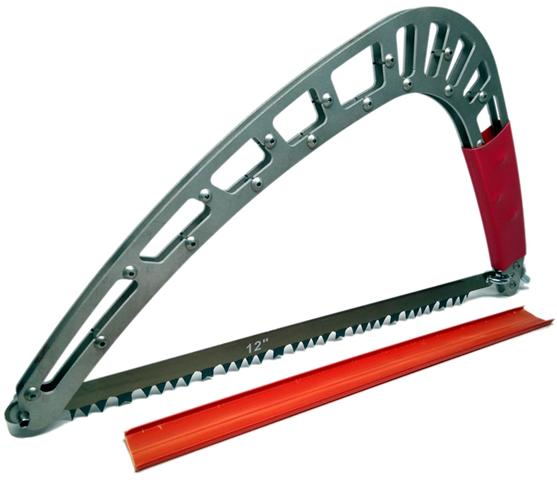
‘There
is nothing quite like the glow and warmth of a fire in camp after a long day of
hiking. At the same time, the burden required to manually break down decent
sized wood to feed the fire can be tiresome and sometimes impossible. Let the
ultralight 12″ Uki Buck Saw help you!
Weighing
only 4.48 ounces and housing a full 12″ blade, this robust buck saw will
cut through all the wood you require with ease. The fixed blade design means
one can deploy the Uki Buck Saw in a fast and efficient manner. All that is
required is to remove the blade guard, tighten the non-rotating tensioning
device, and start cutting, while the covered and contoured handle ensures a
comfortable grip’.
Weight 127 Grams
Dimensions 14 X 7.25 X .75 in
Available
US$74 (Jan 2018): https://suluk46.com/product/uki-buck-saw/
I
would partner this saw with these other recommended
Suluk products:
Titanium
Windscreen: https://suluk46.com/product/titanium-windscreen/
Ultralight
trowel: https://suluk46.com/product/tark-ultralight-backpacking-trowels/
& http://www.theultralighthiker.com/the-rolls-royce-of-back-country-trowels/
TDW
Stove: https://suluk46.com/product/tdw-stove/
& http://www.theultralighthiker.com/titanium-double-wall-wood-stove/
& http://www.theultralighthiker.com/suluk-stove/
05/01/2018:
Canoe Wonnangatta: Kingwill Bridge to
Meyers Flat: We returned to this beautiful section of the river again this
year for a three day trip. Last year we canoed it in two which did
not really give us enough time to savour it. With just a 2WD vehicle you can
canoe down from Eaglevale to Kingwill in 3 days, another 3
days to Meyers Flat, and a further 3 days to Angusvale. Nine unsurpassed
idyllic leisurely days on this incomparable river. It is all only pebble races
with the odd easy Grade 2 rapid except for about 3 Grade 3 rapids just upstream
from Angusvale which can be portaged. Put that on your 'Bucket
List'.
Of
course if you have a 4WD (or at least a pack raft) you can begin at the Humffray confluence and spend
2-3 days coming down to Eaglevale. If you are fairly experienced, you can come
down from Angusvale to the Glenaladale Bridge again taking your time and
completing it in three days to make a total of 15! Of course, you can continue
on to Lake King on largely flat water...
The
river height was 1.81 at Waterford when we began and 1.77 when we finished. We
hardly ever had to get out of the boats.
We
camped the first night after about three hours on the big flat on the true
right bank opposite McGuires Track (above Hut Creek). The second night we
camped again after about three hours on the true right bank just below where
Scrubby Creek track joins the river coming down from the Wonnangatta Road -
this is the last camping spot before the bridge. This left us again about three
hours for our third day down to Meyers Flat - about half an hour below the
Waterford Bridge.
If
you were doing it in two days, you would camp about where we had lunch ie below
Hut Creek, after you leave the walnut farm on the left bank, round a sharp
point and are cruising along a long flat on the true right bank. There are many
other spots where you can stop and camp though.
Here
we are setting out just above the Kingwill Bridge. If you are confused, I am
facing upstream.
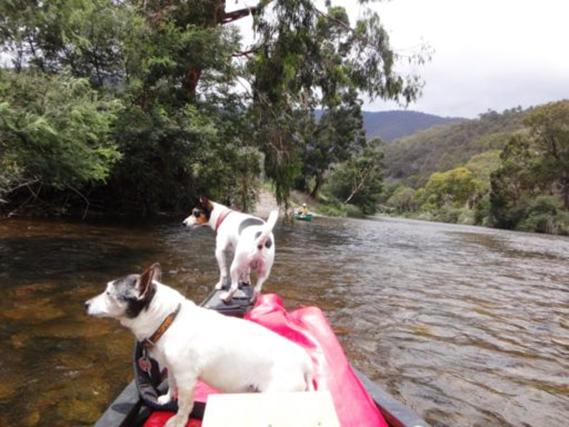
I
have already posted lots of photos of the river, so I will just include some
items of interest (I hope). Wood ducks take flight.
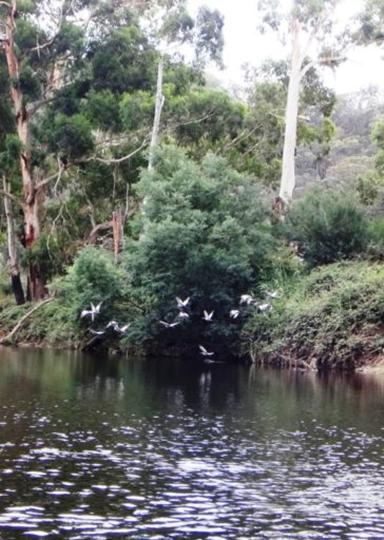
A
farmer, having had much of his land stolen by the Government losing new fence
after new fence to the river...

Entropy
hits the Hawkhurst swing bridge
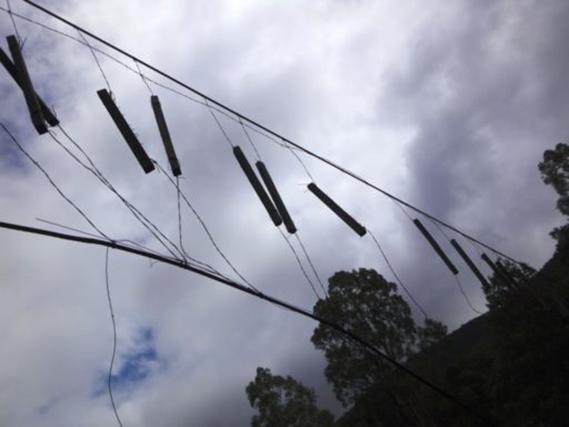
Strange
things appear in river wrack.
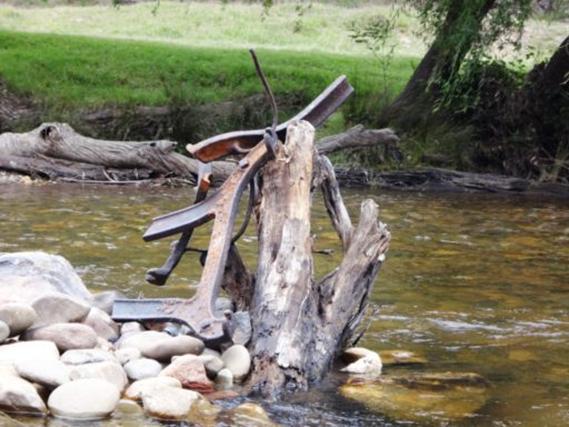
Cows
and ducks watch us pass.
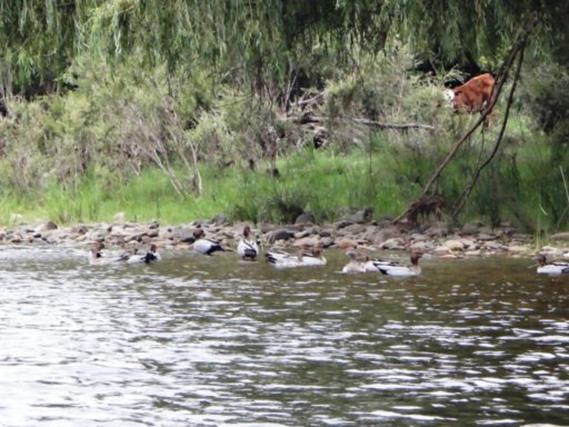
And
blue cranes...
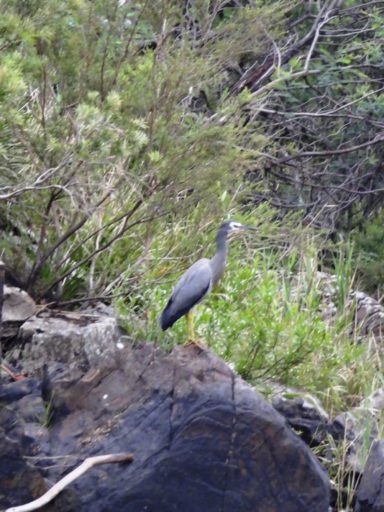
A
rare bird: a Nankeen Night Heron.

Some
other recent travelers had erected a monument at Hut Creek.

We
camped 'By the Light of the Silvery Moon'. It was a 'super moon' actually, 18%
bigger than normal because of the moon's apogee and perigee. It was bright
enough to read a newspaper by!
You
could have walked for miles through the bush without a torch. People used to in
the past. When I was a lad we used the full moon to spotlight possums and plink
them out of the trees with .22 shorts. Their skins were quite valuable (and not
illegal) then!
I
will (eventually) work out how to take moonlight photos with my new camera. First I will need to read the
instructions!
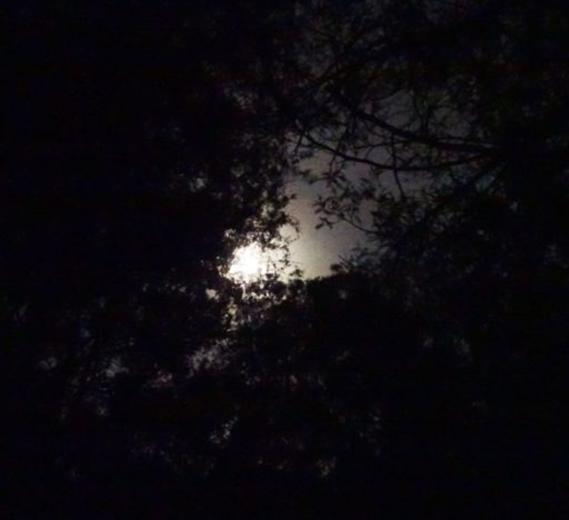
A
very hastily erected tent. I tautened it up a little bit later. I like how it
caught the light of the westering sun. Della is 'intent' on her ebook.
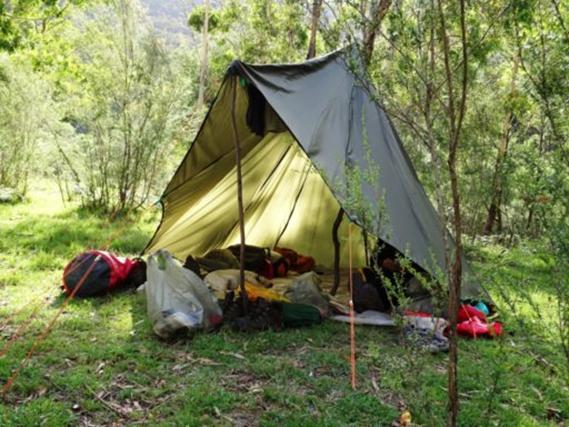
Enjoying
a read on my phone and an apple with Spot. I am re-reading the 'Flashman' books
by George MacDonald Fraser. They are the best 'history' books ever.

Lunch
spot on the second day (looking upstream).
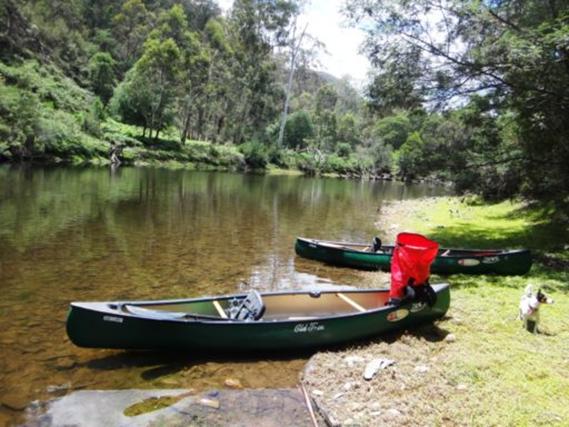
Some
lunchtime visitors: an interesting tadpole:

And
some truly enormous carp - they must have been 2' (60 cm) long!
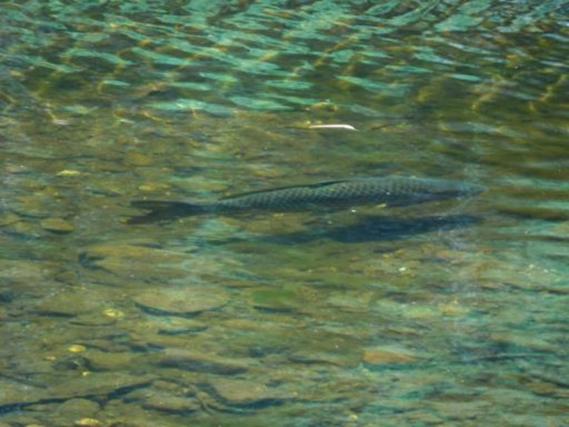
A
little further on (just above Scrubby Creek) this guy was dining on the (scant)
leavings of a hunter's deer carcass.
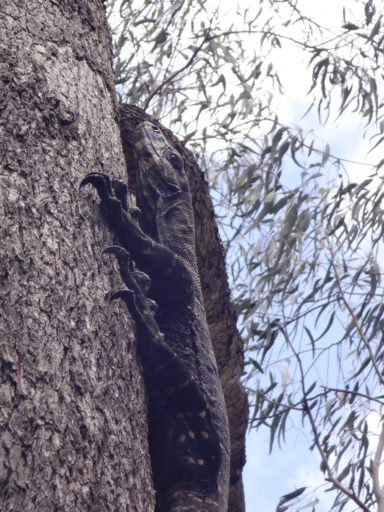
The
Scrubby Creek Track crossing. Whose vehicle does Spot think is the better? I
know which is quieter and allows more enjoyment of the bush, wildlife, etc.
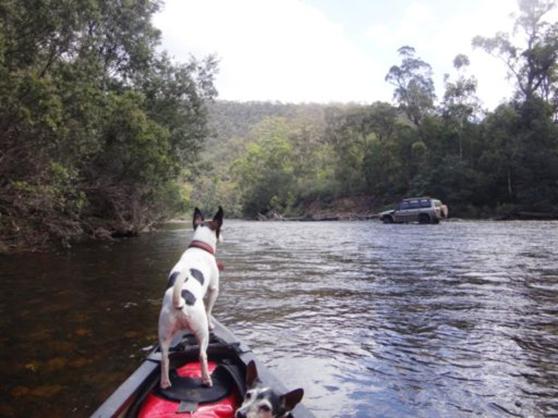
About
a kilometre below the Scrubby Creek Track crossing you will see a clearing on
your right, then you will sweep around a bend and see these 'Dragon's
Teeth' in the river. the last camp is on your right.
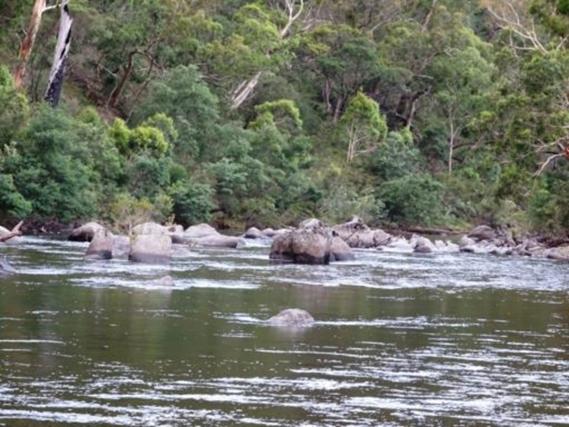
It
is a fine grassy flat. This is a photo of the tent in the morning. When I erected
it, I just went around and pushed all the pegs in and placed the poles in their
pockets. That's it. No adjustment. There was a wind in the night (and a light
shower) but this is what the tent still looked like in the morning; taut as. It
still looks pretty much the same when I remove all but four of the pegs! As I
say, I like a tent which goes up easily but does not come down the same way! It
is also really nice to be able to stand up inside and get dressed too.
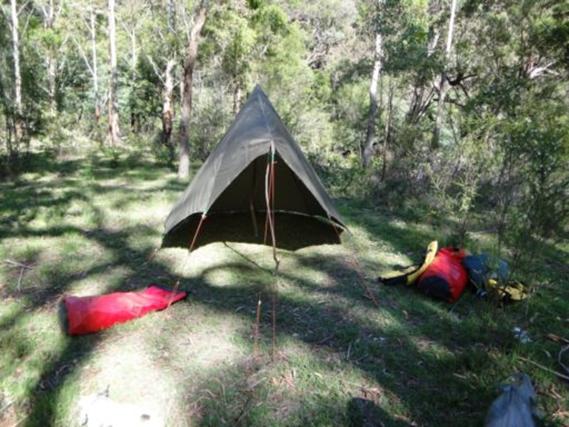
Again
there was a full moon. I had another go, not so clear this time. Oh well...

We
challenge 'The Dragon's Teeth'.

This
bouldery section of the river (at the beginning of Guy's property) is really
beautiful.
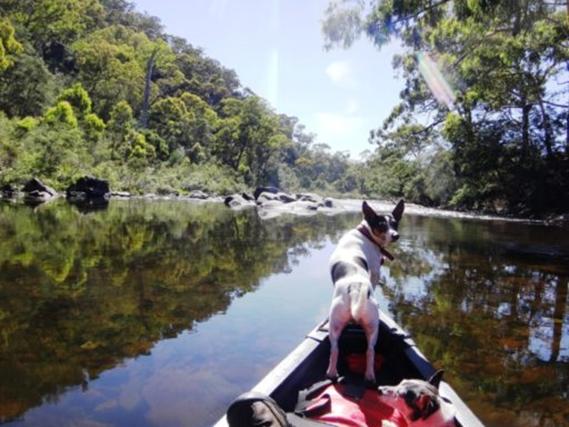
Spur-winged
plovers - they really do have a spur which can deliver a nasty cut!
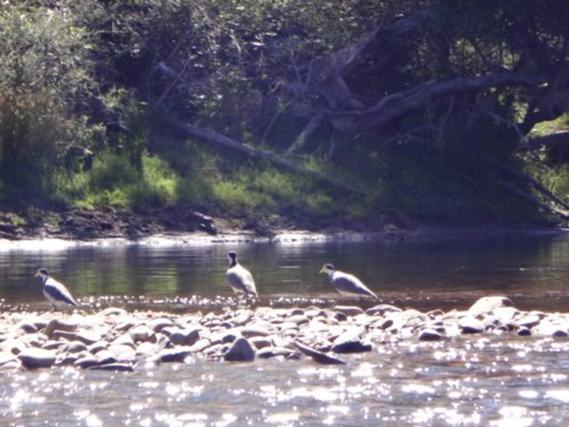
Just
relaxing on the river...

A
lovely placid section.
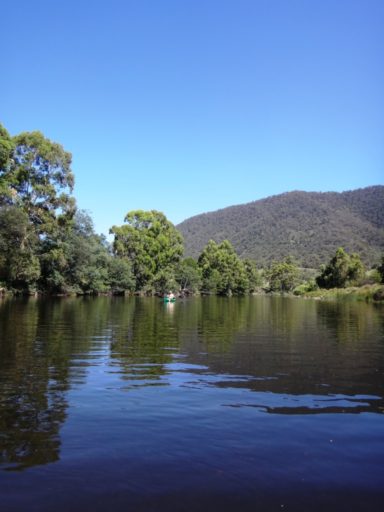
Of
course there are small drops here and there.

One
of my favourite birds - a Black Faced Cuckoo Shrike (Blue Jay). I adore their
dipping flight. a bit of camera shake at 20X zoom and whilst paddling. Sorry.
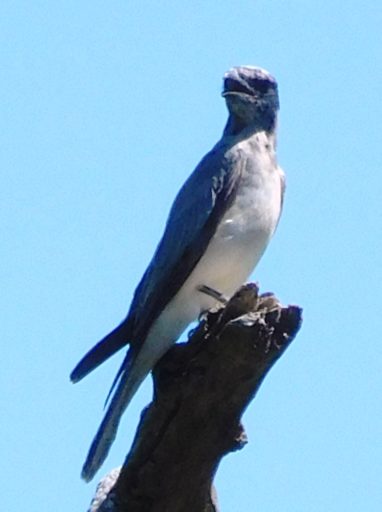
And
another, a Bee Eater, or Rainbow Bird. You will be alerted to their presence by
their shrill whistle. These two were just above the Waterford Bridge. These two
were still taken with my old camera. I am afraid to get my new one wet too!
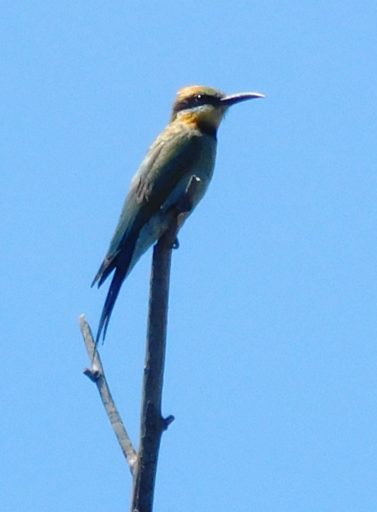
The
flat where we camped on the first night i used to call 'Bellbird Flat' on
account of the myriad Bell Miners whose piercing chimes followed you as you
meandered along it. the terrible fires of 2007-9 pretty much wiped them (and a
zillion other critters) off the map. it was delightful to find a colony of them
on the right bank above Scrubby Creek. Here is a sample of their work:
[video
width="1920" height="1080" mp4="http://www.theultralighthiker.com/wp-content/uploads/2018/01/20180103141541.mp4"][/video]
I
deplore the 'management' of Parks Vic, Catchment Management Authorities and the
like. Critters which were saved for centuries by a diversity of public land
uses have been destroyed in the wink of an eye by their ministrations. Instead
of multiple use: forestry, mining, grazing, tourism, introduced plants and
animals etc with fuel reduction burns, well-manged 'fire trails' dugouts,
settlements, huts etc, we have vast areas under a locked-up monocuture with no
management of any sort (unless having meetings and writing reports can be
termed management - I think it can). When it decides to burn nothing can be
done and it is all wiped clean of life of any sort.
In
just three days along this relatively undisturbed section of river (some of
which was 'saved' from wildfire destruction by the wonderful and heroic CFA -
because of its proximity to private land) we saw (or their tracks, nests etc) a
bewildering variety of life: two kinds of deer, four of possums, two of
macropods, unknown of bats, four of reptiles, four of fish, three of amphibia,
four of snakes, at least three of night birds, and I guess nearly a hundred of
different (day) birds, apart from these Bell Miners...
When
we were at Primary School we were tasked to learn this lovely poem by heart; time
not wasted:
The
Bellbirds,
Henry
Kendall:
'By
channels of coolness the echoes are calling,
And
down the dim gorges I hear the creek falling:
It
lives in the mountain where moss and the sedges
Touch
with their beauty the banks and the ledges.
Through
breaks of the cedar and sycamore bowers
Struggles
the light that is love to the flowers;
And,
softer than slumber, and sweeter than singing,
The
notes of the bell-birds are running and ringing.
The
silver-voiced bell birds, the darlings of daytime!
They
sing in September their songs of the May-time;
When
shadows wax strong, and the thunder bolts hurtle,
They
hide with their fear in the leaves of the myrtle;
When
rain and the sunbeams shine mingled together,
They
start up like fairies that follow fair weather;
And
straightway the hues of their feathers unfolden
Are
the green and the purple, the blue and the golden.
October,
the maiden of bright yellow tresses,
Loiters
for love in these cool wildernesses;
Loiters,
knee-deep, in the grasses, to listen,
Where
dripping rocks gleam and the leafy pools glisten:
Then
is the time when the water-moons splendid
Break
with their gold, and are scattered or blended
Over
the creeks, till the woodlands have warning
Of
songs of the bell-bird and wings of the Morning.
Welcome
as waters unkissed by the summers
Are
the voices of bell-birds to the thirsty far-comers.
When
fiery December sets foot in the forest,
And
the need of the wayfarer presses the sorest,
Pent
in the ridges for ever and ever
The
bell-birds direct him to spring and to river,
With
ring and with ripple, like runnels who torrents
Are
toned by the pebbles and the leaves in the currents.
Often
I sit, looking back to a childhood,
Mixt
with the sights and the sounds of the wildwood,
Longing
for power and the sweetness to fashion,
Lyrics
with beats like the heart-beats of Passion; -
Songs
interwoven of lights and of laughters
Borrowed
from bell-birds in far forest-rafters;
So
I might keep in the city and alleys
The
beauty and strength of the deep mountain valleys:
Charming
to slumber the pain of my losses
With
glimpses of creeks and a vision of mosses.'
02/01/2018:
Fish for Lunch: We have just
discovered this excellent product which no doubt had been hiding for years at
our local supermarket (in with other spreads such as jam - which we hardly ever
eat, and not the canned fish): John West's Tuna Spread. Della 'found' a can and
brought it along on our recent Wonnangatta canoe trip (another one is
coming up soon - lots of water in the river right now - New Year 2018). We had
it spread on Vitawheat 9 Grains and it was absolutely delicious. We will add
this to our standby add-ons of Peanut Butter or salami and cheese for lunch
stops on the trail.

Of
course we have many other food ideas. You might try a look at some of them
here:
http://www.theultralighthiker.com/a-hiking-food-compendium/
01/01/2018:
Ultralight Camera: I received this
wonderful new Sony Cybershot DSC-WX500 for Xmas from my
family to replace my old
Nikon http://www.theultralighthiker.com/new-camera/ which has
seen better days (after drowning it in the Wonnangatta recently http://www.theultralighthiker.com/a-wonnangatta-spring/).

I
suspect the Nikon can be repaired (and I will try). It has taken
thousands (32 gigs worth!) of excellent photos in the last two years, so it
deserves a bit of a rest. From memory it weighed 162 grams including battery
and card and had 20X zoom which I thought spectacular for a pocket camera:http://www.theultralighthiker.com/new-camera/
This
Sony replacement weighs 209 grams but has a 30X zoom and High Dynamic Range.
This morning I tried it out on full zoom on a couple of subjects in the garden.
It managed to take the shots perfectly with no shake or blur, as if you were
using a macro lens almost. I anticipate I will acquire lots of fine shots of
wildlife with it over the next couple of years (so long as I can manage to keep
it out of the river).
A
number of other manufacturers also have 30 X zoom Or better in a compact
camera, but all the others are just too heavy for one's breast pocket I'm
afraid. I have had wonderful service from my (old) waterproof Sony DSC-TX200V
camera, (and from an earlier model Pentax Optio S40 - my first digital camera,
bought in 2004 - what a revolution that was!). All my canoeing and wet weather
photos have been taken with this 5X zoom Sony waterproof - which has as yet not
been bettered (unfortunately).
One
advantage this camera has over my old one is the flip up screen (one of the things
which also makes it heavier though) but which will allow me to take better
selfies - as if you want to see my ugly mug plastered all over my posts!
Here
are my first three shots. A 30X zoom of one of dela's roses, and below it the
same rose taken from about a foot away. It is hard to see the difference in the
clarity of the image, though of course the background is very different without
the zoom.
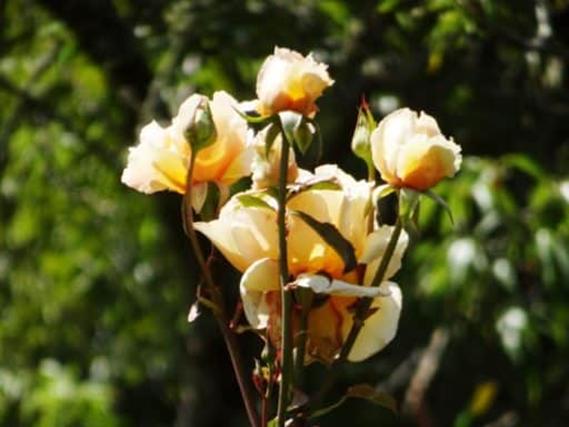

This
wonderful new bird has turned up in della's garden from Nth Qld: It is a White
headed Pigeon, a resident of the rainforests three. It is so beautiful. We hope
it will stay and breed! 30 X zoom:

See
Also:
http://www.theultralighthiker.com/stick-pic/
http://www.theultralighthiker.com/4-gram-string-reverse-tripod/
http://www.theultralighthiker.com/rubber-band-selfie-stick/
http://www.theultralighthiker.com/aloksak/
http://www.theultralighthiker.com/camera-glassing/
http://www.theultralighthiker.com/camera-clearviewers/
01/01/2018:
My 47th New Year with this lovely lady – and they just keep on
getting better!

Read
More Here:
Hiking 2017


















 Views
are just epic; just make sure it’s not going to be windy as there’s some
sketchy sections like half a footpath wide with sheer drops, wouldn’t want it
to be gusty. You could easy get to the view part and back in half a day. It’s
only an hour to the hut, then from the hut another hour to the start of the
crosscut saw. With a light day pack you’d kill it. It’s hilly but if you took
your time you would be fine.
Views
are just epic; just make sure it’s not going to be windy as there’s some
sketchy sections like half a footpath wide with sheer drops, wouldn’t want it
to be gusty. You could easy get to the view part and back in half a day. It’s
only an hour to the hut, then from the hut another hour to the start of the
crosscut saw. With a light day pack you’d kill it. It’s hilly but if you took
your time you would be fine.

















































 There
is as usual Food, lots of food
There
is as usual Food, lots of food and
numerous Deer doings and advice including how to be an Ultralight deer hunter
and
numerous Deer doings and advice including how to be an Ultralight deer hunter




 Here
it is a little closer up.
Here
it is a little closer up.







 Weltool version, Folomov version from approx US$12.69 (Feb
2018)
Weltool version, Folomov version from approx US$12.69 (Feb
2018)







































 Then
came ‘National Parks’, ‘State Parks’, ‘Reference Areas’ and other such
alienations of the public lands from the public. Interestingly these things
came simultaneously as fewer and fewer people lived , worked in or used these
wild areas. I suppose ‘everyone knows’ that Wilsons Prom was ‘pretty much’ the
first ‘National Park’ declared anywhere in the world. Probably the majority of
citizens of Victoria know how onerous the rules and regulations there are –
though some no doubt help preserve ‘delicate’ areas from too much human
traffic. In very busy areas more rules and regulations no doubt are
needed – whether the area be ‘National Park’ or ‘State Forest’.
Then
came ‘National Parks’, ‘State Parks’, ‘Reference Areas’ and other such
alienations of the public lands from the public. Interestingly these things
came simultaneously as fewer and fewer people lived , worked in or used these
wild areas. I suppose ‘everyone knows’ that Wilsons Prom was ‘pretty much’ the
first ‘National Park’ declared anywhere in the world. Probably the majority of
citizens of Victoria know how onerous the rules and regulations there are –
though some no doubt help preserve ‘delicate’ areas from too much human
traffic. In very busy areas more rules and regulations no doubt are
needed – whether the area be ‘National Park’ or ‘State Forest’.













































 We
used to hunt the whole area with hounds for sambar deer until the Park was
declared in the early 1980s
We
used to hunt the whole area with hounds for sambar deer until the Park was
declared in the early 1980s





 This
evergreen alder has already grown a foot in the month since we planted it. In
the background you can see the tree guards we used to use (last year’s
planting) which cost over $20 each instead of $2.
This
evergreen alder has already grown a foot in the month since we planted it. In
the background you can see the tree guards we used to use (last year’s
planting) which cost over $20 each instead of $2.  Japanese
Maple. It’s amazing how much growth you can slip the tube over when the
branches are bare. Of course she may have planted this the other way, ie
slipping the root ball through the tube. In either case, this is quite a tree given
that it has only been in the ground a couple of weeks. (Aside: the thistles are
out of control this year due to my not being able to spray them. We have a
contractor coming next week – and hopefully a couple of inches of rain too!)
Japanese
Maple. It’s amazing how much growth you can slip the tube over when the
branches are bare. Of course she may have planted this the other way, ie
slipping the root ball through the tube. In either case, this is quite a tree given
that it has only been in the ground a couple of weeks. (Aside: the thistles are
out of control this year due to my not being able to spray them. We have a
contractor coming next week – and hopefully a couple of inches of rain too!) The
Makita DHP 481, hole punch from Officeworks, roll of protective tubing and the
poorly welded auger – which nonetheless works perfectly well!
The
Makita DHP 481, hole punch from Officeworks, roll of protective tubing and the
poorly welded auger – which nonetheless works perfectly well!  The
old blackwoods are near the end of their life. This one has fallen down.
The
old blackwoods are near the end of their life. This one has fallen down.  This
Magnolia and Japanese Maple arte already above their protective tubes after
less than a month. These trees will be over 10′ high (3 metres) by
autumn. Instant forest. This planting will both beautify and stabilise this old
slip above our top dam.
This
Magnolia and Japanese Maple arte already above their protective tubes after
less than a month. These trees will be over 10′ high (3 metres) by
autumn. Instant forest. This planting will both beautify and stabilise this old
slip above our top dam. 





















 Tyers
River 2010 Let it pass…
Tyers
River 2010 Let it pass… 





































 This
low-stretch material which Brian says will not need any guyline tensioners yet
will stay put just exactly so sells me. I would choose the Coyote Brown as I
reckon the colour attracts deer. Whenever I have been out camped in one of my
own creations in this sort of colour eg the
This
low-stretch material which Brian says will not need any guyline tensioners yet
will stay put just exactly so sells me. I would choose the Coyote Brown as I
reckon the colour attracts deer. Whenever I have been out camped in one of my
own creations in this sort of colour eg the 
 They
come in three different sizes. I think you could manage to stay dry with the
‘standard’ one in pretty much any situation though – and you could also use it
as a tarp to sleep under on the ground when not hammocking. A hammock would
only add a couple of hundred grams to this set-up. You would want a slightly
wider one if you were going to double up:
They
come in three different sizes. I think you could manage to stay dry with the
‘standard’ one in pretty much any situation though – and you could also use it
as a tarp to sleep under on the ground when not hammocking. A hammock would
only add a couple of hundred grams to this set-up. You would want a slightly
wider one if you were going to double up: 























































































 PS:
It is very easy to find suitable car camping spots in Scotland. This is a good
thing as accommodation is mostly pre-booked and booked out in all the warmer
weather (which is why everyone is hurrying on the terribly narrow roads). I do
hate (mass) tourism actually. I would agree to go nowhere except my own 'back
yard' if everyone else would agree!
PS:
It is very easy to find suitable car camping spots in Scotland. This is a good
thing as accommodation is mostly pre-booked and booked out in all the warmer
weather (which is why everyone is hurrying on the terribly narrow roads). I do
hate (mass) tourism actually. I would agree to go nowhere except my own 'back
yard' if everyone else would agree!




















































































 You
can see what Spot thinks of Amanita (Fly Agaric), the 'Santa Claus' mushroom so
called they say because it can give you the hallucination of flying - and
death!
You
can see what Spot thinks of Amanita (Fly Agaric), the 'Santa Claus' mushroom so
called they say because it can give you the hallucination of flying - and
death!




































































































































































































































































































































































































































































































































 A prosaic farm dam can be a thing of great beauty.
A prosaic farm dam can be a thing of great beauty.




















































































